2020 UW-Whitewater graduate fatally shot in Milwaukee
(Originally published Feb. 9, 2021.)
A man who was fatally shot in Milwaukee on Saturday was a 2020 graduate of University of Wisconsin-Whitewater.
Purcell Pearson, 22, graduated from the university in May.
Several area news agencies, including ABC affiliate WKOW-TV, Madison, reported that Pearson was seen on surveillance video holding onto the side of a minivan. The shots that killed Pearson were alleged to have come from the van.
In June of 2020, a story featuring Pearson was posted on the university’s website. The story, written by Jeffrey Pohorski, outlined many of Pearson’s college-career achievements.
On June 17, Pearson, a psychology major, won the WiSys Quick Pitch State Final, a competition between student researchers from across the UW System. The competition focused on the importance of communicating research to the public, according to Pohorski’s story.
As part of the competition, Pearson completed a research project, entitled: “Racial Bias in News Media and its Effects on Black Males’ Self-Image.”
The research sought to understand “how black males perceive they are depicted in news media and whether these perceptions influence their daily lives,” Pohorski wrote in his story.
Pearson was quoted in the story as saying that he believed his research was timely, noting: “Police reform is a topic that is on everyone’s mind and so I think research like this could play a key role in police reform …”
The story credits Pearson, a leader within the Black Student Union, with creating a police officer liaison position on campus to represent concerns brought by Black students.
In the story, Pearson was reported to have shared his future plans, which included earning a doctorate in clinical psychology and opening a mental health practice within an impoverished and multicultural neighborhood.
Pearson was a member of Alpha Phi Alpha Fraternity and president of the fraternity’s Zeta Iota chapter. Accompanying the story is his picture taken with UW-Whitewater Chancellor Dwight C. Watson as he received on behalf of his fraternity the James R. Connor Spirit Cup. The cup was awarded to the fraternity in October of 2019 during homecoming week. Pearson was the campus homecoming king.

Purcell Pearson (UW-Whitewater photo/Craig Schreiner)
UW-Whitewater study: more deaths prevented by more mask wearing
(Originally published Feb. 19, 2021.)
If anyone still needs an incentive to use a face covering, David Welsch has one.
Welsch, a professor of economics at the University of Wisconsin-Whitewater, determined that if people who interact with others increase their use of face masks by just one percent, it could reduce COVID-19 deaths by 10.5 percent.
Working with data from 3,069 of the 3,131 counties in the United States and applying a series of mathematical controls to allow for variations in the county populations, Welsch concluded that the lives of six people might be saved in the average county if the number of people who wear face coverings within six feet of others increased by a single percentage point.
“Even if that number is off by a bit — even if it’s three people per county — that is still a big number,” said Welsch. “Showing that masks can reduce COVID-19 deaths is the most important outcome (of the study).”
Welsch’s study, which was published as “Do Masks Reduce COVID-19 Deaths? A County Level Analysis” on Nov. 13, 2020, in issue 57 of the Centre for Economic Policy Research, adds to a growing body of research on face coverings during the COVID-19 pandemic.
Ryan Westergaard, a chief medical officer with the Wisconsin Department of Health Services, said Welsch’s study addresses what public health experts have been saying all along about the importance of wearing face coverings to prevent the spread of COVID-19.
“COVID-19 spreads through respiratory droplets from our mouths and noses, and face masks contain those droplets, so wearing masks is important when people need to be out in public, said Westergaard. “But masks are just one tool to prevent the spread of the virus. Other prevention methods, like staying at home, maintaining social distance when you need to go out and washing hands thoroughly and frequently, also reduce the spread of the virus in the community.”
By the summer of 2020, Welsch had begun to notice the range of responses to wearing face coverings, from adherence to outright defiance.
“A lot of economists are inspired by things they see going on in the real world,” said Welsch, whose wife, a pediatrician, routinely wears a face mask and face shield at work. Welsch said their two children also wear masks at school and in basketball leagues. As a result, Welsch did not anticipate the widespread resistance to face masks that developed.
“I didn’t realize how controversial mask usage was. I was surprised.”
Welsch decided to investigate, using a powerful mathematical tool called “econometrics.” He drew on the daily COVID-19 reporting by counties to the Centers for Disease Control and a nationwide map of face covering use from 250,000 surveys compiled in July by the New York Times using global data and survey firm Dynata. He also used the U.S. Census and other sources. Welsch omitted only 62 counties due to missing information in their reporting to the CDC.
“Correlation is not causation. If you just look at (one correlation), you can get this weird result,” said Welsch. “Like, let’s say they have an older population. People in that county are probably going to use more masks because they’re worried about their vulnerable relatives who are older.”
“That county is going to have more deaths, but they’re also going to have more mask usage.”
By applying econometrics, economists over the past 50 years have learned how to use observable data documented by sources like the CDC to mathematically control the more subtle, unseen variables that can lead to distorted results. Honing in only on COVID-19 deaths helped refine Welsch’s study even more.
“So it’s almost like a laboratory experiment where we’re comparing two things that are exactly the same and then altering one dimension,” said Welsch. “These techniques allow us to compare counties with the same-aged population where one has higher mask usage than the other.”
Will more people come around to face coverings? Will the conclusions by Welsch and others tip the balance toward creating an incentive?
“Economists make an assumption that people on average are rational,” said Welsch. “Humans might do weird things once in a while, right? Or irrational things. But, on average, we’re rational and we react to incentives.”

UW-Whitewater plans for in-person fall 2021 classes
(Originally published Feb. 19, 2021.)
Chancellor Dwight C. Watson has announced that the University of Wisconsin-Whitewater’s plans for the fall 2021 semester will include in-person classes and on-campus living and dining experiences as they were pre-pandemic.
In addition, plans include athletics, arts and other expected activities.
“We at UW-Whitewater are always focused on student support and success,” Watson said. “We do not yet know what, if any, modifications — such as mask wearing and restrictions in class sizes — will remain in place as we return in the fall. Just as our protocols under COVID-19 have been based on county, state, and federal health department guidelines, our path to a safe fall 2021 will continue to be based on this guidance.”
To get to fall, Watson said, everyone needs to continue to follow the Warhawk Social Covenant: wear a mask when in public, stay socially distant when appropriate, wash hands regularly and get tested, and — when eligible — get vaccinated.
Currently enrolled students are encouraged to meet with their academic advisers to be ready for fall priority registration, April 5-16.
Newly admitted students can sign up for Student Orientation, Advising, and Registration (SOAR) beginning March 1.
“We can’t wait to welcome you to the Warhawk family!” Watson said.

University of Wisconsin-Whitewater (Kim McDarison photo.)
Recount scheduled for Whitewater’s Aldermanic District 5 serving residents in Jefferson County
(Originally published April 13, 2021.)
A petition has been filed for the recounting of votes cast in the April 6 election for candidates running in the City of Whitewater Common Council Aldermanic District 5.
The district includes a portion of the city of Whitewater that resides within Jefferson County.
The recount petition was filed today by Neil Hicks, who ran against Greg Majkzrak on April 6, according to documents released by Whitewater City Clerk Michele Smith.
The recount will take place Thursday, April 15, at 5 p.m. in the Cravath Lakefront Room, located on the second floor of the City of Whitewater Municipal Building, 312 W. Whitewater St., Whitewater.
According to the petition, the petitioner, Neil Hicks “alleges and shows” to the city clerk that the petitioner was a candidate for the office of City of Whitewater Aldermanic District 5 in the April 6 election, and is “informed and believes that a mistake has been committed in Wards 10-12 of the city of Whitewater, Jefferson County, Wisconsin, in the counting and return of votes cast for the office …”
Resulting from those beliefs, the petitioner is requesting a recount of Wards 10-12, the document states.
As previously reported by Fort Atkinson Online, The District 5 race was a close one, as incumbent Gregory Majkrzak reportedly received 62 votes to challenger Neil Hicks’ 60.
No changes after Whitewater City Council District 5 recount, Majkrzak holds seat
(Originally published April 16, 2021.)
By Kim McDarison
A recount performed yesterday by the Board of Canvass in Whitewater produced the same number of votes for two candidates running in the city’s Aldermanic District 5 race as was tallied on April 6, according to Whitewater City Clerk Michele Smith.
A recount petition was filed Wednesday, April 13, with the city clerk’s office by Neil Hicks. Hicks ran as a challenger against incumbent Whitewater City Common Council member Greg Majkzrak, who emerged victorious after the April 6 election. The count was 62 votes in favor of Majkzrak and 60 in favor of Hicks.
Thursday’s recount produced the same result, Smith said.
According to the petition, Hicks alleged that he was “informed and believes that a mistake has been committed in Wards 10-12 of the city of Whitewater, Jefferson County, Wisconsin, in the counting and return of votes cast for the office …”
He requested the recount based on those beliefs, he wrote within the petition.
The recounting process took about two and a half hours Thursday evening and came at a cost of approximately $90 to taxpayers, which, Smith wrote in an email, was the cost to pay the Board of Canvass.
Majkrzak was not present during the recounting process and Hicks arrived, after being detained in Madison, according to Smith, at the end of the process.
Aldermanic District 5 includes portions of the city of Whitewater that reside in Jefferson County.
With recount results producing the same results as those produced on election night, Majkrzak will continue to represent that district.
Virtual production of ‘Gruesome Playground Injuries’ features Fort actor
(Originally published April 17, 2021.)
By Kim McDarison
Love. Finding it, defining it, embracing it, these are all components of the typical love story, but “Gruesome Playground Injuries,” a play written by Rajiv Joseph, is a love story that’s anything but typical.
The one-act, eight-scene play runs about 75 minutes long and tells the story of two people who are traveling a bumpy, if not heartbreaking, path together.
Characters in the two-person play are brought to life by Fort Atkinson resident Alyssa Hannam, who plays “Kayleen,” and Appleton-area native Johnathon Krautkramer, who plays “Doug.”
“This story is about two people over the course of 30 years, when they are between 8 and 38 years old, and how that relationship can change,” said play director and Whitewater Arts Alliance Theatre Outreach Coordinator Matt Denney.
The play is being produced by the Whitewater Arts Alliance and will be available for viewing online over a 24-hour period between 5 p.m. April 24 and 5 p.m. April 25.
Denney described the presentation as “like a stream that is constantly available.” Ticket holders can watch the show as many times as they like during the 24-hour period, after which it will no longer be available for viewing. That, he said, is a matter of copyright provisions, as the Whitewater Arts Alliance has purchased the rights to present the play for a limited showing.
Tickets for the play are available online, and those purchasing tickets are invited to “pay what you can,” Denney said. Proceeds will be used to support the Whitewater Arts Alliance and its programming. Tickets may be purchased at: http://bit.ly/WAAGPI0421.
A former theater teacher working on a master’s degree at the University of Wisconsin-Whitewater, Denney said the concept of allowing ticket purchasers to name their own price was developed as part of a community outreach initiative. As a youngster growing up in Las Vegas, he said, he wanted to attend shows, but often could not afford them.
In his role as community outreach coordinator, he said: “My job is to integrate theater into the community. Theater and community are very intertwined with each other, and my role is to explore that further.
“For me, my overall goal is to make theater as accessible as I can to a wide audience. So I let anyone pay whatever they want. It doesn’t matter to me as long as they can view the art I’ve put forward.”
While the Whitewater Arts Alliance caters to a broad array of artists, he said, it also has access to what he described as “a beautiful stage,” which, he said, “was not being utilized.”
The play, which was recently performed without an audience on the Whitewater Arts Alliance stage, was filmed for virtual viewing.
The play was filmed by UW-Whitewater graduate Ashley McDarison, who holds a bachelor’s degree in communication, with an emphasis in electronic media, and a minor in film studies, earned in 2018. Today McDarison, 25, a town of Richmond resident, operates McDarison Productions.
Exploring ‘experimental theater’
As the artistic director and founder of MD Virtual Ensemble, a Las Vegas-based production company exploring “experimental theater,” Denney said, he has experience with producing virtual performances, and also had some familiarity with this particular play.
“I love doing weird theater,” Denney said. MD Virtual Ensemble has been producing at least one virtual production monthly since September of last year.
“We utilize actors from all over North America for our shows. Because it’s done virtually, actors don’t have to be where we are,” he said.
While actors, as in the case of Hannam and Krautkramer, might not know each other, Denney said, “there’s a shared experience and art form.”
With the arrival of COVID-19, he said, Zoom and live-streaming have become useful tools.
“We acknowledge that COVID-19 almost becomes a character … There is a sense of fear when people get close and we play around with that. It’s very different now when people get close,” he added.
Casting Hannam and Krautkramer
To cast this play, Denney said, he found local talent through Facebook on pages made specifically for local actors looking for work. He chose Hannam and Krautkramer for their roles after auditioning about a dozen candidates, he said, noting that the two immediately were standouts as the right fit for the two roles.
For Denney, the process started in February.
“It was a very traditional theater audition. They came prepared with one monologue and then they each did a cold read, which is where I give them a script that they haven’t seen before. They just knocked it out of the park. What I am looking for is: can an actor make a choice? Can they act with no preparation? They could very early on,” Denney said.
Describing her acting career and role in the play, Hannam said her interest in performing began to take form in middle school when she was encouraged by her friends to join the choir.
At Fort Atkinson High School, she said, she was a member of the Lexington Street Treble Choir in her sophomore and junior years, and became a member of the South High Street Singers her senior year.
She next attended UW-Green Bay, graduating in December of 2020 with a double major in musical theater and English, and has since been involved with virtual productions, including a summer production of “The Taming of the Shrew,” created by Play-by-Play Theater in Green Bay.
The show had a cast of about 10 characters and rehearsals were conducted through Zoom, Hannam recalled.
When she saw the audition notice placed by Denney on Facebook, she said, she was drawn to the role of Kayleen.
“I read the play a couple of years ago,” Hannam said, adding that playing Kayleen was a “dream role.”
“She is a really complex character. On the surface, she pushes people away, but she is very nuanced and has a soft side to her, and I always wanted a chance to play around with that,” Hannam said.
She also found some of herself in the character, she said, especially when looking at Kayleen’s defense mechanisms.
Krautkramer, too, found common ground between himself and his character.
A graduate of Fox Valley College where he earned an associate’s degree in criminal justice, he said he was impressionable as a youth, often announcing to his mother, after becoming influenced by whatever he had most recently seen on TV, that he wanted to be a fireman or an astronaut.
He developed an interest in acting during his childhood, he said, but put that on hold, thinking instead to develop a career in something society deemed as more likely and lucrative work.
At the age of 32, he said, over the last 10 years, he became active in acting again, picking up work with independent projects that were being produced in Milwaukee and Chicago.
Most of his projects have been in film rather than theater, but, he said, he viewed the Gruesome Playground Injuries production as sort of a hybrid, using both techniques.
“This play was definitely a hybrid. We used camera angles and did only two takes per scene to keep an authentic theater feel. Working with both concepts was a good transition back into theater for me. It was comfortable,” Krautkramer said.
Krautkramer said he did not have familiarity with the play or his character until he was invited to audition for the play.
The father of three children, one night, while he rocked his six-month-old baby to sleep, he said, he read the play, twice, and found himself relating to the role.
Of his character, Doug, Krautkramer said: “He’s more relatable to me than I would like to admit. He is a daredevil and he likes being the center of attention. He is very unafraid, outspoken and sometimes unfiltered. Sometimes, I could relate to him too much.
“He was a fun character. Even with (the play’s) melancholy side.”
Of the play, he said: “It is not your typical love story, so you avoid some of those clichés. The characters are complex and that makes them very real.
“This is the largest amount of work I’ve put into a project. Typically the projects I’ve worked on have bigger casts than this. When you have a big collaborating team, the weight of the show is spread across many hands. This one relies so heavily on you and the other person. It is more intimate because it’s a small team.”
‘Art should make you feel something’
“The relationship between these characters is so relatable. Art should make you feel something by the end of the show. They go through so much trauma and so many things,” Denney said.
Denney said he began working with professional productions on the Las Vegas strip when he was 17.
He was cast in a production called “Awesome 80s Prom.”
“It was a production from New York called immersive theater where the audience comes and enjoys a prom from the 80s every single night. It’s interactive theater.”
Denney said he was a senior in high school when he found his love of theater education. He earned a bachelor’s degree in secondary education with emphasis in theater from the University of Nevada-Reno in 2018.
He described MD Virtual Ensemble as “my little brain child from college,” noting that there were only two other students pursuing his major and the program did not have a directing requirement.
“As a teacher, you need that step,” Denney said. He and a classmate began the endeavor by producing a two-man show. That “kickstarted” the production company in 2017, he said.
After graduating, he served for a year as a theater teacher at Damonte Ranch High School, which emphasized a curriculum in performing arts.
Denney worked while in college as a resident assistant, which, he said, helped mold his career path.
After college, he was looking for an adventure — something different, he said — and that’s when he found his graduate program at UW-Whitewater.
Today, he works as a residential learning advisor at UW-Whitewater, guiding and advising student leadership in the resident hall and working with the resident hall associate.
He will graduate in May with a master’s degree in higher education leadership.
On with the show
For most involved with the production of Gruesome Playground Injuries, change is in the air.
The experience drew the cast and their director together, the three said. But like the play itself, this is but a moment in time.
For Denney, 25, after graduating from UW-Whitewater, he will seek out new adventures, leaving the area in search of work within the field of college administration and student affairs.
“My ambitions are to help students on a college campus. I don’t want to be a professor right away, but one day I want to be a professor of theater,” he said, adding: “I just really believe I’m here on this Earth to help students and help people become who they want to be.”
Of Denney, Krautkramer said: “Matt is so compassionate and caring. He is so worth knowing. I hope I work with him again.”
Of Hannam, Krautkramer said: “Alyssa, too, is just amazing and extremely talented, and she made it so easy to work opposite of her. She was an amazing scene partner.”
In viewing the play, Krautkramer said, he hopes audiences come to see that life can take people in all kinds of directions.
“When you first see it, it is fun and lighthearted and it ends on such a heavy note. You see the full spectrum of life in these characters,” he said.
As for his future, he added, he and his family, wife, Luella, and children, ages 5, 3 and 6 months, are making plans to move to Los Angeles where Krautkramer can pursue his acting goals.
“I guess I’ve learned from this experience that you only have one shot at this,” he said, adding that his wife has always wanted to live in California.
Hannam also described her experience with the play. To develop Kayleen as a character, she said, she used a journal, writing diary entries as though she were Kayleen. She is 22, but her character developed in the play to the age of 38. To help her determine what her character might be like at 38, she worked with written personality tests.
“I also wrote letters to Doug at different ages,” she said.
While she, Krautkramer and Denney were strangers when they came together to make this play, they have since become friends.
Looking to the future, she said: “My college roommate and I are planning to move to Chicago in a couple of months. I will be looking at trying to do more acting as a full time career as I can.”
For audiences, she said: “I don’t want them to feel sad, but I do want them to feel some kind of melancholy for these people who can’t seem to make their relationship work. There is always something getting in the way.”

Actors Johnathon Krautkramer and Alyssa Hannam rehearse. Kim McDarison photo.
Three occupants rescued after plane crash in Kettle Moraine Forest
(Originally published May 16, 2021.)
Editor’s note: The following information was released by the Whitewater Fire Department Saturday, May 15.
At 9:15 p.m. on Saturday the Whitewater Fire Department was dispatched to the area of Hi-Lo Road in the Kettle Moraine Forest for a report of a possible plane crash. Walworth County was initially alerted to the incident by Milwaukee Air Traffic Control regarding a plane that had dropped from radar.
A 911 call placed by the pilot of the aircraft allowed the Walworth County Sheriff’s Department to better pinpoint the location of the crash near the Ice Age Trail, off of County Road P. It took crews approximately 45 minutes to locate the crash site and make contact with the individuals involved. Initial reports are the plane was traveling from Sheboygan to Burlington when it lost power and was forced to deploy an emergency parachute. The aircraft was located approximately 75 (feet) off the ground in the forest canopy with three occupants on board. No injuries were reported.
MABAS (Mutual Aid Box Alarm System) Boxes 12-14 were requested bringing assistance from Janesville, Beloit, Elkhorn, LaGrange and Madison’s Heavy Urban Rescue Team. Dudek Tree Service was also requested for the company’s experience in scaling trees. Due to the plane’s location and terrain, rescuers were initially delayed in reaching the site. ATVs and rescuers on foot were utilized to ferry equipment and provide access.
It took crews approximately five hours, utilizing rope systems, to safely extract the there occupants from the single-engine aircraft. The individuals involved were not injured and were quickly reunited with their families.
The FAA (Federal Aviation Administration) was expecting to be on scene Sunday to investigate the incident. Plans to remove the aircraft were ongoing.

A single-engine plane carrying three passengers dropped from radar and was found lodged in the tree canopy in the Kettle Moraine Forest Saturday night. The above photos, courtesy of the Whitewater Fire Department, were shared through the Jefferson County Scanner Facebook page.
‘Possible sexual assault’ reported near UW-Whitewater parking lot
(Originally published May 24, 2021.)
Editor’s note: The University of Wisconsin-Whitewater has reported the following information through its “Announcements” portal on its website:
In compliance with the “Timely Warning” provisions of the federal Jeanne Clery Disclosure of Campus Security Policy and Crime Statistics Act, the university is releasing the following information:
At approximately 12:40 p.m. on Saturday, May 22, the university became aware of a possible sexual assault that occurred around 12:35 p.m. in the area around parking lot 18. The alleged offender was reported as male, with a tan complexion and athletic build, and wearing athletic shorts and dark shoes, and riding a light-colored bicycle.
Anyone with information related to this alleged assault is asked to contact UW-Whitewater Police at 262-472-4660, the Dean of Students office at 262-472-1533 or the Title IX Coordinator at 262-472-1024.
The full announcement is found here: https://announcements.uww.edu/Announcement/Details/17217.
A map showing the location of parking lot 18 on campus is here: https://www.uww.edu/documents/campus/uwwmap.pdf.
Police look for help identifying suspect related to alleged weekend assault
(Originally published May 24, 2021.)
Update: The UW-Whitewater Police reported at 8:49 p.m. on May 24 that the alleged offender was taken into custody.
Editor’s note: the following information was released today by the University of Wisconsin Police:
The UW-Whitewater Police are investigating a daylight stranger sexual assault that occurred on May 22 at approximately 12:26 p.m.
We are looking for assistance identifying the male depicted in the attached photographs, who is described as a white male, possibly Hispanic with a tan complexion, in his late teens or early 20s having an athletic build, black hair and was described as taller than 5’6”.
At the time of the assault the male was wearing a grey t-shirt, black Adidas athletic shorts, black or dark blue Adidas “NMB” style shoes, and a black baseball hat worn backwards. The male was traveling on a dark colored, soft tail mountain bike. The male had white wireless earbuds in both ears, similar to Apple “Airpods.” During the assault the suspect stated he was from Virginia.
If you have been involved in similar incidents or know of a subject who fits the aforementioned description, please contact Detective Cal Servi 262-472-4660 or servic@uww.edu.

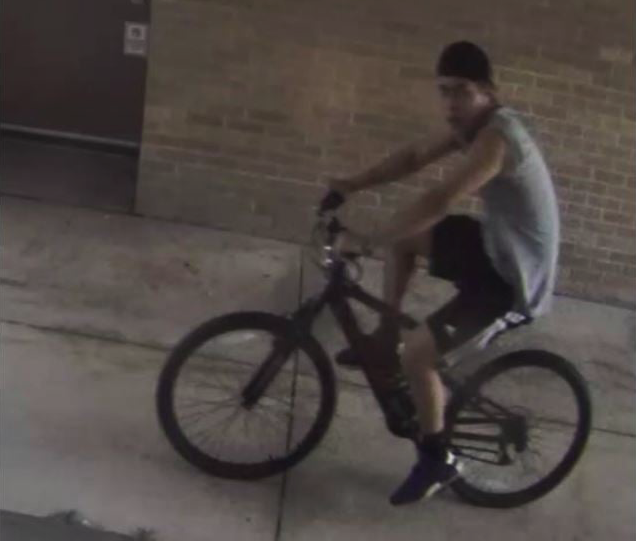

Three photos above: The UW-Whitewater Police are asking the public for help in identifying this individual.
Supplied photos.
Whitewater resident charged with sexual assault, attempted robbery in alleged daylight incident
(Originally published May 27, 2021.)
By Kim McDarison
A Whitewater resident has been charged with second degree sexual assault with use of force and attempted robbery with use of force, according to court documents filed yesterday and posted online. Both are felony charges.
Pedro Mayorquin Landero, Jr., 21, of Whitewater, appeared via Zoom video conference from the Jefferson County Jail Tuesday afternoon at which time a cash bond of $1,000 was set and posted by Mayorquin Landero. Conditions of the bond include: no acts of threats of violence, no contact with the victim in the case, and no presence on the University of Wisconsin-Whitewater campus.
Public defender Cassi Nelson appeared with Mayorquin Landero.
Additionally, the court ordered a DNA sample to be procured from Mayorquin Landero.
An in-person preliminary hearing is set for June 4.
If convicted Mayorquin Landero could face up to 40 years in prison.
Mayorquin Landero was arrested on May 24, according to information released by the UW-Whitewater Police after he was identified as a person of interest by a woman who reported that she had been assaulted near campus on Saturday, May 22, around 12:26 p.m.
Cameras on campus produced an image of the alleged assailant on a bicycle, which was released to the media in an attempt to secure help from the public in identifying the person of interest.
Information from the public was later cited by officials as helping to identify the suspect.
Information, as initially released by UW-Whitewater, is found here: https://fortatkinsononline.com/possible-sexual-assault-reported-near-uw-whitewater-parking-lot/.
Information released by UW-Whitewater Police, with a description of the alleged assailant is found here: https://fortatkinsononline.com/police-look-for-help-identifying-individual-related-to-alleged-weekend-assault/.
Disabled plane removed by helicopter from Kettle Moraine State Forest
(Originally published May 28, 2021.)
Is it a bird? Is it a plane? Well, it was more like a bird towing a plane.
Folks living near Whitewater Lake, located south of the city of Whitewater and southwest of the Southern Unit of the Kettle Moraine State Forest — which extends some 30 miles between Dousman and Whitewater — had opportunity to view an unusual sight Wednesday, May 26, when appearing in the sky was a helicopter transporting a disabled plane which crashed into the unit’s forest canopy nearly two weeks ago.
On May 15, at 9:15 p.m., the Whitewater Fire Department earlier reported, rescue units were dispatched to the Kettle Moraine Forest after learning from Walworth County officials and Milwaukee Air Traffic Control that a plane had dropped from radar in the area.
The crash site was located near the Ice Age Trail off of County Road P in Walworth County where the plane, with three occupants, dangled in the tree canopy some 75 feet off the ground. Passengers in the plane were uninjured and were rescued using a rope system. The rescue took five hours, according to the Whitewater Fire Department, after which the plane itself was left in the trees.
Robert Sivek, an area resident, took a photograph of the plane Wednesday as it traveled through the sky attached to a helicopter, and, posting it on Facebook, he wrote: “Amazing work taking the plane out of the trees on the Ice Age Trail.”
Sivek’s photograph garnered 61 comments from Facebook users posting within a Whitewater Lake-specific Facebook group, and some group members shared photos and videos of their own.
Describing his observations, Sivek wrote: “The plane was rigged for the lift before the helicopter positioned itself. I was able to watch two passes, and then the plane was lifted.”
On May 15, the Whitewater Fire Department reported that the single-engine aircraft was traveling from Sheboygan to Burlington when it lost power and was forced to deploy an emergency parachute.
A related story, with pictures of the crash site, is found here: https://fortatkinsononline.com/three-occupants-rescued-after-plane-crash-in-kettle-moraine-forest/.
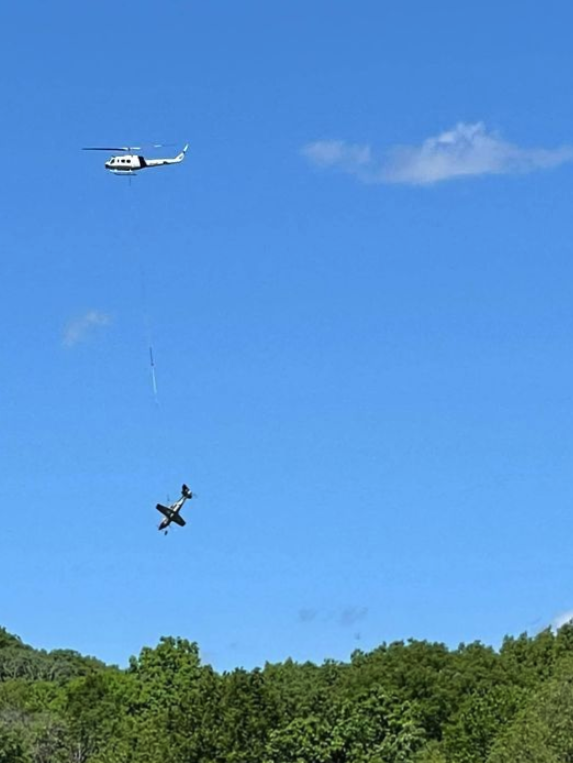
A plane is lifted from the tree canopy and transported by helicopter Wednesday after crashing in the Southern Unit of the Kettle Moraine State Forest on Saturday, May 15.
Photo contributed by Robert Sivek.
Police conduct investigation into ‘accidental and self-inflicted’ shooting death
(Originally published June 10, 2021.)
The Whitewater Police Department released on Thursday, June 10, the following information:
On Friday, June 4, at 9:21 p.m., the City of Whitewater Police Department received a 9-1-1 call. Officers were dispatched to the apartments located within the 300 block of N. Tratt Street after receiving a report of a subject who had “just shot himself.”
Upon arrival, officers located a 23-year-old male with a single gunshot wound. He was not breathing and did not have a pulse. The male was identified as Zachary Wasendorf of Whitewater. No others were injured during this incident.
One firearm was recovered at the scene, which was legally owned and possessed. The Whitewater Police Department investigation reveals the incident appears to be accidental and self-inflicted.
Local Emergency Medical Services, the University of Wisconsin-Whitewater Police Department and the Walworth County Medical Examiner assisted in the incident. The investigation is still ongoing with the medical examiner’s office.
According to the Whitewater Police Department, no additional information is being released at this time.
According to information released on the University of Wisconsin-Whitewater website, Wasendorf was a student at the university pursuing a major in political science and a minor in leadership and military science. He was serving as a sergeant in the Wisconsin National Guard and was an active member in the Phi Delta Theta fraternity.
In honor of his memory, the website stated, flags at the university will be flown at half-mast on Thursday.
Counseling services have been made available to fellow students and university staff members.
A public gathering will be held Thursday, June 10, at Gunderson West Funeral Home and Cremation Care, 7435 University Ave., Middleton, between 4 and 7 p.m., according to the website.
Military funeral honors by the Wisconsin Army National Guard will take place at 6 p.m.
The full announcement, including an obituary, is found here: https://announcements.uww.edu/Announcement/Details/17229.

Whitewater Police Department logo.
UW-Whitewater Chancellor resigns after cancer diagnosis, Henderson named as interim
(Originally published June 17, 2021.)
Editor’s note: The University of Wisconsin-Whitewater released the following announcement today on its website.
University of Wisconsin System President Tommy Thompson announced today that UW-Whitewater Chancellor Dwight Watson has resigned, citing health concerns. Thompson appointed former UW System Vice President for Academic and Student Affairs Jim Henderson as interim chancellor.
“I am deeply saddened to learn of Dwight’s personal health challenges, and I thank him for his service to UW-Whitewater during a difficult period,” Thompson said. “We are incredibly fortunate that Jim Henderson has agreed to lead the university at this challenging time. He is a personable and thoughtful academic leader with exceptional experience that will benefit UW-Whitewater greatly.”
Henderson served as UW System vice president for Academic and Student Affairs from 2016-2018. Prior to that he held the position of provost and vice president for Academic Affairs at University of Louisiana at Lafayette, from 2014-2016, and was dean of the College of Natural and Social Sciences at California State University, Los Angeles, from 2008-2013. Among his other administrative and faculty roles, Henderson was UW-Madison interim provost during the summer 2019.
“I’m excited to join the University of Wisconsin-Whitewater community as the University moves forward with planning and shaping its academic program to meet the needs of its students and the State of Wisconsin,” said Henderson. “UW-Whitewater is a gem, and I’m looking forward to working with the University community, the larger Whitewater and Rock County communities, the UW System, and other stakeholders in Wisconsin to help set the University on a course that will provide a strong foundation for the selection of the next Chancellor.”
Watson disclosed in his resignation letter that he was recently diagnosed with cancer. His resignation is effective June 30. He will serve in a transitional role assisting Henderson until Oct. 31 and then will become a tenured faculty member in the College of Education and Professional Studies, per the terms of his contract, at an annual salary of $92,325. Henderson will serve for an indefinite period starting July 1 and will earn $245,000 annually.
A link to a message from Chancellor Dwight Watson to UW-Whitewater students is found here: https://announcements.uww.edu/Announcement/Details/17236.

Jim Henderson
Whitewater Arts Alliance unveils 2021 public art project
(Originally published June 25, 2021.)
The Whitewater Arts Alliance (WAA) will be unveiling its 2021 public art project Tuesday, June 29.
The project is being produced in collaboration with the City of Whitewater, according to information recently released by the alliance.
This year’s theme is “Whitewater’s Heroes of the Covid-19 Pandemic.”
According to the release: “Each participating artist was encouraged to convey their ‘thank you’ message in their own personal way and artistic style, dedicating their artwork to the medical personnel, emergency workers, and essential workers that helped us through the pandemic.”
Wooden hearts were earlier supplied by the alliance to artists to create the public art.
The decorated wooden hearts will hang on the lampposts in downtown Whitewater throughout the rest of the summer months, after which they will be returned at the artist’s request, or become a permanent part of the Whitewater Arts Alliance collection, the release continued.
For more information about the alliance or its projects, visit its website: https://www.whitewaterarts.org.
UW-W freshman applications up 31 percent over 2020, mirroring systemwide trend
(Originally published June 25, 2021.)
Freshman fall enrollment applications have been rising steadily the past three years at the University of Wisconsin-Whitewater.
UW-Whitewater reports that new freshman applicants for fall 2021 number 8,835, compared to 6,058 in the fall of 2020 and 5,925 in the fall of 2019.
That represents a 31.4-percent increase from 2020 and 32.9-percent boost from 2019.
It mirrors a trend throughout the UW System, where freshman applications are up by one-third over the past two years.
Moreover, applications by Wisconsin residents, first-generation students, and underrepresented minorities are also up across the UW System.
The increases are the result of several actions the UW System took over the last 15 months to simplify the application process, including waiving application fees, creating a new EApp (electronic application), allowing students to use a single application for multiple universities, and suspending the requirement that students take the ACT, according to system officials.
“I’m thrilled with these positive application numbers. Our strategies are working, and we are setting the stage for success,” said UW System President Tommy Thompson. “While the pandemic challenged us all, students are primed to get back to campus this fall, and we want them to know that we are ready as ever to help them achieve their education goals.”
In addition to applications being up systemwide, they also are up at each of the 13 universities. Admissions rates are also up slightly: 82 percent in June, for example, compared to 77 percent during the same month in 2020 and 77 percent during the same month in 2019.
Thompson cautioned that not all students who apply and are admitted will enroll. However, he said the increase in applications is a positive signal about first-year enrollments.
Largely due to the pandemic, enrollment was down at UW System universities in fall 2020 by 1.7 percent, according to final figures. That’s less than the national decline of 4 percent for public institutions, according to the National Student Clearinghouse Research Center.
So far, UW System universities have received 133,484 applications from new freshmen for fall 2021, about 29 percent higher than at the same point in 2020 and 33 percent higher than 2019.
Applications from Wisconsin residents stand at 69,435 compared to roughly 50,000 each of the last two years at the same time. The 22,820 applications from underrepresented minorities are up 19 percent compared to June 2020 and 23 percent compared to June 2019. Applications from first-generation students, 40,085, are up 30 percent compared to the same time in 2020 and 25 percent in 2019.
The rate of students completing applications is also higher than previous years, another sign the strategies implemented by the UW System are working, Thompson said.
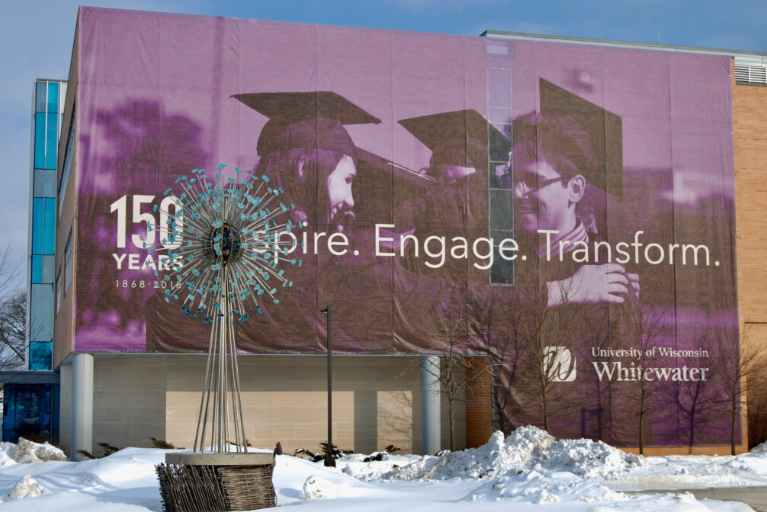
University of Wisconsin-Whitewater, file photo/Kim McDarison.
UW-Whitewater alumna, philanthropist Lolita Kachel, 92, dies
(Originally published Sept. 8, 2021.)
The University of Wisconsin-Whitewater is remembering Lolita Kachel, an alumna and longtime benefactor who has died at the age of 92.
Kachel passed away on Thursday, Sept. 2 in Whitewater.
Over the course of their lives, she and her husband, David Kachel, made hundreds of gifts and donated millions of dollars to UW-Whitewater, leaving a transformative legacy at their alma mater, information released by the university stated.
“It’s impossible to look around our beautiful campus and not see the impact of Lolita and David Kachel. Generations of Warhawks have benefited from their financial support and their service to our university. They were friends to many and respected leaders in the Whitewater community. My heart goes out to the entire Kachel family during this difficult time,” Interim Chancellor Jim Henderson said within the release.
The Kachels’ support for UW-Whitewater ran the gamut from athletics to academics to the arts. Notable building projects include the DLK/Kachel Fieldhouse, the Kachel Family Sports Complex, Football Performance Center at Perkins Stadium, Kachel Center in the Young Auditorium and Kachel Center for Innovation and Business Development in Hyland Hall, the release continued.
Gifts from the Kachel family support numerous student scholarships annually.
Lolita Kachel earned her bachelor’s degree in education in 1950. She and David were inducted into the UW-Whitewater Athletic Hall of Fame in 1998 and received the Distinguished Service Award for their generous contributions and support of Warhawk Athletics.
Nitardy Funeral Home in Whitewater is in charge of funeral arrangements. The following is her obituary:
Lolita Ann Matson Kachel, 92, passed away peacefully with family by her side Sept. 2, 2021, at her home in Whitewater after a brief illness. Lolita was a local businesswoman and philanthropist, as well as a mother of seven and grandmother of 12.
Born April 10, 1929, in Wausau, to John and Laura Matson, Lolita spent her early years in Ringle and her high school years in Eagle River. Her father, John B. Matson, was Vilas County superintendent of schools and a major influence on her appreciating the value of education.
Growing up in the Northwoods, Lolita loved spending summers with her Finnish Grandma Emma Matson and aunts on their farm, overlooking Sand Lake in Phelps. Sand Lake was also the summer home of Al Capone’s lawyer, and her aunts entertained her with tales of Capone hiding out at his lawyer’s home when things got “too hot” in Chicago.
Lolita attended Whitewater State Teachers College in 1946. She enjoyed college and was a member and president of the Women’s Self Government Association, president of Theta Sigma Upsilon Sorority and a member of the A Capella and Treble Clef choirs.
While attending college, she met David L. Kachel. Shortly after graduating in 1950 with a degree in business education, Lolita and Dave wed on Aug. 27, 1950, in Eagle River. They celebrated 60 years of marriage before his passing in February of 2011.
Lolita first taught in Mishicot. Later, while raising her family, she worked side by side with her husband in the family businesses. Her business skills acquired in college proved invaluable throughout her life partnership with Dave at the Wisconsin Dairy Supply, and later in the real estate business of DLK Enterprises, Hawk Bowl, and Brookdale and Blackhawk Manors.
Lolita was on the Board of Directors of Commercial Bank for 40 years and served as chairman for six of those years.
Lolita and Dave were huge supporters of education at all levels. Together they donated funds to Whitewater Unified School District for the fulfillment of many educational and sports projects. They were founding donors of the Whitewater Aquatic Center to ensure that swimming could become a sport at Whitewater High School, as well as being utilized by the public. They awarded numerous scholarships to WHS students to assist with college costs.
At UW-Whitewater, Lolita and Dave supported numerous UW-Whitewater projects to improve the campus. These included the DLK/Kachel Fieldhouse, the Gymnasium in Williams Center, the Kachel Family Sports Complex, the Center for Entrepreneurship in Hyland Hall and the Kachel Center in Young Auditorium. Throughout the years, many UW-W students have received scholarships and been employed in various Kachel businesses.
In 1995, Lolita received the Distinguished UW-W Alumni Award. She and Dave were awarded the UW-Whitewater 1990 Service Award, as well as the UW-Whitewater Athletic Hall of Fame Distinguished Service Award in 1998.
Lolita and Dave were founding supporters of the Whitewater Food Pantry. Lolita continued supporting numerous community organizations, including the Whitewater Fire Department and Rescue Squad, and Bassett House Federation of Women’s Clubs.
The Methodist Church was an integral part of Lolita’s life. She was a 71-year member of the First United Methodist Church and a member of Esther Circle. In later years, she watched every Sunday service at home on TV.
Lolita and Dave were also instrumental in the establishment of Whitewater church’s Bethel House.
Lolita’s greatest joys in later years were visits by her children and grandchildren.
Survivors include her children, Linda (David Katz) Sherman Oaks, Calif.; Jon (Terri), Whitewater; David (Trish) Milton; Laurence (Karen) Whitewater; Kerri (Jeff McDonald) Whitewater; Thomas (Jenny) Madison; and Michael (Sonia) Kachel, Whitewater; grandchildren, Andrew, David Jon, Kristyn, Kaili, Samantha, Max, Molly, Jourden, Madeline, Emery, Camden and Keaton Kachel; sisters, Donna Berg, Whitewater; Eunice (Rolf) Grimsrud, Superior; and sister-in-law, Mia Matson, Poway, Calif.; nieces, Brenda (Berg) Lowry, Appleton; Sandra (Berg) Miller, Madison; Lisa Olberg, Minneapolis, Minn.; and Debra Grimsrud, Superior; nephews, John Matson, Poway, Calif.; and Donald (Star) Matson, Pasadena, Calif.; and grandnieces, Logan Lowry; and Mia and Zoe Matson.
Predeceased family include her husband, David L. Kachel; parents, John B. and Laura E. Matson; in-laws, Laurence M. and Jessie A. Kachel; brother, John E. Matson; and brother-in-law, Rodney D. Berg.
Our heartfelt thanks for the special care provided by the My Care of Wisconsin team, Patti DePorter, RN, and Agrace Hospice Care. Many thanks to family, friends and neighbors for their calls, cards and visits.
Funeral services will be held Thursday, Sept. 9, 2021 at the First United Methodist Church, 145 S. Prairie St., Whitewater, at noon with visitation at the church from 10 am until noon.
In lieu of flowers, memorials may be made to First United Methodist Church, the Whitewater Food Pantry or the UW-Whitewater Foundation Student Scholarship Fund.
Nitardy Funeral Home is assisting the family with arrangements. Online condolences y may be made at www.nitardyfuneralhome.com.
To send flowers to the family or plant a tree in memory of Lolita Kachel, please visit Tribute Store.
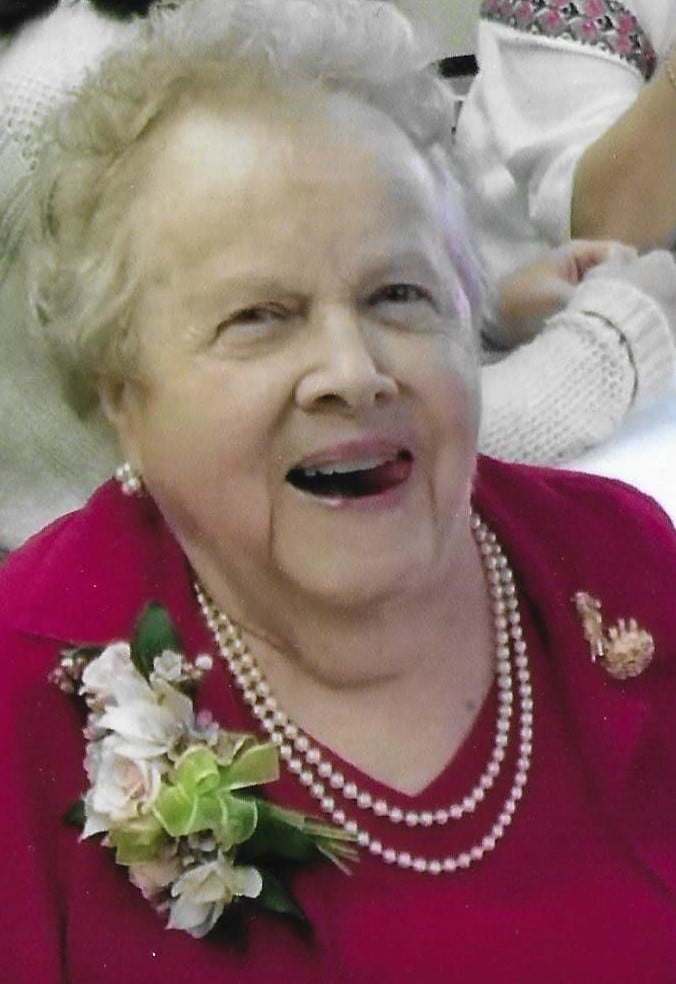
Lolita Kachel
DNR names Whitewater resident State Natural Areas Volunteer Steward of the Year
(Originally published Sept. 22, 2021.)
The Wisconsin Department of Natural Resources (DNR) recently announced Whitewater resident Ginny Coburn as the 2021 State Natural Areas Volunteer Steward of the Year for her work within the Southern Kettle Moraine State Forest.
Describing Coburn as “driven by a passion for nature and ecology,” the release noted that Coburn began volunteering at the Kettle Moraine State Forest in 2012.
According to the release, Coburn and fellow volunteers have provided thousands of hours of labor at Bluff Creek, Kettle Moraine Oak Opening, Whitewater Oak Opening and Clover Valley Fen State Natural Areas in the Kettle Moraine State Forest, including removing brush, controlling invasive plants and collecting and sowing native prairie seeds. Coburn also serves as a contact for monthly workdays and greets and signs in volunteers.
“Ginny has had an important role in protecting and restoring some truly amazing prairies, springs, oak openings and fens in the Kettle Moraine,” said Jared Urban within the release. Urban serves as the DNR’s volunteer program coordinator for state natural areas. “She was the first one to say yes to starting volunteer workdays to remove invasive plants in the Kettle Moraine and has been essential to keeping monthly workdays going,” he added.
With nearly 10 years of volunteering at Kettle Moraine State Forest, Coburn possesses a wealth of knowledge, the release continued, including safely wielding a chainsaw, collecting seeds and controlling invasive plants. Coburn is also instrumental in engaging others in this vital work, including her grandchildren who have volunteered alongside her on various projects.
Coburn’s deep community connections helped her recruit individuals and organizations for special projects, including a cooperative project to install a boot brush at Bluff Creek to prevent anglers from inadvertently spreading aquatic invasive species.
“Everyone likes Ginny. I most admire her energy to help make things happen. She is always ready to learn and is a let’s-go-do-it kind of person,” Urban said.
In addition to seeing great progress at state natural areas in Kettle Moraine State Forest, one of Coburn’s favorite parts of volunteering is the people she’s met along the way, the release noted.
“They are fun and knowledgeable and will come out and help or work in any weather,” Coburn was quoted as saying in the release. “We learn a lot from each other and have a very enjoyable time. We feel like we’ve done good work toward a really big goal,” she added.
Become a volunteer
State natural areas are designated to conserve the best of Wisconsin prairies, forests, wetlands and other habitats. These unique places support 90% of rare plant species and 75% of rare wildlife species. Nearly all properties are open to the public to enjoy while bird watching, hiking, hunting and fishing.
The Wisconsin DNR is actively recruiting volunteers to help care for these unique places. No experience is necessary, and training and equipment are provided on-site.
To learn more about the DNR’s state natural areas volunteer program and receive workday notifications, visit: https://dnr.wisconsin.gov/topic/Lands/NaturalAreas/volunteer.html.
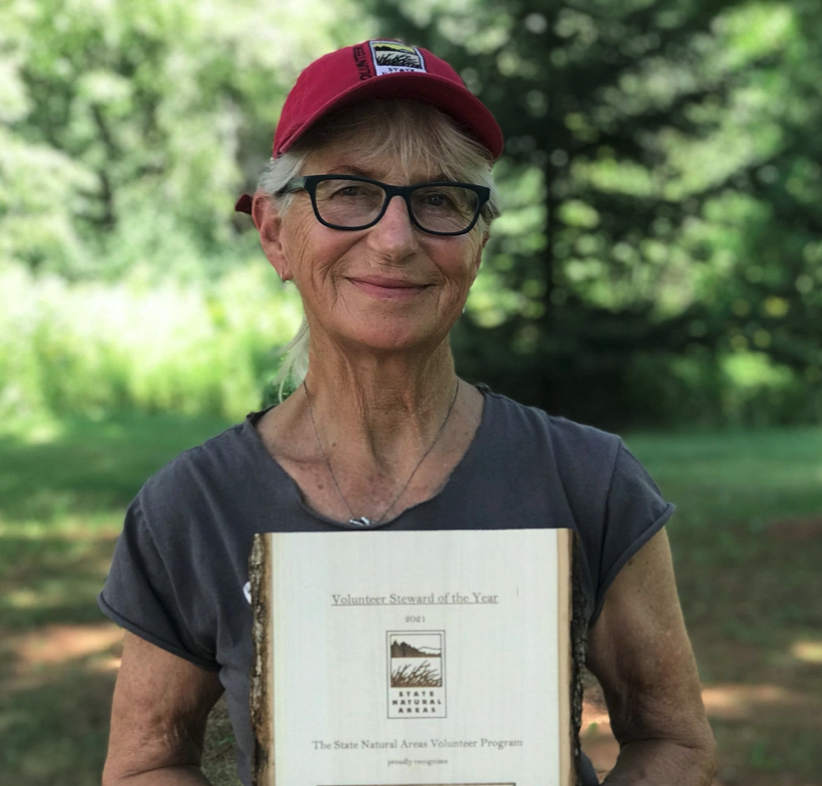
Ginny Coburn, Whitewater, has been named the 2021 State Natural Areas Volunteer Steward of the Year for her work to help restore state natural areas in Kettle Moraine State Forest. Photo credit: Scott Farrell/contributed photo.
UW-Whitewater sees increase in freshmen enrollment, overall enrollment ‘slightly down’
(Originally published Sept. 23, 2021.)
The University of Wisconsin-Whitewater has welcomed its largest freshman class in four years, with 1,873 new freshmen enrolled for the fall 2021 semester (2021-22 school year).
According to a recent press release: Total enrollment at the university is 11,447, with 10,804 students at the Whitewater campus and 643 students at the Rock County campus.
The figures represent preliminary enrollment numbers taken on the 10th day of instruction. Final figures are expected to be available later in the fall semester.
“We’re elated to see students once again engaged in learning in the classrooms and laboratories, and competing on the athletic fields,” Jim Henderson, interim chancellor, said in the release. “We know how important in-person instruction is to our students and 83% of our undergraduate classes offer them that experience. There is a wonderful energy permeating the campus this semester with many athletic and social events.
“While our overall enrollment is down slightly, the larger freshman class and other recruitment successes point to a positive trajectory for our enrollment moving forward,” he added.
The School of Graduate Studies is seeing it’s largest class in history, with 1,683 students pursuing master’s and doctoral degrees and certificates, an increase of 116 students from last year, the release continued.
With the fall 2021 semester underway, UW-Whitewater already is accepting and processing applications for the fall 2022 semester. Students applying for undergraduate admission can do so at no cost, and ACT/SAT test scores continue to be optional as part of the university’s comprehensive review process.
The admission application also serves as a student’s application for many new student scholarship opportunities. Daily campus tours are available at the Whitewater campus and weekly tours at the Rock County campus.
New this year, UW-Whitewater is part of a $1 million initiative to help guide high school students in preparing for, applying to and enrolling in one of the UW System’s 13 universities. UW-Whitewater pre-college coaches will start this fall semester and work in Beloit Memorial, Beloit Turner, Janesville Craig, Janesville Parker, Badger (Lake Geneva), Bigfoot (Walworth), Delavan-Darien and Elkhorn high schools.
“Our counselors are excited to engage earlier with students as they explore their college options across the UW System and find the appropriate education pathways that align with their career interests,” Matt Aschenbrener, associate vice chancellor for enrollment and retention, said within the release. “The focus of the pre-college pipeline initiative is to work with regional high school partners to identify and prepare under-represented and underserved students to help them be successful at the university and beyond. We are fortunate to be working with 8 of the 25 high schools involved with this project,” he added.
For more information on enrollment and UW-Whitewater data, visit the Institutional Research and Planning website at uww.edu/irp.
Following are some statistics as shared on the UW System and UW-Whitewater websites.
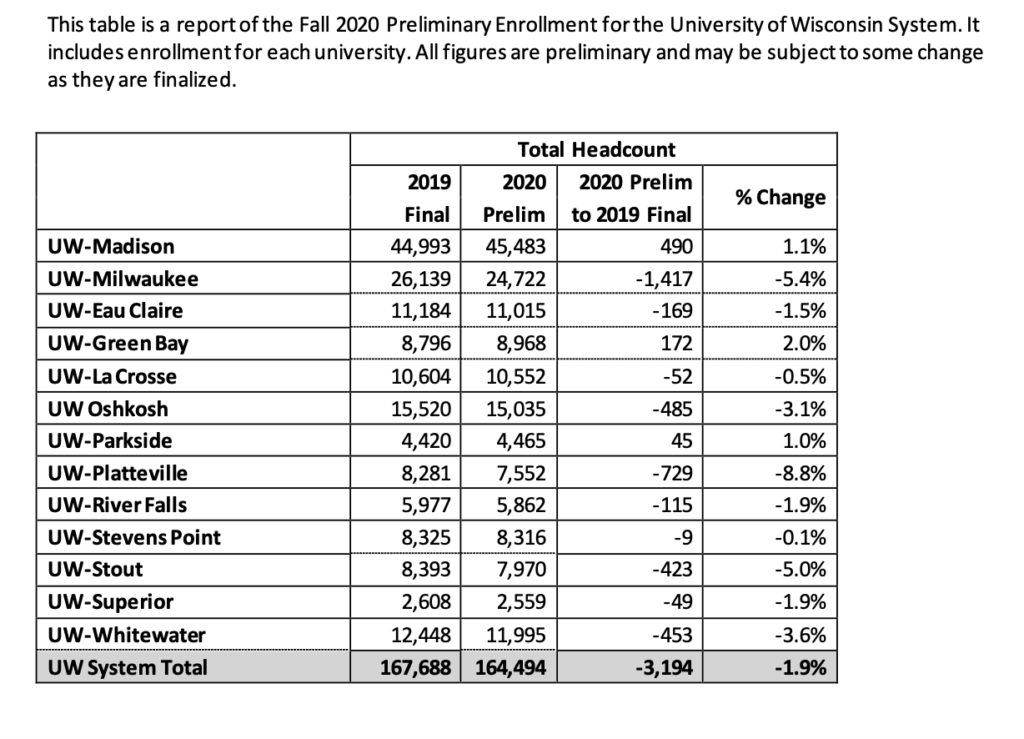
The table above, as suppled on the UW System website, shows the percentage change between final student headcount in 2019 and preliminary headcount in 2020. Schools showing the largest decline in headcount over the two years are: UW-Platteville (8.8%), UW-Milwaukee (5.4%), UW-Stout (5%) UW-Whitewater (3.6%), and UW-Oshkosh (3.1%). Schools showing the largest growth over the two years are UW-Green Bay at 2%, UW-Madison (1.1%) and UW-Parkside at 1%. Systemwide, the chart indicates an overall decline in headcount of 1.9%. The chart and associated links are found here: https://www.wisconsin.edu/news/download/UW-Preliminary-Enrollment-Totals-2020.pdf. Public schools across Walworth and Jefferson counties and UW-Whitewater began engagement with COVID-19-related learning systems in March of 2020.
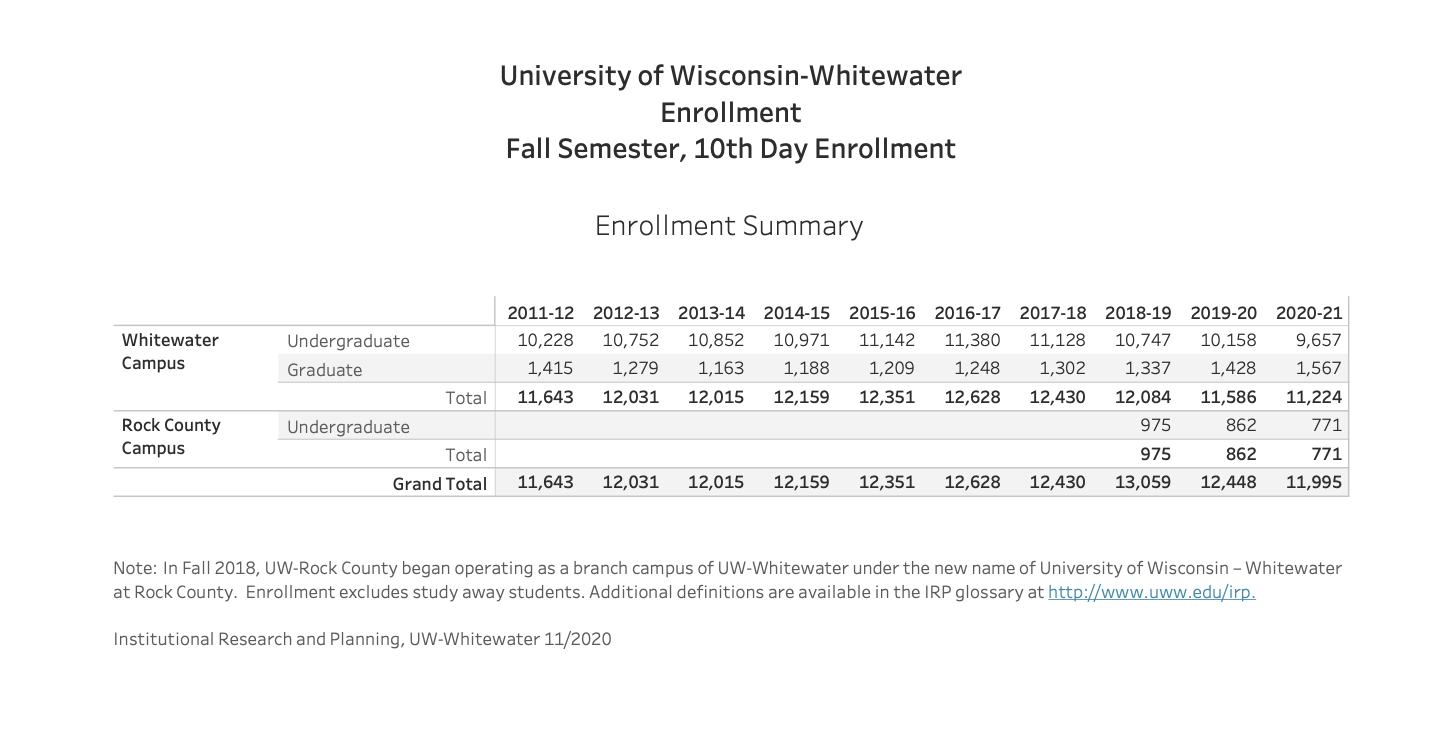
The chart above, as supplied on the UW-Whitewater website, shows UW-Whitewater fall semester, 10th day enrollment totals beginning with the 2011-12 school year through to the 2020-21 (last) school year. Figures for the 2021 fall semester, which is part of the 2021-22 school year, are, according to a recent press release, as follow: Total enrollment at the university is 11,447, with 10,804 students at the Whitewater campus and 643 students at the Rock County campus. While these numbers are preliminary, and continue to show an overall enrollment at UW-Whitewater that is “down slightly,” an increase in freshmen enrollments show “a positive trajectory for our enrollment moving forward,” Jim Henderson, interim chancellor, noted within the release. The chart and associated links are found here: https://www.uww.edu/documents/ir/University%20Data/Enrollment/Enrollment%20Summary.pdf.
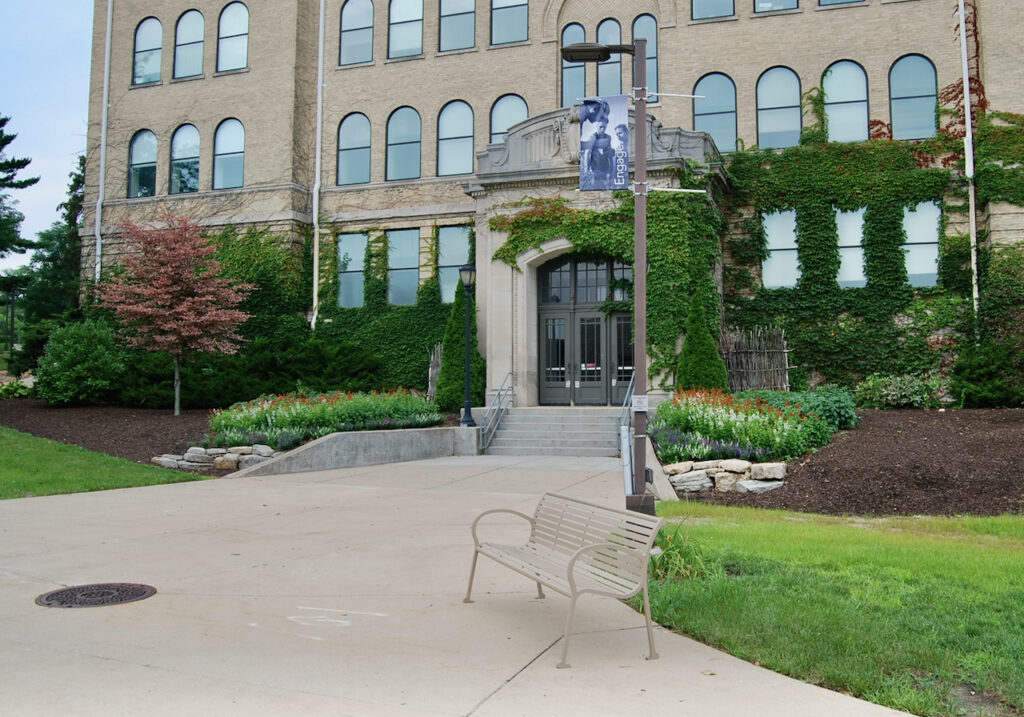
UW-Whitewater, file photo/Kim McDarison
Cravath, Trippe lakes restoration plans on schedule, city manager says
(Originally published Sept. 25, 2021.)
By Kim McDarison
Whitewater City Manager Cameron Clapper delivered virtually Thursday an annual “State of the City” address which included an update of plans underway to restore Cravath and Trippe lakes.
The hour-long virtual forum was hosted by the Whitewater Area League of Women Voters and featured annual addresses about the state of the city and the Whitewater Unified School District.
Cravath and Trippe lakes are part of a connected water system which is impounded by a small dam located in Whitewater’s downtown. Both have been drawn down for nearly two years as part of the city’s plan, according to city officials, to revitalize the lakes to better serve the community for recreational use. The system stretches from the downtown area into adjacent neighborhoods on the southeast side of the city.
An unusual downtown landscape
Dominating the downtown area’s southernmost sector, Cravath Lakefront Park was, according to the city’s website, built in the 1990s to serve as an open space and encourage visitors to the downtown area. The park, overlooking Cravath Lake, is home to Cravath Lakefront Community Center and a bandstand, and is often used for community celebrations, concerts, and weddings.
Today, ornamental concrete, walkways and benches, which once accentuated the lake, grace what appears as a vast field of wetland vegetation, creating an unusual landscape where once stood a lake.
The growth has been developing in the lake beds since the water was drained in anticipation of restorative dredging. The lushness and rapid rate of vegetation growth, Clapper said during his address, was a tribute to the nutrient-rich soil the extended lakebed offers.
Even as the new landscape takes hold, both Clapper, during Thursday’s address, and Whitewater Parks and Recreation Director Eric Boettcher, during a presentation made about the project to the Whitewater City Council in August, have said that plans to restore the lakes remain underway and on schedule.
Filled with sediment
Aided by slides during Thursday’s presentation, Clapper described capturing the lakes for recreational use as “an ongoing challenge.”
He cited the lakes as both “beautiful and valuable water resources,” but, over time, he said, because the lakes are impounded, they were subject to the formation within their beds of increasing volumes of sediment.
That sediment, he said, as it filled the lakes, gave rise to opportunities for invasive species to grow in large proportions throughout the lakes, making them, he added, “undesirable for navigation or really for other water recreation and activities. So we are … draining them to rehab the lakes.”
Using a series of photographs taken of the two-lake system as it was drawn down, Clapper said that now, in the second year of drawdown, what he termed as “greenery” was covering most of the lake beds with a small stream of water still running through.
“That stream is actually removing sediment in an area that we will utilize as kind of a base point for dredging,” which, he said, was slated to take place during the beginning of next year.
Once the work is done, he said, “these lakes can be more useful to the public.”
Sharing photographs of some of the more remote regions of the lakes, Clapper said: “We’ll be dredging portions of that area. An interesting thing to note: on the back end of the lake in this image, the area that is covered in water is actually that way partly because of the creek that’s flowing in, but also because of some natural springs that exist in that area. It’s been nice to see those springs and to be able to recognize where they are in the lake. With the murky water before, nobody could go out on a boat and enjoy that. We’re hoping to make that a much more enjoyable feature once we rehabilitate the lakes, where we can actually go out on a boat and see through clear water those springs on the lakebed.”
To achieve the city’s goals, Clapper said, a first step in the process is to kill or at least weaken some of the new growth that has been established in the lakebed.
“We have to remove some of this vegetation. And to do that, the first step is to spray a herbicide and do what we can to kill and weaken the vegetation,” he said, describing new lake vegetation as easily the height of a human being.
“We can’t burn that the way it is without risking loss of control of the fire, so we’ll weaken it with herbicide, kill some of it … and then initiate what’s called a controlled burn. And those events will happen throughout the month of October and into even November, and possibly December of this year. And then the ground will be frozen, we hope by then, and we will move onto dredging beginning possibly in January,” he said.
According to Clapper, dredging would take place likely between January and March, and water would be returned to the lakes perhaps by early or late July of 2022.
“So they (the lakes) will be back to something we can all swim in or look in or navigate with a boat by the end of next year,” he said.
Low water levels desired, project progressing smoothly
In August, Boettcher shared similar slides as those used by Clapper, calling the photographs a snapshot of where the project stood and “a wrap-up of our last four years.”
Presenting information to the city council, including aerial photos of the lakes taken in 2019, Boettcher said they documented what he described as “a lot of vegetation on top of the water,” including “green slime.”
He drew comparisons between aerial photos taken of the lakes in both 2019 and August of this year, noting what he described as “a drastic difference,” between the two snapshots in time, which, he said, resulted from the drawdown. In August, he said, slides taken that month showed that water within the system had been drawn down, leaving no more than a stream of water flowing through the center of the lakes. The rest of the bed had grown up in vegetation.
Showing an aerial of the bed near Cravath Lakefront Park taken in August, Boettcher said the nearly empty bed was a desired result as the city prepares for lake dredging.
Boettcher shared similar slides of Trippe Lake, noting that in July of 2019, the lakebed was filled with water, while in August of 2021, the bed was drawn down, showing small traces of water moving through the vegetation.
Boettcher said pictures in August showed water levels were “brought down to where we would hope to,” adding, “This project is going along pretty smoothly.”
Boettcher said drawings and other pertinent information about the project had been submitted to the state Department of Natural Resources (DNR), which was a necessary step to gain the department’s approval for the city’s dredging permit.
Another slide presented by Boettcher showed the “planned dredging area,” which Boettcher said, is the area from which sediment will be removed from the lake beds. He also talked about what he called “staging areas,” noting that equipment used to dredge the lakes will operate from Cravath Lakefront Park and Trippe Lakefront Park, respectively.
“This is where we will remove sediment and mobilize to do the actual dredging project,” he said, adding that equipment will be moving in and out of the park areas.
Also identified were two deposit sites to which dredged material would be hauled, with one planned for an area east of and adjacent to the Innovation Center, located in the city’s industrial park.
“This is set up so we have a dewatering area and we have one spot here where there is about 5,000 cubic yards of sediment that we have to dispose of properly and cover with two feet of fill. The rest is all good sediment that we can remove and deposit in other areas,” he said.
A second spot identified by Boettcher to receive dredging spoils is property owned by Whitewater resident Geoff Hale. The property is near Cravath Lake, Boettcher said. He described the property as “a great addition to our project,” adding, “the nice part about having these two sites is that there’s more than enough land to deposit the 87,000 cubic yards we are looking at doing.”
Beottcher further noted that dredging contractors are sometimes interested in keeping the dredging spoils, in which case, he said, the sites will not be needed. However, he said, DNR approval of the dredging permit requires that the city has sites identified to receive the spoils.
Looking at project costs, Boettcher said, Phase 1, which was the project planning and water level drawdown phase, as calculated between Jan. 1, 2017 and August 17, has so far cost the city $102,893.
Included within resources used to offset costs associated with Phase 1 are some funds which were supplied through a $25,000 grant, he said.
“We currently have $1,328,000 in the budget to remove the 87,000 cubic yards (of dredged spoils)” he said.
At $1.3 million dollars, Boettcher identified Phase 2 dredging as “the most expensive cost element of the project.”
Looking at the remaining timeline for the project, he said, the lakes will remain drawn down in 2021. The DNR permit application process is expected to complete sometime between late September and early October of this year. The dredging project is anticipated to go out for bidding this fall. A controlled burn of the vegetation in the lake beds is scheduled for November, with dredging possibly beginning this winter. A second controlled burn of any new or emergent vegetation in the lake beds is anticipated to take place in April of 2022.
Dredging would be expected to continue into next year, potentially through January, February and March, Boettcher said.
Using that schedule, he added, he would anticipate refilling the lakes with water in June of 2022.
Responding to questions asked by council members is August, Boettcher said the Whitewater Community Foundation had expressed interest in helping to support the project through the funding of what he termed “enhancements,” offering as example boat launches.
“There is also grant funding available for that, but the community foundation is looking at helping support this project because the lakes are a lively part of our community. The more financial help we can get, the more projects we can get done along the lake,” he said.
Boettcher also addressed a question about the potential for eradicating carp populations in Cravath and Trippe lakes. While procedures to achieve that goal exist, they could cost as much as $10,000 and would not likely bring about the desired changes in the fish population for more than a year, he said, adding that the lakes are part of an “open water system,” meaning that carp could return to the lakes by swimming upstream or downstream using connecting water channels.
He described the solution as “not really worth our investment to remove them at this time.”
At council’s urging, he said, he would continue to explore solutions.
The full update as presented by Boettcher in August is here: https://vimeo.com/589042556?ref=em-share.
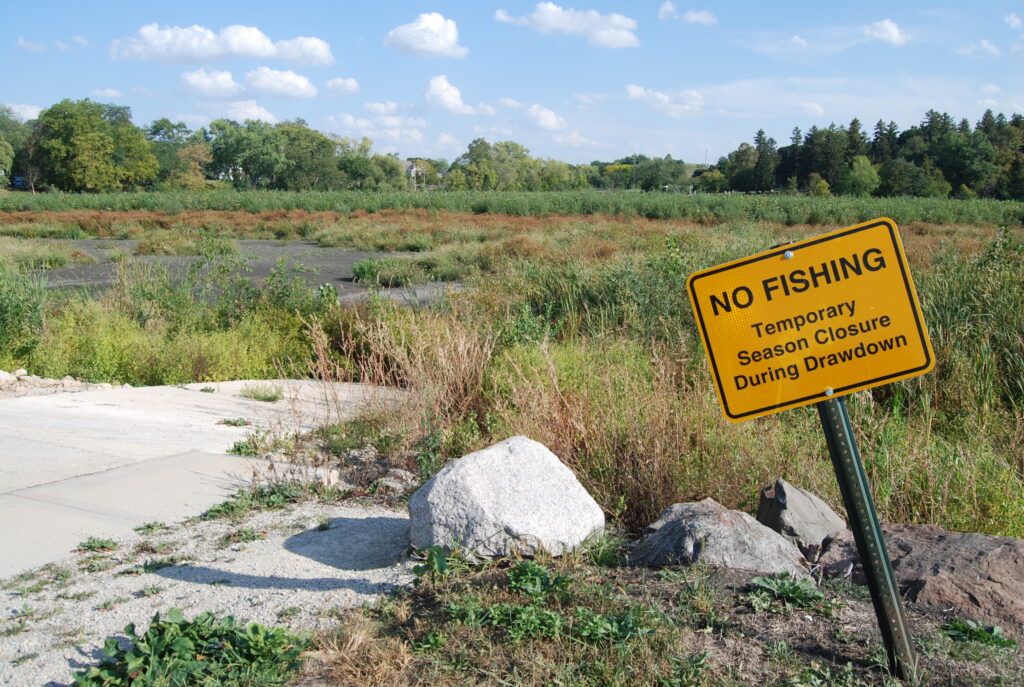
Signage alerts would-be fishermen that Cravath and Trippe lakes are closed. The concrete slab, at left, is a launch that once offered Cravath Lake access to boaters.
Kim McDarison photo.

An ornamental concrete shoreline denotes where Whitewater’s downtown Cravath Lakefront Park once met with the water of Cravath Lake. A sea of seven-foot-tall plants today engulfs the promenade.
Kim McDarison photo.
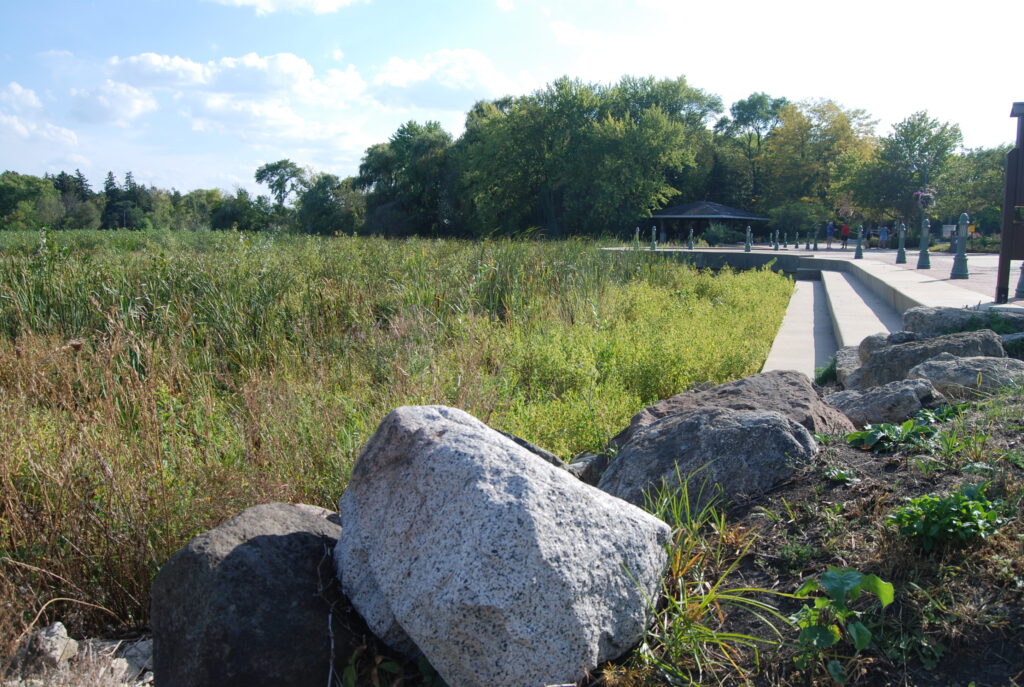
Vegetation covers the Cravath Lake bed. Kim McDarison photo.
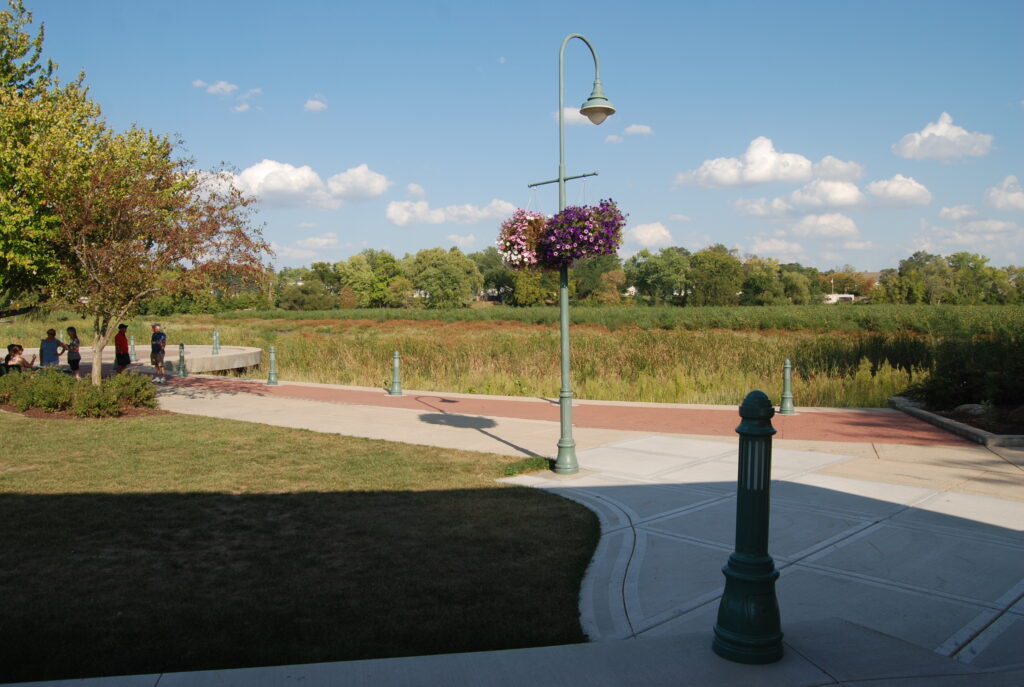
Visitors to Cravath Lakefront Park find a new landscape. Kim McDarison photo.
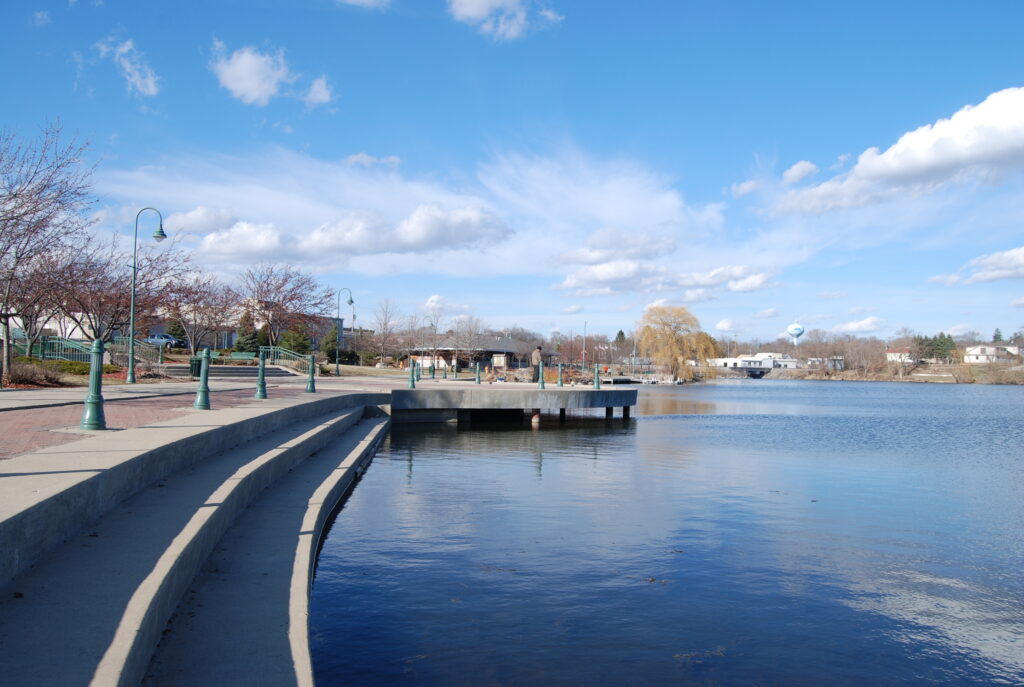
Cravath Lake where it meets the shore at Cravath Lakefront Park. The photo was taken on a crisp spring day in 2015. Kim McDarison photo.
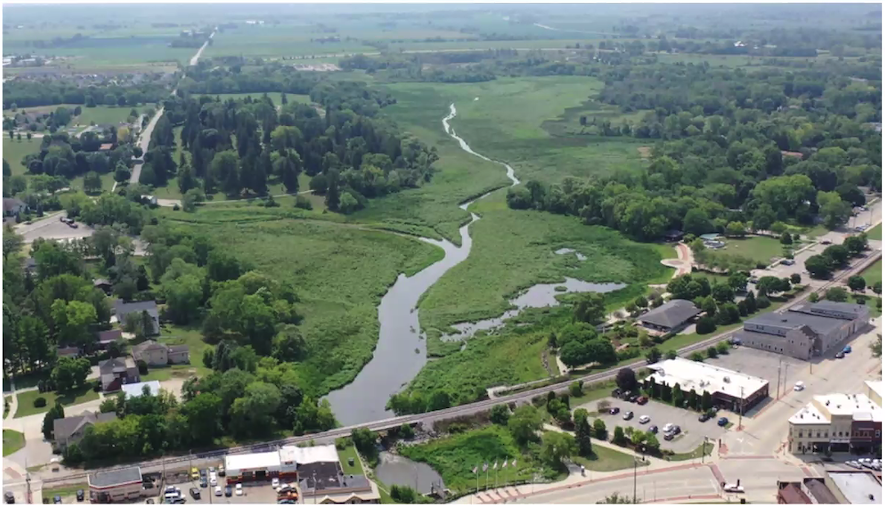
An aerial view of Cravath and Trippe lakes showing receding water and encroaching vegetation. The drawdown is part of a process designed to make the lakes more functional for recreation. The process is anticipated to complete, with water returned to the lakes, by the summer of 2022. The aerial view was among slides shared by Whitewater City Manager Cameron Clapper during his State of the City address delivered virtually Thursday.
Whitewater school district highlights shared during ‘State of the District’ address
(Originally published Sept. 26, 2021.)
By Kim McDarison
The Whitewater Area League of Women Voters State of the City and School District forum was held Thursday, Sept. 23.
Whitewater Unified School District Superintendent Caroline Pate-Hefty and Whitewater City Manager Cameron Clapper each shared presentations about the school district and city, respectively. Questions were taken after each presentation from the moderator and members of the audience.
The hour-long forum was presented using a virtual format and moderated by League Co-President Mary Beth Byrne.
Following is the “State of the District” address as delivered by Pate-Hefty. The “State of the City” address will be reported in an upcoming story.
A portion of the State of the City address, focusing on the water drawdown project underway at Cravath and Trippe lakes is here: https://fortatkinsononline.com/cravath-trippe-lakes-restoration-plans-on-schedule-city-manager-says/.
District highlights
Aided by a slide presentation, Pate-Hefty noted that with the completion of her first year as the district’s superintendent, there was much activity to report.
Among highlights of the past year, she said, was an achievement of Lincoln Elementary School Principal Mary Kilar, who was one of 16 statewide winners of the Herb Kohl Educational Foundation 2021 Principal Leadership Award. As a winner, Kilar was awarded a $6,000 grant which, Pate-Hefty said, Kilar will be applying to her school.
She next pointed to the achievements of the district’s music teachers who collectively were honored with the Best Communities for Music Education award in 2021 from the National Association of Music Merchants (NAMM) Foundation. The honor has been earned by Whitewater music staff in previous years, she said, listing such years as 2012, 2014, 2017, 2019 and 2020.
She talked about changes within the district brought about by COVID-19, some of which, she said, helped the district create “new traditions.”
She cited “great feedback from our students and their families,” in response to the district’s decision to hold this year’s high school graduation ceremony outdoors. The ceremony was the last celebration held, she said, on the old high school football field, which, she noted, has since been updated and is today called the stadium field.
Some 141 graduates from the class of 2021 “made it through a tough year,” she said, adding that during graduation, they “were outside celebrating.”
On June 10, Pate-Hefty said, the district honored “retirees from two generations of retired teachers,” including those retiring in 2020 and 2021.
“There is a tremendous amount of service and history that go with these teachers; over 537 years of service in changing students’ lives,” she said.
She pointed to a production of “Madagascar Junior,” a play performed by summer school students between July 8-10. The district’s summer school students attended classes at the high school this year between June 21 and July 2, and July 5 and July 16, Pate-Hefty said.
Some 609 students participated in summer school, she added, describing summer school enrollment as a return to “good numbers.”
Looking at athletics, she said, upgrades were made to the high school’s football field.
A turf groundbreaking ceremony was held on July 26.
“We took some problematic areas of turf that were causing us water problems and cancelations — we were struggling to keep water flowing off of them — so we took those areas and we’ve done some revamping and turfing to help us out with that water flow.
“The turf stadium, which used to be called a football field … is now soccer and football, so we refer to it as ‘The Stadium,’” she said.
Currently, Pate-Hefty said, the district is engaged in a planning process, focusing on upgrades to the high school’s softball and baseball fields, describing those plans as “a second part of the project that just initiated.”
She said the district hopes, after achieving its upgrades, that it will be able to host larger events than it has in the past. Plans call for the further involvement of “other sports teams, in collaboration with the university and with Treyton Field, so it really can open us up for additional large events,” Pate-Hefty continued.
Additionally, she said, this year, the district also was able to “highlight teachers as they’ve returned.”
She said the district has a number of teachers who “have been with us for an amazing amount of years.
“I was really proud to give away that 30-years-of-service award, along with the others.”
Last year, she said, for those who watched her (State of the District) presentation, “we talked about doing school really different. And this year, while we still have COVID plans and precautions, we really wanted to get back to some of our traditions that make kids feel welcome in school buildings and so you will see that we are a mask optional school district at this time, and so we worked very hard to make sure that that’s the comfort level because students feel both ways about what makes them feel safe.”
Pate-Hefty continued: “So we’ve worked hard to make sure everyone is comfortable in this process and it’s been a fantastic start of school, and we are getting to see some of those traditions that we didn’t see at the start of school last year, and kids are really enjoying it.”
Sharing a slide, Pate-Hefty pointed to a collage of photographs showing the celebration of the new Stadium Field held Sept. 10. She described the enthusiasm and turnout for the opening of the new field as “fantastic.”
Also this year, she said, the district has four 2022 Herb Kohl Teacher Fellowship nominees, including Sara Sixel, Greg Steward, Stacey Joseph and Whitney Updike.
Looking at school financing, she cited a need for advocacy at the state level to make sure there is financial support for all students, “so we can make all kids successful as we begin to work through a population — about 30% of students that have English language needs and 15-20% of students with disabilities. So we need that financial support to make sure things work for them.”
“But,” she continued, “we are a district that works hard to make sure that we’re being fiscally responsible with your funds.” Pointing to a slide showing property tax mill rates between the 2011-12 and the 2020-21 school years, she said: “You can see last school year —we don’t have those projections quite yet for this year, but we have projected a mill rate of 11.97 and we are able to relook, cut and carefully watch our spending, and we were able to bring that down and give that back to our taxpayers.”
Pate-Hefty said the district this year has an estimated budget of about $27 million.
The district has also recently hired a new business manager, Pate-Hefty said.
The new business manager, Benjamin Prather, was listed among presenters at the forum by the League of Women Voters in information released in advance of the event.
Prather did not present information during the event.
“You’re going to be seeing his face around town soon,” Pate-Hefty said, adding that among his duties will be updating the district’s budget and website.
Returning to the slide, she said, “state level funding is really important for us. You can see how that hasn’t changed much,” she said noting that balancing available funding with student needs is a continuing district priority.
Through COVID, she said, the district learned that the staff had “grit,” and, she said, “that we were a family, and even when the world got kind of difficult, and messaging was tough around education, we gathered together and made it count, every student, every day, in a unified way, and that’s really our mission and vision.”
Questions
As moderator, Byrne asked two questions of Pate-Hefty:
Said Byrne: “I believe there are two social workers who have been working with students who went out of district, so how are we doing?”
She asked if students were returning to Whitewater schools, further inquiring about increases in homeschooling.
Pate-Hefty, responded, saying: “I would say that we have not had a significant increase in homeschooling. That’s a difficult number; we have to make sure that families registered specifically for homeschooling. As far as overall numbers, although the count is not considered finalized, at this time — there are a couple school districts in the state that have to register their numbers in order for us to finalize ours — but it looks like we have an increase of about 80 students from last year. And that’s exactly the direction we hope to be moving as a district.”
Byrne asked: “Has there been any feedback that you got from parents in terms of the approach with masks, or no masks, or options?”
Pate-Hefty said: “Yes, lots of opinions in both directions. We had a strong show and feedback from families early on that choice was important to our families, that they can make choices as families,” she said, adding that working to create policies about masking has been stressful for “a lot of school boards.”
According to information released in advance of the forum, the event was live-streamed on the LWV-WW Facebook page: facebook.com/lwvwhitewater.org, and has been recorded for future broadcasting on the City of Whitewater local access Channel 990.
For more information about the league, visit its website: https://my.lwv.org/wisconsin/whitewater-area.
Following are some of the slides presented by Pate-Hefty.

A slide as presented by Whitewater Unified School District Superintendent Caroline Pate-Hefty enumerates upgrades made or planned to be made to high school athletic fields.
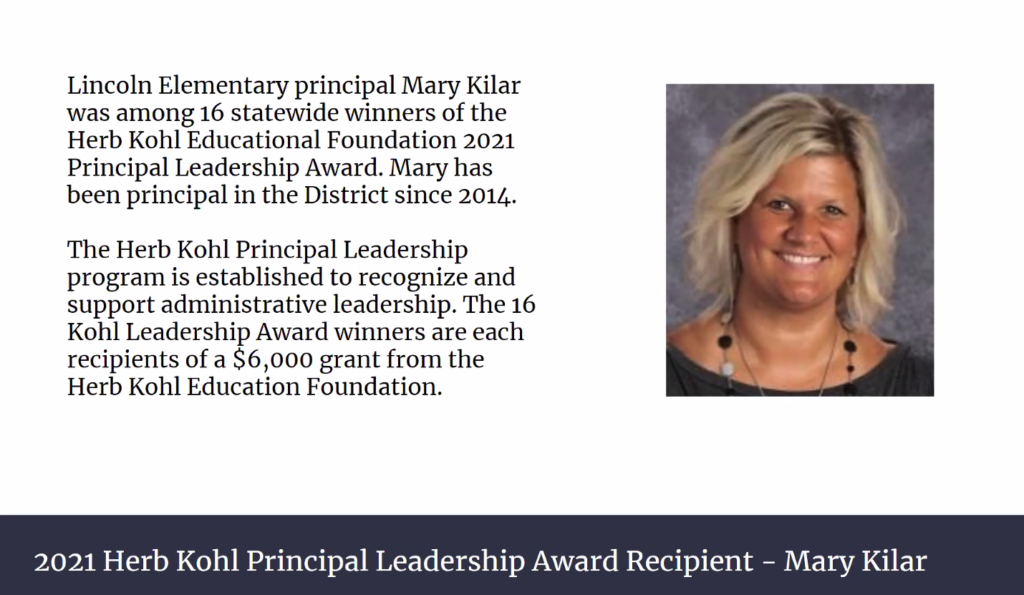
A slide highlights the achievement of Lincoln Elementary School Principal Mary Kilar who was selected as a 2021 Herb Kohl Educational Foundation Principal Leadership Award winner.

A slide highlights the achievements of the district’s music teachers who have been selected collectively as the recipients of the 2021 Best Communities for Music Education designation given by the National Association of Music Merchants Foundation.

The above slide, shared by Pate-Hefty during her presentation, highlights four nominees for the 2022 Herb Kohl Teacher Fellowship award.
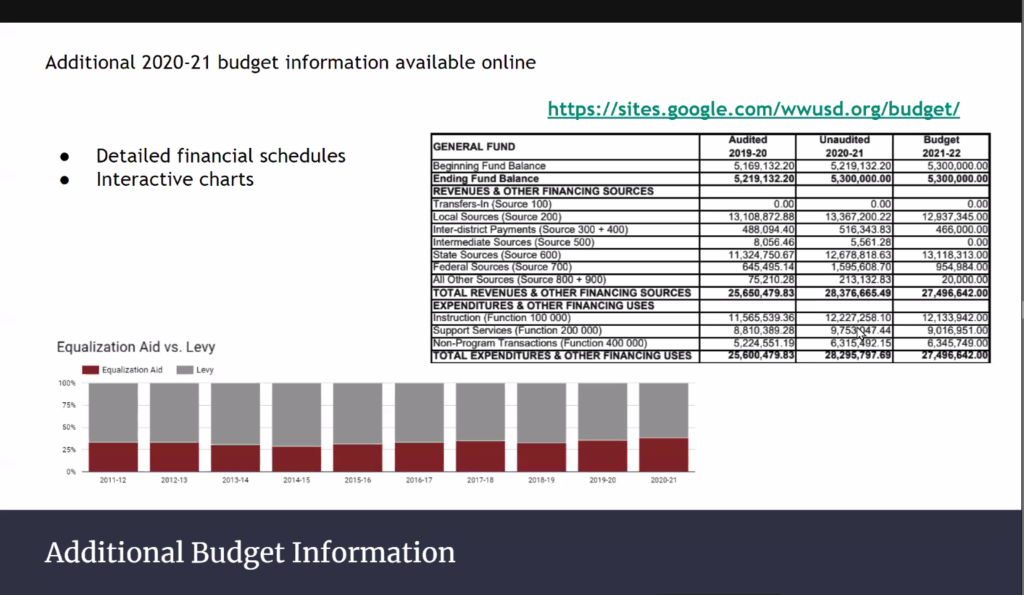
The above slide, as shared by Pate-Hefty shows a total budget calculation for the 2021-22 school year at approximately $27.5 million. The calculation is slightly down, the slide shows, from an unaudited 2020-21 calculation of $28.3 million. Looking at the bar chart, showing the varying levels between state equalization aid received by the district and the taxpayer-funded levy, the chart indicates, as Pate-Hefty noted during her presentation, that the levels of aid received by the district have not changed significantly over the last 10 years. The above chart, showing budgetary figures, is more easily viewed here: https://sites.google.com/wwusd.org/budget/2021-22-budget/original-budget-august.
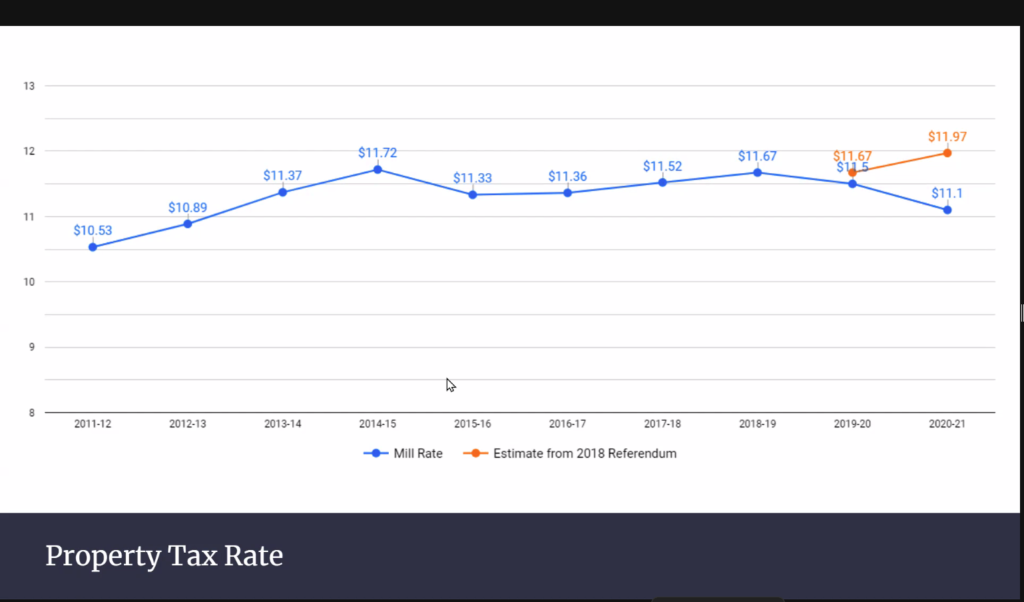
A slide shows a 10-year history of the mill rate collected from property owners within the district. The slide highlights a change in the projected mill rate, which, Pate-Hefty said during her presentation, had come in lower last year than initially projected. According to the chart, the 2019-20 district budget was supported by a tax contribution calculated using a mill rate of $11.5. The rate was initially projected during the budget formulation process at $11.67. Calculations for the 2020-21 budget were initially made anticipating a mill rate of $11.97. The actual mill rate used was $11.1, according to the chart. During her presentation, Pate-Hefty said: “we were able to bring that down and give that back to our taxpayers.”
Mill rate, as defined by the Wisconsin Department of Instruction: “School district property taxes include levies for general operations, debt service, capital expansion and community services. Property values are equalized to reflect market value rather than local assessed value. The equalized levy rate is the total property tax levy divided by the current year equalized property value with tax incremental financing (TIF) values excluded. Levy rates are shown in “mills” or property tax dollars levied per $1,000 of equalized property value.”
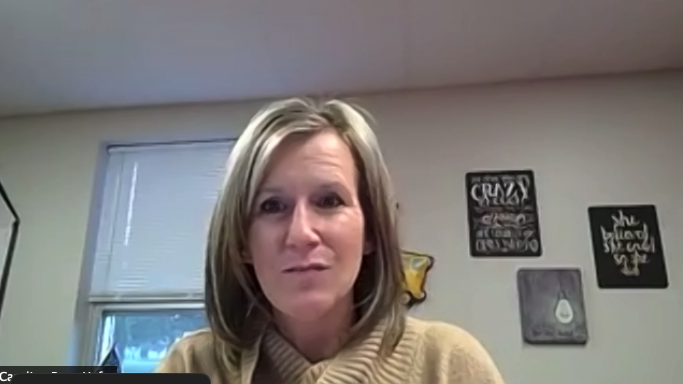
Whitewater Unified School District Superintendent Caroline Pate-Hefty gives the State of the School District address during the Whitewater Area League of Women Voters forum held virtually Thursday.
Partners in Play program kicks off
(Originally published Sept. 29, 2021.)
By Kim McDarison
A new early development program, Partners in Play, debuted Tuesday at the the University of Wisconsin-Whitewater Community Engagement Center, 1260 W. Main St., Whitewater.
Several families with children ages 2-5 arrived at 10 a.m. for the first in a series of weekly sessions planned to run through mid-November.
Upon arrival into the early development classroom, visitors were asked to remove their shoes before exploring the many colorful and tactile opportunities designed to engage youth, as they partnered with educators for both group and individualized guided learning experiences.
Tuesday’s focus was on learning about healthy foods by color. Other sessions will explore such topics as emotions, body movement, light and shadows, and relaxation techniques, among others.
Newly hired Whitewater Unified School District (WUSD) Family/Community Engagement Coordinator Molly Fuller has been instrumental in helping to develop the program.
Placed in her position this past summer, she said, before taking the job, she served within the WUSD as a paraprofessional, working within the district’s elementary schools.
“The students I worked with had educational needs, emotional needs, experiences with trauma, and the like. School was their safe space,” she said. “I always worried about the children before they were of school age and wondered where their safe space would be,” she noted, adding that her new position offered an opportunity to address those concerns while also providing enrichment to a broader preschool community.
The program focuses on creating a fun and developmentally sound opportunity for families while supporting children and parents, Fuller said.
Prior to Tuesday’s kickoff, the program was in the planning stages for about three months, she said, adding that finding partnerships with the UW-Whitewater Early Childhood Department, headed by Dean Robin Fox, who was on hand Tuesday to greet families and mingle with preschoolers, and PremierBank, which provided support including a bilingual translator, has brought a more inclusive and dynamic element to the curriculum.
“I wanted to make sure that any child, no matter income or language barrier, could come and enjoy Partners in Play,” Fuller said.
The school district serves a student population in which at least 30% of students and families can benefit from translation services, she said, adding that the program is open to families with children in two age blocks: birth to 2, and 2-5. Parents of 2-year-olds have the option of placing their children in either session, depending upon their child’s perceived maturity level.
Another aspect of partnering with the UW-Whitewater, Fuller said, is that university students, who are pursuing a career in the field of eduction, work with the preschoolers. The collaboration is valuable to both sets of students.
“University of Wisconsin-Whitewater Early Childhood Education Program professors, along with the students in the program, create and teach the sessions. This not only helps the university students have hands-on experience before heading out into the field, but creates state of the art sessions for families,” Fuller said.
Thanks to these collaborations, Fuller added, the Partners in Play program is unique in the broader Whitewater area, and has attracted families from outside of the community.
“Half the families who have signed up are from other towns. That shows how much a program like this is needed, and the fact that it is in collaboration with UW-Whitewater makes it one of a kind,” Fuller said.
Also on hand to greet program participants on Tuesday were interim UW-Whitewater Chancellor Jim Henderson and WUSD Superintendent Caroline Pate-Hefty.
Emphasizing the program’s value to preschool-aged students, Pate-Hefty said: “Every second, the children of our community are learning, exploring and growing. We don’t want to miss a single opportunity to partner with their families to watch and support that process. The classes — Partners in Play — are open to any children birth through age five and their caregivers, from all of our surrounding areas. The curriculum for these sessions was created and will be taught by WUSD staff and the Early Childhood Education Program faculty and students from UW-Whitewater.”
“Early childhood programs in general, and Partners in Play in particular, provide young children the opportunity to engage in both social learning and developmental engagement,” Henderson said. “Such interactions have shown to lead to better experiences in K-12 and a higher rate of lifelong learning. The socialization part of the program plays a key role in development, and is even more important given the isolation that has taken place for many families during the COVID pandemic. The Partners in Play classroom provides a stimulating environment that will support multiple modes of learning, provided in both English and Spanish,” he added.
Henderson described the collaboration as an example of the type of success that is gained when community members come together, providing resources that each organization, individually, would likely not be able to provide.
“The University was pleased to provide space for the program, some funding for furnishing the space and equipment, and expertise from our College of Education and Professional Studies. Molly Fuller, the director of the program, and Dr. Caroline Pate-Hefty were crucial in seeing the development through from its inception, solving problems along the way. Community members such as (WUSD Board of Education member) Larry Kachel also played a major role in ensuring that this concept resulted in a community asset. Finally, PremierBank also provided support, including bilingual staff members who will be crucial to the success of the program. This is a true community effort that will provide invaluable support to families in our area with young children,” Henderson said.
Partners in Play is offered to families with preschool-aged children throughout the area free of charge.
Topics for each session include: week 1, “Rainbow of Foods,” exploring healthy foods by color; week 2, “Crunch and Munch,” exploring healthy foods by texture; week 3, “If You Are Happy and You Know It,” exploring emotions; week 4, “Moving and Grooving,” big body movements; week 5, “Roll Baby Roll,” exploring things that roll; week 6, “Into the Light,” light and shadow explorations; week 7, “Cool as a Cucumber,” relaxing our bodies, and week 8, “Head, Shoulders, Knees and Toes,” featuring body awareness.
Parents and guardians interested in having their children participate in the program can sign up at wwusd.org. Look for the Partners in Play link. Parents and guardians must stay with their children for the duration of the session. A limited number of spots are available within each session and will be filled on a first-come, first served basis.
For more information, contact Whitewater Unified School District Family/Community Engagement Coordinator Molly Fuller: mfuller@wwusd.org.
Following are photographs from Tuesday’s program kickoff.

A preschooler enjoys learning about healthy fruit and color during Tuesday’s first Partners in Play session.

A preschooler takes some time to explore the Partners in Play classroom located in the University of Wisconsin-Whitewater Community Engagement Center, 1260 W. Main St., Whitewater.

A preschooler and educator team up to sort healthy fruits and vegetables by color.

Aided by an educator, this young preschooler places healthy food items in a bag.
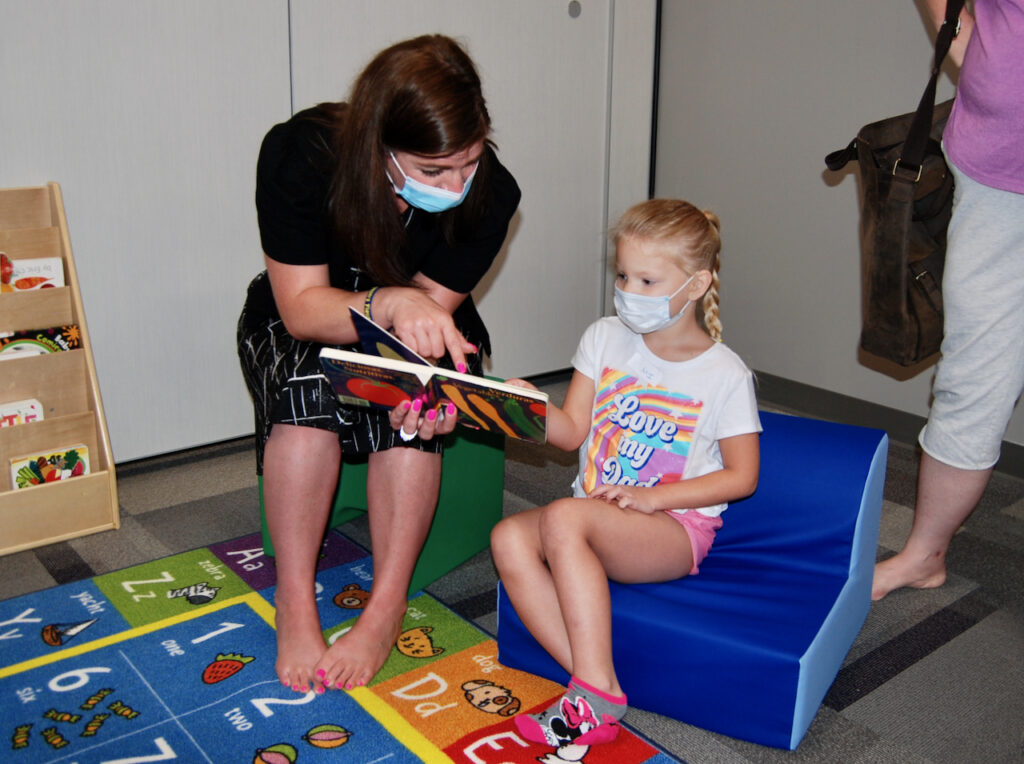
Whitewater Unified School District Family and Community Engagement Coordinator and Partners in Play Director Molly Fuller reads to a young Partners in Play participant.
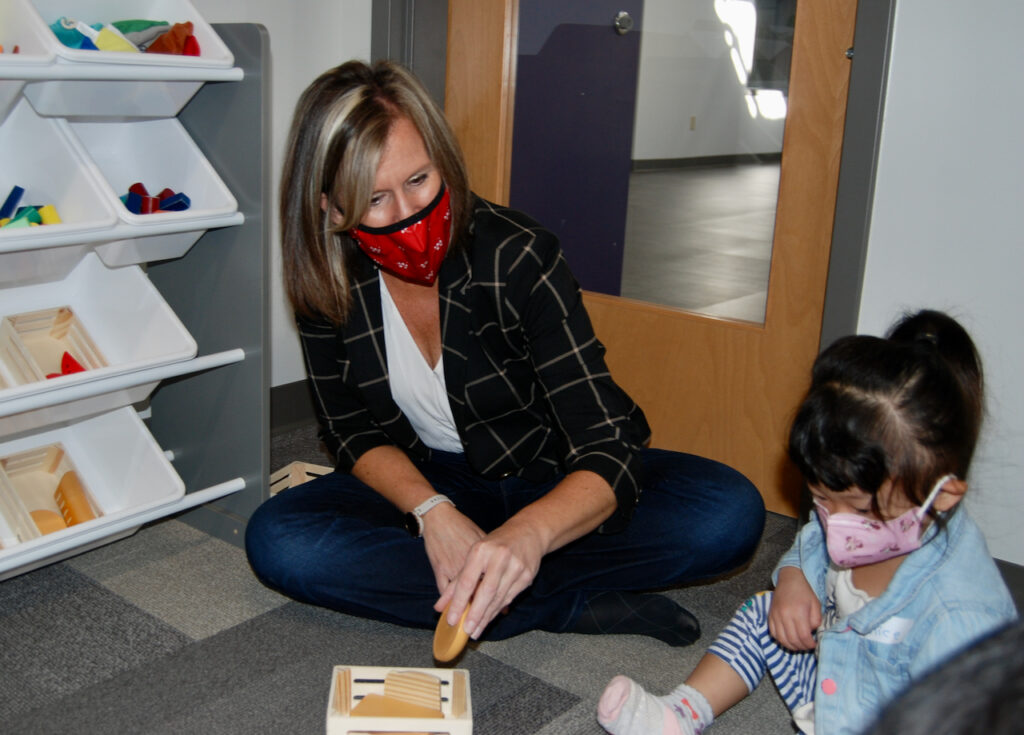
Whitewater Unified School District Superintendent Caroline Pate-Hefty helps a preschooler sort healthy food.

An educator guides a preschooler as he explores a learning device affixed to the classroom wall.
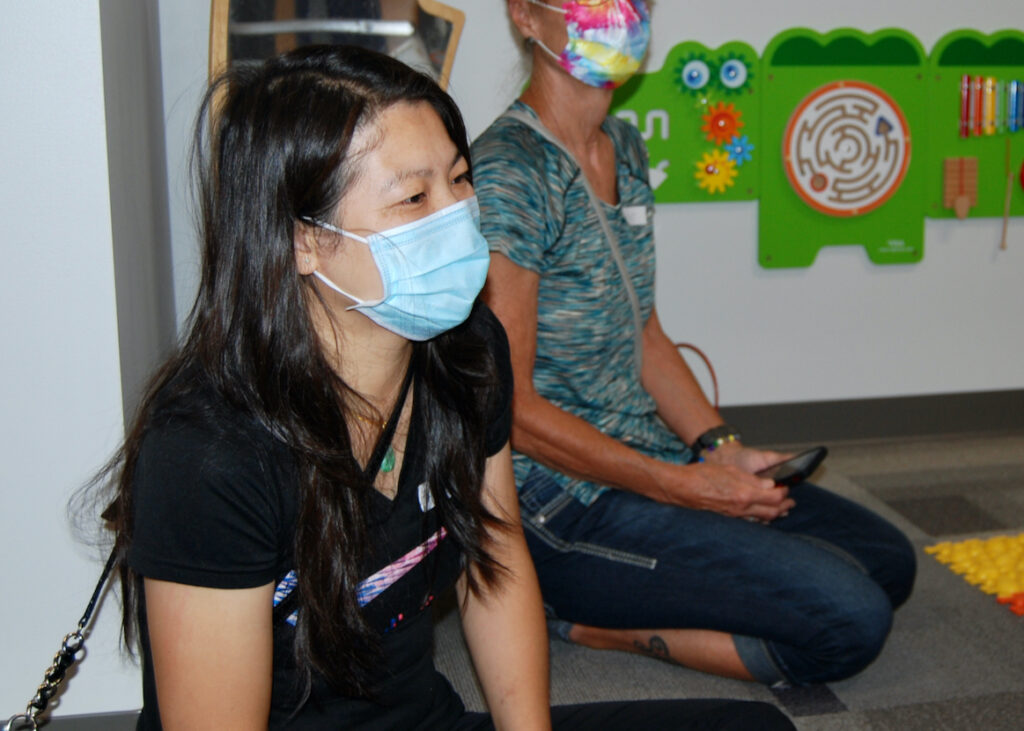
Parents watch as program instructors engage their children in socialization and learning.

Seated in the Partners in Play classroom amid a group of active preschoolers, program facilitators arriving to participate in Tuesday’s program kickoff include: Whitewater Unified School District Superintendent Caroline Pate-Hefty, from left, UW-Whitewater Dean of the College of Education and Professional Studies Robin Fox, Whitewater Unified School District Family and Community Engagement Coordinator and Partners in Play Director Molly Fuller, and interim UW-Whitewater Chancellor Jim Henderson.
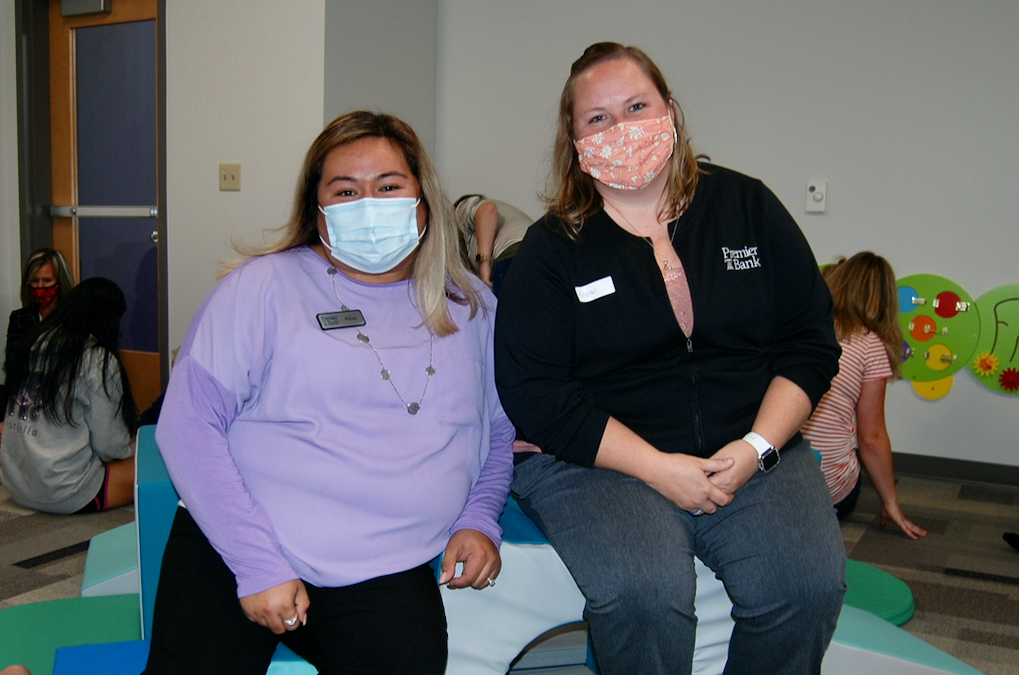
On hand Tuesday to support the Partners in Play program and provide bilingual services are Marisa Longoria, at left, who works at PremierBank in the Whitewater branch as part of the bank’s bilingual initiative. Krystal Walsh is the PremierBank branch manager in Whitewater. PremierBank will be providing bilingual and support services at every Partners in Play session, the bank representatives said.
Kim McDarison photos.
Cravath, Trippe herbicide application anticipated in October, public meeting to be scheduled
(Originally published Oct. 1, 2021.)
By Kim McDarison
Herbicide application on some 103 acres of Cravath and Trippe lakebed that has become overtaken by vegetation is anticipated to take place sometime in October, according to Whitewater Parks and Recreation Director Eric Boettcher.
While information posted in August in the city’s paper of record, the Whitewater Register, noted that application of the herbicide would take place between late August and early September, Boettcher said, confusion with the city’s chemical control permit application, which, he said, initially described the area to be treated as a prairie or wetlands, resulted in a need to resubmit the application, properly identifying the area as a lake.
“We are redoing the application and should be spraying sometime between next week and the 31st of October,” he said, adding chemically treating the lake beds would most likely take place around mid-October.
In a followup interview, Wisconsin Department of Natural Resources Lakes Biologist Heidi Bunk noted that the city had recently applied for a permit to chemically treat emergent vegetation growing on the connected beds of Cravath and Trippe lakes.
According to Bunk, drawdown for the lakes was initiated in June of 2020 and the lakes will remain drawn down until next May.
The city’s application for a permit to chemically treat the area is on hold for two reasons, Bunk wrote in a recent email: “1) The original public notice in the paper stated that the project would be completed by now; and 2) The city is in the process of sending a copy of the application to each riparian owner on the lake as required by NR 107. The city has published a new public notice in the paper and I am waiting for the affidavit. The city will send a copy of the application either by mail or by email to each riparian owner,” she added.
Further, she wrote: “Based on the interest this action has generated, the city has decided to hold a public meeting. This is not an action that the department is requiring.”
As of Sept. 29, Bunk wrote, the city had not yet set the date for the upcoming public meeting.
According to Bunk, the city plans to invite its contractor to the public meeting to answer any questions the public may have.
“The main concern expressed by citizens is that they don’t want their properties to receive either direct treatment or overspray,” Bunk wrote, adding, “the city is only treating below the ordinary high water mark and will not be treating upland property.”
According to a DNR “worksheet for large-scale aquatic plant treatment,” submitted by the city with the department on Aug. 26, Cravath and Trippe lakes will be treated to eradicate growth, which the document stated, was caused by “runoff from fertilized lawns near the lake.”
The document further notes that the city is looking to “remove 100% of the plants in the treatment area, outlining the city’s plans to chemically treat the area one time for the removal of “other plants,” and one time for algae.
Among solutions to vegetation control, the document notes that the city plans to “develop a lake plant management plan,” and “develop a lake protection plan.”
Among steps toward management and protection plans, the document lists the lakes drawdown and rehabilitation project which is currently underway.
The document states that a public informational meeting on the proposed chemical treatment plan was not required as outlined in state statute.
The document submitted to the DNR further notes that a total of just under 104 acres will be treated, with the goal of controlling invasive exotics and removing cattail and other woody plant species from the lakes’ shallow areas to improve recreational use.
Another document submitted to the DNR, titled: “Aquatic Plant Management,” notes that Cottage Grove-based Field & Stream Restorations will be applying the chemical to the designated property.
The document further states that there will be no “uncontrolled surface water discharge” associated with the project.
The chemical which will be used, according to the document, is “Roundup Custom for Aquatic & Terrestrial Use,” to be applied using a “broadcast” method.
The document provides a list of other methods that could be employed for controlling plants other than the use of herbicides. Responding to the checklist, the city noted that the problem could not be addressed through the use of mechanical harvesting, writing, “this will not completely remove established plants.” The city noted that solutions such as manual removal, sediment screens or covers, nutrient control in the watershed, and dredging would not bring the desired effect because the “area (is) too large.” Responding to the solution of waterbody drawdown, the city noted that “the lakes are currently drawn down and it has not removed the vegetation.”
The permit requested by the city is a type granted to address aquatic plants, algae and bacteria for not more than one year.
A permit fee of $1,250 was charged by the DNR.
The full documents as submitted by the city to the DNR are here: https://permits.dnr.wi.gov/water/SitePages/DocSetView.aspx?DocSet=AP-IP-SE-2021-65-X08-27T16-57-04&Loc=undefined.

A view of the vegetation which now fills Cravath Lake. Plans to weaken the vegetation using herbicide are in progress. A public meeting about the process is set to be scheduled soon, according to the Wisconsin Department of Natural Resources. Application of the herbicide is anticipated to take place mid-October, according to city officials.
File photo/Kim McDarison
Trippe, Cravath lakes Chemical Aquatic Application public meeting set for Oct. 6
(Originally published Oct. 3, 2021.)
By Kim McDarison
A public meeting to discuss plans underway to apply herbicides to over 100 acres of drawn down lakebed in Whitewater has been scheduled for Wednesday, Oct. 6, at 3:30 p.m.
The virtual meeting will be held using the “GoToMeeting” platform.
A link to join the meeting in here:
https://global.gotomeeting.com/join/469475541.
The full meeting notice placed recently on the City of Whitewater’s website is here: https://whitewater-wi.gov/AgendaCenter/ViewFile/Agenda/_10062021-1414?packet=true.
Among documents shared recently on the city’s website is a letter, dated Sept. 28, written to landowners around Trippe and Cravath lakes, which states that some 100 acres of lakebed will be treated sometime during mid to late October.
Through the letter, property owners were informed of the following: “The area to be treated near your property will be selectively treated to help reduce a nuisance population and help restore native aquatic plant populations in Cravath and Trippe Lakes. The day treatment is to take place a bright yellow sign will be placed along each shoreline within 200 feet of any of the affected treatment areas.”
A list of undesirable and desirable plant species, compiled by Cottage Grove-based Field & Stream Restoration, the contractor hired by the city to apply the herbicide, and dated Sept. 8, was also shared on the city’s website.
According to information shared on Sept. 8 with the city by Field & Stream Restoration, LLC, a “Lake Spraying Plan” calls for plants designated within a map, which also recently has been shared on the city’s website, of the lakebed to be sprayed, but “limited to not greater than 10 plants in any one contiguous area.”
The plan, which is presented in an outline form, makes note of such variable as “map creeks, seeps, and other wet areas,” and offers some types of criteria, enumerated as: “determine sprayer mixing/refilling locations,” including “level, legal, approved, access to the lakebed,” “mixing pads (containment and absorbent),” and “source of water, municipal garage quick fill.”
The outline further notes that the plan will engage “small scale spraying,” enumerating such elements as narrow strips, around obstacles such as bridges, rock work, and docks.
Spraying will take place “adjacent to flowing water,” and will be done using “backpack and ATV sprayer guns,” the outline notes.
During spraying, the plans calls for sidewalks, trails and other public access points to be “closed off,” and for the installation of “field signs.”
Under the heading of “Large Scale Spraying” the plan notes activity will occur in areas that are “30 feet or greater from shore,” and will use a UTV (utility task vehicles also called a side-by-side recreational off-road vehicle) with a “boom-less sprayer.”
The document further identifies “spray bands,” noting that a band of 0-50 feet from shore will be treated with aquatic approved triclopyr and aquatic approved glyphosate, and a band of 50 feet plus will be treated with aquatic approved triclopyr and aquatic approved imazapyr.
Documents submitted to the Wisconsin Department of Natural Resources identify the chemical that will be used as “Roundup Custom for Aquatic & Terrestrial Use.”
According to published information, the “main active ingredient” in Roundup is isopropylamine salt of glyphosate.
An earlier story, noting the city’s plans to apply herbicide in the lake beds, is here: https://fortatkinsononline.com/cravath-trippe-lakes-herbicide-application-anticipated-in-mid-october-public-meeting-to-be-scheduled/.
An earlier story, outlining overall plans for lake restoration at Cravath and Trippe lakes, is here: https://fortatkinsononline.com/cravath-trippe-lakes-restoration-plans-on-schedule-city-manager-says/.
A link to the city’s website, which also includes documents submitted by the city to the DNR, is here: https://whitewater-wi.gov/AgendaCenter/ViewFile/Agenda/_10062021-1414?packet=true.
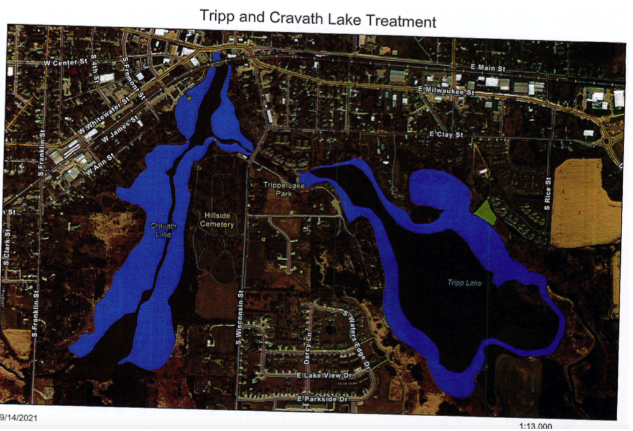
A map supplied within documents recently shared by the City of Whitewater on its website show areas where herbicide will be applied within the Trippe and Cravath lake beds sometime later this month. A public meeting about the planned process is scheduled to take place virtually on Wednesday at 3:30 p.m. A link to the city’s website, which also includes documents submitted by the city to the DNR, is here: https://whitewater-wi.gov/AgendaCenter/ViewFile/Agenda/_10062021-1414?packet=true.
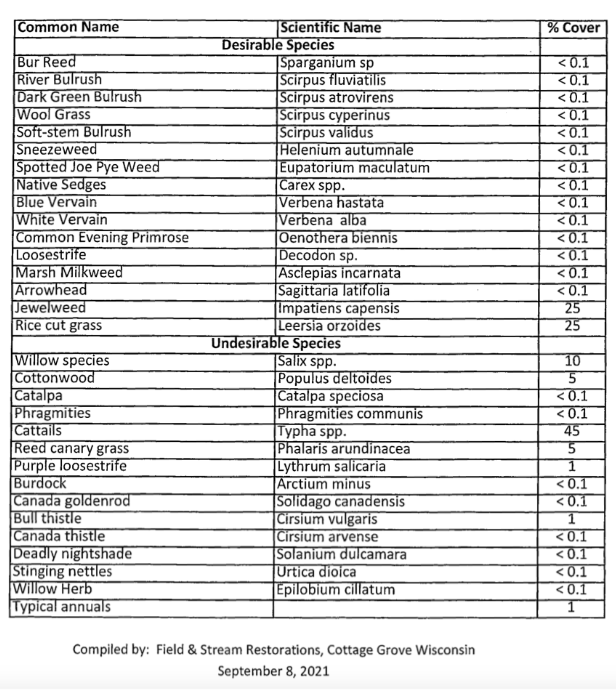
A list of desirable and undesirable plants, as compiled by the company contracted by the city to apply herbicide to the connected Trippe and Cravath lakebed, pictured above, has been shared on the city’s website.
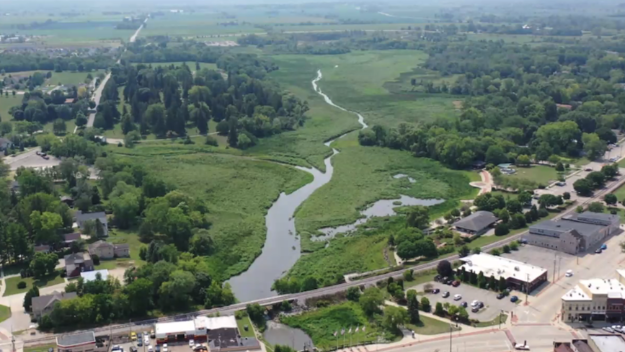
A recent aerial view, as shared by the city in recent presentations about plans to rehabilitate Cravath and Trippe lakes, shows vegetation that has become overgrown in the connected lakebed since the lake water was drawn down. Drawdown began in June of 2020, according to Wisconsin Department of Natural Resources Lakes Biologist Heidi Bunk. Her comments can be found in an earlier story here: https://fortatkinsononline.com/cravath-trippe-lakes-herbicide-application-anticipated-in-mid-october-public-meeting-to-be-scheduled/.
Herbicide application explained, could begin next week, Whitewater officials say
(Originally published Oct. 8, 2021.)
By Kim McDarison
The City of Whitewater will soon be making aquatic herbicide application to over 100 acres of drawn down lakebed located on the city’s south side.
Representatives from the city and Field and Stream Restorations, LLC, the Cottage-Grove based company that will be applying the herbicide, held a virtual meeting Wednesday, Oct. 6, to update the public about planning underway for herbicide application to control vegetation which has grown in the Cravath and Trippe lake beds.
Plant growth in the lakes was initially attributed to fertilizers that had washed into the lakes from area properties, City Manager Cameron Clapper said in a presentation given to the public last month, making a nutrient rich environment in which invasive plants grew. To return the lakes to recreational use, Clapper said last month, the city began a restoration process, drawing down the lake water.
That process, according to a representative from the Wisconsin Department of Natural Resources (DNR), began in May of last year. Since then, city officials have explained, vegetation has grown to heights that are taller than a human being, as described by Clapper during a State of the City address given virtually in September. The city has been working with the DNR to obtain dredging permits to clear the lake of invasive vegetation. Plans call for a controlled burning process to help remove the plants, but first, Clapper said during his September address, a chemical herbicide will be applied to the lakebed to weaken the plants.
During Wednesday’s meeting, Whitewater Parks and Recreation Director Eric Boettcher introduced Field and Stream Restorations Senior Ecologist Steven Banovetz who gave a summary of the process, equipment and chemicals the company plans to employ during the herbicide application project. Additionally, Banovetz responded to several questions asked by Clapper and Whitewater City Council Member Brienne Brown. Whitewater City Council Member Lisa Dawsey Smith was also in attendance. A total of nine participants were in attendance during the meeting.
An update from Boettcher
Boettcher noted that the project to restore the two lakes, Cravath and Trippe, had been underway for “quite some time now,” and that Wednesday’s meeting was meant to serve as an update of the continuing project. The application of herbicide is a step that will be followed, according to information shared by Boettcher in previous presentations, by some controlled burning of vegetation and dredging, after which the lakes will be refilled with water sometime next year, likely in the spring and summer.
Boettcher further pointed to an outline produced by Field and Stream Restorations which offers an overview of the herbicidal process.
The outline, he said, “describes where they are spraying and what they are spraying.”
Looking at a map included as part of Wednesday’s presentation, Boettcher said: “The blue area is kind of where we are looking at treating. Again, this is the lakebed area; this does not go up onto residential shorelines. We are only allowed to treat the area on the lakebed.”
A permit application sent by the city to the DNR was also shared during the meeting.
“The DNR reviews all of this and then they are the ones that determine whether we can spray or not, and give us the permit in order to perform this work,” Boettcher said.
Boettcher likened the process of herbicidal spraying to one a property owner might undertake in his yard.
“How this kind of works is it is kind of like, if you think about it, a neighbor who sprays their lawn. When the spraying is done, they will mark the area they are spraying; they will post signage letting people know, and, kind of like when you have your neighbor spraying their lawn, they have an indication of what they are spraying, what they are doing, and how long to keep away,” Boettcher said.
He next opened the floor to questions.
Questions and answers
Clapper indicated that the questions he was asking were among those be believed would be of interest to people who might not have been able to attend the virtual meeting.
Addressing his questions to Banovetz, Clapper asked: “What is the process, and especially, we talked about somebody going out and spraying, what does that look like, what kinds of equipment are they using, is this airborne, how does that work?”
Banovetz said there were two reasons why the herbicide was useful: “One was, we thought that by refilling the lake and having 12-foot cottonwoods all over out in the water, what seemed like the public backlash would be: ‘we’ve spent two years doing all of this and we’ve got more standing biomass out there than we had before.’ So that was part of it. And a 12-foot cottonwood isn’t going to go away in a couple weeks, it may be two years.”
He cited a goal of working to bring down unwanted vegetation so that it would “rot and fall down to the lake bottom, so that it’s tied up in the lake muds rather than in the water column when the water comes back.
“If we leave those plants in the water column, in essence, they will become part of the nutrients in the water,” Banovetz said, which, he noted, would serve to feed and restore blooms of unwanted lake flora.
Turning to herbicide application and methodology, Banovetz said his company would use a three-tiered approach, with each tier determined by its proximity to the shoreline, which, in turn, would determine the size of equipment used to make the application, and the types of chemicals that would be applied.
“We would be spraying the herbicides; it’s really the only logical, readily available method, from ground equipment. The ground equipment can range, on the small side, from a backpack on someone’s back, spraying an arc out in front of your walkway that you’re walking, as far as three or four feet from your feet. And you can spray maybe four or five feet in either direction as you’re walking. Imagine creating an arc in front of you with a fan tip. That’s kind of the smallest, most detailed type of application you could do, Banovetz said, adding that the backpack approach would be used in areas with sharp slopes, wet soils, and in and around trees that are hanging down onto the lakebed. The application would be used within five feet of the shoreline area.
The next tier, according to Banovetz, would use single-person ATVs that would carry 25-gallon tanks of herbicide mounted to the vehicle. The chemicals would be applied to vegetation using a “boomless spray nozzle.” he said. The nozzle can spray chemicals about 15 feet in both directions from about five feet off the ground, he added.
“Those, we would use in, again, small areas that it just doesn’t make sense to try and use anything larger,” he said, describing such areas as places where machinery might have to back up, or maneuver around obstacles.
“The four-wheelers are pretty maneuverable that way, but unlike walking miles and miles a day, the ATV is certainly much easier than that. It can go a little bit quicker, and its going 15 to 20 feet wide versus maybe eight feet wide walking. So certainly our application rate and speed goes way up,” he said.
A third tier would employ the use of a UTV, which, Banovetz said, was twice as wide as an ATV. “It’s almost like a mini pickup truck,” he said.
The UTVs carry 100-gallon tanks and use what Banovetz described as a rod with nozzles that can spray product from 10 feet in the air, making a 35-foot wide area of application. The vehicle has tracking, he said, making it better able to go where smaller equipment might encounter difficulty with the terrain.
“With 100 gallons, there are far fewer times you have to go back and refill, so again, our application rate is going to skyrocket with that tool as well,” he said.
Said Banovetz: “Our intention is to do the shoreline with either the ATV or backpack by hand, until we are to a point where we feel like we are so well controlled, we can use the bigger machine and not worry about if a small breeze comes along, or a rut or something, where it takes our machine and moves it.
“There’s two ways that the spray could leave our intended area that we want it to be, either the wind could take it, or you could hit a bad rut or something if you were driving and instead of your boom spray pattern being horizontal with the ground, it all of a sudden becomes hard to tilt it, and it starts spraying more horizontally than down. That’s why we would look at creating kind of a buffer along people’s properties. The last thing we want is for someone to complain that we harmed one of their trees or some of their hostas, or something along the shoreline. Our effort will be to use the tool where we can ensure exactly the edge of where that herbicide is being sprayed.”
Clapper asked: If someone was to look at their edge where they’ve got grass, and I know water came up to their grass before, where the grass ends, about how far from there are you expecting to go? How are you navigating that, and how close do you anticipate getting?
Said Banovetz: “I’d like to be within five feet of that to accomplish our goal. I think there may be times, especially along the park, where there are some rock areas with noxious weeds in them that we’d like to hand backpack up into and capture some of those areas. We are going to be on the lake bottom, but there may be some associated landscapes within the city’s property that we may be able to treat within this. We would be less than five feet in those scenarios. If we approach somebody’s well manicured, well landscaped yard, we’re going to stay some distance away from that because the backlash is too difficult, but the goal of trying to remove the weeds from the lakebed is not more important than their comfort knowing that we respected their property rights.”
Brown asked: “There are people at Whitewater Lake who have hand-planted native sedges and stuff like that in waters around there and so it may or may not be appropriate since I don’t know everybody around Trippe and Cravath, but if there were native things like that around, would your applicators be able to recognize that and try not to spray those?”
Banovetz responded, saying: “Yes, we actually went around and mapped out where native plant populations were all the way around both lakes.”
The map made by his team, he said, included areas where there were at least 20 native species. Areas in which a single native plant might be surrounded by invasive vegetation were not indicated.
“So to find a single sedge, completely overwhelmed with canary grass or stinging nettle, we didn’t map that per se. We know it exists, so then really the direction could be from the council, if that’s of interest, we would need to backoff the property at least on some of the lakes in some areas 20 feet,” Banovetz said, adding, “If we want to save every native plant like that right on the edge of the shore, we could back off an additional distance from the shore.”
Said Banovetz: “Our plan is fluid and adaptable. You notice from the blue map … that’s kind of the entire area that we could choose to spray. Some of it’s going to come down to the day we are spraying. We are going to do what we can based on wind direction and wind speed, how wet the soils are, if there is other feedback that would change that. Our original goal was to try and do the first 200 feet all the way around each lake. Certainly it’s much wider than that in Cravath Lake. So we left ourselves with the regulators a little more flexibility in case there were some areas we couldn’t get to and still wanted to try and reach a target of about 100 acres.
“In terms of flexibility with the regulator, what I mean by that is if I don’t show it, I can’t really spray it under our permit. So it was easier to show too much blue than not enough blue, and then afford us a little adaptability to change the plan a little bit.”
Banovetz said his team did not map “every square foot of both lakes,” calling that “a daunting task.” Instead, he said, his team would use discretion, and if they saw areas with highly desirable targets, such as cottonwoods, they would work to acquire those targets down to the roots.
He identified portions on the map, specifically within the center of Cravath lake and on the south ends of both lakes, as areas that might not receive herbicide.
“The soils get much harder to work with in terms of the creeks and the springs coming in, and when they get to a certain level of how wet and saturated they are, it gets hard to float equipment on them. Especially when you put 1,000 pounds in the rear end of a UTV or even the ATVs have 200 pounds in the rear. Those machines will start to sink,” Barnovetz said.
Noting the four herbicidal products — Roundup Custom Aquatic Terrestrial Herbicide, Polaris AQ, Arsenal Herbicide, and Vastlan Herbicide — the company plans to use on the Cravath and Trippe lakebed, Clapper asked: Regarding the residue from the herbicides that will be applied, will the residue from those chemicals have a possibility in the spring of washing downstream? What kind of impact would that have on animals and aquatic life farther down Whitewater Creek?
Banovetz said he did not believe any of the four chemical products, as noted by Clapper and as planned for application on the lakebed, would impact animals downstream.
“By the time the water has come back up, or even in a hard rain event, these chemicals breakdown fairly readily. They are going to be sprayed to organic material that’s decomposing and rotting to the ground. If they were able to move so quickly and to do really any kind of measurable damage, they wouldn’t be labeled for use in aquatic environments,” Banovetz noted.
He continued: “if you use a terrestrial herbicide and sprayed it in flowing water, it could potentially float on the water, move downstream, attach to vegetation and kill it. The goal with aquatic approved herbicides is that once they come in contact with water they’re … encapsulated and become inactive. Not that they’re not still an herbicide and still there, but they don’t have the same capacity to affect plant life and animal life like they did when they were first sprayed.
“Herbicides, the same herbicide like Roundup, can be formulated for a terrestrial or land-based application and it’s effective and they use certain ingredients to make it work on land; they can take that same herbicide and they can put different additives with it so that it can be used in an aquatic environment, but not float or go off site and (cause) damage. That’s what makes it approved for aquatic use, because we all know that water can flow or that it could layer on the water and be blown across a lake and affect something on the other side.”
Said Clapper: “I’m also thinking about someone having the concern — we’ve seen TruGreen lawn care and other companies that come out and take care of your lawns, and like Eric (Boettcher) said, put signs out that say, ‘hey, this is in process, doing its job, don’t walk out here … or roll around the grass for a day or two.’”
Clapper asked: What about weather and rain; I think that might be some of the concern: we go to all this work and look at the forecast and then something crazy happens and the next day there’s a torrential downpour. He asked if the city would need to reapply the herbicide.
Said Banovetz: “Once the herbicide is applied to green living tissue … within an hour it is absorbed into the leaf, into the vascular system of the plant, so there isn’t a reapplication that would have to occur, unless you were negligently applying in the rainfall. Once it’s on and dried onto the leaf tissue, it’s there, it would be difficult to wash off.
“Could we apply some of this herbicide and get a torrential rainfall and could some of it be detectable and move downstream? There’s always that possibility.
“We’re using aquatic herbicides. My guess is after a hard rainfall after herbicide use in the farm fields around Whitewater, it would be detectable in the lake every time it rains, because you’re now washing things that are not aquatic approved. Not that that makes anybody happier, it’s not like this would be a real oddity, you know? The use of herbicides in our landscape is common everywhere.”
Clapper asked Banovetz to talk further about the chemical products that will be used.
Said Banovetz: “We chose four different herbicides. Often times you use more than one herbicide because the herbicides are designed to work on the plant cellular systems in different ways. One may disrupt the way an enzyme is made or used, another may be a growth hormone that causes a plant to overgrow itself, so there’s a couple different ways and modes at which they try to specifically create an herbicide that will disrupt a particular unique cellular function within just plants. It’s important to note that, because what they try to do to get a label, and to get the ability to use the product, they have to show that it doesn’t kill insects, and mammals, and other forms of life. So they try to find plant-unique cellular systems to disrupt.”
Such techniques are used to ensure the products will kill plants, but will not necessarily harm the animals living around them, he said.
Banovetz continued: “The next layer we looked at, there are some herbicides that are considered contact only. Roundup is one of those. If it doesn’t generally hit green leaf tissue, there’s nothing much more that it will do. It will degrade fairly quickly. The soils, bacteria will break it all down, the sunlight breaks it down. Moisture helps with that. There are other herbicides, what we call residual, where the herbicide may stay around for a while in the soils, continuing to actively work on humans’ best interest, to control the weedy plants that you applied it for. The common lawn herbicide 2, 4-D, Weed B-gon, is the common name for it, is a residual herbicide. It sits in your lawn for two to three months, continuing to provide dandelion control let’s say. So we are using both of those — both the contact only and a residual — but in the first 50 feet from the shoreline, we are not using a residual because the chances are that maybe let’s say a big willow tree growing right on the edge of the shoreline may have roots underneath the lakebed or within the lakebed. And if we put a residual herbicide down, eventually, it may find its way to those willow roots and could negatively affect that willow tree.”
He said the plan in the lakebed called for the use of contact-only herbicide in the first 50 feet from shore.
“When we get farther out from 50 feet, we are going to switch over and use Polaris, which has a residual quality to it. And the value to that is that we are going to have an extended length of time for weed control beyond just the initial application. I’m no expert in this, so I can’t say that the Polaris will be there in June of 2022, but I’m quite sure it will be there late into November and December, perhaps, if we have a cool winter, it may still be somewhat active to the next spring. The advantage to that is that if the lake levels don’t come up as quick as you’d hope and maybe there’s some residual herbicide activity there, we can keep the lakebed cleaner longer and perhaps have a more aesthetic lake refilling process,” Banovetz said.
Clapper asked about people who might be sensitive to odors, what precautions should they take?
Banovetz suggested sensitive people keep their windows closed or perhaps choose to spend the day doing something away from Whitewater.
“Our herbicides are applied with a lot of water, so it’s not like we’re creating a mist that might come out of an airplane that will float across the lake and landscape. Nothing we are using will become volatile,” he said. “I cannot guarantee that someone might be able to smell something that may smell like herbicide, or an unusual oder the days we are spraying,” he added.
Clapper asked: “Animals that are living in the area, the birds, the fish, any of our mammal or other critters, turtles, frogs, this is not intended to and has low risk of hurting those animals, correct?”
“Correct. If there was any risk, real risk at all, it wouldn’t be labeled for the type of application we are doing. That science has been settled long before our work here,” Banovetz said.
Said Boettcher: “I can also add to that that the Wisconsin DNR would not allow us to apply anything that was not meant for this purpose. They are pretty strict on what we can and can’t do.”
Banovetz agreed, saying: “I have created permits and had the DNR turn me down and say, ‘we need you to use this and this in this situation.’ They actually do do their research, they know what they are talking about, and they help guide us; they are not just there to approve or disapprove.”
“I do believe that due diligence has been done by all the parties involved in making this happen. Concerns are understandable and legitimate. This is chemicals applied in a natural area,” Clapper said.
Benovetz said on Wednesday that while he was still waiting for final approval of the permit from the DNR, he anticipated that the first day of spraying could begin in 7-10 days. How long it might take to complete the task of spraying 100 acres was weather dependent, he said, adding that with perfect breeze-free weather, it could be completed in as few as three or four days. Typically, he said, weather affects some portion of each day, which would increase the time needed to complete the full application.
Those interested in learning when spraying will begin can look for notification on the city’s website, Clapper said.
An earlier story about the permitting process and the meeting, including documents filed with the DNR is here: https://fortatkinsononline.com/trippe-cravath-lakes-chemical-aquatic-application-public-meeting-set-for-oct-6/.
The city’s website is here: https://whitewater-wi.gov/1.
A link to the full meeting provided by the City of Whitewater on Vimeo is here: https://vimeo.com/624918894.

A map of Trippe and Cravath lakes in Whitewater shows areas highlighted in blue which have been identified by Cottage-Grove based Field and Stream Restorations, a company hired by the City of Whitewater to spray herbicide on growth in the now drawn down lake beds, for herbicide application. The goal, a company spokesperson said Wednesday, is to target 100 acres.
Whitewater city manager shares ‘State of the City’ address
(Originally published Oct. 12, 2021.)
By Kim McDarison
The Whitewater Area League of Women Voters State of the City and School District forum was held Thursday, Sept. 23.
Delivering a State of the City address, Whitewater City Manager Cameron Clapper was one of two presenters during the hour-long virtual event. He shared the platform with Whitewater Unified School District Superintendent Caroline Pate-Hefty, who delivered a State of the District address. A story about Pate-Hefty’s presentation is here: https://fortatkinsononline.com/whitewater-school-district-highlights-shared-during-state-of-the-district-address/.
Following an introduction given by League Co-President and forum moderator Mary Beth Byrne, Clapper, aided by slides, spoke about such topics as operating in the pandemic, strategic management and budgeting, the American Rescue Plan Act (ARPA), Whitewater’s housing dilemma, and new development, which included an overview of tax incremental financing districts, and business and industry growth.
Also included was an update on the Cravath and Trippe lakes rehabilitation project. A story, including Clapper’s comments about the project, is here: https://fortatkinsononline.com/cravath-trippe-lakes-restoration-plans-on-schedule-city-manager-says/.
A story about the most recent update on the lakes restoration project, including plans to treat some 100 acres of connected lakebed with herbicide, is here: https://fortatkinsononline.com/herbicide-application-explained-could-begin-next-week-whitewater-officials-say/.
Operating in the pandemic
During his presentation, Clapper said, based on guidance from the Center for Disease Control and Prevention, city employees working indoors at city-owned facilities are required to wear masks, regardless of vaccination status, and members of the public conducting business in city-owned buildings are asked, but not required, to wear face masks.
Employees are required to wear masks for “safety purposes,” and for the purpose of “setting a good example,” Clapper said.
Every city facility is open and accessible, Clapper added.
Strategic Management and budgeting
Looking at strategic management and budgeting, Clapper said the city is a four-time recipient of the “Distinguished Budget Presentation Award,” earned in 2018 through 2021, as presented by the Government Finance Officers Association. The award recognizes the city’s budget document as offering sound policy, fiscal planning, operations guidance and as a good communication device.
Pointing to the budget document, he said “We want to make sure that it is something that is clear and transparent, so that you all as community members understand how your resources are being utilized for the benefit of the community as a whole.”
Additionally, Clapper offered a breakdown by percentage of resources paid to each taxing district annually by Whitewater residents. Using preliminary figures from the 2020-2021 property tax bill, Clapper said 16% of the total taxation goes to Walworth or Jefferson county, depending on where in the city the taxpayer lives; another 4% goes to area technical colleges, some 51% is allocated to the Whitewater Unified School District, and 29% is collected by the city.
“We don’t have to pay anything right now on property taxes to the state; fortunately the state has reduced to zero their draw on property tax from the property tax system, however we still distribute to other entities,” Clapper said.
Looking at a comparison between the city’s budget in 2021 and the actual dollars spent thus far in the budgetary cycle, he said, the city developed its budget anticipating revenues of $9.6 million, and has thus far received $6.68 million. Of that amount, the city has thus far spent $6.61 million.
Referencing a slide showing the city’s revenue sources, Clapper said: “You can see property taxes and intergovernmental revenue make up the largest chunk of our dollars coming in, and intergovernmental revenues is actually more than property tax, so we are very dependent on the state for the dollars that they choose to allocate annually in the biannual budget to municipalities.”
Clapper said monies collected through the tax levy support 42% of the city’s operating budget and 47% come from intergovernmental revenues. Other sources, such as public charges for services, forfeitures, licenses and permits, special assessments and miscellaneous charges, each account individually for anywhere from 1% to 5% of the full general fund revenue pie.
Looking at general fund operating expenditures, he said, public safety accounts for 40%; followed by general government expenses, at 16%; public works expenses and transfers, each coming in at 11%; debt service accounts for 10%; cultural, recreational and educational activities consume 8%, and conservation and development are allotted 4%.
Clapper defined expenditures associated with public works and public safety as “significant.”
“Public Safety, of course, is very expensive, with all of the equipment and training that’s required of our public servants,” he said.
Looking at the city’s expenses thus far in the current budgetary cycle, Clapper said: “I just want to report, in the state of the city, currently, we are moving forward as projected this year with how we budgeted in terms of dollars for expense and use of city resources. We are about two-thirds of the way through the year and we are about two-thirds of the way through where we expected to be with our budget, so things are moving along smoothly. Our budget, this year … is just over $9.6 million, and so we are very fortunate to have a lot of frugal people and intelligent people working to maintain operations and keep us low on expenses as much as possible.”
American Rescue Plan Act
As of March 11, 2021, Clapper said, the federal government earmarked some $1.9 trillion through the American Rescue Plan Act (ARPA) of which $362 billion was dedicated to state and local governments through the Coronavirus Fiscal Recovery Fund.
Of those monies, he said, the state of Wisconsin received $2.5 billion, the counties of Walworth and Jefferson received $20.2 million and $16.5 million, respectively, and the City of Whitewater received $1.5 million.
Monies received by the city could be used for lost public sector revenue, and water, sewer and broadband infrastructure.
Looking at the city’s appropriation, he said: “We are thrilled about that because those dollars are very useful for a number of things.
Clapper noted that levels of government, such as state and county, are able to use the ARPA funds for such expenses as public health responses, negative economic impacts from the pandemic, premium pay for public sector essential workers, and infrastructure projects such as water, sewer or broadband.
Whitewater is classified as a NEU, or non-entitlement unit of local government. As such, he said, the city’s ARPA funds can be used to cover two areas that the other levels of government will not cover. They are a loss of public sector revenues and infrastructure projects.
“So that’s where I anticipate we will be focusing the majority of the dollars that will be coming to us. We’ve already received about $770,000, that’s the first installment of a two-installment payment of that $1.5 million. So those dollars are sitting in a fund, and will sit there until we come up with, as a community, the way we are going to disperse those dollars,” Clapper said.
He said the money would give the city an opportunity to improve infrastructure, which, he said, had been “neglected for some time.”
Whitewater’s housing dilemma
Clapper stressed a need within the city to address housing shortages, which, he said, affected all variety of housing stock designed to accommodate all population segments. He said plans were in the preliminary stages to create owner-occupied housing on the city’s northeast side.
Said Clapper: “Right now we know there is a national crisis for housing — having homes available for the people that are searching for them, wanting to buy them, and occupy them. Whitewater’s dilemma has actually lasted a lot longer, but thanks to what’s happening nationwide … the silver lining is our entire community and surrounding area now sees the importance of housing.
“Something that we’ve noticed professionally, as staff, and subject matter experts have seen, has not been as evident for the general public. Some of you have caught it because you are smart and absorbent to those things and you’ve been experienced living in the Whitewater community for a number of years. Others did not. So now having the national crises helps focus (attention) on the importance of housing and the need to develop more in our community.
“Right now,” Clapper continued, “the only area where we are seeing significant development of housing is in an area known as the Park Crest subdivision, and it is in what was phase 4 of that subdivision.”
Fifteen construction permits have been issued by the city for homes to be built in that area over the last two years, Clapper said.
“The challenge is we need more,” he added.
Aided by a slide, Clapper talked about “the lifecycle of housing.”
He defined various subsets of homebuyers as people with different needs, defining some as families with young children, while others might be single. Still others, he said, are empty nesters who may no longer enjoy caring for a yard.
Each lifestyle, he said, “demands a different type of house product.”
In Whitewater, he said: “We don’t necessarily have residential product or residential options for individuals looking for their own space. Space suitable for partners and families is lacking in the area as well.
“It’s really been a challenge for our community to grow in a healthy way because our housing stock is really imbalanced. We are heavily loaded with rental housing primarily built for young adults attending the university, and then we have a significant amount, or maybe not as much as we need, of homes for individuals at the other end of that life spectrum, where you are looking to have a place that’s yours, and you don’t need any assistance or medical care, but you don’t want to mow the lawn everyday. In between those is really lacking at this point,” Clapper said, adding that the city is currently working on a housing plan, which, he said, he thought would be available for the public to view potentially before the end of this year.
With a plan in place this year, he said, “we could hit the ground running next year on projects to develop additional homes. Our primary focus is owner occupied, and I think that’s probably our number one effort, whether it be in condominium style or individual homes. We are looking for a greater amount of density, but also owner-occupied spaces.”
New development: Tax incremental financing districts
Under the heading of new development, Clapper shared a graphic designed to explain tax incremental financing districts, noting that on one end of the graphic were inputs such as taxes that are collected from property owners for use as revenue by the various taxing districts, including the county, school district, technical college and municipality.
Using tax incremental financing methodology, the graphic showed, a tax incremental financing district (TID) is determined and the properties within the district are collectively given a base equalized assessed valuation. With that value set as a starting point, any taxes from any new value created in the district above the base value are held within the TID for the life of the TID, which, Clapper said, could be anywhere from 20 to 27 years, depending upon how the district is set up. The taxing districts — county, school, technical college and municipality — agree to allow those dollars to remain as revenue of the TID, with those monies used to finance new projects within the TID, until such time when the TID sunsets or closes.
When the TID closes, the tax revenue streams are returned to the original taxing districts, which, in theory, would be larger than amounts collected before the TID was established because the value of taxable property within the TID would have increased over the base value as a result of new and completed projects within the TID. That increment, or new value above base, would then become available as collectable property tax income to the original taxing districts.
“Tax increment financing, and the districts we’ve developed to utilize tax incremental financing, are probably the most successful and really a fundamental economic development tool for local governments in Wisconsin,” Clapper said.
After the district closes, Clapper said, “all the dollars that were generated by using that district are 100% allocated to those same taxing jurisdictions,” and the increment is created using a system, which, he said, “does not increase the tax burden for any resident. It simply reallocates the tax dollars to fund development, until enough development is funded, that it will actually benefit from tax revenue to those jurisdictions.”
Clapper added: “Over time, value is increased, and ultimately that end goal is so that that value can be translated to revenues for those local governments that survive on property tax revenue.”
New development: Business and Industry growth
Clapper said several lots within the city’s business park are “shovel ready,” which, he said, means they are ready for development.
Clapper credited the city’s Economic Development Director Cathy Anderson with “the great amount of activity we are seeing.
“She is an outstanding dynamo, and just a ball of energy. She has been very responsive to businesses in the community as well as developers looking to relocate to our community, and so we have a lot of leads, individuals or businesses looking to purchase these lots,” Clapper said.
He said many developers are in discussion with the city, and he expects more to come in the future.
“That’s a big positive for our community, and really comes as a result of Cathy Anderson’s efforts,” he said.
Questions from the moderator, audience
Following his presentation, Clapper responded to several questions posed by Byrne, many of which, she said, originated with members of the virtual audience.
Byrne began the question-and-answer period with a comment which, she said, was received from the audience.
“I’m thrilled to learn that the city is working on diversifying our housing stock with a focus on owner-occupied. (I) cannot wait to see the housing plan,” the comment stated.
Byrne asked: “How is the city actively working to bring in new businesses into existing empty spaces in the area? Especially on the east side and in downtown? Additionally, how is the city currently working with existing business owners to ensure the good health and longevity of their businesses?”
Said Clapper: “I mentioned Cathy Anderson. Cathy is no stranger to the businesses in our downtown area and on the east side as well, and also in our business park. She is truly a dynamo; she is building relationships with existing businesses, frequently connecting with them, and then she makes phone calls to businesses in our community to check in on their well-being, but also frequents those businesses as a patron, and as an in-person visitor.”
Clapper said Anderson worked to stay up to date with resources available through the ARPA and CARES Act, as well as other programs, including those offered in-house, through the city, to make sure businesses were aware of the resources available to them.
“Personally, I spend, unfortunately this last year, year and a half, I’ve spent less time out and about because most of my meetings are still virtual. But Cathy has spent a great deal of time in person, helping our business community. She also works with the Downtown Whitewater organization and she sits on the chamber board as a representative from the city,” Clapper said.
Byrne asked: “What is the greatest challenge facing the city this fiscal year?”
Said Clapper: “I would say probably levy limits.”
Clapper said he believed property taxes were among the most transparent of taxes, and, he said, he recognized the importance of keeping them “reined in.”
“However,” he said, “the way levy limits are structured right now, we continue to see a diminishing return. For example, for 2022, we will be looking at about an increase of $50,000. And in a community with about a $9.6 million budget, … $50,000 doesn’t go very far in covering all of the increases in costs. Especially if you want to maintain competitive rates … That’s, I think, the biggest challenge and I don’t see it going away anytime soon. So it’s just navigating around that, and what can we forego now in order to make operations as they are.”
He said the challenge is to make every dollar stretch further.
Byrne asked: “With regard to owner-occupied housing, how affordable will these new homes be, and will this area be a part of the new Ward 13?”
Addressing the second part of the question first, Clapper said: “We don’t have a specific area designated. There are lots of areas where we would like to see new homes developed. That’s really going to depend on the impact or influence of whatever development groups or people we end up working with and what properties are available. Currently, we don’t have a lot of acreage owned by the city for development so that’s really up in the air. As soon as we have a map or idea where that is, we will be sharing that.”
Addressing the first part of the question, Clapper said: “We hope that starter homes … starter homes in general are homes that hover around $150,000. That hasn’t really changed; the amount in people’s pockets hasn’t really changed, just the increased cost of houses has changed. Personally, my hope is that we can develop … looking at homes that are under $200,000.
“The way that we would do that is utilizing some programs that have come our way. One is the tax increment districts that we have established (this year); another is an extension of some increment collection that we were able to obtain from the state with old districts that were recently closed also this year. We should have somewhere between $1.5 and $2 million of revenue generated back exclusively for housing development, and then an additional amount to be determined based on need that we would finance through those new tax increment districts.”
He said the money would be used to subsidize the cost of building homes, most likely, with a possibility that some could be used for rehabilitating existing housing.
“Much of it obviously would go to new homes. And so we would subsidize the cost of new construction, and as a result of that, we would be able to reach a price point that people can come into our community and afford,” he said.
Byrne asked: “Are you saying that the city would have to buy more land in order to build more homes?”
Clapper responded: “Yes, if the city has interest in being the developer, we would have to buy more land.”
He pointed to the Mound Acres subdivision on the city’s west side, noting that the project began when a developer approached the city to purchase land. The city was involved with working with a developer, a contractor, and selling the lots, he said.
The city could consider a similar option again, he said, adding that the housing plan that is under development would provide more details. That plan could be available for the public to view by the end of October, he said.
Byrne asked: “How can we learn about what the latest Census tells us about what is happening with the demographics in Whitewater?”
Clapper suggested those interested could visit the Census website.
“We are in the process right now of redistricting, so some of that information has been made available to our clerk so that she can really look at how to equitably distribute aldermanic districts and wards throughout the community. On that note, I would just say, stay tuned. There is more to come in the next few months and as information is released, and as those districts get finished, at this point, I’m at a loss for resources just as you may be,” he said.
Clapper said he has received “occasional updates on population from the Department of Administration,” adding that the city has an estimated population of 14,889 people.
“We haven’t seen a lot of growth over the last decade in terms of the number of people. How that number breaks out in the area of socioeconomics is the only thing that’s changed,” Clapper said.
Byrne asked: “Does that number include college students?”
Said Clapper: “It does. That number is not the full enrollment of UW-Whitewater because a number of programs are online and people are coming in during the day from out of the community, traveling from home here and then back again. But we are willing to say about 50% of that number and possibly a little more, even 60% of that number, is population directly related to the university, and most of that, students.”
Responding to a question about the impacts of COVID to the city, Clapper said the city was in better condition than initially predicted. He attributed that to people staying at home and using fewer services after the pandemic began and federal dollars that helped offset some city expenses. He cited the CARES Act and ARPA as among sources of those dollars.
According to information released in advance of the forum, the event was live-streamed on the LWV-WW Facebook page: facebook.com/lwvwhitewater.org, and was recorded for future broadcast on the City of Whitewater local access Channel 990.
The league’s next virtual program will focus on gerrymandering, according to a recent press release. The program is scheduled for Thursday, Oct. 21.
For more information about the league, visit its website: https://my.lwv.org/wisconsin/whitewater-area.
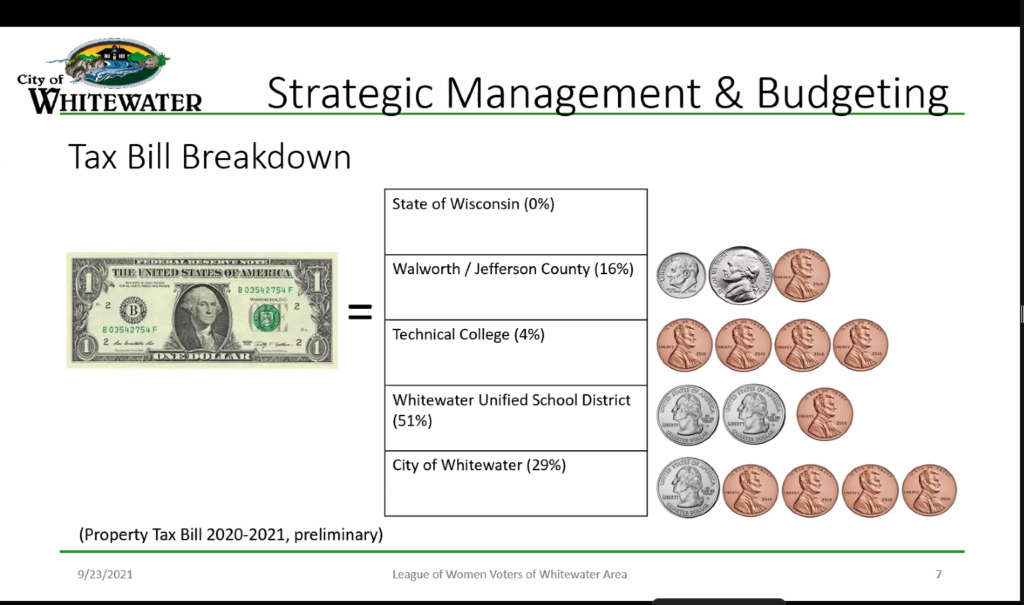
The above slide as shared by Whitewater City Manager Cameron Clapper during his State of the City address shows the breakdown by percentages of a city of Whitewater resident’s property tax bill.
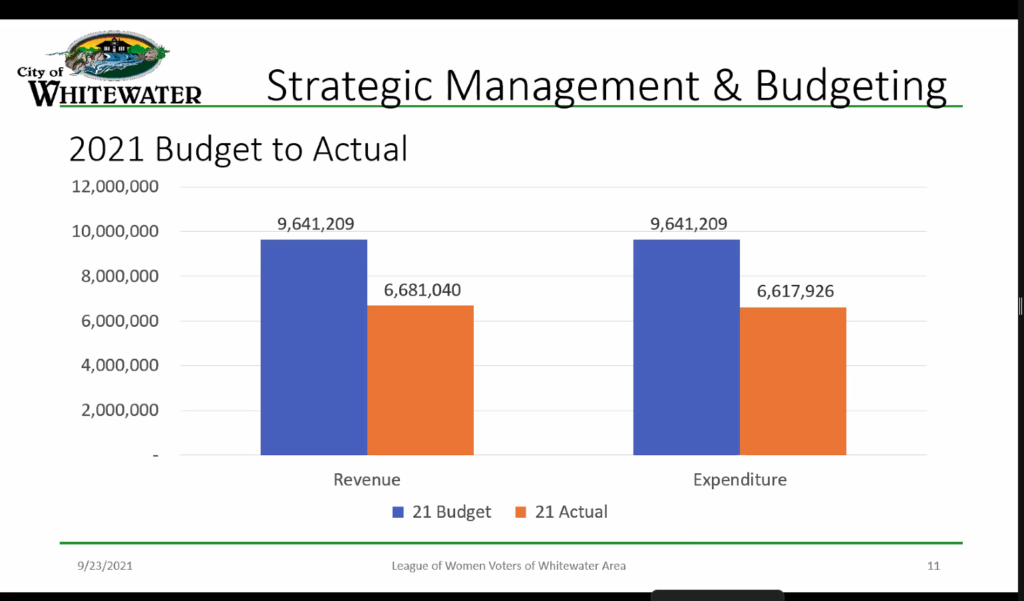
The above slide as shared by Clapper shows the city’s 2021 budget. The blue bar represents the actual budget and the orange bar shows how many of those dollars have thus far been collected and spent. Clapper said during his address that about two-thirds of the budget had been spend and the budget schedule was running smoothly.

The above pie chart shows the breakdown of general fund revenues received.

The above pie chart shows the breakdown of general fund expenditures.

The side above shows the city’s most recent housing development activities. Clapper said some 15 construction permits have been issued by the city in the area known as the Park Crest subdivision over the last two years.

The above graphic shows how tax incremental financing districts work. Clapper noted that inputs from various taxing jurisdictions are small when the district’s base is created, as represented by the colored bars at the graphic’s left side, and increase in size after development, paid for by the tax revenues from the frozen base, fund the development of taxable construction within the district. The larger increment, which is returned to the initial taxing jurisdictions, is represented by the larger corresponding boxes on the graphic’s right side.
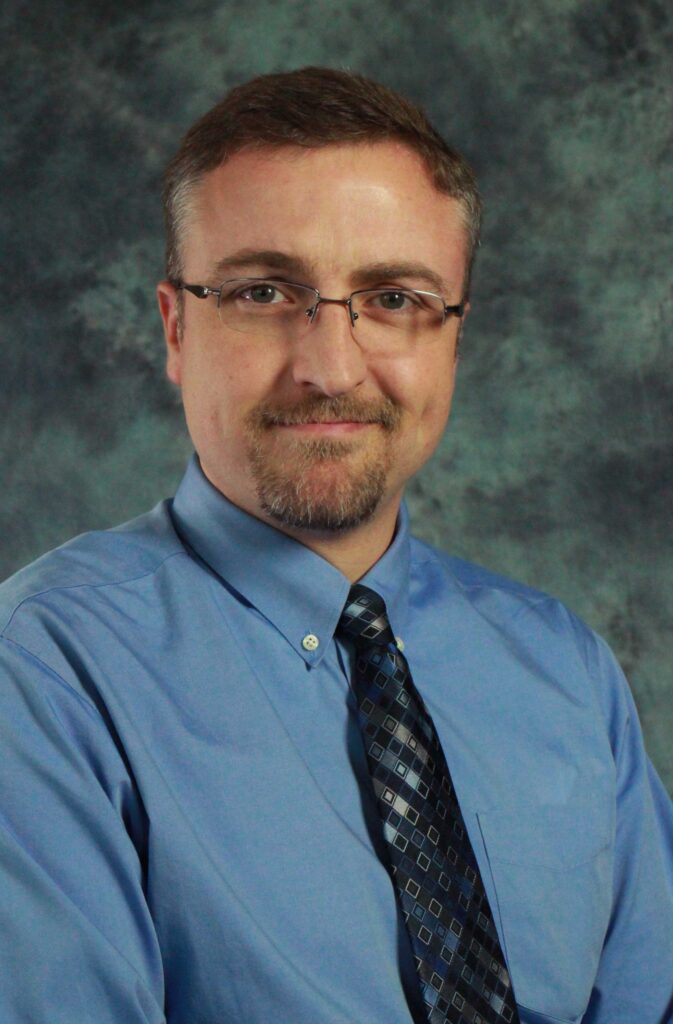
Cameron Clapper
Coming Out Day events set in Whitewater, Watertown
(Originally published Oct. 17, 2021.)
National Coming Out Day events are being planned in Whitewater and Watertown this month.
National Coming Out Day is celebrated on Oct. 11 each year to encourage LGBTQ+ individuals to come out to their families, friends, and/or community.
All events are family friendly and welcome to all, according to information supplied by event organizers.
Organizers Margie Stoneman, Whitewater, and Trent Kangas, Watertown, invite the public to attend both events to support these communities as they welcome newly “out” individuals and celebrate both National Coming Out Day and members of the LGBTQ+ community.
Whitewater
Whitewater Unites Lives will hold its Pride event Saturday, Oct. 23, from noon to 1:30 p.m. at the Whitewater Cultural Arts Center.
This event will feature live performances from volunteer members of the University of Wisconsin-Whitewater Warhawk Marching Band, student drag performer Victorya Attwood, singer/songwriter Felix Ramsey and others.
Watertown
Meanwhile, a Pride gathering will take place
Sunday, Oct. 30, from 3 to 5 p.m. at Latte Donatte, 501 E. Main St. This will be hosted by the Unity Project of Watertown.

A sign on the Main Street bridge in Fort Atkinson invites participants to help celebrate the LGBTQ+ community. The Pride celebration in Fort Atkinson was held Saturday. Similar celebrations will be held in Whitewater and Watertown later this month. Chris Spangler photo.
o.
UW-Whitewater professor to receive statewide honor for diversity
(Originally published Oct. 28, 2021.)
Editor’s note: the following story has been submitted by the University of Wisconsin-Whitewater.
Pilar Melero, professor of Spanish at the University of Wisconsin-Whitewater, will receive the 2021 University Lifetime of Service Award from the State Council on Affirmative Action on Friday, Oct. 29, at the annual diversity awards program at the Wisconsin State Capitol in Madison. Recipients include state agencies, educators and other individuals whose efforts resulted in more inclusive workplaces, equity in healthcare, community-building and mentoring for young people.
In an announcement from the state Department of Administration, Melero was chosen “for dedicating her more than 20-year career in education to educating and advocating for the LatinX, Chicano, Hispanic and LGBTQ+ communities as well as serving as a mentor, resource and ally to all students and staff around equity and gender issues.”
Melero, a UW-Whitewater alum from the Class of 1988, double-majored in Spanish and journalism, then embarked on a journalism career at newspapers in Waukesha, Milwaukee and El Paso, Texas. As a journalist, Melero wrote bilingual articles, wrote for an African American newspaper and covered women’s issues and Latino issues.
“It was a milestone the first time I got published in an English-language newspaper,” she said. “English is my second language. I used to cover school districts. I had to read a lot of documents. I did a lot of asking. I was prepared for the writing but not for the reporting itself.”
She became a writer and columnist for her hometown newspaper, the Waukesha Freeman and for the Milwaukee Journal. From covering smalltown school districts, she went on to write about issues as diverse as unequal access to housing and organic farming. In a reporting project on women in Waukesha, Melero interviewed the director of the local women’s center. The interview stuck with Melero.
“She told me her dream would be that every women’s center in the world would be closed because they were no longer necessary,” said Melero. “That was the most beautiful statement I had ever heard.”
In Texas, Melero was asked to teach a Spanish course, and noticed how much she loved working with the students. She attended the University of Texas-El Paso for her master’s degree and then UW-Madison for her Ph.D. before returning “home” in 2003 to teach at UW-Whitewater and to build upon the legacy of courses in diversity she had found there as an undergraduate.
Along with her teaching duties, Melero and her colleagues developed new programs in diversity studies, renovated others and created curriculum. Like the foundation of a building, this work is almost invisible, but everything rests upon it. She credits the teams of curriculum builders she worked with saying, “They did their own mentoring with me. They mentored me with collegiality and support.”
“The biggest milestone workwise is with my team in Race and Ethnic Studies,” said Melero. “We developed minors in Asian/Asian American Studies, African American Studies, Latinx/Latin American Studies and American Indian Studies.”
“We did it all as a team,” she added. “(A milestone was) coming back to my alma mater where I first got exposed to diversity courses and to be able to continue that evolution and the legacy of all of these people (faculty).”
As an undergraduate student at UW-Whitewater, Melero found a home. Her academic family included Carlos de Onis, a professor of Chicano Studies and Spanish; and Spanish instructors Aldo and Adriana Busot. Before that, she remembers Doug Evans, a teacher and advocate at Waukesha South High School. If not for Evans’ early mentoring and guidance, she said, she likely would not have attended college at all.
Evans saw the young Melero’s academic ability when others didn’t, she said. Evans was so tall and lanky that he practically had to fold himself into his tiny office, especially on the day he and Melero’s parents crowded into that office to plan her college application process.
And as Melero walks to the podium of the State Assembly chamber in the Capitol to receive the award for a lifetime of achievement, she will retrace the steps of Roger Pulliam, a beloved mentor who was the first person to receive the award. Pulliam, in multiple roles through decades of service, infused first-generation college students with confidence, and especially those students from underrepresented communities. Pulliam was a mentor for Melero when she was an undergraduate studying Spanish and journalism. He was still there to encourage her to return as a faculty member.
“Whitewater is not a job,” said Melero. “Whitewater is my home.”
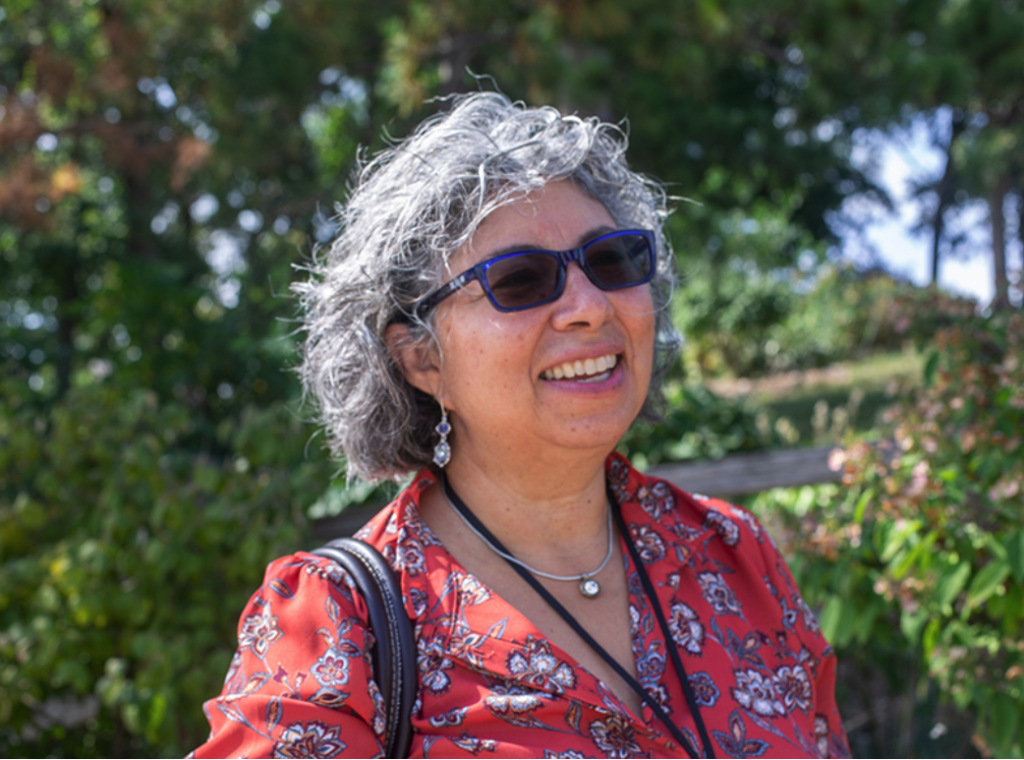
Pilar Melero, professor of languages and literatures. Photo contributed by UW-Whitewater/Craig Schreiner photographer.
Trippe, Cravath herbicide application reevaluated, mowing to begin Friday
(Originally published Nov. 3, 2021.)
By Kim McDarison
Whitewater City Manager Cameron Clapper Tuesday announced that mowing activities to reduce vegetation growth and prepare the Cravath and Trippe lake beds for future dredging will begin Friday and likely will reach completion over the weekend.
The information came as part of a city manager’s report delivered to the Whitewater City Council during its regularly scheduled monthly meeting.
According to Clapper, a next step in the process would include burning vegetation, with that activity slated for late November or early December.
After burning is completed, Clapper said, lake dredging is anticipated to begin sometime in early 2022.
In a lake restoration update delivered during a city council meeting held Oct. 19, Parks and Recreation Director Eric Boettcher noted that plans to use herbicide as part of the ongoing lake restoration efforts had been reevaluated.
According to Boettcher, use of herbicides within the lake beds, as previously planned, would likely be greatly reduced. He cited plant die down, which was naturally occurring, as reason for reevaluating the plan.
Lake update from Boettcher
Boettcher said that after talking with the city’s consultant, Field and Stream Restorations, which is also the company that will be performing the herbicide and mowing work, he’d been made aware that vegetation die down within the lake beds had reduced the potential effectiveness of herbicidal spraying.
According to Field and Stream, Boettcher said, “Over 25% of the vegetation — there is 25% die back — so what that means is that we could spray, but it wouldn’t be as effective as it was over a month ago. With the drought lake conditions this year, everything has gone to seed a lot earlier, so we are looking at transitioning and switching over to mowing the lake bed.”
Boettcher noted that some spraying might still be effective, but that activity would not occur in areas that had “gone to seed.”
“The majority of the lakebed will be mowed,” he said, adding that he believed the activity would start around the first week in November.
Field and Stream Restorations has three different types of mowers that will be employed in the lake beds, Boettcher said.
They are a Kubota with a track and a 57-inch deck, a John Deere with a 64-inch deck, and an ATV with an attached mower.
Some cutting of bigger trees will also be done by hand, he added.
“That is our most effective way to take care of that at this point,” Boettcher said.
“They may spray certain areas if it’s going to be deemed effective, but they are looking at the majority of it being mowed,” Boettcher added.
According to Boettcher, the city is working towards obtaining a burn permit, with hopes that an initial controlled burn can take place within the lake beds at the end of November or early December. Plans further call for a second controlled burn to take place in April or May, he said.
“We will burn in November, December, then hopefully have our dredging in the winter and do another controlled burn before we refill (the lakes),” Boettcher continued.
Additionally, Boettcher said, the city has posted a bid for dredging. A request for bids was released on Thursday, Oct. 14, with the bidding period closing on Nov. 6. He anticipated bringing a bid proposal before council on Nov. 16.
Councilman Jim Allen asked if the city had received an “adequate number of bids.”
Boettcher noted that the city had received one or two inquiries, but it was still early in the process.
Allen noted that he had seen a drone flying over the lakebed, presumably taking pictures and mapping, he said.
Boettcher said drones had been taking photos and video of the lake beds and the information would be used to update dredging plans.
He said, initially, the city planned to remove 87,000 cubic yards of lakebed materials, but with “scouring,” over a period of time, there was a likelihood that less materials might be removed.
“With the scouring and new additional time with the drawdown, they (mapping contractor) are thinking that we won’t have quite as much material to remove, so they are reevaluating that to make sure that our bid quantities are correct,” Boettcher said.
Defining “head cutting” and scouring, he said: “The head cutting is the stream, basically, that is going through each lake, and as we would then draw down, the scouring is basically the erosion of that stream; so that has gone down further and further because we’ve been drawn down for an extended period of time. So that has removed some of the sediment that we were planning on removing, so that is why we are reevaluating the amount of material to remove through our dredging plan footprint, and that way, we have a better idea of what we’re asking our bidders, or our contractor, to basically remove.”
More accurate information would help avoid work change orders in the future, he said, adding: “it is important that we have an accurate quantity of actual sediment that we will be removing.”
Councilwoman Brienne Brown asked about the city’s plans to inform lake area residents about changes being made in the city’s plans.
She had earlier heard from constituents, she said, regarding a meeting about herbicides, with those people noting that they were unaware of the meeting, she said.
Boettcher said the city made two public postings about the meeting and mailed a packet of information to residents living along the lakes. Information was also posted to the city’s website, he said.
“Moving forward with it and the changes, the mowing isn’t as big a deal as the herbicidal treatment because we are just cutting down the materials,” Boettcher said.
“There were a lot of rumors floating around,” Brown said, adding: “People who are most affected … are the people who live against the lakes, so it seems to me like we need to be a little bit more diligent about giving them information.”
Boettcher said that could be done.
An earlier story about lake restoration plans is here: https://fortatkinsononline.com/herbicide-application-explained-could-begin-next-week-whitewater-officials-say/.

City of Whitewater Parks and Recreation Director Eric Boettcher addresses the Whitewater City Council Tuesday, Oct. 19. Boettcher delivered a lakes restoration project update, sharing with council that the herbicide application earlier planned for the Trippe and Cravath lake beds had been reevaluated. The majority of the lake beds will instead be mowed, followed by two controlled burns and dredging before water is returned to the lakes.
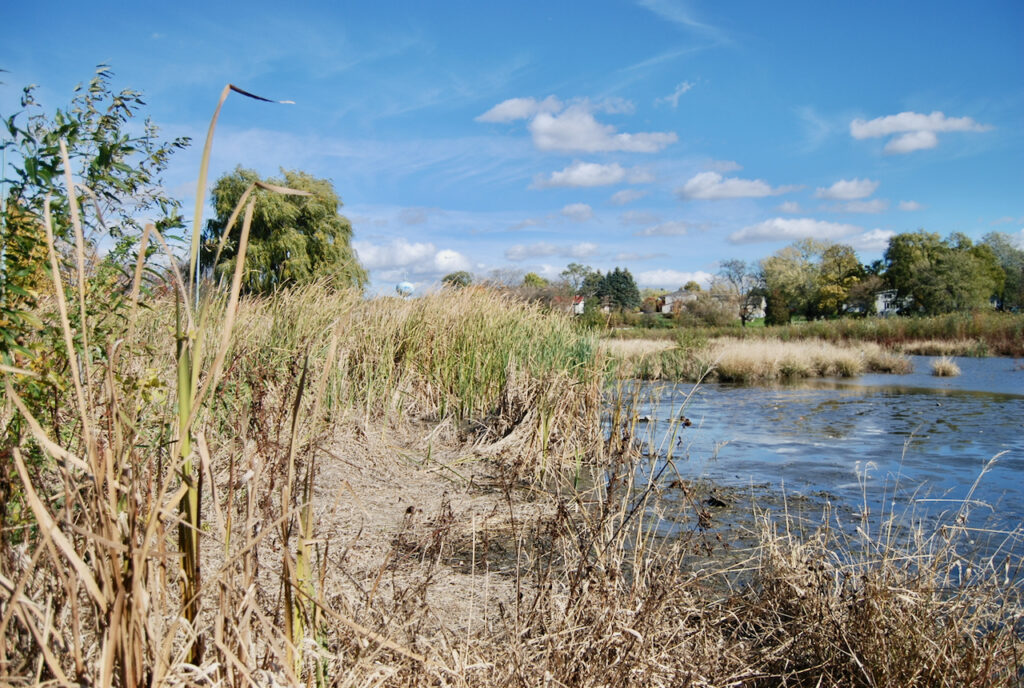

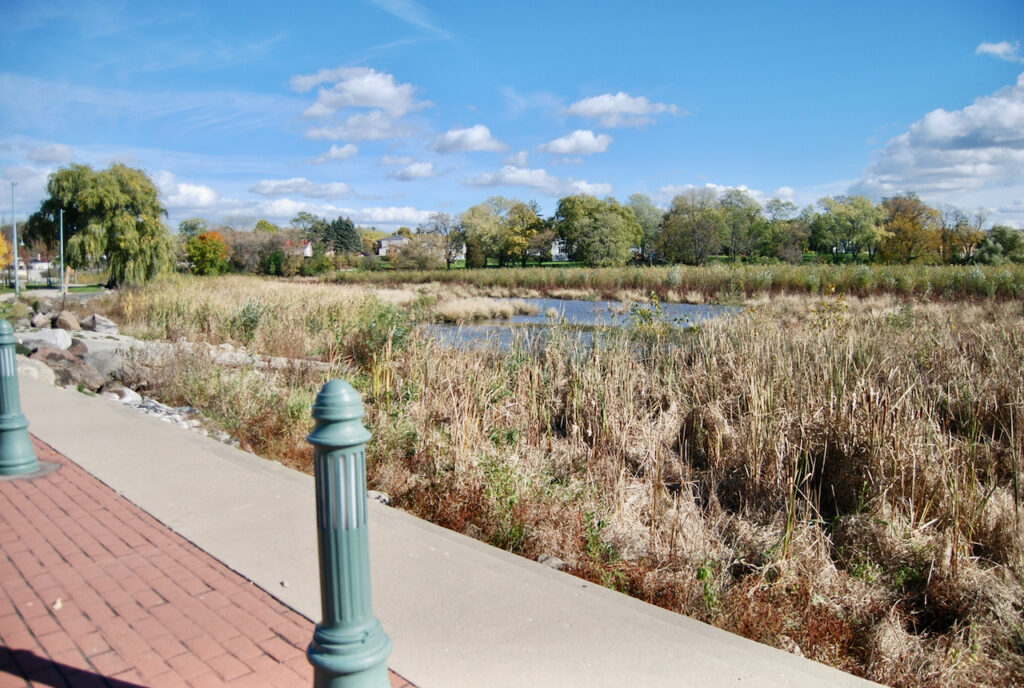

Four photos above: Vegetation in the drawn down Cravath lakebed is dying back, a phenomenon attributed to drought conditions brought about by an extended drawdown period and seasonal changes, according to city officials. The conditions have prompted a reevaluation of earlier plans to use herbicide to kill vegetation growing in the lakebed, officials have said. Mowing, to prepare the lakebed for two anticipated controlled burns and dredging is scheduled to begin on Friday. Kim McDarison photos.
Area K-8 schools place within top 30% statewide, says U.S. News
(Originally published Nov. 12, 2021.)
By Kim McDarison
Several schools within the Fort Atkinson, Jefferson, Whitewater and Milton school districts make the grade according to a 2022 list of K-8 schools recently released by U.S. News and World Report.
While the publication is known for annual rankings of high schools and colleges, the 2022 K-8 ranking, released late last month, is the first to assess K-8 schools based on their share of students who are proficient or above proficient in reading/language arts and math as measured by state assessments, along with socioeconomic demographics.
“In other words,” the report states, “the top-ranked schools are all high achieving and have succeeded at educating all their students.”
Rankings are calculated using data from the 2018-19 school year.
The report ranks K-8 schools within each state and does not produce a national ranking, according to the publication.
Schools ranked within the top 30% within their state have an overall performance score, as determined by the publication, of 70.00 or higher.
School District of Fort Atkinson
Within the School District of Fort Atkinson, Barrie and Rockwell elementary schools both score within the top 30% statewide, as does the Fort Atkinson Middle School.
Statistics collected by the online media service for each of the district’s four elementary schools are here: https://www.usnews.com/education/k12/search?grade=2&state=WI&district-id=110810&school-type=charter&school-type=magnet&school-type=public.
Statistics collected by the online media service for the Fort Atkinson Middle School are here: https://www.usnews.com/education/k12/wisconsin/fort-atkinson-middle-262827.
Jefferson School District
Within the Jefferson School District, Sullivan Elementary School is among the state’s top 30%.
Statistics collected by the publication for the district’s three elementary schools and middle school are here: https://www.usnews.com/education/k12/search?state=WI&district-id=112935&school-type=charter&school-type=magnet&school-type=public.
Whitewater Unified School District
Within the Whitewater Unified School District, two of the district’s three elementary schools, Lakeview and Washington, also make the grade.
Statistics collected by the online service for each of the district’s three elementary schools are here: https://www.usnews.com/education/k12/search?grade=2&state=WI&district-id=112881&school-type=charter&school-type=magnet&school-type=public.
Statistics collected by the publication for the Whitewater Middle School are here: https://www.usnews.com/education/k12/wisconsin/whitewater-middle-270074.
Milton School District
Within the Milton School District, two elementary schools, West and Harmony, are among the state’s top 30%, as is Northside Intermediate School.
Statistics presented online for each of the district’s four elementary schools are here: https://www.usnews.com/education/k12/search?grade=2&state=WI&district-id=112204&school-type=charter&school-type=magnet&school-type=public.
Statistics collected by the publication for the district’s middle and intermediate schools are here: https://www.usnews.com/education/k12/search?grade=3&state=WI&district-id=112204&school-type=charter&school-type=magnet&school-type=public.
The full report, offering a searchable database by state and school district, is here: https://www.usnews.com/education/k12/search?school-type=charter&school-type=magnet&school-type=public.
Wisconsin DPI: Schools at a glance
Statistics shared by the Wisconsin Department of Public Instruction (DPI) show that as of the 2019-20 school year, the state has 2,190 public schools. Of that number, 514 are high schools, 19 are junior high schools, 359 are middle schools, 1,206 are elementary schools, 92 are combined elementary/secondary schools, 211 are district charter schools, and 25 are non-district (2R) charter schools. There are 421 public school districts in the state.
An overview of statewide school and enrollment statistics is here: https://dpi.wi.gov/sites/default/files/imce/eis/pdf/schools_at_a_glance.pdf.
U.S. News and World Report
According to online information, U.S. News and World Report is a media company, publishing news, opinion, consumer advice, rankings and analysis. The magazine launched in 1948 after merging two weekly publications: U.S. News, a newspaper with a domestic focus, and World Report, a magazine with an international focus. The company launched its website In 1995 and ceased printing the magazine in 2010.

File photo/public domain.
Whitewater: City rejects Trippe, Cravath dredging bids, explores new bids, scope
(Originally published Nov. 21, 2021.)
By Kim McDarison
The City of Whitewater Common Council rejected two bids obtained earlier this month to dredge Trippe and Cravath lakes near the city’s downtown area.
Additionally, council authorized city staff to solicit new bids and speak to “any and all people who are interested in dredging the lakes.”
The directives, packaged in a single motion, were approved unanimously by council during its most recent meeting held Nov. 16.
New program initiatives identified by staff are anticipated to be shared with council by City Manager Cameron Clapper during its next meeting scheduled for Dec. 7.
During the meeting, Clapper told those in attendance that the city, after undergoing a formal bidding process, received two bids for the project, both of which exceeded the $1.5 million the city had earmarked for the project.
The city received the two bids, according to information supplied within the meeting packet, on Nov. 11. No other information about the bids was presented in the packet.
Sharing a slide, Clapper noted that a bid of just over $2.49 million had been received from A-1 Excavating, Inc., and a bid of just over $3.8 million had been received from Michaels Marine.
Addressing council before sharing the bids, Clapper said: “The lack of material or a memo in your packet was deliberate because we got numbers that were higher than we anticipated and we wanted to do some legwork in advance of this meeting on what would be the most appropriate course of action for this body as we look at the lakes project.”
The slide further noted that staff was recommending that council reject both bids and authorize it to “negotiate with A-1 on an affordable project within budget parameters.”
Price and parameters
Citing earlier commitments made to the project, Clapper said: “You all may recall we were looking in the realm of $1.2 to $1.5 million for the original estimate on the project.”
Referencing the two bids received, he said: “both of those numbers are higher, so, at this point, we have to reevaluate the scope of the project or the timeline for the project to make this, the dredging and the completion of the lakes project, a reality.”
To achieve those goals, Clapper said, staff was recommending that the council reject the two bids and authorize it to continue to negotiate with the lowest bidder, looking for alternatives that could be incorporated into the project, while bringing costs closer to those initially anticipated by the city.
Whitewater Parks and Recreation Director Eric Boettcher also addressed council, noting that the bids received by the city “weren’t close to what we were hoping for.”
He shared some of the process that went into receiving the bids, stating that on Oct. 26, city staff took five potential bidders on a tour of the project area, calling the event a “pre-bid meeting.”
The tour included the lake beds slated for dredging and the sites identified for depositing dredging spoils.
“Unfortunately, that weekend prior, we had about two and a half to three inches of rain, so I think that may have scared off some of the bidders that we were going to get. I believe there were 16 different bid packets that were pulled and obviously we only had two people bid,” Boettcher said.
In response to the bids received, he said, city staff was “regrouping and trying to see where we could go from here.”
Boettcher said Ayres Associates, a Eau Claire-based architectural and engineering firm which has been working on the project with the city, had been asked to contact potential bidders who had earlier expressed interest in the project to learn about their “hesitations,” and also learn why the bids the city did receive were so high.
Staff was interested in learning what else it might do to continue with the project, he said.
Additionally, Boettcher said, city staff had contacted the city’s attorney.
“Technically, we can go out and negotiate with a contractor to see if we can get a better price. One of the things we are looking at is whether to just dredge one lake this time and then see how that goes or see how much we can dredge with the budget amount $1.5 million,” Boettcher added.
According to Boettcher, the city is waiting to learn from Ayres Associates about what it might cost to dredge only one of the two lakes.
“Looking at Trippe, that was the one that was most difficult to draw down. I would suggest if we were to dredge one lake, we would look at Trippe first and then we can always revisit Cravath,” Boettcher noted.
Boettcher stated that he had also spoken with resident and landowner Geoff Hale, who had earlier granted the city permission to use his property as a deposit site for dredging spoils. Boettcher said that Hale stated he would still be supportive of the project if plans changed, making Trippe Lake the first to be dredged.
Hale’s property in on Cravath Lake, Boettcher added.
“Whatever we decide, we have done the best we can to be prepared at this point for where we are with this project and again, if all else fails, we did have a successful drawdown that will, regardless, also benefit our lakes regardless if we dredge or not,” Boettcher said.
Timeline
Citing potential changes in the project’s timeline, Clapper said the city still anticipated moving forward with some dredging in the first part of 2022.
A next step would be to bring “additional details” about any changes to the project before council for its consideration on Dec. 7.
“We are going to be working as quickly as we can on this issue and come back with additional information,” Clapper said, adding: “I do want to reiterate though what Eric shared at the end (of his presentation).
“We’re not done with the idea of having the dredging happen, but we’re going to obviously be working with some other contractors, now that we’ve done a formal public bidding process, to see what we can negotiate.”
Clapper continued: “If for any reason we do have to delay dredging, and look for another alternative for dredging, we have, by virtue of the process, now established a way to drawdown each lake so that we can visit the dredging if necessary in the future.”
Clapper said lessons learned from the drawdown activity that had already taken place would allow any future processes to be done with “greater ease” because “of the obstacles we’ve discovered and the things we’ve been able to overcome.”
Clapper reminded council that he, Boettcher and Public Works Director Brad Marquardt had earlier in the process accompanied Department of Natural Resources (DNR) Representative and Lakes Biologist Heidi Bunk on a field trip where they were introduced to School Section Lake.
The 122-acre lake is in Waukesha County.
“It’s a beautiful lake, and much like ours, it’s an impoundment. The lake, in many places, most places, in fact, except a specific area where they did a significant dredge about 20 years ago — with the exception of that location — the lake is about 18 to 36 inches deep,” Clapper said.
He described the lake as active, and with “beautiful, clear water. That’s what we anticipate when we refill our lake.
“So worst case is not all bad, but I do think that before we go there we are definitely wanting to come back to this body with a program that is longer in scope for dredging, but allows for us to be able to continue with our dredging project as well. Just not all in 2022 most likely,” Clapper said.
The way forward
Taking the podium, Hale described for council his impressions of the October pre-bid meeting, saying: “I was on that bus trip with these contractors and there was not a single one of them that took the time to take one foot of step into either one of those bodies of vegetation. They all walked away assuming that it was going to be too wet to deal with.”
Hale advocated for council to rebid the project or look locally for other prospective contractors. The owner of a lumber yard, he offered his own contacts and expertise to help with the search.
“I don’t think there’s any reason that we can’t come in with a number that’s closer to what’s budgeted,” Hale said.
Councilman Jim Allen called the situation “the worst news we didn’t hope for,” adding: “When we all started this project, I think we all held our breath. And of course none of us wanted this to happen, but some fault needs to be shared with the DNR who wouldn’t allow us to drain the lakes sooner or at a faster rate, which expanded the length of the program from one year to two.”
Allen asked if legally the scope of the project could be changed and then rebid.
Marquardt said he had discussed that option with the city’s attorney who recommended that the council reject the bids the city received. They also discussed the possibility of using a change order, with a contractor signing a contract with a reduced scope of work.
According to Marquardt, in the city attorney’s opinion, he said, “from what he saw, that the step project does not constitute a public construction project, but it is a maintenance project, which does not need to be publicly bid. He thought that it would be very prudent of us to do the public bidding to start with, but he does recommend rejecting the bids and negotiating with a contractor of our choosing on a price for the work.”
Allen said he saw a benefit in having individuals like Hale approach potential contractors to learn if they might have interest in the project.
Allen cited the DNR as “hard to work with,” adding: “They have never brought a hydrologist in front of us and we are all holding our breath. I don’t think any of us wants to do one lake, which essentially doubles the cost of the project; we’ve already committed $1.3 million. I’m getting more scared all the time. We don’t even know that if we do one or two of the lakes, how long it will last before they fill back in, or what maintenance will need to be done after that.”
He added: “I would suggest that we keep the commitment of $1.3 (million) and go back to all the contractors and see what they can do for us in that amount; that, or we change the scope and hand it back to them to see what we can find out.”
Comparing lake water levels today against where they were in October, Councilwoman Carol McCormick said: “Trippe Lake is a lot lower now. And I would think it would be good to have people revisit it now and see that the depth of water is minimal in most places. You just see mudflats right now.”
Citing the earlier rain, she said, “Mother Nature did not do us any favors.”
Before a vote to direct staff was taken, Clapper suggested removing the request for staff to work with A-1, as earlier recommended, proposing instead that council reject the bids and authorize staff to work with a contractor of “our choosing” to come back with a project that better aligned with the original scope, cost, and overall project. The new language was adopted into the final motion.
An earlier story about the Trippe and Cravath lakes restoration project is here: https://fortatkinsononline.com/trippe-cravath-herbicide-application-reevaluated-mowing-to-begin-friday/.
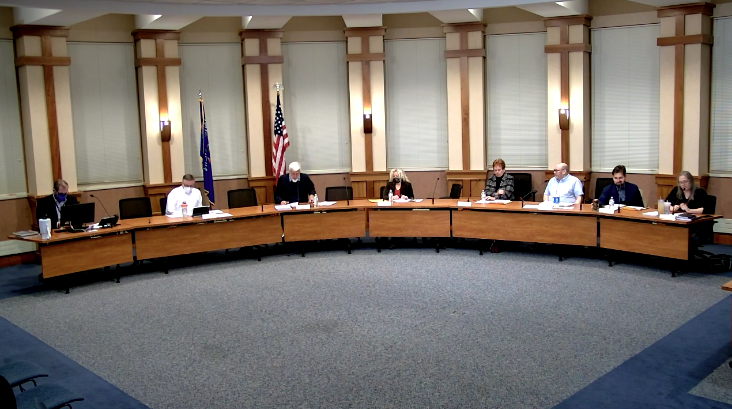
The Whitewater Common Council assembles for its Nov. 16 meeting. The Trippe and Cravath lakes restoration project was among topics discussed during the meeting.
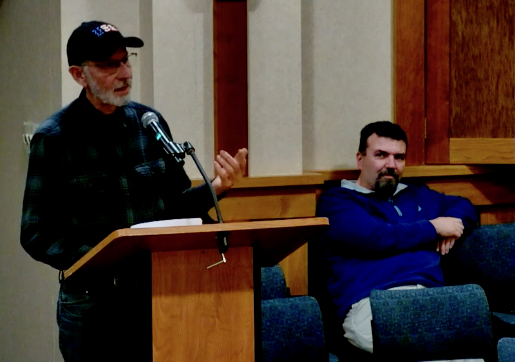
Whitewater resident and landowner Geoff Hale, at left, addresses the Whitewater Common Council during its meeting held Nov. 16. Hale described his impressions of a pre-bid meeting held in October during which five contractors were brought by bus to see the city’s Trippe and Cravath lakes dredging project. According to Hale, who was also in attendance, the contractors did not adequately explore the proposed dredging area. Whitewater Parks and Recreation Director Eric Boettcher, who has helped to oversee much of the execution of the project, is seated. The city is developing next steps for the project with further discussion expected in December.
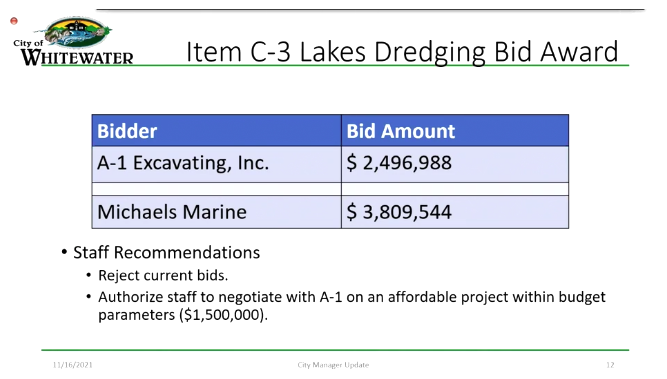
A slide, shared by Whitewater City Manager Cameron Clapper with those in attendance during a meeting of the Whitewater Common Council held Nov. 16, shows two bids received by the city for proposed dredging work to take place in the Trippe and Cravath lake beds. Both bids, and the only bids received by the city, show costs that exceed the amount authorized by the city council for the dredging project.
Whitewater school board member, founder of ‘Whitewater Banner’ James ‘Jim’ Stewart dies
(Originally published Nov. 29, 2021.)
Editor’s note: The following obituary was posted today by Nitardy Funeral Home.
James “Jim” McBride Stewart was, up until the time of his death, a member of the Whitewater Unified School District Board of Education and is the founder of the Whitewater community website known as the “Whitewater Banner.”
His full obituary is here:

James “Jim” McBride Stewart
Whitewater police chief placed on paid administrative leave
(Originally published Dec. 3, 2021.)
Editor’s note: the following information has been supplied by the City of Whitewater.
December 3, 2021 – Whitewater Police Chief Aaron M. Raap has been placed on paid administrative leave. Deputy Chief Dan Meyer is serving as acting Police Chief until further notice. The Whitewater Police Department operations will continue without disruption and with full expectations of providing high quality services to our community.
An internal investigation will be conducted by an outside agency based on an incident that occurred outside the city of Whitewater. The leave is not considered punitive, rather part of the Whitewater Police Department policy.
Because this is an ongoing investigation, no additional information will be released at this time.
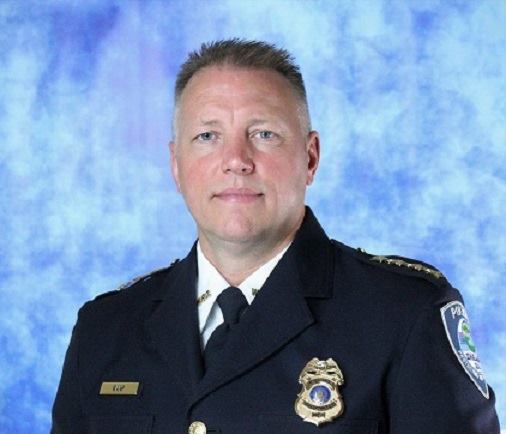
Aaron Raap
One dead after semi versus car crash in Whitewater
(Originally published Dec. 3, 2021.)
The following information has been released by the Walworth County Sheriff’s Office.
On Friday, Dec. 03, at approximately 10:11 a.m., the Walworth County Sheriff’s Office 911 Communications Center received a report of a motor vehicle crash involving a semi-truck and a passenger car in the city of Whitewater at the intersection of Highway 12 and Walworth Avenue.
City of Whitewater Police, Walworth County Sheriff’s deputies and the City of Whitewater Fire / Rescue Department were dispatched to the scene.
The initial investigation reveals a female driver operating a 2000 Dodge Neon was southbound on Highway 12 and attempted to turn left at Walworth Avenue failing to yield the right of way, crossing into the path of a semi straight truck loaded with steel pipe which was northbound on Highway 12.
As a result of the crash, a male occupying the front passenger seat of the Dodge Neon was killed. First responders attempted life saving measures along with a MD-1 Mercy Doctor unsuccessfully.
The female driver of the Dodge Neon was transported by ambulance to a local trauma center with critical injuries. The truck driver was also transported by ambulance to a local hospital for treatment. The conditions of each are unknown at the time of this release.
The Walworth County Sheriff’s Office Traffic Crash Reconstruction Team is conducting a crash reconstruction. The Wisconsin State Patrol is conducting a post-crash inspection of the semi-truck.
This case is an active investigation and no additional information will be released at this time.
Names are being withheld pending proper notification of relatives and positive identification of the deceased by the Walworth County Medical Examiner’s Office.
Bethel House’s Weinberg receives ‘Making Democracy Work’ award
(Originally published Dec. 8, 2021.)
The League of Women Voters of the Whitewater Area has announced that Kristy Weinberg, director of The Bethel House of Whitewater, has been chosen as the recipient of the league’s 2021 Making Democracy Work award.
According to information released by the league, Weinberg was chosen for her compassionate work helping families facing homelessness in Whitewater.
For over ten years, Weinberg has administered transitional housing and case management needs to at-risk Whitewater families to build a more equitable and inclusive community. These values exemplify the spirit and the mission of the league, the release stated.
A recognition ceremony for Weinberg was video recorded on Dec. 3 by Whitewater Community TV and is available for viewing at: https://vimeo.com/654247489.
During the presentation, tributes were made by Dave Gamble, The Bethel House treasurer, and Jim Winship, a founding member of The Bethel House and current board vice president.
The league’s annual Making Democracy Work award was established in 2010 for the purpose of honoring the civic work of individuals or groups that make the community a safer and fairer place in which to live, the release continued.
About the league
The League of Women Voters is a nonpartisan political organization that encourages informed and active participation in government, works to increase understanding of major public policy issues and influences public policy through education and advocacy. For more information, visit the organization’s website at https://my.lwv.org/wisconsin/whitewater-area.
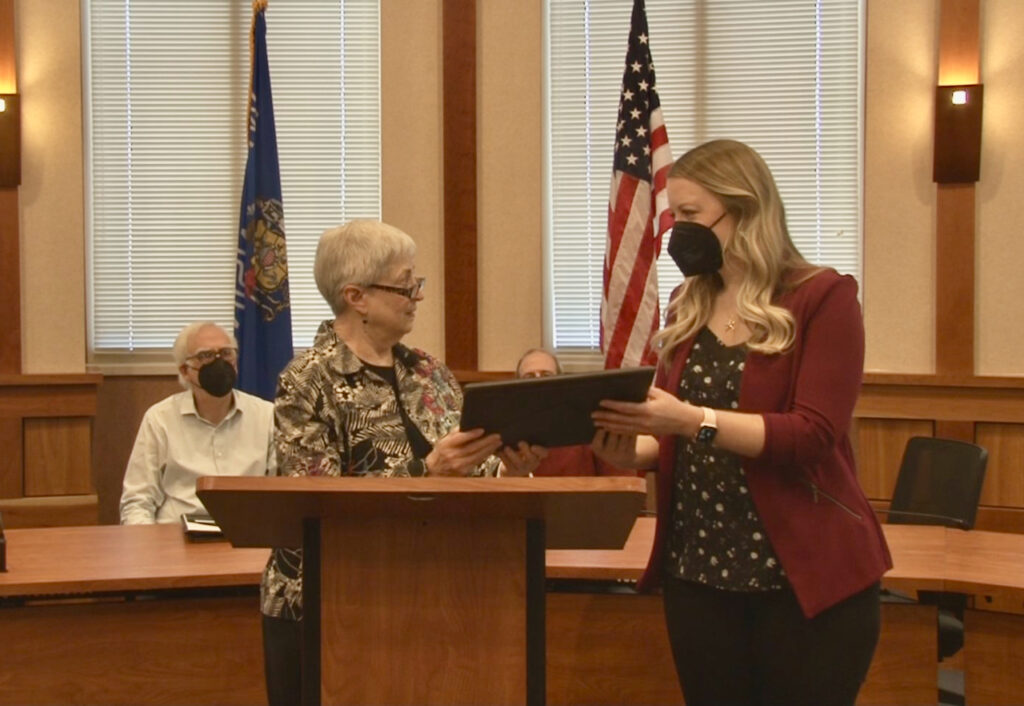
League of Women Voters of the Whitewater Area Co-President Mary Beth Byrne, at left, presents Kristy Weinberg, director of The Bethel House of Whitewater with the league’s 2021 Making Democracy Work award. The presentation was made Dec. 3 and was recorded for online viewing. Contributed photo.
The full presentation can be viewed below.
Behind the scenes: The making of a virtual art reception
(Originally published Dec. 9, 2021.)
By Kim McDarison
The Whitewater Arts Alliance is producing a virtual art reception to complement its online and in-gallery “members” art show. The members show, featuring the work of 19 local artists, will be on display until Dec. 19.
This is the second time the alliance has created a virtual reception for the annual members show, Whitewater Arts Alliance Gallery Manager Nicole Holder said, adding that the first was created last year as a safety response to COVID-19.
The alliance, like many organizations working within an ongoing COVID landscape, has embraced a hybrid model for its exhibits, offering both an online and in-person approach to viewing art, Holder said, and while the show can be viewed in-person in the gallery, a virtual reception continues to provide a value for the alliance, its member artists, and the broader participating public.
A new landscape
According to Holder, before COVID-19 protocols were put in place, an art show reception traditionally offered an opportunity for the public to meet and talk with participating artists. In the case of the annual members show, artists were on hand to greet event-goers and share their artistic concepts. The members show reception was also a good place to introduce aspiring artists to the local art community, give area artists an opportunity to network with each other, and grow the alliance’s membership.
Last year, with COVID-19 safety protocols in place, the alliance was exploring ways to retain the traditional benefits of the art reception, without exacerbating any uncertainties which might have been brought about by gathering artists together in close proximities, Holder said.
In response to those challenges, she added, the concept of the virtual reception was developed.
This year, as the alliance continues to embrace COVID safety protocols through online opportunities, the virtual reception remains a good alternative and also has become a beneficial tool to make art more accessible to a broader viewing public, Holder said.
Benefits of virtual
“One of the benefits of a virtual show is that traffic on our website is pretty consistent, where in-person attendance is not,” Holder noted.
She described a “snow bird” aspect to the alliance’s membership and those that frequent public art events in the area. As artists and patrons of the arts seek warmer climates for the winter, fewer visitors arrive in person to shows and receptions.
“So the website brings a more reliable viewership for our shows,” Holder said, adding, “it also gives alternatives for people who are still uncomfortable with in-person events.”
Additionally, Holder said, the City of Whitewater has offered the alliance feedback, expressing gratitude that the organization has continued through use of alternative approaches to keep art accessible to the community.
“They were glad we were doing the virtual event this year. They appreciated that we were still putting in the effort to pull in artists to our community and that, even with COVID, we did not give up and shut down,” Holder said, adding that it was important to the Whitewater Art Alliance board, membership, and city officials that an avenue was provided to promote art, support local artists and draw visiting artists and art enthusiasts to the community.
In-person events continue to draw visitors, Holder said. This year, the Whitewater Arts Alliance gallery has been visited by viewers from Whitewater, Fort Atkinson, Elkhorn, Lake Mills, De Pere, Reedsville, and even Atlanta, Ga., and Mexico.
Patterns and Participation
During the pandemic, some patterns in gallery in-person attendance continued: throughout the summer months, shows drew crowds, Holder said, adding that summer events brought the most event-goers seen by the alliance since the onset of the pandemic, but, she admitted, the number of those participating in events was still lower than what might have been anticipated in previous years.
Still, she said, she and the alliance members have been happy to receive the visitors that have come, with many member artists noting that event participation was better than they expected in a COVID year.
Looking at online statistics, Holder said, over the last year, online shows have received about 300 views per show. Those numbers have remained consistent from show to show.
The gallery runs shows regularly, with each online event viewable for a month.
Another benefit is that an online show is easier for volunteers to set up.
“It’s easier to click and drag than it is to set up, hang, level and label each piece,” she said.
While the presentations are easier to assemble, she noted, when comparing a virtual show to one held in person, some elements are lost.
“One concern is that online, a viewer cannot tell how big the piece actually is. That’s a huge part of the statement of the piece and it affects the feeling of the art as it affects you as a viewer,” Holder said.
Curation is also affected, she said, adding, in person, the art speaks for itself, but on a webpage, the composition is uniform.
“Each piece is presented in a square image box so that the overall layout on the page works well, but a lot of pieces don’t look the best when viewed as a square,” she said.
This year, Holder said, the alliance had two shows that were held virtually without an in-person option. They were the Whitewater Unified School District’s student art show which was held in April and a show introducing Holder as gallery manager, along with her artwork, which was held in January.
Additionally, since the development of the virtual option, some artists have opted to participate virtually only, she said.
“Some people are in poor health or are concerned about going into indoor spaces. Some artists have not been keeping up with what would have been a regular show schedule for them so they have pieces that are not printed and ready for an in-person exhibit, but they still can be placed online,” she said.
More recently, Holder added, alliance members and show participants have expressed a renewed sense of concern about rising COVID case numbers.
Further, Holder said, she sees continued benefits of virtual formats beyond their use as COVID precautions because artists who might have difficulty participating, like the disabled population or the elderly, or those in poor health, can more easily interact virtually.
For those reasons, she anticipates that virtual options will continue to have a place at the gallery even after the pandemic, she said.
Featured pieces and artists
The members show that is currently installed in the gallery and which will be featured in the virtual reception has 56 pieces in the gallery and 60 pieces displayed online.
Holder described the format of the online reception as being more like a tour, with Holder offering her perceptions about the art.
“I’m like a representative for the public as they view the art,” she said. She anticipates the full online reception video to run about 20 to 25 minutes.
“The virtual reception is more of a highlight of what is in the gallery. I picked one piece from each artist featured in the show. Work produced by 19 artists is featured virtually, 18 in the gallery. All 19 will be featured in the virtual reception,” Holder added.
Plans call for the reception to be made available for viewing on the alliance’s website this month.
Artists whose work will be discussed as part of the virtual reception include: Mary Abbott, Karolyn Alexander, Nik S. Chaphalkar, Craig Ede, M. Virginia Epps, Marilyn Fuerstenberg, Mary Anne Gerlach, Kathy Gibbs, Michael Havice, Dawn Hunter, John D. Koebler, Sylvia Linton, Everett Long, Ken Marsden, Jeff McDonald, Rick Santovec, Roy C. Schmidt, Terry Tutton and Amy Weh.
For more information about the Whitewater Art Alliance and its programming, visit: www.whitewaterarts.org.

As seen through the camera’s lens, Whitewater Arts Alliance Gallery Manager Nicole Holder talks about an artist’s piece on display in the gallery. The piece is among those featured in the virtual reception currently in production. The reception is slated for release on the alliance’s website later this month.
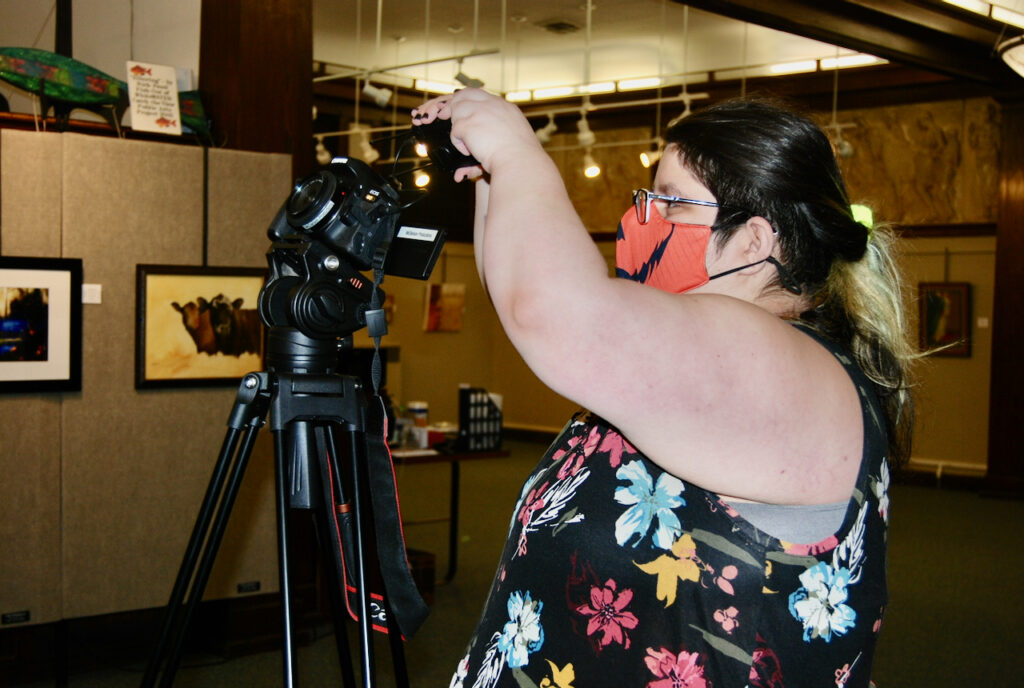
Contracted videographer Ashley McDarison sets up equipment in preparation of making the Whitewater Arts Alliance’s members show virtual reception. This year’s virtual reception is the second produced to highlight the annual members show, and also the second produced with McDarison as videographer. The virtual reception was produced last year as a COVID-19 safety measure.
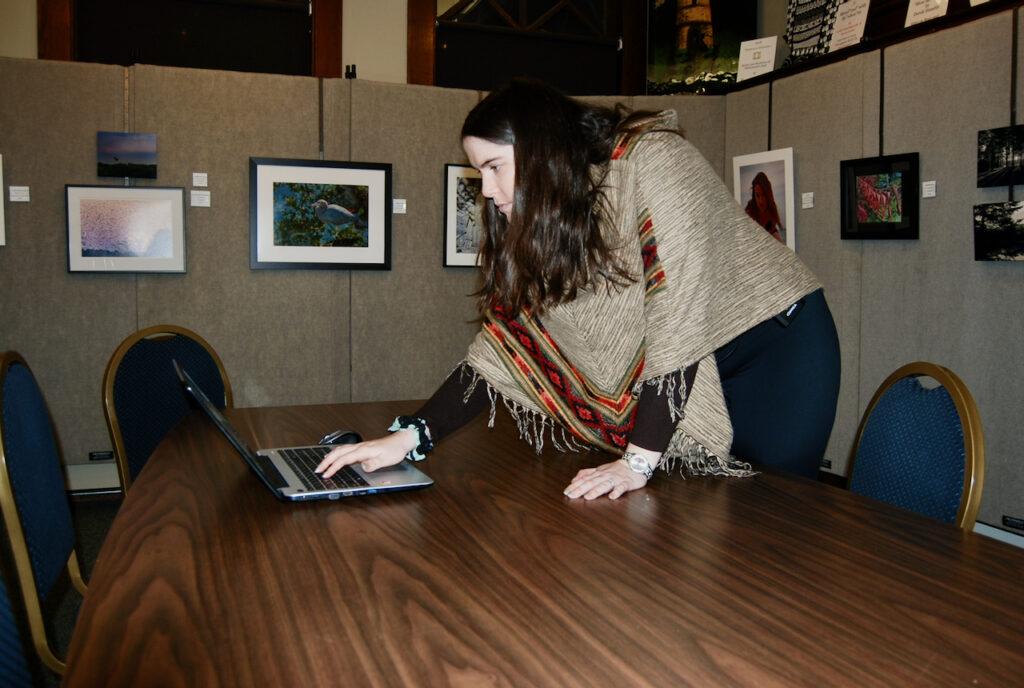
Whitewater Arts Alliance Gallery Manager Nicole Holder prepares an introduction which will be delivered as part of the members show virtual reception.
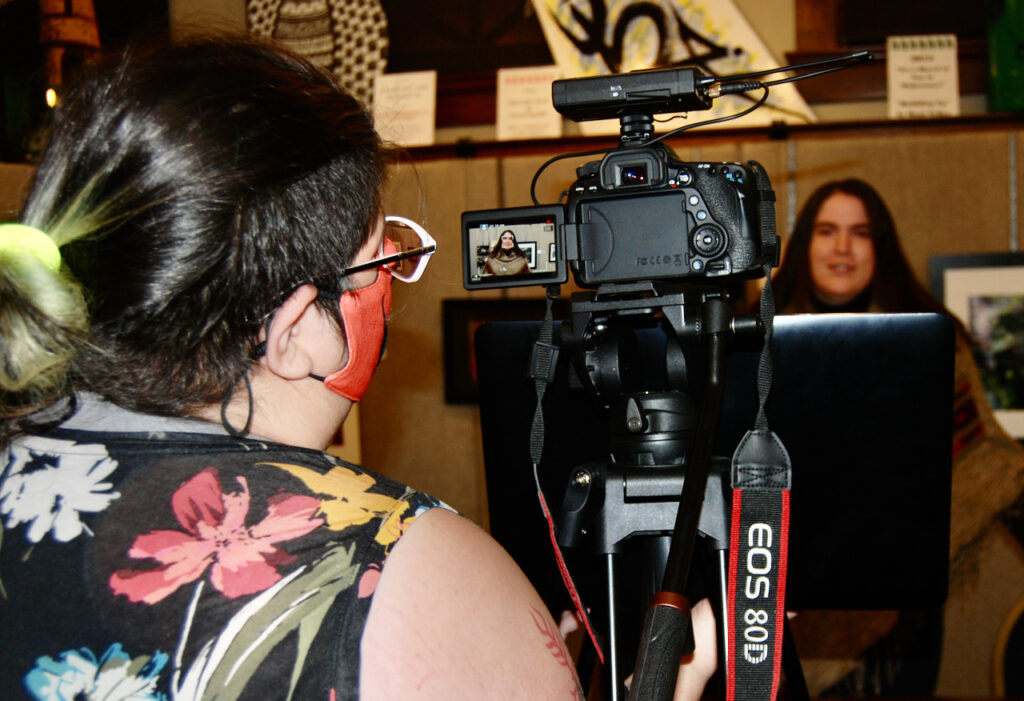
With camera rolling, Holder delivers and introduction for the members show virtual reception.
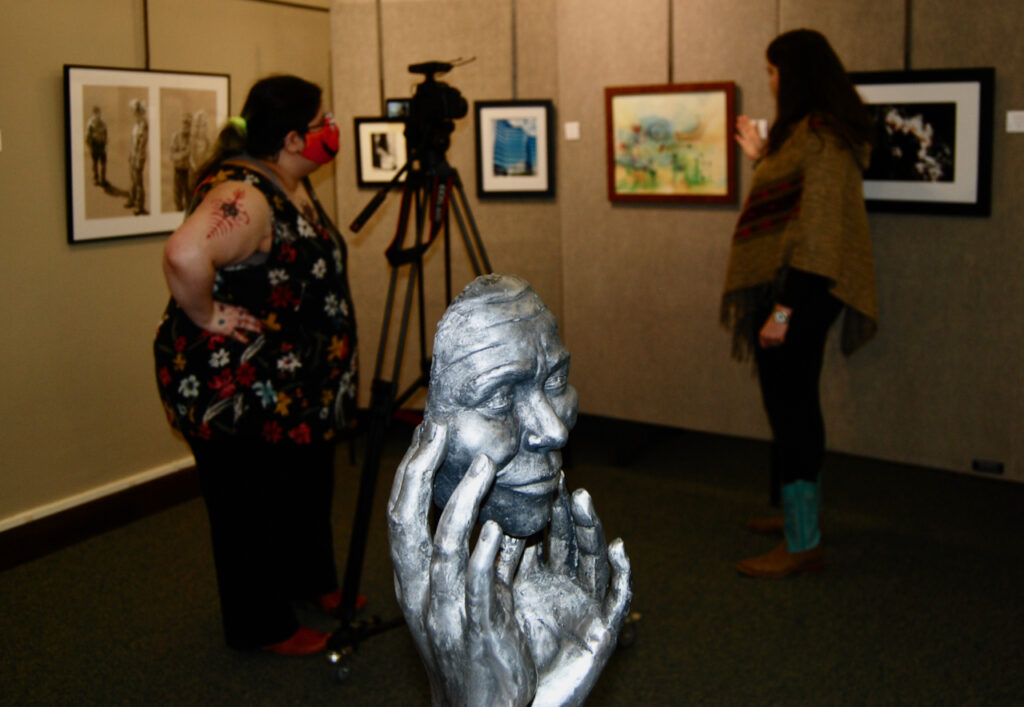
Contracted videographer Ashley McDarison, at left, and Whitewater Arts Alliance Gallery Manager Nicole Holder move about the gallery to feature selected pieces. Some 58 pieces are currently on display as part of the members show at the Whitewater Cultural Arts Center, 402 West Main St. Selected pieces from each featured artist will be included in the virtual reception.

Whitewater Arts Alliance Gallery Manager Nicole Holder shares her perceptions about the work of Fort Atkinson artist Amy Weh. Weh’s work is among pieces featured in the members show and also will be included in the virtual reception.
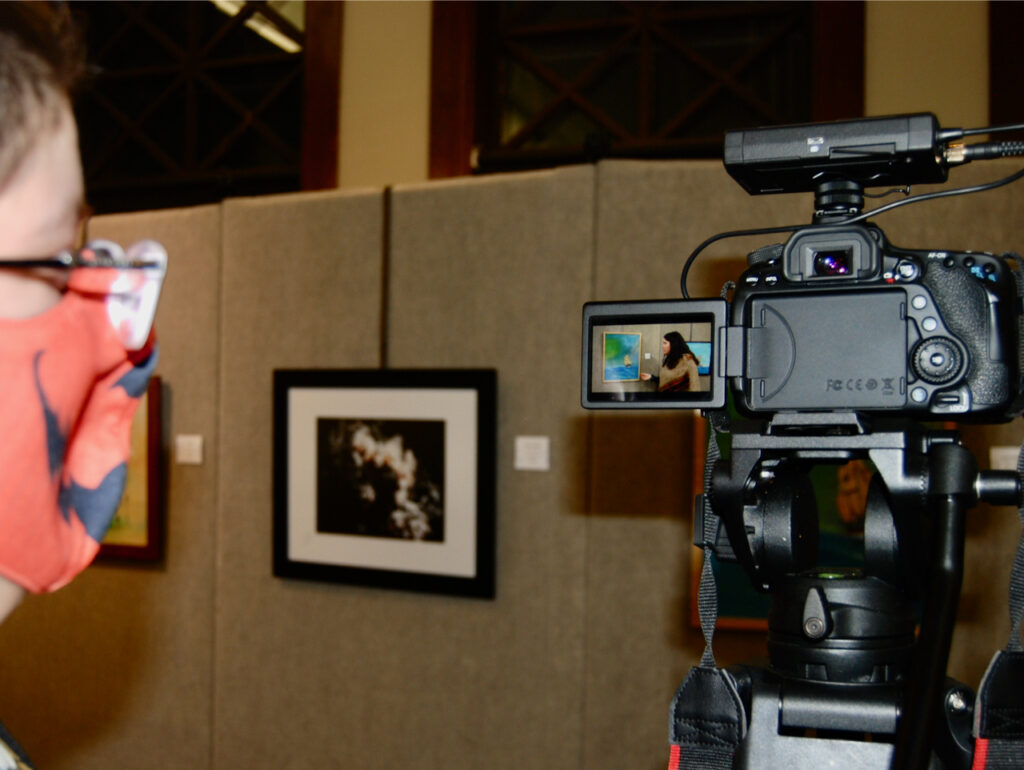
Contracted videographer Ashley McDarison views her work in progress. McDarison is a 2018 University of Wisconsin-Whitewater graduate, holding a degree in communications with an electronic media emphasis, and minoring in film studies.
Kim McDarison photos.
‘Information gathering’ continues in advance of lake restoration plans
(Originally published Dec. 11, 2021.)
By Kim McDarison
Whitewater Parks and Recreation Director Eric Boettcher, addressing the Whitewater Common Council remotely Tuesday, noted that more information was required before a plan to continue with the restoration of Trippe and Cravath lakes could be brought before council.
During a meeting held in November, council voted unanimously to reject the two bids it had received to perform dredging within the two lakes.
Both bids, Clapper explained in November and again on Tuesday, exceeded the amount the city had budgeted for the project.
The city received two bids for the project, one of $2.49 million and another for $3.8 million. The city had planned to spend $1.5 million.
Citing the two bids, Clapper said in November: “Both of those numbers are higher, so, at this point, we have to reevaluate the scope of the project or the timeline for the project to make this, the dredging and the completion of the lakes project, a reality.”
Clapper said staff would work quickly to bring additional information before council to develop next steps. He anticipated bringing new concepts before council for consideration on Dec. 7.
On Tuesday, Clapper said, the decision in November to reject the two bids was based on discussions with the city’s engineers and legal advisors. The rejection of the bids allowed the city to move forward — having met the requirements of a public meeting process, he said — and to reach out to other potential contractors who might provide options, allowing the restoration project to continue, but stay closer to budget.
“So we have done that, and we are gathering information, but we are not ready I think, yet, to have a vote on it tonight,” Clapper said.
Addressing council, Boettcher said that since the last council meeting staff had been in an “information gathering phase.”
“I’ve been in contact with five to six different contractors, trying to have another proposal. Unfortunately, I was hoping to have some proposals for you tonight, but since the last meeting we’ve also had a holiday season, and a lot of people go deer hunting, so I haven’t gotten the numbers back that I had hoped to get,” he said.
Boettcher said over the course of the previous two weeks, he had met with two contractors and had given them tours of the project area.
On Tuesday, he said, he had met with yet another contractor, and was planning to meet another within the days following Tuesday’s meeting and perhaps into early next week.
“So (we are) just trying to gather information and trying to see if we can get a better price. Obviously the almost $2.5 million price was a big price compared to what our budget was, so we are trying to work ways to whittle that down. In the meantime, I did reach out to the DNR (Wisconsin Department of Natural Resources) to find out some other questions, in case we need to extend and do this over a couple of years,” Boettcher said, adding that he learned from DNR that the city’s dredging permit would remain valid until November of 2026.
“So we have time there, and we could potentially keep the lakes drawn down, so right now, we’re just trying to find a contractor who will be able to do it closer to our budget and trying to work that process out. So hopefully at our next meeting, we’ll have some numbers for you and have something for you to discuss and move on,” Boettcher said.
Responding to Boettcher’s invitation to answer council members’ questions, Councilwoman Carol McCormick said: “I have one, because a lot of people are asking about it: There was talk of the controlled burn, is that still going to take place or is that kind of put on the back burner?”
Boettcher said the burn was scheduled to occur. Hired contractor Field and Stream Restorations still had some mowing planned, which, he said, was weather dependent, and scheduled, along with the anticipated controlled burn, for next week.
Additionally, he said, the company was working with the DNR to make sure the city’s burn permit was in order.
“When this comes back, I’d like to understand how much money we’ve spent so far and I think that would go into helping with making the decision,” Councilman Gregory Majkrzak II said.
He asked: “Is there a choice to do nothing? We just fill it back up?”
Majkrzak continued: “I’ve heard opinions from both ways: ‘We want to spend this money, we want to make it look like a beautiful lake.’ I’ve heard from the other side: ‘Why’d you do anything? Let nature take its course.’ If we could have that information that would help us.”
Boettcher said he could provide the requested information during the council’s next meeting.
“We can definitely have the option of what it would be if we don’t do anything, or if we just fill them back up,” Boettcher said.
He noted that he could provide costs associated with the project since 2016, which, he said, was before he became involved.
Councilwoman Lisa Dawsey-Smith advocated for communication, requesting, with regard to any potential burning, that a “very concerted effort” to inform the public be made.
“There are people who live in our community, such as myself, who are incredibly sensitive to smoke, so that’s very helpful to know,” she said.
Boettcher said the contractor is “required to notify through a letter before they do the burn. So, we will make sure that that’s followed through.”
“I gather the suggestion was more than a letter though. I think a notification …,” Council President Lynn Binnie said.
“I think we can tell the media as well,” Clapper added.
Councilman Jim Allen asked Boettcher to include a proposal for a dredging project of smaller scale than what was initially proposed.
“If we’re not going to have the dollars to do the dredging that we wanted to do, then do we want this to, you know, like Greg said — make it look nice … we at least want to then scale it back to dredging out in front of the park and in the old beach as possibilities,” Allen said.
A map provided by the city and indicating various controlled-burn-related zones along Trippe and Cravath lakes is here: https://www.whitewater-wi.gov/DocumentCenter/View/2666/BURN-MAP-12-08-21-PDF?bidId=.
An earlier story about lake-related dredging costs and the bidding process is here: https://fortatkinsononline.com/whitewater-city-rejects-trippe-cravath-dredging-bids-explores-new-bids-scope/.
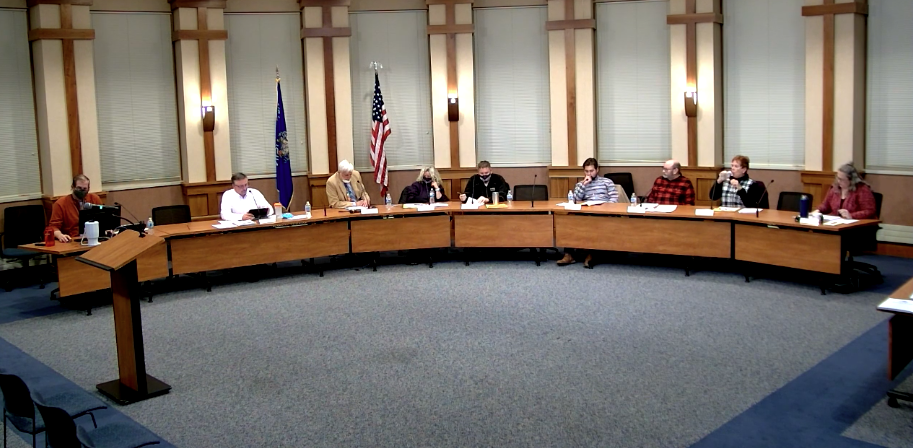
Members of the Whitewater Common Council receive an update on the Trippe and Cravath lakes restoration project. More time was required to gather information before staff could present options and next steps, both City Manager Cameron Clapper and Parks and Recreation Director Eric Boettcher noted during the Dec. 7 meeting.
Waukesha DA: ‘I’ve declined prosecution’; Whitewater officials: process ‘broader effort’
(Originally published Dec. 16, 2021.)
By Kim McDarison
While the Waukesha District Attorney’s office has stated it will not be bringing criminal charges against Whitewater Police Chief Aaron Raap, the City of Whitewater has announced that an ongoing internal investigation remains in place.
Regarding an arrest made by the Waukesha County Sheriff’s Department of Raap in November, Waukesha District Attorney Susan Opper, responding to questions Thursday by phone, said: “I’ve declined prosecution.”
There was a referral for charges, but after review, she said, she “did not find sufficient evidence that there was an intention to inflict bodily harm.”
Any further investigations, she said, “do not involve me whatsoever.”
Raap remains on paid administrative leave.
In a press release issued on Dec. 3, Whitewater city officials announced that Raap had been placed on leave pending an internal investigation, which, the release noted, “will be conducted by an outside agency based on an incident that occurred outside the city of Whitewater. The leave is not considered punitive, rather part of the Whitewater Police Department policy.
“Because this is an ongoing investigation, no additional information will be released at this time.”
Whitewater City Manager Cameron Clapper did not respond to Fort Atkinson Online’s questions about Raap’s status asked Thursday by phone.
In an updated press release issued Thursday, city officials noted that they had “received a number of media inquiries regarding the status of the investigation of Aaron Raap.”
The release continued: “The procedure is part of a broader effort to maintain the integrity of the organization as a whole, not a criminal investigation. As a result, the internal investigation runs independent from any decisions made by other agencies including Waukesha County’s District Attorney’s Office and will be completed as soon as possible.”
Raap was arrested at his home in Waukesha County on Thanksgiving day.
This story will be updated as more information is made available.

Gerber announces candidacy for Whitewater Common Council seat
(Originally published Dec. 16, 2021.)
Editor’s note: Information below has been provided by a political candidate announcing her intention to run for office. Other candidates wishing to run for political office will have equal opportunity to announce their intensions.
Whitewater community member Jill Gerber is running for the 4th District council seat being vacated by council member Lynn Binnie. Gerber believes in hard work, transparency and getting results.
Gerber has been a part of the Whitewater community for many years. She graduated from the University of Wisconsin-Whitewater with a business law degree and worked as the executive assistant to the Whitewater city manager from 2015 to 2019. During her time working for the city, she was able to learn the ins and outs of Whitewater. Gerber now works for UW-Whitewater in the Office of Field Experience within the College of Education and Professional Studies.
While already an involved community member, Gerber hopes to continue to serve the city of Whitewater and its residents as a common council member. She is a strong supporter in upholding the city’s transparency provisions adopted by the city council. A firm believer in informed decision making, Gerber maintains that providing council members and the public with information at least 72 hours prior to discussion allows enough time to understand the views of community members and advocate for them.
“I have always prided myself in digging in, researching subjects and creating real resolutions,” Gerber said. “I would be humbled if my neighbors elected me as their representative. I am ready to work alongside the other council members on important city issues as they arise,” she added.
Gerber believes in diversifying Whitewater’s existing housing stock and supports the construction of additional single-family residential homes. She plans to advocate for additional housing in Whitewater, as well as work to increase efforts to land a grocery store in the city.
Her core values and strong work ethic make her a great candidate to represent the city of Whitewater, Gerber noted.
Gerber has been married to Dave Gerber, undersheriff with the Walworth County Sheriff’s Office, for 21 years and has two sons, Ben and Griffin, both of whom are sophomores at UW-Whitewater.
For more information about Gerber, contact the candidate at jgerber1026@gmail.com.
Police dog, K-9 handler to leave Whitewater Police Department
(Originally published Dec. 17, 2021.)
The Whitewater Police Department’s police dog, “Tilla,” and its police K-9 handler, officer Justin Stuppy, will be leaving the department, according to information released by the City of Whitewater.
Tilla, a five-year-old, male German Shepherd dog will be retiring, the release stated.
Tilla arrived from the Netherlands and was sworn in as a member of the Whitewater Police Department in December of 2018. After months of training, he graduated from Little Rock K-9 Academy and is certified in narcotics detection, tracking lost persons or suspects, and apprehension, the release continued.
Tilla and Stuppy have served together as partners for three years. After his retirement, Tilla will continue to reside with Stuppy, who, the release noted “is ending employment with the Whitewater Police Department this week.”
Prior to his partnership with Tilla, Stuppy was the department’s K-9 handler, partnering with “Ruso,” a police dog who passed away in July of 2018, according to the release. Ruso was also trained at the Little Rock K-9 Academy.
Within the release, city officials offered thanks to residents and organizations who helped to provide funds in support of the department’s K-9 program.
The department anticipates continuing its K-9 program in 2022, the release noted.

“Tilla,” a police dog serving with the Whitewater Police Department for three years will be retiring this week. Contributed photo.

“Tilla” is pictured with Whitewater Police Department K-9 handler officer Justin Stuppy. Both will be leaving the department this week. Contributed photo.
Waukesha County Sheriff Department records pertaining to arrest of Whitewater police chief released
(Originally published Dec. 18, 2021.)
By Kim McDarison
Fort Atkinson Online has obtained a 19-page report from the Waukesha County Sheriff’s Office pertaining to the incidents which led to the arrest of Whitewater Police Chief Aaron Raap on Thanksgiving day.
While charges were referred to the Waukesha County District Attorney’s office, Waukesha County District Attorney Susan L. Opper told Fort Atkinson Online Thursday that she was declining prosecution, saying that she did not find sufficient evidence that there was an intention to inflict bodily harm.
A Whitewater Police Department internal investigation remains underway, according to information supplied by Whitewater city officials in a press release, which stated: “The procedure is part of a broader effort to maintain the integrity of the organization as a whole, not a criminal investigation. As a result, the internal investigation runs independent from any decisions made by other agencies including Waukesha County’s District Attorney’s Office and will be completed as soon as possible.”
Raap remains on a paid administrative leave which was announced in a press release by the City of Whitewater on Dec. 3.
A letter from the sheriff
In a letter from Waukesha County Sheriff Eric Severson, which was released with the report, Severson explained that several portions of the incident report have been redacted.
Severson wrote: “I am releasing the report. However, I have determined that some of the information contained in the report is not subject to release. Under Wis. Stat. 19.36(6), I have redacted or withheld information from the record that is not subject to disclosure before release.”
Severson’s letter next gave descriptions of redacted materials, which, in brief, included Department of Transportation information, including personal information derived from the Department of Motor Vehicles, and other personal information such as telephone numbers, etc. Also, in accordance with Marsy’s Law, redacted from the document is any information pertaining to witnesses and victims, which, the letter noted, “is treated as confidential.” Also, the letter stated, medical records and medical information obtained as part of the investigation has not been made available. Also withheld is the 911 audio recording containing victim and witness information. The letter noted that the Waukesha County Sheriff’s Department does not have any squads equipped with dash cam and does not utilize body cameras.
From the incident report
According to the incident report, the Waukesha County Sheriff’s Department was alerted of an incident at the home of Whitewater Police Chief Aaron Raap in the town of Ottawa after receiving a 911 call.
According to the report, the incident, which is coded as “simple battery” occurred on Nov. 25 between 7:30 and 7:40 a.m.
According to the incident report, an alleged altercation in the home occurred and escalated when Raap “physically prohibited” an unarmed individual from leaving the residence.
“Aaron (Raap) was subsequently taken into custody for battery – domestic abuse related and transported to the Waukesha County Jail,” the report states.
The report indicates that photos of a victim’s injuries sustained in the altercation were taken by a deputy. It also reports that at the time of the 911 call, the caller indicated that there was no need for an ambulance. The report indicates that when law enforcement personnel spoke with the victim at the scene, that person indicated that they did not need an ambulance.
The caller further advised, according to the report, that they did not believe “there was any drinking or drugs involved and there were no weapons present.”
The report indicates that deputies met with Raap in the kitchen of his home. In an initial interview, according to the report, Raap told deputies that on the Tuesday before the alleged altercation, an individual, whose name is redacted from the report, told him he had been sent home early from work. Raap indicated that he and another individual, whose name is also redacted, agreed to query the individual who was sent home.
When they went to confront the individual, the report states, that individual was in their bedroom playing video games and wasn’t, the report states, “very receptive to the conversation.”
According to the report, Raap asked the individual to give him his cell phone, car keys and play station. The individual complied, giving Raap the items he requested with the exception of his car keys.
The conversation left the bedroom and resumed in the living room of the home, the report states. After the individuals involved in the discussion sat down, the individual who had been asked to give Raap his car keys “got up and ran out the front door.”
According to the report, Raap stated that “no physical altercation occurred during this time.”
The report noted that the individual who had left the home later returned through a garage door.
The individual entered the master bedroom of the home.
Raap told deputies that he stopped the individual to “see what (redacted) may have taken from the room.”
The report continued: “When Aaron (Raap) stopped (redacted) he felt a knife was in (redacted) waist band in a sheath.”
The knife was described in the report as “considered a hunting knife.”
Raap told deputies that the individual whom he suspected had a knife “never threatened to use the knife or never displayed the knife and that he only knew it was on (redacted) due to feeling it.”
Raap told deputies that he tried to take the knife away and a struggle ensued. Raap said he was able to take the knife and give it to another individual. He described the activity that occurred between himself and the individual with whom he struggled as “wrestling.”
Raap said that he controlled the individual while he was on the ground and asked another individual in the home to call 911. He continued to control the individual on the ground, he said, waiting for law enforcement to arrive, but, he told deputies, that he came to understand that it would take more time for them to arrive than he could maintain enough energy to keep the individual on the ground, so, he said, he let the individual go. After the individual was released, Raap said, he exited the residence.
Deputies asked Raap if at any point he “kicked, punched or choke(d) (redacted) and he stated no,” the report noted.
Raap told deputies that he put the individual in a head lock to gain control.
Responding to deputies’ questions, Raap said he asked one of the individuals present to call 911 because “he didn’t know what (redacted) was going to do.” When asked by deputies if he was fearful for his safety, Raap said: “yes, that’s why I held (redacted) down.”
The report stated: “After further investigation it was determined that Aaron (Raap) was the predominate aggressor in the incident and was subsequently arrested on Battery Domestic Abuse related.”
Related stories: https://fortatkinsononline.com/waukesha-da-ive-declined-prosecution-whitewater-officials-process-broader-effort/, and https://fortatkinsononline.com/whitewater-police-chief-placed-on-paid-administrative-leave/.

A 24-page hard copy document includes a letter from Waukesha County Sheriff Eric Severson about information which could be released and information that was redacted from a 19-page incident report and other addenda relating to the arrest of Whitewater Police Chief Aaron Raap. Kim McDarison photo.

Whitewater Police Chief Aaron Raap
Controlled burning in Whitewater lake beds underway through Wednesday
(Originally published Dec. 18, 2021.)
Those driving through Whitewater Friday may have noticed the addition of signage in Cravath Lakefront Park and the surrounding area.
By late afternoon, a smell of smoke could be detected in the air.
While weather caused a late start to controlled burning within the Cravath and Trippe lake beds, the process was underway by Friday afternoon.
According to information released on the City of Whitewater’s website, the burning of vegetation in the two lake beds is anticipated to continue, with the exception of Sunday, until Wednesday, Dec. 22.
The lake beds, which have been in a state of drawdown for nearly two years, occupy approximately 100 acres of ground near the city’s downtown area.
Those with questions about the process are encouraged to contact Whitewater Parks and Recreation Director Eric Boettcher by email: EBoettcher@whitewater-wi.gov.
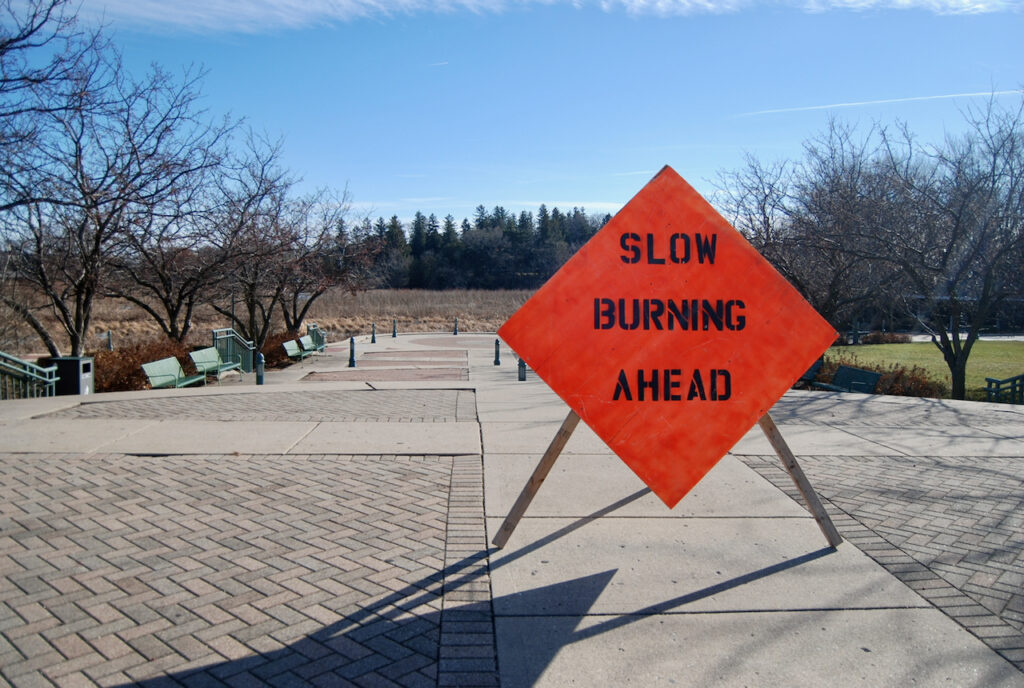
A “Slow Burning Ahead” sign alerts those entering Cravath Lakefront Park that a controlled burning of vegetation, a portion of which is visible in the background, began Friday. Similar signs have been posted around the Trippe and Cravath lake beds where burning is planned through Wednesday.
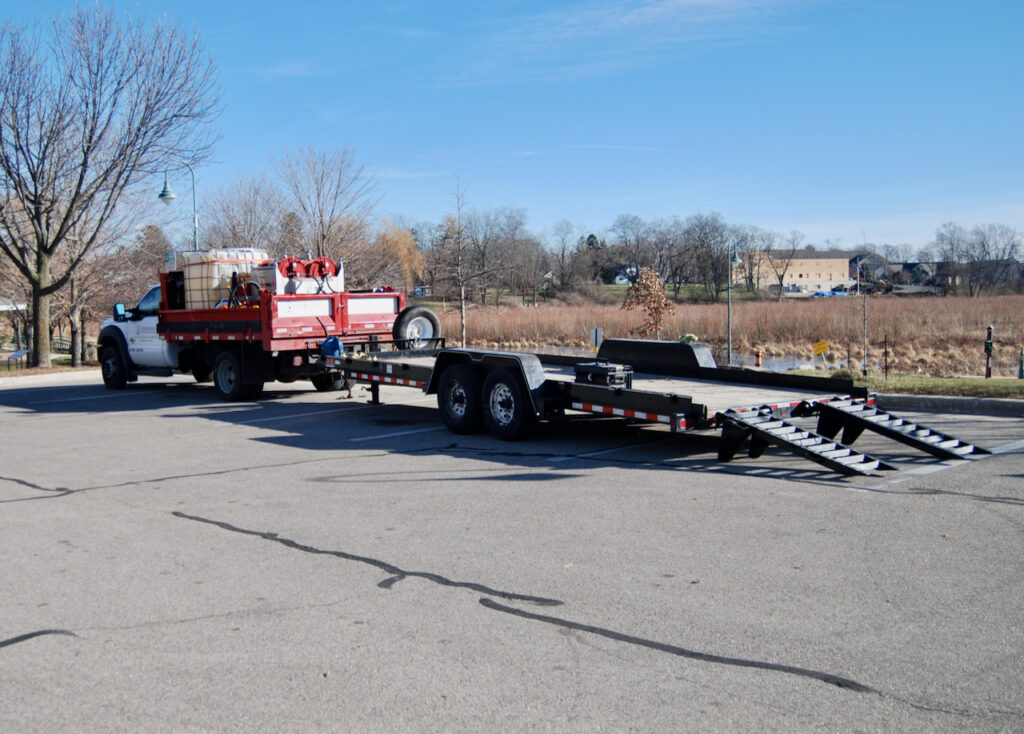
Field and Stream Restoration equipment is parked at the Cravath Lakefront Park Friday. A controlled burn of vegetation in the attached Trippe and Cravath lakebed began Friday afternoon and is anticipated to complete by Wednesday. Kim McDarison photos.
Whitewater: City authorizes pursuit of dredging contract with A-1, Kowalski
(Originally published Dec. 24, 2021.)
By Kim McDarison
The City of Whitewater Common Council Tuesday authorized city staff to pursue two contractors, A-1 Excavating, Inc. and Whitewater-based Mark Kowalski and Sons Excavating, regarding a dredging contract for work to be done in Trippe and Cravath lakes.
Both companies have been in discussions with the city recently, looking to create options the city might pursue to continue with dredging plans.
Authorization granted by council allows city staff to enter into a contract with one of the two contractors, with proposals extended to one or both contractors by the end of this week.
Before the authorization was granted, council received a presentation about the project from Whitewater Parks and Recreation Director Eric Boettcher.
Boettcher began his presentation by responding to a question asked by council members during their last meeting regarding monies spent on the project to date. Boettcher shared financial information associated with the project beginning in 2016.
What’s been spent so far?
Aided by slides, Boettcher said the city thus far had spent $152,307 on the project. He broke expenditures and budgeting into several categories, including: “Lakes Drawdown Project Planning History: Planning Grants and Engineering,” “Lakes Drawdown Project Services,” and “Current Project Budget 2018-2022.”
Within the first category — Drawdown Planning History, — Boettcher noted that between 2016 and 2017, the city spent $20,932 on a “Lakes Dredging Feasibility Study,” performed by Middleton-based Nahn and Associates. According to the company’s website, it focuses on “providing services to developers, municipalities, industries and nonprofit groups,” with such services focusing on the areas of stormwater erosion and control planning, hydraulics and hydrology, and environmental permitting, among others. (More information about the company is here: https://www.nahnandassociates.com.)
Between 2018 and 2021, Boettcher noted, the city spent $36,214 on “lakes drawdown project and dredging planning,” with those funds paid to Madison-based Ayers and Associates. According to its website, the company provides a full range of services including engineering, mapping, environmental, architectural and survey services, among others. (More information about the company is here: https://www.ayresassociates.com.)
In 2021, Boettcher continued, the city spent $24,845 for the creation of bid-ready plans drafted by Ayers and Associates.
In total, within the category, Boettcher said, the city has spent $81,991.
Looking more closely at lake drawdown project services, in 2019, the city spent $30,656 to purchase and install three siphons.
Between 2019 and 2020, the city authored the removal of a rock and ledge south of the railroad bridge, and performed dams and gates clearing for a total cost of $25,880.
In 2021, the city employed a contractor — Cottage Grove-based Field and Stream Restoration LLC — to mow and cut vegetation within the Trippe and Cravath lake beds, at a cost of $12,711.
According to its website, Field and Stream Restorations “specializes in building beautiful, healthy, and sustainable natural areas.” (More information about the company is here: https://www.fs-restorations.com.)
In 2021, and continuing into 2022, the city is projecting a total expenditure of $45,000 for several controlled burning events within the two lake beds.
Looking at total costs versus the city’s approved budget for the project, Boettcher said the project had a total approved budget of $1.47 million. With approved project-related expenditures to date, a remaining budget stands at just over $1.32 million.
In a final slide, Boettcher noted that, when including the $20,932 spent on the feasibility study authorized in 2016, the city’s total expenditures for the project to date are $173,239.
Dredging options
Boettcher next shared options the city might employ to continue with the project. A slide enumerated six options, including:
- Option 1: No dredging, begin restoration.
• Option 2: Contract with A-1 at the “full bid scope” at a cost of $2.5 million.
- Option 3: Contract with A-1 to perform dredging within one lakebed. Dredging costs associated with Cravath Lake only are $1.87 million
- Option 4: Contract with A-1 to perform dredging within one lakebed. Dredging costs associated with Trippe Lake only are $1.74 million.
• Option 5: Contract with A-1 for a “reduced bid scope” keeping the project to the budgeted amount of $1.38 million.
• Option 6: Contracting with Whitewater-based Kowalski Excavating to perform dredging as a two-year process, with dredging occurring in one lake each year. The full project comes at an estimated cost of between $2 million and $2.3 million. (More information about Whitewater-based Mark Kowalski and Sons Excavating is here: https://www.facebook.com/Mark-Kowalski-Sons-Excavating-459537640908538/.)
Citing Option 6, Boettcher said the plan would include dredging Trippe Lake first.
“This gives us an option that is less expensive than the original bid and still gets us the 82,000 cubic yards of material removed, and it also keeps it with someone that’s local that we can work with,” Boettcher said.
A-1 and Kowalski
After the presentation, council members discussed next steps for the project.
City Manager Cameron Clapper noted that, after further discussion with Kowalski, it was determined that Option 6 would likely come with a cost ceiling of about $2.3 million.
Citing cost differentials would council choose to fund the full project as bid by A-1, Clapper said the increased cost would bring a change of “about 10 cents per $1,000 of (home) value” for taxpayers.
“So if we were to go ahead and have an action tonight, to say: go ahead with the project, up to an amount not to exceed $2.5 million, which we are not saying that, but even if that was the recommendation, that would, at this point (amount to) $20 more per year for someone with a $200,000 house. It would be $25 more for a $250,000 home, and so on. Essentially, 10 cents per $1,000,” Clapper stated.
Clapper continued by saying: “Looking at the longterm benefit for the community of this project and process, and having worked with him (Kowalski) thus far, we favor as a staff, or I do anyway, exploring further with Mr. Kowalski or moving forward with Mr. Kowalski. There are some things that are costs for him, that after discussion … we might be able to find ways to alleviate, for example matting that is required to make sure trucks can actually get out onto the lakebed; that’s an expense that is significant for the excavating company, whether it be Mr. Kowalski or others. That may be something you might be able to purchase rather than have them lease, and then resell or lease ourselves.
“It’s out of the box, I think, in terms of one possibility of thinking, but there are things that we can look at to reduce that amount.”
Clapper said he was aware of individuals within the community who had expressed interest in aiding the city with its project through fundraising.
“We had anticipated looking at that once we had a solid bid specification and some response to that from competitive bids,” he said.
“I’m looking at the Kowalski piece, thinking that is a better option for us. We know that we would not be able to begin still until January, but it gives us some time to even look and see what other ways we can reduce costs,” Clapper continued.
He said a second option might be to work with both A-1 or Kowalski to reduce the scope of the project, bringing it more in line with the city’s budget.
Clapper said the city had learned over the last 2-1/2 years how to more smoothly draw down water levels in the lakes, which, he said, could help reduce costs by spreading the project out over two years.
Offering his thoughts, Councilman Jim Allen said: “Well, people are fed up. The drawdown should have taken one year instead of two. I understand that wasn’t the city’s fault; we didn’t anticipate that, and neither did the citizens. So, they’re frustrated; they want something done and fixed. Or fill the lakes back up. I’m going to suggest that maybe the drawdown, as explained by the DNR, carved deep enough a path from the south ends to the north ends of the lakes for fish habitat, by just naturally the water carving that channel. I think we should continue to work with both companies and scale back, and clean out a large area in front of the park on Cravath and in front of the dam on Trippe and stick to our original budget, and if there’s anything left after that, then we go dredge towards the south end of the trench.
“I just don’t want to go over the budget or take another year.”
Councilman Greg Majkrzak II asked for clarification about why the city’s proposed budget for the project was so different from the bids received.
“Were we just wrong or were there rising costs?” he asked.
Boettcher responded: “I think it was more of the rising costs. The trucking, that’s the expense. Trucking went way high.”
Boettcher continued: “We know a lot more now after this process of how to drawdown a lake. We did remove that rock ledge so we can bring down Cravath pretty well. Trippe is a little bit more difficult; we’ve had a hard time even with the syphons drawing that down; we’ve had issues with the siphons during the summertime with wildlife getting caught up in them. Also, this year, with Trippe especially, with a drought season, this is about as low and dry as we can probably get it even with the siphons. It’s not to say we couldn’t add some siphons in the future, or do something else, but this is kind of been like the perfect summer of drought to get Trippe down and dried out.
“If you look at now, now’s the time to try and do this.”
Boettcher said that he did not anticipate that future trucking costs would go down.
“They may go down, but everything else, as we find out, as we go on, it goes up in price. I don’t see this getting less expensive to do in the future, but I can’t say for sure,” he said.
Clapper noted that contributing to costs were those associated with mats used to allow trucks to drive on the lakebed and fuel, “and we would be looking to get the (dredged) materials out in the 90-day period,” he said, adding that one contractor calculated it would require 100 truck loads a day.
“That’s quite an intense process with trucks,” Clapper said.
A resident of George Street, addressed council from the podium, said sediment was coming from the lakes through the navigational channel that had been dug and emptying into Whitewater Creek.
“That creek needs to be cleaned out. There’s so many trees, garbage, you name it, you went through and cleaned it out, what? 10 years ago? give or take, and ever since then, there’s a lot of trees that came down.
“Back in the 1800s that was a trout stream, not a lake. Personally, I like it the way it is. This is the way nature intended it,” he said, adding, that after a rainfall, he often experiences flooding in his yard.
Said Councilwoman Lisa Dawsey-Smith: “I would say negotiate, keep it on budget. Refill it in the spring as anticipated. If nothing else, the community has pretty clearly spoken that they are ready for this project to be completed.”
Council President Lynn Binnie, referencing the estimate from Kowalski, asked: “Do we have a cubic yard price that’s apples to apples as what we got elsewhere?”
Boettcher and Clapper noted that Kowalski was working with the same bid package that had been received by all the responding bidders.
By extending the project over a two-year period, Boettcher said, some cost savings could be achieved by using less matting.
As far as the comparison between A-1 and Kowalski, Boettcher said, “It’s still the same project.”
Council unanimously approved a motion, as stated by Clapper, “to direct staff to approve staff entering into an agreement with a contractor for dredging of both lakes in 2022 at a cubic yardage amount that allows us to stay within the originally anticipated budget and entering into that agreement contingent upon approval by the parks and recreation director, the public works director, city attorney and city manager, and to authorize fundraising and take that into account if ultimately successful.”
An earlier story about bids received for the lake dredging project is here: https://fortatkinsononline.com/whitewater-city-rejects-trippe-cravath-dredging-bids-explores-new-bids-scope/.

The above graphic shows options considered by the Whitewater Common Council for the Cravath and Trippe Lake dredging project as presented by Parks and Recreation Director Eric Boettcher Tuesday, Dec. 21.
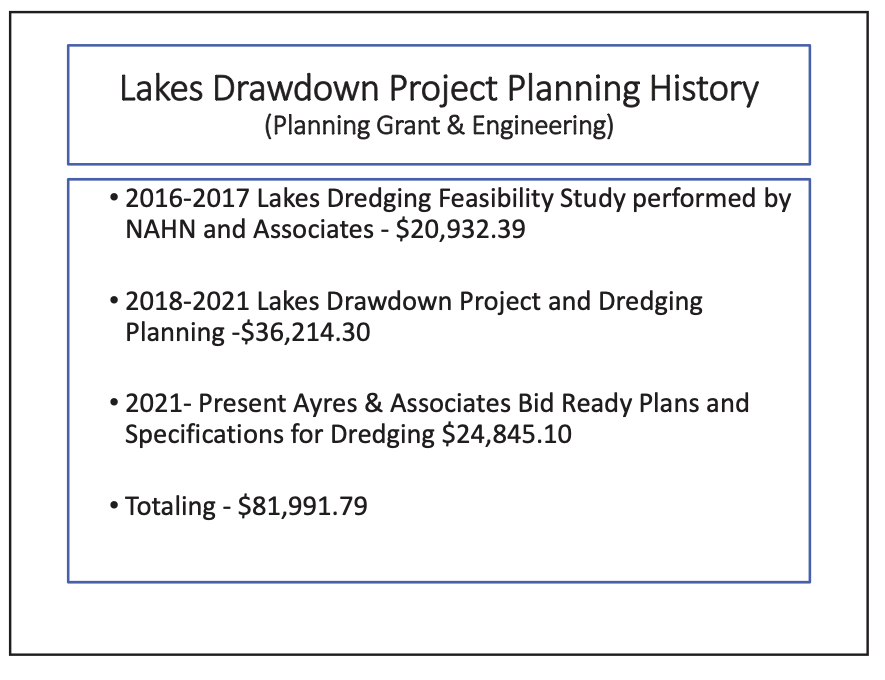


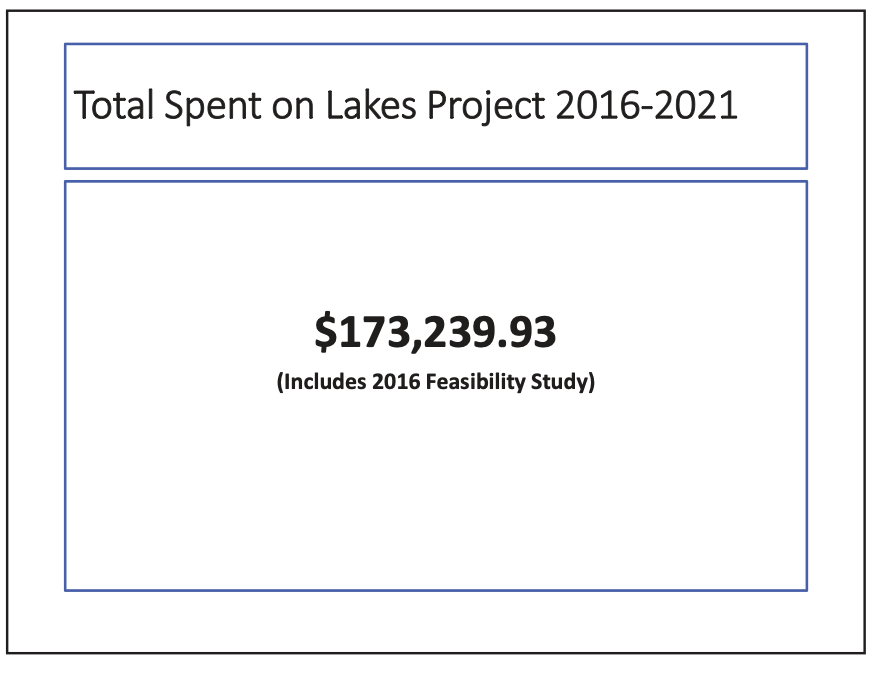
Four graphics above show the financial history and budgeting to date for the Trippe and Cravath lakes restoration project. The information was included within the council packet Tuesday, Dec. 21.
Whitewater: City commits $3 million towards $5 million library renovation project
(Originally published Dec. 24, 2021.)
By Kim McDarison
The City of Whitewater Common Council approved Tuesday funding $3 million of a $5 million library expansion and renovation project.
The council approved a resolution which stated that the city will make a $3 million contribution to the project once the city’s library board can show it has obtained funding for the remaining $2 million, which, the library board stated, includes fundraising for a portion of the monies needed.
Monies to fulfill the city’s contribution would be included in the city’s 2024 budget.
The measured was approved by a 6-1 vote with Councilman Jim Allen casting the ‘no’ vote.
During the meeting, council heard a presentation given my library board member Jim Winship and Library Director Stacey Lunsford.
Addressing members of council, Winship said the project proposed by the library board was more of a renovation than an expansion.
The proposed addition to the building would add some 7,000 square feet.
In the existing portion of the building, he said, the restrooms and the checkout desk would be the same, but everything else would be different.
The new building would feature increased meeting room space, increased Makerspace space, more space for teens and upgrades allowing for the use of better technology.
“Updating the library is just another selling point when enticing families to come to Whitewater,” Winship said, adding: “We can afford to make this investment.
“I think this is especially important now, because we are in a community where close to half the students get free or reduced lunches, and the impact of the pandemic will still be going on for many, many years when this library opens.”
Looking at the $2 million commitment to the project which would need to come from the library board, Winship said: “The library has, one way or another, about $1 million in assets. We would fundraise for the other one.”
Lunsford next addressed the council sharing highlights of the plan.
Aided by slides, Lunsford presented a graphic showing the library’s current footprint. The graphic included the library, its parking lot and some properties, Lunsford said the library board had acquired to the east.
Looking at the library building, she said, a small area extending from the west side of the building delineated the current “Community Room.”
“That’s the part that’s going to be expanded,” she said.
Said Lunsford: “We are going to demolish the current lobby and Community Room and we are going to build an addition on the west side. So there will be an expanded lobby; there’s going to be several meeting rooms of various sizes that are going to be flexible in their sizing — they can be made smaller, they can be made larger, they can open up into the lobby for venues that require extra space. So we are making it very flexible.”
Plans also call for a walkway along the building’s west side which could be used for additional programming, she said.
Looking at the existing building, she said, plans for renovations include moving the adult section closer to the current library entrance and moving the early learning section into the building’s southeast corner.
“We are going to be adding a children’s restroom there, a nursing mother’s room there, (and) there’s going to be a new small office space for the youth educational services librarian,” Lunsford said, adding that the area used for the library’s Makerspace program will be renovated into a children’s story time room.
With the expanded building, Lunsford said, “we need to have expanded restrooms; you need to have so many stalls per square foot.”
Within the one-story addition visitors to the library will find a new social reading and discover area.
Space within in new addition will accommodate the free pantry, and spaces where people can sit, use wifi, read, socialize, all outside the library proper, Lunsford said.
“A lot of times people want to talk, they want to chat, and then other people want quiet. So this offers us the opportunity to do that, which we don’t have right now. It’s hard to get a quiet corner in the current library,” she said.
Addressing costs associated with the project, Lunsford noted that construction costs for the addition are estimated at $1.7 million. The remaining costs of the project are for the renovations to the existing building, and costs associated with the architectural and design team.
Citing a need for renovations, Lunsford said the library building is 30 years old.
“It is not a very modern building as far as the ability to have technology and those things in it. We need to replace the lighting. The lighting is very bad. The carpet needs to be replaced. We have a lot of bubbling and tears there. We need to have more electrical outlets. We need to have more places for people to plug in their devices. That’s extremely important to people. What we have right now are some outlets that sit up off the floor; they are a tripping hazard, but it is the best we can offer.”
Discussion about financing
Councilwoman Carol McCormick expressed concern with rising construction costs. She asked: “This is going to be through 2024? How are you going to compensate for the cost of construction over the next two years? We are committing $3 million. Would you be able to cover that gap should it increase?
Lunsford responded: “I don’t have a crystal ball so I can’t really answer that with any confidence. I like to have facts when I say things. We understand that asking for this commitment — that we have to come up with the rest of the money first. And so we will be looking at that and I would assume that we would be adjusting our capital campaign as we saw things going up.”
Offering encouragement, Lunsford said she and library board members had learned, after having conversations with other library boards which had engaged in capital campaigning, that they had exceeded their fundraising goals.
Whitewater Director of Finance and Administration Steve Hatton also offered some financial information, looking to answer the question, he said: “How does this fit into our CIP and our financial plans?”
Sharing several slides from the city’s November budget process, Hatton said the city, along with its biennial budget and Capital Improvement Plan (CIP) had created a “10 Year Horizon,” which, he said, aimed to predict and plan for the city’s capital needs within a 10-year window.
Within those documents, he said, the city had identified resources for the library renovation project.
Among dollars earmarked, he said, was $250,000 of spending from within the fund balance in the 2023 budget, and, he said, the library board has roughly $1 million in funding that would be coming from assets held and controlled by the board.
Hatton said those dollars were among the first that could be spent to pay for design and other early project costs. Construction, he said, would likely take place in 2024 or 2025, at which time the council would need to approve its contribution coming from that budget cycle.
Looking more specifically at funding sources, Hatton said, “I can see a bond issuance in 2024 for $3 million.”
Additionally, he pointed to $1 million in fundraising, $500,000 of cash or fund balance from the library board, which, he said represents the real estate the library board holds, and some funds held by the library board in its fund 220, which, he said, the board intends to commit to the project.
Looking at revenue forecasts, he said: “We’ve been very conservative with property values, so we show a return on TID 4 that comes back into the tax base, and then the growth of the property values …so we don’t want to paint a rosy picture … we’ve been very conservative with estimates for the tax base.”
The forecast and the 10-year CIP horizon include plans for several city projects, he said.
Looking at a potential for borrowing, Hatton pointed to a chart showing state imposed limits on the city’s borrowing capacity. The council, he said, has a policy whereby the city may not borrow more than 70% of the state imposed limit. The chart showed that the city’s current level of borrowing was within the 50- to 55% range over the full 10-year horizon.
Discussion
During discussion, Councilman Lukas Schreiber said he was in favor of the project and saw a need for the library to keep up with “changing times and the need for upgraded technology, especially.”
Said Allen: “I think we are all in favor of the expansion of the library. I think the library needs changes, certainly technology needs to change, and maybe the lighting needs to be changed … The problem I have is $3.3 million for remodeling … that seems a little outlandish to me.
“We’ve got $1 million set aside for a water tower, a million and a half for the lakes drawdown, a million-plus for a lift station, $10 million projected for the city garage, $2 million projected for police property garage, and another $5 million for the library, that’s twenty and a half million dollars.
“You have to scale things back. This doesn’t even include the fire and rescue referendum; we already know we are going to have to go to referendum because we are going to have to ask the taxpayer to pay more, an increase, on their taxes, than the state allows us to give …
“I can’t support this as it is,” Allen concluded.
Allen proposed making changes to language within the resolution whereby the city would be committed to the project “up to $2 million.”
With no second offered by other council members the motion failed.
Council members discussed changes that had been made to the resolution as it was presented Tuesday by city attorney Wally McDonnell.
New language stipulates that the library board must raise its portion of the funding required before the city will take action to approve the $3 million committed.
“My feeling is if people are telling us they want this, and the library board can have them put their money where their mouth is, then we should support this and say, put your money where your mouth is, and see what happens. If it doesn’t happen, we don’t have to do this,” said Councilwoman Brienne Brown.
For more information on the library renovation project, visit the city’s websote: https://whitewater-wi.gov/CivicAlerts.aspx?AID=341.
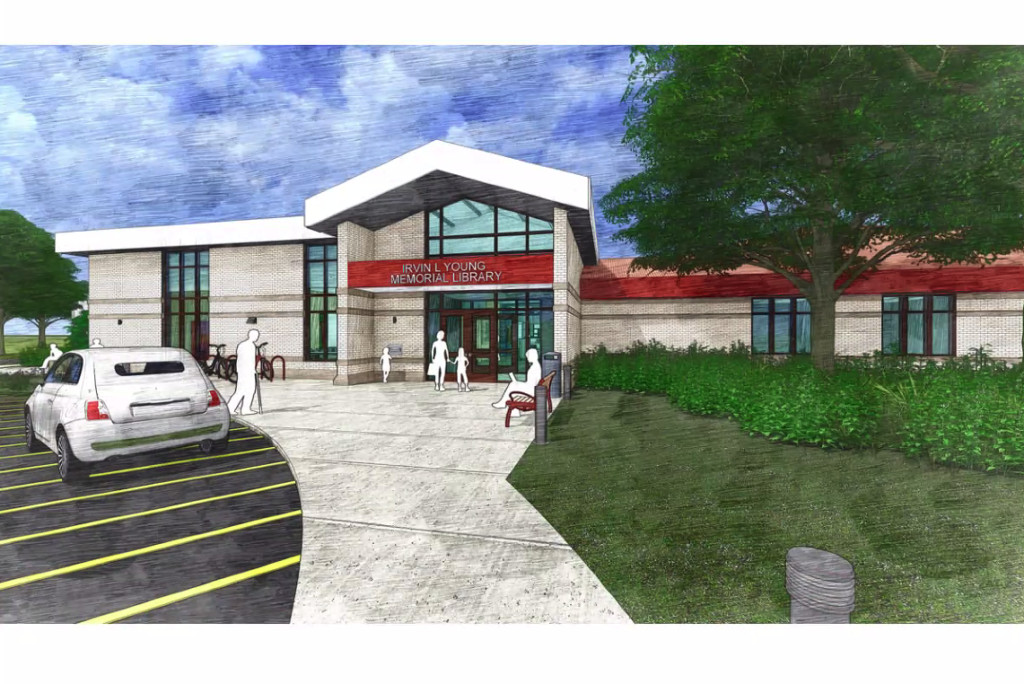

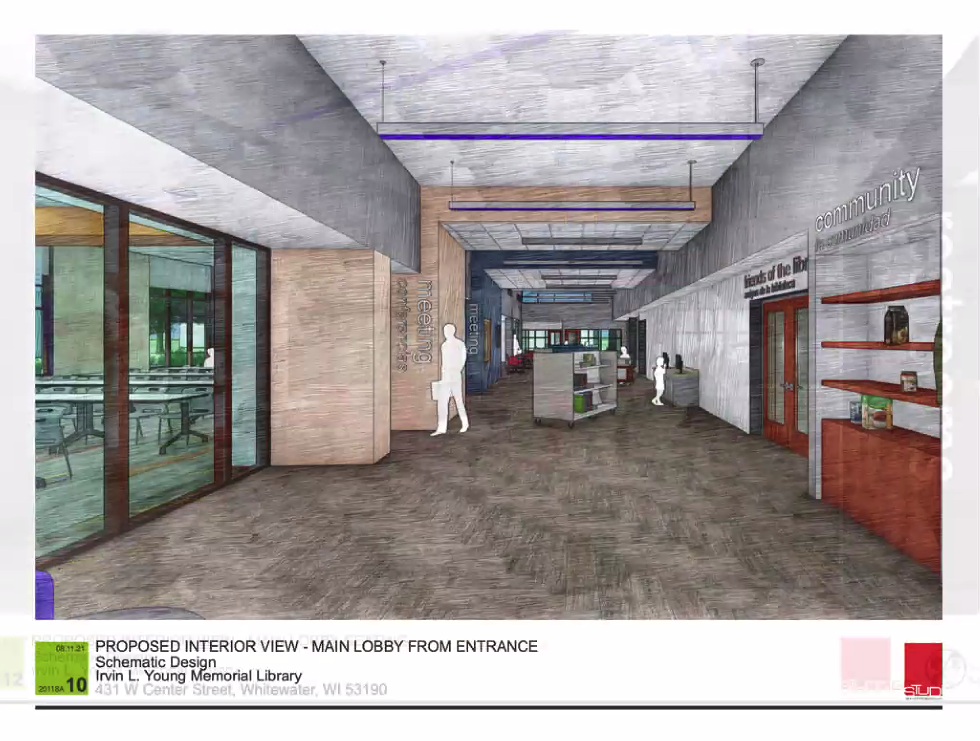
Three graphics above show an artist’s rendition of how the interior and exterior of a renovated and expanded Irvin L. Young Memorial library might look.

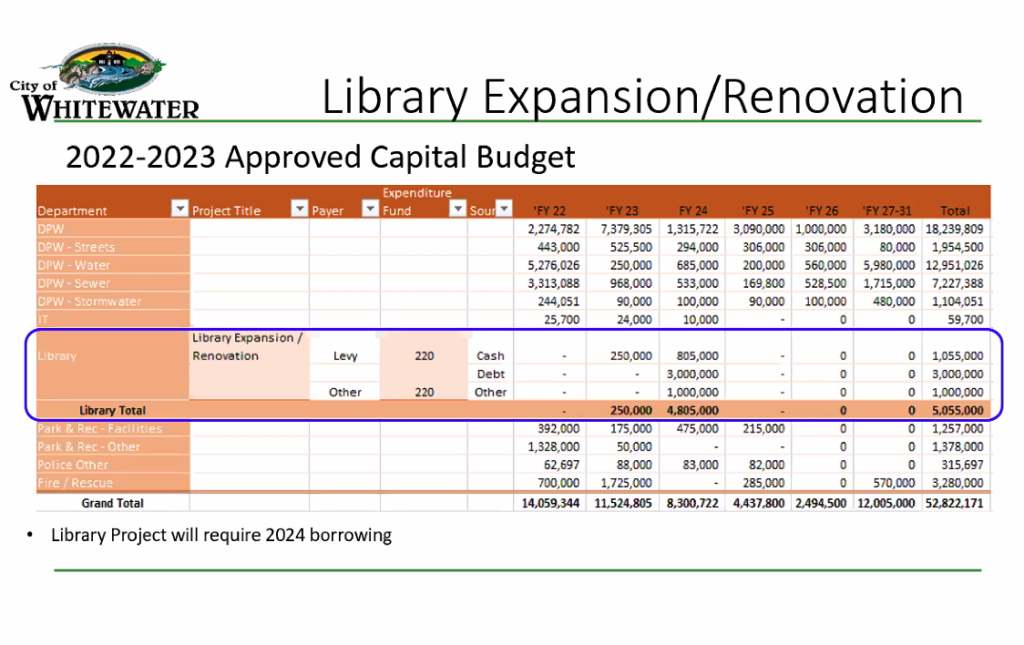

Three graphics above show the budgetary plans and 10-year horizon capital improvement forecasts made by the City of Whitewater. The slides were shared by Whitewater Finance Director Steve Hatton during Tuesday’s council meeting.

Looking at a potential for borrowing, Finance Director Steve Hatton points to a chart showing state imposed limits on the city’s borrowing capacity, indicated by the orange line. The council, Hatton said Tuesday, has a policy whereby the city may not borrow more than 70% of the state imposed limit, shown by the blue line. The chart showed that the city’s current level of borrowing was within the 50- to 55% range up until 2026, indicated by the gray bars.
Two Walworth County board members decide against reelection run
(Originally published Dec. 29, 2021.)
Editor’s note: The following story has been reprinted, with permission, from the online news site: Walworthcountycommunitynews.com.
By Dan Plutchak
The makeup of the next Walworth County Board will look quite differently after two more longtime board members announced they will not run for re-election.
County Board Vice Chair Jerry Grant and Supervisor Daniel Kilkenny have notifications of non-candidacy with County Clerk Kim Bushey.
Board Chair Nancy Russell announced earlier she would step down.
That means at least three of the 11 county board seats will have new members in 2022.
Grant represents portions of Whitewater in District 4, and first served on the board from 1998-2014.
He ran again in 2018 and continues to serve both as County Board Supervisor and as the Board Vice Chair. Grant also served as County Board Vice Chair in 2008-2010 and 2012-2014.
In addition to serving as the Vice Chair of the County Board, Grant currently serves as the Chair of the Public Works Committee and member of the County Zoning Agency, Finance Committee and Whitewaler/Rice Lake Management District.
Kilkenny has served since 2006 in District 8, which includes portions of the Towns of Darien, Delavan, Sugar Creek and a portion of the city of Delavan.
Kilkenny also currently serves the County as Vice Chair of Agriculture and Extension Education, Executive, finance. Land Conservation and Park Committees. He previously served as Vice Chair of the County Board from 2010-2012.
All eleven of the Walworth County Supervisor positions will be on the ballot at the Spring Election on Tuesday, April 5, 2022.
Informational packets on running for County Board Supervisor are available at the Walworth County Clerk’s Office located at the Government Center at 100 West Walworth Street in Elkhorn. You can also check the County website at: www.co.walworth.wi.
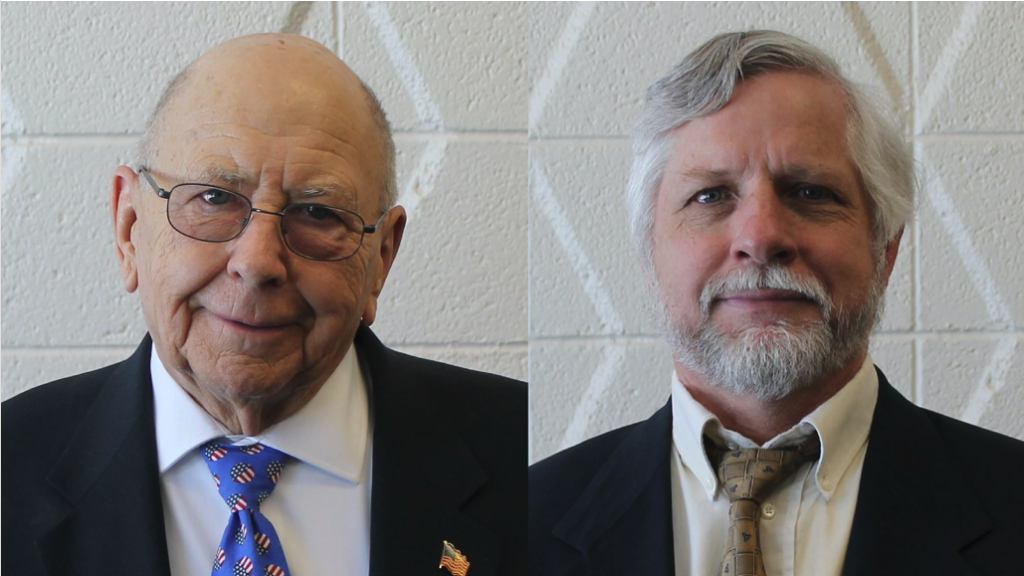
County Board Vice Chair Jerry Grant, at left, and Supervisor Daniel Kilkenny. Photo courtesy of Walworth County Community News.

Dan Plutchak is the founder of Walworth County Community News, a countywide, online news outlet covering Walworth County, Wis., begun in 2021. Weekly newspaper coverage in Walworth County began in June of 1978 when The Janesville Gazette launched Walworth County Sunday, a weekly insert into the Gazette. Walworth County Sunday was revamped in 1991 into a standalone publication, The Week, and Plutchak joined as a staff photographer. Plutchak went on to edit The Week from 1995 to 2008. That year, Bliss Communications purchased Community Shoppers Inc., and rolled The Week into CSI’s Walworth County Sunday. During those years, Plutchak launched TheWeekExtra.com and WalworthCountyToday.com, which are no longer being produced. Plutchak later became editor of Walworth County Sunday until he departed for WKOW 27 News in Madison in 2017 to oversee the station’s digital operations. Now retired, Plutchak founded Walworth County Community News to provide coverage that doesn’t always make it into other local media outlets.
The year in review: Top 10 stories from 2021
(Originally published Dec. 30, 2021.)
By Kim McDarison
While Fort Atkinson Online had a soft opening in January of this year, officially, we opened our virtual doors on Feb.1.
News publications, in print and online, traditionally each year, mark that year’s passing by reflecting upon the top 10 stories of the year. Typically, news reporters and editors come together and make a list of the stories that most affected or impacted them. While these journalists usually have a good sense of the stories that impacted their communities, they are not often privy to hard numbers.
Here, at FortAtkinsonOnline.com, we are.
Our top 10 stories of 2021 are, therefore, chosen by you, our readers. The counters on our pages and stories tell us which were the most read. Our stats begin in February and run through Dec. 30.
In descending order, here are our 2021 most read top 10 headlines:

1. “Letter to middle school parents reports news of a student’s death,” read 19,703 times.
What can we say about the utter sadness of this September story? A 13-year-old Fort Atkinson Middle School student, Danny Rees, according to information shared by family members on the GoFundMe page they set up for help with expenses, had become congested with what seemed like a cold. Two days later, he stopped breathing. His death was difficult enough for his family and friends given its sudden nature, and initially the family said some of its members, including Danny, had tested positive for COVID-19. After a day of unrest, and the polarization and politicizing that gripped the greater Fort Atkinson community, which was already fraught with heated debates about mask protocols in school buildings, the Rees family rewrote its funding page, excluding information about any COVID testing Danny might have undergone.
The page ultimately raised $32,250 for Danny’s expenses, and the mask debate rages on.
The full story is here: https://fortatkinsononline.com/letter-to-middle-school-parents-shares-news-of-a-students-death/.

2. “Waukesha County Sheriff Department records pertaining to arrest of Whitewater police chief released,” read 13,618 times.
A story coming from the city of Whitewater began when city officials announced that they had placed their police chief, Aaron Raap, on a paid administrative leave, pending an internal investigation. The action was announced on Dec. 3. Few details explaining why the action was taken were disclosed.
The release noted that the internal investigation found basis in “an incident that occurred outside the city of Whitewater,” further noting that the city’s action was not punitive.
On Dec. 16, Fort Atkinson Online learned that the Waukesha County Sheriff’s Department had arrested Raap for a domestic dispute. Raap lives in Waukesha County.
Further, Waukesha County District Attorney Susan Opper told Fort Atkinson Online that she had “declined prosecution,” noting that she did not find “sufficient evidence” of “an intention to inflict bodily harm.”
On Dec. 18, Fort Atkinson Online, having received a 19-page report from the Waukesha County Sheriff’s Office, reported on the incident alleged to have taken place at Raap’s home on Thanksgiving day.
The report documents an altercation that took place in the home between Raap and an unnamed victim. The report notes that the unnamed individual was a member of the household, and Raap and another unnamed person who was present during the incident had questioned the first individual about time missed from work. Raap also asked the first unnamed individual to give him his car keys, cell phone and playstation.
The individual gave Raap everything but his car keys and exited the home, later returning, Raap told deputies, according to the report, and entering the master bedroom of the home. Raap and the individual struggled in a manner that Raap described as “wrestling” after Raap stopped the individual and felt, he said, what he believed was a sheathed hunting knife in the individual’s waistband.
The second unnamed individual in the household called 911.
The report indicates that individuals at the scene said they did not require medical attention, although, the report continues, deputies did take photographs of a victim’s injuries sustained in the altercation.
While the district attorney has dropped the charges, Raap remains on paid administrative leave from the Whitewater Police Department.
As of Dec. 18, City of Whitewater officials have said in a press release that the internal investigation they are conducting remains underway and “runs independent from any decisions made by other agencies.”
The investigation will be completed “as soon as possible,” the release stated.
The full story is here: https://fortatkinsononline.com/waukesha-county-sheriff-department-records-pertaining-to-arrest-of-whitewater-police-chief-released/.
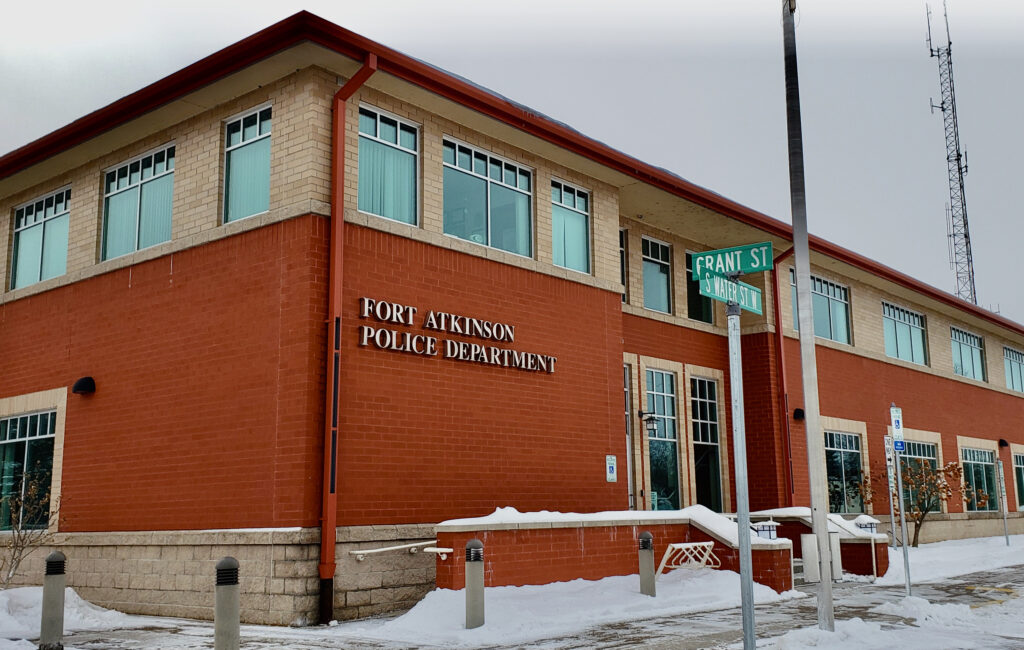
3. “Fort police respond to two traffic accidents Thursday afternoon, one with a fatality,” read 12,714 times.
Nearly two hours later, at around 5:15, a second accident, this time involving a car and a bicycle, occurred near the intersection of Janesville Avenue, South 3rd Street and Robert Street. In the second accident, the subjects involved, police reported, were both female and both in their 40s. The bicyclist was transported by Ryan Brothers Ambulance Service to an area hospital. Injuries were not thought to be life-threatening.
The full story is here: https://fortatkinsononline.com/fort-police-respond-to-two-traffic-accidents-thursday-afternoon-one-with-a-fatality/.
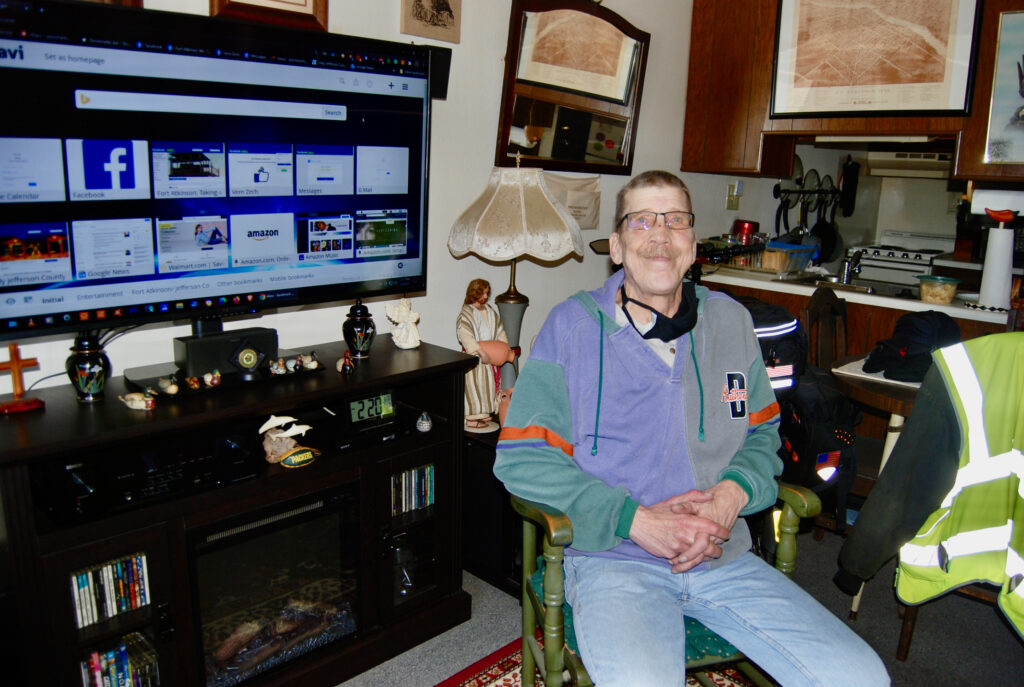
4. “Vern Zech is a Fort native on a social-media mission,” read 12,175 times.
This story, too, represented a large loss in Fort Atkinson and its surrounding communities. At the time it was written, in early March, Vern Zech, a Fort Atkinson native, was busy at work in his one-bedroom apartment where he sat before a large TV screen, operating — as the sole administrator — two social media pages: “Fort Atkinson Wi.: Taking a Stroll Down Memory Lane Then And Now,” begun by Zech in 2012, and “Jefferson County Obituaries.” He also supplied obituaries to Fort Atkinson Online, sending us links each evening after he combed through the various funeral parlors’ sites each day. In March, his Then and Now page had 9,200 members and his obituary page had 4,800. Today, his Then and Now page has over 10,500 members.
Why did he do it?
When we asked him, he said: “I love Fort Atkinson. It’s a good place.”
But by summer’s end, Zech was in a different place. After learning of his declining health, Zech asked Fort Atkinson Online editor Kim McDarison to join him as an administrator of the Then and Now page. He archived the obituary site.
On Aug. 4, Zech sent an email to McDarison. It read: “I’ve had 2 heart attacks in the last month will be going to Dr. tomorrow. I will let you know what’s up. Right now have no idea what will happen. Crossing my fingers on what goes on from here.”
On Aug. 5, Zech wrote to McDarison: “A lot of things to take of. He is starting with some drugs to get my heart beat back to normal and not all over. Then go for a full CAT Scan next week then the bad news comes after he looks at them. He told me the possibilities of what is wrong today. Not anything good at all.”
When Zech’s health issues became more broadly known, members of his page wished him well and, as he worked to recover his health and spent some time in an area hospital, an outpouring of friendship and support filled his Then and Now page.
After his hospital stay, Zech came home to recover.
Zech invited McDarison to join him as an administrator on the page on Sept. 1. He died in his home on Sept. 30. The news of his death was reported by a family friend on his Facebook community page. He was 65.
Zech remained an active participant, continuing to perform administrative duties on the Then and Now page, until Sept. 26.
A celebration of his life was held at the American Legion Dugout on Oct. 24.
Today, although operating under a slightly different name: “Fort Atkinson Wi., Then and Now,” the page Zech founded continues to grow at a rate of between approximately 40 and 60 new participants each month.
A kind and often solitary man of few words gave Fort Atkinson the gift of gregarious community.
Participants of the page continue to think of him often.
The full story is here: https://fortatkinsononline.com/vern-zech-is-a-fort-native-on-a-social-media-mission/.
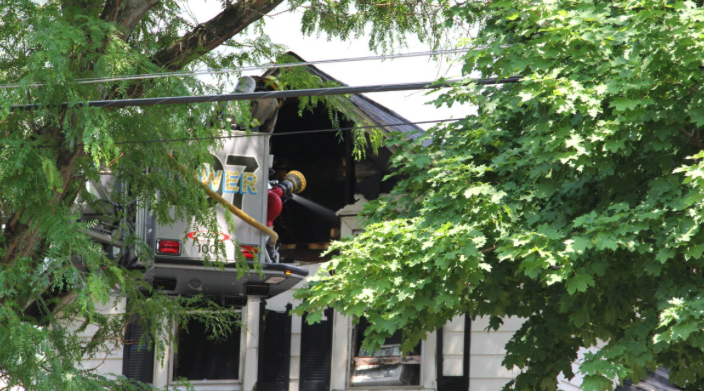
5. “One dead in house fire on Foster Street; related Amber Alert issued,” read 11,030 times.
Reported on June 11, what began as a tragic house fire turned even more tragic when officials announced they had found a charred body inside a home on Foster Street. The discovery led to the issuance later that evening of an AMBER alert. The Wisconsin Department of Justice announced that it was looking for Elizabeth M. Durkee, a resident of the fire-consumed Fort Atkinson house, along with her 2-year-old daughter. The daughter, the alert stated, was believed to be in “great danger.”
The mother and daughter were found about an hour later at a hotel in Delavan. The events of June 11 were further complicated by the developments reported within our most read story designated No. 7 on our top 10 list.
The full story is here: https://fortatkinsononline.com/body-found-in-house-fire-on-foster-street/.

6. “Jim, Nedra Lemke murders focus of ‘In Pursuit with John Walsh’ this Wednesday,” read 10,589 times.
In October, a set of unsolved murders from the summer of 2020 got some new attention. Fort Atkinson Online contributor and a guest on the “In Pursuit with John Walsh” Investigation Discovery Channel show, Chris Spangler, reported that the program would feature a 22-minute segment about the local case in which a town of Sumner husband and wife, Jim and Nedra Lemke, were murdered on a property formerly owned by Nedra’s late father. The murders remain unsolved. Since the murders, law enforcement officials have been looking for Kevin P. Anderson, Nedra’s brother, who has been charged in connection with the deaths.
Between June 29 and July 1, a camera crew for the show arrived in Oconomowoc where they interviewed the Lemkes’ daughter, Amanda Waterworth; her husband, Jacob Waterworth; Jefferson County Sheriff’s Office Det. Sgt. Chad Garcia, Det. Donald Petig, Det. Ryan McIntyre and the first deputy on the scene, who asked to remain anonymous; and Spangler, former managing editor of the Daily Jefferson County Union, who covered the murders for the paper.
The show debuted on Oct. 6.
In the days following the show, several dozen tips were received by law enforcement, Spangler said.
Anderson continues to remain at large.
The full story is here: https://fortatkinsononline.com/jim-nedra-lemke-murders-focus-of-in-pursuit-with-john-walsh-this-wednesday/.
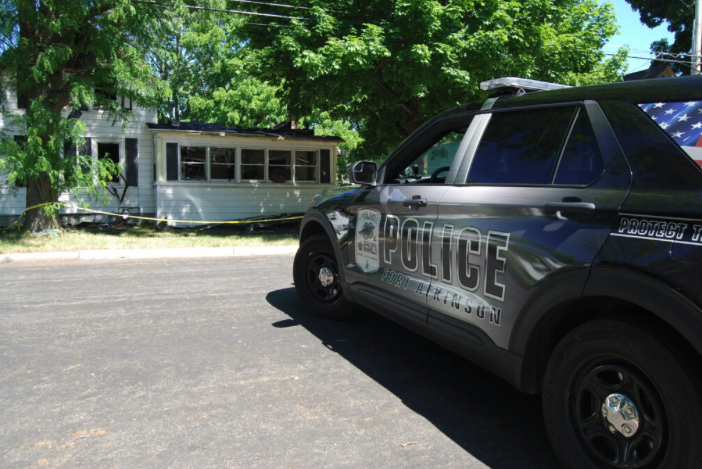
7. “Homicide, strangulation, arson among charges filed in relation to Foster Street house fire,” read 10,303 times.
Events surrounding the Foster Street fire initially reported on June 11 became more complicated when, on June 15, Fort Atkinson Online learned that charges of first-degree intentional homicide; strangulation and suffocation; arson of a building without the owner’s consent, and mutilating a corpse were being filed against Elizabeth M. Durkee, the then 36-year-old granddaughter of the woman found dead in the Foster Street home. Durkee’s grandmother was allegedly strangled to death before the house was allegedly set on fire, according to authorities.
Charges filed against Durkee bring a possible penalty of life in prison.
Durkee remains in custody. A status conference is scheduled for Jan. 6. 2022. After Durkee waived her right to a preliminary hearing in August, court records indicate that the court “binds her over for trial.”
In September, court records show, after the court read the charges and the maximum penalties, Durkee entered pleas of “not guilty” to the counts against her.
After pleas were entered, counsel on both sides indicated “that they are not requesting speedy trial,” the court filing reports.
“The defense requests that these matters be scheduled far enough out to allow for the considerable amount of discovery to be reviewed,” the record stated. A pretrial conference was scheduled for Nov. 20, which is followed by the Jan. 6 status conference, defined as a pretrial meeting of attorneys with a judge. It is held to share the progress of the case and set a timeline for discovery matters and a trial.
The full story is here: https://fortatkinsononline.com/homicide-strangulation-arson-among-charges-filed-against-foster-street-house-fire-suspect/.
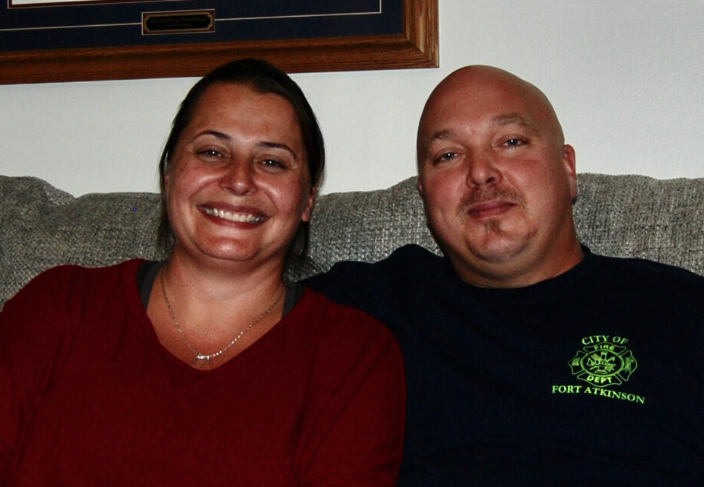
8. “Fort Firefighter injured during Oak Street Fire says fast action saved his life,” read 9,053 times.
The five alarm fire, which came to be known locally as “the Oak Street” fire, consumed a large portion of the enormous D.B. Oak building, a warehouse on Oak Street. The fire smoldered for days and brought equipment from fire departments across the state. On the first day, Aug. 10, a Fort Atkinson Fire Department captain, Nick Rueth, was among the first on the scene. As the fire raged on into the evening and a storm swept in, Rueth sustained a life-threatening injury when some glass blew free from a compromised window. Recovering in his home nearly a month later, he shared the captivating story of what happened, complete with the heroic actions of a fellow firefighter, Capt. Paul Verhalen, whom, Rueth noted, is among those he credits with saving his life. Rueth also cited the efforts to save him made by ambulance personnel, and healthcare workers in Fort Atkinson and Madison.
Verhalen, Rueth said, was by his side when the piece of glass fell from the window and lodged in his arm. Verhalen created a temporary tourniquet, radioed ahead for a medical team and then carried Rueth from the building and through debris and standing water to a waiting ambulance.
Fort Atkinson Fire Department Capt. Paul Verhalen was later recognized for his heroic actions as a First Responders Hometown Hero by State Rep. Cody Horlacher. A ceremony, recognizing Verhalen, along with other Hometown Heroes from across the state, was held Oct. 26 on the Assembly floor in the State Capitol in Madison.
The full story is here: https://fortatkinsononline.com/fort-firefighter-injured-during-oak-street-fire-says-fast-action-saved-his-life/.

9. “Fort man killed in rear end crash in Milton,”read 7,407 times.
In October, authorities reported a deadly accident involving two Fort Atkinson residents. The accident, involving a pickup truck with a trailer and a commercial box truck, occurred on State Highway 26 in Rock County in the town of Milton.
According to information released by the Rock County Sheriff’s Office, on Oct. 31, a 30-year-old male from Elkhorn who was driving the pickup truck, began to turn into a driveway from the northbound lane.
The commercial box truck, which was being driven by a 37-year-old male from Fort Atkinson, and was traveling behind the pickup truck, struck the rear end of the trailer which was being towed by the pickup truck. A passenger in the commercial box truck, 35-year-old Jeremy Jorgensen of Fort Atkinson, was pronounced dead at the scene.
The full story is here: https://fortatkinsononline.com/fort-man-killed-in-rear-end-crash-in-milton/.

10. “Fort dog trainer with warrant apprehended in Illinois,” read 7,055 times.
This story, too, follows event that began as summer ended in 2020.
On Sept. 10, 2020, Janesville resident Lindsey Davidson, the owner of an 8-month-old puppy, made a call for assistance to the Fort Atkinson Police Department. Davidson told officers that she believed her puppy had been subjected to cruelty. She had been presented that night with the lifeless body of her puppy after Fort Atkinson dog trainer Tammy Flemming told Davidson, Davidson alleged, that she had mistakenly used too much force while engaged with the puppy in a training exercise.
Flemming was arrested in March of 2021 and charged with one count of mistreatment of animals/causing death. After a short time in the Jefferson County Jail, she was released on a $1,000 signature bond.
In June, Flemming failed to appear for a scheduled arraignment hearing prompting the court to issue a judgement in the amount of the bond. Flemming next failed to appear at the bond forfeiture hearing and the court issued a warrant for her arrest.
On Aug. 4. Capt. Jeff Davis, of the Fort Atkinson Police Department, confirmed that Flemming had been taken into custody the night before. She had been located in Illinois, Davis said.
In September, after the completion of a court-ordered competency hearing, a motion to reduce the amount of Flemming’s bail was entered. On Oct. 8, the court modified its cash bond from $10,000 to $2,500, and found Flemming competent to proceed with a trial. Flemming posted bond on Oct. 8.
According to court records, a pretrial conference was set for Oct. 27 and an arraignment was scheduled for Dec. 2.
On Dec. 2, Flemming entered a plea of “not guilty” to the charge against her and the court scheduled a final status conference for Feb. 22, 2022, and a one-day jury trial scheduled for Feb. 28, 2022.
If convicted on the felony animal cruelty charge, Flemming could face fines up to $10,000, up to three years of incarceration, or both.
The full story is here: https://fortatkinsononline.com/fort-dog-trainer-with-warrant-apprehended-in-illinois/.
Whitewater: Teacher’s retirement fuels controversy; supporters look for reinstatement
(Originally published Jan. 3, 2022.)
By Kim McDarison
While few details have been released by the Whitewater Unified School District regarding an accident occurring within the Whitewater High School’s tech-ed department late last year, the retirement of shop teacher Mike Wintz — which is related to the incident — has garnered disapproval from many of his supporters.
Efforts to reinstate him continue according to Geoff Hale, a Whitewater resident and one of Wintz’s supporters.
Hale is the owner of Home Lumber, 499 W. Whitewater St., and a distribution facility, 960 E. Milwaukee St., both in Whitewater. He has erected plywood signs on both of his properties which state: “Save Wintz and tech ed please call school board.”
The signs went up just before Christmas, Hale said.
Wintz submitted his letter of notice, announcing his decision to retire from the district, on Dec. 13. The letter indicated that his employment with the district would end on that date.
The letter states: “It is understood that I have met the requirements from the Whitewater Unified School District and all WUSD post-retirement benefits as offered to me at our meeting at 3 p.m. on Thursday, Dec. 9, 2021.”
During a school board meeting held Dec. 20, some 20 members of the public addressed the school board, asking for its consideration in reinstating Wintz.
Addressing those in attendance, Whitewater Unified School District Superintendent Caroline Pate-Hefty said: “Please know that with any employee accident or incident I can’t give details specific of the employee. I can confirm that there was an accident at the high school. As with any serious accident or incident, we are required to investigate.”
Pate-Hefty said the aforementioned accident and investigation that followed constituted a process that would be applied by the district to any similar set of circumstances.
Following an investigation, an employee is given an opportunity to review the investigation summary and learn the outcome of the investigation, Pate-Hefty said.
“They are offered due process and union representation at this time. The summary really includes my recommendation, which is not binding, and they are informed that the final recommendations are made at the board,” Pate-Hefty noted, adding that the board is the only entity that can take action on hiring or firing an employee.
An employee, after learning of the investigation’s outcome, is offered several options, Pate-Hefty said, including a board hearing in either closed or open session. Outcomes of such hearings could include no action, a disciplinary action up to and including termination, or an employee can choose to resign and retire.
Pate-Hefty told Wintz’s supporters that she was able to confirm that Wintz chose to retire.
“He confirmed this choice as recently as this weekend through his union representation,” Pate-Hefty said.
Online petition
As word of Wintz’s departure from the district became more widely known, Whitewater High School student Jenna Pope, who was among members of the public addressing the board on Dec. 20, said she made an online petition on Dec. 15, as a mechanism to give other students “an outlet to speak their mind on the matter and just simply show support for the teacher they love.”
The petition reads: “Wintz has been teaching at the Whitewater High School for over 20 years. He recently lost his job due to an accident that happened in the shop. He faced the consequences of a student not following the rules of his class that every shop student is taught before they are allowed to enter the shop. This petition may not get him his job back, but it was also made to show the support we have for a great teacher that impacted so many students at Whitewater High School.”
Within the first eight hours that the petition was available, Pope said, some 1,000 supporters had signed, and within 24 hours, the number had grown to almost 1,500.
The petition remains available for signature through change.org. A link to participate in the petition is here: https://www.change.org/p/sign-here-to-get-winze-his-job-back-petition-to-get-wintz-his-job-back.
To date, the petition has received 1,670 signatures.
On Dec. 20, addressing board members, Pope said: “I started a petition to show support to a teacher who has been teaching at Whitewater High School for over 20 years.”
Citing safety within the high school tech-ed department, Pope said students who take shop must read and sign various worksheets outlining safety rules before they can participate with projects.
Addressing the accident for which Wintz was investigated, she said: “I’m not here to put blame on anyone. I’m here to remind us all that accidents happen and that a wonderful teacher shouldn’t face the consequences of that said accident.”
A value of her petition, she said, was that students, parents and even grandparents made comments and signed it.
“This shows that not only are students at this school conflicted with the decision of Mr. Wintz no longer teaching, but also the community is conflicted,” Pope said.
She read aloud several comments made on the change.org site attached to the petition. Signers spoke of their experiences with Wintz, many of them describing mentoring activities that helped them or family members later in life.
Dec. 20, public comments
Supporters coming to the podium Dec. 20 delivered high praise of Wintz and his 27-year career.
Before supporters spoke, School Board President Casey Judd reminded those in attendance that the accident and Wintz’s retirement letter were not on the agenda. Further, he said: “Just for everyone’s knowledge, the board has not discussed this. When we do, if we do, it will be on an agenda, so, it’s not tonight, we have not discussed it. We will take no action on it.”
Arriving at the podium, Whitewater school district resident Mark Maas thanked Pate-Hefty for her clarifying remarks. He said: “I do think that there are feelings that these options, that Mr. Wintz’s options, were limited, however, we’ll obviously not know the extent of that because we were not at the meeting.”
Maas described the atmosphere in the room as “high charged” and emotional.
Of Wintz, he said: “When we hire someone to teach our children, I believe we want more than just a particular subject area taught and knowledge imparted. We want people in our classrooms who develop meaning, (and) full, impactful and transformational relationships. In a word, we want people in our classrooms who make a difference.
“We have that in Mike Wintz. As we’ve heard over and over this week, Mike has transformed countless lives for the better, inspiring kids who felt out of place, maybe disenfranchised in the normal school setting, helping them find a home in his shop area. He’s known for raising money, often times his own, to provide scholarships so that kids can attend technical schools, helping former students form their own businesses, forging relationships with businesses, not only in this community, but all over southern Wisconsin.”
Maas said Wintz, in his function as shop teacher, had “saved lives,” and “stopped kids from self-harming.”
Addressing board members, Mass continued: “It’s been a heartbreaking week; it has been a gut-wrenching week, and I know it hasn’t been easy for all of you as well. But if you take anything from this week, it should be this: we should all be as loved and as respected and cared for as much as Mike Wintz has by former students and by students that have him right now.
“We cannot ignore all the good that has been done by this man, and maybe most importantly, all of the good that could possibly be yet to come. We have an opportunity to change the decision. There is nothing wrong with that. It’s my personal feeling that Mike should not have to come and plead for his job back, but, once again, I understand that there is a process.
“I’m asking you tonight, whether it’s tonight or over the next week or the next few days to please restore Mike Wintz back into his classroom. I respectfully request that this board choose to not formally accept Mike Wintz’s resignation, as I believe it is, and truthfully always was, his desire to keep teaching at Whitewater High School.”
Addressing the board, Whitewater school district resident Nick Baldwin said: “I was recently made aware of a tech ed job posting in our district. As an auto shop teacher, and an alumnus of WHS, it’s been a life goal of mine to work at my old high school and further give back to the community that gave me so much. I did my student teaching here in this building in 2005. I knew that someday I’d have a chance to take over the program and continue its excellence.
“I’m disheartened to inform you that I would not consider applying for a position at WHS. After speaking with employees at the high school from four different departments, I can’t imagine how a prospective applicant would be persuaded to do so. The work environment sounds like the polar opposite of the wonderful thing it was when I taught here in 2005. I’m not sure how in tune you are with the morale of your staff, but an anonymous survey would benefit you in knowing what the rest of the educators in this building seem to know. While I could not be more proud of the grade school that my children attend here in the district, and the great job that the district does with promoting STEM education at the elementary level, there seems to be a disconnect in how they treat it at the high school.”
Hale, too, addressed the board. He said: “It’s rare to experience such a profound cause and effect on any community. Last time it happened in Whitewater was after the tragic death of Treyton Kilar. Our community rallied. The result is the Field of Dreams. Prior to that you might have to step back over 50 years, when Home Lumber was completely engulfed by fire in 1967. Whitewater rallied then again. Local residents and contractors donated time, trucks, bulldozers and loading machines to form a mile-long convoy to the local landfill. Through this generous community effort, the site was cleared, leveled, and graded in several days.
“There has been a phenomenon working in our school system for the past 27 years. It’s called the ‘Mike Wintz effect.’ Effect means the power to cause results. Also described as the impression made on the mind. The uncountable impressions made and the results caused by Coach Wintz have pouring in by the hundreds in less than a week. Almost a thousand life-changing testimonials by his former students from all across the world; everyone showing Mike’s credibility and leadership. Countless stories about his caring, his compassion and creativity; about his patience, passion and pride, and just as important, his sense of humor. Selfless may be the best word to describe Mike Wintz.”
Hale asked the board to reinstate Wintz, adding: “If you as a board fail to reverse this atrocity, it will simply bring us another notch closer to destroying ourselves and tech-ed in Whitewater.”
At the podium, John Marshall said: “My fear is that we are looking at the tip of the iceberg in what’s going on with this incident. Such as having such a devastating effect and longterm effect on the district, and having these knee-jerk decisions and reactions to uphold an image. What did the teacher do wrong? Where are the kids going with the education that they signed up for now? When a student that doesn’t follow directions has the power to end the teacher’s employment, does this not put a target on other teacher’s backs? Doesn’t this leave the school district open for future liabilities by other not-so-well-intentioned students or parents? Isn’t this what school’s about: make mistakes so we can learn rather than crucify a teacher when a student does make a mistake?
“The teacher was forced to choose the best worst of three options he was presented with, yet the school board says they were simply presented with a retirement letter. It just doesn’t make sense.”
Acknowledging followup questions asked on Jan. 3 by Fort Atkinson Online, the school district responded through email, saying: “The district will not be commenting on this personnel matter.”
A copy of Wintz’s notice of retirement was supplied.
The Whitewater Unified School District Board of Education Dec. 20 meeting can be viewed here: https://vimeo.com/659799856.
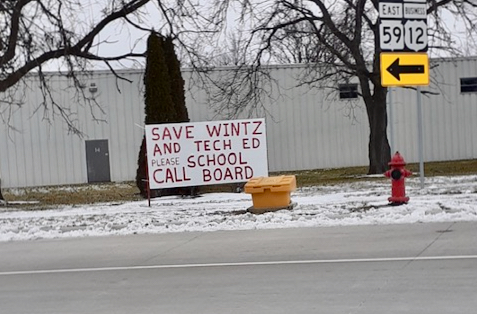
One of two large signs erected on properties owned by Whitewater resident Geoff Hale show support for Whitewater High School tech-ed teacher Mike Wintz. After an accident that occurred in his classroom late last year, Wintz was offered an option to retire. He submitted his retirement letter on Dec. 13. Supporters have asked school board members to reinstate him. Contributed photo.
Whitewater school board member meets with Wintz supporters
(Originally published Jan. 6, 2022.)
By Kim McDarison
Supporters of recently retired Whitewater High School shop teacher Mike Wintz met Tuesday with Wintz and Whitewater Unified School District Board of Education member Joe Kromholz.
The meeting, which was held at the Home Lumber store in Whitewater, was organized by the store’s owner, Geoff Hale, for the purpose of discussing the school board’s process and any future employment options available to Wintz, both Hale and Kromholz said during the meeting. Wintz submitted his notice of retirement to the district on Dec. 13. Wintz and his supporters said during the meeting that although Wintz submitted the letter, he had not actively been seeking an opportunity to retire.
The meeting, which lasted about 90 minutes, was attended by some 15 supporters, including two Whitewater High School students, and several former educators, many of whom said they had worked with Wintz over the course of their careers. Two supporters — both former Whitewater educators — joined the meeting remotely.
During the meeting, Wintz said he submitted his notice of retirement after the district investigated him, following an accident involving a student which occurred late last year in one of the high school’s three tech-ed shops. At the time of the incident, the area was under Wintz’s supervision.
At the conclusion of the investigation, Wintz said, he was offered three options on behalf of the district by Superintendent Caroline Pate-Hefty. They included appearing before the board for a hearing in closed session, appearing before the board for a hearing in open session or submitting a letter of resignation or retirement.
Wintz said he chose what he thought was the “least evil of my choices” and submitted his letter of retirement, ending prematurely, Wintz and his supporters have said, a 27-year teaching career.
During the informal meeting, which was conducted as a discussion, Wintz said when he was confronted with the choices, he was concerned that, would the board opt to terminate his employment, he would lose his health benefits. The retirement option offered an opportunity to preserve them, he said.
Addressing attendees on Tuesday, Kromholz said he had come to the meeting with the intention of listening to supporters and describing the district’s process, which revolved around the receipt of Wintz’s retirement letter. Kromholz said any views he presented were his own and not necessarily the views of the board. Additionally, he said, he had been serving as a school board member for “less than 30 days.”
Praise for Wintz
During Tuesday’s meeting, several attendees offered praise for Wintz and his dedication to his students.
Several of Tuesday’s attendees were among those offering similar comments during a school board meeting held Dec. 20.
Attending the meeting remotely, Pete Grace, who described himself as a former Whitewater High School educator who “taught with Mike for many years,” said of Wintz, “without a doubt, I’m sure that he is the best auto mechanics teacher that we ever had.”
Describing Wintz, former Whitewater High School shop teacher Ken Nehring said: “We’ve had a lot of auto mechanics teachers, and I’m not knocking any of them, but he’s good. The thing that a lot of people don’t realize is to do any type of teaching thing, you’ve got to have a few things going for you; one of them is a sense of humor, which he has. He gets along very well with his students, and some of you fellas there have been his students, and you know he can get along with some of the difficult students as well as some of the very good students.
“I think it would be a loss to the school system and to the program if he were to leave.”
Nehring also talked about changes in technology education over the years within the school district, noting that he believed ending the program at the middle school, which, he said, occurred at the time when the high school was built, was “really a big mistake.”
Middle school, he said, was a good starting point for many tech-ed students, noting that kids at that level can benefit from having something to do with their hands.
Additionally, Nehring said:” If Mike is responsible for this, then I guess the principal ought to be responsible, too, because he’s responsible for Mike, and the superintendent has to be responsible because she’s responsible for the principal.”
Citing student choices, an attendee said: “Sometimes students make decisions that are poor, and it puts all the adults in a bad spot also. And that could happened to anyone when you get 600 teenagers in one building.”
Kromholz told those in attendance that he was a supporter of technology education. Further, he said: “Regardless of how this all turns out, I think the most important thing to share at this meeting is that we all know Mike Wintz was a tremendous teacher for a number of years. My own son was in his class. We all owe a debt of gratitude and thanks to Mike for the years of service that he put in, and he should receive a debt of gratitude and a thank you.”
The process
Looking at potential next steps and focusing on school district process, Kromholz said: “There has been no hearing in front of the board on any of this … to my understanding, you (Wintz) submitted a resignation and that was an agreement, a legal agreement; I haven’t seen that agreement, but I understand that parts of that are confidential … There’s an agreement that got entered into between yourself and the district.”
Wintz agreed.
Kromholz continued: “So before this could ever get back to the board, the first thing that has to happen is that agreement has to be nullified. And you have to indicate that you want to nullify that agreement and then the district would have to agree that they want to nullify that agreement. Once that agreement’s nullified, then, I guess we go back to square one where you could request a hearing. They might come back again with termination, and I don’t know all the facts, I’m just talking about the procedure here.
“I’m a lawyer so I’m big on procedures,” Kromholz said.
Would a request for a hearing be granted by the board, Kromholz added, the evidence collected during the district’s investigation would be presented to the board, which would then vote.
“But nothing can happen, as long as that resignation is in place,” he said.
Hale asked if the board could decide against accepting Wintz’s retirement letter.
Said Kromholz: “The agreement is in place now; as I understand it, it’s been signed by Mike, and Casey Judd, the president of the school board. So the agreement is in place.
“To get to a hearing of the board, Mike would have to come in and say he wants that agreement removed and then, I guess, the district would have to say it wants that agreement removed. I’ve been on the board for 30 days so I’m looking into this, but, I’m trying to figure out who has the power to do that on the district side, and I don’t know just yet.”
Kromholz told Wintz that any next step to restart the previous process would begin with him.
Hale asked Kromholz: if Wintz chose to go before the board, would he risk losing his benefits?
Responding to Hale’s question, Wintz said: “That’s why I submitted my letter.”
“If he goes back to the board there’s two outcomes: the termination can get affirmed, in which case I don’t know what all the aspects are, but I imagine there are some negative aspects. Or it could be refused. But again, that depends on how the board would vote based upon all the evidence that it hears at the hearing. And the board would have to have a hearing and hear the evidence,” Kromholz said.
Wintz said he was given a period when he could change his mind about his decision, but that time had passed.
Attendees asked Kromholz if the period could be extended.
Kromholz said he believed Wintz could still submit a request to the district.
Sharing his thoughts before he wrote his letter of retirement, Wintz said that he qualified for a health insurance benefit offered to those employed by the district for 15 consecutive years or were 55 years old or older.
“So I took that and turned in my letter. I know three board members and I thought, well, a trial hearing isn’t going to really bother me, but I don’t know everyone, and I didn’t want to lose benefits I’d worked pretty hard to gain, so I turned in that letter. That was my train of thought,” Wintz said.
Wintz said he did not want to lose his job.
Support for technology education
Kromholz said he was a supporter of technology education, both at the high and middle school levels.
“There will always be tech-ed as long as I’m on the board. And we need more money in tech-ed. Right now, tech-ed, if you adjust for inflation, is being funded at one-eight of the funding that it had 25-30 years ago. So that’s crazy,” he said.
“I’m a firm supporter of tech-ed. There will never not be tech-ed as long as I have a vote on the board; at least I’ll always be voting for it,” Kromholz continued.
‘The more the board knows’
Attending the meeting virtually, former Whitewater educator Mark Maas thanked Kromholz for attending the meeting.
“For you to even be here today is pretty awesome so I commend you for that,” Maas said, but, he added, he had concerns at the high school about “a bigger picture.”
He described a history of workplace unrest, and suggested that “a line of questioning” was in order.
Said Maas: “The more the board knows, the more the board knows.”
He asked that the board apply “a little more due diligence on this whole thing. I hope some questions get asked that make some people feel really, really uncomfortable,” he said.
Given what several in attendance described as a “toxic environment” at the high school, Hale asked Kromholz how the board would attract a new shop teacher.
Hale asked: “How are you going to find a replacement for Mike Wintz if anybody that’s coming to apply for the job knows the toxicity that exists in that environment, for taking a kid into that classroom and having a small accident happen and you get terminated? How are you going to grow the program if you lose him?”
“It’s my understanding that they are actively looking for another person right now. When they have everything said and done, I don’t know, and I don’t know the answer to that question,” Kromholz said.
“We are getting the cart before the horse here, ok, with that question,” Kromholz added.
“I guess I’d like to know, why are we even here talking about that?” another attendee asked. “Why is this man forced to make this decision; why was he put in that place to begin with? I think the two most important components in this room right now are you (Kromholz) and Mike. Everyone else here is an outsider looking in. We do not know .. we’re all trying to piece this all together. Mike’s the only one that really knows what happened. Have you even had a chance to get that story?”
Said Wintz: “The board, It’s my understanding, on purpose they cannot share anything with them in case there is a hearing. Then they have no preconceived notions going into that hearing.”
Kromholz said the information from the investigation was not shared with board members because a hearing was not held.
Attendee Mike Pope asked why Wintz had not been placed on paid administrative leave while the process was underway.
Wintz said he had been placed on paid administrative leave.
“And then our insurance company — the district’s insurance company — did some investigations and some interviews with some students and faculty members, and, it was my understanding, that it was Caroline’s (Pate-Hefty’s) recommendation to terminate my employment.
“And she did present to me the options,” Wintz said.
Wintz said at that time, he was asked to make a choice.
“I’m just glad the student involved is back in school and has been for several weeks; he’s just fine and running around talking to his friends,” Wintz said.
Shop safety procedures
Hale asked Kromholz if he was aware that the student had to pass a test to participate in the tech-ed program.
According to Hale, a statement on safety information reads: “I will not shoot sparks at myself or others in any situation.”
The student signed that agreement, Hale said.
Others, including the two high school students in the room, agreed all shop program participants had to sign a safety agreement.
“I think my son had to sign an agreement like that,” Kromholz said.
Attendees asked why the student was not held accountable for the accident.
Citing issues associated with culpability, Wintz said: “The people I talked to and worked with for a couple of decades are scared to death to go to work. They don’t want to go. They think they are all going to get fired. No one will do lunch duty. It’s a terrible environment.”
Responding to questions asked about his safety record, Wintz said: “I went 27 years completely incident-free.”
Both of the high school students in attendance said at school, students were not allowed to mention Wintz’s name, with one student saying the whole incident was “hush-hush.”
Moving forward
Responding to questions about next steps and requesting a hearing, Kromholz said: “I don’t know if it’s the school board’s decision or the superintendent’s decision. I have to find that out.”
Attendee A.J. Tanis said he was concerned about “some of the situations” in the district’s schools and “COVID money spent on things that I consider frivolous.”
He asked about accountability at the administrative level.
As the meeting concluded, when asked about takeaways, Kromholz said: “I learned that there’s tremendous support for Mr. Wintz in this segment of the community for sure. I’m gratified that we have people that are active in the community and want to participate in this. My takeaways are I want to gather some more information, but I do think at this stage, it’s up to Mr. Wintz to make some decisions before anything can go forward, and that’s his choice, and not my choice.”
An earlier story about Wintz’s retirement letter submitted as one of several options provided by the school district after its investigation of a shop-related accident at the high school is here: https://fortatkinsononline.com/whitewater-teachers-retirement-fuels-controversy-supporters-look-for-reinstatement/.
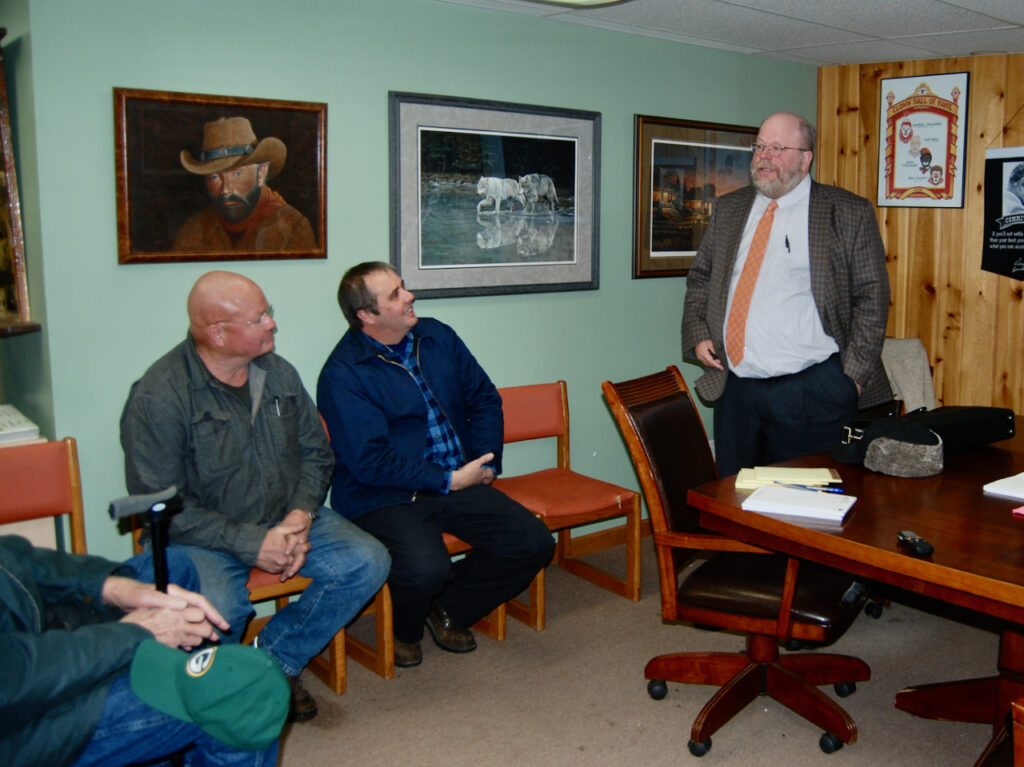
Supporters of recently retired Whitewater High School shop teacher Mike Wintz, seated, at right, listen as school board member Joe Kromholz, standing, explains school district process related to circumstances surrounding a retirement letter submitted by Wintz on Dec. 13.
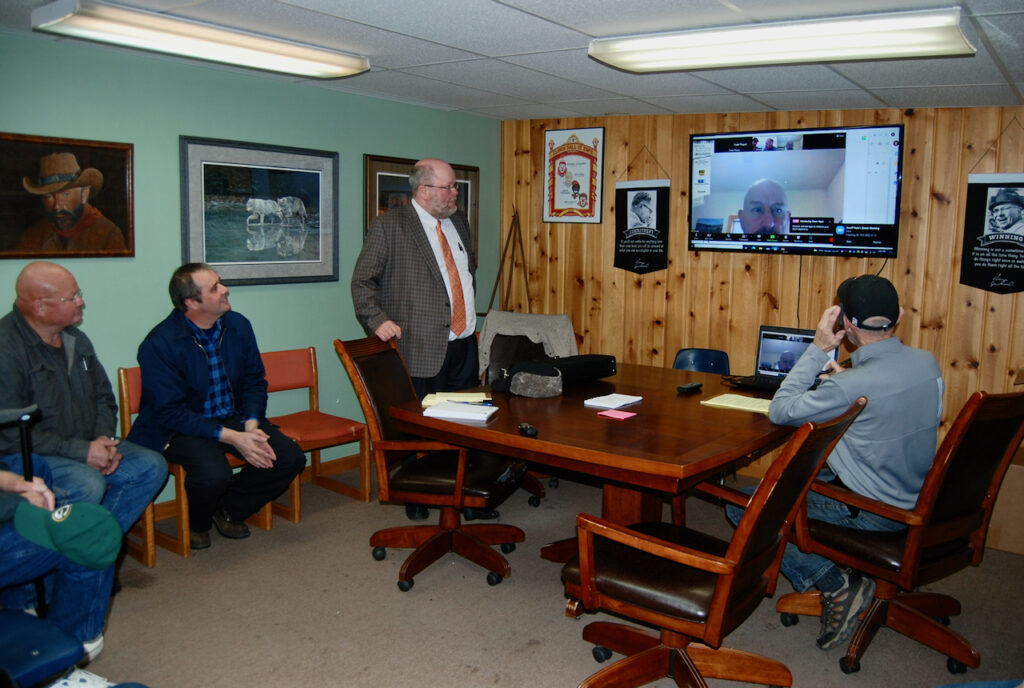
Former Whitewater school district educator Mark Maas, shown on screen, shares words of praise about Mike Wintz’s 27-year teaching career.
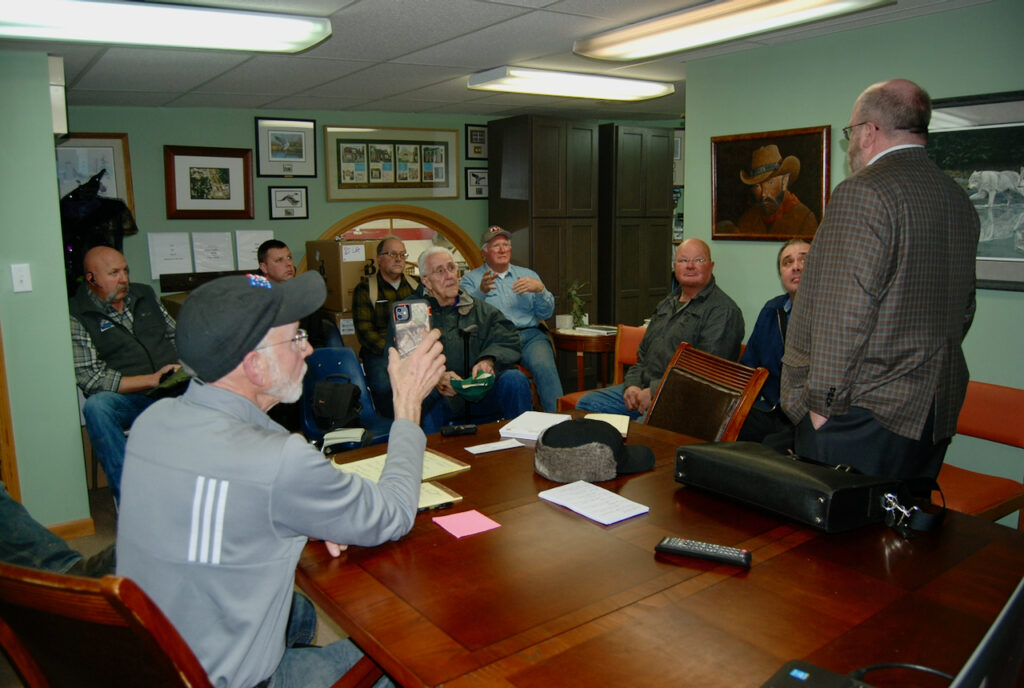
Wintz supporter Geoff Hale, front, left, holds a phone so a remote meeting attendee can participate in the discussion. In-person attendees Tuesday filled a small meeting room and part of an attached hallway at Hometown Lumber in Whitewater. Kim McDarison photos.
Whitewater Common Council to see race for one at-large seat in April
(Originally published Jan. 7, 2022.)
By Kim McDarison
The Whitewater Common Council will have at least one race for a single at-large seat which will be decided in April.
Two candidates for the at-large seat, incumbent Jim Allen, 215 E. Clay St., and challenger Chuck Mills, 336 S. Whiton St., have successfully submitted paperwork with the city clerk’s office to have their names appear on the spring election ballot.
Among other changes, council president Lynn Binnie filed a statement of non-candidacy in December. Binnie holds a seat representing the city’s Aldermanic District No. 4.
Jill Gerber, 234 Pleasant St., has successfully submitted paperwork with the city clerk’s office and her name will appear on the April ballot. Gerber is looking to fill the open seat vacated by Binnie.
Gerber made known her intentions to run for the seat late last year, submitting an announcement to Fort Atkinson Online on Dec. 16.
She will be running unopposed.
In the city’s Aldermanic District No. 2, incumbent Lukas Schreiber, 375 N. Harmony Lane., having successfully submitted his paperwork with the city clerk’s office, will be running unopposed.
A general spring election is scheduled for April 5.
Thompson tenders letter of resignation to UW Board of Regents
(Originally published Jan. 7, 2022.)
Former state Gov. Tommy Thompson will be stepping down as interim president of the University of Wisconsin System, according to information released today be the UW Board of Regents.
In a letter dated Jan. 7 to UW Board of Regents President Edmund Manydeeds III, Thompson said his resignation would take effect March 18.
Thompson was sworn in as interim head of the UW System in July 2020.
“While challenging on many fronts, we worked together to continue to provide the quality of education our students deserve and parents expect,” Thompson wrote in his letter of resignation. “We not only performed but prevailed in our fight against COVID’s deleterious impact on our universities and our communities — and in doing so we made our campuses some of the safest places in Wisconsin.”
Thompson pointed out that the position was temporary as the UW System sought a permanent president
“While I firmly believe that the pursuit of excellence never ends, I am satisfied that I have accomplished what has been asked of me and what the people of this state have sought,” Thompson said in his resignation letter. “It is time to allow you and the board the ability to prepare for a successor to lead the UW System into the years ahead.”
Manydeeds lauded Thompson’s efforts during his tenure.
“Tommy Thompson was the right man at the right time. His leadership has helped carry us through a pandemic and set the standard for managing during a crisis,” he said within the release.
“As important, President Thompson has been a relentless champion of the University of Wisconsin,” Mandeeds continued. “It showed in everything he did as system president. He raised the profile of public higher education in our state and ensured that it is relevant, not only to students, parents, faculty, and staff whose leadership we entrusted to him, but also to all Wisconsinites.”
Manydeeds said that Thompson answered the call as one of Wisconsin’s greatest public leaders by accepting this role in spite of the challenges in front of him.
“We are proud of what he accomplished in his time here and consider him, as always, a lifelong friend of the University of Wisconsin. We were fortunate to have such a strong advocate and evaluator lead the UW System,” he said.
UW-Whitewater Interim Chancellor Jim Henderson also commented on Thompson’s pending resignation.
In a prepared and released statement, he said: “On behalf of the Warhawk family, I’d like to extend my deepest appreciation to President Tommy Thompson for his service to the UW System and the state of Wisconsin,” he said. “He has led the system through one of the most challenging times in our history with unmatched energy and passion.
“We couldn’t have asked for a more enthusiastic champion of UW-Whitewater and the state universities as a whole — someone who fundamentally understands our collective educational, economic, and cultural impact and fiercely promotes our contributions,” Henderson continued. “His tireless advocacy and efforts to provide the universities with resources to carry out our unique missions have been critical to the success of our students and will be felt for years to come. And we will always remember his embrace of the Warhawk Strut!”

Tommy Thompson
Jefferson County Board: Fort to see one race; Whitewater candidates running unopposed
(Originally published Jan. 12, 2022.)
By Kim McDarison
Jefferson County Board of Supervisor seats will be on the ballot in April. Seats coming due this spring include those held by supervisors representing constituents within the cities of Fort Atkinson and Whitewater.
Fort Atkinson
In Fort Atkinson, all of the city’s wards, 1-9, are included in Jefferson County. Districts and wards are as follows: District 23 includes Ward 8; District 26 includes Wards 1 and 2; District 27 includes Wards 3 and 4; District 28 includes Wards 7 and 9, and District 29 includes Wards 5 and 6.
Among districts including wards in Fort Atkinson there is a race in District 29. Incumbent Mary Roberts will face challenger Wyatt Cooper.
Cooper announced his candidacy with Fort Atkinson Online on Jan. 3.
Candidates in all other districts including wards in Fort Atkinson are running unopposed, and include: District 23, George Jaeckel; District 26, Joan Fitzgerald; District 27, Joan Callan, and District 28, Anthony Gulig.
The city of Fort Atkinson has traditionally had 9 wards. In 2021, after the annexation of a single property, the city had 10 wards, but after the most recent census update last fall, City Clerk Michelle Ebbert said, the single property in the ward was added to an adjacent ward, bringing the total number of wards within the city back to 9.
Last July, the city designated a Ward 11 as a “placeholder” after land along Banker Road was annexed into the city, but no electors live within the ward, City Manager Rebecca Houseman LeMire explained during the annexation process.
Whitewater
City of Whitewater Wards 10, 11 and 12 are included in Jefferson County.
District 24 includes Wards 11 and 12, and District 25 includes Ward 10.
District Supervisor candidates representing wards in Whitewater are running unopposed and include: District 24, Roger Lindl, and District 25, Matthew Foelker.
Other races
Among other Jefferson County Board races, Heart of the City President Frankie Fuller is running in District 20. Fuller said she lives in the town of Jefferson along its border with Fort Atkinson and within the Fort Atkinson School District. Fuller is running against incumbent Curtis Backlund.
In District 30, incumbent Walt Christiansen will be facing challenger Jeff Agnew, an agricultural education teacher who retired from the School District of Fort Atkinson in 2020. The district includes wards within the towns of Koshkonong and Sumner.
A full list of districts and candidates can be found on the county’s website: https://files4.1.revize.com/jeffersoncountynew/2022%20Nomination%20Papers.pdf.
A map of supervisory districts is here: https://www.jeffersoncountywi.gov/departments/county_clerk/elections/supervisory_district_maps.php#revize_document_center_rz807.
Whitewater Chamber celebrates 80-year anniversary; events, activities scheduled
(Originally published Jan. 13, 2022.)
The Whitewater Area Chamber of Commerce has announced that it will be celebrating its 80th Anniversary in 2022.
According to information released by the chamber, the organization was incorporated in March of 1942 and is dedicated to helping Whitewater area businesses and the community thrive.
Adhering to COVID-19 precautions, after two years of postponed, canceled and abbreviated events and activities, the chamber is poised to make 2022 a year of celebration and community, the release stated.
This month, the chamber will kick off a year of celebration with “Conversations and Cocoa,” which will be held Monday, Jan. 31.
According to the release, the chamber is inviting its partners, local business owners and staff, and area residents to stop into the Discover Whitewater offices in downtown Whitewater, 150 W. Main St., between 10:30 a.m. and 2:30 p.m. to participate in “a mid-winter break and chat” about the community.
Event-goers are invited to participate in the chamber’s “Love Local” February campaign by filling out a love letter heart for their favorite local business or organization. The chamber will deliver the “love letters” on Valentine’s Day.
In April, the chamber will be hosting its annual Awards and Celebration Dinner, at which time the organization will be commemorating 80 years of service to businesses and the community.
Current, former and prospective chamber members are encouraged to attend and help celebrate this milestone anniversary. The chamber would also like to invite the community to share any photos, documents or mementos community members might have regarding the chamber’s activities over the past eight decades for a timeline project. Items can be dropped off at the Discover Whitewater offices or emailed to info@whitewaterchamber.com, the release continued.
Registration is required for the dinner. More information will soon be available on the chamber’s website. Seating is limited and chamber members will be given first priority. Those interested in attending are encouraged to watch the chamber’s website and make reservations early to ensure seating. Arrangements for the dinner are underway and ticket information will soon become available on the chamber’s website, Executive Director Kellie Carper recently noted.
For more information about upcoming chamber events or all other chamber-related activities, visit its website: https://www.whitewaterchamber.com/ or contact Carper: (262) 473-4005.

A view of downtown Whitewater features the Discover Whitewater office, 150 W. Main St. Community members and partners interested in “chatting” about Whitewater with members of the Whitewater Area Chamber of Commerce are invited to stop by Monday, Jan. 31, between 10:30 a.m. and 2:30 p.m. to say hello, learn about the chamber as it celebrates its 80th anniversary, and share thoughts and ideas. Contributed photo.
Investigation of police chief remains ongoing, Whitewater city officials say
(Originally published Jan. 13, 2022.)
By Kim McDarison
More than a month after Whitewater Police Chief Aaron Raap was placed by the City of Whitewater on paid administrative leave, pending an internal investigation which is being conducted by an outside source, as of Thursday, city officials have said the investigation “is still ongoing.”
Responding to emailed questions about the status of the investigation posed by Fort Atkinson Online, Public Relations and Communications Manager for the City of Whitewater, serving as spokesperson and responding by email, Kristin Mickelson, wrote that after conferring with Whitewater City Manager Cameron Clapper and Whitewater Deputy Police Chief Dan Meyer, she was able to release the following statement:
“The outside investigation in regards to the status of the Whitewater Police Chief is still ongoing. Although we are hopeful for this investigation to draw to a close soon, we do not have any new information to share at this time as we wait for the results.
“When the investigation is complete, it will be reviewed by city officials. Upon the conclusion of that process, we will be issuing an updated press release for the community. The timeline is undetermined and we are very appreciative for the patience of the community and all those involved as we navigate through this difficult situation.
“During the course of this investigation, our focus at WPD (Whitewater Police Department) has remained providing a high-level of public safety service to our community. We have an exceptional staff and have adjusted duties as needed to continue operating effectively.”
City officials announced in a press release on Dec. 3 that Raap had been placed on paid administrative leave, further noting that Meyer would be serving as acting police chief “until further notice.”
The release from Dec. 3 continued: “An internal investigation will be conducted by an outside agency based on an incident that occurred outside the city of Whitewater. The leave is not considered punitive, rather part of the Whitewater Police Department policy.”
Information shared Dec. 16 with Fort Atkinson Online by the Waukesha County Sheriff’s office indicated that Raap had been arrested Thanksgiving day after an alleged altercation at his home.
In an incident report filed by the sheriff’s department in November, charges of “simple battery” were referred to the Waukesha district attorney’s office.
Raap lives in Waukesha County.
Speaking with Fort Atkinson Online by phone on Dec. 16, Waukesha District Attorney Susan Opper said that after reviewing the information provided, she “declined prosecution,” citing a lack of “sufficient evidence that there was an intention to inflict bodily harm.”
In a statement issued by Clapper also on Dec. 16, he wrote that the city had received a number of media inquiries about the status of the investigation, adding: “The procedure is part of a broader effort to maintain the integrity of the organization as a whole, not a criminal investigation. As a result, the internal investigation runs independent from any decisions made by other agencies including Waukesha County’s District Attorney’s Office and will be completed as soon as possible.”
An earlier story, including information from the incident report filed by the Waukesha County Sheriff’s Department is here: https://fortatkinsononline.com/waukesha-county-sheriff-department-records-pertaining-to-arrest-of-whitewater-police-chief-released/.

Whitewater Police Chief Aaron Raap
.
Two transported to hospital after single vehicle crash near Whitewater
(Originally published Jan. 14, 2022.)
By Kim McDarison
A single-vehicle accident occurred at approximately noon today on County Highway N, just north of the city of Whitewater.
An observer at the scene told Fort Atkinson Online that a Whitewater ambulance responded to the scene shortly after noon.
According to the observer, the car, a sedan, sustained damage to the driver’s side.
Information provided on the Whitewater Fire Department’s Facebook page about the incident is as follows:
“At 11:58AM on 1-14-22, a Whitewater Ambulance transporting a patient to the hospital, witnessed a 1 vehicle accident in the area of Cty Road N, before the S curve in Cold Spring township.
“Fire and additional EMS crews were requested to the scene, for 2 patients. The south bound lane was closed for approximately 30 minutes while crews removed a patient and swept the roadway. 2 patients were transported to area hospitals.”


Two photos above: At top, a Whitewater ambulance arrives at the scene of a single-car accident around noon Friday. The accident occurred on County Road N north of Whitewater. Above: Whitewater fire and EMS crews were called to the scene to help remove and transport two patients, according to information shared on the Whitewater Fire Department Facebook page. Contributed photos/Pete Spangler.
Regent Committee announces finalists for UW System president
(Originally published Jan. 15, 2022.)
The Special Regent Committee for the University of Wisconsin System Presidential Search announced Friday that it has identified two finalists who have agreed to be interviewed for the position next week.
The two finalist are Jay O. Rothman, chairman and CEO of the Milwaukee-based law firm of Foley and Lardner LLP, and Janes C. Schmidt, who has served as chancellor at UW-Eau Claire since July 2013.
According to information supplied by the UW System Friday, Rothman, has served in his current roles at Foley and Lardner since June 2011 and has been a member of the firm’s Management Committee since February 2002. He joined Foley in October 1986 and has been a partner since February 1994. He earned a bachelor’s degree from Marquette University and a law degree from Harvard Law School.
Schmidt has served as chancellor at UW-Eau Claire since July 2013. Previously he was vice president for university advancement at Winona State University in Winona, Minn., and vice president for student affairs at Riverland Community College in Austin, Minn. He earned a bachelor’s degree in political science from Winona State University, a master’s degree in business administration from the University of St. Thomas in St. Paul, and a doctorate in educational policy and administration from the University of Minnesota.
As quoted in the release, Regent President Edmund Manydeeds III, chair of the Special Regent Committee, said the two finalists offer a depth and breadth of experience, including in the academic, business, and civic arenas.
He said: “We have identified two excellent candidates, each of whom would be an outstanding leader for our university system. We believe their qualifications and experience provide the committee a great opportunity to pick a future leader for the UW System.”
The finalists will interview Tuesday with the Special Regent Committee and other groups, including shared governance representatives, chancellors, and UW System executive leaders. Manydeeds and Search and Screen Committee chair Karen Walsh, the Regent Vice President, announced that because of the extraordinary public input in the process so far, there will be no public session with the finalists, the release continued.
“Our diverse 21-member Search and Screen Committee included representatives from all universities and all campus constituencies, which helped us identify a list of viable candidates to forward to the Special Regent Committee. We also held numerous valuable listening sessions at all of the universities and with all constituencies – often more than one. We look forward to the Special Regent Committee completing its work,” ” Walsh said in the release.
After the interviews, the Special Regent Committee will forward a recommendation to the full Board of Regents, which will make the final decision on hiring a new UW System President. A decision is expected by the end of January.
The chosen finalist will replace Tommy Thompson who has been serving as president since July 1, 2020. He announced this month that he would step down effective March 18. Thompson replaced former president Ray Cross.
The next UW System President will be the System’s eighth since 1971 legislation unified two public university systems under a single Board of Regents. The system educates approximately 165,000 students at 13 universities across 26 campuses, serves more than 1 million Wisconsin residents through statewide outreach programs, and employs about 39,000 faculty and staff statewide. The total estimated annual economic impact of the UW System exceeds $24 billion, according to the release.
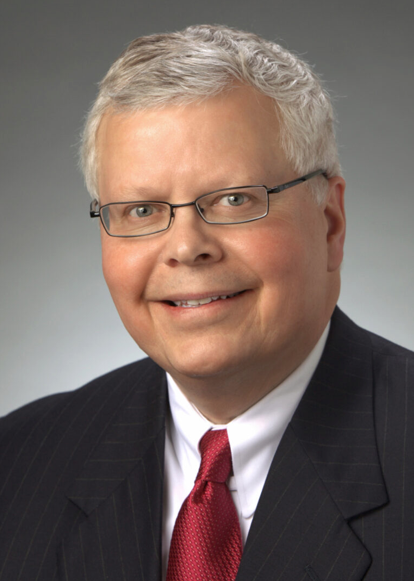
Jay O. Rothman

James C. Schmidt
Whitewater: City signs contract with Stout Construction, lake dredging to begin Monday
(Originally published Jan. 16, 2022.)
By Kim McDarison
A document released through the City of Whitewater’s website indicates that city officials have signed a contract for dredging within Cravath and Trippe lakes with Chetek-based Stout Construction, Inc. The document was signed on Jan. 11.
Information recently released by the City of Whitewater notes that Stout is a subcontractor working with A-1 Excavating, Inc., one of two contractors that responded to a request for bids made by the city last November.
During a meeting of the Whitewater Common Council held Dec. 21, the council granted authorization to members of city staff to pursue a contract with A-1 Excavating, Inc., and Whitewater-based Kowalski and Sons Excavating.
Both companies, City Manager Cameron Clapper said during the meeting, had expressed an interest in working with the city to help keep dredging costs to within an amount as originally budgeted by the city. That amount was $1.5 million.
After releasing a request for bids in November, the city received two responses. The smaller of the two bids received was provided by A-1 Excavating. The company bid the city’s full dredging project, as it was presented in the request, at just under $2.5 million.
According to the contract recently signed with Stout Construction, the process will use excavators, dozers and dump trucks, with all work toward completion on a “time and material basis.”
The contract supplied estimates of itemized expenses, further stating that “actual invoices will be created based on actual amounts.”
Among costs identified in the document are $30,000 for “mobilization and demobilization” and $60,000 for mats, which are required to ensure mobility of equipment in the lake beds.
Hourly rates for use of equipment range from $115 per hour for a quad axle dump truck to $265 per hour for a CAT 336 excavator.
“Production tracking shall be signed off by (the) Stout superintendent and city official weekly. Invoices shall be sent weekly,” the contract states.
In addition, the document specifies that the company will plan for 12-hour work days.
Exclusions within the contract include: ripping, blasting, licensed staking and layout, permits, private locations, hidden or buried debris, rock excavation, dust suppression, compaction testing, traffic control, dewatering, landscaping, planting and retaining walls, according to the document.
Information posted to the city’s website on Jan. 14 indicates that plans call for the company to provide two teams of workers, one at each lake, with dredging preparations to begin next week and the removal of materials from the lake beds to begin the following week.
The full project is anticipated to take place, weather permitting, over a 5-6 week period.
Construction work will be performed Monday through Friday, between 7 a.m. and 7 p.m., according to the city’s website.
Parking areas at Cravath Lakefront Park and Trippe Lake Park will be closed while the work is being performed, the information continued.
Plans call for spoils removed from the lake beds to be “stockpiled” at the city’s designated deposit sites located on land east of and adjacent to the Innovation Center in the city’s industrial park and on property owned by Whitewater business owner Geoff Hale, located near Cravath Lake.
According to the information released: “The plan is to create a navigation channel through the lakes and dredge around the park waterfront areas.”
The city has received a permit from the Wisconsin Department of Natural Resources to remove 81,000 cubic yards of materials from the lakes.
Plans call for the refilling of the lakes with water beginning June 10, the information stated.
A link to the city’s website is here: https://whitewater-wi.gov/1.
A copy of the contract with Stout Construction is here: http://fortatkinsononline.com/wp-content/uploads/2022/01/Stout20Construction20Dredging20Contract.pdf.
An earlier story about bids received and plans to restore Cravath and Trippe lakes is here: https://fortatkinsononline.com/whitewater-city-authorizes-pursuit-of-dredging-contract-with-a-1-kowalski/.

Cravath Lake as it appeared in 2015. Recent steps taken by City of Whitewater officials move both Cravath Lake, and its adjacent counterpart, Trippe Lake, closer to completion of a restoration project that has been ongoing for more than two years. Newest plans anticipate the drawn down lakes will be refilled with water in June of this year. File photo/Kim McDarison.
UW-W Chancellor congratulates Rothman as UW System president
(Originally published Jan. 22, 2022.)
Editor’s note: the following statement was released Friday by the University of Wisconsin-Whitewater.
“On behalf of UW-Whitewater, I’d like to offer my heartfelt congratulations to Jay O. Rothman on his appointment as the next president of the University of Wisconsin System,” said Jim Henderson, interim chancellor. “During the interview process, I was extremely impressed by Mr. Rothman’s vision for public higher education in our state – one that is grounded in excellence in every aspect of our respective university missions. As a native of Wisconsin with strong ties to the state, he deeply understands the unique nature of the UW System as an academic, economic and cultural driver of Wisconsin and of our future. At a critical time for higher education, Mr. Rothman is the right person with the right leadership skills to move the UW System forward, to strengthen relationships with all of our constituents, and to build upon our important work on behalf of the people of our state. We look forward to him visiting UW-Whitewater in the future and sharing with him the outstanding story of the Warhawk family.”
Jim Henderson,
Interim chancellor, UW-Whitewater
A story about the UW System finalists for the position, a pool of two from which Rothman was selected, is here: https://fortatkinsononline.com/regent-committee-announces-finalists-for-uw-system-president/.

Jay O. Rothman
Whitewater tech ed teacher Watson resigns, two tech ed teachers hired
(Originally published Jan. 25, 2022.)
Correction: Comments attributed to Whitewater Unified School District Board Member Maryann Zimmerman in response to Geoff Hale during public comments were made by board member Jennifer Kienbaum. The story has been corrected to reflect that change. Fort Atkinson Online regrets the error.
By Kim McDarison
Members of the Whitewater Unified School District Board of Education Monday ratified the resignation of a high school technology education teacher and the employment of two others.
Board members formally accepted the resignation of tech ed teacher Cody Watson. The effective date of his resignation was listed on the agenda as Jan. 17.
Watson is the second high school tech ed teacher to leave the department in recent months. Twenty-seven year veteran tech ed teacher Mike Wintz retired in December, following an investigation undertaken by the district after an accident involving a student occurred last November.
In addition, board members welcomed two new teachers to the high school’s tech ed department. They are Mason Pautsch, whose effective date to begin working at the high school was listed on the agenda as Jan. 18, and Tim O’Toole, who will begin working in the high school’s tech ed department on Jan. 31.
During the ratification process, board members unanimously approved Watson’s resignation and O’Toole’s employment.
Pautsch’s employment was approved by a vote of 6-1, with board member Larry Kachel casting the “no” vote.
Prior to the regular board meeting, the board met in executive session to consider: “financial, medical, social or personal histories or disciplinary data of specific persons, preliminary consideration of specific personnel problems or the investigation of charges against specific persons except where par. (b) applies which, if discussed in public, would be likely to have a substantial adverse effect upon the reputation of any persons referred to in such histories or data, or involved in such problems or investigations, specifically, to discuss disciplinary data of a previous district employee.”
The subject was listed on the agenda as an action item.
The board, upon reconvening into open session, did not disclose any action taken during the executive session.
Public comments
In open session, during public comments, two speakers came forward to address the board.
Nick Baldwin, who described himself during a previous board meeting as an auto shop teacher in a different school district and a parent of students in the Whitewater school district, addressed the board Monday sharing concerns about changes in Whitewater High School’s tech ed program.
Baldwin cited concerns about certifications required allowing the district to continue its participation in what he described as a “dual credit” program facilitated in collaboration with Gateway Technical College. In past years, he said, Whitewater High School was able to offer its automotive shop students an opportunity to earn tuition-free college credits through Gateway. Baldwin told board members that participation in the program requires shop teachers working with Gateway to be Automotive Service Excellence (ASE) certified.
“Whoever it is that teaches automotive, I ask that the school board or district administration works toward pursuing this option, so it’s something that we can continue to do with our kids,” Baldwin said.
Responding to a board member’s request for information, Baldwin said when a class offered at the high school meets with a certain percentage of the curriculum offered at Gateway, the students taking that class can earn “transcripted” credits though the technical college.
“Those college credits stay with them on their record,” Baldwin said, adding, “the instructor needs to be ASE certified, and that’s a deal between Gateway and the instructor, not the school, so whoever does teach automotive will need to be certified in that if they plan to continue that program.”
Whitewater Unified School District Superintendent Caroline Pate-Hefty said the district was already engaged in talks with Gateway.
Whitewater resident Geoff Hale addressed the board sharing his frustration about decisions made regarding the retirement of Wintz.
Said Hale: “As servants of our community, is there a creed for a school board member? Is there a creed for the principal? Is there a creed for a superintendent? If there is none, you may wish to find one. … Ms. Pate-Hefty pretty clearly misrepresented the true facts in the Wintz case. Mike Wintz never, ever wished retirement. As a school board, was there ever any concern or consideration given to asking the tough questions? Did anyone ask if it was truly Mike’s wish to step down? Did anyone think to ask how someone with a spotless, revered, life-changing 27 (year) career would choose retirement when he had two more years to make a difference with so many more young lives? Your failure to ask, your failure to react, your failure to hold a superintendent accountable has enthused a tidal wave of tension and resentment throughout our community.”
Hale claimed a history of what he cited as “non-transparent activity” at the high school, which, he said, was being “pushed by this administration.
“It’s felt in the classrooms, in the hallways, by students and teachers throughout our high school. There’s a sense of fear and intimidation that is coming from the top down.”
Addressing the superintendent, Hale said: “Ms. Hefty you ought to be ashamed for the manner you chose to handle Mike Wintz. … As our superintendent you need to take all the credit for taking down and destroying one of the most beloved human beings in Whitewater’s history.”
Hale called events leading to Wintz’s retirement contributors to one of the “largest community controversies Whitewater has ever seen,” which, he said, “incited community-wide anger and the pullback of $4,800 in scholarships.”
Responding to Hale’s comments, school board member Maryann Zimmerman said she, too, was frustrated and asked the community not to punish Whitewater students by taking away scholarships.
“We have a 50% poverty level, so those scholarships are needed,” she said.
School board member Jennifer Kienbaum added: “The frustrating part for me is we are all adults, and the questions have been asked, and we do follow through, so for other adults to, when you don’t know the story, to assume or put blame where blame not necessarily is, is very frustrating.
“There’s a lot of ways that this could have probably maybe been handled a little bit different, but to say that we didn’t ask or to accuse is very frustrating, because we have processes in place and we do follow them. From a state level, from a board level, and I, quite frankly, I don’t tolerate bullies. So if you’re going to come in here or anybody else, and say I’m going to pull money because this wasn’t done, that hurts the kids.”
“You think I’m a bully?” Hale asked.
Kienbaum responded: “I’m not saying that; I’m just saying, don’t come in and say we’re taking money away from the kids in this community, because we’re all sitting at this table trying to help the kids.”
In other employment-related actions, the board unanimously:
• Accepted the resignation of Kimberly Knudsen, a cook at Lakeview Elementary School, which, the agenda stated, was effective as of last December.
• Welcomed Sean McKenzie as a district data analyst. McKenzie began working at the district’s Central Office Monday.
• Hired co-head coaches for high school track Nicholas Bee and Matthew Green; middle school track coach Sallie Berndt, and assistant high school track coach Rachel Cook.

Following a closed session meeting, members of the Whitewater Unified School District Board of Education Monday convene in open session in the Whitewater High School library. The image shows the board via Zoom.
Whitewater: School board sets special education open enrollment space limitations
(Originally published Jan. 26, 2002.)
By Kim McDarison
Members of the Whitewater Unified School District Board of Education Monday approved special education open enrollment space limitations for the 2022-23 school year.
Space limitations were not set for general education students looking to open enroll into the district.
Numbers presented to the board included maximum space within each special education category available to a total number of students, including resident students, enrolling into the district.
Space limitations were developed based on the district’s ability to supply special education services using its current level of staffing, Director of Pupil Services Lanora Heim said.
Available space for students in need of special education services were capped for the 2022-23 school year as follows:
Cross Categorical Special Education: early childhood, 7 students; grades 4K-5, 147 students; grades 6-8, 75 students, and grades 9-12, 90 students.
In addition, limitations of “no additional students” were set for supports such as deaf and hard of hearing services, including audiology, and services for the visually impaired, based on a lack of staffing. The district contracts such services from an outside source, Heim noted during the meeting.
Students in need of speech and language services are limited to 158, those in need of occupational therapy services are limited to 70, and those in need of physical therapy are limited to 18.
Students with needs
Aided by slides, Heim shared open enrollment statistics as they related to several categories within the scope of special education.
According to Heim, assessing space available for open enrollment students within the district is done annually as required by state statute.
Pointing to a bar graph labeled: “Number of Students with Special Needs as of Jan. 3, 2022,” Heim noted that, within a category of “speech and language” the district currently supports 206 students. Next school year, she said, she anticipates the district will be looking at potentially supporting 215 students. She recommended an enrollment cap for the 2022-23 school year of 158 students.
In the category of “occupational therapy,” Heim said the district is currently supporting 69 students, and anticipates a potential enrollment of 70 students next school year. She recommended capping enrollment at 70 students for the 2022-23 school year.
In the category of “physical therapy,” Heim said the district is currently supporting 19 students, with an anticipated enrollment for next year of 21 students. She recommended capping enrollment for students in need of physical therapy at 18 students.
Pointing to a bar graph labeled: “Special Education Numbers,” Heim presented numbers of students receiving special education services grouped by grade level.
According to the graph, this school year, the district is supporting three students enrolled in an early childhood program. Next school year, the number is anticipated to climb to six. Heim recommended that the district cap enrollment into the early childhood program in the 2022-23 school year at seven students.
This school year, in grades 4K-5, the district is supporting 121 students with Individual Education Programs also known as IEPs. That number was predicted to increase in the 2022-23 school year to 125 students, Heim said. She recommended capping enrollment next school year at 147 students.
Looking at numbers in the middle school, Heim said the district currently supports 69 students with IEPs. Next year, the number is anticipated to increase to 71. She recommended capping enrollments for next school year at 75 students.
At the high school level, the district is currently supporting 95 students with IEPs. The number is predicted to increase next school year to 104 students. Heim recommended capping enrollments at 90 students.
Planning for special needs
According to Heim, space limitations apply to students entering the district through the state’s open enrollment program.
“If they move to our district, they’re ours; no matter what, we serve them,” Heim said.
Students who have previously enrolled in the district through open enrollment stay with the district.
“We never turn anyone away who has been accepted in,” she said.
Heim cited a limited number of district staff as the main driver behind a need to set space limitations. Costs, too, affected decision-making, she said. As an example, she pointed to services contracted through outside sources by the district, such as those used to support the deaf and hard of hearing, and services for the visually impaired.
“We don’t actually have our own employees; we contract them through CESA 2, so that would be an additional cost,” she said.
Heim said recommendations she was bringing before the board were designed to identify space that could be made available to open enrollment students without creating a need for more staff.
Enrollment predictions were made, in part, by comparing the number of high school seniors using special education services that would be leaving the district with the number of 3-year-old students preparing to enter the district, Heim said.
“We look at the open enrollment application to see who actually comes in; we physically look at our numbers and see if we have space and we can take that child in without needing to hire additional staff. And so most of the time we are able to do that and sometimes we are not able to do that when we look at the limits,” Heim noted.
While state statutes require predictions to be made in January, she said, more reliable numbers are available in September.
“Our actual numbers will be in September because we have a huge amount of transfer-ins and transfer-outs, and a huge amount of special ed IEPs, so right now, I’m just making a guess with actual students that I actually know.”
Looking at the ratios between staff and students, Heim said, the district has 206 students who are supported by four full-time and one part-time speech pathologists.
“That’s an average of 46 kids per teacher,” she said.
Sixty-nine students in need of occupational therapy are supported by two full-time therapists, and the district has a part-time physical therapist who is currently supporting 19 Whitewater students. She is shared as an employee with the East Troy school district, Heim noted.
Responding to questions asked by board members, Heim said Walworth, Rock and Jefferson counties have Birth-to-3 programs. When students in those programs are 120 days away from their third birthday, the school district is notified.
Currently, she said, she is aware of 20 children enrolled within Birth-to-3 programming that will soon be nearing their third birthday.
Some of those children will require speech-related services and others will require “a lot more services,” she said.
“So we know about them 120 days before they turn and then we actually evaluate them 90 days before they turn 3, and we start services on their third birthday,” Heim said.
At the 4K level, students are screened to determine if speech or other services are required, she added.
Responding to a question about monetary aids and costs associated with special education students, Heim said when a student open enrolls into a district from another district, the district receiving the student also receives $12,500, but, she said, some of those students could have needs that cost in excess of $100,000.
Heim said most of Whitewater’s neighboring school districts have adopted open enrollment limitations.
“There are very few in our area that are wide open for open enrollment. Right now, I know Elkhorn and Edgerton are, nobody else is wide open, they all have space limitations,” she said.
Responding to questions about Medicare reimbursement for special needs services, Heim said the district works to maximize the Medicare billing piece for students that qualify.
Responding to questions about diverting funds from supplies to support hiring another teacher, Heim said teachers within the district working with special education students have a budget for supplies of about $750 each. If she took all the money for supplies to fund more staff, she might be able to hire a part-time person, she said.
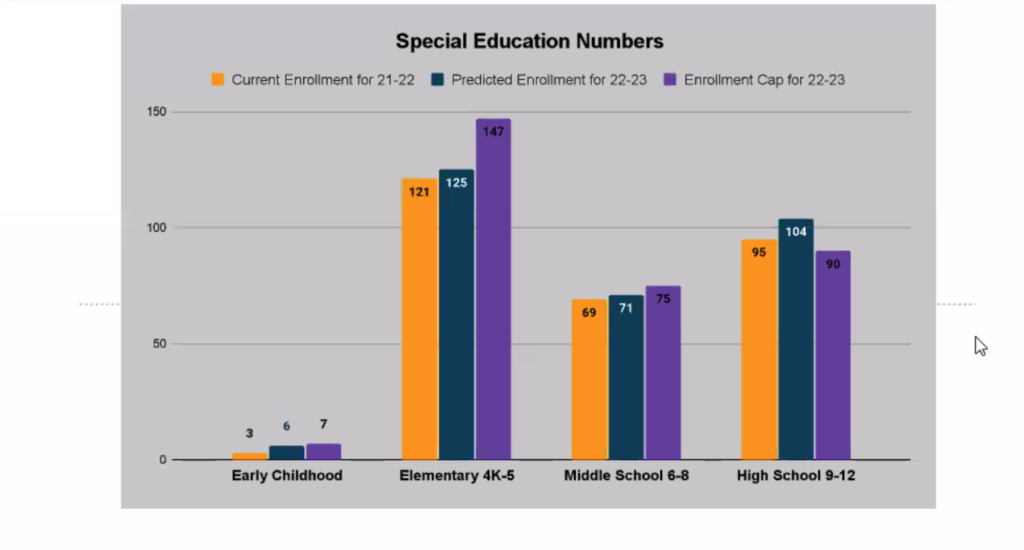
The above bar chart as presented by Whitewater Unified School District Director of Pupil Services Lanora Heim shows the number of students enrolled in special education by grade level within the district. The orange bars represent students currently enrolled. The blue bars represent students anticipated to enroll next school year. The purple bars represent the enrollment caps which were approved Monday for the 2022-23 school year.
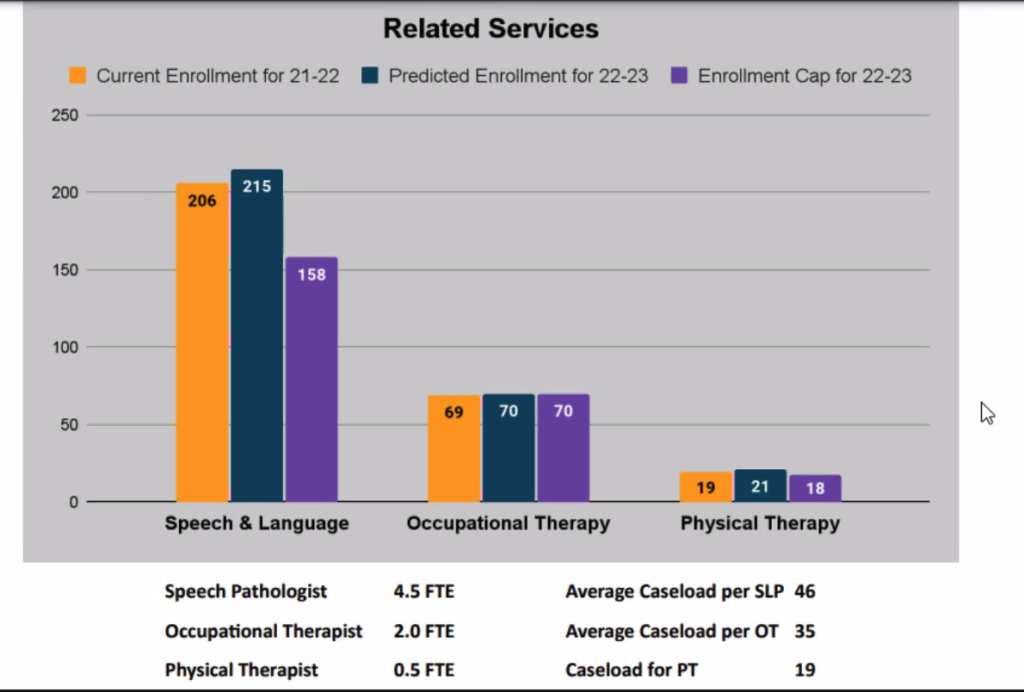
The above bar chart as presented by Whitewater Unified School District Director of Pupil Services Lanora Heim shows the number of students using related special education services, including speech and language, occupational therapy and physical therapy. The orange bars represent students currently enrolled. The blue bars represent students anticipated to enroll next school year and the purple bars represent the enrollment caps which were approved Monday for the 2022-23 school year. Information below the graph notes the number of employees the district has to perform each service and each individual’s associated average caseload.
Whitewater: School board approves new ELL staffing, multilingual program considered
(Originally published Jan. 29, 2022.)
By Kim McDarison
Members of the Whitewater Unified School District Board of Education Monday approved the hiring of a new English language learning program coordinator and a part-time instructor.
During Monday’s meeting, school district Superintendent Caroline Pate-Hefty presented a proposal to offer multilingual learning services to students who are native English speakers and those learning English as a second language.
“If we do this well, it could mean that we are graduating students to be multicultural, bilingual and bi-literate,” Pate-Hefty said.
After the presentation, the board approved the hiring of a coordinator for the new program, contingent upon the presentation of a job description, which is anticipated to be brought before the board during its next meeting.
The board also stipulated that the person filling the coordinator’s position must be qualified to teach English language learners in a classroom.
Additionally, the board learned that Lakeview Elementary School was served by one part-time paraprofessional who works with students learning English. With a recent addition of students at Lakeview, bringing the school into compliance with state statutes would require at least one full-time instructor for the building’s English language learning population, Pate-Hefty explained
The board approved the necessary hours to bring the school into compliance.
Enrollment and need
Aided by slides, Pate-Hefty shared a proposal to increase programming opportunities for students coming into the district in need of English speaking skills while helping them maintain their native language. The result, Pate-Hefty said, would be more multilingual students. Further, she said, the program could also be offered to native English speakers who, by opting into the program, could become multilingual by learning to speak a second language.
Pate-Hefty said her proposal was modeled after a program which enjoyed success in the district where she previously served.
Pointing to a slide presentation, titled: “Multilingual/English Language Learner Program Response to Student Needs,” Pate-Hefty said benefits multilingual learning students enrolled in the program could enjoy included: moving away from the concept that students should only learn English; subtracting the concept of taking away their ability to speak Spanish, and recognizing the benefits associated with speaking two languages.
The program would also allow all students to participate in multilingual opportunities and offer support to students learning languages earlier in their K-12 educational careers.
Pate-Hefty next shared a slide showing different brain scans. Information on the slide indicated that “brain imaging techniques, such as fMRIs, have shown that multilingual brains tend to activate the linguistic portion of their brains even when not engaged in linguistic tasks. This leads researchers to believe that the brain’s ability to connect skills tends to enhance cognitive function over time.”
The slide further indicated that “bilingual brains tend to show higher levels of activation to auditory stimuli overall.”
Among other statistics shared, according to Pate-Hefty, between 2010 and 2018, the number of U.S. job advertisements including the ability to speak Spanish as a desired skill increased by about 150%.
Citing U.S. Census Bureau statistics, she said, as of 2018, the number of residents in Wisconsin who speak a language other than English was reported at 483,952.
Also, she said, the American Council on the Teaching of Foreign Languages research cites five major research-based studies that show students who learn foreign languages perform better on standardized tests.
Within her presentation, Pate-Hefty defined several terms, including that of “newcomer,” which, she said, describes “foreign-born students who have recently arrived in the United States.”
Looking at districtwide data, Pate-Hefty noted that since Sept. 1, enrollment has increased by 51 students.
Pointing to a “December Snapshot,” she said, after sustaining a dip in enrollment in 2021, the district’s enrollment has rebounded to similar numbers as those recorded before the onset of the COVID-19 pandemic. A slide showed enrollment in 2019 at 1,946, and in 2020, at 1,988. In 2021, enrollment numbers decreased to 1,786. In 2022, Pate-Hefty said, referencing the latest data receive this week, numbers had risen to 1,937.
“We have more than recovered from our COVID loss, and we are only 87 students away from our highest enrollment ever, which was in 2011,” Pate-Hefty said.
Looking specifically at Lakeview Elementary School, Pate-Hefty said, as of Sept. 1, the school saw an increase of 15 students. The December Snapshot showed building enrollment at 201 students in 2019; 207 students in 2020; 164 students in 2021, and 179 students in 2022.
“So looking at Lakeview, when I took this data, we were at about 179 students,” Pate-Hefty said, adding that “now” the number is at about 186. “It should be noted that they are 28 students away from their highest enrollment ever,” she said.
Pate-Hefty noted that while it was often assumed within the district that Lakeview has small class sizes, that was not true in all classrooms in all grade levels.
Looking at overall elementary school class sizes, on average, by student, she said, “Lincoln has about 19.2, Washington about 19.1, and Lakeview, 17.5.”
When looking at class size, she said, at Lakeview, it was noteworthy that while it has the smallest average overall class size, it also has the least amount of resources, especially as they relate to students with disabilities and English language learners.
“They have a .5 paraprofessional that can speak Spanish … and our staffing is very different in the other buildings,” she said.
Similar data at Lincoln Elementary School indicated that the building had seen an increase in enrollment of one student since last September. Data was as follows: in 2019, the school had 376 students; in 2020, the school had 388 students; in 2021, the school had 353 students, and in 2022, the school has 375 students.
“They are 13 students from our highest enrollment just before 2020. Lincoln’s zone is our largest according to the last board-approved map that you can find. It does house a majority of move-in students,” Pate-Hefty said, adding that with regard to multilingual students, the building would require a “tremendous amount of support” to “continue doing what’s right for all kids.”
At Washington Elementary School, the December Snapshot reported enrollment of 340 students in 2019, 345 students in 2020, 300 in 2021, and 322 this year. The data noted that five new students had enrolled at the school since last September.
Most recent enrollment numbers showed that Washington is 23 students away from its highest enrollment ever, Pate-Hefty said.
Middle school data was reported as follows: from the December Snapshot: 408 students in 2019, 400 students in 2020, 349 students in 2021, and 436 students in 2022. Nine students have enrolled at the middle school since last September.
Looking at the high school, Pate-Hefty noted that in 2019, the school had an enrollment, according to the December Snapshot, of 584 students. In 2020, the number was 608. In 2021, 489 students were enrolled at the school, and in 2022, the number stands at 587. Since last September, 17 students have enrolled at the high school.
Pate-Hefty next produced a bar graph showing districtwide enrollment of English language (EL) learning students. She noted that 99 new EL students had joined the district as of Jan. 11.
The graph offered total enrollment numbers for EL students counted in both September and June, and a total of EL newcomers for each year. During the 2019-20 school year, a September count showed 254 EL students and a June count showed 236 students. Ten newcomers enrolled into the district that school year.
During the 2020-2021 school year, the September count showed an enrollment of 234 EL learners and a June count of 252 students. Twenty students enrolled as newcomers that year.
This year, 2021-2022, Pate-Hefty reported a September count of 290 EL students and a June count of 322, with 52 students identified as newcomers.
Pate-Hefty noted feedback about the district’s EL programming, offered by the Cooperative Educational Service Agency (CESA) 2, of which the Whitewater Unified School District is a part, which included the following recommendations: that the district create a standard operating procedure including an initial assessment for English language and multilingual learners, along with intake and placement procedures, and consider a model for EL and multilingual instruction, which Pate-Hefty said, would mean all kids becoming multilingual, noting that the district currently uses a “one size fits all” approach for EL instruction.
“So if you are a newcomer, or proficient in English or Spanish, we are treating them all the same way,” Pate-Hefty explained.
Pate-Hefty shared several models showing that multilingual students, who, after entering the district and participating in its current programming, lose their ability to speak their native language, with a drop in that proficiency occurring most dramatically between the elementary and middle school levels.
Staffing
According to Pate-Hefty, to create a program that would equitably address needs across the district for EL and ML learners, additional staffing would be required.
Sharing some district history, Pate-Hefty said: “Years back, Washington was approved for a grant that allows funding for one of several optional strategies. So when you are looking at your numbers, that’s called AGR or Achievement Gap Reduction. This is significant funding that we get over at Washington for this, and it allows us to support staffing needs and we are tremendously grateful for it, but it does only come to one school.”
Pate-Hefty noted that, along with AGR funding, comes research showing effective strategies the district can adopt.
“We can choose from several strategies,” she said, adding that a strategy in use at Washington is limiting class size.
Said Pate-Hefty: “So from K-3 we limit Washington’s enrollment to 18. This limitation … does put some pressure to move those students who start after the year in those grades into the other school buildings. Which is often, first Lincoln, because that’s the closest geographically, and then secondary to Lakeview.
“So when students move in, say, to Washington, and Lincoln becomes starting to get full, then we are moving students with language needs to Lakeview. This has been historically acceptable. Now, however, we have influx that I’m going to show you.
“It really is not equitable when we send students who don’t speak English specifically to Lakeview where … currently, the way it stands, they currently have a .5 paraprofessional. So we are sending potentially students with the greatest need to get the least amount of support.”
Aided by staffing charts, Pate-Hefty said EL staffing across the district includes two EL teachers and one paraprofessional at each of the district’s school buildings with the exception of Lakeview, which has one part-time paraprofessional.
The district also has an EL intervention teacher who shares time between Lincoln and Washington, and virtually with Lakeview, and a district Spanish liaison, who is funding through a stipend.
The EL intervention teacher is funded by stipend paid through the Elementary and Secondary School Emergency Relief (ESSER) fund, which was extended to schools as part of the CARES act passed in 2020, Pate-Hefty noted, adding that a teacher within the district is filling the role, working nights and on weekends to help meet social, emotional, and medical needs, among others.
English Language staff currently reports to the district’s director of pupil services.
Staffing for a new program, as proposed by Pate-Hefty and demonstrated in an employment flowchart, would include the addition of a coordinator or director of multilingual services, a full-time district hispanic liaison, two additional EL/ML teachers and additional hours added to the paraprofessional position at Lakeview, bringing it to full-time.
Changes depicted on the flowchart indicated that the coordinator would assume EL-related duties currently performed by the director of pupil services. Another priority would include the dedication of one full-time teacher to Lakeview, which, the chart noted, was required by state statute because the school is supporting at least 10 EL students.
Costs, identified as salary and benefits, associated with the proposed staffing changes are as follows: coordinator position: $100,000; hispanic liaison, $81,292; each of two EL teachers, $81,292 (total cost, $162,584), and part-time paraprofessional, $48,000.
Costs associated with curriculum and transportation needed to support the program were listed as “TBD” (to be determined)” by “collaborative work in the ML department.”
Also noted was the potential for funding through the Wisconsin Department of Public Instruction (DPI) using its enrollment-based Transfer of Services (TOS) mechanism. The district has identified $392,376 in program-related costs as applicable for funding through the TOS mechanism.
Funding
Sharing the presentation with Pate-Hefty, school district business manager Benjamin Prather talked about the TOS mechanism.
“This allows us to request an exemption to exceed the revenue limit based on an estimated cost. The estimated cost is tied directly to new students coming in,” Prather said.
Looking at some district history, he said during “our past revenue limit, we did request a transfer of services for $115,000 for new students that were here prior to the third Friday count.”
Since then, he said, more students have enrolled into the district and he is looking into requesting additional transfers.
Prather said that as he considered the next budget, he would be looking to build a transfer exemption to support the dual language program and to cover costs associated with students in need of additional EL services.
Prather said he had recently reached out to other area school district business managers and learned about the value of using the TOS provision.
Explaining the process, Prather said the revenue limit is tied to enrollment. With more students come more needs, he said, adding, that state statutes stipulate those costs fall on the taxpayers unless the district qualifies for additional aids.
Board member Larry Kachel asked about other possible funding sources including grants and federal aid.
Pate-Hefty said she would encourage program staff to seek grants.
“There is funding for charters in Wisconsin,” she said, adding “we need to be creative with it, but federal is not really provided.”
She reminded board members that the district has 55 students who likely qualify for TOS offsets that the district has not yet claimed.
Referencing a conversation with DPI, Prather said he understood that the 55 students would likely qualify, but there was an “untraditional” component to his understanding of the process.
Typically, he said, districts receive money from a district of origin when a student transfers from one district to another, and a similar process exists when a student transfers in from a district within another state. The students in question are from another country, he said. In his conversations with DPI, he understood they would still qualify because they would “pass Question 1.”
“I pressed DPI pretty hard on this to make sure we would be compliant … as long as these students would qualify as ELL or special ed students, it’s going to tick the boxes,” he said.
Looking at the full program staffing proposal, Kachel said: “So with benefits we are looking at half a million dollars, all funded by local taxpayers.”
Pate-Hefty responded, saying: “About $400,000 is where we estimated, not including curriculum and transportation.
“It would increase the levy,” she added.
A further consideration for the program was space, Pate-Hefty said.
“None of our buildings can currently house a K-5 multilingual program. We don’t have enough room. So it means that we have to make some shifts somewhere. If we want this program to provide access for all students … we don’t have a space for five grades in one place.
“We are just talking about some initial programing and staffing in this proposal that would get us to the place of making other decisions about: Where do we want to go? Where do we want to build this program? What does it look like for all families?” she said.
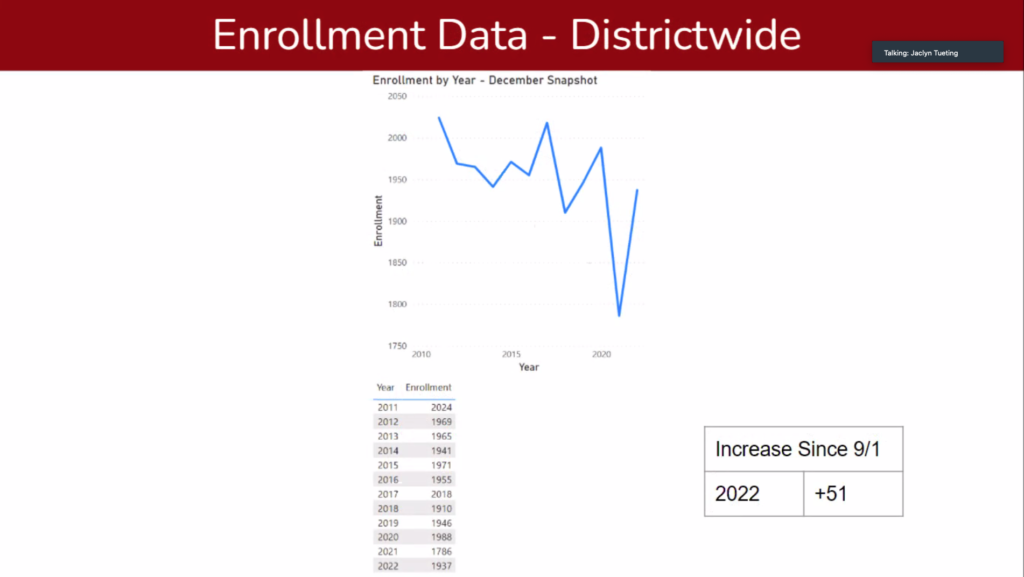
A graphic shared Monday with Whitewater school board members by Superintendent Caroline Pate-Hefty shows enrollment statistics for the district between 2011 and 2022

A bar graph shared with Whitewater school board members Monday by school Superintendent Caroline Pate-Hefty shows the number of English language learners enrolled in the district over the last three school years.

A flowchart shared with Whitewater school board members Monday by Superintendent Caroline Pate-Hefty shows current staffing within the district’s buildings to support English language learning students.
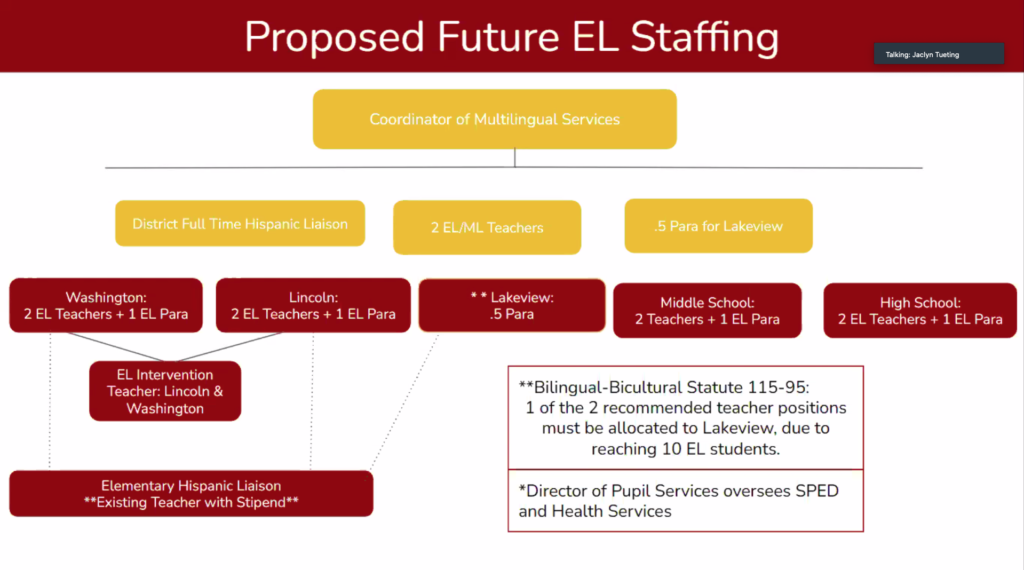
A flowchart shared with Whitewater school board members Monday by Superintendent Caroline Pate-Hefty shows proposed staffing within the district’s buildings to support a new multilingual learning program. The board approved the hiring of the coordinator’s position, with some contingencies, and added part-time hours to an instructional position at Lakeview Elementary School, bringing it to a full-time position.
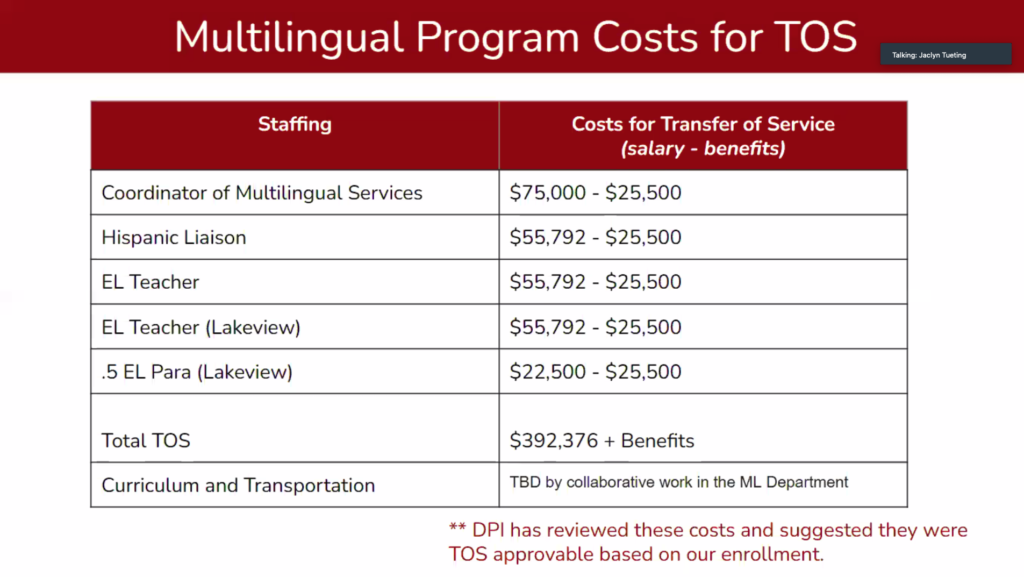
The above graphic shows costs associated with staffing a new multilingual program as proposed by Whitewater Unified School District Superintendent Caroline Pate-Hefty.
Whitewater: Lakes drawdown project moves to dredging phase
(Originally published Feb. 7, 2022.)
Dredging began last week on Whitewater’s Cravath and Trippe lakes as part of the lakes drawdown project, according to information released Monday by city officials to Fort Atkinson Online.
According to the release, after several weeks of preparation within the lake beds — which included a controlled burn, skinning snow and vegetation from the top of the ground, and laying wood matting — Stout Construction, the contractor hired by the city to perform the dredging, began removing spoils last Wednesday.
The controlled burn, the release continued, was performed to help stop the growth of vegetation in the areas where dredging will take place. The skinning of snow and vegetation cleared the ground to expose it to cold temperatures to help facilitate freezing of the ground; the areas to be dredged require 18 inches of frozen ground to allow excavating equipment to drive on it and remove materials, the release noted.
Due to recent warmer-than-expected temperatures, some areas earmarked for dredging had not received “enough frost to begin the process,” the release stated. Wood matting was placed in many locations that did not freeze to allow dredging equipment access into the areas without sinking.
According to the release, work schedules were adjusted as crews prepared to dredge and will continue to be adjusted throughout the dredging process, allowing crews and equipment to access frozen lake beds when the sun is not increasing temperatures and warming the frozen ground. Crews have been most active when skies are cloudy and in the early morning hours. This process will continue in the upcoming weeks.
Crews spent 20 hours dredging Trippe Lake and 10 hours dredging Cravath Lake this past weekend, taking advantage of colder temperatures, the release read.
Evening dredging is anticipated to resume Wednesday, Feb. 9, according to the release.
To learn more about the city’s lakes drawdown project and receive weekly updates, visit https://www.whitewater-wi.gov/520/Lakes-Drawdown-Updates or contact Whitewater Parks and Recreation Director Eric Boettcher by phone: 262-473-0122, or email: EBoettcher@whitewater-wi.gov.
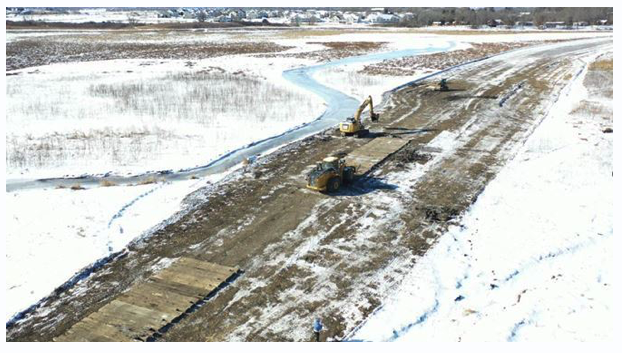
A view from above as wood “mats” are placed in the Cravath and Trippe lake beds. The matting is required to help keep a solid base upon which crews and equipment can move. A process to begin dredging the lake beds began last week, according to Whitewater city officials. Contributed photo.
City, Whitewater Fire Department, Inc., take step closer toward merging
(Originally published Feb. 17, 2022.)
The Whitewater Fire Department Inc. and the City of Whitewater have entered into negotiations to bring the fire department in house.
The move is anticipated to provide better services to residents within the city and surrounding towns, according to information released Thursday by city officials.
According to the release, at the end of 2021, discussions began, revolving around staffing concerns and a desire to better serve the community and its surrounding areas.
By January of 2022, members of the Whitewater Fire Department, Inc., which operates as an independent nonprofit organization, gave permission to the organization’s board of directors to move forward in creating a relationship with the City of Whitewater.
“This includes creating a Memorandum of Understanding (MOU), which is currently in process,” the release stated.
City officials and the department are planning a multi-phased approach to facilitate a smooth transition, the release noted. The first phase will involve transferring Emergency Medical Services (EMS), which include operations, staffing and physical assets, such as equipment.
Additionally, according to the release, the fire department will plan to keep its established 501c3 status, allowing the organization to continue to accept donations for additional equipment in the future.
The merging of the two entities is intended to address emergency staffing needs by providing comparable salaries as other fire departments as well as offering benefits to staff, the release continued.
“This merge is for the citizens. We need to provide the best service we can to our community and the surrounding townships,” Whitewater Fire Department, Inc. Board of Directors President and Fire Capt. Christ Christon was quoted as saying in the release.
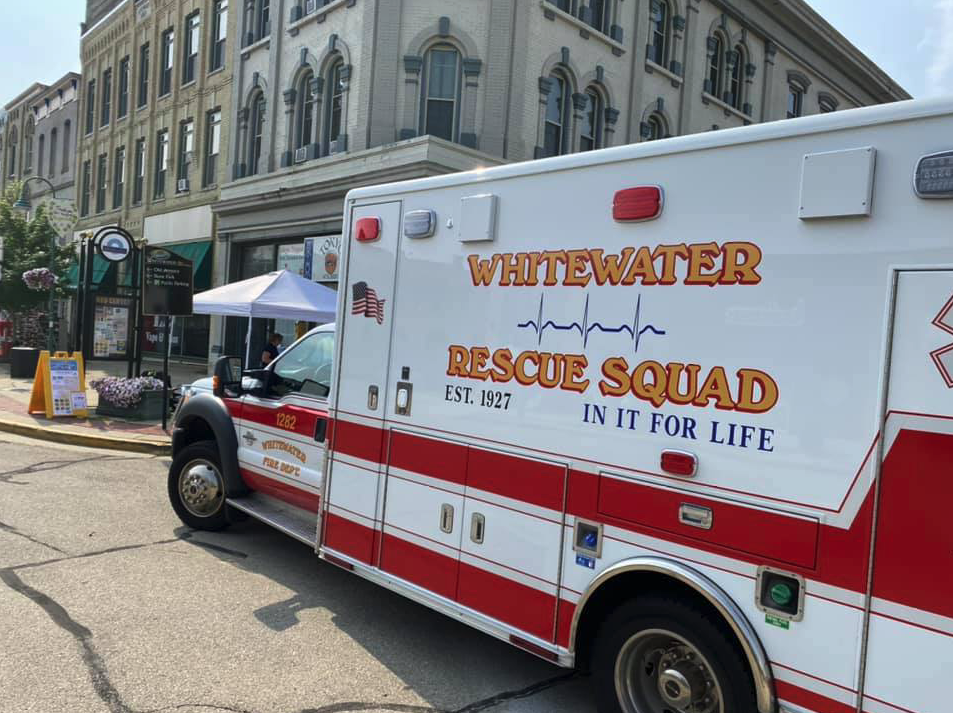
Photo courtesy of the Whitewater Fire Department as shared on its Facebook page.
Whitewater police release Community Notification of Sex Offender
(Originally published March 2, 2022.)
The Whitewater Police Department has released the following information pursuant to Wisconsin Statute 301.46 (Act 440), which authorizes law enforcement agencies to inform the public of a sex offender’s release when that information will enhance public safety and awareness, information released by the department Wednesday states.
According to the release, Craig A. Voegeli Jr., 37, was previously convicted of 943.10(2)(e) burglary, 940.225(3) attempted third-degree sexual assault, 946.49(1)(B) felony bail jumping, 947.01(1) disorderly conduct, 944.20(1)(B) and lewd, lascivious behavior – exposure.
The release continued: Voegeli is scheduled to be released from prison on March 8, and will be residing at 720 W. Walworth Ave. Whitewater. As part of Voegeli’s supervision with the Department of Corrections, he will be subject to 24-hour electronic monitoring. Voegeli is restricted from being on the University of Wisconsin-Whitewater campus. Additionally, Voegeli’s rules of supervision include no unsupervised contact with minors and no consumption of alcohol or use of illegal drugs.
Citizen abuse of this information to threaten, intimidate, or harass registered sex offenders will not be tolerated. Further, such abuse could subject those who commit such acts to criminal penalties, and potentially end law enforcement’s ability to do community notification.
Additionally, the release states: “If you have information regarding current criminal activity of this individual, or any other offender, please contact the Whitewater Police Department at 262-473-0555. Additional information is available at the Wisconsin Department of Corrections Sex Offender Registry Web site located at http://offender.doc.state.wi.us/public/.
“The information has been released and authorized by a core team made up of representatives from local law enforcement, the District Attorney’s Office, and the Department of Corrections. The core team evaluates and makes decisions on the level of notification to the community for the pending release of sex offenders under Wisconsin Statute 301.46 (Act 440).
“Community notification furthers the interest of public safety and it is our belief that a better-informed public is a safer public. The intent is to provide citizens with knowledge and to minimize the cloak of secrecy for the offender; both of which are necessary to stop continued criminal behavior. This notification is not intended to increase fear in the community, but rather to increase awareness. This offender is not wanted by the police at this time and has served the sentence imposed on him by the court.”

Craig A. Voegeli Jr.
Whitewater: Trippe, Cravath lakes dredging project winding down, update reports
(Originally published March 3, 2022.)
By Kim McDarison
Dredging activity in Whitewater’s Trippe and Cravath lakes is winding down, according to information shared Tuesday during the city’s common council meeting.
An update about the city’s lakes dredging project was shared with council as part of the city manager’s report.
During his report, City Manager Cameron Clapper said that the total number of cubic yards removed during the dredging process was less than initially planned. The process removed some 68,000 cubic yards of spoils from the two lake beds. Original estimates were closer to 81,000 cubic yards, he said.
“It’s actually a significant positive above what we anticipated when weather started warming up,” Clapper said.
Aided by slides, City of Whitewater Parks and Recreation Director Eric Boettcher also provided information about the dredging project.
He described spoils collecting at the DNR-approved disposal site near the Whitewater University Innovation Center, 1221 Innovation Dr., as “a lot of dirt.”
Sharing slides denoting areas for dredging, Boettcher made comparisons between areas originally planned for dredging and areas that had, as of March 1, been dredged.
In Cravath, Boettcher said, “We dredged pretty much what we had planned on for the navigation channel. Instead of wasting time and effort dredging the contaminated area, we skipped that, because they had actual stream cut through that area. So that naturally connected our area. And there’s a couple of reasons we did this. One, we were able to dredge more areas in front of the park, as we are running out of cold weather, and also that way we don’t have to worry about where we deposit that material. Since we haven’t had to deal with a contaminant issue, we can just deposit it all in the same spot, so we don’t have to worry about that.”
In Trippe, Boettcher said: “We were able to do the navigation channel all the way up to pretty much where the boat launch is. Unfortunately, the weather has gotten too warm and we are not able to dredge much around the Trippe Lake park area. Again, it got too wet and it’s too sloppy to be able to dredge that area at this time.”
Pointing to a photo, which he said, was taken early last week, Boettcher noted: “This kind of shows the whole navigation channel. You can kind of see how wide it is, and this is where they kind of dredged from the middle, then worked their way towards the south end of the lake, and once they got to the south end, they dug. And this is kind of where they were going to connect to the existing stream.”
Looking at costs, Boettcher said that the project was currently under budget, adding that, thus far, dredging expenses were approximately $1,046,000, which, he said, was under the budgeted $1.375 million the city had set aside for the project.
“We still have some additional funds to look at using. One of the things we looked at is maybe doing a little bit of hydraulic dredging in those areas around the lake that we can’t get to at this point, but, overall, we’re pretty happy with the weather that we had and what we were able to accomplish,” Boettcher said.
Clapper asked Boettcher to share with council information about ongoing activities involving dredging along some of the lakebed shoreline, citing the activity as private dredging projects on private property.
Boettcher said the activity had been approved by the Wisconsin Department of Natural Resources (DNR), which, he noted, had worked to aid residents with the permitting process to allow private dredging projects to move forward while the weather was still cold.
Said Boettcher: “There were residents along the lake that have their own dredging projects, and, at the beginning of this, we were always told that you can’t do a blanket permit, or have them attached to our permit. While with the whole dredging project, overall, the DNR was allowing those that did put their permits in in January to tag onto our permit, in order to save time, because usually it’s a 90-day process.
“So that way, residents who had already started their permitting process were able to get their permits a little earlier so that they could still do their dredging while it’s still cold. I know it’s not cold enough for the bigger equipment, but a lot of the shoreline is still able to be dredged. That dredging is going to be taking place; they were able to get their dredging permit this week … so they are going forward with their projects.
“So that adds to our permit — so it falls under our permit — which means they have to use our dredging (spoils deposit) sites, but we have plenty of room out at the Innovation Center to accommodate that. We are looking at an additional 4,000 cubic yards total between all the potential dredgings that will come forward from those residents that are doing their own dredging project.”
Clapper said council would receive its next update on the lakes dredging project at its next meeting, scheduled for March 15.
During that update, Clapper said, he anticipated sharing with council “more details about where we ended and mobilization of all of the equipment, and the contractor moving out of the space.”
An earlier story about the scope of dredging to be performed within Trippe and Cravath lakes and related costs is here: https://fortatkinsononline.com/whitewater-city-rejects-trippe-cravath-dredging-bids-explores-new-bids-scope/.
An earlier story, including project history, is here: https://fortatkinsononline.com/whitewater-city-authorizes-pursuit-of-dredging-contract-with-a-1-kowalski/.

A slide, labeled “Original Dredge Plan” is shared Tuesday with members of the Whitewater Common Council as part of an update about the Trippe and Cravath lakes dredging project.

A slide, labeled “Trippe Dredging Area” shows area dredged within Trippe Lake, according to information shared with members of the Whitewater Common Council Tuesday.

A slide, labeled “Cravath Dredging Area” shows area dredged within Cravath Lake, according to information shared with members of the Whitewater Common Council Tuesday.

A photo, shared as part of an update on dredging within the Trippe and Cravath lakebed, shows a navigational channel created in Trippe Lake, City of Whitewater Parks and Recreation Director Eric Boettcher told members of the Whitewater Common Council Tuesday.
Thompson to speak at ‘farewell celebration’ at UW-Whitewater
(Originally published March 3, 2022.)
By Kim McDarison
Outgoing interim UW System President Tommy Thompson will be visiting the University of Wisconsin-Whitewater campus next week to celebrate his accomplishments as interim system president, according to information released by the university.
The celebration, which is open to the public, will be held Monday, March 7, at 3:30 p.m., in the Hamilton Room in the James R. Connor University Center, located on campus, 190 Hamilton Green Way.
Complimentary parking is available in lots 12 and 14.
The event will include networking, a program, and refreshments, according to the release.
As reported earlier this year, Thompson announced he would be stepping down as UW System interim president in January.
His resignation is set to take effect Friday, March 18.
Thompson was sworn in as interim president of the system in July of 2020.
In his resignation letter, Thompson wrote: “While challenging on many fronts, we worked together to continue to provide the quality of education our students deserve and parents expect. We not only performed but prevailed in our fight against COVID’s deleterious impact on our universities and our communities — and in doing so we made our campuses some of the safest places in Wisconsin.”
In mid-January, a Special Regent Committee for the University of Wisconsin System Presidential Search announced that it had identified two finalists, one of which was Jay O Rothman, CEO of the Milwaukee-based law firm of Foley and Lardner LLP.
By month’s end, Rothman was appointed by the UW System Board of Regents as Thompson’s successor.
An earlier story about Thompson’s resignation is here: https://fortatkinsononline.com/thompson-tenders-letter-of-resignation-to-uw-board-of-regents/.
An earlier story about the search for Thompson’s successor is here: https://fortatkinsononline.com/regent-committee-announces-finalists-for-uw-system-president/.
A statement, congratulating Rothman on his appointment as system president from UW-Whitewater interim Chancellor Jim Henderson is here: https://fortatkinsononline.com/uw-w-chancellor-congratulates-rothman-as-uw-system-president/.

Tommy Thompson

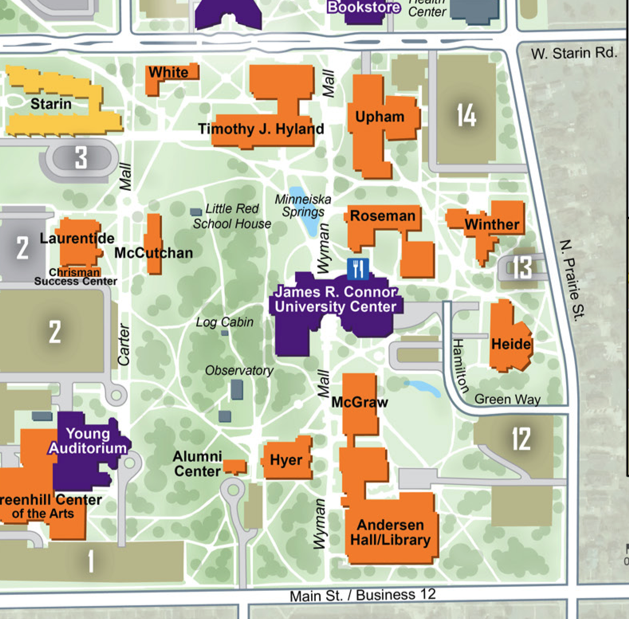
Two graphics above: at top, a map shows the University of Wisconsin-Whitewater campus. Above, a map offers a closer look at the location of the James R. Conner University Center and parking lots 12 and 14.
Whitewater Common Council considers referendum to fund EMS
(Originally published March 3, 2022.)
By Kim McDarison
The Whitewater Common Council Tuesday discussed bringing a referendum before voters to fund, in part, an increase in emergency medical services (EMS) staffing.
If approved by council, a referendum question would likely appear on the ballot in November, Whitewater City Manager Cameron Clapper said.
Details about proposed upgrades to the city’s EMS, changes within the city’s fire department, and plans to fit the two divisions together, as well as details about the overall cost of the proposals and from where funding might come were still in the development stages, and would come before council as the steps developed, Clapper said.
During the meeting, council members received a presentation given by Whitewater EMS Chief Ashley Vickers and Dr. Steven Andrews, an EMS physician with Aurora medical centers. Andrews was introduced to council by Clapper as Whitewater’s medical director for EMS. Responding to questions, Andrews said, along with Whitewater, he serves 17 other EMS departments in a similar capacity.
Aided by slides, Vickers shared some EMS statistics and a proposal to increase staffing within the city’s EMS division by hiring five full-time paramedics.
EMS staffing and call volume
Vickers began the presentation by sharing information about the staffing and operations of the city’s EMS division.
The EMS membership responds to 911 calls for service, in full or in part, within the city of Whitewater and towns of Whitewater, Cold Spring, Richmond, Lima and Koshkonong, Vickers said.
The EMS department has 40 members, six of whom are paid on call and respond from home. The remaining 34 are paid on premise and respond from the station, she noted.
At its current staffing level, Vickers said, the EMS division has two full-time Advanced Emergency Medical Technicians (AEMTs) and three full-time Emergency Medical Technicians (EMTs), whom, she said, are scheduled during daytime hours, Monday through Friday.
Additionally, the department has five paramedics, 17 AEMTs and 16 EMTs.
Looking at call volume, Vickers said, in 2021, the EMS division received 1,620 calls for ambulance service. Of those calls, 272 were “second calls,” meaning a first ambulance and its crew were already on a call when those calls came in. Additionally, the division received 22 “third calls” and one “fourth call.”
In 2022, Vickers said, the division has received 147 total calls, with 28 of those resulting in a need for a second ambulance, eight calls resulting in a need for a third ambulance and two resulting in a need for a fourth ambulance.
In response to those calls, mutual aid was requested twice, with both of those requests coming in response to a second call for ambulance service, she said.
The average response time in 2022 has been 3.66 minutes, Vickers reported.
In Whitewater, she said, the division’s first ambulance is staffed with an AEMT and an EMT. Two full-time EMTs work Monday through Friday, from 6 a.m. to 6 p.m.
A second ambulance is staffed with two EMTs with an emphasis placed on those crew members who have both EMT and firefighting skills. The crew is cross-staffed for both the ambulance and an engine, according to a slide shared by Vickers.
EMS members, with the exception of two paid-on-premise AEMTs, work monthly 12-hour mandatory shifts which are scheduled by the assistant chief of the EMS Division. The shifts cover Fridays at 8 p.m. to Sundays at 8 p.m., information on a slide indicated.
The current EMS hourly pay structure is as follows: AEMT, full-time, paid on premise, $22; flex AEMT, paid on premise, $19; EMT, full-time, paid on premise, $18; AEMT, paid on call (respond from home), $17; second ambulance, firefighter/EMT, $13; EMT, paid on call, $14; EMT, paid on premise, $16; second ambulance, EMT, $12, and trainee, $7.25.
Proposed paramedic upgrade
Under the heading of “Proposed Paramedic Upgrade,” Vickers outlined the following: the department would continue to staff the first and second responding ambulances with two EMTs or AEMTs, or a two-man crew with members at each of those training levels.
In addition to the department’s existing membership, the department would hire five full-time paramedics at a starting hourly wage of $25, and the new hires would receive benefits.
When responding to calls, paramedics would respond in a “chase vehicle” to all first calls and perform an advanced life support (ALS) level assessment, which would determine if that level of care was needed for the safe transport of the patient. If an ALS level was required, the paramedics would make the transport. If not, the paramedics would return to the station to receive incoming calls and two EMTs would transport the patient as a basic life support (BLS) level call.
Sharing a slide titled: “Previously approved plan,” Vickers noted, “This plan is the same as previously approved, but at the paramedic level instead of the AEMT level.”
The plan, a council member noted in a followup comment on Friday, was previously approved by the Whitewater Fire Department, Inc., Board of Directors.
Within the presentation, Vickers cited high call volume and high acuity calls (defined as calls meeting trauma triage criteria for treatment or receiving treatment for acute conditions such as coronary syndrome, respiratory distress, altered mental status, acute stroke, allergic reaction or abnormal vital signs) as reasons for a need for a paramedic-level quality of care in Whitewater.
Wait times for paramedics to respond from other jurisdictions such as Jefferson or Janesville cost valuable time, Vickers said, noting that in the field of EMS, an expression used is “time is tissue,” meaning life depends on a quick response.
Comparing the differences between AEMT and paramedic-level skills, Vickers said, among procedures a paramedic can perform that an AEMT cannot, are: advanced airway interventions; electrical interventions for cardiac arrhythmias, and administering medications used to stop seizures, control heart rhythms, control blood pressure, pain, and stop nausea and vomiting.
Further, a slide stated: “paramedics have also been shown to have a relative reduction in mortality compared to the current AEMT level of service in several different conditions,” including, reducing death from heart attacks by 47%, reducing death from all causes of chest pain by 45%, and reducing death from respiratory distress by 13%.
Vickers next shared wages as paid to paramedics serving in area departments including the Jefferson Fire Department, where paramedics receive hourly wages between $24 and $26, and the Edgerton Fire Department, where paramedics receive hourly wages of approximately $24.
Costs
Looking at budgets and costs, Vickers said in 2021, the budget anticipated to cover the cost of EMS staffing in Whitewater was set at $296,838. The actual amount spent was $287,191.
A slide shared by Vickers showed a previously approved AEMT-level staffing budget of $641,680, which, the slide indicated, was an increase of $344,842 over the budgeted amount in 2021.
Sharing a slide with costs associated with the proposed paramedic upgrade, Vickers said the staffing provision would require a budget of $801,528, which would bring an increase of $504,690 as compared with dollars budgeted for EMS staffing in 2021.
As part of the presentation, a slide shared increased ambulance rates for 2022, noting that the increased rates could bring an “increase in revenue for 2022 by approximately $118,000 at the AEMT level,” and an “increase in revenue at the paramedic level (that) would equate to approximately an additional $100,000 annually.”
‘How do we pay for this?’
After the presentation, Clapper opened discussion with a question. He asked: “How do we pay for this?”
He noted that the EMS proposal was driven by “a need to catch up our emergency medical service to what our community actually is in need of and what many of our community members already think they are getting.”
To achieve that goal, Clapper said, council had two options.
“One is we don’t change anything about our tax levy and as a result we make dramatic changes and shifts to every other service that we provide to accommodate changes with EMS.”
Or, he said, “We pursue a referendum and address the funding gap by way of that referendum in November.”
Earlier Tuesday, Clapper said, city staff held a meeting to become familiar with scheduling requirements associated with bringing a referendum forward.
In terms of funding options, he said, “right now, it’s magic money … that’s a joke; I don’t know if it’s funny or not.”
He said city staff was looking at fund balances to see how they might be applied.
A council member asked if the city’s demographics were contributing to elevated call volumes.
Vickers responded, saying: “I would say a good majority of our calls is a geriatric population … We do visit the assisted living facilities, the nursing homes, we go to those quite a bit. We do also tend to frequent the lower income housing and the group homes as well.”
Looking at possible strategies to reduce call volume, Clapper said: “I can tell you that I do believe that there are ways for us, in some ordinances and other means, to assist in shifting the burden to the actual care facility rather than allowing them or letting them take advantage of our EMS program, our fire department’s EMTs. Some of that’s been done, but I think there’s probably more things we can do; I just haven’t explored it yet.”
Said Vickers: “We’ve implemented some things internally, such as … when we see frequent fliers for routine things, especially like lift assists, you know, somebody that’s not injured, but they just need assistance up. So we give them one freebie, but if they call us multiple times within a certain time period, we start billing them.”
Vickers added: “Working with the Walworth County crisis worker has helped tremendously with some of the frequent fliers that we’ve had. Especially with mental health concerns or substance issues, so that has been a big help for us.”
Returning to the question of options and the EMS paramedic upgrade, Clapper said: “So tonight, the council has a few options. I think one important one is making sure you all have heard about it and became aware of it. The fire department board of directors has approved moving forward with it subject to any actions taken by the council. We could act tonight to say, ‘yeah, let’s do it,’ or you could act tonight to say, ‘let’s get all the kinks worked out so we can pull the trigger on it right after the referendum,’ or anything in between there.”
In an ideal set of circumstances, Clapper said, “I think … we say, yes, and then we get started on moving forward, but I do have to caution … we’ve committed to the fire department that we are supportive of their plan, and we acknowledge the need to staff,” but, he added, “The budget that was approved recognizes funding at a level that is now obsolete, with the understanding that we would need to do a referendum or significantly change other services by year end 2022.”
Looking ahead, Clapper said, next steps would include informing the public and “identifying the parameters of the whole,” asking: “What does that egg look like? How big is it? And then being able to take time and go through all the details of what comprises that egg, and then getting that information out into the community early in this summer most likely.”
Referencing numbers presented by Vickers, Whitewater Finance and Administrative Services Director Steve Hatton said: “I’ve received this for the first time today, so I need to work with Ashley go through it. This is the EMS piece of it, for the ambulance, but to put that into the entire fire and EMS budget and compare where we budgeted and approved for ’22 versus what this would entail and the full picture, that work needs to be done.”
“My guess is this body would be very favorable towards having paramedics. It’s a matter of paying for it. Also, I would suspect it’s a matter of how feasible it is to even hire them — paramedics — in this area. I really wonder if ultimately you might end up finding that we might need to grow some paramedics from within our own existing staff,” Council President Lynn Binnie said.
Addressing questions about a timeline, Vickers said: “It’s going to take some time to not only outfit our current ambulances to the paramedic level, but also acquire all the medications, supplies, and then submitting the operational plan to the state, which, the state is not very quick on turn-around times, so, I mean, realistically, if we said tomorrow that we can go ahead with it, it would probably be summer before we’d even have it operational.”


Two graphics above as supplied by Whitewater EMS Chief Ashley Vickers shows budgeted costs associated with EMS in 2021, as well as budgeted amounts associated with an approved proposal to increase staff with full-time AEMTs and upgrading to increasing staff with full-time paramedics. The proposal to increase staff with AEMTs was approved by the Whitewater Fire Department, Inc., Board of Directors.

Whitewater EMS Chief Ashley Vickers, from left, and Dr. Steven Andrews, an EMS physician with Aurora medical centers who serves as Whitewater’s medical director for EMS, address the Whitewater Common Council Tuesday. The EMS professionals shared with council a proposal to increase the Whitewater EMS division staff by five full-time paramedics.
Update: This story has been updated to include comments shared Friday by a council member indicating that the EMT plan presented Tuesday as “previously approved” was approved by the Whitewater Fire Department Inc., Board of Directors.
Whitewater voters guide: school board candidates share experience, views
(Originally published March 8, 2022.)
Compiled by Kim McDarison
A spring general election will be held April 5. Residents residing within the Whitewater Unified School District will find four candidates vying for two open Board of Education seats on the general election ballot.
They are incumbents Jen Kienbaum and Joe Kromholz — who, after an election held by the board last December, was appointed to fill the remaining term held by the late and then-sitting board member Jim Stewart — and two returning challengers: Miguel Aranda — who is a former board member after he, too, was appointed to complete a term following the resignation of Jean Linos in 2019 — and Andrea Svec, who, having lost a coin toss after tying with Kromholz in the election held by the board to fill Stewart’s seat, is making a second run for a full term: In 2021, Svec made a bid for a school board seat, but left the race, citing “unforeseen circumstances,” while pledging to run in 2022.
Board members are elected to three-year terms.
Fort Atkinson Online recently asked each of the candidates to provide some biographical information and fill out a short questionnaire. Candidates were asked to respond to four questions using a combined total of between 700 and 1,000 words.
Candidates were asked to submit a photo for publication.
The electorate also will have an opportunity to see these candidates respond to questions during a candidates forum which will be held Saturday, March 12, from 10 to 11:30 a.m., in the council chambers of the Whitewater Municipal Building, 312 W. Whitewater St., Whitewater. The forum is sponsored by the League of Women Voters-Whitewater Area.
The forum also will be live-streamed and recorded by Whitewater Community TV and uploaded to its Vimeo website, as well as rebroadcast on channel 990.
Additionally, the forum will be available on the league’s website: https://my.lwv.org/wisconsin/whitewater-area.
Candidates’ responses to Fort Atkinson Online’s questionnaires, presented in alphabetical order, follow.

Miguel Aranda
Age: 31
Address: 243 N Park St, Whitewater
Occupation: Administrative Assistant III (Level 3) for the Associate Vice Chancellor of the Office of Equity, Diversity, Inclusion and Support Programs. The Associate Vice Chancellor reports to the University Chancellor.
Number of years resided in district: 30 years
Education: Whitewater High School, UW-Whitewater BBA International Business with an Economics Minor, and UW-Whitewater MBA by May 2022
Civic and other organizational memberships: League of Women Voters, City of Whitewater Community Involvement Commission Member, City of Whitewater Community Development Board Member, Voto Latino Wisconsin Coordinator
Political experience: Appointed to Whitewater Unified School District from September 2019 to April 2020. International diplomatic relationship with the Mexican Consulate of Milwaukee.
What are your reasons for seeking this position?
I have always been satisfied with being a community organizer and staying civically engaged. Public office has never been a goal. After multiple sources of encouragement, I applied for the Whitewater Unified School Board position in September 2019. Once I received more insight about the district as a board member, I knew I had to return, or at least continue supporting the district where possible.
What are the most pressing issues facing the position you seek?
An aging population in Wisconsin, increasing income inequality, decreasing domestic population growth, and a lack of support and funding for public education from some of our State representatives. Trends affecting communities beyond the Whitewater community. This is only a few of the factors leading to a reduction of revenue for many Wisconsin public school districts.
If elected, what unique perspective and experience do you bring to the board?
My experience will come from a Latino male of Mexican immigrants perspective. I attended the Whitewater Unified School District, with my first language being Spanish and learning English as a second language. With a large portion of my extended family living in Whitewater, we represent a variety of cohorts of the Whitewater community. My viewpoint for the Whitewater community has always been a holistic one. My hope is to connect with those of similar experiences, from immigrant to Millennial parents.
Any additional comments?
Since 2009, I have been involved in social justice initiatives, particularly related to the Latino experience. In 2011, I was named a “People Who Matter” by the Janesville Gazette for leading and coordinating a volunteer group of other Latino University students. We outreached to surrounding school districts, including Fort Atkinson, to talk about the importance of higher education and to offer a guide of possible next steps after high school. These sessions were catered for high school students and included parent involvement; the sessions were offered in English and in Spanish. In 2012, I founded a University student organization to support students known as DREAMers. In 2018, it was a great honor to have received the League of Women Voters of Whitewater Area’s Making Democracy Work Award for engaging the local Latino community in regards to voter information and advocacy.

Jennifer Kienbaum
Age: 42 years old
Address: 272 Parkside Drive
Occupation: Compliance Manager
Education: Bachelor of Business Administration in Finance
Number of years resided in the district: 23 years in Whitewater
Civic and other organizational memberships:
• Boy Scouts of America
• American Legion Auxiliary
• Parent Teacher Association (PTA)
Political experience:
• Member, Whitewater Unified School Board, 2019 to current
• Treasurer, Rock Prairie Montessori School Board of Trustees, 2011-2017
What are your reasons for seeking this position?
I am currently one of the seven members of the Whitewater Unified School Board. I have served on the school board since April 2019, and I have decided to run for another three-year term based on a variety of reasons. First, as a mother of four children (ages 13, 12, 9 and 7), it is important for the school board to have representation from parents who have a personal interest in improving the quality of our school district. Second, I believe in quality public education that ensures the success of all students. Third, serving on the Whitewater School Board allows me the opportunity to share my experiences and skills to benefit this community.
What are the most pressing issues facing the position you seek?
Over the next several years, key areas of focus for this district include ensuring that all needs related to Special Education and English Language Learners are met, building a top notch vocational and technical education program that allows our students to graduate in a competitive career ready environment, addressing our aging buildings, all while operating a fiscally responsible budget.
In addition, student success requires support for not only their academic needs, but also their social and emotional needs. As a district, we need to do everything that we can to keep our students and educators safe and healthy so that they can stay in person, in school, where they can be most effective. With the pandemic widening an already concerning gap in student achievement it is imperative that we identify each student’s educational and emotional needs in order to provide a roadmap for success.
If elected, what unique perspective and experience do you bring to the board?
Prior to serving the Whitewater School District, I was on the Board of Trustees for two three-year terms for Rock Prairie Montessori School. I have also worked with many boards in my professional career. While the objective of each board has been different, they all require someone who can create stronger ties between the board and the stakeholders. One of the most important roles as a Whitewater School Board member is to serve as the voice of the community, something that I take seriously.
If elected, I will continue to focus on student achievement and implementing policies that will ensure success for all students. I will continue to listen to the concerns of this community, be responsive, serve as a voice for all, demand transparency, encourage data-driven decision making, and help problem solve to facilitate setting measurable goals and action plans.

Joseph Kromholz
Age: 60
Address: 393 Eagle Court
Occupation: Attorney, Partner at Ryan Kromholz and Manion, S.C.
Number of years resided in district: 19 years
Education: I received my undergraduate degree in chemistry from Carroll College and my law degree from Marquette University.
Civic and other organizational memberships: I am a member of the Whitewater Unified School District School Board (finishing Jim Stewart’s term). I am a member of the State Bar of Wisconsin, the Wisconsin Intellectual Property Law Association, the State Bar Section on Intellectual Property Law Association, and I am admitted to practice in all federal courts in Wisconsin as well as before the 4th and 7th Circuit Courts of Appeal and the Court of Appeals for the Federal Circuit. I provide pro-bono legal assistance in the Eastern District of Wisconsin. I am a registered Patent Attorney.
Political experience: None
What are your reasons for seeking this position?
I believe in a strong public school education, and I believe that our community needs to rally behind and support our parents, our teachers, and staff to make our schools exemplary places for all children to receive an education. To achieve this we must ensure that all kids have access to school and be in school. We need to work together.
I believe that Whitewater Schools are great for our children. My wife Marjorie Stoneman grew up in Whitewater and we moved here in 2003 to raise our son, David, who attended public school in Whitewater. Our son clearly benefited from talented, caring teachers and opportunities in this school district. Although he has now graduated, I want to continue to be involved in the board because I want to continue supporting the district. A strong school district benefits everyone.
What are the most pressing issues facing the position you seek?
I believe that we need to adequately fund our schools. The state of Wisconsin is now expected to end its budget cycle in June 2023 with a surplus of $3.8 billion in its main bank account. Real school funding has not meaningfully increased since 2011. During that time school districts have repeatedly had to go to referendums to cover the costs of operations. It is time to effectively support our state education system and the children and families that rely on that system. We need to end the cycle of having to go to referendum. We need to actively educate the state Legislature to use this surplus to ensure adequate funding of our schools so that this referendum cycle can end. I want to be part of this effort to bring more funding to our schools.
I believe that all children deserve a strong education. I want to ensure that all children, regardless of abilities or languages, have the opportunity to succeed in a caring, learning environment. All children need to be given the opportunities to succeed. For some this may be to go to college and for others this may be to go to work in industry. Local and national industries need qualified, skilled people. For too long we have underfunded technical education in our school system and we have fallen behind in the types of training and education that other districts offer.
We also have a unique opportunity to pursue a dual language program. Almost 50% of our students do not speak English as their primary language and the majority of those students speak Spanish as their primary language. If we were to teach all of our students to speak both English and Spanish we would enable them to communicate with roughly 80% of the people in the world and make them very desirable persons for the business community to employ.
If elected, what unique perspective and experience do you bring to the board?
I believe that school board members must be able to work together to make changes. As a partner at the law firm, Ryan Kromholz and Manion, I have had the opportunity to lead staff, engage in challenging discussions, and pursue successful outcomes. I believe all of those traits are vital to working together with school board members to make sound decisions based on research and the needs of students. As a board member, I have already engaged with the community to discuss issues that are deemed contentious. I plan to continue to work together with all community members.
Any additional comments?
I strongly believe in the value of education and believe that the school district already provides a strong education. That said, I believe we need to plan to start tackling predicted challenges. I ask for your vote to help me work with others as I strongly believe we can be a great school district if we all work together.
Please share my contact information. I plan to work together with all community members. If you call and I am not able to answer the phone immediately, please leave a message with your contact information so that I can return your call: kromholz@execpc.com or 414-379-2116.

Andrea M. Svec
Age: 55
Address: W7679 Shereda Rd., Whitewater
Occupation: Lead Compliance Analyst for AT&T; I have been with AT&T since 1992.
Number of years resided in district: Moved permanently in 2013. I have been coming here my whole life.
Education: B.A. Northern Illinois University; majored in English, History minor.
Civic and other organizational memberships: President of the Music Parents Association
Political experience: None
What are your reasons for seeking this position?
I want to help make our schools a priority. We have lost a number of students over the last few years to other school districts. Not only must we attract our own students back, we must make Whitewater the school of choice. It is critical that strong partnerships with parents, teachers, administrators and the community are created in order to make this happen. All students should have a path to follow as they move through school. Whether a student chooses to pursue higher education or a career in the trades and vocations, excellence must be expected and pursued.
What are the most pressing issues facing the position you seek?
Finances will be a struggle in the months and years to come. Families, businesses and by extension schools will face hardships with the rise in inflation. Asking for and receiving money from our community in the form of taxes, referendums or fundraising will be challenging; therefore, we must be judicial with the money we have, spend it wisely and be transparent with the spending we do. It doesn’t mean that we shouldn’t spend, it means we do it the right way by prioritizing the needs.
Academics, Athletics and Arts are the 3 areas that we need to refocus our efforts. In order to be the school of choice and to prepare our students for success, we must channel our energies in these 3 key areas. Strong plans and goals need to be set and accomplishments measured against those goals. Students must remain in the classroom and have hands-on experiences through a well-rounded curriculum that includes integrated learning. Athletics, music, drama and art are required for a robust student experience. These components also make schools desirable to parents making school choices for their children.
Technology and Vocational training is greatly needed in our district. Students who will not or do not choose a path to college should have skills when they graduate to prepare them for success in trades. Community and business partnerships will be critical in this area of our school. At this time this is an area of opportunity that we should be cultivating for our young people.
If elected, what unique perspective and experience do you bring to the board?
I am not a politician. I believe in doing the right thing — not some of the time, all of the time. I have the ability to look at information that is presented and ask questions that others don’t. I will be a voice for those who do not feel they have been heard. I will listen to the people of this community and make decisions based on facts and data. I am creative and am not comfortable with the answer, “We have always done it this way.” It is time to try things a different way. I want to be a part of that change.
Any additional comments?
It’s about the FACTS:
F is for Fiscal Responsibility. We must spend our dollars wisely. We must provide clear data and plans that ensure we are being good stewards of the monies we have been given. We must plan for rainy days. We will find alternative ways when necessary. We will treat the money as if it were our own and be accountable for our results.
A is for Academics, Athletics, and Arts. These are the basics. When we are strong here, when the 3 legs on this stool do not wobble, we will be successful. It’s time to take our blinders off. It’s time to listen and think outside the box. It’s time to dare to be different. Mediocrity is not okay. If we don’t dream for more, we can’t work for more. Every child deserves the chance to be the most he or she can be. It can’t just be the teachers who bear this burden. These students belong to us all because they are our citizens of tomorrow. When they succeed, we all succeed. It is up to each of us to find ways to strengthen our “A”s.
C is for Culture. We must create a culture of excellence. Mediocrity is not an acceptable outcome. Students must know their success is our success. Their failures are ours. Our culture will be one of respect. Respect and courtesy will be shown to all. Parents, teachers and administrators will be the examples of what that means.
T is for Tech Ed. Not every student will be college bound. It is our obligation to ensure there is a path for them. There are careers in the trades are and there is good money for those who have the know-how. We must partner with the community members and businesses to create a program that is second to none. Whitewater should be the school others look to for inspiration when designing their own trades curriculum.
S is for students and S is for success. After all, if it isn’t about these things…why bother? Students must be brought into the mix when planning for this change. Being a part of the solution gives them skin in the game. Working hard for common causes is how work gets done. It’s part of being a citizen. It’s part of growing up. They will benefit from the hard work and partnership. Give students a voice today so they can be the voice for tomorrow.
Success. It is something that all can achieve. Not all will want it. But it is there for those who are willing. It cannot be given to someone. It is earned. One must work for it. Success is not created equal. But success has one thing in common for all…it is a reflection of being the best one can be. Success isn’t stopping once you get to the top of the hill. Success is looking for your next mountain to conquer.
Whitewater voters guide: common council candidates share experience, views
(Originally published March 9, 2022.)
Compiled by Kim McDarison
A spring general election will be held April 5. City of Whitewater residents will find four Whitewater Common Council candidates on the election ballot, two of which are running unopposed and two of which are vying for an open at-large seat.
Running unopposed in Aldermanic District 2, which includes Whitewater’s Wards 9 and 10, is incumbent Lukas Schreiber.
Schreiber was appointed in the summer of 2021 by council members to complete a term left vacant by Matthew Schulgit, who, in turn, was appointed in the summer of 2019 after his brother, Jimmy Schulgit, resigned. Both brothers resigned after graduating from the University of Wisconsin-Whitewater.
Although unopposed, Schreiber will be running for the seat for the first time.
Also running unopposed is newcomer Jill Gerber, who will be filling a seat in Aldermanic District 4, which includes Whitewater’s Wards 6, 7 and 8. The seat is currently held by Lynn Binnie, who filed papers of non-candidacy with the city. A deadline for such filings was last December.
The city will see its only council race for one of its two at-large seats. One is held by Councilwoman Lisa Dawsey-Smith and will come due for reelection in 2023.
The other is held by incumbent Jim Allen who will face at the polls challenger Chuck Mills.
Common council candidates are elected to two-year terms.
The electorate also will have an opportunity to see these candidates respond to questions during a candidates forum which will be held Saturday, March 12, from 1 to 2:30 p.m., in the council chambers of the Whitewater Municipal Building, 312 W. Whitewater St., Whitewater. The forum is sponsored by the League of Women Voters-Whitewater Area.
The forum also will be live-streamed and recorded by Whitewater Community TV and uploaded to its Vimeo website, as well as rebroadcast on channel 990.
Additionally, the forum will be available on the league’s website: https://my.lwv.org/wisconsin/whitewater-area.
Fort Atkinson Online recently asked each of the candidates to provide some biographical information and fill out a short questionnaire. Candidates were asked to respond to four questions using a combined total of between 700 and 1,000 words.
Candidates were asked to submit a photo for publication.
Candidates’ responses to questionnaires, presented in alphabetical order, follow.

Jim Allen
Age: no answer given
Address: 215 Clay Street
Occupation: Retired
Number of years resided in city: 50+
Education: Whitewater HS, UW-Whitewater
Civic and other organizational memberships:
Boy Scout Troop 173, Whitewater
Pres. Whitewater’s 4th of July, 10yrs
United Way, past fundraiser
Founding member, UMYF (United Methodist Youth Fellowship)
Founding member, Birge Fountain Restoration Committee
Founding member, Whitewater Tourism Committee
Member, Whitewater CDA (Community Development Authority) (20+ yrs. work in Whitewater economic development)
Member, Whitewater Public Works Committee
Pres. Whitewater Alcohol Review Committee
Past member, Whitewater Police and Fire Commission
Past member, Whitewater Finance Committee
Past member, Whitewater City Council
Nat’l Restaurant Assoc. FMP certification
Political experience: I was appointed to the common council previously and served a few terms following that appointment. That time gave me an understanding of just how local government works and how to be effective in making change. I have also served on many of the city’s boards and commissions.
What are your reasons for seeking this position?
My background is in business so I bring that experience and also a common-sense way of getting things done. I keep an eye on the budget so that we don’t have to cut services that we all enjoy and expect.
What are the most pressing issues facing the position you seek?
This next year we are incorporating Whitewater’s EMT’s and Fire services into the city. Members will become city employees with employee pay and benefits. This is going to come with some costs. Whitewater will go to referendum to exceed the levy limit in the fall.
Recent housing studies have confirmed that we need new housing starts. I will work to involve developers and to incentivize housing starts for all income levels, but what we don’t need in Whitewater right now are more student housing developments.
If elected, what unique perspective and experience do you bring to the council?
I think I bring the common sense perspective to city government. I also use my background in business. The job of running the city is a business with a $10M budget.
Any additional comments?
I wish the citizens of Ukraine good wishes for their bravery and hope for a quick resolution for peace. Please consider voting for me on April 5th.
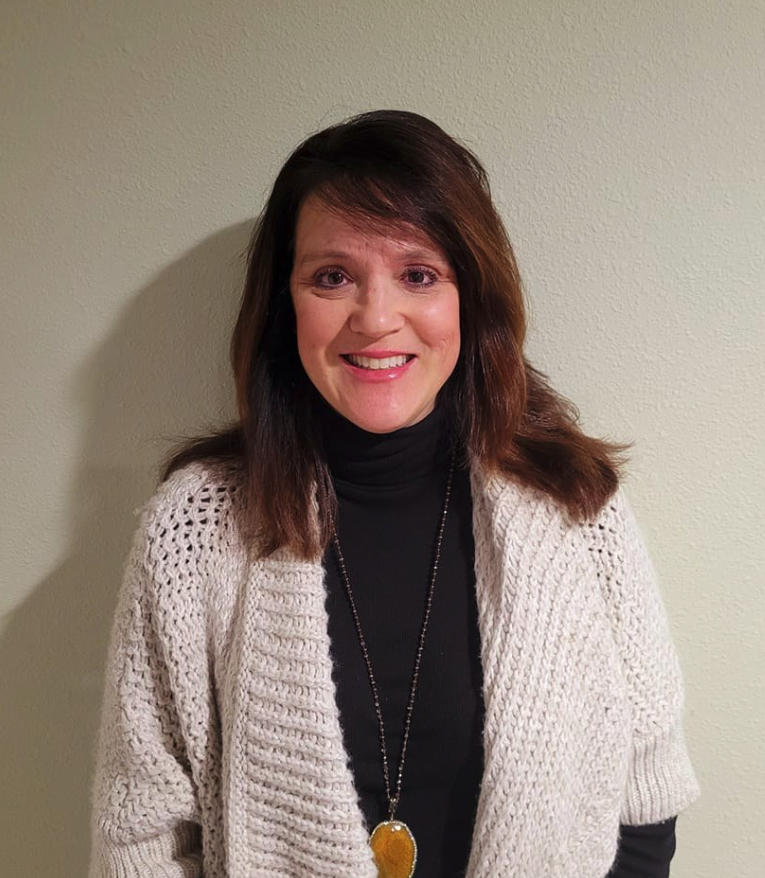
Jill Gerber
Age: no anser given
Address: 234 S. Pleasant St.
Occupation: Data and Special Programs Assistant within the College of Education and Professional Services (UW-Whitewater)
Number of years resided in city: no answer given
Education: Bachelor’s Degree in Business Law from UW-Whitewater
Civic and other organizational memberships: no answer given
Political experience: no answer given
What are your reasons for seeking this position?
My interest in the Common Council developed from working within municipal agencies for over 17 years. I was the executive assistant to the City Manager for the City of Whitewater from 2015-2019 where I was able to see first-hand the ins and outs of each department within the City and how important it is for employees to work together to achieve goals.
I feel the local government needs to be more efficient in researching projects and more transparent with the citizens so we can be a service to the community and not make our citizens feel like they are getting less for their tax dollars.
As mentioned earlier, I have worked in the public sector for years, not for the money, but because I enjoy feeling like I am making a difference and helping citizens. I enjoy volunteering and being a part of a team that works on a project from the start to the finish. Key word being “finish.”
What are the most pressing issues facing the position you seek?
One of the most pressing issues facing the City is getting emergency medical treatment in a timely manner. Whitewater Fire, Inc., for years has been facing difficulties in staffing, recruiting and responding to calls for service. In 2021, EMS had 1,620 calls for service with 272 being a 2nd call. Usually at 1,000 calls for service full-time paramedics are added to the staffing. Not only does Whitewater have a high call volume, but the priority of the calls is also much higher. Currently, we are waiting for a paramedic to respond from other jurisdictions which is causing excess delay time for critical service. Paramedics provide more advanced medical treatment such as advanced airway and electrical intervention for cardiac arrhythmias and can administer additional medications.
By adding a full-time EMS department under the City of Whitewater, citizens would have a paramedic available to respond on each call for service and receive more advanced medical treatment.
The City of Whitewater has a high population of citizens over the age of 55. Given the higher level of service from a paramedic, comes a reduction in mortality rates compared to receiving an AEMT level of service. I believe we need to provide better emergency medical care and service to the citizens of Whitewater.
Another pending issue is the City’s housing stock. The City has very few homes that are within the $200,000-$400,000 range that are in Type A condition. With a large city population under age 25 and over age 55, we are not attracting or retaining homeowners after age 25. The City is expecting just over $2,000,000 at the end of 2022 to spend from TIF 4. This money should be spent on promoting and improving single-family housing within the City. I would like to see developers and builders offered incentives to build within our City.
Other issues include: the need for more new businesses, improvements to the Whitewater Aquatic Center and Cravath Lakefront building, more collaboration with the public schools and the university, improved transparency with citizens, and updated City marketing to make Whitewater a destination.
If elected, what unique perspective and experience do you bring to the council?
I previously worked for the City of Whitewater, for the City Manager, where I was tasked with working with each department within the City on various projects such as reviewing and updating policies, developing ways of streamlining existing departmental procedures, initiating and tracking city-wide training, developing emergency procedures, responding to citizen questions and complaints, and filling in within departments where needed.
Prior to working for the City, I worked primarily within county and municipal government in various positions that included: 911 operator, police dispatcher, and corrections officer. I have been in plenty of situations that require a person to ask the right questions and make decisions. I am not afraid to ask the tough questions and think outside the box to find answers. Many questions pertaining to City projects should be prepared before coming to the Common Council to save time and money.
I currently work at the University of Wisconsin-Whitewater as a Data and Special Programs Assistant. I believe in using and reviewing data to make decisions. Data should not be overlooked and should play a role in many of the City’s decisions on how and where to spend money. The City is looking at several million-dollar projects in the future: library remodel/addition, new Public Works garage, new police evidence garage, and the possible merger with Whitewater Fire, Inc. I believe my experience and abilities will play an important role in making the best possible decisions for the citizens.
Any additional comments?
If elected to Common Council as your Aldermanic District 4 representative, I look forward to working hard for the citizens, and listening to your questions and thoughts about city government.
I am very interested in working towards a more transparent government and getting accurate information to the citizens. I want to see more developers and business owners being marketed to build and expand in Whitewater. I would love to see our Downtown district flourish with more marketing to the students, citizens and surrounding communities, which will help grow our housing stock.
The Cravath Lakefront building needs a facelift, and I would like to see paddle boards, paddle boats, canoes and/or kayaks rented from the building with the library offering yard games and books for checkout.
I believe we will need to spend money on adding full-time paramedics to our EMS staff to improve service and response time. I am a strong supporter of our first responders, including police, fire and EMS. We need our first responders to ensure Whitewater remains a safe place to live, work and play.
If you have any questions, please feel free to reach me through my Facebook site, the Nextdoor app, or by email, jgerber1026@gmail.com.

Chuck Mills
Age: 61
Address: 336 S. Whiton St., Whitewater
Occupation: Small Business Owner
Number of years resided in city: 30
Education: High School
Civic and other organizational memberships: Whitewater 4th of July Committee
Political experience: None
What are your reasons for seeking this position?
My goal is to represent all Whitewater residents.
What are the most pressing issues facing the position you seek?
I would like to bring Main Street back to economic success. I have a goal to bring jobs to our commercial park. I also feel Whitewater’s infrastructure is in need of attention.
If elected, what unique perspective and experience do you bring to the council?
I have been in business for 25 years and living in the community for 30 years. I work closely with our police and fire departments.
Any additional comments?
No response given.

Lukas S. Schreiber
Age: 21
Address: 375 N. Harmony Ln., Apt.125A, Whitewater
Occupation: Student at University of Wisconsin-Whitewater
Number of years resided in city: 3
Education: In the process of obtaining a Bachelor of Business Administration (Finance Major) and a Bachelor of Science (Political Science Major) at UW-W
Civic and other organizational memberships: Sigma Tau Gamma Fraternity, Whitewater Student Government
Political experience: I have served as a Whitewater Common Council Member since July of 2021.
What are your reasons for seeking this position?
I have lived in the Whitewater area since 2013 and have come to love this city. I want to continue serving on the Common Council as I have for the past seven months to be a greater force for good in my community. As a college student at UW-W, I want to ensure Whitewater is developing in a way that not only is attractive to future students coming to study at the college, but also encourages families to settle here to grow our community.
What are the most pressing issues facing the position you seek?
Probably one of the largest issues facing Whitewater currently is further development. We are already on the right track in fixing our roads and building new infrastructure, like the new water tower. Also, I would like to keep working on ensuring our emergency services provided by the city are top-notch and the transition of making emergency services into a municipal department runs as smoothly as possible. This requires the best leaders and managers from the city staff to ensure the proper time is allotted to these issues and transitions.
If elected, what unique perspective and experience do you bring to the council?
I am currently the youngest member on the Common Council at 21 years old, and I am the only college student on the council as well. Having grown up in the area and now living as a student on campus, my main perspective is of a student at the college. I have the perspectives of fellow peers and how they perceive the city that they are living in for the next four years, but also having been a local for the past eight years I know what makes the city special and I’m looking long-term as well as short-term. My experience being a leader in multiple different student organizations on campus has also taught me how to delegate and work with those who are all working towards the same goal. Being young, I have the passion and energy to bring to the council ensuring we continue moving forwards towards a better Whitewater.
Any additional comments?
I am grateful for the opportunity to have originally been appointed to the council back in July of 2021. I have learned much from the past seven months being a council member and I am prepared to continue serving for this next term.
New statewide program offers ‘Help for Homeowners’
(Originally published March 23, 2022.)
Editor’s note: The following information has been shared by the Community Development Authority of the City of Whitewater.
The COVID-19 pandemic has financially impacted thousands of Wisconsin families.
Wisconsin Help for Homeowners (WHH) is a new statewide program that can help with overdue bills like mortgage payments, property taxes and utilities. The program is available to Wisconsin homeowners with overdue housing-related bills, both with and without a mortgage, who meet income and other eligibility requirements, and have experienced a qualified economic hardship since January 21, 2020.
This $92 million federally funded program provides a maximum of $40,000 in assistance for eligible households.
To apply, visit HomeownerHelp.WI.Gov or, for additional information, contact the WHH call center at 1-855-2-HOME-WI. Applications may not be submitted by phone.

File photo/public domain.
Several court of appeals, circuit court judges seats to be decided in April
(Originally published March 24, 2022.)
By Kim McDarison
Among state office seats to be filled in April, constituents in Jefferson and Walworth counties will find candidates running for Wisconsin Court of Appeals Judges in Districts 2 and 4, and two circuit court judges in Walworth County.
According to the Wisconsin Elections Commission website, there are no circuit court judges serving in Jefferson County whose seats are due for election this spring.
Constituents in Jefferson County will find the name of Court of Appeals District 4 Judge Brian Blanchard who is an incumbent running unopposed. Blanchard is a resident of Madison.
Constituents in Walworth County will find a race in Court of Appeals District 2 between judges Lori Kornblum, who is the incumbent, and Maria S. Lazar. Kornblum is a resident of Mequon. Lazar lives in Brookfield.
In Walworth County, constitutes will find the names of two circuit court judges running for open seats. They are incumbent Judge Daniel Johnson, Elkhorn, who is running unopposed in Walworth County Circuit Court Branch 2, and incumbent Judge David M. Reddy, Williams Bay, who is running unopposed in Walworth County Circuit Branch 4.
A full list of Wisconsin Court of Appeals judges and County Circuit Court Judges who are running for election in April — 62 in all — is here: https://elections.wi.gov/sites/elections/files/2022-01/Candidates%20Tracking%20By%20Office%20as%20of%201.7.2022_SEI%20Updates.pdf.
The judiciary system
According to the Wisconsin Court System website, there are 253 circuit judges in Wisconsin’s 72 counties. Milwaukee is the largest jurisdiction with 47 judges. Among smaller counties, some 26 have only one judge and the state’s smallest counties share a judge.
Circuit courts are divided into branches with at least one branch in every county, with the exception of six counties, which are paired and share judges. The Wisconsin circuit courts are the state’s trial courts and handle all civil and criminal matters. Judges are elected to six-year terms.
Wisconsin’s Court of Appeals system is made up of 16 judges who serve within four districts. Judges are elected to six-year terms. The districts are headquartered in Milwaukee (District 1), Waukesha (District 2), Wausau (District 3) and Madison (District 4). The system is the state’s intermediate appellate court.
The system is structured such that a chief judge is appointed by the Wisconsin Supreme Court who then handles administrative duties and participates in deciding cases. A chief judge’s term is three years.
Each of the four district within the Court of Appeals is managed by a presiding judge who is appointed by the chief judge. Presiding judges serve two-year terms.
Wisconsin’s four districts within the Court of Appeals are as follows:
District 1: Milwaukee.
District 2: Calumet, Fond du Lac, Green Lake, Kenosha, Manitowoc, Ozaukee, Racine, Sheboygan, Walworth, Washington, Waukesha and Winnebago.
District 3: Ashland, Barron, Bayfield, Brown, Buffalo, Burnett, Chippewa, Door, Douglas, Dunn, Eau Claire, Florence, Forest, Iron, Kewaunee, Langlade, Lincoln, Marathon, Marinette, Menominee, Oconto, Oneida, Outagamie, Pepin, Pierce, Polk, Price, Rusk, Sawyer, Shawano, St. Croix, Taylor, Trempealeau, Vilas, Washburn and Wausau.
District 4: Adams, Clark, Columbia, Crawford, Dane, Dodge, Grant, Green, Iowa, Jackson, Jefferson, Juneau, La Crosse, Lafayette, Madison, Marquette, Monroe, Potage, Richland, Rock, Sauk, Vernon, Waupaca, Waushara and Wood.
A map of each of the four districts is here: https://www.wicourts.gov/courts/appeals/index.htm.
Circuit Court branches and judges within Jefferson County are as follows:
Branch 1: William Gruber
Branch 2: William Hue
Branch 3: Robert Dehring
Branch 4: Bennett Brantmeier
Circuit Court branches and judges within Walworth County are as follows:
Branch 1: Philip Koss
Branch 2: Daniel Johnson
Branch 3: Kristine Drettwan
Branch 4: David Reddy
About the candidates
Brian Blanchard
According to biographical information found on Ballotpedia, Blanchard began his tenure as a Court of Appeals District 4 judge in August of 2010. He holds a bachelor’s degree earned at the University of Michigan in 1980 and a law degree earned at Northwestern University School of Law in 1989.
Professionally, between 1990 and 1997, Blanchard worked in Chicago as an assistant U.S. attorney, after which time he joined a Madison law firm. He was elected Dane County District Attorney in 2000 and was reelected to the position three times. He has also worked as a reporter for the Miami Herald and a law clerk to a United States Appeals Court judge. His full Ballotpedia profile is here: https://ballotpedia.org/Brian_Blanchard.
Lori Kornblum
According to biographical information found on Ballotpedia, Kornblum began her tenure as a Court of Appeals District 2 judge January of this year. She was appointed to the position by Gov. Tony Evers in November of last year after her predecessor, Judge Paul Reilly, resigned. Her full Ballotpedia profile is here: https://ballotpedia.org/Lori_Kornblum.
Maria S. Lazar
According to information found on Ballotpedia, Lazar is a Waukesha County Circuit Court judge. She was elected to that position in 2015. Lazar holds an undergraduate degree from Mount Mary College and a law degree from Georgetown Law School.
Professionally, she served, between 2010 and 2015, as an assistant attorney general with the Wisconsin Department of Justice, and previously worked in private practice. Her full Ballotpedia profile is here: https://ballotpedia.org/Maria_S._Lazar.
Daniel Johnson
According to information found on Ballotpedia, Johnson was elected to his seat on the Walworth County Circuit Court in 2016. He holds a bachelor’s degree in psychology from Wesleyan University in Illinois, earned in 2000, and holds a law degree from Marquette University Law School, earned in 2003.
Johnson worked as an associate attorney with Hahn Law Office between 2004 and 2010 and is a partner at Braden Olson Draper LLP. His full Ballotpedia profile is here: https://ballotpedia.org/Daniel_Johnson_(Wisconsin).
David Reddy
According to information found on Ballotpedia, Reddy was elected to his seat on the Walworth County Circuit Count in 2010, and reelected in 2016. Reddy holds a bachelor’s degree from the United States Merchant Marine Academy and a law degree from Thomas M. Cooley Law School which he earned in 1987. His resume also includes time spent as a family court commissioner in Walworth County between 2006 and 2010, and he was an attorney in private practice between 1992 and 2006. Reddy also served in the Waukesha County District Attorney’s office between 1987 and 1992. His full Ballotpedia profile is here: https://ballotpedia.org/David_Reddy.
UW-Whitewater water research projects garner statewide funding
(Originally published March 29, 2022.)
Three research endeavors at the University of Wisconsin-Whitewater have been awarded nearly $40,000 in funding from the Freshwater Collaborative of Wisconsin, according to information released by the university Tuesday.
The research projects — which vary from a Freshwater Summer Camp to developing a toolkit designed to measure the effects of water cleanup and restoration projects on a community’s economic vitality — will be initiated this summer, according to the release.
The first endeavor, titled: “Freshwater Camp: A Summer Field Experience for High School Juniors” will be led by Elisabeth Harrahy, associate professor of biology at UW-Whitewater, in collaboration with Jessica Orlofske and Laura Schulz at UW-Parkside. The team will pilot a water-focused high school camp in southeastern Wisconsin in June 2022. The project will highlight important freshwater habitats in the region, build confidence and skills with hands-on field and laboratory activities, and introduce potential freshwater career opportunities to students.
A second project, titled: “Aquatic Biogeochemistry of Wisconsin Waters,” will be co-led by Stephen Levas, assistant professor of geography, geology and environmental science, and John Ejnik, associate professor of chemistry, and will develop an interdisciplinary course in aquatic biogeochemistry that could be taken by future Freshwater Collaborative students from any UW System campus.
The third project, titled: “Building a Toolbox to Evaluate the ROI (return on investment) on redevelopment of Areas of Concern” will be led by professor of economics of The Institute for Water Business at UW-Whitewater Russell Kashian. The project will collaborate with the Wisconsin Department of Natural Resources Office of Great Waters to develop a toolbox that will help provide more rigorous, quantitative information on the value of water improvements to state and local decision makers. In the study, undergraduate students will benefit from the ability to work on water quality issues from an economic perspective, according to the release.
The funding for the Freshwater Collaborative of Wisconsin grants is part of a statewide initiative, backed by the Wisconsin State Legislature and Gov. Tony Evers, to tackle 10 grand water challenges and support curriculum development, undergraduate research opportunities, career development, and field training experiences for students interested in studying water-related fields at the 13 UW Schools, the release noted.
Forty-two grants, for a total of $3.42 million, are intended to further develop UW System-wide water science programs, internships and research opportunities. High school and undergraduate students will have opportunities to participate in hands-on field and research experiences with faculty throughout the state, allowing them to develop a diverse range of skills, the release continued.
Grant descriptions for the 2022 projects are available at freshwater.wisconsin.edu.
For more information regarding the UW-Whitewater projects, contact Elisabeth Harrahy, associate professor of biology, at harrahye@uww.edu or 262-472-1086.

Geese glide serenely Monday across water flowing within the recently dredged Cravath lakebed in Whitewater. The restoration project, which has been funded and facilitated by the city, is designed to make Trippe and Cravath lakes near downtown Whitewater better able to support recreational activity. The project has been underway for approximately two years. Water-related research projects are also the focus of three initiatives which have recently received statewide funding and will be facilitated through the UW-Whitewater this summer. The initiatives range from a Freshwater Summer Camp to the development of a toolkit designed to measure the effects of water cleanup and restoration projects on a community’s economic vitality. Kim McDarison photo.
Whitewater Makers president, former Fort newspaper editor’s husband Pete Spangler dies
(Originally published March 29, 2022.)
By Kim McDarison
Peter Anthony Spangler, 66, longtime resident of Fort Atkinson and native of Johnson Creek, died unexpectedly Tuesday, March 22, in his home.
Spangler was a well-known and familiar face in Fort Atkinson as he attended and supported many community events alongside his wife of 33 years, Chris Spangler, who served as a reporter and editor of the Daily Jefferson County Union for a combined total of over 42 years before retiring in 2020.
Spangler was also a familiar figure in Whitewater where — after he and Chris purchased the former Whitewater Register building in 2016 — he helped form and became president of Wisconsin Makers, a nonprofit organization providing opportunities to those interested in bringing their product and creative ideas to fruition by utilizing the large warehouse facility and the various tools and machines available inside.
According to his obituary, Spangler enjoyed planning activities and was especially gratified to be a part of the annual University of Wisconsin-Whitewater spring iron pour, which continues to be held at the Wisconsin Makers building.
The iron pour offers opportunities to members of the public to create a scratch block design and then observe as a team of UW-Whitewater art students and alumni pour the creations with iron that is melted on site. Iron pour crew members also pour molds of their own works.
Spangler also served as secretary of the Whitewater Rotary Club.
His full obituary is here: https://fortatkinsononline.com/peter-anthony-spangler/.
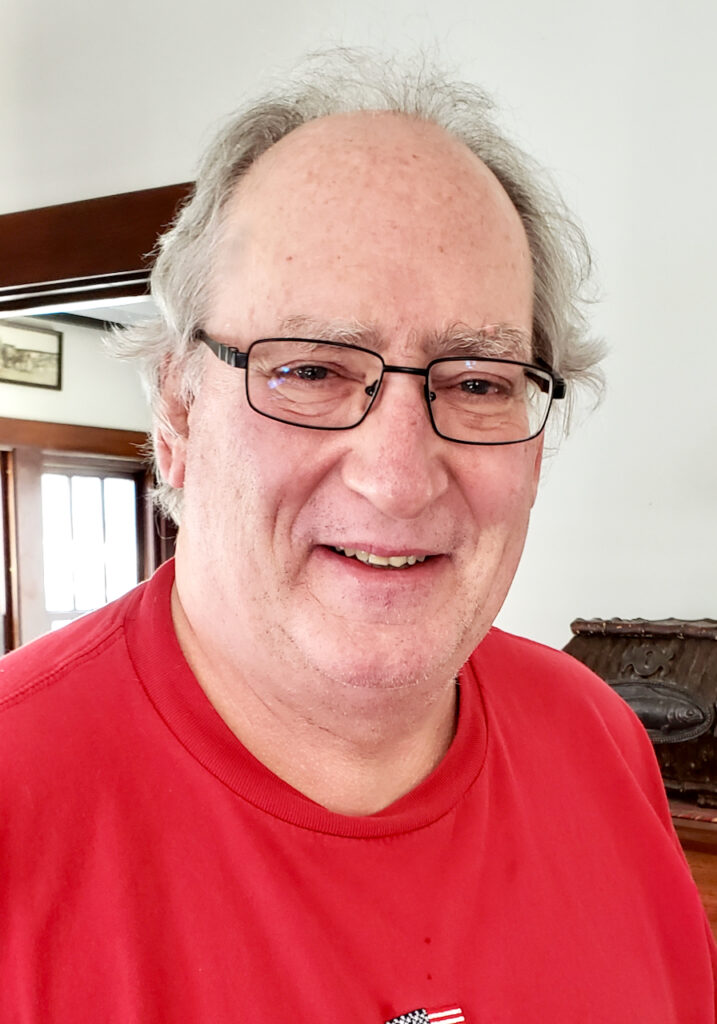
Peter Anthony Spangler
Whitewater: Amended ordinance requires permit to store ‘junk vehicles’
(Originally published March 29, 2022.)
Whitewater city officials have released an announcement reminding residents that a permit is required to store unused or “junk” vehicles within the city.
Amendments made recently to a city ordinance governing the storage of unused vehicles include language which states that such vehicles require a permit when being stored “on a hard surface.”
Permits will be issued by the city for a period of up to one year.
Additionally, the ordinance stipulates the use of a car cover when storing vehicles.
According to the amended ordinance: “No person, firm, partnership, or corporation shall accumulate or store any junked, disassembled, inoperable, or unlicensed automobiles or trucks or parts thereof, on any real estate located in the city, except upon a permit issued by the city council.”
Additionally, the ordinance states: “If an owner is actively racing, restoring or repairing a vehicle, one vehicle, including stock/race vehicles, may be stored on the vehicle owner’s property based on a permit being issued by the city manager or his or her designee, for a period of up to one year when said vehicle is covered with a canvas, tarpaulin or manufactured vehicle cover that is properly secured, free of rips and tears and covers the vehicle to the wheels/tires.”
The stored vehicle must be:
- Located in the rear yard,
- Parked on a hard surface,
- Kept in compliance with the all city ordinances, including the zoning ordinance,
- Kept in a location that is not visible to travelers on public roads and alleys, and
- Kept in a location that, in the opinion of the city manager or his or her designee, will not substantially diminish the quality of views of neighboring property owners.
Those with questions are encouraged to contact Whitewater Neighborhood Services Director Chris Bennett by phone: 262-473-0143 or email: CBennett@whitewater-wi.gov.
The full ordinance is found here: https://library.municode.com/wi/whitewater/codes/code_of_ordinances.

File photo/public domain.
.
Whitewater: City to begin inventory of public, private water laterals
(Originally published March 30, 2022.)
By Kim McDarison
City of Whitewater officials have announced that a process to inventory public and private side water laterals will soon be underway.
Within a recent news release, officials noted that city residents might notice city employees over the next several months as they begin the task of creating the inventory.
According to the release, in December of 2021, the Environmental Protection Agency (EPA) published revisions to the Lead and Copper Rule (LCR), the federal regulation designed to control lead and copper in drinking water.
According to information published by the EPA, the intent of the revisions is to “better protect communities from exposure to lead in drinking water.”
As noted on the EPA’s website, revisions include “a suite of actions to reduce lead exposure in drinking water where it is needed the most. The … rule will identify the most at-risk communities and ensure systems have plans in place to rapidly respond by taking actions to reduce elevated levels of lead in drinking water.”
The EPA website states: “On December 16, 2021, EPA announced next steps to strengthen the regulatory framework on lead in drinking water. Following the agency’s review of the Lead and Copper Rule Revisions (LCRR) under Executive Order 13990, EPA has concluded that there are significant opportunities to improve the rule to support the overarching goal of proactively removing lead service lines and more equitably protecting public health.”
According to information released by the city, revisions included requirements instructing water utilities to make an inventory of both public and private service laterals, with a completion date of 2024.
To meet the requirements, the release continued, the city of Whitewater will begin the process of identifying undocumented service laterals.
During the process, a city employee will be using flags to locate and mark “water curb stop boxes,” which, the release noted, are typically located in the terrace, defined as the grassy area between the city sidewalk and the street.
According to the Center for Disease Control and Prevention (CDC) Healthy Housing Reference Manual, a water curb stop box is an access box to the curb stop, which is defined as a valve used within a process to control water flow and pressure, allowing the isolation of a building from the municipal water supply as it undergoes maintenance or repair.
The curb stop box works in conjunction with a “corporation stop,” which is connected to the water main.
“Because the corporation stop is usually under the street and it is necessary to break the pavement to reach the valve, the curb stop is used as the isolation valve,” the manual stated.
According to information supplied by the city: “Other utilities (gas, electric and fiber optics) will be flagging the same areas. After all utilities have been located, the Water Utility will return with the necessary equipment to excavate a small area around the water service box to identity the water lateral material.”
Examples of materials from which laterals could be made include copper, iron, plastic or lead.
Any disturbed areas will be restored to the original condition, the release added.
Those with questions about the inventory process are encouraged to contact City of Whitewater Water Utility Superintendent Jim Bergner by phone: 262-458-2803 or email: jbergner@whitewater-wi.gov.
More information about the EPA revisions is here: https://www.epa.gov/sdwa/lead-and-copper-rule-long-term-revisions.
A detailed explanation of homeowner water systems as supplied by the CDC is here: https://www.cdc.gov/nceh/publications/books/housing/cha09.htm#:~:text=Curb%20stop%20box%20—The%20curb%20stop%20box%20is,meter%20to%20isolate%20it%20for%20installation%20or%20maintenance.

The above graphic, as shared by the city of Whitewater, shows the location of a curb stop. As depicted in the graphic, the curb stop is located under the terrace, which is the area of ground located between the sidewalk and the street. The graphic further indicates that while lead does not exist in the materials used to manufacture the city-owned water main, there is a possibility that lead could be present in the public service line connecting the water main to the curb stop.
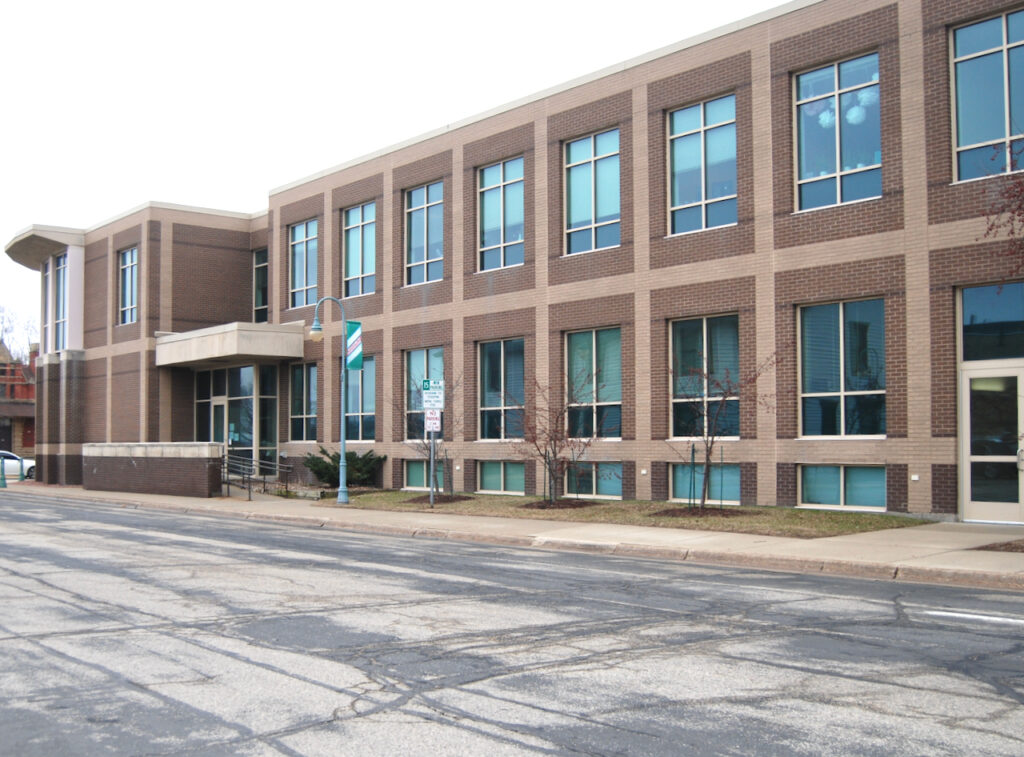
City of Whitewater Municipal Building, file photo/Kim McDarison.
Whitewater election recap: council, school, county, judicial seats to be decided Tuesday
(Originally published April 3, 2022.)
By Kim McDarison
Whitewater constituents casting ballots Tuesday will be asked to decide seats on several boards including those of Whitewater Common Council, Whitewater Unified School District, Walworth County Board of Supervisors and Jefferson County Board of Supervisors, and seats within Wisconsin Court of Appeals District 2 as well as seats in two Walworth County Circuit Court branches, Nos. 2 and 4.
City of Whitewater Common Council
City of Whitewater residents will find four candidates running for seats on the city’s common council.
Two candidates — incumbent Lukas Schreiber representing the city’s Aldermanic District 2, including wards 9 and 10, and challenger Jill Gerber, who is looking to fill a seat in Aldermanic District 4, including wards 6, 7 and 8 — are running unopposed.
Two candidates — incumbent Jim Allen and challenger Chuck Mills — will race for one of two at-large seats. Tuesday’s top vote-getter will be seated after the election.
Common council members serve for two-year terms.
Voters will find biographical information and responses made by the candidates to a Fort Atkinson Online questionnaire here: https://fortatkinsononline.com/whitewater-voters-guide-common-council-candidates-share-experience-views/.
A candidates forum featuring the common council candidates was facilitated by the Whitewater Area League of Women Voters. Click on the arrow below to watch the candidates forum video.
Whitewater Unified School District Board of Education
Constituents living within the Whitewater Unified School District (WUSD) will find four candidates on Tuesday’s ballot. They are incumbents Jen Kienbaum and Joe Kromholz and two challengers: Miguel Aranda and Andrea Svec.
The two top vote-getters will fill the two open at-large seats. Board of education members serve three-year terms.
Some history about the candidates, along with biographical information and answers to a Fort Atkinson Online candidates questionnaire is here: https://fortatkinsononline.com/whitewater-voters-guide-school-board-candidates-share-experience-views/.
A candidates forum featuring the WUSD candidates was facilitated by the Whitewater Area League of Women Voters. Click on the arrow below to watch the candidates forum video.
Walworth County Board of Supervisors
The full Walworth County Board of Supervisors, which is comprised of 11 seats, will be on Tuesday’s ballot.
In District 4, which includes Whitewater wards 2 through 9, longtime supervisor Jerry Grant filed papers of non-candidacy.
A story about his decision against running for another term is here: https://fortatkinsononline.com/two-walworth-county-board-members-decide-against-reelection-run/.
Two challengers, Al Stanek and Curt Knull, are running for the open seat.
Information about Stanek can be found on his campaign website: https://www.stanekcountyboard.org/?fbclid=IwAR1lTXtyNIqkKEGd7WIartiZV4OyY7BCHhGs-gl17Apvihflg2QdozqgvKs.
Information about Knull can be found on his campaign Facebook page: https://www.facebook.com/knull4district4.
A map of Walworth County supervisory districts is here: https://www.co.walworth.wi.us/534/Board-of-Supervisors.
In District 3, which includes Whitewater’s wards 1 and 13, incumbent Brian Holt is running unopposed. According to his profile presented on the Walworth County website, Holt lives in Elkhorn. His county website profile is here: https://www.co.walworth.wi.us/550/District-3.
Whitewater’s wards 10, 11 and 12 are in Jefferson County.
Jefferson County Board of Supervisors
In Jefferson County, Whitewater’s wards 11 and 12 are included within the Jefferson County Board of Supervisors District 25. Incumbent Matthew Foelker is running unopposed in the district. According to his profile on the Jefferson County website, Foelker lives in Fort Atkinson.
Whitewater’s ward 10 is included within the Jefferson County Board of Supervisors District 24. Incumbent Roger Lindl is running unopposed in the district. According to his profile on the Jefferson County website, Lindl lives in Whitewater.
Profiles for Jefferson County Board Supervisors are here: https://www.jeffersoncountywi.gov/government/jefferson_county_board/county_board_supervisors.php.
A map of Jefferson County Board of Supervisor districts is here: https://www.jeffersoncountywi.gov/departments/county_clerk/elections/supervisory_district_maps.php#revize_document_center_rz807.
Court of appeals, circuit court judges
Constituents in Walworth County will find a race in Court of Appeals District 2 between judges Lori Kornblum, who is the incumbent, and Maria S. Lazar. Kornblum is a resident of Mequon. Lazar lives in Brookfield.
Also in Walworth County, constitutes will find the names of two circuit court judges running for open seats. They are incumbent Judge Daniel Johnson, Elkhorn, who is running unopposed in Walworth County Circuit Court Branch 2, and incumbent Judge David M. Reddy, Williams Bay, who is running unopposed in Walworth County Circuit Branch 4.
A story about the court system, its structure and candidates is here: https://fortatkinsononline.com/several-court-of-appeals-circuit-court-judges-seats-to-be-decided-in-april/.
Polling places
A complete list of polling places in Walworth County is here: https://www.co.walworth.wi.us/DocumentCenter/View/8128/Polling-hours-and-locations-April-2022-PDF.
Polls are open from 7 a.m. to 8 p.m. Tuesday.

Whitewater Municipal Building, file photo/Kim McDarison.
Whitewater: Alliance, library seek artists, sponsors for spring public art project
(Originally published April 4, 2022.)
The Whitewater Arts Alliance, in partnership with the Irvin L Young Memorial Library, is dedicating the Spring 2022 Public Art Project to literature by advancing the theme: “The Colors of Literature.”
According to information recently released by the groups, “great literature provides us a tranquil escape, expands our mind, invokes our sense of adventure, and builds our empathy, among many other benefits.”
To demonstrate an appreciation for literature, the alliance will be providing large, wooden “pages” for participating artists to decorate in accordance with the theme.
Artists are encouraged to use messages and images from written stories when creating art for their pages, according to the release.
The finished pieces of public art will be suspended from lampposts along Whitewater’s Main Street.
To help facilitate the production of the theme-based public art, the Irvin L Young Memorial Library will hold a workshop on Monday, May 16, at 1 p.m., for those who would like to collaborate with others when decorating a community page, the release stated.
Artist participation in the public art project is free.
Those wishing to participate in the public art project as an artist or sponsor are asked to complete a form found on the Whitewater Arts Alliance website.
The form, found here: https://www.whitewaterarts.org/forms can be returned and sponsorship checks can be mailed to the Whitewater Arts Alliance, P.O. Box 311, Whitewater, WI 53190. Forms can also be returned by email: wwartsalliance@gmail.com.
Forms must be returned by Wednesday, April 20.
Sponsors are asked to complete the form and return it with their checks for identification purposes.
Sponsorship checks should be made payable to the Whitewater Arts Alliance.
Those with questions are encouraged to contact Ashe McDarison: wwartsalliance@gmail.com.

The Whitewater Cultural Arts Center sign braves an April snow storm. FAO file photo/Ashley McDarison.
UW-Whitewater interim chancellor resigns effective Monday
(Originally published April 4, 2022.)
Compiled by Kim McDarison
The following statement from interim Chancellor Jim Henderson was released on the announcements page of the University of Wisconsin-Whitewater website Monday.
It reads:
“Dear Colleagues:
“One of my three goals for my time as interim chancellor has been to help this campus hire the best chancellor possible who will be here for the long term. Over the past few days it has become clear to me that I cannot make progress on that goal. Given that, I feel that it is in both the best interest of UW-Whitewater and me personally that I resign my position as interim chancellor, and I have submitted my resignation effective at the end of the day today.
“I have greatly enjoyed my time with you. I so admire all of you and what you are accomplishing for the students at both the Whitewater and Rock County campuses. I wish you the best going forward and thank you all for the incredible support that you’ve given me over the past 9 months.
“With deep appreciation,
Jim Henderson”
Also Monday, the following message from the institution’s vice chancellors was released:
“Dear university community,
“We know today’s resignation of Interim Chancellor Jim Henderson was unexpected — and that you may have many questions. At this time, we do not have additional details, but please know we are in close contact with UW System and will share information on next steps as soon as we can.
“It’s understandable to feel a sense of disappointment at this time, having gone through multiple leadership transitions over the past few years.
“The vice chancellors are united in our passionate dedication to this university — to serving all of you, our students, faculty and staff members — and we are united in our fierce commitment in moving the Whitewater and Rock County campuses forward.
“Please remember the outstanding work we have collectively accomplished. This past fall, we welcomed our largest freshman class in four years and our largest graduate class in the history of UW-Whitewater. We have addressed our budget deficit and our fiscal house is in much stronger shape for the future. Our entrepreneurial spirit, nimbleness and caring culture helped us successfully navigate a global pandemic, and campus life is thriving once again.
“As we navigate this leadership transition, thank you for wholeheartedly supporting one another as we carry on our important work of providing a transformational university education and experience to our students. During a time of unprecedented challenges, our university family has shown strong resilience and achieved important successes. We deeply appreciate you.
“With gratitude,
John Chenoweth, provost and vice chancellor for academic affairs
Artanya Wesley, vice chancellor for student affairs
Jeff Arnold, interim vice chancellor for administrative affairs
Katie Kuznacic, interim vice chancellor for university relations”
A link to a UW System news release announcing Henderson as the interim chancellor in June of last year after the resignation of then-chancellor Dwight Watson is here: https://www.wisconsin.edu/news/archive/uw-whitewater-chancellor-dwight-watson-resigns-former-uw-system-leader-jim-henderson-named-interim/.
Watson tendered his resignation on June 17, 2021, citing health reasons.
This story may be updated.
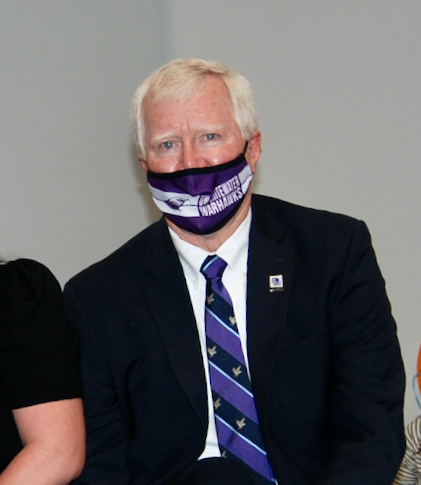
University of Wisconsin-Whitewater interim Chancellor Jim Henderson. Kim McDarison photo.
Chenoweth named interim UW-W chancellor
(Originally published April 4, 2022.)
Editor’s note: the following information was released Monday by the UW-System.
University of Wisconsin System Interim President Michael J. Falbo today announced that John Chenoweth will take over as interim chancellor of UW-Whitewater effective Tuesday, April 5. Chenoweth, the university’s provost and vice chancellor for academic affairs, replaces Jim Henderson, who resigned as interim chancellor effective today.
“This is an unexpected situation, but I am confident that Provost Chenoweth will maintain continuity at UW-Whitewater,” Falbo said. “I thank Jim for his service.”
UW System Board of Regents President Edmund Manydeeds III is expected this week to provide an update on a search for a new permanent chancellor at UW-Whitewater.
Chenoweth began as UW-Whitewater provost on July 1, 2021. He previously was dean of the UW-Whitewater College of Business and Economics, the largest AACSB-accredited business school in Wisconsin, where he led 184 faculty and staff in a college with more than 4,000 students enrolled in 15 bachelor’s degree programs, seven master’s degree programs, and a doctoral program.
A tenured faculty member in the Department of Information Technology and Supply Chain Management, Chenoweth arrived at UW-Whitewater in 2002. He received his Ed.D. in educational leadership and policy analysis from East Tennessee State University, a master’s degree in computer science from the University of South Dakota, and a bachelor’s degree in computer science from Augustana University.

Photo courtesy of UW-Whitewater. Photo by Craig Schreiner.
Whitewater: Allen retains seat
(Originally published April 5, 2022.)
By Kim McDarison
City of Whitewater Common Council incumbent Jim Allen Tuesday retained his at-large seat.
Allen faced challenger Chuck Mills in the only race for a common council seat.
Two other candidates ran unopposed for seats in Aldermanic Districts 2 and 4.
Across the city’s wards, unofficial election results show a total of 807 ballots were cast for Allen while 472 were cast for Mills.
Constituents living in wards within Walworth County voted in favor of Allen with 710 votes cast against 421 cast for Mills.
In Jefferson County, within which the city’s wards 11-13 reside, voters cast ballots for the at-large seat, with Allen receiving 97 votes or 62.18% of ballots cast in the Jefferson county wards. Mills received 51 votes, representing 32.69% of ballots cast.
In Aldermanic District 2, incumbent Lukas Schreiber received 9 votes.
In Aldermanic District 4, newcomer Jill Gerber received 331 votes.

Jim Allen
Whitewater: Kienbaum, Aranda win school board seats
(Originally published April 6, 2022.)
By Kim McDarison
Separated by thin margins, Whitewater Unified School District Board of Education candidates Miguel Aranda and Jennifer Kienbaum emerged Tuesday from a field of four as winners of the district’s two open at-large seats.
Across the district, total unofficial election results showed Aranda, a challenger and former board member, with 1,249 votes and Kienbaum, an incumbent, with 1,226 votes. Totals show a margin of 23 votes between them.
Following Kienbaum by a margin of 28 votes, incumbent Joseph Kromholz lost his bid for a seat, receiving 1,198 votes. Challenger Andrea Svec also lost her bid for a seat, receiving 1,015 votes.
Within Walworth County, a total of 3,794 ballots were cast as follows: Aranda, 1,022 votes; Kienbaum, 976 votes; Kromholz, 964 votes, and Svec, 829 votes.
In Rock County, the district’s constituents cast ballots as follows: Kienbaum, 107 votes; Kromholz, 89 votes; Aranda, 83 votes, and Svec, 68 votes.
Rock County Whitewater Unified School District constituents live in the towns of Johnstown and Lima.
In Jefferson County, the school district has constituents living in the towns of Cold Spring and Koshkonong, and the city of Whitewater wards 11-13.
Jefferson County voters cast ballots for school board candidates as follows: Kromholz, 145 votes; Aranda, 144 votes; Kienbaum, 143 votes, and Svec, 118 votes.
Tuesday’s vote tallies remain unofficial until certified by county clerks.

Jennifer Kienbaum

Miguel Aranda
Whitewater Community Foundation president Frawley steps down
(Originally published April 10, 2022.)
The Whitewater Community Foundation announced Sunday on its Facebook page that its president, Danielle Frawley, “has stepped aside in her role as president of the Whitewater Community Foundation as of April 1, 2022.”
According to the announcement, Frawley has served as president of the foundation since 2018.
Additionally, the announcement states, Frawley will continue to serve on the foundation’s board.
The announcement reads: “Under Danielle’s leadership, the foundation has continued to grow and expand its outreach in the greater Whitewater area. We are grateful for Danielle’s leadership and appreciate her continued commitment and dedication to the Whitewater community.”
Roni Telfer and Therese Kennedy will assume leadership of the foundation serving as co-presidents, according to the announcement.
The mission of the Whitewater Community Foundation, according to its Facebook page, “is to enhance quality of life in the Whitewater area via educational, cultural, charitable or benevolent expenditures.”
Among its undertakings, the foundation oversees activities at The Whitewater Banner, an online publication delivering community-related information.
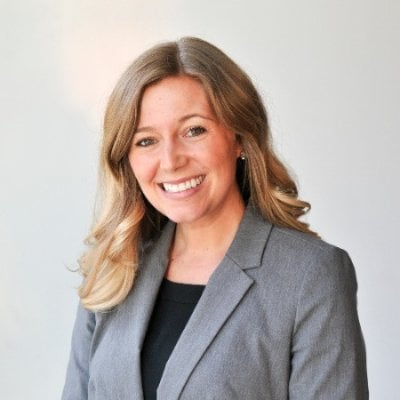
Danielle Frawley
Report finds decline in state support for college financial aid; workforce shortages affected
(Originally published April 12, 2022.)
Compiled by Kim McDarison
A report released by the Wisconsin Policy Forum on Tuesday shows that enrollment in Wisconsin colleges and universities has “generally” been falling even faster than the national trend.
The report concludes, “financial aid could serve as one tool to help address this decline while providing benefits to low-income students and students of color in particular.”
The report acknowledges the development of declining workforce trends throughout the state.
The report, titled: “A Little Help: Is Financial Aid Keeping College Affordable in Wisconsin?” found that even as the state’s workforce faces, in some cases, “severe shortages,” support for Wisconsin students through state and federal financial aid has “lagged and in some respects even declined over the past decade.”
The report finds that state spending on grants, loans and scholarships to undergraduate students increased during the 2000s, but has decreased in recent years.
The report cited data from the Higher Educational Aids Board and Legislative Fiscal Bureau, and noted that even with spending at $119.1 million in 2021, total spending was down by 0.5% from the amount spent in 2011 “even before adjusting for inflation.”
When making comparisons between public, private and technical colleges, the report found the average grant offered to students seeking aid through the Wisconsin Grants program, the state’s main form of need-based financial aid, was smaller for students entering into various state programs than awards offered in 2010 and 2011.
In 2021, the report noted, the average Wisconsin Grants award given to students in the UW System was $2,037, which was down from the comparative grant offered in 2010. Students enrolling in the Wisconsin Technical College System saw a peak in grant amounts in 2011 at $955. In 2021, the comparative award was $865.
Within the report, key findings include:
• State spending on grants, loans, and scholarships to undergraduate students grew rapidly from 2000 to 2011 but fell 0.5% between 2011 and 2021, without adjusting for inflation.
• Even adjusted for inflation, the average unmet need for in-state undergraduates receiving financial aid at all higher education institutions in Wisconsin has grown 135.6% from $3,755 in 2000 to $8,845 in 2021.
• The average Wisconsin Grant and federal Pell Grant combined paid for 91.4% of in-state undergraduate tuition at UW-Madison in 2002 but only 69% in 2021.
• Wisconsin’s 2020 spending on grants to undergraduates worked out to $541 per student, 44.8% lower than the national average of nearly $980 per undergraduate.
• Wisconsin’s total grant aid to undergraduates increased from $107.2 million in 2010 to $120.9 million in 2020, or 12.8%. That was 36th among the 50 states. Nationally, grant aid increased by 46%, or more than three-and-a-half times as much.
Offering options, the report outlined the following:
• Make progress without spending large sums: Low-cost options include consolidating small aid programs scattered across various state agencies, creating a one-stop state website that could provide information on all public financial aid programs for Wisconsin students, and supporting students and families to ensure they fill out a key federal form needed to access financial aid.
• Provide a bump in overall funding: At a relatively modest cost, the state could provide a funding increase for its need-based Wisconsin Grants program. It would cost just under $6.1 million to provide an additional 10%, or $204, to each of the 29,881 UW System students who received grants averaging $2,037 in 2021. Providing 10% increases to students at other types of institutions would require an even smaller investment. Some financial aid could be targeted, if desired, toward students studying in certain in-demand fields.
• Tie financial aid to student cost: A key problem for financial aid levels in Wisconsin has been the fact that neither overall funding nor average grant amounts are tethered to student costs. The state could remedy that by tying either total funding levels or the target grant amounts for programs such as the Wisconsin Grants to an objective standard such as tuition costs, the Consumer Price Index, or other inflation measure.
• Expand Bucky’s Tuition Promise or consider another such program: UW-Madison already offers Bucky’s Tuition Promise, which guarantees enough scholarships and grants to cover four years of tuition and fees for freshman students with household incomes of $60,000 or less. Policymakers could consider expanding the tuition promise to other UW campuses as well as extending a similar promise to low-income students at technical and tribal colleges. They also may wish to consider providing additional assistance to private college students.
According to a news release about the report, “During the pandemic, students have faced unprecedented challenges and, perhaps not surprisingly, post-secondary enrollment and retention rates have fallen to a concerning degree. Now, an influx of federal pandemic aid and unprecedented recent rise in state tax collections create a unique opportunity to use financial aid as one tool to support students in this precarious time. Doing so could boost long-term earnings for these students and tax collections for the state, help address some workforce challenges, and ensure a more equitable society in the years to come.”
In its conclusion, the report notes: “For the past decade, Wisconsin has chosen not to prioritize student financial aid, relying instead on a state-imposed freeze on in-state undergraduate tuition at the UW System campuses.”
Moving forward, the report concludes: “financial aid is likely to become increasingly important for the state’s students and ultimately, its labor force.”
In response to the reports findings, UW System interim President Michael J. Falbo stated: “State support for its public universities here in Wisconsin has fallen from around 30 percent in 2002 to 18 percent today. While students and families are picking up more of the costs of education, student aid has also fallen behind. Declining student aid increases student debt, depresses enrollment, and exacerbates Wisconsin’s workforce challenges.
“The University of Wisconsin is the state’s primary magnet for developing, attracting, and retaining talent. Yet, investment in financial aid for Wisconsin students is now well below national averages. That is why we proposed expanding UW-Madison’s Bucky’s Tuition Promise to all UW System universities in the last budget. Targeted aid to students will help more than just those students and families affected, it would help all of Wisconsin. More students getting more education leads to more graduates. Simply put, student aid should be an easy investment to increase personal earnings and address workforce shortages.”
The full report from the Wisconsin Policy Forum is here: https://wispolicyforum.org/wp-content/uploads/2022/04/ALittleHelp_Full.pdf.
About the Wisconsin Policy Forum
The Wisconsin Policy Forum is the state’s leading source of nonpartisan, independent research on state and local public policy. As a nonprofit, the organization’s research is supported by members including “hundreds of corporations, nonprofits, local governments, school districts, and individuals,” as stated in a press release. To learn more, visit: wispolicyforum.org.
The report: “A Little Help: Is Financial Aid Keeping College Affordable in Wisconsin?” was funded, in part, by contributions from the Herzfeld Foundation, the Higher Education Regional Alliance, the ADAMM Foundation, and the Milwaukee Regional Research Forum, according to a press release.

University of Wisconsin-Whitewater, file photo/Kim McDarison.
UW-Whitewater teachers union circulates petition against ‘political interference’
(Originally published April 17, 2022.)
By Kim McDarison
As of Easter Sunday, 31 people have signed a petition begun by the University of Wisconsin-Whitewater teachers union local 3535. The union represents UW-Whitewater faculty and academic staff.
The petition, available on the Action Network, is titled: “Protect UW-Whitewater from political interference.”
According to the the union’s president, Chris Ramaekers, an associate professor of music and director of orchestras at UW-Whitewater, the petition was launched Tuesday, April 12, as a means by which to garner support from the campus and broader Whitewater community against what union members perceive as political interference from state lawmakers on the UW-Whitewater campus.
Ramaekers said the purpose of the petition is three-fold: it seeks support in objecting to political interference on campus, and points to the methodology and process used to administer a proposed free speech survey. UW System chancellors were recently informed by the UW System interim president about a free speech survey which had been slated for distribution earlier this month to all UW System students. The survey has since been postponed.
Ramaekers said he and other faculty members on campus became aware of the survey after it was tied to the abrupt resignation of former UW-Whitewater Interim Chancellor Jim Henderson.
A chancellor resigns
Ramaekers described Henderson as someone who was well-liked on campus.
“He was collaborative, even-keeled, reasonable. We were surprised when he abruptly resigned,” he said.
Henderson tendered his resignation Monday, April 4, effective immediately, writing in his resignation statement, which was posted to the campus website: “One of my three goals for my time as interim chancellor has been to help this campus hire the best chancellor possible who will be here for the long term. Over the past few days it has become clear to me that I cannot make progress on that goal. Given that, I feel that it is in both the best interest of UW-Whitewater and me personally that I resign my position as interim chancellor, and I have submitted my resignation effective at the end of the day today.”
After Henderson released his statement, UW System Interim President Michael J. Falbo announced that then-UW-Whitewater Provost John Chenoweth would be installed as interim chancellor at UW-Whitewater.
“This is an unexpected situation, but I am confident that Provost Chenoweth will maintain continuity at UW-Whitewater,” Falbo was quoted as saying in a UW System news release. The release further stated: “UW System Board of Regents President Edmund Manydeeds III is expected this week to provide an update on a search for a new permanent chancellor at UW-Whitewater.”
As the story emerged, statewide news sources reported a second source of concern coming from UW System chancellors and educators: a survey which was being provided as a research project through UW-Stout. The survey’s purpose, researchers at that institution reportedly said, was to learn more about attitudes from students about free speech on campus.
UW-Whitewater Associate Professor and Faculty Senate Chairperson Tracy Hawkins said she was among four campus leaders Henderson called into his office Monday before he officially resigned.
Free speech and funding
During the meeting, Hawkins said, Henderson explained his reasons for his resignation.
“He did talk about the survey that morning. He was using the survey as an example that highlighted for him the problematic dynamics that were going on at the system level,” Hawkins said, adding that, according to Henderson, “the survey was a symptom of the problem.”
The “dynamic” he described, she said, “was the (State) Legislature was threatening to withhold funding if the UW System president did not go forward with this survey. All of the (UW System) chancellors were against the survey but the system president said we have to do it anyway,” Hawkins said.
On April 4, Hawkins said, after her discussion with Henderson, she also had discussions with members of UW System leadership, including Falbo and Manydeeds. From information gathered from those three discussions, she said, she came to understand that there was some concern that would the system campuses not administer the survey to their students, there was a possibility that some $1 billion in state funding that had been allocated as investments in capital projects throughout the system, but had not yet been delivered, would not move forward.
“My understanding is that the Legislature has approved this funding in principle, but not in deed — we don’t yet have the money,” she said.
Said Hawkins: “Chancellor Henderson resigned because he felt like he could not in good faith recommend a (permanent position) chancellorship if that was the dynamic.”
She said Henderson described to her and the three other leaders present at the meeting on April 4 his concern about a systemwide dynamic that “excluded autonomy in decision-making for the system’s chancellors.”
UW-Whitewater campus community responds
While Hawkins was aware of the teachers union’s survey, she said, the UW-Whitewater Faculty Senate had not released a statement addressing the survey specifically.
“We have not taken a position on the survey, but yesterday (April 12) we approved a resolution opposing the political interference in the system,” she said.
The resolution reads: “Be it resolved that we, the UW-W Faculty Senate, strongly oppose all forms of political interference in the UW System, including: Threatening to or actually withholding funding on the condition of adherence to politically motivated or partisan agendas; Withholding confirmation from duly appointed Regents: Attempting to prohibit any specific academic content; Usurping campus-level control of health and safety initiatives (and) Using intimidation, harassment, or threats — including threats of termination — to influence the
decisions or behaviors of chancellors, faculty, staff, or students at any UW System institutions.”
Students, too, have responded to the free speech survey, Ramaekers said, citing a statement sent to Falbo and released by the student government at UW-Stevens Point.
The statement, dated April 6, is signed by student government leaders from UW-Eau Claire, UW-Madison, UW-Whitewater and UW-La Crosse, in addition to Stevens Point, and reads, in part: “We are writing today to express our deep disappointment in regard to the free speech survey announced yesterday. This survey, which is slated to be sent to our campus communities on Thursday, April 7, has raised concerns about the intent, methodology, and impact with student government leaders. We are calling for this survey to be delayed or cancelled until all shared governance groups are consulted.
“The topic of free speech at our universities has been used in the political arena to divide our students, create unwarranted resentment towards public higher education, and pass unjust laws limiting educational freedoms and the ability to have an honest conversation in the classroom. While we clearly support academic freedom and free speech rights, student perceptions of these complex topics must be studied in an academically rigorous manner for the results to be effective. This starts with engaging stakeholders from across the UW System.”
The statement continues: “Not only are the above issues deeply concerning, but the timing and manner of this survey also raise concerns. This time of year is one when students are already swamped with communications about registration, elections, financial aid, housing, graduation – the list goes on. Sending this survey now will only mean that it is lost in the heat of the late spring semester. As a result, this survey will likely have an extremely low response rate and suffer from biases, making the data near useless. This is not even to mention the timeline of this being announced to administrations and shared governance groups less than a week before the survey opens, leaving little to no time for proper response.”
The survey has since been postponed, with a potential for reconsideration in the fall, Ramaekers said.
Regarding the survey and alleged political interference on campus, Ramaekers added: “Everyone in the broader Whitewater community has a stake in the wellbeing of the UW-Whitewater campus. The wellbeing of the community is intertwined with these campuses, so to play games with the wellbeing of campuses is also to play games with the community.”
Withholding funds from campus, he said, “it runs the risk of financially damaging members of the community. There are business leaders who have financial interest in the community’s wellbeing, and people who own homes.”
Why object to free speech?
Citing the petition, Ramaekers said: “So it’s kind of first to say, of course everybody on campus — faculty, administration and students — we support our right to free speech. It’s the context in which this was raised.
“Free speech on campus has become a buzz word,” he said, used by some state legislative officials, “to insinuate,” Ramaekers noted “that we are somehow quashing free speech on campus.”
Ramaekers said that while he was not an expert, those on campus who are experts in the field of methodology have raised concerns with the methodology used in the proposed free speech survey.
“They (UW-Whitewater campus methodology experts) say this is not an effective methodology for evaluating whether students feel free speech is honored on campus,” he said.
A third concern, Ramaekers said, is that the UW-Whitewater’s process used for reviewing information before its submittal to students, which involves the information coming before an Institutional Review Board (IRB), was not conducted.
“It appears the IRB process was not followed properly,” Ramaekers said.
According to Ramaekers, each campus has an IRB. The free speech survey was submitted to the IRB at UW-Stout. At that review, Ramaekers said, he understands the survey was given an exemption.
“It was deemed that it didn’t need approval for Stout. Then it was supposed to go to the IRB on each campus to see if we agree, and it’s that second piece of it that didn’t happen,” Ramaekers said.
The petition created by the UW-Whitewater teachers union remains open and available to collect signatures on the union’s Facebook page, Ramaekers said. A decision about when to close it has not been made.

UW-Whitewater, file photo/Kim McDarison.
Whitewater: High school principal Lovenberg resigns
(Originally published April 18, 2022.)

Whitewater High School Principal Michael Lovenberg attends a career fair. File photo/Kim McDarison.
Musical maps: Assembly and State Senate districts drawn; candidates come forward
(Originally published April 19, 2022)
By Kim McDarison
The Wisconsin Supreme Court on Friday, April 15, ruled that legislative maps as drawn by the State Legislature will be used to define Assembly and State Senate districts for the next 10 years.
The new ruling reverses an earlier decision, which was made by the Wisconsin Supreme Court and published in February, adopting legislative maps as submitted by Gov. Tony Evers.
The Supreme Court of the United States published its reversal of the Wisconsin Supreme Court’s February ruling in March.
Commentary, published by Fort Atkinson Online as written by Jefferson County resident Dan Russler — who was among members of an ad hoc analytical group called the Wisconsin Map Assessment Project (WIMAP) — notes, “these new district maps are a drastic change from the maps selected by the court in February.” Russler has been following closely the full redistricting process. His three commentaries on the subject are found here: https://fortatkinsononline.com/wisconsin-redistricting-2022-is-historic-and-surprising/, here https://fortatkinsononline.com/commentary-scotus-wisconsin-and-the-election-risk/, and here: https://fortatkinsononline.com/commentary-a-wisconsin-supreme-court-surprise/.
New maps adopted on April 15 will affect, to varying degrees, the state’s 99 Assembly districts and 33 State Senate districts.
Those interested in running for a state office will find pertinent information here: https://elections.wi.gov/candidates/state.
Candidates running for a seat on the Assembly must collect between 200 and 400 signatures and file a declaration of candidacy and nomination papers with the Wisconsin Elections Commission by 5 p.m. on June 1.
Candidates running for a seat on the State Senate must collected between 400 and 800 signatures and meet the same filing criteria as those running for Assembly seats.
All 99 Assembly seats come due for election this year. State representatives serve two-year terms.
Seventeen of 33 State Senate seats come due for election in November. State Senators serve four-year terms.
Wisconsin’s fall general election will be held Nov. 8. Primary elections will be held Aug. 9.
Changes brought about by redistricting affecting State Senate and Assembly districts including the cities of Fort Atkinson and Whitewater, Jefferson County and the surrounding area, follow.
Assembly District 33
In Jefferson County, earlier changes made to the boundaries of Assembly District 33, which had formerly included a portion of Mukwonago, left Rep. Cody Horlacher, R-Mukwonago, residing outside of his district. He has since announced that he will not seek another term in the Assembly.
Before redistricting maps were adopted in February, the 33rd Assembly District included portions of Jefferson, Waukesha and Walworth counties, holding within its boundaries the communities of Cambridge, Jefferson, Fort Atkinson, Hebron, Palmyra, Eagle and Mukwonago.
After maps were adopted in February, boundaries excluded Mukwonago and added, in part or full, the communities of Johnson Creek, Rome, Sullivan, Ixonia, Lebanon, Neosho and Watertown.
Final maps approved April 15 show the communities, in part or full, of Fort Atkinson, Jefferson, Milton, Helenville, Hebron, Sullivan, Oakland and Palmyra included in the district. A portion of the city of Whitewater, which resides in Jefferson County, also is included. The portion of Whitewater residing in Walworth County is included in Assembly District 31.
Assembly District 38
In Assembly District 38, maps adopted in February, which included a portion of Jefferson County, placed Rep. Barbara Dittrich, R-Oconomowoc, residing outside of her district. Before the February Wisconsin Supreme Court ruling, the district contained a portion of Oconomowoc, along with the Jefferson County community of Lake Mills. Boundaries adopted in February excluded communities formerly included within the district east of Watertown and added communities to the city’s north, extending into Dodge County and including Clyman and Lowell.
Final maps approved April 15 show the communities, in part or full, of Marshall, Deerfield, Cambridge, Waterloo, Lake Mills, Aztalan, Johnson Creek, Farmington, and Rockdale included in the district.
Assembly District 43
In February, maps adopted by the Wisconsin Supreme Court made virtually no changes to borders delineating Assembly District 43. In March, Rep. Don Vruwink, D-Milton, announced he would run for reelection to the seat. At that time, the district included portions of Rock, Walworth and Jefferson counties, including the communities of Evansville, Edgerton, Milton and Whitewater.
Assembly District 43, as adopted on April 15, includes the communities, in part or full, of Footville, Edgerton, Brooklyn, Stoughton and Oregon.
Vruwink, after maps were adopted on April 15, resides in Assembly District 33.
Assembly District 31
Maps adopted April 15 show the following Rock and Walworth county communities, in full or part, included in Assembly District 31: Whitewater, Elkhorn, Darien, Avalon and Clinton. Maryann Zimmerman, a resident and school board member within the Whitewater Unified School District, has announced on her Facebook page that she is running for the seat. Likewise, Ellen Schutt, Clinton, has announced her intent to run for the seat on her Facebook page and has declared her candidacy for the Republican primary, according to Ballotpedia.org.
Senate District 11
In February, changes made in Wisconsin Senate District 11, represented by Sen. Stephen Nass, R-Whitewater, largely mirrored changes made in Assembly District 33. The senatorial district contained Assembly Districts 31, 32 and 33.
Maps adopted on April 15, show, in part or full, the following communities included within the district: Jefferson, Helenville, Sullivan, Fort Atkinson, Hebron, Palmyra, Whitewater, Milton, Avalon, Elkhorn, Delavan, Johnstown, Richmond, Darien, Clinton, Sharon, Williams Bay, Lake Geneva, Fontana, Walworth, Beloit and Genoa.
Senate District 15
In February, borders delineating Wisconsin Senate District 15, represented by Sen. Janis Ringhand, D-Evansville, were virtually unchanged. The senatorial district contains Assembly Districts 43, 44, 45.
In March, Ringhand announced that she would not be seeking another term as a state senator.
Maps adopted on April 15, show, in part or full, the following communities included within the district: Oregon, Stoughton, Brooklyn, Edgerton, Janesville, Footville, Orfordville, Brodhead, Albany, and Evansville.
A map including all of the Wisconsin Assembly Districts adopted by the Wisconsin Supreme Court on April 15 is here: https://data-ltsb.opendata.arcgis.com/datasets/LTSB::sb621-assembly-districts-1/explore.
A map including all of the Wisconsin Senate Districts adopted by the Wisconsin Supreme Court on April 15 is here: https://data-ltsb.opendata.arcgis.com/datasets/sb621-senate-districts-1/explore?location=45.089939%2C-89.517808%2C8.21.
A map showing Assembly and Senate districts combined on one map as adopted by the Wisconsin Supreme Court on April 15 is here: https://www.arcgis.com/home/webmap/viewer.html?webmap=57249db1dfc442478d3f2f55f8b66cad.

A map shows Assembly District 33 before the February Wisconsin Supreme Court ruling.
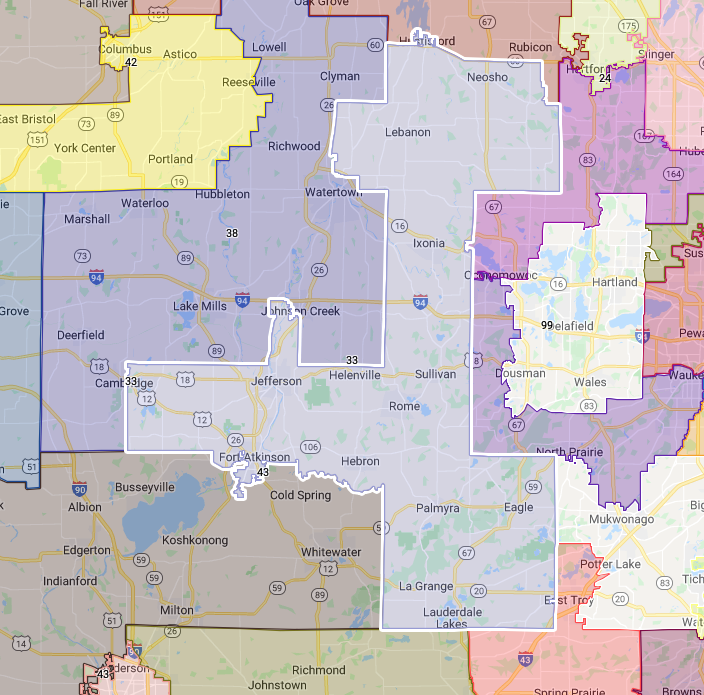
A map shows Assembly District 33 using maps as proposed by Gov. Tony Evers.

A map shows Assembly District 33 as drawn by the Legislature. The map was adopted by the Wisconsin Supreme Count on April 15 for use within the state until 2032. The city of Fort Atkinson and a portion of the city of Whitewater, which resides within Jefferson County, are included in this district. With the adoption of maps on April 15, Rep. Don Vruwink, D-Milton, no longer lives in the 43rd district he represents. Vruwink had earlier announced he would be running for reelection. His next run will be made for an Assembly seat representing the 33rd district. Rep. Cody Horlacher, R-Mukwonago, after maps were adopted in February, no longer resided within the 33rd district, which he represents. He announced earlier this month that he will not seek another term in the Assembly.
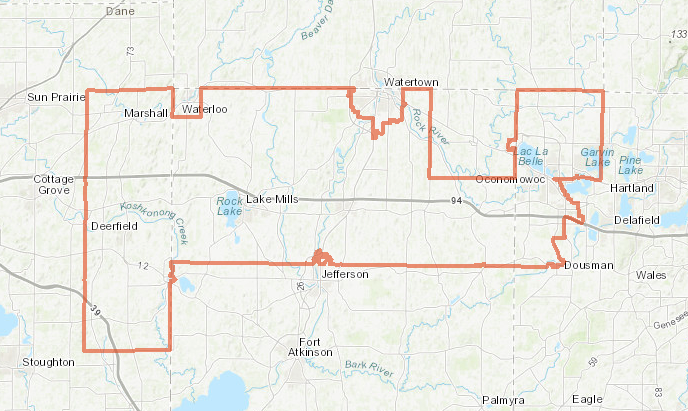
A map shows Assembly District 38 before the February Wisconsin Supreme Court ruling.
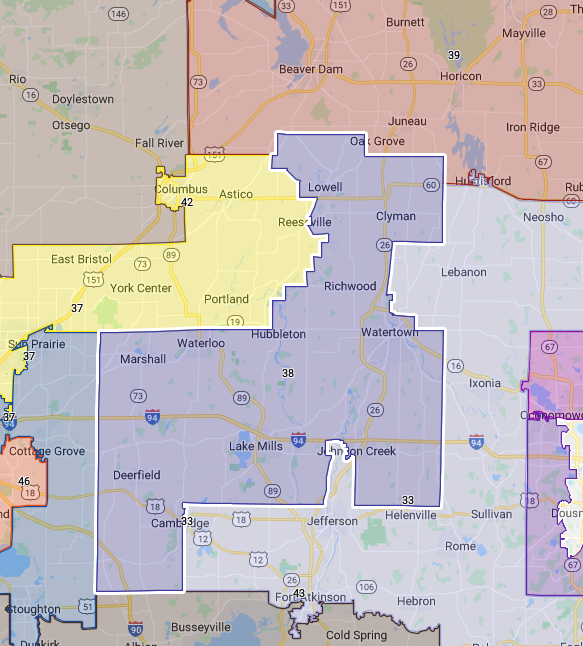
A map shows Assembly District 38 using maps as proposed by Gov. Tony Evers.
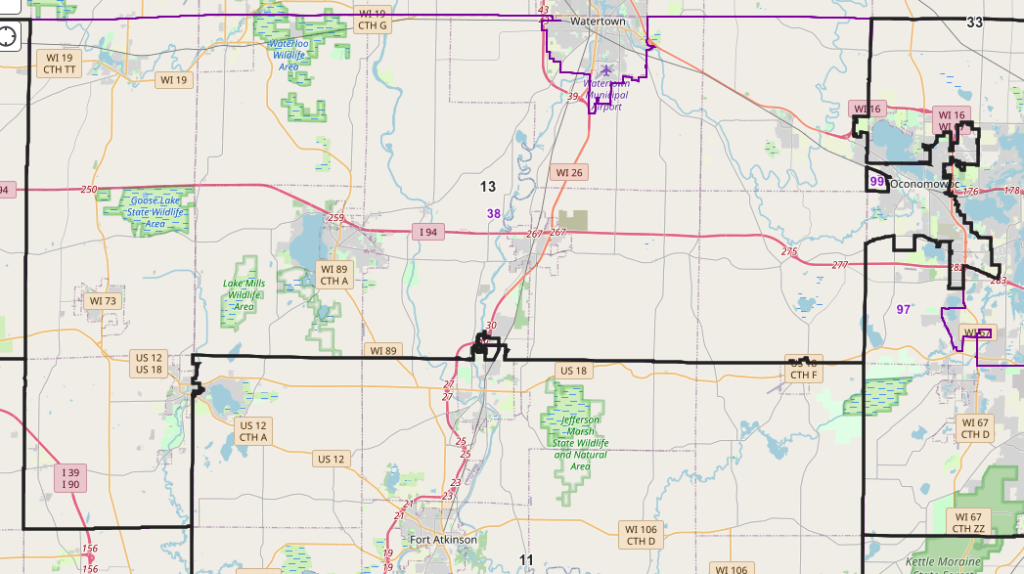
A map shows Assembly District 38 as drawn by the Legislature. The map was adopted by the Wisconsin Supreme Count on April 15 for use within the state until 2032. The district extends from Dane County, across northern Jefferson County, and into Waukesha County.
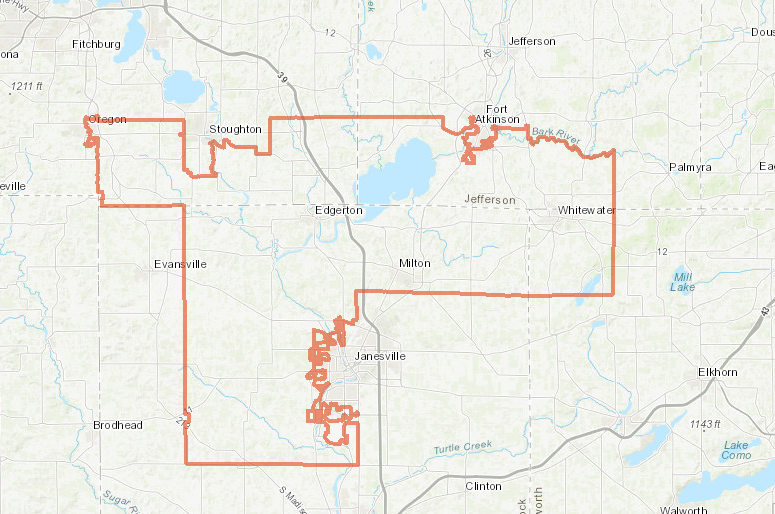
A map shows Assembly District 43 before the February Wisconsin Supreme Court ruling.

A map shows Assembly District 43 using maps as proposed by Gov. Tony Evers. The map shows virtually no change between the district’s borders drawn before and after the February ruling made by the Wisconsin Supreme Court.
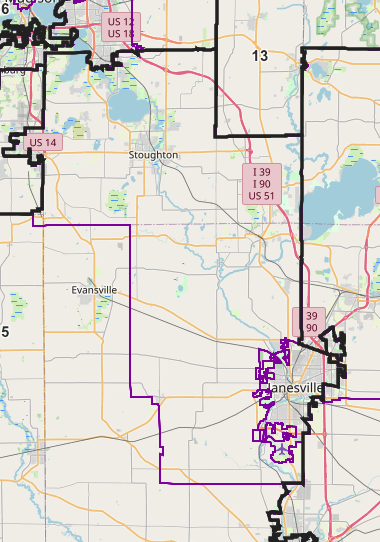
A map shows Assembly District 43 as drawn by the Legislature. The map was adopted by the Wisconsin Supreme Count on April 15 for use within the state until 2032.

A map shows Senate District 11 before the February Wisconsin Supreme Court ruling.
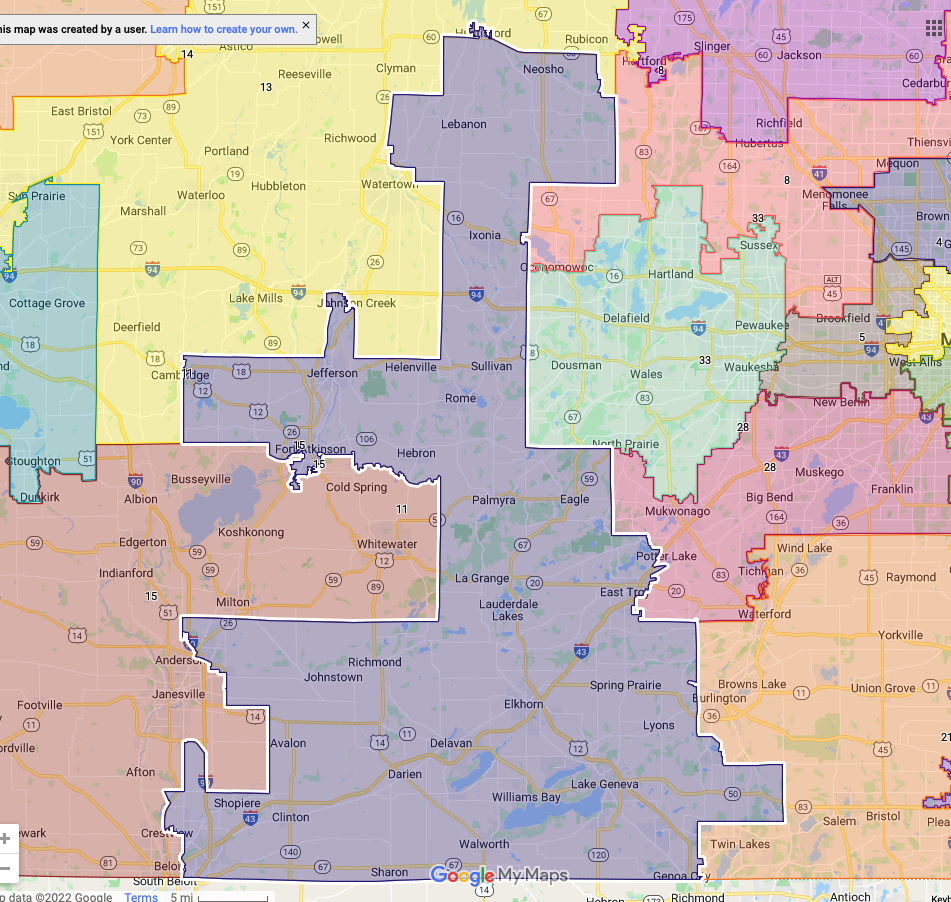
A map shows Senate District 11 using maps as proposed by Gov. Tony Evers.
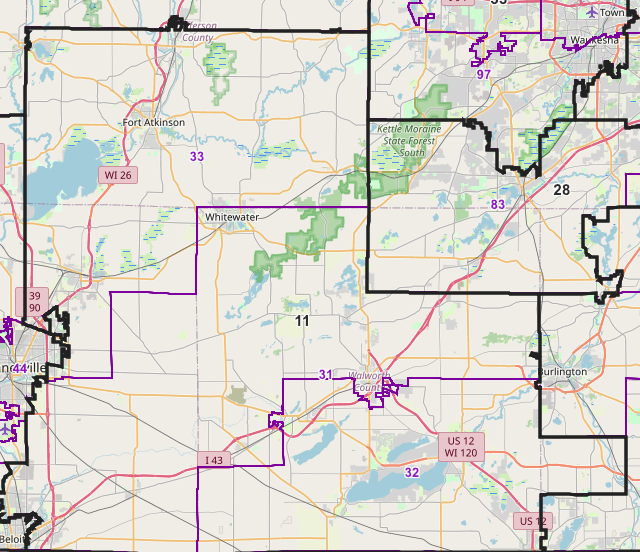
A map shows Senate District 11 as drawn by the Legislature. The map was adopted by the Wisconsin Supreme Count on April 15 for use within the state until 2032. In February, changes made in Wisconsin Senate District 11, represented by Sen. Stephen Nass, R-Whitewater, largely mirrored changes made in Assembly District 33. The senatorial district contained Assembly Districts 31, 32 and 33. Maps adopted on April 15, show, in part or full, the following communities included within the district: Jefferson, Helenville, Sullivan, Fort Atkinson, Hebron, Palmyra, Whitewater, Milton, Avalon, Elkhorn, Delavan, Johnstown, Richmond, Darien, Clinton, Sharon, Williams Bay, Lake Geneva, Fontana, Walworth, Beloit and Genoa. The senatorial district continues to include Assemble Districts 31, 32 and 33.

A map shows Senate District 15 before the February Wisconsin Supreme Court ruling.

A map shows Senate District 15 using maps as proposed by Gov. Tony Evers.
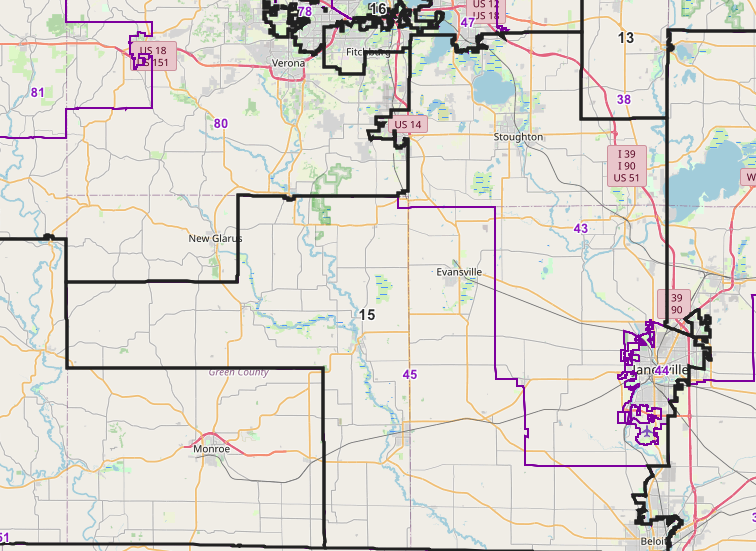
A map shows Senate District 15 as drawn by the Legislature. The map was adopted by the Wisconsin Supreme Count on April 15 for use within the state until 2032. In February, changes made in Wisconsin Senate District 15, represented by Sen. Janis Ringhand, D-Evansville, were virtually unchanged. The senatorial district contained Assembly Districts 43, 44, 45. Maps adopted on April 15, show, in part or full, the following communities included within the district: Oregon, Stoughton, Brooklyn, Edgerton, Janesville, Footville, Orfordville, Brodhead, Albany, and Evansville. The senatorial district continues to include Assembly Districts 43, 44 and 45. Ringhand has announced that she will not be seeking another term as a state senator.
Zimmerman to run for Assembly District 31 seat
(Originally published April 20, 2022.)
Editor’s note: information below has been provided by a political candidate announcing her intention to run for office. Other candidates wishing to run for political office will have equal opportunity to announce their intensions.
The “Maryann Zimmerman for Wisconsin State Assembly” campaign has announced that its candidate will be running for the open seat within District 31.
According to information released by the campaign, “The Wisconsin Supreme Court’s reversing its previous decision to use the Republican district map instead of the map submitted by the Governor Evers’ administration resulted in Maryann Zimmerman (Republican), a first-time state candidate becoming ineligible for the Senate race in the 15th district.
“Rather than give up, Zimmerman changed gears.”
“I am a public servant and I know I have the expertise, work ethic and fortitude to serve my community well in the State Legislature,” Zimmerman was quoted as saying in the announcement.
The release continued: “Zimmerman is no stranger to serving her community, since moving here eight years ago, she has served as a member of the Whitewater Unified School District School board and a State of Wisconsin Parent2Parent Advocate. (Zimmerman’s) role as a Parent to Parent Advocate includes acting as an advocate, mentor and friend to parents of children with special needs. (Zimmerman) is also a member of the Equal Opportunities Commission and the Disability Rights Commission for the City of Whitewater. Professionally, Zimmerman has been the director of the Walworth County Food and Diaper Bank, a compliance officer for a local manufacturer as well as presenting at a national conference on poverty and basic needs for women. Zimmerman is also a certified six-sigma black belt. She and her husband are small business owners.”
According to the release, Zimmerman lives with her family on a hobby farm in the town of Whitewater. She is one of eight siblings who grew up in Milwaukee and Glendale.
She is excited to travel to the communities within the 31st district to meet constituents gathering the needed signatures to be featured in the August primaries, the release stated.
Within the release, Zimmerman said: “I love to interact with people so please come and say, ‘Hi’ when I am in your area. I truly have an open-door policy and welcome your input, feedback and ideas.”
Outlining her view of the district in an email, Zimmerman wrote: within the district there are struggling small businesses; school districts that are struggling to make their budgets work; a housing shortage; a need for more manufacturing and agricultural jobs, and “assurance that our freedoms will be protected regardless of emergency situations.”
Under goals, she listed: introducing bills for SMART grants to our public school systems; supporting universal school choice; promoting racial unity; drafting bills that give tax breaks to new small businesses and foster strong relationships with community; and developing educational and business leaders to attract and keep citizens in the community.
Zimmerman wrote in her announcement that, would she be elected to the Assembly, she does not plan to step down from her position as a school board member in Whitewater, stating: “Serving on my local school board has been an amazing experience. I have learned a lot and being allowed to serve my fellow neighbors, friends and parents has been an honor.”
The 31st Assembly District includes Elkhorn, Whitewater, Darien, Clinton, Parts of the city of Beloit and the town of Beloit and up to Burlington, along with rural areas, the release noted.
For more information, visit: www.maryann4assembly.com, or call: 262-753-1063.

Maryann Zimmerman
Walworth County Sheriff: 11 named in alleged drug trafficking conspiracy
(Originally published April 22, 2022.)
The Walworth County Sheriff’s Office and the Walworth County District Attorney’s office — on behalf of the Walworth County Drug Enforcement Unit and the Milwaukee office of the Bureau of Alcohol, Tobacco, Firearms and Explosives (ATF) — announced Thursday that on Monday the district attorney’s office filed criminal complaints agains 11 suspects whom, the complaints allege, have conspired to deliver over 500 grams of Methamphetamine.
According to information released by the Walworth County Sheriff’s Office, the suspects are alleged to have conspired for a period of 11 months, which concluded in August of 2021.
The complaint names the following suspects:
Kenneth W. Chadwick, age 54 (Phoenix, AZ)
Krystal D. Gehrke, age 36 (Racine, WI)
Shauna M. Gonzalez Garza, age 35 (Burlington, WI)
Jillian R. Leighton, age 38 (Burlington, WI)
Michelle A. Lyons, age 43 (Lake Geneva, WI)
Sean M. Mason, age 44 (Elkhorn, WI)
Christopher F. McFadden, age 35 (Waterford, WI)
Joshua C. Potter, age 33 (Whitewater, WI)
Thomas D. Schultz, age 33 (Elkhorn, WI)
Frederick M. Taylor, age 46 (Burlington, WI)
Brian N. Tidwell, age 37 (Elkhorn, WI)
The release reads: “The alleged involvement of these individuals ranges from street level dealing to transporting large amounts of Methamphetamine from Arizona to various locations in Southeastern Wisconsin, including Walworth County.
“The investigation involved conducting controlled buys, monitoring calls, writing subpoenas and search warrants, conducting surveillance, and obtaining statements from associates and coconspirators.”
“This investigation is an example of what is achieved when dedicated investigators from many law enforcement agencies work together across jurisdictions with a common goal to keep our communities safe,” Walworth County Sheriff Kurt Picknell was quoted as saying in the release.
The release directs those interested in learning more to look for changes and updates involving the case on the Wisconsin Circuit Court Access website: wcca.wicourts.gov.
Agencies lending expertise or involvement in this action include: the Walworth County Drug Enforcement Unit; ATF- Milwaukee; ATF- Flagstaff, Arizona; Drug Enforcement Administration (DEA) – Milwaukee Office; United States Postal Inspectors; Wisconsin Department of Corrections; Kenosha County Sheriff’s Office; Racine County Sheriff’s Office; Rock County Sheriff’s Office; City of Burlington Police Department; City of Lake Geneva Police Department; City of Elkhorn Police Department, and the Village of East Troy Police Department.
“Pursuant to the directive of the Wisconsin Supreme Court, as found in Supreme Court Rule 20:3.6, Trial Publicity, you are advised that a charge is merely an accusation and that a defendant is presumed innocent until and unless proved guilty,” the release stated.

File photo/Walworth County Sheriff’s Office.
Women of Whitewater: A legacy of earning a seat at the table
(Originally published April 23, 2022.)
Editor’s note: I’ve worked with Whitewater City Clerk Michele Smith at various times throughout my reporting career, and during that time, I’ve come to understand that she’s a researcher at heart. When she contacted me recently, sharing these words: “I dumbfoundedly discovered that Whitewater had a female council member in 1923. I stumbled upon it by accident, incorrectly thinking that Bettijane Partridge was the first council member,” I was not surprised. Her interest was piqued and as she researched, she made further discoveries, among them that Whitewater has been embracing women as council members for decades, and the city’s most recent election continues the trend. Smith dubbed her research “WOW” or “Women of Whitewater.”
By Kim McDarison
As election results developed on April 5, Whitewater City Clerk Michele Smith, an employee with the city of Whitewater since 1994 and serving in her capacity as clerk since 2000, noticed something somewhat historic: “For the first time ever,” she wrote in an email, “we will have a majority of women serving on the common council.”
As of April 19, with the recent election and installation of Jill Gerber, the council, which is a seven-member board, has four councilwomen. In addition to Gerber, they are Carol McCormick, Brienne Diebolt Brown and Lisa Dawsey Smith, who, during Tuesday’s meeting was elected as council president.
For Michele Smith, the phenomenon triggered her curiosity: she wanted to know more about Whitewater’s women and when they might have begun serving on the city’s legislative body.
Poring through old stories found in the Whitewater Register, the city’s historical paper of record, Smith made several discoveries. Among them, she found that the city’s first councilwoman was elected in 1923. Her name was Mathilda Case Fowler. She served the city for two terms.
Of Fowler, Smith wrote: “I do not intend to research all female council members this close. It is just that I had an incredible curiosity about our first trailblazer.”
As her research developed, Smith found three more trailblazers, women who were elected to seats on the city council, following Fowler, between 1968 and 1974.
From Smith’s research, their stories emerge.
Mathilda Case Fowler
Sharing her discoveries, Smith wrote: “Whitewater’s first female council member, Mathilda Case Fowler, was elected in April of 1923 — pretty progressive for the times. In fact, Mathilda served as council president in 1924 and was reelected one more term.”
Documentation, offered through various news stories printed in the Register, brings a sense of the woman and the times in which she served as a councilwoman. In January of 1922, the register reported, “a second edition of the Woman’s Number of the Whitewater Register,” known as “Federation Register,” made a “formal bow to the public,” with the editors further noting, “It will be edited by us with a great deal of pleasure and we trust that it will be perused with no little pleasure by our readers.
“That it will be a great paper needs hardly to be stated. Indeed we may safely say that its like has not appeared since the woman’s paper was presented to the public two years ago.”
The editor’s promised the new edition would be teeming with “literary gems, unusual cartoons, unusual humor, unusual pathos and many other unusual features.”
The person revealed as editor-in-chief was Mathilda Case Fowler. She would be aided in her pursuit by several women, according to the announcement.
In April of the following year, the register was focused on the spring general election, noting in a headline: “Voters Establish a Precedent by Placing a Woman on the Council.”
The story initially focused on a hard-fought race for the position of mayor, claiming it brought “the biggest vote ever cast in a local election,” and next revealed that a woman who, just 15 months earlier, had been heralded as a harbinger of the unusual, had earned a seat on the city council.
The Register reported: “Probably the greatest interest outside of the mayoralty contest centered in the second ward where a lady, Mrs. Mathilda Case Fowler was running for alderman in opposition to Albert M. Hanson.”
The paper offered solace to Hanson, having lost to a woman, and lauded Fowler as not only a novelty in aldermanic office, but someone who was “sure to meet the responsibility with credit to herself and her sex.” Of Hanson, it was reported, “he was a victim of circumstances and that the vote in no way reflects any criticism of the faithful way he has served his constituents on the city council.”
After Fowler won her seat, the Register noted, the council chamber was populated with “scores” of people, both men and women. They arrived to hear from the mayor, but also to honor Mrs. Mathilda Case Fowler, the first woman to serve on the council.
“When she took her seat, she found it occupied by a vase filled with roses, a gift of Whitewater ladies, all of whom are her well wishers,” the Register read.
The news of Whitewater’s first councilwoman even reached the Capital Times. In 1923, an editorial in the paper reported “Whitewater, one of the few communities which gave the conservative candidates a majority in the recent fall election, has come out for clean, progressive politics by electing a La Follette supporter for mayor, and re-electing two La Follette men as aldermen … the honors in the second ward go for the first time to a woman, Mrs. Mathilda Case Fowler, who was elected by a large majority over her opponent.”
In the two terms that followed, Fowler made her mark on the city. In 1923, she was present at “our informal homecoming,” which a Register story proclaimed, was a success noted by those who were in attendance from Whitewater, Chicago and “elsewhere.” Those who attended had an opportunity to “meet old friends” many of whom came by train, which, the story noted, was late in its arrival.
A special car was provided to carry officers from the Whitewater-Chicago Club, the organization credited in the story with the “idea of coming back in a body,” and while those passengers were an hour late, “the crowd stuck.”
Once the passengers arrived, conversations began, the band played, and an auto parade assembled to convey guests to a picnic.
“Thanks to Mrs. Mathilda Fowler, upon whom devolved the responsibility of getting the townspeople and lunches together at the proper time and place,” the Register reported, adding that “lunch was served cafeteria style and the various groups consumed what they could, seated on the ground under the trees.”
In yet another Register story, published in 1923, Mrs. Mathilda Fowler was credited with scoring a scoop for her Beloit paper. The story noted that “Alderman and Mrs. J. H. Dunham have in their possession a lemon tree that is a rare specimen in this locality.” The tree, according to the story, was then 25 years old.
Reporting the success of the gardener, the story noted: “It has been a custom to house the tree winters in the basement, but this season, Mr. Dunham has placed it on exhibition in his place of business.”
The exploits and successes of Mathilda Fowler did not end there. In a story published in the Register in 1924, it was reported that Mrs. Fowler, the only woman member of the council, was elected as the body’s president.
In April of 1924, the Register reported, Whitewater two months earlier, had come into some luck: “At a meeting of the National Parks Highway association … it was decided that the route of the National Park Highway should pass on Route 12 through Whitewater.”
With new travelers likely heading to town, there was talk of becoming prepared with a “modern tourist camp.”
Thinking ahead, according to reports in the Register, Mathilda Fowler was already making plans: “Working very happily with that situation is the undertaking of Mrs. Mathilda Fowler to make a small park and perhaps camping spot on the tract of playground property back of the Old Stone Mill.” The land reportedly belonged to the Whitewater Play Ground Association. Association officers had expressed their willingness to turn the property over to the city for park purposes, the Register reported, and Fowler, the report continued, was preparing a resolution to bring before council “providing for just that move.”
In February of 1925, the Register reported: “‘They say’ that Will Fricker is to run for Alderman against Mathilda Fowler…”
The paper later reported: “Mrs. Mathilda Fowler is apparently to go back to council from Ward 2 without a struggle.”
There was some opportunity, the paper had earlier reported, for Fowler to meet with competition for her seat, but then, the paper confirmed, “the unexpected” occurred when a last minute candidate emerged for mayor: William Fricker, whom, the paper had been supposing, “was aiming at supplanting Mrs. Mathilda Fowler on the city council.”
In a story published in 1925, it was reported that Fowler was reelected to a second term.
For Whitewater, having the first woman serving on council in the area was a source of pride. A story in the Register offered an item it had picked up from the Walworth Times, which noted that there was reporting in the Janesville Gazette that Mrs. Emma Manning was the only woman alderman in the state. The Times reported: “Whitewater refused to tolerate this misinformation … Mrs. Mathilda Case Fowler is Alderman from the second ward and has not only served an entire term, but was re-elected.”
In March of 1927, according to the Register, Fowler announced that she would not seek a third term.
The paper reported: “That much is definite at least and will bring joy to those who found her difficult to manage and sorrow to those who have followed her unselfish effort to do at all times what was best for this community.”
In 1928, it was reported that Fowler had written “a readable column covering the high spots in Whitewater’s 1927 history” which was published in the Beloit New Year’s edition.
In 1929, Fowler was chosen as City Federation of Women’s Clubs president. Fowler, it was reported, was also a member of the Emerson Club and a graduate of the University of Wisconsin, class of 1904, and “thereafter taught English in the West Division High School, Milwaukee, until she married H. A. Fowler and moved to Whitewater.”
Bettijane Partridge
As her research developed, Smith wrote: “No more female council members for around 40 years, until in 1968, Bettijane Partridge, who lived in the Hamilton House on West Main Street, was elected to Council. Bettijane was a short-time council member, serving only a couple of months. Her husband was offered a job in Florida and they left Whitewater in early fall of 1968.”
On April 3, 1968 the city’s board of canvassers announced that a woman, Bettijane J. Partridge, won her race for a seat in the city’s Fourth Ward. She defeated her opponents by no small margin, garnering 299 votes of the total 722 votes cast within the city’s Fourth Ward. Her opponents, all of whom were men, each earned 21, 23, 66, 92, and 221 votes respectively, with Paul E. Miller, as her closest contender.
Elizabeth Wright
Smith wrote: “Whitewater’s third councilwoman was Elizabeth Wright. ‘Lizzy,’ as she was called at that time, lived at the corner of East Milwaukee and Dann streets. She was well known for her ‘East Gate Garden,’ which, during that time period, was unusual and something to behold. Gardening and flowers were not as plentiful in those days. Lizzy was a local historian and was regularly the subject of newspaper articles.”
The general spring election, held April 7, 1970, according to the Whitewater Register, brought four new faces to the city council, one of which belonged to yet another woman, Mrs. Elizabeth Wright. She, the story noted, was the curator and former president of the Whitewater Historical Society and had previously served on the Whitewater School District Board of Education.
According to the story, newcomer Wright earned 137 votes against her opponent, also a newcomer, who earned 75. Both were running for a seat representing the city’s First Ward. Her opponent was Charles. E. Boelkow, an owner of Boelkow Construction Co.
Among the many things Wright might have become known for, a story in the Register presented within the “It Must Be So” column written by C.B. Coe, told a fishy story: it read: “Would you believe — that on the opposite end of our city the high water impounded back of Councilman Elizabeth Wright’s has sported several carp on occasion and one of the big lunkers frolicked in the deeper portions with a balloon attached to his dorsal fin that said, ‘Keep Smiling.’”
Rosemary Green
Introducing the fourth councilwoman, Smith wrote: “The next councilwoman was Rosemary Green. Rosemary is alive and well and lives at Blackhawk Manor … She remembers the city attorney calling her ‘girlie’ on a regular basis. After reading some of the Whitewater Register articles, it seems like Rose may have had some tough times being a female on council. Rose recalls the most controversial subject of those times being the Vietnam war.”
Green held a council seat for one term, between 1974 and 1976.
In 1974, a Register headline noted: “Coburn, Green, Loizzo, Keshemberg On Council.”
The story placed for the record the exploits of that year’s election, noting that incumbent James Coburn and three newcomers, Rosemary Green, Samuel Loizzo, who was a University of Wisconsin-Whitewater student, and Claude Keshemberg would serve the public as councilmen for the next two years.
The story noted that about 26% of the city’s registered voters arrived at the polls, some 1,514 in all. In the Fourth Ward, Green won narrowly, defeating Daniel O’Sullivan, 160-149, according to the report.
During Green’s tenure, in Whitewater, campus-related issues arose. A 1974 Register headline read: “Student Grievance Aired Before Council Thursday.” The story told of a special session called by Coburn and Green. The topic, the paper proclaimed, “involved city police in a UW-Whitewater dormitory.
“It was alleged at the meeting that city policemen had ordered a resident assistant to open a locked room in Lee Hall so that a suspected article of contraband could be removed.”
According to the account, the resident assistant called another student and then complied with the police officers’ request. Removed by officers was a McDonald’s pennant. While some consternation developed about whether the city police had an ability to confiscate property from within a campus building, the Register reported, having interviewed City Police Chief Don Simon independently, that while he responded with “no comment on the matter,” he did say “that the investigation would continue into the possibility that the pennant confiscated on October 17 was stolen.”
In 1974, Among projects Green supported was an addition to the city’s library. Council was considering a $400,000 addition “in the near future,” the Register reported, which would house a council room and court chambers.
In a meeting that followed, however, the Register reported that council support for the project was “eroding.”
“A changing economy was a factor” in at least one councilman’s decision to vote against the concept, the Register noted, further describing Green as one of the library’s “strongest proponents.”
Even as support waned, Green was reported to have said that she was “still convinced that an addition would be in the best interest of the community,” and she was quoted as saying: “The library is more popular during hard times.”
In 1974, zoning issues also were on the city council agenda. In a story in the Register, a lede read: “The chances for McDonalds Corporation to build a restaurant in Whitewater were apparently ended Tuesday night when Council voted against a rezoning of the Miller property at 1041 W. Main Street.”
Green was among council members voting against the rezone. She was joined in that decision by Council President Thomas McLeRoy and Clarence Haize. The required three-quarters majority needed to pass the rezone fell short by a single vote, the Register reported.
Council today
Today, along with newly elected councilwoman Gerber, a majority of decision-makers who are women are comprised on council by McCormick, Diebolt Brown and Dawsey Smith, all of whom were last elected to seats, serving in Aldermanic Districts 1, 3, and at-large, respectively, in 2021. Their terms expire in 2023. Gerber holds a seat in the city’s Aldermanic District 4, which was previously held by Lynn Binnie. The seat will next come due in 2024.
Men on the council include Lukas Schreiber and Jim Allen, both of whom were reelected as incumbents on April 5. Schreiber serves in the city’s Aldermanic District 2 and Allen serves at large. Both seats will next come due in 2024. Gregory Majkrazek, who serves in Aldermanic District 5, will face reelection in 2023.
As she prepared for the April 19 council meeting, during which members elected on April 5 were installed and the historic Whitewater event of having a majority of women seated on that body took shape, Michele Smith wrote in an email to council members: “Congratulations Jill Gerber, Lisa Dawsey Smith, Carol McCormick and Brienne Diebolt Brown for being members of the first Whitewater council managed by a majority of women. As they sang in the commercials when I was approximately 12 years old, ‘You’ve come a long way, baby.’
“Enjoy your seat at the table.”

As of the April 5 spring general election, Whitewater councilwomen Lisa Dawsey Smith, from left, Brienne Diebolt Brown, Carol McCormick and Jill Gerber, who is not pictured, comprise, for the first time in its history, a majority of women on the city’s seven-member legislative board. Gerber was installed as a new council member during Tuesday’s City of Whitewater Common Council meeting after which Dawsey Smith was elected by the board as president. Kim McDarison photo.
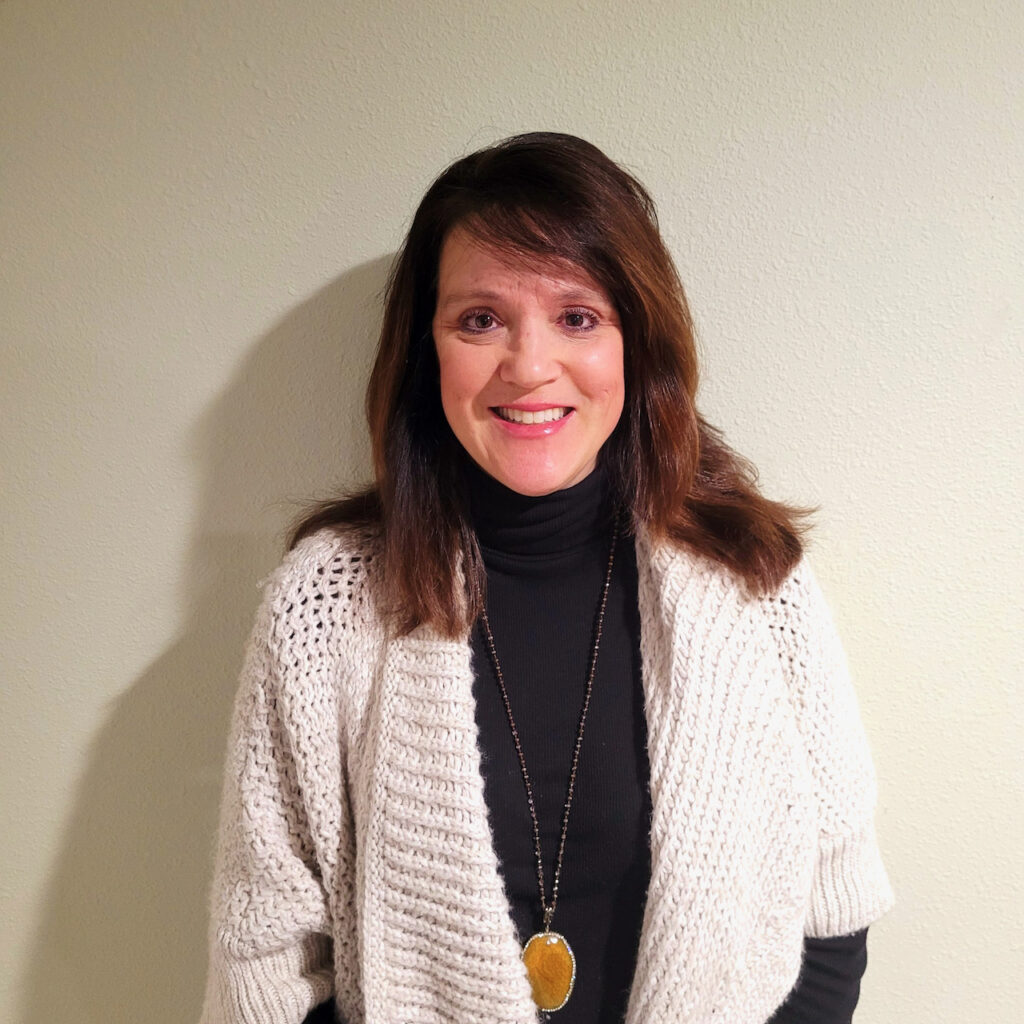
Elected on April 5 to an Aldermanic District 4 seat on the City of Whitewater Common Council, Councilwoman Jill Gerber took the oath of office Tuesday. Her addition to the council gives the board for the first time in its history a majority of women. Contributed photo.
Kellyanne Conway at UW-Whitewater: ‘If you build it, they do come’
(Originally published April 28, 2022.)
By Kim McDarison
Donald Trump’s campaign manager during the 2016 election Kellyanne Conway addressed some 200 students and members of the public Wednesday on the University of Wisconsin-Whitewater campus.
The event was held in the Timmerman Auditorium, Hyland Hall. The presentation was part of the Robert and Patricia Herbold Lecture Series.
Conway’s appearance was made possible with support provided by the Republican Party in Jefferson and Walworth counties, along with the Young America’s Foundation, a group associated with former Wisconsin Gov. Scott Walker. Conway was hosted on campus by the UW-Whitewater chapter of the Wisconsin College Republicans.
Conway shared her experiences related to the 2016 campaign as well as her political views, spanning from women’s issues, which she said was a euphemism for abortion, to the recent purchase of Twitter by Elon Musk, whom she described as a genius, noting the he would make Twitter “fun again, and free again, and fair again.”
Though the event began 30 minutes late, Conway was greeted with enthusiasm when she reached the podium.
She was introduced by John Beauchamp, chairman of the Whitewater campus Republicans, who described America as “deeply divided,” noting that he found it evident with each passing day, that values and ideals shared by conservatives were being met with “an ever-increasing blockage.”
“We find ourselves shouted down, and shut up, but we will not be silenced,” he said.
Conway began the program by telling those in attendance that she had taken a call from Trump as she journeyed to campus.
He asked, “How’s Wisconsin doing?” she said, and “Do they like me there?”
She next addressed some of Beauchamp’s comments, saying, she, too, while in college had experienced similar blockages when she and a friend sought to establish clubs for both the Democratic and Republican parties on their Washington D.C. campus.
Conway said when she returned to America after a year studying abroad, she discovered that her campus had no Republican or Democratic clubs.
“It didn’t make sense to me,” she said, adding, at the time she thought: “There have to be people like me on both sides of the aisle who, in part, chose this college because it’s in Washington D.C. — it’s in the nation’s Capital, where there are internship opportunities and Congressional or Supreme Court opportunities, to go to and witness and absorb.”
Conway said when she and her friend went to establish their clubs in advance of the 1988 presidential race — her friend, looking to establish the Democratic club, and she, looking to establish the Republican club — she “ran into problems that the college Democrats did not.
“We couldn’t find a single faculty member to be our advisor. And to be recognized by the school, by the college, and to have access to any type of resources — a couple dollars here or there to have an event or maybe some refreshments, or, of course a speaker’s fee, a pot for the speakers — we had nothing like that.”
Conway noted that a professor, Ira Reed, stepped forward to become the club’s advisor. While the professor was not a Republican, Conway, relating his comments, said: ‘I think that your right to assembly and to speech is much more important than my political beliefs.’ with Conway adding: “And I will always be grateful to him for that because by the time we graduated, a year and a half later, the college Republican club was the largest club on campus.
“And we are right back there a couple of decades later.”
For Whitewater’s college Republicans, Conway said, the lesson was two-fold: “It tells you that, number one, that if you build it they do come. And it tells you, it really suggests, how many people are open to that message that you don’t even realize in your circle of life.”
Conway said: “Lots of them sound conservative, they just call themselves something else.
“Number two, it tells you something else; it tells you that all you need to know about why the hard left wants to stop you, and take out your voice box, and make you look the other way when you see injustices against conservatives and free speech, … They’re afraid … Because you are on the right side of so many issues.”
Among issues which Conway said Republicans were “on the right side,” were those of “school choice, charter school opportunities, scholarships and educational freedom. And you know what? You know who agrees with you now who maybe three years ago did not? Maybe three years ago they hadn’t thought much about it. Many parents, because for two school years, screen time became school time. And they know better. They know screen time is not school time.”
Conway said focus groups showed that parents were frustrated.
“It wasn’t just critical race theory, or masks on little kids, it was actually a larger issue as everybody bought into March to June of 2020 — get off of campus and stay home, try to slow down the spread — but then we had a fairly good summer, and then the next school year they started saying, ‘oh, I’m sorry, you have to start on a new year again.’ And parents knew which political party wanted that and which one did not want that.”
It was a “bright line” distinction, she said. “People are paying attention. You’re on the right side of that,” she added.
“Critical race theory is a very important issue. We should teach kids to love America not to hate America, and each other; it’s very simple. And of course we shouldn’t have masks on second-graders, outside on the playground, in 2022,” Conway said.
Conway told students to embrace what she saw as a nationwide and Wisconsin opportunity to spread a Republican message.
“It’s actually your opportunity because you have something I’ll never have again: a future. You’ve got more of the future than anyone else around.”
Conway next commented on religious freedom, saying: “And speaking of God, we like him. We want to respect people’s religious freedom, their liberty. I’m very proud to have worked for a president who’s the first president in the history of the U.S. to go to the United Nation’s general assembly in September of 2019 and give a major speech on religious liberty …”
During that speech, Conway said, Trump called upon all people from large countries, like China, and individual citizens found in public squares, saying: “the first right that each of us has is our right to practice religion freely and as we wish. And that is under attack every single day.”
Addressing the topic of border security, Conway said: “Do you realize more Americans and Wisconsinites now say that immigration and border security is a more important issue to them than when Donald Trump was the president?”
She added: “This country has spent billions of dollars over decades to protect the borders and the sovereignties of countries all over the world. Is it so difficult to want to protect our own sovereignty and our own borders?
“And Donald Trump is right. If you don’t have a border, you don’t have a country.”
Conway talked about deaths in America due to Fentanyl, citing the drug as the leading cause of death in America for people ages 18 to 44.
She said the former president and first lady, Melania Trump, worked on policies to address that issue.
“Prevention, education, treatment, recovery, law enforcement, intervention, the two political parties were always doing one or the other,” she said, adding that the Trumps did them all.
Trump signed into law in 2018 “the largest single piece of legislation on any one drug crisis in our nation’s history,” Conway said, citing the effort as bipartisan, further noting that “every single Democrat voted for it … You probably never heard that before because it doesn’t fit the narrative.”
“Now the latest numbers under Joe Biden: 106,000 overdose deaths. It’s just unacceptable, ladies and gentleman,” she continued.
“When you hear of one death, It affects hundreds of lives. And the government has a lot of resources: time, talent, treasure, we can do better, you deserve better,” she said.
Conway next said she wanted to talk about Wisconsin.
In 2016, she said, Trump asked her to be his campaign manager, and after she agreed to take the job, she said, they talked about Wisconsin.
Conway shared the importance in 2016 of Wisconsin as a swing state, noting that her professional career as a pollster enabled her to travel to 50 states doing research.
“So I respect the central wisdom of the American people,” she said, adding that the American people bring “the best responses,” because “you think about these things everyday; you’re living through them. If we put you in charge and took your representatives out, in Washington, or Madison, I mean if we put you in charge for a couple days, things would look measurably different. We know that.”
Conway said she advised her candidate of “the blue wall.”
The term is used by political pundits to describe 18 U.S. states and the District of Columbia that the Democratic Party consistently won in presidential elections between 1992 and 2012
Conway said she told Trump: “I very much believe the blue wall is real. The blue wall of course begins and ends here in Wisconsin.”
In 2016, she said she told Trump: “Hillary (Clinton) had the benefit of the blue wall. I said, we have to bust through the blue wall, and this is also where I recommended (then) Governor (Mike) Pence or (then) Governor (Scott) Walker as his running mate, because I very much believed that you have to go to the Midwest or the rust belt — the upper Midwest or the rust belt — and find somebody who is known there, who has governed there, who understands the issues there, and put them on the ticket.”
Conway said she advised the candidate to focus on the 10 or 12 states that the Obama/Biden campaign carried with 50% of the vote, twice, and where Hillary Clinton was, in 2016, “nowhere over 50% and staying there in any legitimate polls.”
Also important about Wisconsin, she said: the state elected Republicans down ticket, including a senator and governor, even while Barack Obama was president.
“That’s the key to this; you’re not allergic to Republicans,” Conway said.
Conway next described a meeting in a Trump Tower conference room. Trump was not there, she said.
“Katie Walsh, who was chief of staff to RNC (Republican National Committee) Chairman Reince Priebus at the time, another Wisconsin favorite son, did this big presentation. We had about 30 people around. She said, ‘Kellyanne we just want to give you the benefit of the data and the modeling … She said, I hate to say this … and I know that you’re new to this job, but if I were you, I would consider pulling out of Virginia.’”
She advised instead that the campaign focus on Wisconsin, Conway said.
“I said: so what’s going on in Wisconsin. I love Wisconsin, but we are way behind there.”
Conway said Walsh told her that “Wisconsin will always have a big footprint … because the Speaker of the House Paul Ryan is from Wisconsin, the chairman of the RNC Reince Priebus is from Wisconsin … Scott Walker’s elected three times in five years and whatnot, and … the most competitive senate seat this year, Ron Johnson’s, — sound familiar? — in 2016, is in Wisconsin. So she said we will always have a footprint there.”
Conway said she filed the information in her mind, and remembered it when she received several calls from Wisconsin Gov. Tommy Thompson, who invited the campaign back to Wisconsin during the 2016 election.
In 2016, Trump won Wisconsin, Conway said. She asked the audience: “What’s the secret sauce?” She answered: “Just showing up. And standing up, and speaking up. And doing what Hillary Clinton didn’t do. She was playing around in Georgia and Arizona and Texas.”
Said Conway: “The country is divided — I got it, but this country was founded on that, and we’re resilient. We’ll survive that. Democracy will survive, America will survive. The question is how do we make conservatism thrive?”
Her answer: “You do that through policies and ideas; policies not personalities; principles more than politics; ideas more than any one individual.
“There’s a reason why presidents are term limited. There’s a reason we’re all term limited.
“These ideas, these principles, we need them to be timeless and survive all of us. And now is really the time that you have people’s attention. They are suffering, they’re angry with the Biden administration. Young people are abandoning it. In the latest poll, it shows his approval rating among young people has gone down 19 points from a year ago.
“Do you know what that’s called? Causation, not coincidence. Just like when I looked at Kamala Harris’ approval rating and it was 28%.
“She earned it. She earns it everyday.”
Conway addressed what she said was described in the media as “chaos” in the Trump White House.
“Chaos, there’s chaos. Chaos in the Trump White House. Here’s our chaos correspondent to tell you more about the chaos in the Trump White House,” she said, asking: Chaos is where? In a tweet?
“Now there is chaos everywhere you look,” she said.
“There’s chaos in Ukraine and worse — chaos at the border, chaos at the gas pump, chaos in the grocery store, chaos in the supply chain. Chaos in these increases in crime. (It’s) in major cities, including here in Wisconsin; chaos at the ballot box.”
She scoffed at those who questioned Trump’s stability.
Of Biden, she said: “He has a trifecta of negative polling. The country has lost confidence in his competence, completely. Even CNN and the NBC polls show that.”
She cited his disapproval rating as over 60%.
Said Conway: “He’s why I think young people are leaving Biden and the Democrats right now. It’s not because their major leaders are all sort of old white people, like Biden and Bernie Sanders and Chuck Schumer and Nancy Pelosi, and Hillary Clinton … Apart from the fact that they’re smart, young people call themselves Independents more than Republicans or Democrats. So what does it mean to be Independent? It means you don’t really trust politicians and the government. Everyone’s part of the problem and not the solution.”
Conway said those identifying as Independent, in her opinion, are looking for options. Independents, she said, are “open to hearing about ideas.”
Looking at the mental health of the American people, she said, people are struggling.
“We know why that happened. To say nothing of life interrupted with academic progress and careers and of course there was a poll released this week saying that all the financial burdens now have prevented young people from doing a lot of the things they want to do — that they freely want to choose to do. Buy their first home, or condo, and maybe go to graduate school, maybe saving or investing, and it’s all because of this; it’s all because of this.
“And it will be better because you are better. You deserve better, and now’s the chance for you to bring this message to some of the other people who are truly open to it.”
Looking at opportunities for messaging, she said: “The genius Elon Musk bought Twitter. Which means Twitter will be fun again, and free again, and fair again. And I know a thing or two about Twitter. I know a thing or two — two major men in my life love to tweet. Which means I don’t.”
Conway said she was asked on many occasions to stop Trump from tweeting.
“They told me this during the campaign, they told me this during transition, they told me while he was president, they told me when he wasn’t president,” she said, adding that recently Trump had not been tweeting.
Conway said she developed what she called “a standard response”: “He needs to tweet like we need to eat. It’s just about better choices.”
When asked by the then-president if she liked his tweets, Conway said she responded by admitting that not all of his tweets were her favorites, but, she said: “here are the ones that I do like. I like when you tell America what’s happening, what are you considering today, what you’re working on, where you’re going to travel next, what head of state is coming, what issues you’re going to tackle next month, next week.”
She added: “Donald Trump did something transformative with a United States presidency … The president transformed information for you. I call it the democratization of information. Every single person in this room, in this country, in the world, had immediate and free-of-charge access to a presidential communication. Imagine that. Do you deserve anything less than that?”
She described the former president’s tweeting as “Transparency … really, just terrifically done.”
Among other issues, Conway addressed her ideas about abortion, asking those in the audience to ask those whom they knew who are pro-choice this question: Could they name “a single abortion that you think is a bad idea?”
She offered the advice as a conversation starter to find common ground and share ideas.
As she concluded her presentation, Conway, again, addressed the college students present. She said while there is talk about angry youth in America, she does not see angry youth.
“I think you are spectacular. I’m very happy that our future is in your hands. America first is right because it means freedom,” she said.

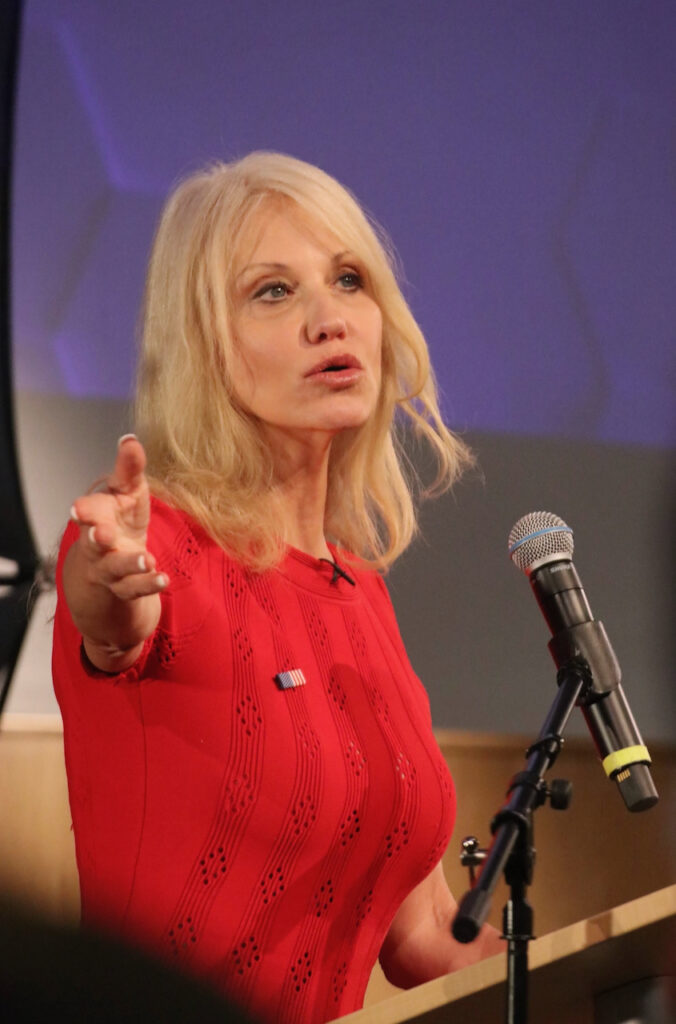
Two photos above: Kellyanne Conway, a nationally recognized pollster, political pundit and the campaign manager for former President Donald Trump, addresses students Wednesday in the Timmerman Auditorium at Hyland Hall on the University of Wisconsin-Whitewater campus.

Chairman of the UW-Whitewater chapter of the Wisconsin College Republicans, the organization that brought Kellyanne Conway to campus Wednesday, John Beauchamp, introduces Conway.
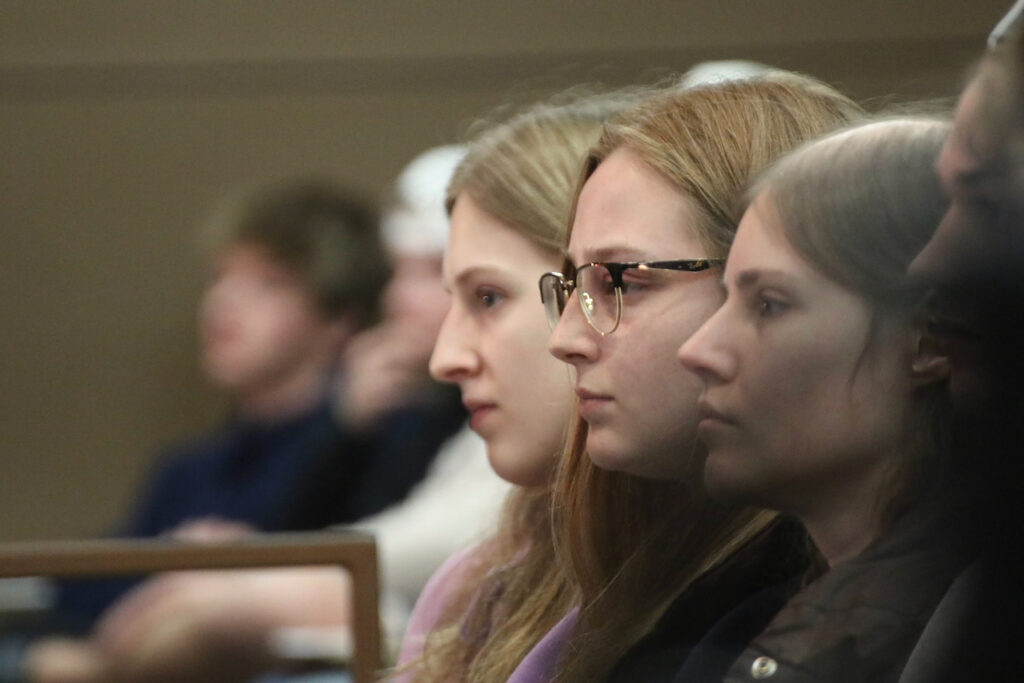
Students listen to Kellyanne Conway.
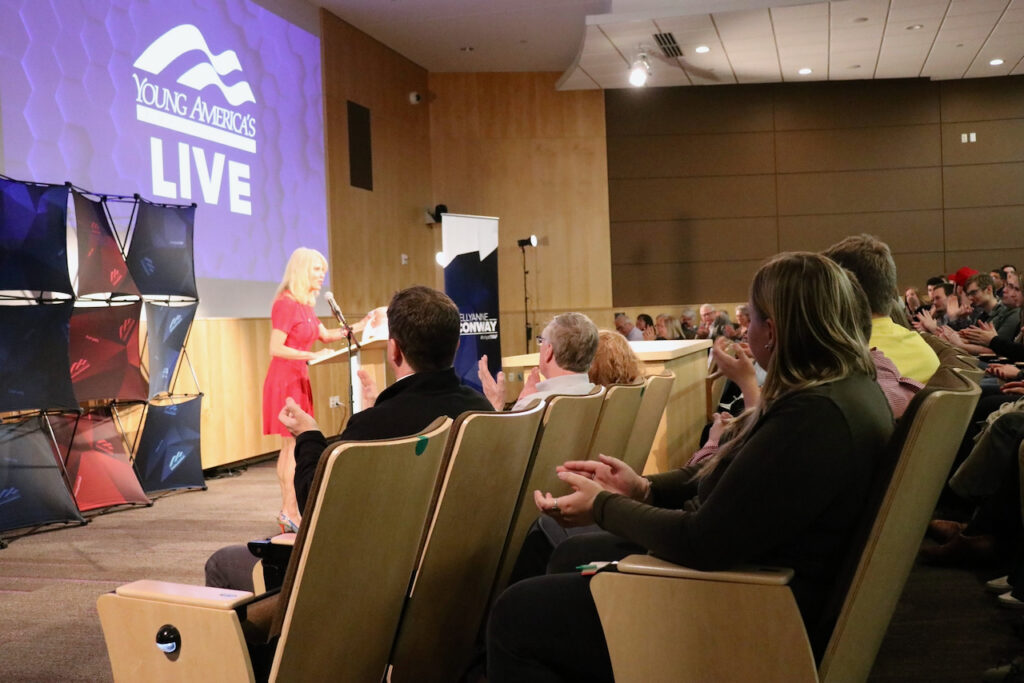
Kellyanne Conway stands before a nearly filled auditorium of about 200 people. Her presentation lasted an hour and touched on such topics as strategies used during the 2016 campaign to elect Donald Trump, as well as issues facing the American public in 2022.

A member of the audience asks Kellyanne Conway if he can shake her hand. Conway granted his request.
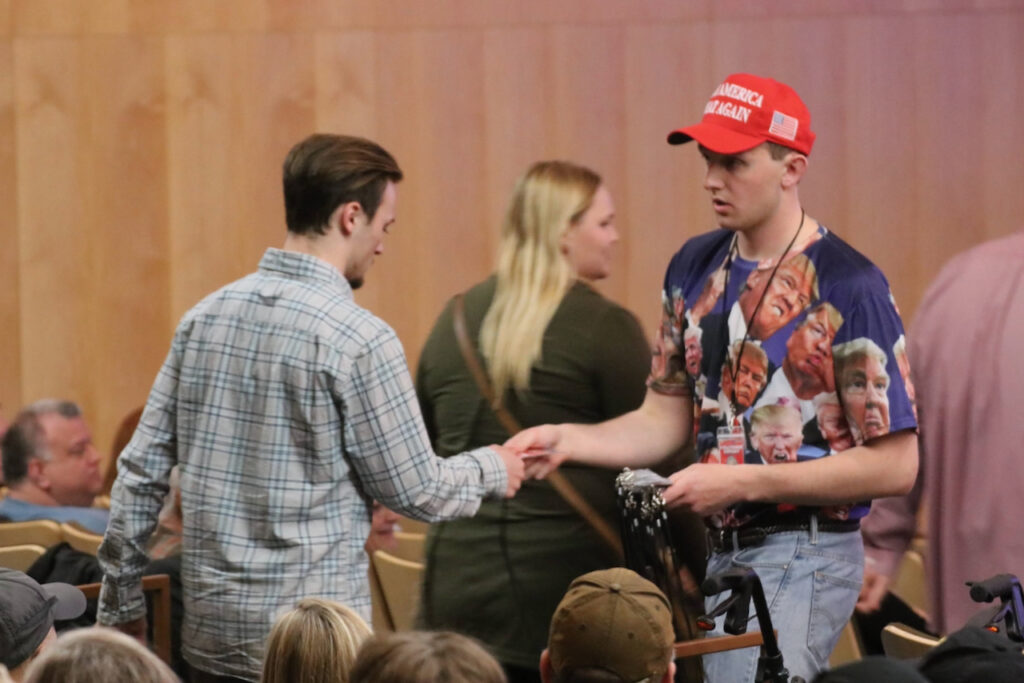
A participant, at left, gives his credentials to an auditorium worker. Several seats within the auditorium were reserved for VIP guests, including members of the college Republicans who hosted Kellyanne Conway on campus.
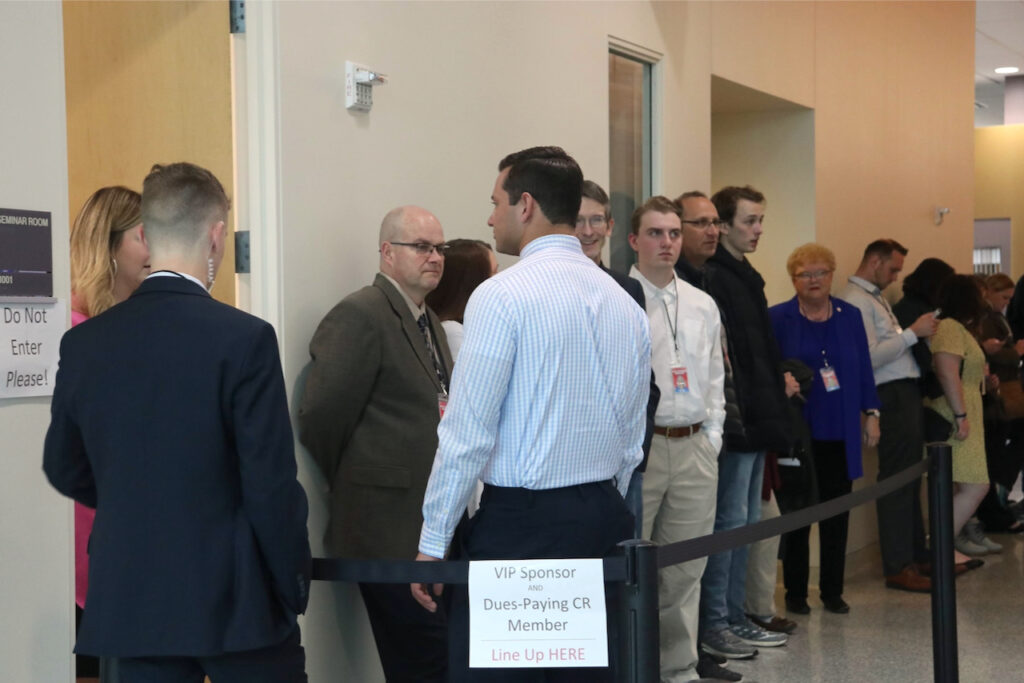
VIP guests and dues paying members of the college Republican group on the UW-Whitewater campus wait outside the Timmerman Auditorium Wednesday.
Ashley McDarison photos.
Differing perspectives: A view of free speech on campus
(Originally published April 28, 2022.)
By Kim McDarison
University of Wisconsin-Whitewater student and chairman of the UW-Whitewater chapter of the Wisconsin College Republicans John Beauchamp says he is an advocate for free speech.
His organization recently hosted a presentation made on campus by Kellyanne Conway, the nationally known pollster, political pundit and campaign manager in 2016 for former President Donald Trump.
Wednesday, as he introduced Conway, Beauchamp included within his comments concerns about what he said was “an ever-increasing blockage” when it came to free speech associated with he and his club members getting their message heard.
“We find ourselves shouted down, and shut up, but we will not be silenced,” he told the 200 or so audience members assembled in the Timmerman Auditorium on campus.
Free speech as an issue was being discussed on campus before the arrival of Conway.
Former UW-Whitewater Interim Chancellor Jim Henderson tendered his resignation on April 4. In the reporting that followed, it was noted that a survey about free speech, intended by the UW System to be distributed to students systemwide, was a factor when the former interim chancellor made his decision to resign.
On April 5, a news release issued by the UW System announced that the system would be launching a systemwide survey on April 7.
In the debate that followed, which some system and campus administrative, faculty and student leaders have said, centered around the intent and timing of the survey, the system postponed its plans. The system has not announced its plans for launching the survey in the future.
At UW-Whitewater, the teacher’s union launched an online petition, which, Chris Ramaekers, the union’s president, told Fort Atkinson Online in an earlier interview, sought to accomplish three things: it seeks support in objecting to political interference on campus, and points to the methodology and process used to administer a proposed free speech survey.
UW System chancellors were recently informed by the UW System interim president about a free speech survey, which had been slated for distribution earlier this month to all UW System students, Ramaekers said, adding that he and other faculty members on campus became aware of the survey after it was tied to the abrupt resignation of Henderson.
The petition has since, as of Thursday, been signed by 37 people.
While not specifically addressing the proposed survey, UW-Whitewater Associate Professor and Faculty Senate Chairperson Tracy Hawkins said, The UW-Whitewater Faculty Senate had, on April 12, approved a resolution opposing political interference throughout the UW System.
On April 6, leaders from student governments from five of the system campuses, including Whitewater, sent a letter to the interim system president, enumerating their concerns with the proposed free speech survey.
The students wrote: “The topic of free speech at our universities has been used in the political arena to divide our students, create unwarranted resentment towards public higher education, and pass unjust laws limiting educational freedoms and the ability to have an honest conversation in the classroom. While we clearly support academic freedom and free speech rights, student perceptions of these complex topics must be studied in an academically rigorous manner for the results to be effective. This starts with engaging stakeholders from across the UW System.”
In an earlier interview with Fort Atkinson Online, Beauchamp said that he did not see the intent of the survey as working to advance a conservative agenda.
“I don’t believe free speech belongs to one side or the other. Everyone should be passionate about free speech,” he said.
Campuses, and not just in Whitewater, were founded on the principles of free speech, and are meant to be incubators of thoughts and ideas, Beauchamp said.
“If a campus community is really a beacon of free speech, there should really be nothing to hide,” he said.
Beauchamp said that through his own discussions with student leaders on his campus and others, he saw an issue developing on campuses, including Whitewater, in which students espousing conservative ideas, or even those which he described as apolitcal, were “unable to share their opinions at times. So I do believe there is a little bit of an issue at times,” he said.
He said there is an atmosphere on campus that keeps conservatives and others from having free speech.
“On the side of Republicans and conservatives, we cherish free speech and the inclusion of ideas,” he added.
Beauchamp said that while he believed the Republican group on campus was considered one of the more welcoming to other students and student groups, it was not always received in the same manner by others.
“We’ve encountered quite a bit of intolerance, and I think intolerance and hostile environments to free speech is increasing,” Beauchamp said.
He described vandalism on campus made to his club’s event posters, and verbal exchanges at event tables.
“Colleges were meant to provide for the sharing of different ideas and different opinions, and the fact is that’s not what we’re seeing these days.
“I’m not trying to accuse the administration at UW-Whitewater of any kind of free speech coverup,” Beauchamp said, adding: “When we go to the proper channels, things are typically dealt with, but we are seeing an overall intolerance towards conservative ideas, and not the free and open exchange of ideas that should be there.
“We should not have to bring concerns to proper channels. We should be able to share our ideas and opinions without fear of being harassed for them, essentially,” he said.
Beauchamp said he and his club members would like to see the survey administered on campus and its results.
“I’m disappointed that student leaders on this campus and others don’t want to see these results about what’s happening on their own campuses,” he said.
Beauchamp noted that he had seen the survey and its questions, and while he was aware that some on campus had expressed concerns with the survey that its questions are bias, he did not share that view.
About the survey, he said: “I have had discussions with our Student Government leaders and I still don’t see any concern. It’s something that everyone should be able to get behind, and frankly, I’m not seeing the ‘slantedness’ that people are claiming these questions have.”
An earlier story about alleged political interference and the debate over free speech on campus is here: https://fortatkinsononline.com/uw-whitewater-teachers-union-circulates-petition-against-political-interference/.

Chairman of the UW-Whitewater chapter of the Wisconsin College Republicans, the organization that brought Kellyanne Conway to campus Wednesday, John Beauchamp, introduces Conway. Beauchamp, in an earlier interview with Fort Atkinson Online, shared his thoughts about what has been a growing debate about free speech on campus. Ashley McDarison photo.
Whitewater: City considers ‘possible release and employment disposition agreement’ with police chief
(Originally published May 4, 2022.)
By Kim McDarison
Among items included Tuesday on the City of Whitewater Common Council agenda was an executive session, after which, as listed on the open-session agenda, the council announced it would reconvene in open session.
The agenda listed a closed-session discussion regarding employment terms for the city’s Police Chief Aaron Raap.
At the end of the regular and open-session portion of Tuesday’s meeting, City Manager Cameron Clapper announced that plans to reconvene from the scheduled closed session had been “pulled” from the agenda.
Clapper noted that the agenda item relating to the city’s police chief “just needs to be attended by myself, city attorney, city clerk and the council.”
Council President Lisa Dawsey-Smith next cleared the chamber and adjourned the open session meeting to reconvene in closed session.
According to the agenda, council planned to discuss Tuesday in closed session the consideration of “employment, promotion, compensation or performance evaluation data of any public employee over which the governmental body has jurisdiction or exercises responsibility.”
The agenda continued: “Items to be discussed: 1) consideration of the terms of a Release and Employment Disposition Agreement between the City of Whitewater and the City of Whitewater Police Chief.”
After a regularly scheduled Common Council meeting held March 1, a closed session was held to give council members an “update on investigation of Police Chief.”
The city announced through a press release in December that Whitewater Police Chief Aaron Raap had been placed on paid administrative leave.
According to the release, “An internal investigation will be conducted by an outside agency based on an incident that occurred outside of the city of Whitewater. The leave is not considered punitive, rather part of the Whitewater Police Department policy.”
The operations of the department, the release announced, would be handled by Deputy Chief Dan Meyer, who would serve as acting police chief “until further notice.”
Citing an “ongoing investigation,” the release noted that “no additional information will be released at this time.”
In November of last year, Raap was arrested in his Waukesha County home and charged with “simple battery,” according to a criminal complaint filed by the Waukesha County Sheriff’s Department.
In early December, Waukesha District Attorney Susan Opper told Fort Atkinson Online, that she had “declined prosecution” of any charges as outlined within the criminal complaint filed by the Waukesha County Sheriff’s Department relating to the November incident, further noting that she did not find sufficient evidence that there was an intention to inflict bodily harm.
On Dec. 16, 2021, in an updated press release, city officials, noting that they were responding to “a number of media inquiries about the city’s ongoing investigation,” wrote: “The procedure is part of a broader effort to maintain the integrity of the organization as a whole, not a criminal investigation. As a result, the internal investigation runs independent from any decisions made by other agencies including Waukesha County’s District Attorney’s Office and will be completed as soon as possible.”
An earlier story, which includes the criminal complaint regarding the events leading to the police chief’s arrest in November, is here: https://fortatkinsononline.com/waukesha-county-sheriff-department-records-pertaining-to-arrest-of-whitewater-police-chief-released/.

Whitewater Police Chief Aaron Raap
Whitewater: City, fire department move closer to merging
(Originally published May 5, 2022.)
Whitewater city officials have announced that a Memorandum of Understanding (MOU) has been signed by the city and the Whitewater Fire Department, Inc., with both parties agreeing to continue the process of converting the independently operated fire department to a city department.
According to the release, an outside consultant, Public Consulting Group, is working with the two groups on a weekly basis to help develop a plan for a smooth transition.
“This process is allowing for an outside look at current operational protocols in addition to possible future needs to help service the community and townships,” the release stated.
“We are excited to continue moving forward on the process to join the city,” Whitewater Fire Department, Inc., Board of Directors President and Fire Captain Christ Christon was quoted as saying in the release.
An anticipated completion of the merger is “mid-summer,” the release stated.
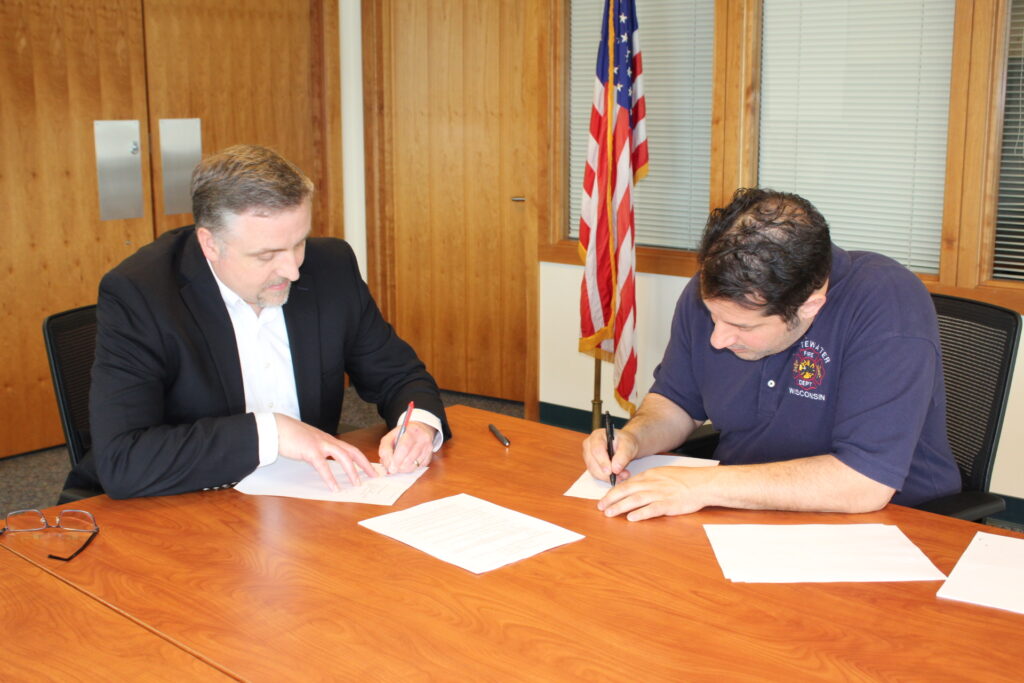
Whitewater City Manager Cameron Clapper, at left, and Whitewater Fire Department, Inc., Board of Directors President and Fire Captain Christ Christon sign a memorandum of understanding, agreeing to continue the process of merging the two groups. The photo was released Wednesday by city officials. Contributed photo.
Steil tours Whitewater Fire Department, service area
(Originally published May 6, 2022)
By Kim McDarison
Wisconsin 1st Congressional District Rep. Bryan Steil, R-Janesville, visited Friday with members of the Whitewater Fire Department.
According to information supplied by his office, the purpose of Steil’s visit was to learn about the department’s equipment and capabilities.
Arriving around 10:30 a.m., Steil met with the department’s staff, toured the firehouse and participated in a ride-along to better understand the scope of the department’s services and the area it serves.
According to information supplied to the media, the Whitewater Fire Department services several towns within Wisconsin’s 1st Congressional District.
“Our firefighters and first responders are heroes. I’m thankful for the work of the Whitewater Fire Department and grateful that they were able to give me a firsthand look at the lifesaving work they do every day,” Steil said after completing his visit.
Whitewater Assistant Fire Chief – EMS Ashley Vickers, responding to the morning’s events, said: “It was great to host Congressman Steil at the Whitewater Fire Department today. It is important that our elected leaders know what our firefighters and first responders do to help save lives in our community.”
Steil has served as representative in the 1st Congressional District since January of 2019. His terms ends in 2023.
The Whitewater Fire Department, which operates independently from the City of Whitewater, announced earlier this week that is has signed a memorandum of understanding, moving the department and city closer to a mutual goal of reorganizing the independent organization into a city-operated department.

Wisconsin 1st Congressional District Rep. Bryan Steil at left, learns about equipment at the Whitewater Firehouse from Whitewater Assistant Fire Chief -Equipment Joe Uselding.
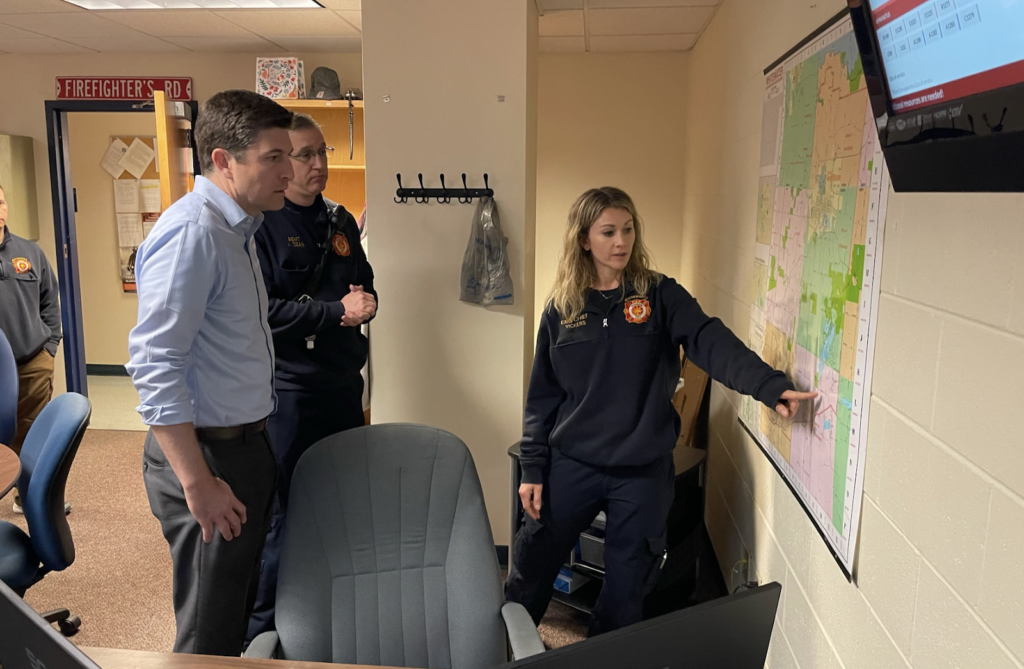
Whitewater Assistant Fire Chief – EMS Ashley Vickers, at right, shares information about the department’s service area with Wisconsin 1st Congressional District Rep. Bryan Steil, at left.

Members of the Whitewater Fire Department gather after sharing their morning with Wisconsin 1st Congressional District Rep. Bryan Steil, pictured second from left.
Contributed photos.
Kilar named principal of Purdy Elementary School
(Originally published May 6, 2022.)
The School District of Fort Atkinson announced Friday that Mary Kilar has been selected as the next Purdy Elementary School principal.
Kilar will succeed Leigh Ann Scheuerell who has accepted the principal position at Fort Atkinson High School beginning with the 2022-2023 school year.
“Mrs. Kilar will be an instant asset to our 1FORT learning community as we strive to meet our strategic plan goals given her leadership experience, demonstrated commitment to students and families, and connections to our local area. We are more than excited to welcome Mary to the Purdy Elementary School Team,” School District of Fort Atkinson Superintendent Rob Abbott was quoted as saying in a news release Friday.
As cited in the release, Kilar comes to the School District of Fort Atkinson with experience as an elementary teacher, having served in various roles including director with the Jefferson County Early Intervention Program, and 18 years experience in school administration. Most recently, Kilar has served as principal at Lincoln Elementary School within the Whitewater Unified School District. Among other professional distinctions, Kilar was honored with a Kohl award for Excellence in Principal Leadership in 2021. In addition, she was honored in 2012 by the National Catholic Association (NCEA) as one of twelve distinguished principals in the country.
Abbott added: “Her prior administrative experience, strong academic background, and demonstrated success in school report card growth, directly aligns with both the Purdy Principal Profile created by stakeholders as well as the District’s Strategic Plan goals.”
“It is with great excitement and honor that I become the next Principal of Purdy Elementary. From the minute I met the team at Fort Atkinson, I could feel the pride they have in both the culture of community and excellent learning environment created here. I am beyond grateful for the opportunity, look forward to the connections I will be making, and can’t wait to grow and learn among the wonderful staff, students, and families. I was drawn to the mission and vision of Fort Atkinson School District, cultivating an inclusive high-performing culture of growth and community, and can’t wait to be part of it,” Kilar noted in the release.
According to the release, the School District of Fort Atkinson Board of Education and the School District of Fort Atkinson ask the community to join them in extending a warm welcome to Kilar in her new position.
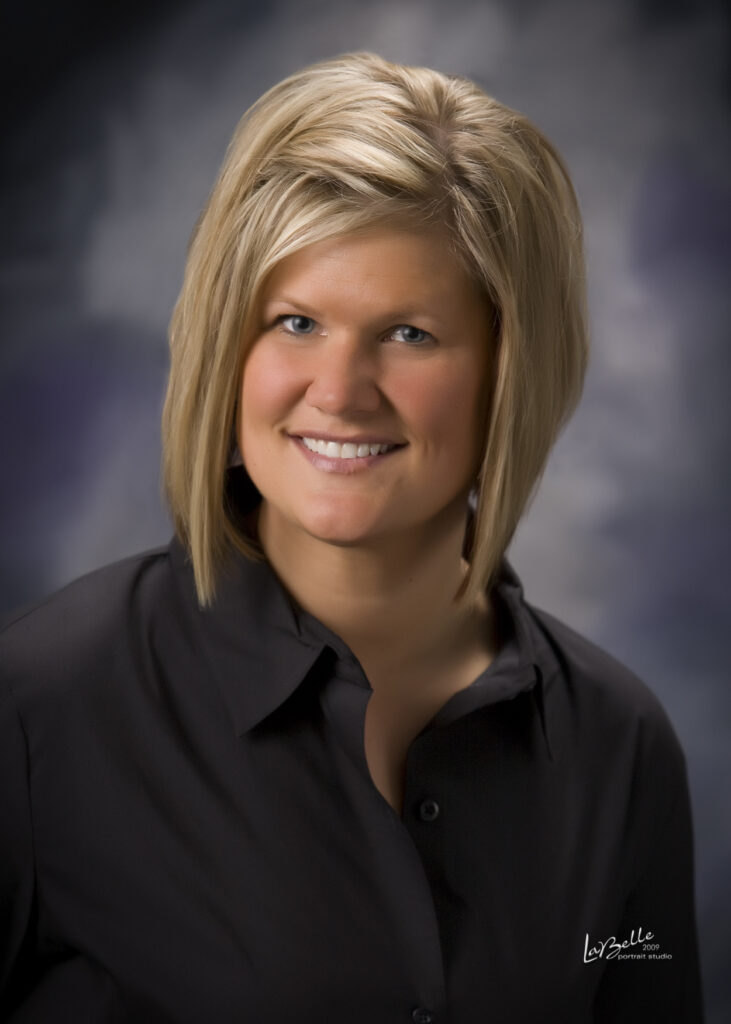
Mary Kilar
Update, cancelation: Whitewater CDA to hold informational meeting for landlords
(Originally published May 11, 2022.)
Editor’s note: The informational session for landlords scheduled for Friday, May 13, has been canceled, according to Whitewater city officials. No other information regarding the cancelation has been released. The New Community Expo will continue as planned on Saturday, May 21.
The City of Whitewater Community Development Authority (CDA) will be hosting an information session for all landlords and rental property owners, according to information released by city officials.
The session will be held in the Whitewater High School auditorium, 534 S. Elizabeth St., Whitewater, Friday, May 13, from 10 a.m. to noon.
Landlords and rental property owners within the city of Whitewater are encouraged to attend.
During the meeting, information about the city’s growing international population, will be shared, according to the release.
“The meeting will focus on preferred practices and opportunities of communication,” the release stated.
The City of Whitewater Police Department, Whitewater Unified School District, the City of Whitewater Neighborhood Services Department and Fire Prevention Services/Fire Inspection contractor, will be among presenters during the meeting.
“A number of parties in Whitewater are interested in helping the new faces in our community. We want those involved to gather, receive updates and work on a positive course of action for moving forward,” Chris Bennett, Whitewater Neighborhood Services director, was quoted as saying in the release.
The meeting will include time allotted for a questions for panelists, the release noted.
For more information, contact Economic Development Director Cathy Anderson, by phone: 262-473-0149 or email: CAnderson@whitewater-wi.gov.
Additionally, citizens are invited to attend a New Community Member Expo planned for Saturday, May 21, from noon to 2 p.m., at the Community Engagement Center, 1260 W. Main St., Whitewater, the release read.

City of Whitewater Municipal Building, file photo/Kim McDarison.
Rock River Community Clinic names new medical director
(Originally published May 11, 2022.)
Rock River Community Clinic (RRCC) has announced that Donald Williams, MD, will serve as the clinic’s next medical director.
Additionally, the announcement notes, he will provide primary care at the RRCC Whitewater Clinic several mornings each week.
According to information released by RRCC, Williams attended medical school at the University of Illinois and completed his residency and training in internal medicine and pediatrics at Akron Children’s Hospital and Medical Center and Akron General Medical Center in Ohio. He is board certified in both specialties and practiced at Fort HealthCare’s Internal Medicine and Pediatrics department for over 40 years, retiring in 2021.
“I am excited to use my experience in a way that brings much needed primary care options to our community. Reducing the barriers to medical care has always been near and dear to my heart. At RRCC, I will be able to do just that as we work to improve access to health care for everyone in our community,” Williams was quoted as saying in the announcement.
“Dr. Williams’ passion for primary care, collaboration with fellow providers, and devotion to patients is unmatched. His kindness and genuine concern for others allows him to provide medical care in a way that ensures patients feel heard, valued and respected, all very important pieces to our community health center model,” Olivia Nichols, CEO/executive director of RRCC stated in the announcement.
Williams joins fellow primary care providers Mary Beck Metzger, APNP, Whitewater and Jefferson clinics, and Cynthia Sepulveda, APNP, Watertown and Whitewater clinics, in providing primary care services at RRCC. Williams has assumed the role of RRCC medical director from Stephanie Nottestad, MD, of Fort HealthCare’s Cambridge Family Practice and Lake Mills clinic.
To schedule an appointment, call: 262-472-6839. For clinic hours and directions, visit www.rockrivercommunityclinic.org.
About RRCC
According to the announcement, RRCC provides comprehensive and cost-effective health care services to ensure all community members have access to the care they need. Serving families in Jefferson, Dodge, and parts of Walworth counties, RRCC includes three medical clinics located in Whitewater, Watertown, and Jefferson, and one dental clinic located in Fort Atkinson. Referrals for behavioral health care services will soon be available at locations in Whitewater and Watertown.
RRCC accepts all community members, regardless of ability to pay, offering discounted prices for patients who are uninsured or underinsured. RRCC also provides care coordination services to help patients overcome barriers to accessing healthcare, such as transportation, and helps to coordinate referrals. Bilingual staff who speak Spanish and English are available to support patients and their families. By increasing access to health care services, offering care at affordable costs, and assisting with healthcare navigation, RRCC works to create a healthier, more equitable, community.
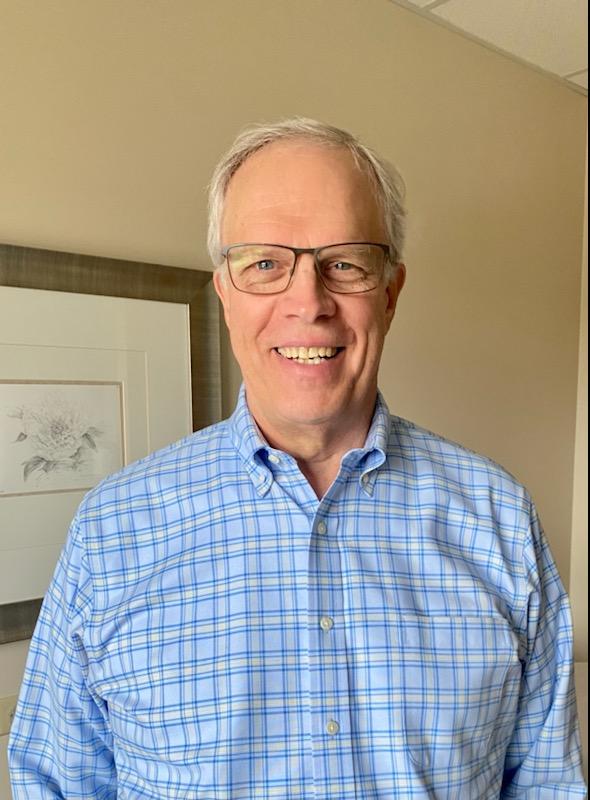
Donald Williams
Stroebel, Vruwink, Horlacher each named Greater Whitewater Committee ‘Legislator of the Year’
(Originally published May 13, 2022.)
State Sen. Duey Stroebel (R-Cedarburg) and State Reps. Don Vruwink (D-Milton) and Cody Horlacher (R-Mukwonago) have each been named “Legislator of the Year” by the Greater Whitewater Committee (GWC), a Whitewater-based, action-oriented, pro-business group, according to information released by the organization. The three were honored Thursday at the Wisconsin State Capitol.
The three were chosen for the recognition in response to their work in introducing the General Purpose Revenue (GPR) Equity Bill. The bill aids in the creation of an equitable GPR funding formula for the UW System, according to the release.
“All three of these legislators saw a disparity in the current funding formula and felt it needed to be addressed, inspiring them to author this GPR equity bill,” the release stated.
According to the release, the bill, if made into law, will require the Board of Regents to allocate an equal amount of GPR funding to all UW institutions per full-time equivalent undergraduate student enrolled at the institution.
“This will not include UW-Madison or UW-Milwaukee. As a result of this bill, the Board of Regents will create a task force, designed to address the disparities in the current funding formula. The GWC is committed to building an alliance with the other nine comprehensive campuses to continue to make a stronger case in the next legislative session,” the release stated.
According to the release, the GPR funding formula in use allocates funding disproportionately within the UW System and the University of Wisconsin-Whitewater receives the least amount of funding. UW-Whitewater receives about $1,500 less in funding per full-time student compared to the average number received by the comprehensive campuses in the UW System.
“Most students go to a comprehensive university near their home, so the current funding formula penalizes families in the Whitewater region,” the release noted, adding that nine of the 12 comprehensive campuses receive less than the average systemwide amount as calculated by the funding formula.
The release continued: Stroebel, Vruwink and Horlacher each advocated for an equitable GPR funding formula, not just to benefit Whitewater, but to create equitable opportunities for all UW System students. UW-Whitewater in particular has a large number of disabled students, as well as students who come from low income or first-generation backgrounds. These factors increase the amount of aid needed to fund students.
“The entire Whitewater community is so grateful for all of the work done by Stroebel, Vruwink, and Horlacher on this equity bill. Thanks to these legislators, UW-Whitewater will be able to properly assist its students and provide the best education possible,” GWC chairman Larry Kachel was quoted as saying in the release.
A comprehensive report describing funding allocations throughout the UW System and at the UW-Whitewater is here: https://www.uww.edu/documents/facsenate/meeting%20archive/2021-2022/2022-04-12_Senate/D2.%20FEAOC%20-%20UWW%20GPR%20Fact%20Sheet%20-%20Spring%202022.pdf.
About the GWC
According to the release, the GWC is an action-oriented group committed to working with citizens, elected officials and policy makers to identify, craft and implement a pro-business agenda. The agenda advances the economic, educational and social policies required to energize and secure the Whitewater area’s economic future, as well as protect Whitewater’s quality of life.
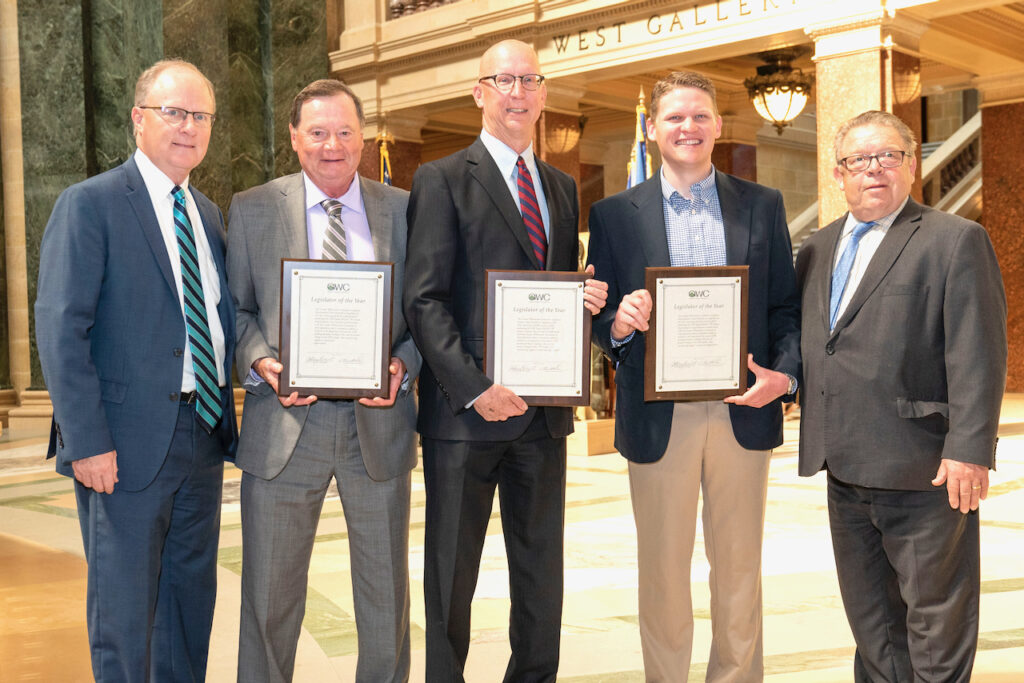
Greater Whitewater Committee chairman Larry Kachel, from left, and three recipients of the committee’s “Legislator of the Year” award — Rep. Don Vruwink, Sen. Duey Stroebel, and Rep. Cody Horlacker — along with Greater Whitewater Committee President and CEO Jeff Knight, gather Thursday during a presentation of the awards made at the Wisconsin State Capitol. Contributed photo.
Whitewater: Clapper named finalist in Dodge County administrator search
(Originally published May 24, 2022.)
By Kim McDarison
The Dodge County Board of Supervisors has announced that it has identified four finalists from a pool of at least 12 candidates.
Among the four finalists is Whitewater City Manager Cameron Clapper.
According to information released Monday by County Board Chairperson Dave Frohling, the process to find a replacement for retiring County Administrator James Mielke began in March.
Mielke will serve his last day as county administrator in June.
The board’s Executive Committee, with help from hired contractor, Public Administration Associates, LLC, met in executive session Friday, May 20,
According to Friday’s Executive Committee meeting agenda, the committee met in closed session “for the purposes of considering employment of a county administrator, strategies for recruitment and potential candidates, all of which are of a competitive nature, specifically to: review candidate profiles, determine number of candidates for in-person interview, and determine the interview questions/schedule.”
According to information supplied to the county board by Mielke in his “County Project and Issue Update — May 2022,” which was included with information in the board’s May 17 meeting packet, the recruitment period concluded on May 9.
Mielke wrote: “Dave Bretl of Public Administration Associates reports that as of Monday Morning, May 9th, there were 12 applications. Mr. Bretl indicated he expected to receive additional applications by the end of the day. The Executive Committee is scheduled to meet on May 20th to review and select the candidates for interviews. Interviews are currently scheduled for Monday, June 6th and Tuesday, June 7th. Scheduling details for June 6th and 7th have not been finalized as of this writing. Subject to county board confirmation, a potential start date for the next county administrator remains early August.”
The board has installed Jon Hochkammer as interim county administrator.
“The Executive Committee has been methodical in its search, to date, to arrive at our list of final candidates. There was strong interest in the position and I am pleased with the quality of the candidates that applied,” Frohling was quoted as saying in Monday’s release.
Clapper was among finalists seeking a position as city manager in Fort Atkinson in 2020.
Clapper was named as one of four finalists in that city’s search in December of 2020. He withdrew from consideration after beginning the interviewing process that same month. The city ultimately hired Rebecca Houseman LeMire.
Public Administration Associates, LLC, was hired by the Fort Atkinson City Council to help with the search. The president of the company is Kevin Brunner who served as city manager in Whitewater between 2004 and 2012.
Finalists include:
Rebecca Bell
Bell has served as the Dodge County Human Services and Health director since 2016, according to the release. She has also served as deputy program director at the Fond du Lac County Department of Community Programs from 2008 to 2016 and as a psychiatric social worker for that county between 2006 and 2008. She began her career as an adult/child protective services and crisis intervention worker for Waushara County in the Department of Human Services in 1997. She is a licensed clinical social worker and holds a masters degree in social work from the University of Wisconsin-Madison.
Cameron Clapper
Clapper has served as the city manager in Whitewater since 2012. Prior to that service, he was the assistant to the city manager in Whitewater between 2010 and 2012. Additionally, he served in the village of Waunakee as a management/analyst/deputy clerk from 2005 to 2010. He also served as the assistant to the village administrator in Waunakee. Clapper holds a bachelor’s degree in international studies and a masters degree in public administration, both from Brigham Young University.
Daryl DeDeker
DeDeker is an assistant professor of accounting at the University of Wisconsin-Stevens Point. He has held that position since 2015. He served as the UW-Stevens Point controller from 2008 to 2015, and was the chief financial officer for Portage County between 1998 and 2008. Additionally, DeDeker has served as the director of finance and administration for Northcentral Technical College in Wausau. DeKeker has prior service as a supervisor on the Portage County Board of Supervisors. He is a licensed certified public accountant and holds a doctorate in sustainable education from UW-Stevens Point, a master’s in business administration from UW-Oshkosh, and a bachelor’s degree in accounting from UW-Stevens Point.
Scott Feldt
Feldt is the county administrator in Kewaunee County. He has held that position since 2015. He has served as the deputy state treasurer in Wisconsin between 2011 and 2015, and as director of economic development for the city of East Moline, Ill., from 2008 to 2010. Feldt has held board positions on the Janesville School Board and Rock County Board of Supervisors. He holds a master’s degree in public administration and a bachelor’s degree in political science, both from the University of Wisconsin-Madison.
About County Administrator James Mielke
The chosen candidate will replace Mielke, who began his administrative career in 1997 as interim city administrator for the city of Ripon. Prior to arriving at Dodge County, he held the position of county administrator of Ogle County, Ill. Former administrative experience in Wisconsin includes village administrator for Trempealeau and New Glarus. Mielke has also served in elected positions, including board trustee for the village of DeForest and supervisor on the Green County Board of Supervisors. Mielke holds a bachelor’s degree in geography/economics from the University of Wisconsin-Stevens Point and a master’s degree in public administration from the University of Wisconsin-Oshkosh, according to biographical information provided on the Dodge County website.

Cameron Clapper
Whitewater: School board addresses concerns over faculty resignations, supports superintendent
(Originally published May 25, 2022.)
By Kim McDarison
The Whitewater Unified School District Board of Education Tuesday began its meeting with a statement read into the record by board President Thayer Coburn in which it outlined its concern over recent staff and administrative resignations.
Within the statement, the board outlined two “factors” which it perceived as contributing to its developing retention concerns. They are:
- “Unmanageable workloads: Educating Whitewater’s high-needs population, which is uniquely large for a district of our size and growing by the day, is putting a great deal of stress on many of our staff members. The demands of the pandemic and recent turnover have created imbalances. Our superintendent, Dr. Caroline Pate-Hefty, is addressing these imbalances with the board’s support.”
- “Concerns about direction: Some see the challenges we are dealing with and have concluded that our superintendent is leading the district in the wrong direction. Some have even made career decisions based on inaccurate or incomplete facts. We take this issue seriously and have investigated it through our 360-degree evaluation process.”
Tuesday’s open session meeting followed a closed session meeting, which, according to the agenda, was held for the purpose of “considering employment, promotion, compensation or performance evaluation data of any public employee over which the governmental body has jurisdiction or exercises responsibility; specifically, to review the superintendent evaluation.”
After the board reconvened in open session and before the floor was opened for public comments, the full statement made on behalf of the board was read.
Within the statement, the board noted that “the board makes district policy based on our community’s priorities and employs a superintendent to implement those policies, enforce board rules and regulations, and oversee district operations. The superintendent has a 13-person District Leadership Team, or DLT, that consists of building principals and districtwide administrators. The superintendent uses the DLT forum to share and receive feedback and information to help her run the district.
“The board evaluates the superintendent twice per year. For the most recent winter evaluation, the board was satisfied that our superintendent was working in accordance with its wishes. Sensing a recent change, we sped up the summer evaluation and enhanced 360-degree upstream component of the review by holding in-person interviews with all 13 DLT members.”
Within the statement, the board said it concluded, after that review, that “our superintendent has many strengths, among them a clear vision for the district, the energy and the organization to execute that vision, the willingness to make unpopular, but necessary, decisions, an approachable and compassionate demeanor, and the fortitude to stand before her staff and the public — no matter what.”
The statement continued: “These strengths were exemplified in the administrative actions prior to the resignation of a former high school tech ed teacher.”
As reported earlier by Fort Atkinson Online, tech ed teacher Mike Wintz’s decision to resign sparked controversy. Stories about the resignation and the controversy that followed are here: https://fortatkinsononline.com/whitewater-tech-ed-teacher-watson-resigns-two-tech-ed-teachers-hired/, here: https://fortatkinsononline.com/whitewater-school-board-member-meets-with-wintz-supporters/, and here: https://fortatkinsononline.com/whitewater-teachers-retirement-fuels-controversy-supporters-look-for-reinstatement/.
According to the statement: “Knowing that the mishandling of the situation could have cost the district hundreds of thousands of dollars or more in legal costs, our superintendent worked closely with the district’s long-term legal council to protect both the district and the employee, all while supporting an injured student and their family and rebuilding the tech ed program into one the district can be proud of. Due process dictated that the superintendent withhold certain details of the case from the board at the beginning of the investigation, which created the misperception that she was hiding something for her own benefit. In fact, she shared the details of the case with the board precisely when the district’s legal team advised it was appropriate.”
Additionally, the statement noted that the board had identified “areas of improvement” for the superintendent, adding: “We will not list them here, but she has acknowledged and is working on them with the board’s support and input, as well.”
Addressing allegations within the community about missteps in leadership, the board’s statement included this response: “A well-functioning organization is characterized by constructive communication, which means direct conversations between those who notice problems and those who have the authority to fix them. A poorly functioning organization … is characterized by destructive communication, including a habitual, deliberate circumvention of the chain of command and the spreading of unsubstantiated rumors. Unfortunately, destructive communication is creating disunity in our ‘Unified’ school district. Constructive communication could help define problems and elicit solutions; instead, far too often, destructive communication fosters misunderstandings and erodes morale …”
The board and the superintendent, the statement read, “encourage anyone to share constructive communication directly with the board.”
In conclusion, the statement noted: “the board does not and will not tolerate retaliation.”
Citing a board policy, the statement read: “No employee or District official shall, or attempt to, restrain, interfere with, coerce, discriminate against and/or retaliate against any employee who files or processes a grievance in good faith.”
The statement read: “That anybody even thinks retaliation could happen is bad enough. Still, the board is grateful to have a superintendent who has firm expectations and holds her team accountable. Anybody who believes they have been the victim of retaliation, and not accountability, should immediately contact a member of the school board.
“In the meantime, the board believes our superintendent is moving our district forward, and we are excited for the future.”
Public comments
The meeting was attended by some 40 people, some of whom were there to receive board recognitions.
After assessing the number of people in the gallery who indicated they might like to speak, the board approved extending the period for public comments beyond the 30 minutes allocated by board policy. Each individual, per board policy, was allowed three minutes to speak.
During public comments five individuals addressed the board, with many receiving a round of applause after their comments were delivered.
Addressing the board, Whitewater resident and business owner Geoff Hale, referring to the recent hiring by the School District of Fort Atkinson of former Lincoln Elementary School Principal Mary Kilar, said: “Another loss for Whitewater schools, another gain for Fort Atkinson. In so many words, I guess, we told you so a very few months back when Mike Wintz was forced to resign.
“As part of the collateral damage, (former Whitewater school district tech ed teacher) Cody Watson took flight and was greeting with open arms by Fort Atkinson’s tech program.”
Hale said that Wintz was today employed by Generac, where he serves as a teacher and trainer in a “companywide” capacity.
“A strong culture is key to any institution,” Hale said.
He talked about the culture fostered at his company, Home Lumber, noting that his company has a culture that is “so strong that 26% of our current staff have left for other careers only to return to us in the long haul.”
He asked board members: “Is it possible that a different type of culture is being pursued here (within the school district)?”
He offered some examples, which he said, would illustrate his point.
“Over the years there have been untold teachers and coaches in our school system who have changed the lives of countless students radically for the better. There are three that dramatically stand out for me: James Crummey, Mike Wintz and Mark Maas.
“We’ve already exhausted the Wintz story,” he said, turning his comments towards what he claimed were recent events surrounding Maas.
“Mark Maas slept, dreamt and exampled making a difference every day with whomever he touched within a classroom, as a teacher, or in the field as a coach. Mark forever held … a working school email. A school email that was worthy of being engraved in a stone at our school’s entry. Magically, Mark Maas’ email disappeared. It was taken down, removed the very next day after Mark spoke up at the school board meeting raising concerns about Mike Wintz’s forced resignation.”
Hale continued: “When faced with the prospect of a school walkout over the Wintz situation, our superintendent chose to shut down the entire administrative building rather than face the protest.”
Citing a 1977 World War II movie titled: “A Bridge Too Far,” Hale asked board members: Is Mary Kilar your bridge too far?” and: who will be next?”
Whitewater Unified School District Community Engagement Coordinator Molly Fuller next approached the podium. Emotional at times, Fuller said that she and her husband, Dan, had two children attending school within the district.
“Over the past several months, numerous community members, staff members from each of our schools, and families have reached out to me regarding their disappointment in where our district is headed. I want to be clear that people, including myself, are not upset with change in our programs or in our workload. I myself understand that for a district to succeed, you must run it like a business; you must increase enrollment and money to survive. What I also know is that this business, this school district, this community is a family.
“A business cannot succeed if its employees do not get heard or appreciated. Our district will not grow if we have numerous great teachers leaving or just waiting around until a lateral position becomes available. Our district has been built on the community and staff who have given everything for our students,” Fuller said.
She continued: “I am heartbroken to know so many of us are hurting and disappointed at them being told that what we are feeling is a miscommunication. We are a family. When one, or in this case, numerous people are being shown that they don’t matter, it tells me that we are not following our vision as a district. Our vision is ‘every student, every day, in a unified way.’ Our community is here for our students. We want what’s best for them. In order to do this, we must have our dedicated staff and community members feel supported. We have become a district where the only voice being heard is that of our leader. If people speak up, or against our leader, they are reprimanded, belittled and become fearful of losing their job or demoted.
“We the people have come to the board to speak our mind through letters, emails and phone calls. I ask the board to take this very seriously and be fully aware,” Fuller said, adding: “if we don’t support our staff, students and families, they will leave our district. If our district is run without the heart, integrity, honesty and trust, transparency and ethics, no amount of programming will save this district because staff and families will not stay, because our core values do not exist.”
Nick Meinel, who identified himself as a fourth-grade teacher at Washington Elementary School, addressing the board, said: “I recently submitted a letter to the board expressing some significant concerns that I was having.”
Among his concerns, he said, was the rate at which teachers and administrators were leaving the district. He described those leaving as “well-rooted people, who care passionately, deeply about this district and about this community.
“And they are leaving and I unfortunately understand why. I think it’s a symptom of a larger issue; I think that there is no longer trust and no longer faith in their leadership. I think that the number of things that have happened that seem dysfunctional … the board is well aware of the many instances, I know, that have been shared with them.”
Meinel continued: “As far as massive decisions about the district moving forward with their early childhood program or English language or special ed … teachers being offered jobs, dream jobs — otherwise would have been dream jobs — but they weren’t comfortable taking a position because they got called on a Saturday morning and the board didn’t know anything about it ahead of time according to board members that I talked to. I think that that epitomizes the dysfunctional communication, and to say that the board is leading the way, I have a hard time getting on board with.
“There’s an apparent lack of integrity which will continue moving us towards a demise of this district, one I take a lot of pride in. I have lived here my whole life. I went to school here, my dad taught here; between the two of us, we’ve almost 50 years of teaching experienced, and I never in my life would have imagined questioning my place in Whitewater moving forward, and, unfortunately, it’s kind of come to that. I’m not sure how things are going to go.”
Meinel said he has a daughter in the school district and her mother is also a teacher in the district.
“She and I have talked, and we are not quite sure, moving forward, I don’t know I guess at this point what the resolution to this situation is, he said, adding: “If the board is committing to moving forward as is, I do know for a fact that there are many faculty members who are uncomfortable coming tonight who have expressed to me that they don’t want to be the next one, or want to have the target on their back, and that’s a really crummy position to be in. It is really unfair for us as teachers to feel that we can’t respectfully voice … I was going to write a letter to begin with and see it through; it breaks my heart that my pride in Whitewater and in our district has faltered the way that it has.”
Another speaker, Lexy Maas, said she was formerly employed by the district for 28 years and has served as a substitute teacher.
“This district is breaking my heart,” she said, adding: “My son was raised here, went to school here, finished college here, and we are committed to this town. And this town is breaking my heart. And I think (earlier speaker) Molly (Fuller) put it all together. I just concur with everything she said. We are family and we are in crisis. And I am pleading with the board to look at this crisis, and please, we have to be better, we have to do better. We are Whitewater. We are Whitewater Unified.”
Crystal Benes, who described herself as a parent of a high school student in the district, addressing the board, said: “I just kind of want to reiterate some of the things that other people are saying. As a parent, these kids can feel the tension. And I don’t know if people realize that, but there are teachers that are typically happy-go-lucky, wonderful to work with, teachers that I am close with, that are frustrated, hurt, concerned, and they are not taking it out on their students, but these students feel the tension.”


Two photos above: Members of the public assemble in the Whitewater High School library Tuesday during the Whitewater Unified School District Board of Education meeting. Contributed photos.
Whitewater: Mansky to serve as high school principal; August community meet-and-greet scheduled
(Originally published May 26, 2022.)
The Whitewater Unified School District Board of Eduction has announced that Brent Mansky will serve as the next principal at Whitewater High School (WHS).
Mansky, who serves as principal of the Williams Bay Middle and High School, was installed into the position through board of education approval garnered during the board’s meeting held Tuesday night.
According to information released Tuesday by the district through Facebook, “the District Leadership Team selected a slate of five potential candidates. After three panel interviews, and a student interview and tour, Mansky was the administration’s WHS principal recommendation.”
Mansky will assume responsibilities at the high school in July.
Whitewater High School families are invited to meet Mansky Thursday, Aug. 11, between noon and 5 p.m., at the Whitewater High School, during the Whitewater Unified School District’s registration day, according to the release.
Additionally, the district released a letter from Mansky, which states:
Dear Whippets,
It is with great pride and excitement that I write this letter of introduction to you as the next principal of Whitewater High School. I am honored to have the opportunity to lead a school with such a rich tradition of excellence in academics, the arts, and co-curricular programs in such a supportive community. I am looking forward to joining the excellent team assembled within the Whitewater School District and working with you as a partner in education to ensure a successful and enjoyable experience for all students.
My wife Alison and I currently reside in Williams Bay with our children, Brynn – 8 and Braden – 6. We enjoy traveling, playing sports, and spending time outdoors around the Castle Rock Lake area. I am also an avid golfer and we are proud supporters of all Wisconsin sports teams.
I am from Waunakee, WI and graduated from UW-Eau Claire with a BA in Broadfield Social Studies (Economics) and hold a Master’s degree in Educational Leadership from Cardinal Stritch University. I have spent the past 19 years in Wisconsin public education in a variety of roles. I began my career as a teacher at Black Hawk High School and spent fifteen years as a social studies teacher at Westosha Central High School before serving as the principal at Williams Bay Middle/High School for the past two years.
Additionally, I have spent the last five years with Economics Wisconsin as an instructional coach. I have also served as a varsity-level basketball (18 years) and football (10 years) coach at all stops throughout my educational experiences at Eleva-Strum, Hudson, Black Hawk, Westosha Central, and Richmond-Burton (IL) High School.
As your principal, it is important to me that we build strong relationships to ensure that our students are actively involved in their school experience in order to benefit from all of the opportunities we offer. We will continue to develop individuals with good character, compassion, and integrity who understand the importance of citizenship and responsibility in our global society.
Additionally, we will provide a variety of academic and career pathways that will allow students to individualize their course of study to meet their college and career goals.This attitude enables us to meet the challenges of academic excellence in a positive, fun, and nurturing environment. My door will always be open and I welcome your input.
I look forward to getting to know all the members of the Whitewater school community in the months ahead. I am impressed at the level of excitement, pride and commitment to excellence that is present in the entire school community and look forward to transitioning to my new role on July 1st.
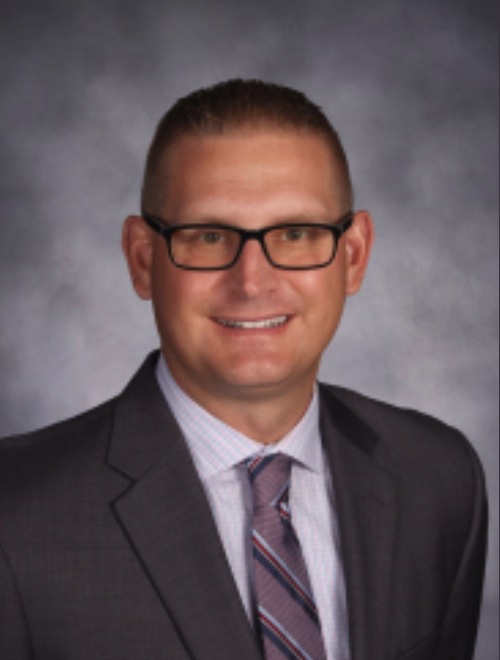
Brent Mansky
Whitewater: Residents share frustration with school board amid resignations; cite poor communication
(Originally published June 8, 2022.)
By Kim McDarison
Tuesday marked the second in what has become a series of special meetings during which members of the Whitewater Unified School District community share — often emotionally — upset with the district’s superintendent and board of education.
According to district stakeholders, frustration stems from two causes: a series of teacher and staff resignations, seen by some as resulting from fear of retaliatory responses made by the district’s leadership against those who voice concerns as they relate to recent changes made in district programs and policies, and a lack of communication between the district’s leadership and its faculty and families.
Tech ed resignations
Upset among community members became public during a school board meeting held Jan. 3, during which the resignation of a high school shop teacher, Mike Wintz, was discussed.
Several members of the community voiced their concern over losing the veteran teacher, who, according to the district’s superintendent, had been given the choice to retire or face potential disciplinary consequences after a student was injured in shop class.
During the January meeting, Whitewater Unified School District Superintendent Caroline Pate-Hefty told those in attendance: “Please know that with any employee accident or incident I can’t give details specific of the employee. I can confirm that there was an accident at the high school. As with any serious accident or incident, we are required to investigate.”
Pate-Hefty said the aforementioned accident and investigation that followed constituted a process that would be applied by the district to any similar set of circumstances.
Following an investigation, an employee is given an opportunity to review the investigation summary and learn the outcome of the investigation, Pate-Hefty said.
“They are offered due process and union representation at this time. The summary really includes my recommendation, which is not binding, and they are informed that the final recommendations are made at the board,” Pate-Hefty noted, adding that the board is the only entity that can take action on hiring or firing an employee.
An employee, after learning of the investigation’s outcome, is offered several options, Pate-Hefty said, including a board hearing in either closed or open session. Outcomes of such hearings could include no action, a disciplinary action up to and including termination, or an employee can choose to resign and retire.
Wintz retired Dec. 13, 2021.
Following the January meeting, Wintz told Fort Atkinson Online that he opted to retire so as not to risk losing his health insurance. He has since found other employment.
Wintz’s retirement was followed by the resignation of a second shop teacher, Cody Watson, who has since found employment as a member of the tech ed program within the School District of Fort Atkinson.
Watson resigned from the Whitewater school district Jan. 17.
During a school board meeting held Jan. 24, Pate-Hefty announced a new hire in the district’s tech ed program: Tim O’Toole. His starting date was Jan. 31.
The board accepted his resignation during Tuesday’s special meeting.
In his resignation letter, dated June 1, O’Toole said that he believed “my engineering/management skills can be better utilized within the manufacturing environment.”
O’Toole held a private sector job before joining the school district.
His resignation date is June 9.
O’Toole wrote: “I am willing to help in any way that I can in regards to preparing the shop for a new curriculum and fresh start.”
In his letter, O’Toole noted that a Wisconsin Automobile and Truck Dealers Association curriculum manager had recommended “to clear out the shop, elimination of irrelevant engines, vehicles, motorcycles and junk in an attempt to create a shop more conducive to delivery of a structured curriculum rather than project based learning.”
Additionally, in May, the School District of Fort Atkinson announced that Mary Kilar, principal at Lincoln Elementary School in Whitewater, would be assuming her new duties as principal of Purdy Elementary School in Fort Atkinson beginning with the 2022-23 school year.
Special meeting held May 24
During a special Whitewater Unified School District Board of Education meeting held May 24, members of the public again voiced frustration with what they saw as an increasing frequency of resignations, including that of Kilar.
Prior to the May 24 special meeting, board members met in executive session, according to the agenda, “to review the superintendent evaluation.”
After the board reconvened in open session, Board President Thayer Coburn read a statement outlining what the board perceived as two factors that had been contributing to retention concerns. The were “unmanageable workloads” and “concerns about direction.”
“The demands of the pandemic and recent turnover have created imbalances. Our superintendent, Dr. Caroline Pate-Hefty, is addressing these imbalances with the board’s support,” the statement read.
Additionally, Coburn read from the statement: “our superintendent has many strengths, among them a clear vision for the district, the energy and the organization to execute that vision, the willingness to make unpopular, but necessary, decisions, an approachable and compassionate demeanor, and the fortitude to stand before her staff and the public — no matter what. These strengths were exemplified in the administrative actions prior to the resignation of a former high school tech ed teacher.
“Knowing that the mishandling of the situation could have cost the district hundreds of thousands of dollars or more in legal costs, our superintendent worked closely with the district’s long-term legal council to protect both the district and the employee, all while supporting an injured student and their family and rebuilding the tech ed program into one the district can be proud of. Due process dictated that the superintendent withhold certain details of the case from the board at the beginning of the investigation, which created the misperception that she was hiding something for her own benefit. In fact, she shared the details of the case with the board precisely when the district’s legal team advised it was appropriate.”
Additionally, the statement noted, the board had identified “areas of improvement” for the superintendent, adding: “We will not list them here, but she has acknowledged and is working on them with the board’s support and input, as well.”
The statement also addressed issues of communication, noting: “Unfortunately, destructive communication is creating disunity in our ‘Unified’ school district. Constructive communication could help define problems and elicit solutions; instead, far too often, destructive communication fosters misunderstandings and erodes morale …”
The statement addressed concerns voiced by stakeholders about the perception among some about district retaliation, stating: “That anybody even thinks retaliation could happen is bad enough. Still, the board is grateful to have a superintendent who has firm expectations and holds her team accountable. Anybody who believes they have been the victim of retaliation, and not accountability, should immediately contact a member of the school board.”
Whitewater Unified School District Community Engagement Coordinator Molly Fuller spoke during the public comments segment of the May 24 meeting.
Said Fuller: “Over the past several months, numerous community members, staff members from each of our schools, and families have reached out to me regarding their disappointment in where our district is headed. I want to be clear that people, including myself, are not upset with change in our programs or in our workload.”
She continued: “I am heartbroken to know so many of us are hurting and disappointed at them being told that what we are feeling is a miscommunication. We are a family. When one, or in this case, numerous people are being shown that they don’t matter, it tells me that we are not following our vision as a district.”
She added: “If we don’t support our staff, students and families, they will leave our district. If our district is run without the heart, integrity, honesty and trust, transparency and ethics, no amount of programming will save this district because staff and families will not stay, because our core values do not exist.”
A Washington Elementary School teacher, Nick Meinel, also addressed the board, saying: “I recently submitted a letter to the board expressing some significant concerns that I was having.”
Among his concerns, he said, was the rate at which teachers and administrators were leaving the district. He described those leaving as “well-rooted people, who care passionately, deeply about this district and about this community.
“And they are leaving and I unfortunately understand why. I think it’s a symptom of a larger issue; I think that there is no longer trust and no longer faith in their leadership.”
During the May 24 meeting, Fuller’s position was approved by the board for an increase from part-time to full-time.
An hour after the meeting, the superintendent and a board member confirmed on Tuesday, June 7, Fuller tendered her resignation.
In her resignation letter, which was supplied by the district through request made by Fort Atkinson Online, Fuller wrote: “It saddens me to inform you that I will be resigning from my position as Whitewater Unified School District’s Family/Community Engagement Coordinator. Everything I have done has been in the best interest of our students, staff, families, and community. Creating Partners in Play, forming great relationships with companies and Blackhawk Technical College, helping promote our Youth Apprenticeship Program, putting together the Career and Job Fairs, creating the Welcome Wagon, helping create a positive narrative on social media and local papers. I served on the board of Whitewater Chamber of Commerce, and board co-president of Whitewater Leads has always been in the best interest of our students, staff, families and community. I no longer feel that what I hold most important is held with the same regard by the district. June 14th will be my last day. I wish you all the best.”
On June 6, Pate-Hefty sent a communication to district families and staff, which read: “A Whitewater Unified School District teacher has been placed on administrative leave while the district’s legal representation conducts an investigation of complaints received by a building principal. Per district policy, the teacher will remain on leave until the investigation is complete, and a substitute will cover the teacher’s classes for the remainder of the school year.”
The school year officially ended Tuesday, June 7, according to Jaclyn Tueting, administrative assistant to the superintendent.
The district has been advised by its legal representation that it may not release the name of the teacher who has been placed on administrative leave, Coburn told Fort Atkinson Online Wednesday in a telephone interview.
Special meeting held June 7
During Tuesday’s special board of education meeting, four speakers came to the podium to address the board during public comments.
Whitewater business owner and resident Geoff Hale, noting what he described as his “deep seated love” of the community and district, said: “We talked about culture at the last school board meeting and some of the reasons that, as important as a strong culture might be, it was lacking here in our school district.”
He added: “Another sound characteristic of a great organization is that it’s built from the bottom up, not the top down. The latter is too often the case here and it leads to my next question: Why is it that all of the 4K teachers have resigned? Is it because this stretch of your 3K agenda was pushed as a directive from our superintendent and more than most could bear?”
Citing a chart produced by a resident and recently shared through online resources, Hale said 53 teachers had resigned from the district within the last year.
Said Hale: “People don’t care about how much you know until they know how much you care. You have a superintendent who has demonstrated time and time again that she cares little, if any at all, about her staff or for her staff. As a school board and as a superintendent, the message you are sending to all staff … is that they are simply disposable. You have a policy problem, but you also have a leadership problem. Respect for the ranks is gone.”
Whitewater resident Guy Ledwell, addressing the board, said that while he was “out in the community,” he often heard people talk. While at a restaurant recently, he said, he overheard people talking about the statement read by Coburn on the board’s behalf during the May 24 special school board meeting.
“I don’t know who wrote that letter, but I found it somewhat appalling. One of the words that came to mind with that letter is ‘cowardly,’ he said, adding: “I think it was invalidating, and I think anybody that wanted to come up here and speak wouldn’t feel very comfortable to do so.”
Ledwell said he felt embarrassed by the letter.
“I felt it was a little bit of an attempt to cover butts, sometimes your own and sometimes others. This district has a culture problem. I hear the word being used: ‘toxic,’ and I don’t like that, that makes me feel uncomfortable, but I really feel it’s become a little bit toxic.”
Ledwell said he has spoken with teachers in the district, many of whom he described as friends.
“They’re scared to death of retaliation. They’re very stressed in their jobs without that. I feel that the culture is a problem and I think it’s unsafe. And I think it’s an ‘us against them’ mentality,” he said.
Ledwell said he felt uninformed by the district about its plans and goals.
“Everything I hear here and everything I read, and I’ve read every piece I can get, is from 10,000 feet,” he said, adding that within his company, when people he supervises are in need of adjustments, he looks to establish a plan.
“I talk to those people and I say: ‘what you’re doing’s not working. I don’t want to get rid of you, but I need a plan from you. And I need a very specific plan’ — I want a plan with benchmarks. I want a plan with goals, and I want a plan that there’s accountability to them.”
In the district, he said, “everything just seems open-ended. I just think as a whole, there was retaliation after the last board meeting. I’m just going to say it. And if people are going to deny it, they can deny it. But the two employees that spoke here, both have unfortunate situations now, and the timing is really interesting … I’m very upset that that teacher’s on administrative leave even if he deserves it, with the timing, because I believe it would have been known before now, and the other person that left, I only met her three times … and I can tell you she had a very positive affect on this district and now she’s gone. So is Mary Kilar … a lot of people have left. I don’t know what your plan is Ms. Superintendent, but I would love to hear it. It doesn’t seem like it’s compatible or can coexist with really good people in this district.”
Whitewater resident Lexy Maas spoke about her battle with cancer, sharing with board members a visual she used to help her get through her treatments. She described her visual as a pyramid, and she needed to “stay on top” of each tier.
She next shared a similar visual she created to describe the district. It, too, was a pyramid, she said, noting that each tier was required to make a strong district. In the district, she said, “Our middle tier is crumbling. And regardless of the reason: retirement, COVID, national statistics, this middle tier is crumbling. We are losing the tier that is directly supportive of our student body. Without them, and without their support, they will not succeed.”
District resident Andrea Svec said she was saddened and scared by the state of the district.
“We have lost so many teachers and we have lost so much trust, and I’m not sure where the vision is for this district, but we have a problem, folks, we have a serious problem,” Svec said.
She told board members and the superintendent that she did not know who was at fault, but, she said, “what I do see is that there is a lack of cohesion in this town; there is a lack of respect in talking to each other. We should not have teachers be afraid to come up and talk about the things that they see that are wrong. That’s wrong. We should be able to speak; that is our right — to speak. It is their right to speak.”
Svec said teachers should not be afraid to come forward thinking their livelihoods are in danger.
“It is so wrong. It’s unAmerican. And you should do better than that. And our kids deserve better than this. You are all responsible for making the school district strong; you have been voted here, you have been hired to do better than you are doing. And our teachers deserve better than that. We need to get our act together, and we need to make a difference. And we need to change. And I don’t know what this vision is that we have, because we don’t talk about anything. We don’t talk about what the vision is,” Svec said.
Followup statements
On Wednesday, in response to questions asked by Fort Atkinson Online, Coburn sent by email the following statements.
Addressing retaliation he wrote: “The board does not and will not tolerate retaliation. Board policy 527, which states that ‘No employee or District official shall, or attempt to, restrain, interfere with, coerce, discriminate against and/or retaliate against any employee who files or processes a grievance in good faith,’ obligates us to look into any instance of suspected retaliation that has been brought to our attention. I interpret this policy to apply to both formal grievances, like those that would be submitted in writing by an employee or by the union on an employee’s behalf, and informal grievances, like speaking during the public comments at a school board meeting.”
Addressing investigations, he wrote: “Regarding the current administrative leave of a teacher in the district, to protect the interests of both the employee and the district, the board President and Vice President are only aware of the name of the employee, the general nature of the allegations, and the timeline of the notification and response. Knowing these things, this absolutely does not appear to be retaliation. Nonetheless, recognizing the potential for that appearance, Dr. Pate-Hefty immediately turned this matter over to an outside investigator contracted by the board. That outside investigator will present their findings and recommendations directly to the board when appropriate, and we will share what we can when we can.”
A story about the special school board meeting held May 24 is here: https://fortatkinsononline.com/whitewater-school-board-addressed-concerns-over-faculty-resignations-supports-superintendent/.
A story about a meeting held by Wintz supporters is here: https://fortatkinsononline.com/whitewater-school-board-member-meets-with-wintz-supporters/.
A story about the school board meeting in which Wintz’s retirement was discussed is here: https://fortatkinsononline.com/whitewater-teachers-retirement-fuels-controversy-supporters-look-for-reinstatement/.
A School District of Fort Atkinson announcement about its hiring of Kilar is here: https://fortatkinsononline.com/kilar-named-principal-of-purdy-elementary-school/.

Whitewater Unified School District Superintendent Caroline Pate-Hefty, at left, and Whitewater Unified School District Board of Education President Thayer Coburn listen as community members share their concerns about recent teacher and staff resignations, and what they say appears to be district leadership-driven retaliation against district employees who speak out.
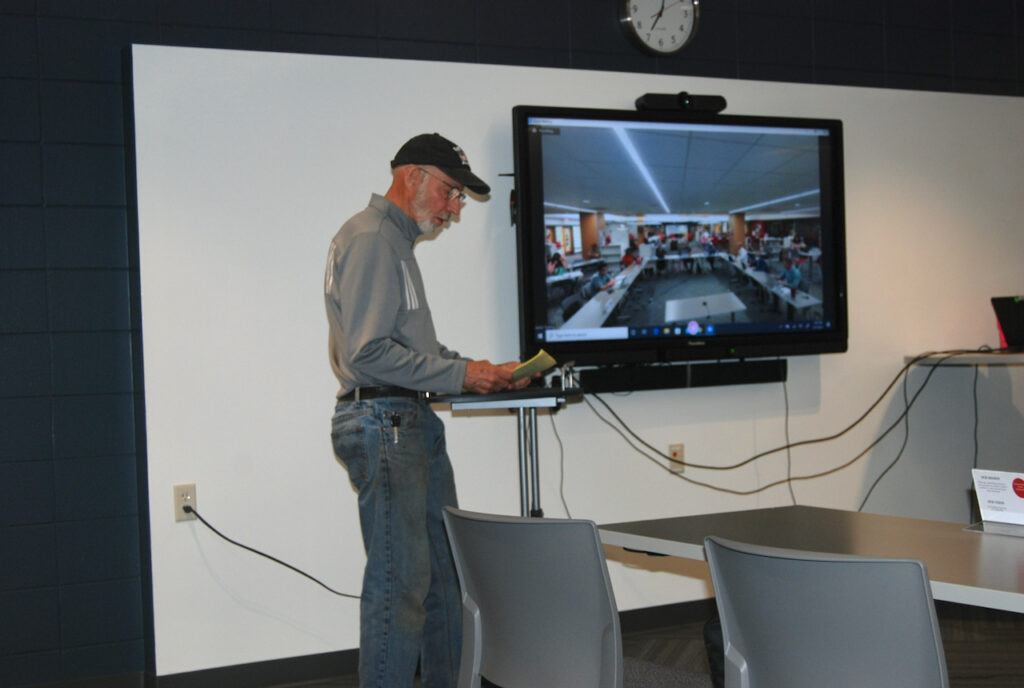
Whitewater resident and businessman Geoff Hale addresses the board with his concerns.
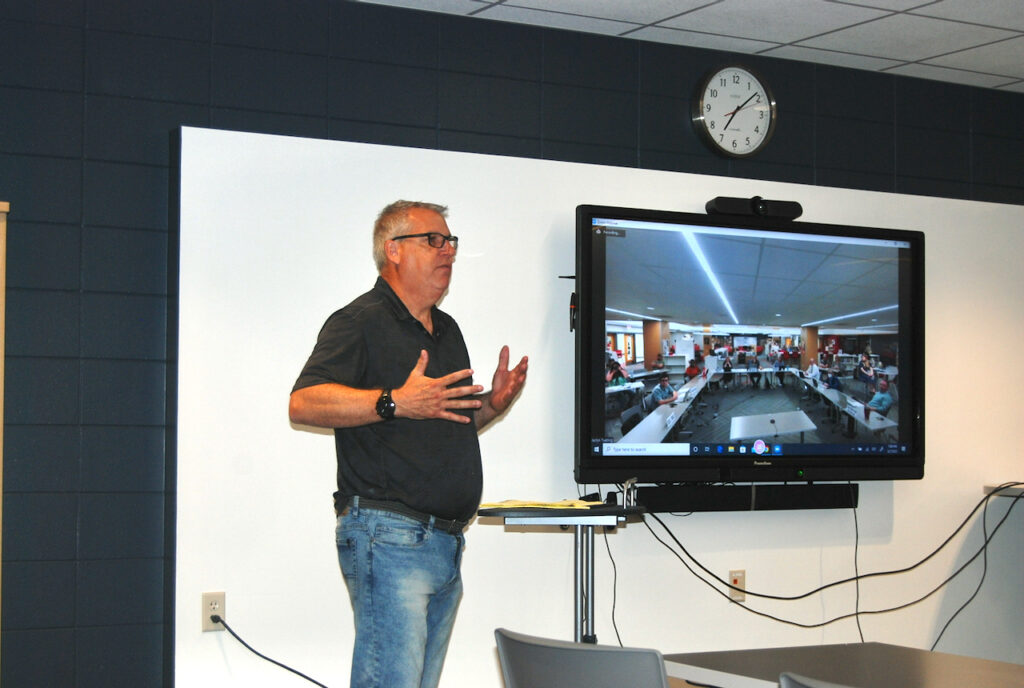
Whitewater resident Guy Ledwell shares his concerns about retaliation against teachers.

Holding a visual, Whitewater resident Lexy Maas shares her concerns about an eroding “middle tier” within the district.

District resident Andrea Svec shares her concerns about trust within the district and teachers’ rights to speak.
Kim McDarison photos.
Whitewater PD: man charged with disorderly conduct, failing to notify school of sex offender status
(Originally published June 10, 2022.)
Editor’s note: Information shared Thursday by the Whitewater Police Department on its Facebook page reports the following:
The Whitewater Police Department responded to two separate incidents that occurred on June 5 and 6 on the east side of the city.
The Whitewater Police Department received two separate reports of a male that was peering into a child’s bedroom window during the early morning hours of June 5 and 6. This incident was caught on video surveillance.
Additionally, this same male reportedly attended the Whitewater High School graduation ceremony on June 5.
On June 8, Christopher Cole, from the State of Kansas, was arrested for these incidents and criminal charges of Disorderly Conduct (2 counts) and Knowingly Failing to Notify School of Sex Offender Status were referred to the Walworth County District Attorney’s office.
The Whitewater Police Department recognizes that all defendants are presumed innocent unless proven guilty in a court of law.

Whitewater Municipal Building, file photo/Kim McDarison.
Tourism Department, Whitewater tourism council report economic growth in Walworth, Jefferson counties
(Originally published June 13, 2022.)
The Wisconsin Department of Tourism released on Wednesday its 2021 economic impact data, reporting that Wisconsin tourism generated $20.9 billion in total economic impact, with Walworth County contributing $790 million and Jefferson County contributing $179 million in total economic impact.
According to a news release produced by the Discover Whitewater Tourism Council, the department noted that statewide, economic impact increased 21% in 2021, with all 72 counties reporting double-digit growth over 2020. Wisconsin also hosted over 102.3 million visitor trips in 2021, up 12% from 2020.
Walworth County ranked 6th in the state for direct visitor spending growth in 2021, up 35.8% over 2020 figures.
Information noted by the Discover Whitewater Tourism Council reported that Whitewater saw local hotel occupancy “outpace forecasts as folks seeking outdoor adventure and quiet escapes chose our hidden gem as their vacation spot during 2021.”
According to the release, Karin Silvius, general manager at the Fairfield Inn and Suites, noted that in 2021, the average occupancy rate was 58.4%.
The measure was above anticipated levels for the new Whitewater hotel’s first official full year of operation, the release stated.
Additionally, tourism supported more than 169,700 full- and part-time jobs statewide across diverse sectors of the industry, up 7% over 2020, the release reported.
In 2021, Walworth County tourism generated more than 6,800 full- and part-time jobs across diverse sectors of the industry, up 16.1% percent over 2020. Jefferson County saw a 7.6% increase with over 1,500 jobs generated, the release stated.
“Wisconsin’s tourism recovery is something to be proud of. These successes are the result of intentional and strategic action by everyone who makes up our industry,” Wisconsin Department of Tourism Secretary-designee Anne Sayers, was quoted as saying in the release.
Within the department’s release, according to Discover Whitewater, the following statistics were shared: Visitors generated $1.4 billion in state and local taxes because of tourism spending.
“Without this tax revenue, each Wisconsin household would need to pay $580 to maintain the current level of government services generated by tourism,” the release noted.
For more information, including individual county figures and year-over-year growth, visit industry.travelwisconsin.com.
“Wisconsin tourism continues to recover, but has not fully recovered to Wisconsin tourism’s record-setting year of 2019, which saw $22.2 billion in total economic impact,” the release stated.
About Discover Whitewater Tourism Council
According to the release, the Whitewater Tourism Council is an advisory committee comprised of representatives from a cross-section of businesses and organizations serving tourists. The council works to market the Whitewater area as a regional tourism destination, highlighting the local history, culture, natural wonders, attractions and events. For more information, visit: www.discoverwhitewater.org.

Downtown Whitewater and the Discover Whitewater Tourism Council office on Main Street, file photo/contributed.
DNR: Black bear sightings increase in summer; populations expanding south over last decade
(Originally published June 19, 2022.)
Following several recent black bear sightings across the state, the Wisconsin Department of Natural Resources (DNR) is reminding the public to take precautions to avoid potential conflicts this summer, according to information released Friday by the department.
Although black bears are most common in the northern half of the state, populations have been slowly expanding south over the last decade. Wisconsinites are encouraged to take the same bear precautions no matter what part of the state, the release stated.
While bear sightings in southern Wisconsin remain rare, sightings in Waukesha and Washington counties are a reminder that bears can be found in any county, the release noted.
Although not included in the DNR news release, according to information found on a Facebook page titled: “Walworth County Scanner Updates,” black bears have been spotted, as reported by commenters on the site, near Whitewater and Elkhorn.
On June 17, a comment on the page read: “from our inbox, Just saw a black bear in Elkhorn.”
On May 29, the Facebook page reported: “Cty P right before Bluff Creek small black bear in the road,” followed by, “From reader: I was the one who called it in, was a full sized black bear. Almost hit it in the road on my way home from work.”
The DNR release continued: Sightings usually increase in early summer when young bears strike out on their own for the first time. Bear breeding season also occurs in early summer resulting in many male bears wandering around in search of a mate.
If a bear is near your home or cabin:
- From a safe location, wave your arms and make noise to scare it away.
- Back away slowly and seek a safe location where you can wait for the bear to leave.
- When scaring a bear away, make sure it has a clear escape route; never corner a bear.
- If you encounter a bear while in the woods, DO NOT RUN, stay calm and do not approach the bear.
- Never approach any bear.
- For your safety, do not attempt to break up a fight between your pet and a bear.
Black bears are naturally cautious animals that normally avoid contact with people for their safety, but conflicts between people and bears can arise. Additionally, bears can quickly learn to associate humans with food when food sources are available.
If a bear finds food, such as bird feed or garbage near your home or cabin, it will likely return for more. Bear visits are more likely to stop when food is no longer available. Bears will periodically check sites where food was once available, so it may take several days to weeks after a food source has been removed for a bear to completely discontinue visiting food sites.
It is important to make sure these tasty food sources are hidden from bears at all times of the year, but it’s especially important in warmer months when bears are more active.
Follow these steps to avoid attracting black bears:
- Do not knowingly feed a bear.
- Completely remove bird feeders, even during daytime hours – Bears are active during the day and may cause problems even if the feeders are out only during that time.
- Clean areas where bird feeders were located so that accumulated deposits of spilled seed are removed.
- Reduce garbage odors by rinsing food cans before putting them in covered recycling containers or garbage cans.
- Keep meat scraps in the freezer until garbage day, and if possible, keep garbage cans in a closed building until the morning of pickup.
- Be sure to lock commercial dumpsters.
- Keep pet food inside or inaccessible to bears even during daytime hours.
- Keep grills and picnic tables clean.
Bears are normally solitary forest animals, but their powerful sense of smell can lead them into urban areas in search of food. Black bears are secretive animals and usually try to avoid people. However, conflicts with humans can occur when bears destroy gardens, bird feeders, apiaries and trash cans.
By understanding bear behavior, there are several ways people can reduce negative human-bear conflicts around their homes. The DNR’s Living With Black Bears In Wisconsin pamphlet is a great resource for learning more about co-existing with bears in Wisconsin.
The department partners with the U.S. Department of Agriculture’s Wildlife Services Program to respond to approximately 800 bear-related complaints reported in Wisconsin each year.
If unable to resolve a conflict with a bear, contact the USDA Wildlife Services toll-free line at 1-800-433-0663 for properties in Southern Wisconsin and 1-800-228-1368 for properties in Northern Wisconsin. Most complaints are resolved through technical advice.
More information regarding bears and safety is available on the DNR’s Bear Hunting webpage.

Black bears, photo courtesy of the U.S. Fish and Wildlife Service.
Dodge County: Whitewater city manager nominated as administrator, appointment set for Tuesday
(Originally published June 20, 2022.)
Dodge County Board Chairperson Dave Frohling has announced that the Dodge County Board of Supervisor’s Executive Committee has nominated Whitewater City Manager Cameron Clapper to serve as the next Dodge County administrator.
A resolution to appoint Clapper will come before the full board of supervisors during its meeting Tuesday.
According to the release, Clapper will succeed Jim Mielke, who retired on June 1.
The release noted that Clapper has been the Whitewater City Manager since 2012. Prior to that, he was Whitewater’s assistant to the city manager from 2010 to 2012. He served the village of Waunakee from 2005 to 2010 as a management/analyst/deputy clerk and then as assistant to the village administrator. He earned both a bachelor’s degree in International Studies and a master’s degree in Public Administration from Brigham Young University.
The county’s Executive Committee has been leading the administrator search, which began in March. It selected Clapper from a field of seventeen applicants for the position. Clapper and three other finalists participated in an assessment process on June 6 and 7 in Juneau, the release read.
Clapper’s nomination is subject to approval by the Dodge County Board of Supervisors. A meeting is scheduled for Tuesday, June 21.
If confirmed, Clapper will begin work in Dodge County on Aug. 21, the release stated.

Cameron Clapper
Dodge County Board hires Whitewater’s city manager
(Originally published June 21, 2022.)
By Chris Spangler
The Dodge County Board of Supervisors has selected Whitewater City Manager Cameron Clapper as its next county administrator.
During their meeting Tuesday evening, 28 of the 31 supervisors in attendance voted to hire Clapper to succeed Jim Mielke, who retired on June 1.
Supervisor David Guckenberger made the hiring motion, which was seconded by Supervisor Kira Sheahan-Malloy. Voting “no” were Supervisors Michael Butler, Jeff Breselow and Daniel Siegmann.
Two other supervisors were absent from the meeting.
Prior to the vote, Breselow questioned the proposed compensation plan.
According to a resolution provided in the board’s meeting packet, Clapper was appointed to the full-time, benefited position of county administrator, effective August 21, at Step 1 of Labor Grade AA of the Dodge County Wage Schedule, at a beginning annual salary equivalent to $67.88 per hour, and, in addition, the same fringe benefits that are provided to department heads of the county to be administered in accordance with the ordinances, resolutions and policies of the county, including a beginning Paid Time Off Accrual Rate of .103 per hour, accrued and used in accordance with Dodge County’s Paid Time Off Policy.
Clapper’s employment agreement runs from Aug. 22, 2022, until Aug. 21, 2025, with a clause allowing for the automatic renewal of an additional year.
Said Breselow: “We’re offering this position, this money, as if he’s been with us for how long already? I think this is a bad precedent to set, to start out at the top wages with a new employee.
“I mean, we’ve not even proven what we’re paying for at this point.”
Board Chairperson Dave Frohling responded that this is at Step One, rather than the top, of the salary scale. He said he believes it is the same as what Mielke was paid.
“So our past administrator that was with us 16 years was at Level One?” Breselow asked.
Frohling said that following a wage study, he was placed at Step One of a new pay grade.
Breselow also questioned the vacation time.
“I also think it’s a tough sell to the rest of our county employees to start someone off at three weeks of vacation, when they have to work 10 years to get that,” he said. “We’re talking about employee morale in the county and how to keep and retain employees. It doesn’t sit well with me.”
Also speaking was Supervisor Robert Boelk Jr., who noted that this was a contract negotiated according to parameters set by the board.
“I think this is as good as we’re going to get at this point, and I hate to start over from Square One for the fact that we’ve already decided on the county administrator,” he said.
“Nothing’s fair all the time in life and a lot of people want to get 100 percent of what they want to get,” Boelk added. “But at the end of the day, when you are negotiating kind of a high salary compensation package, this is probably the fairest deal we’re going to come up with.”
Frohling previously had announced in a press release that the board’s Executive Committee nominated Clapper to serve as Dodge County administrator.
He said the county’s Executive Committee had been leading the administrator search, which began in March. It selected Clapper from a field of 17 applicants for the position.
Clapper and three other finalists participated in an assessment process on June 6 and 7 in Juneau, with Clapper nominated for the post by the Executive Committee, Frohling said.
Clapper has served as Whitewater city manager since 2012. He was Whitewater’s assistant to the city manager from 2010-12.
In addition, Clapper was employed as a management/analyst/deputy clerk in the Village of Waunakee from 2005-10 and then as assistant to the village administrator.
He earned both a bachelor’s degree in International Studies and a master’s degree in public administration from Brigham Young University.
Clapper is slated to begin work in Dodge County on Aug. 21, according to Frohling.
During a Whitewater Common Council meeting also held Tuesday, Clapper told those in attendance that his last day as city manager would be Aug. 12.

Cameron Clapper
Whitewater: Council approves police chief’s employment ‘terms of release’
(Originally published June 22, 2022.)
By Kim McDarison
The Whitewater Common Council Tuesday announced it has approved a Release and Employment Disposition Agreement with City of Whitewater Police Chief Aaron Raap.
The chief was placed on paid administrative leave in December.
The administrative leave, and what was described by Whitewater city officials in a press release made available on Dec. 3, 2021, as an internal investigation, followed battery charges brought by the Waukesha County Sheriff’s Department and filed with the Waukesha County District Attorney’s office.
According to a criminal complaint filed by the department with the Waukesha County District Attorney’s office, law enforcement responded to a disturbance at Raap’s Waukesha County home last November. Waukesha County District Attorney Susan Opper told Fort Atkinson Online, on Dec. 16, that she was not proceeding with the charges and the criminal case was dropped.
Following several requests, an explanation for the internal investigation of Raap was not disclosed in press-released information shared by the city with Fort Atkinson Online. Information about the investigation released to the media in January is here: https://fortatkinsononline.com/investigation-of-police-chief-remains-ongoing-whitewater-city-officials-say/.
Within the information released in January, Whitewater City Manager Cameron Clapper wrote that the city had received a number of media inquiries about the status of the investigation, adding: “The procedure is part of a broader effort to maintain the integrity of the organization as a whole, not a criminal investigation. As a result, the internal investigation runs independent from any decisions made by other agencies including Waukesha County’s District Attorney’s Office and will be completed as soon as possible.”
On Tuesday, a closed-session meeting was held to discuss “consideration of the terms” of the chief’s employment agreement with the city, after which a document, titled “Resignation Agreement, Waiver And Release Between: City of Whitewater and Aaron Raap,” was released.
The document states that Raap and the city agree “the employee’s voluntary and irrevocable resignation and retirement is effective on June 30, 2022.”
A letter of resignation must be submitted by Raap to the city’s Fire and Police Commission no later than noon, June 30, the agreement stipulates.
Additionally, the document states, “The employee desires, through this agreement, to finalize his separation from employment with the city, to resign and retire, and accept the terms of this agreement.”
The document further states that the parties “agree to mutual termination,” adding: the “employee and the city desire to retain amicable relations and cooperation throughout the entirety of this agreement and they desire to amicably resolve any and all outstanding differences and concerns.”
According to the document, following the resignation date, Raap will receive his accrued, unused vacation leave.
“Payments shall be paid at employee’s straight time hourly rate of pay in effect as of the effective date. Employee and his qualified dependents may timely and properly elect COBRA coverage in according with applicable law if eligible,” the document stated.
Further, the document noted, from the resignation date until Dec. 31, 2022, Raap will continue to be paid only his regular hourly wage as if regularly scheduled for work, with his pay rate adjusted effective Jan. 1, 2022, by 2.25% and the medical insurance stipend of $400 per month from July through December, with the understanding that such salary continuation pay shall offset any unemployment insurance benefits due him for the periods of time that such payments are applicable.
The document also stipulated that the city has no obligation to continue the employee’s benefits or pay premiums or contributions on his behalf beyond the resignation date.
Within the document, both parties agree to “no admission of liability,” with language stating that participation in the agreement by the parties is “not to be construed as an admission of any wrongdoing or liability whatsoever by or on behalf of the employee, the city, or related parties.”
Under the terms of the agreement, the city agrees to provide Raap with a Whitewater Police Department identification card on or after June 30, noting his highest achieved rank and noting his status as retired; with his class A uniform, cap and accompanying shield, and will permit Raap the opportunity to clear his police department office of all personal items.
The city will also provide Raap with an employment reference letter, stating that he was employed with the city as its police chief under the command of the city manager. The letter will indicate that Raap began his employment with the city on June 1, 2018 and resigned and retired on June 30, 2022.
An earlier story about the Whitewater City Council’s deliberations relative to the chief’s employment is here: https://fortatkinsononline.com/whitewater-city-considers-possible-release-and-employment-disposition-agreement-with-police-chief/.
The full agreement and reference letter is here: http://fortatkinsononline.com/wp-content/uploads/2022/07/police-chief-agreement-.pdf.

Aaron Raap
Whitewater: Council explores hiring firm to conduct city manager search
(Originally published June 25, 2022.)
By Kim McDarison
The City of Whitewater Common Council officially learned Tuesday that City Manager Cameron Clapper was approved by the Dodge County Board of Supervisors as its new county administrator.
The board approved its resolution to hire Clapper Tuesday during the same time that the city’s common council meeting was taking place.
During the council meeting, Clapper shared a memo with council members noting his new position and suggesting a recruitment process be undertaken to find his replacement.
He asked for direction from council relative to hiring a firm to facilitate the hiring of the next city manager.
Council directed staff to explore the possibility.
In the memo, Clapper wrote: “As common council members may be aware, the city manager has been nominated to fill the role of county administrator for Dodge County beginning in August.”
In addition, Clapper wrote, should the board affirm his nomination during its June 21 meeting, he would tender his formal resignation June 22.
During the council meeting, Clapper told those in attendance that his last day as city manager would be Aug. 12.
The memo continued: “While Whitewater is equipped with excellent professional staff members capable of conducting a recruitment for the city manager position on behalf of the common council, the use of a third-party firm to assist in the recruitment is common among municipalities and is also strongly recommended on the part of the soon-to-depart city manager.”
Clapper suggested to council in his memo that a third-party firm specializing in professional recruitments could provide a “broader professional network of qualified candidates,” while assisting with the “development of recruitment materials,” as well as experience and expertise.
He noted that some firms are capable of providing clients with the services of an interim manager, if one is needed.
During Tuesday’s city council meeting, Clapper suggested council direct staff to solicit the cost of proposals from area recruitment firms, with requests for proposals looking to firms to provide the following information:
• Costs associated with the recruitment process, such as the solicitation, application reviews, finalist selections, final reviews and contract negotiation services, as well as meetings to review candidates and the interviewing process for finalists.
• Costs associated with providing an interim city manager during the recruitment process.
Proposals are anticipated to be presented during the council’s July 19 meeting, or if applicable, during an earlier scheduled special meeting of the council.

Whitewater Municipal Building, file photo/Kim McDarison
Whitewater: Community Engagement Center holds ‘soft’ grand opening
(Originally published June 25, 2022.)
By Kim McDarison
A “soft” grand opening was held Thursday at the Community Engagement Center (CEC), Whitewater.
The building, 1260 W. Main St., which is often referenced by residents as “the purple building,” due to its distinctive exterior, is operated by the University of Wisconsin-Whitewater, and tenants, coordinators and volunteers at the grand opening were eager to make people aware of the amenities and services inside, all of which are available to the public.
Among volunteers on hand Thursday to greet and inform the public was CEC advisor and team member Meghan Williams, who explained that while the facility is privately owned, UW-Whitewater leases the space with an option towards ownership. Operations inside the building are managed with UW-Whitewater oversight, she said.
The university opened the CEC in 2019, Williams, who is an audit liaison at UW-Whitewater, noted, and a grand opening event had been planned for March in 2020. Then came COVID, she said. It put a hold on grand opening plans.
“The purpose of today is to open the Community Engagement Center to the public and let them know we are a place with space to rent for events. We are inviting the public in to see what is here,” she said.
“Post COVID, we decided to have a soft grand opening,” she said, adding that the CEC team set a goal of having 100 people tour the building. The event opened at 4 p.m., and by 4:30, she said, some 50 people had arrived to check the place out. With the event planned to receive visitors until 6 p.m., Williams said she was very optimistic that the team would meet and even exceed its goal.
“When people come in, they are surprised at what’s here and they are surprised at what’s available to the public, Williams said.
The center is open 8 a.m. to 4:30 p.m., Monday through Friday.
“We accommodate evening and weekend events,” Williams added.
Currently, she said, the building is staffed with two student workers, and plans call for the addition of a CEC manager.
Among activities available during Thursday’s opening was a guided building tour. With a small group assembled, Maureen Quass, a project coordinator at UW-Whitewater, began the tour in the building’s onsite print shop.
As the group moved through the halls, tour participants were encouraged to stop and walk inside the various spaces.
According to a printed brochure, the building offers some 11,000 square feet of newly renovated space, which includes 12 flex spaces, some of which can accommodate groups up to 200 people; board meeting rooms; training and classrooms; a commercial catering kitchen and even an art gallery.
Among those on hand to answer questions and give tours was Molly Fuller, who serves as a member of the CEC advisory board and was volunteering her time during the open house.
Inside the Community Engagement Center Gallery, Fuller pointed to a collection of 2D and 3D art pieces, some of which were made as prop and costume contributions for a theatrical production titled: “She Kills Monsters,” which, the exhibition brochure noted, was the creation of Qui Nguyen and focuses on “overcoming adversities and defeating the inner dragon, a subject matter that is larger and seemingly more powerful than the self.”
According to the printed exhibition program, the “monsters” are the work of Eric Appleton, a professor of scenic design. “Head pieces” are the work of Marshall Anderson, professor emeritus of costume design, and selected prop and costume pieces are the work of student designers Abby Lezama-Smith and Lydia Oestriech. The UW-Whitewater theatrical production was directed by Sara J. Griffin.
Other pieces included in the exhibition are from the UW-Whitewater permanent collection and span a broad range of mediums.
The building further boasts a Co-Working Cafe, which features open work and collaboration space, individual workstations, conversation nooks and more.
Finding opportunity from within the commercial catering kitchen, which is available to rent or to support an event, Fuller said, is Nordskov, a company that makes Nordic style craft coffee.
Owner Ryan Rouse said he began the business with his partner, Sheryl Rosa, and they have been operating from the kitchen in the CEC since March. The company brings in raw green beans from all around the world, he said.
“We do 100% of our business from here,” Rouse said, adding that services within the building, like the print shop, make it easy to take care of many of his business needs right inside the center.
According to information on the company’s website, only a few micro batches are roasted each week. Coffee can be picked up at the CEC and the company participates as a merchant at the Janesville Farmers Market.
More about the company is found here: https://www.nordskovgoods.com.
Advocating the use of the CEC kitchen, Rouse said: “I would love to see more businesses in the area and this is an efficient way to do it.”
Other community members on hand at the grand opening included Whitewater Common Council President Lisa Dawsey Smith who was passing out literature and answering questions. Dawsey Smith said she was participating as a Downtown Whitewater, Inc., volunteer. The organization works at “spearheading community efforts to re-energize and enhance our historic downtown,” according to its website.
Also helping out was Executive Director of the Whitewater Area Chamber of Commerce Kellie Carper.
Among those greeting guests with Warhawk enthusiasm was “Willie Warhawk,” who charmed visitors and posed for photo ops.
For more information about the CEC, and inquiries about room rental fees and services available to the public, visit: uww.edu/community-engagement-center.
Following are photographs from Thursday’s open house.

University of Wisconsin-Whitewater mascot “Willie Warhawk” greets visitors to the Community Engagement Center Thursday during a “soft” open house.

Visitors entering the Community Engagement Center Thursday are directed to several tables where volunteers organize tours and hand out literature.
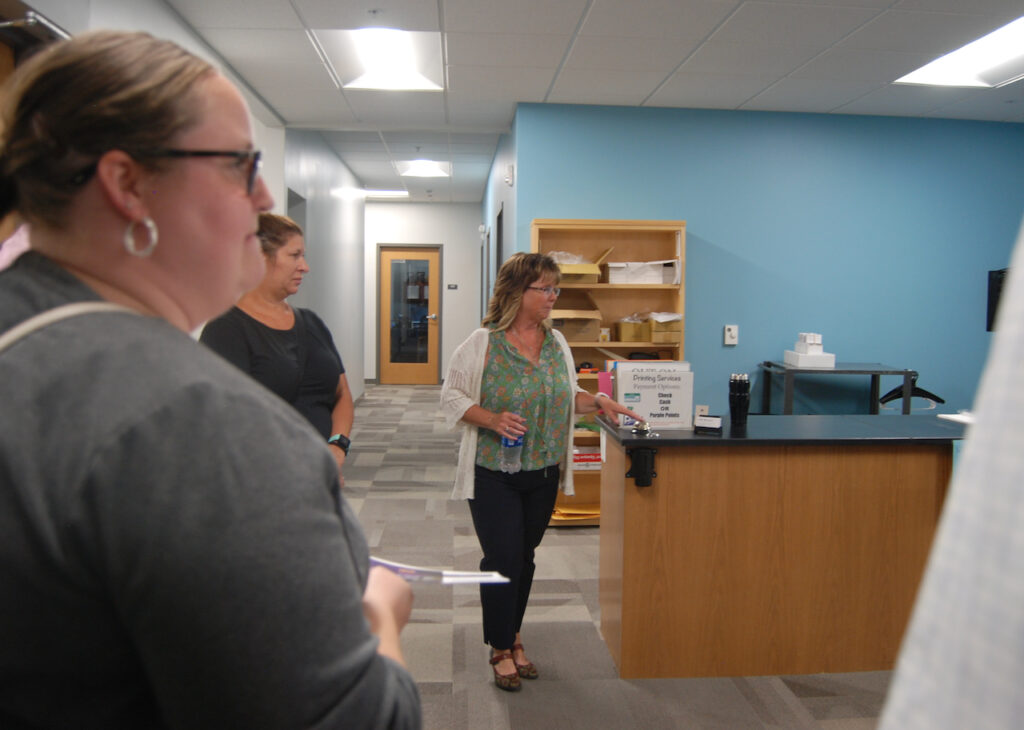
Leading a guided tour of the building, Maureen Quass, a project coordinator at UW-Whitewater, at right, begins with the center’s onsite print shop.
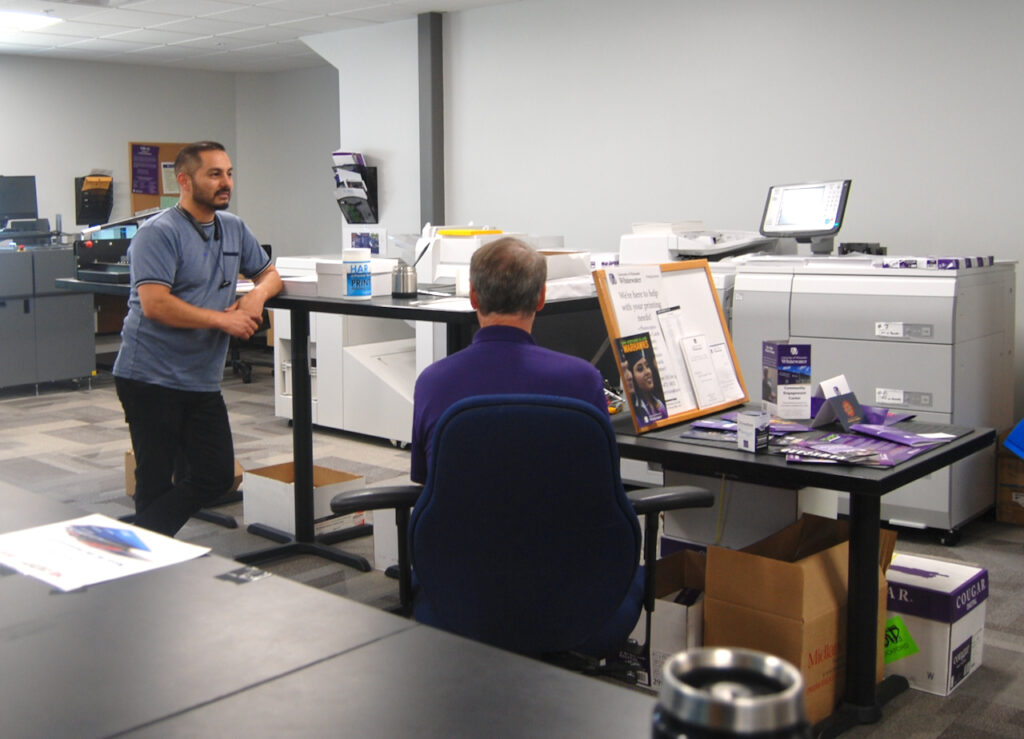
Print shop staff greet visitors and answer questions.
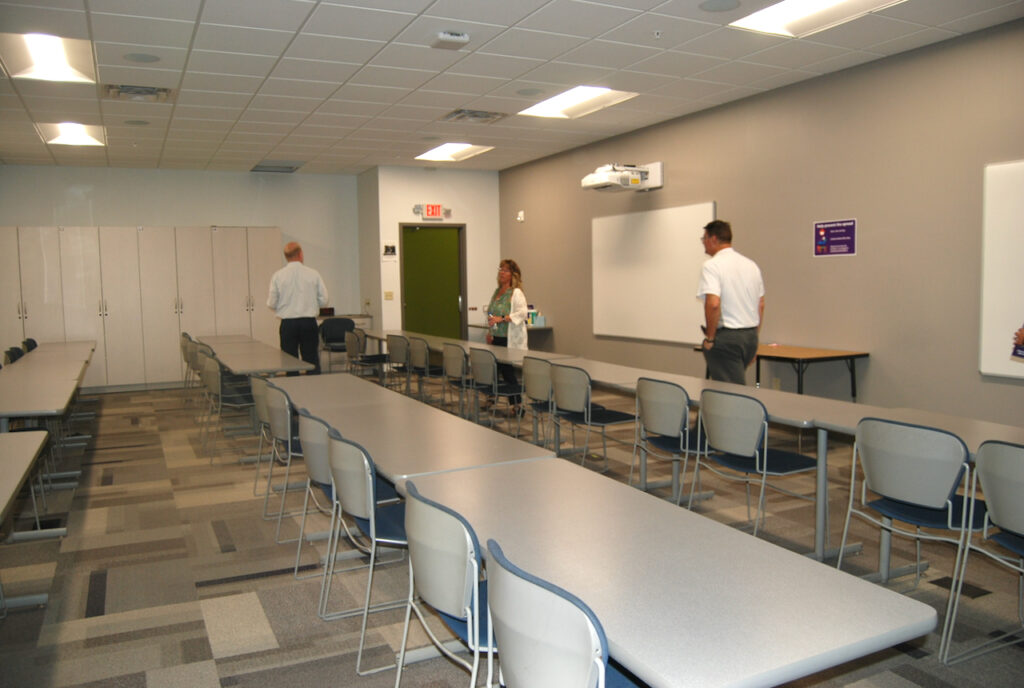
Members of a tour group visit a rentable classroom space.

A peek inside a rentable conference room is offered to tour participants.
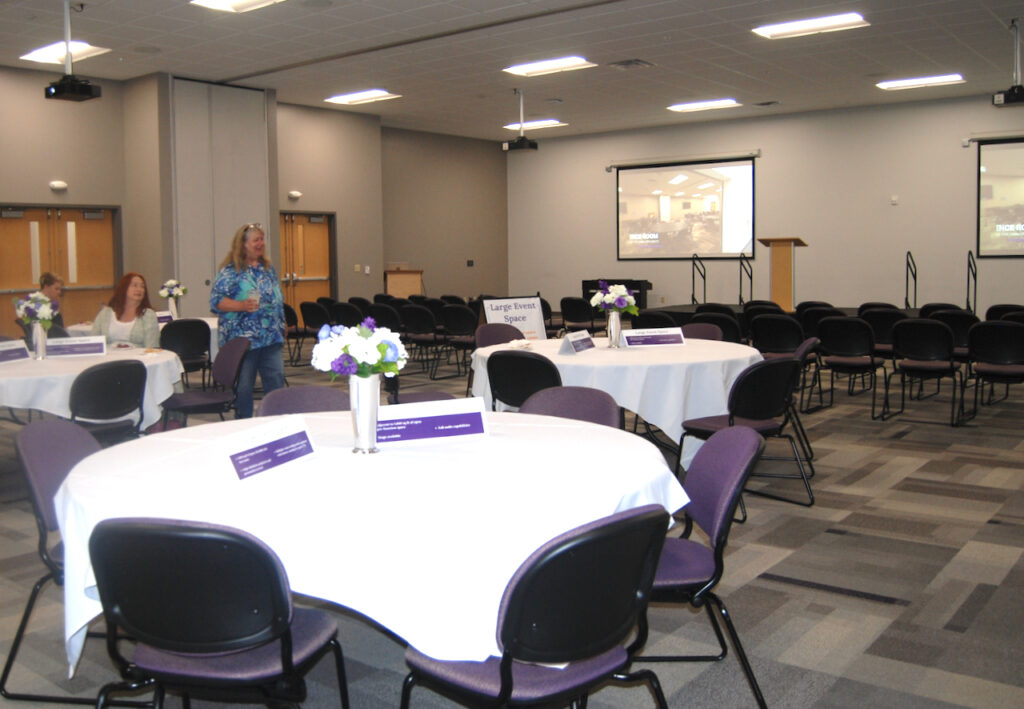
A large event space is available at the Community Engagement Center.
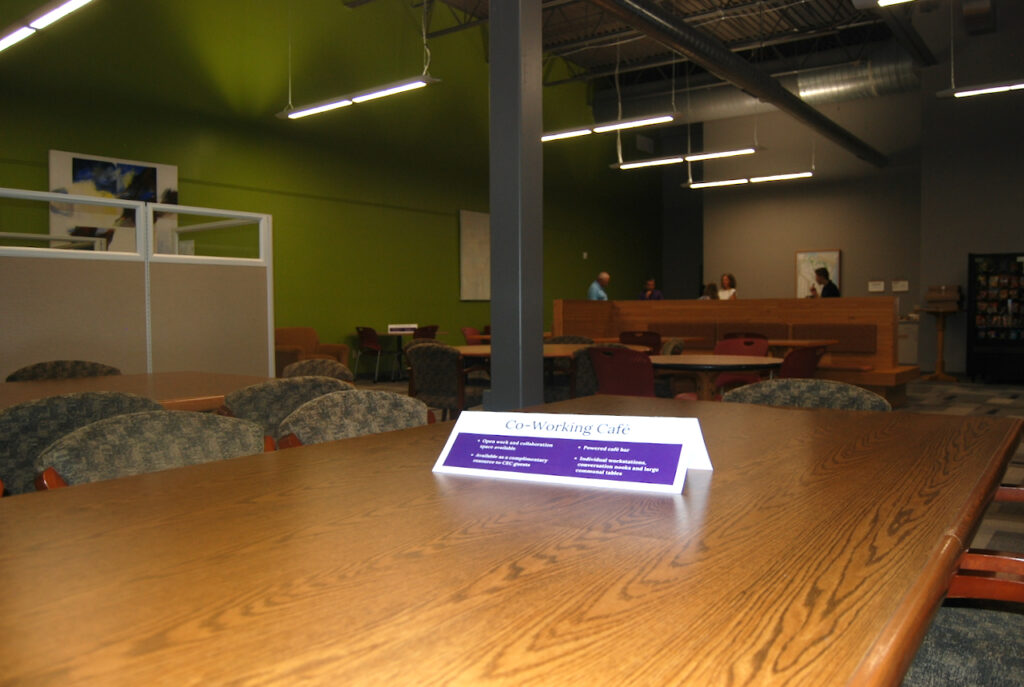
The Co-Working Cafe provides myriad opportunities for community members looking to work or study.
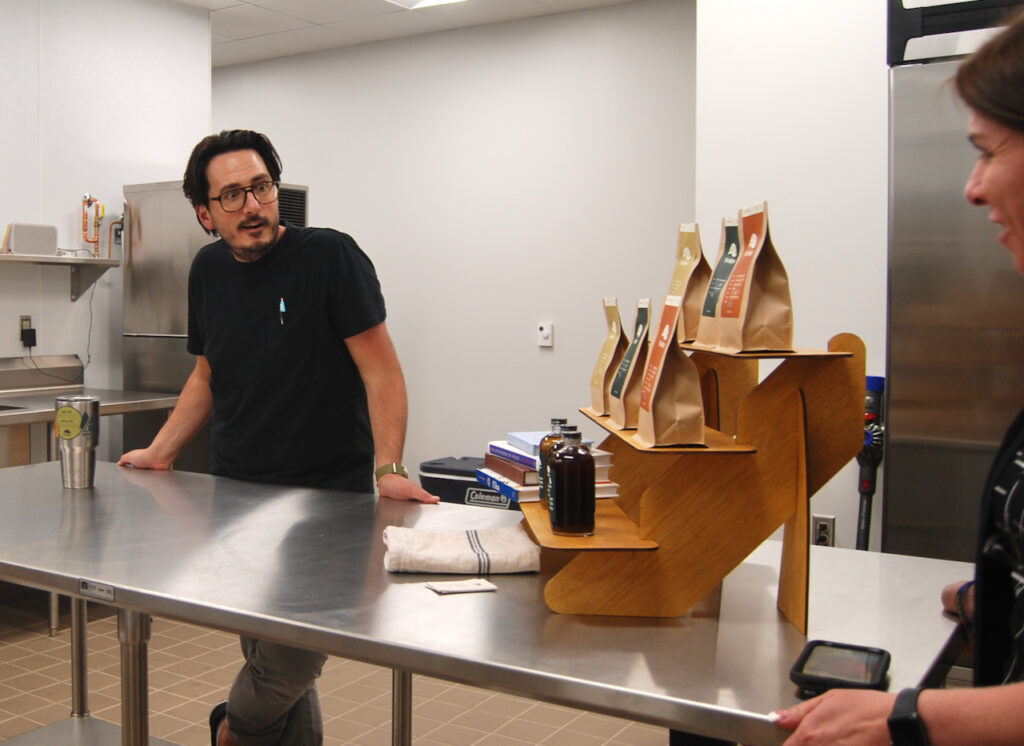
Greeting visitors to the center’s rentable catering kitchen, Ryan Rouse shares his experience starting a business, along with his partner, Sheryl Rosa, not pictured, from the Community Engagement Center. The pair owns and operates Nordskov, a company that makes Nordic style craft coffee.
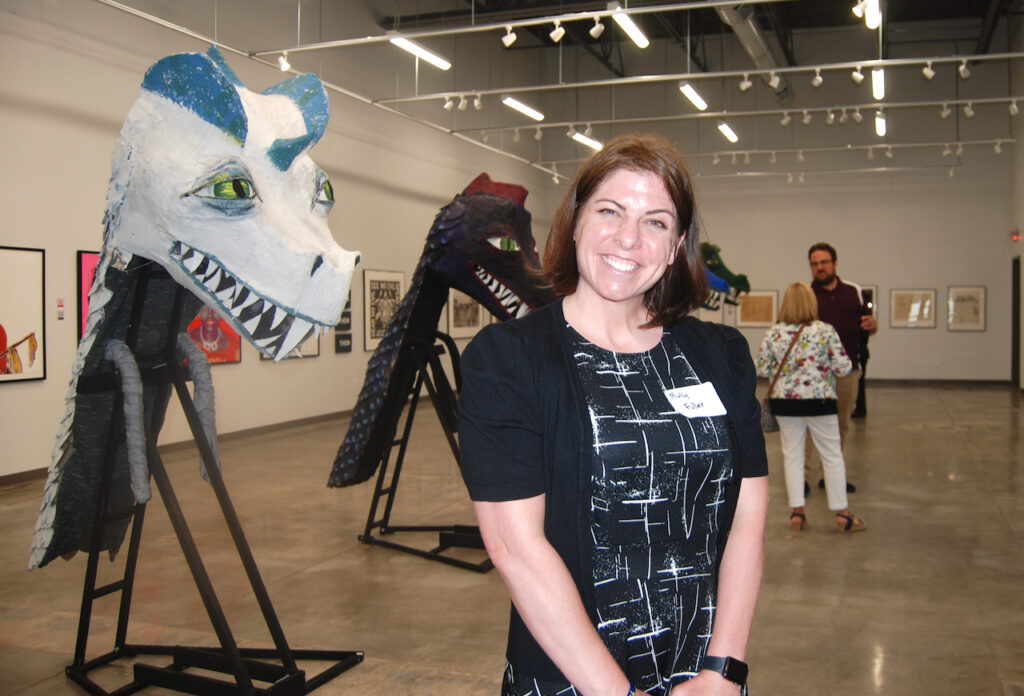
Volunteering as a tour guide, Molly Fuller, who serves as a member of the CEC advisory board, presents a view inside the Community Engagement Center Gallery. Fuller pointed to a collection of 2D and 3D art pieces, some of which were made as prop and costume contributions for a theatrical production titled: “She Kills Monsters.”

Art eyes visitors to the Community Engagement Center Gallery.
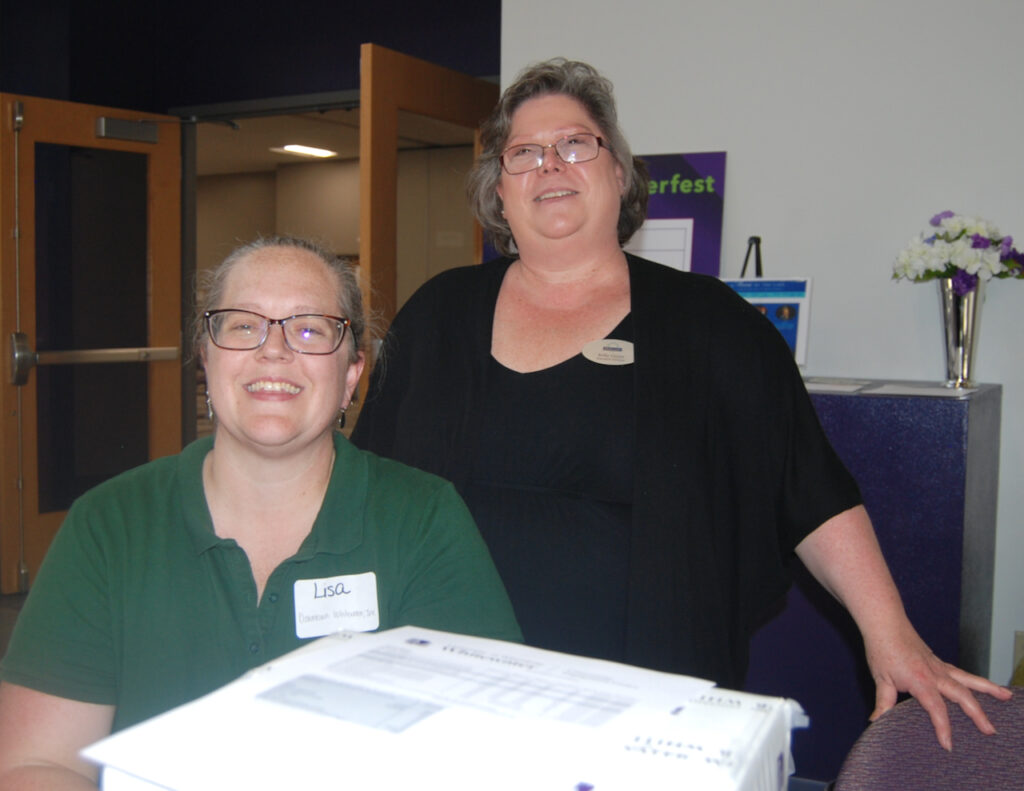
Manning an information table, grand opening volunteers Lisa Dawsey Smith, at left, and Kellie Carper greet guests as they arrive Thursday afternoon.

Grand opening volunteer Lisa Dawsey Smith demonstrates the use of a Willie Warhawk photo-op cutout.
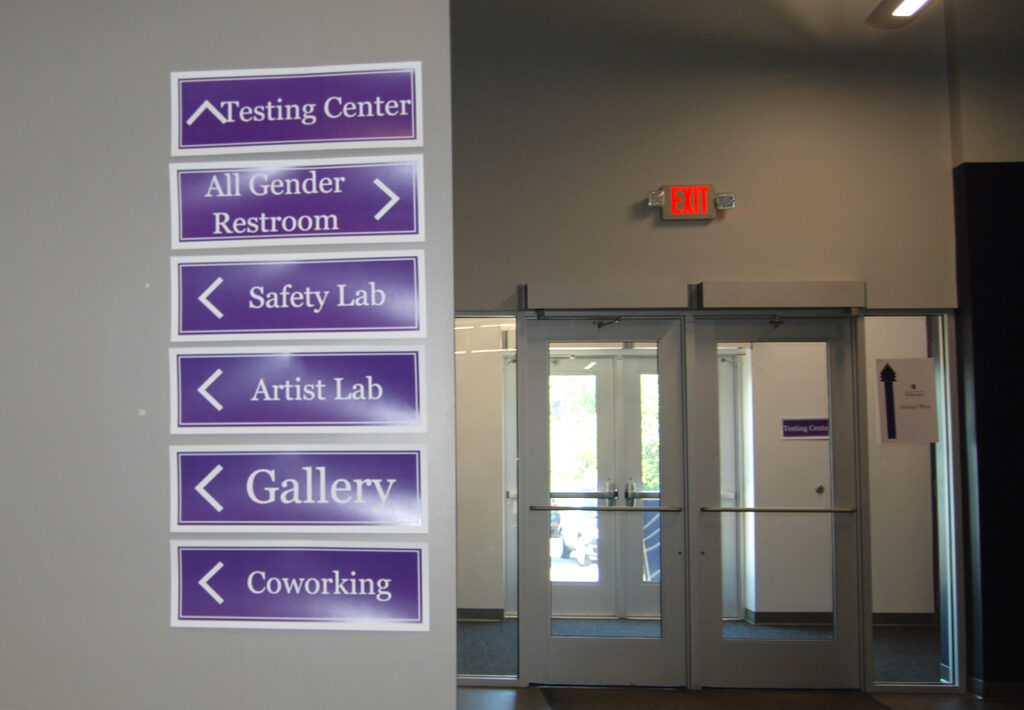
Signage points visitors to various amenities found within the Community Engagement Center.
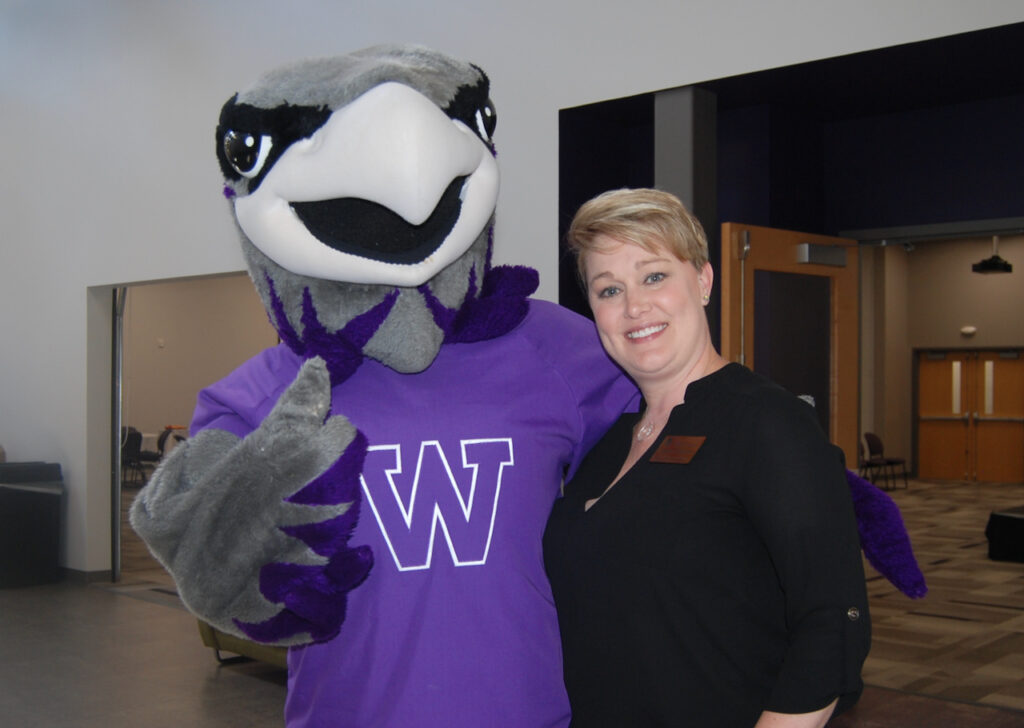
Community Engagement Center advisor and team member Meghan Williams and Willie Warhawk greet visitors at the center’s grand opening held Thursday.
Kim McDarison photos.
Gefvert named Whitewater’s Lincoln Elementary School principal
(Originally published June 27, 2022.)
By Kim McDarison
Fort Atkinson High School Associate Principal Brad Gefvert has been hired by the Whitewater Unified School District as principal of Lincoln Elementary School.
Gefvert’s employment was approved by the Whitewater Unified School District Board of Education Monday.
Gefvert will be filling a position recently vacated by Mary Kilar whose employment with the School District of Fort Atkinson was announced by the district May 6. Kilar was hired to succeed Leigh Ann Scheuerell who accepted the position of principal at the Fort Atkinson High School beginning with the 2022-2023 school year.
According to information shared with Whitewater Unified School District board members within their meeting packet, Gefvert has served 20 years in the field of education, including the past eight years as associate principal at the Fort Atkinson High School.
He holds a masters degree, and has attended the University of Wisconsin-Platteville, UW-River Falls and Viterbo University.
Gefvert’s employment as principal of Lincoln Elementary is effective July 1.
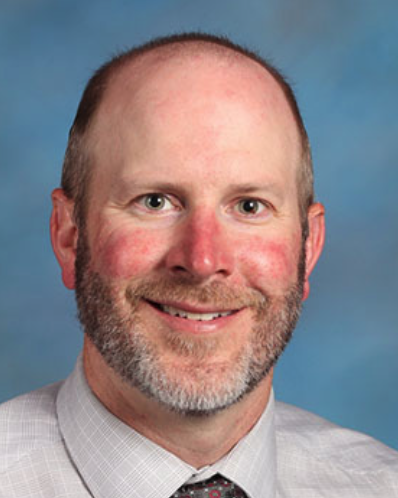
Brad Gefvert
Whitewater to conduct police chief search
(Originally published June 30, 2022.)
By Kim McDarison
The Whitewater Police and Fire Commission has unanimously approved plans to conduct an in-house search for a new police chief.
The search will be conducted by the city’s Human Resources Department in conjunction with the police and fire commission, according to Whitewater Police and Fire Commission Chairman Glenn Hayes.
The commission held a special meeting Thursday during which time the proposed plans were unanimously approved.
The decision was approved during an open-session meeting, which was held directly after the commission deliberated in closed session for approximately 30 minutes.
The closed-session meeting was held, according to the agenda, to consider employment, promotion, compensation or performance evaluation data of any public employee over which the body has jurisdiction or exercises responsibility, with the agenda further specifying the item to be discussed as the “appointment of chief of police.”
After the meeting, Hayes told Fort Atkinson Online that he anticipates meeting with the director of the city’s Human Resources Department to develop a process and timeline over which the search will take place.
He further anticipated, he said, that he would be able to return to a special meeting of the police and fire commission in about two weeks, at which time he would be able to further elaborate on the search plan and its associated timeline.
During the meeting, commissioners asked interim Whitewater Police Chief Dan Meyer if he would be wiling to continue in the capacity of interim while the process was under discussion.
Meyer said he would.
Meyer has been serving in an interim capacity with the police department as its chief since last December when then-Whitewater Police Chief Aaron Raap was placed on paid administrate leave, following an incident that occurred in his Waukesha County home last November.
While charges of simply battery related to the November incident were dropped by the Waukesha County District Attorney’s office, Whitewater city officials announced in December that an internal investigation continued to be ongoing.
During a Whitewater Common Council meeting held Tuesday, June 21, council accepted an employment “terms of release” agreement with Raap, providing him with an option to resign and retire.
Raap officially ended his tenure as an employee with the city Thursday.
In his resignation letter, dated June 29, and shared by the city with Fort Atkinson Online Thursday, Raap wrote: “As per the Common Council approved resignation/retirement agreement between the city of Whitewater and me, I am respectfully notifying you that my final day as our city’s police chief will the Thursday, June 30, 2022.”
He continued: “When I began employment with the city more than four years ago, I found that the police department was a well-organized and professional organization. It was, and remains, comprised of talented and dedicated sworn and civilian staff. They regularly make difficult decisions and institute some very unique solutions to ensure that the safety of our neighborhoods and business corridors are enhanced.
“I believe that I am leaving the police department in even better condition — especially in the areas of community outreach, enhanced transparency and with stronger connections to other entities within the greater criminal justice system.
“Alone, our individual accomplishments are impressive. Together, they are a record of achievement few police departments can match.”
Raap concluded his letter, writing: “I’m confident that the police department is strongly positioned to continue to provide superb law enforcement services.”
An earlier story about the agreement between the city and Raap is here: https://fortatkinsononline.com/whitewater-council-approves-police-chiefs-employment-terms-of-release/.

Members of the Whitewater Police and Fire Commission meet during a special meeting to discuss, first in closed session, and then in open session, plans to hire a new police chief. The commission unanimously approved undertaking a search process which will be conducted by the city’s Human Resources Department in conjunction with the police and fire commission.
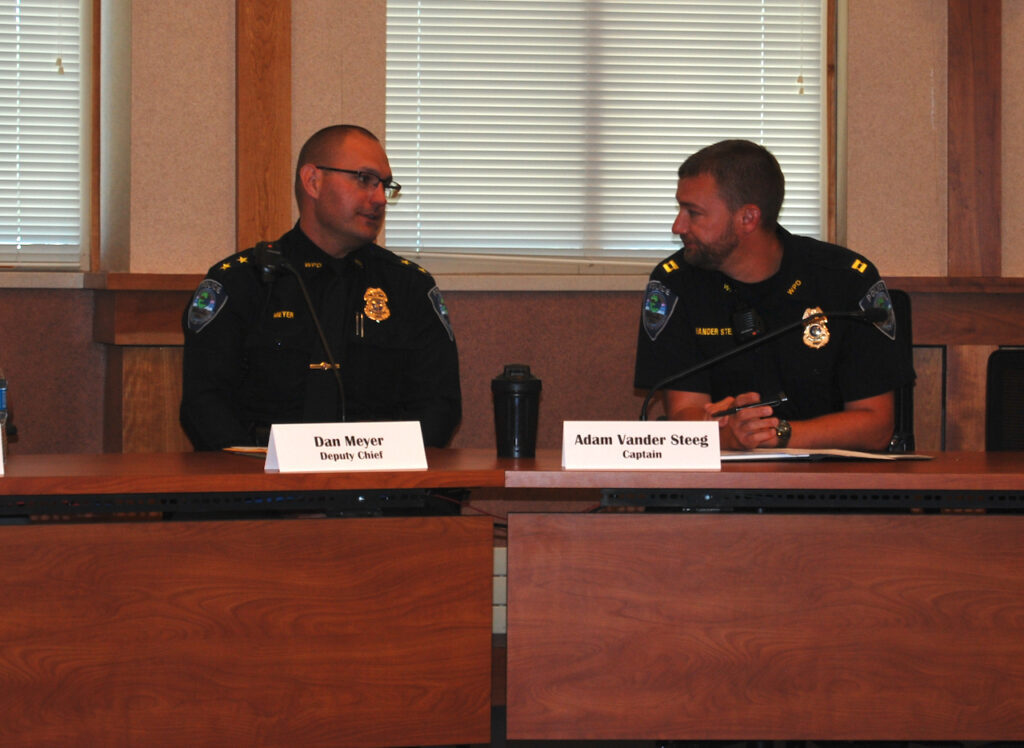
Whitewater interim Police Chief Dan Meyer, at left, and Whitewater Police Capt. Adam Vander Steeg converse in advance of the special meeting of the Whitewater Police and Fire Commission held Thursday. Kim McDarison photos.
70 vehicles on display at Whitewater’s Fourth of July car show
(Originally published July 3, 2022.)
By Kim McDarison
Some 70 vehicles, all entrants in the 37th Annual Whitewater Fourth of July Car Show, lined the municipal parking lot and grassy area across the street from the Whitewater Municipal Building Saturday.
The one-day show was among attractions offered at the Whitewater Fourth of July Festival.
Among committee members who organized the car show, spokesperson Chad O’Leary, of Milton, said this year’s event brought a very successful turnout, with more cars entering the show than last year.
He, and his wife, Jessica, displayed their vehicle, a 1958 Chevy Biscayne.
Among car enthusiasts displaying vehicles was Elmer Keske, Whitewater, who shared information about his 1954 Ford Mainline four-door.
He purchased the car about four years ago, he said, attracted to the make and model because it was the same as one he owned in his youth.
“I owned one just like it when I was 18. That one went to the junkyard,” he said. The one on display Saturday was purchased in Texas, he added.
After he purchased the car, he was rummaging around his property when he found his license plate from the vehicle he had in his youth.
Harry and Cindee Lenius, Watertown, said they were attracted to their 1957 Chevy Bel Air in part, Cindee said, “because we fell in love with the color.”
The bright blue vehicle was rebuilt 25 years ago, in 1995, Harry said. A framed collage of photographs on display with the car documented its restoration.
“The vehicle is all stock,” Harry added.
Don Morris, Elkhorn, brought a 1959 Chevy Corvette to the show.
Whitewater resident Rod Lorenz said he has owned his 1953 Chevy pickup 3100 five-window for 29 years.
Five years ago, he said, he brought the car to Perfect Auto in Burlington to have it “completely redone.” he received the car in its new condition Friday, just in time for the show.
“I love the big fender trucks. I drove it for many years,” he said, before he chose to have it restored.
The color of the paint is a feature they also enjoy, Lorenz, and his girlfriend, Jane Roberts, said.
The color is called Rose Metallic, Roberts noted. Lorenz said he attended the Indianapolis 500 in 2017 and saw a Corvette with the color. It was the only year that Corvettes were painted with the color, Roberts said. Lorenz liked it so much he had it painted on his truck.
Milton resident Steve Hatlen arrived with his 1997 Dodge Viper GTS. He has owned the car since 1997 and has kept it in its original condition, he said.
“Everything is original except the engine. I put a super charger on it,” he said.
In 1989, Hatlen said, he went to the Chicago Auto Show.
“They had a prototype there. The original came out in 1992. In 1996, they had a hardtop,” he said.
A year later, he decided to buy one before they stopped building them, he added.
Bobby Dworak, Burlington, and a former race car driver, said he purchased his 1938 Ford Humpback because he wanted something different.
He found the vehicle some 7 years ago, describing it as “partially in this condition.”
He has been restoring it since and said there is still more work to be done.
The car has been a hobby car for most of its life, Dworak said.
Attracting visitors to the Whitewater VFW tent was a 2011 Chevy Camaro owned by Mecum Auctions, which, VFW Post 5470 Quartermaster Curtis Lemke said, was on loan to the post to help with its ongoing fundraising efforts to build a new VFW center in Whitewater.
Plans call for the VFW to purchase an 1860-vintage cream brick building located in Whitewater at the corner of Walworth Avenue and Janesville Street.
In 2018, Lemke said, the former VFW building in Whitewater was razed to make room for apartments.
“There is a need for a VFW building because there are a lot of vets in the area, including student vets and ROTC members on campus. The car helps us bring attention to the project. It will be in the parade on Monday,” Lemke said.
Also on hand in support of the VFW project were Jason Dean and his wife, Jessica. Jason is the commander of Post 5470. The couple lives in LaGrange. Jason is running for an open Wisconsin Assembly seat in district 31 which will be decided this fall.
At the end of the day Saturday, O’Leary noted, five People’s Choice awards were given to car show participants. The awards were presented to car show winners with help from winners of Friday’s Miss Whitewater pageant.
The winners are:
Photos from the car show follow.

Harry and Cindee Lenius, Watertown, display their 1957 Chevy Bel Air. The vehicle was among 70 participating in the 37th Annual Whitewater Fourth of July Car Show and a recipient of one of the show’s five People’s Choice awards. The one-day show was held Saturday near Cravath Lakefront Park.

Don Morris, Elkhorn, displays his 1959 Chevy Corvette.

Jane Roberts, Florida, and Rod Lorenz, Whitewater, flank a 1953 Chevy pickup 3100 five-window. Lornez has owned the vehicle for 29 years. Five years ago, the vehicle began a restoration process which was completed Friday.

Several vehicles greet event-goers from their display space across the street from the Whitewater Municipal Building.

Vehicles of all color and vintage are on display. The one-day car show was held Saturday.


Two photos above: a variety of cars await viewing.

Milton resident Steve Hatlen, at left, stands near his 1997 Dodge Viper GTS. He has owned the car since 1997 and has kept it in its original condition, he said.

Bobby Dworak, Burlington, stands with his 1938 Ford Humpback. A former race car driver, he said he purchased the vehicle because he wanted something different.

Pretty in purple, a car show entrant awaits viewing.
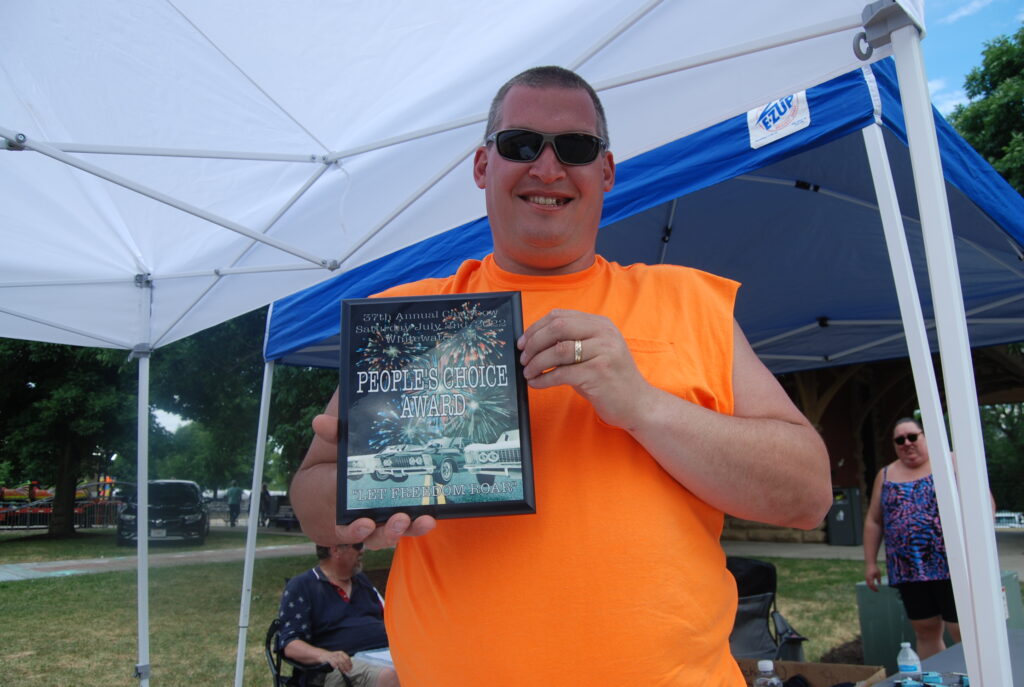
Car show organizing committee spokesperson Chad O’Leary holds one of five People’s Choice plaques which were awarded at the end of Saturday’s show.

A 1958 Chevy Biscayne owned by Chad and Jessica O’Leary, Milton, stands on display Saturday.


Two photos above: Event-goers are treated to a view both inside and out of the “Al Capone” car. The 2006 Chrysler 300 is owned by Lake Mills resident Mario Ortiz.

Whitewater VFW Post 5470 Quartermaster Curtis Lemke, at left, post Commander Jason Dean, at right, and his wife, Jessica, flank a 2011 Chevy Camaro owned by Mecum Auctions, which, Lemke said, was on loan to the post to help with its ongoing fundraising efforts to build a new VFW center in Whitewater.
Kim McDarison photos.
Whitewater Fourth of July parade 2022
(Originally published July 4, 2022.)
Whitewater held its annual four-day weekend Fourth of July celebratory event, which, on Monday, included a Fourth of July parade.
According to parade organizers, the city anticipated some 5,000 visitors from around the area arriving to watch the parade.
Among guests marching in the parade this year was Wisconsin Gov. Tony Evers.
He was joined by over 50 parade entrants, organizers said.
This year’s parade grand marshal was Master Sgt. Steve Edwards.
Pictured below are scenes from Monday’s Fourth of July parade in Whitewater.
Kim McDarison photos.


A character, flanked by golf carts, makes its way down Whitewater’s Main Street. The parade entry was supplied by Willow Brook Golf Course, Whitewater. The group took third place in the business and commercial floats category of the parade entrants competition.
A cluster of mini cars, operated by Zor Shriners, enters the intersection of Main and Fremont streets. The cars won “Best of Parade” in this year’s parade competition for floats and entries.

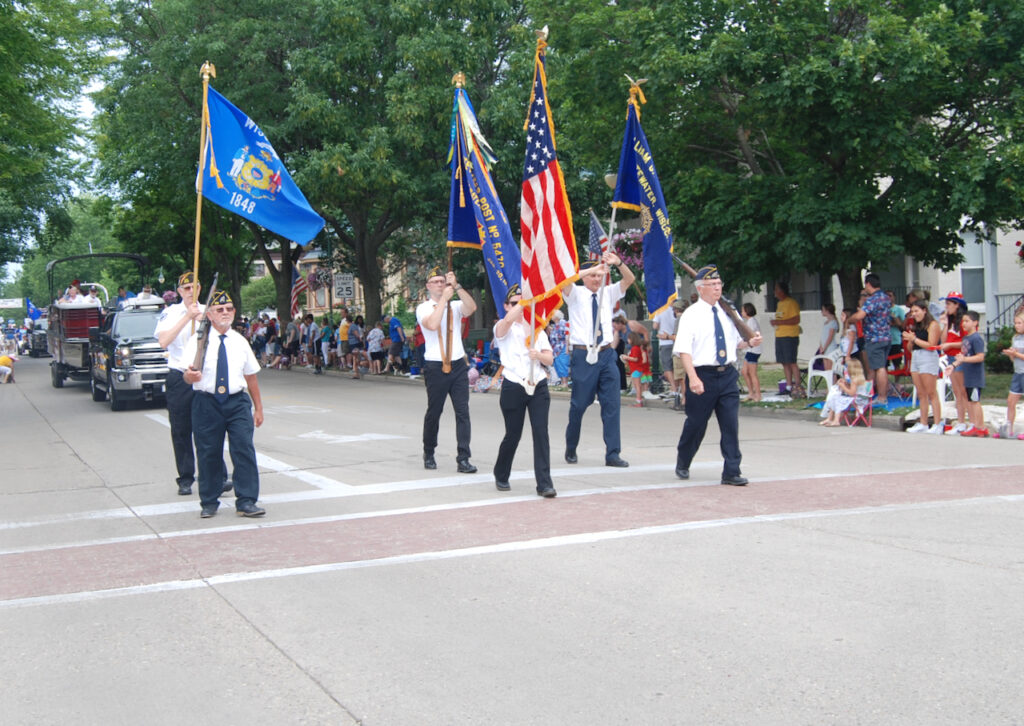
Walking the parade route, Wisconsin Gov. Tony Evers waves to the crowd and claps with excitement.
An honor guard leads the parade down Main Street. The honor guard was provided by Whitewater VFW Post 5470. Among its members is State Sen. Steve Nass, pictured at right.

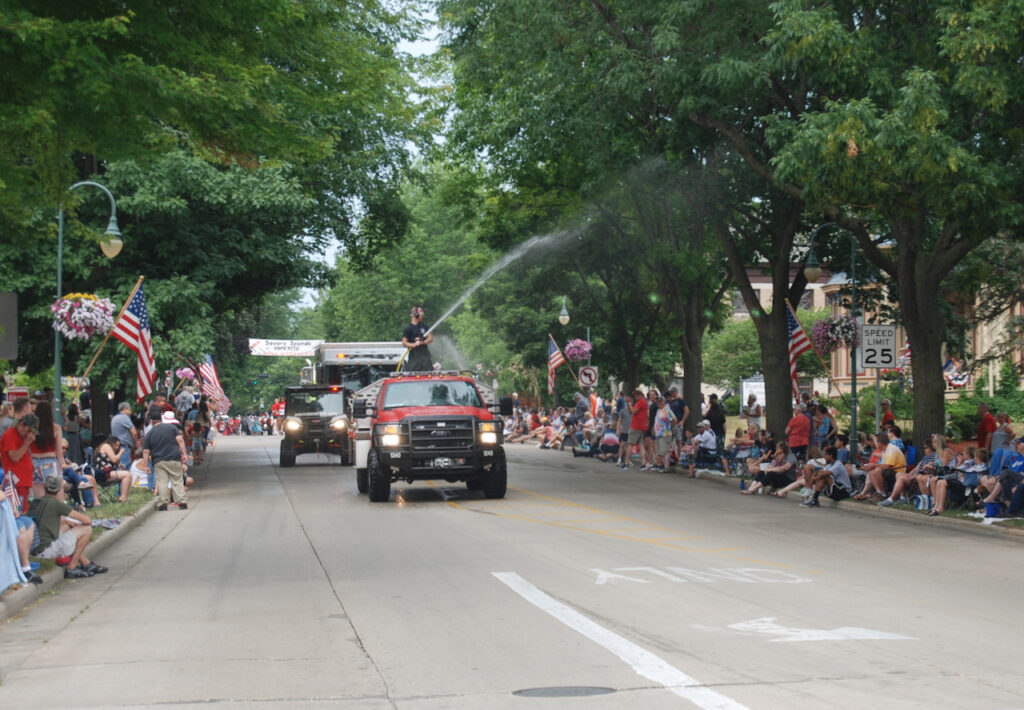
A group of exuberant young women toss candy to the crowd.
Members of the Whitewater Fire Department spray water on the crowd.
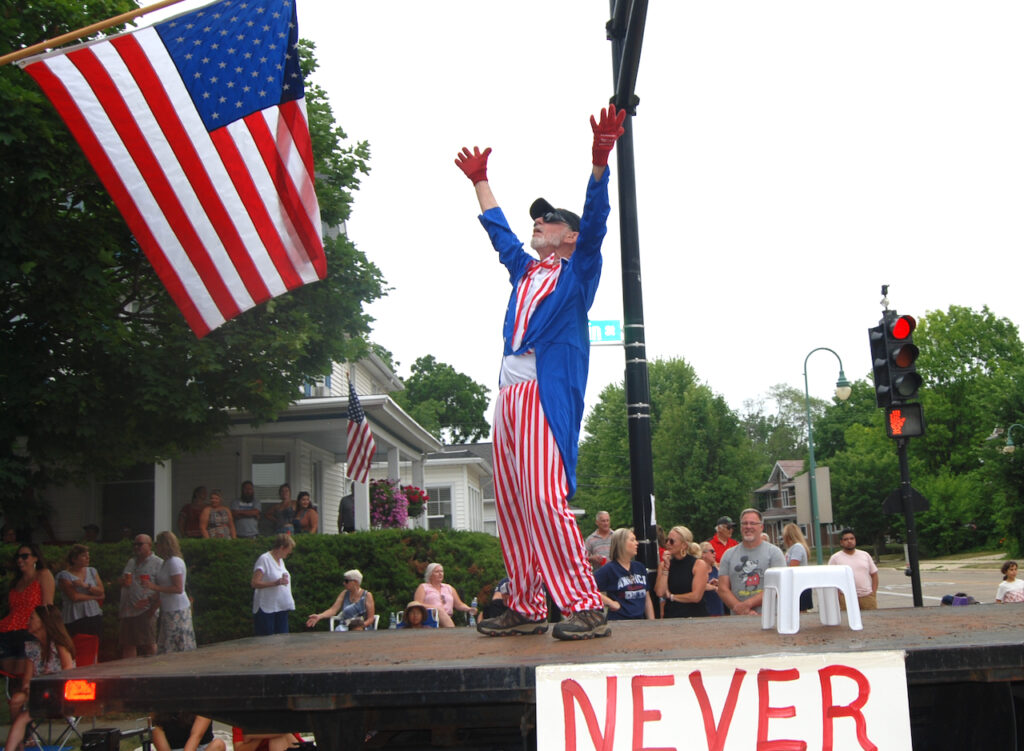

“Uncle Sam” entertains the crowd with his rendition of “God Bless the USA.” The performance was given from one of several Home Lumber parade entries.
A young woman hands out fliers informing the public about an upcoming performance of “Willy Wonka and the Chocolate Factory.” The performance will be held July 7 and 8, at 7 p.m., at the Whitewater High School auditorium. The performance is a production of the Whitewater Summer School Playhouse.


A young parade participant waves at the crowd.
A couple dressed in garb representing another era makes its way down Main Street.
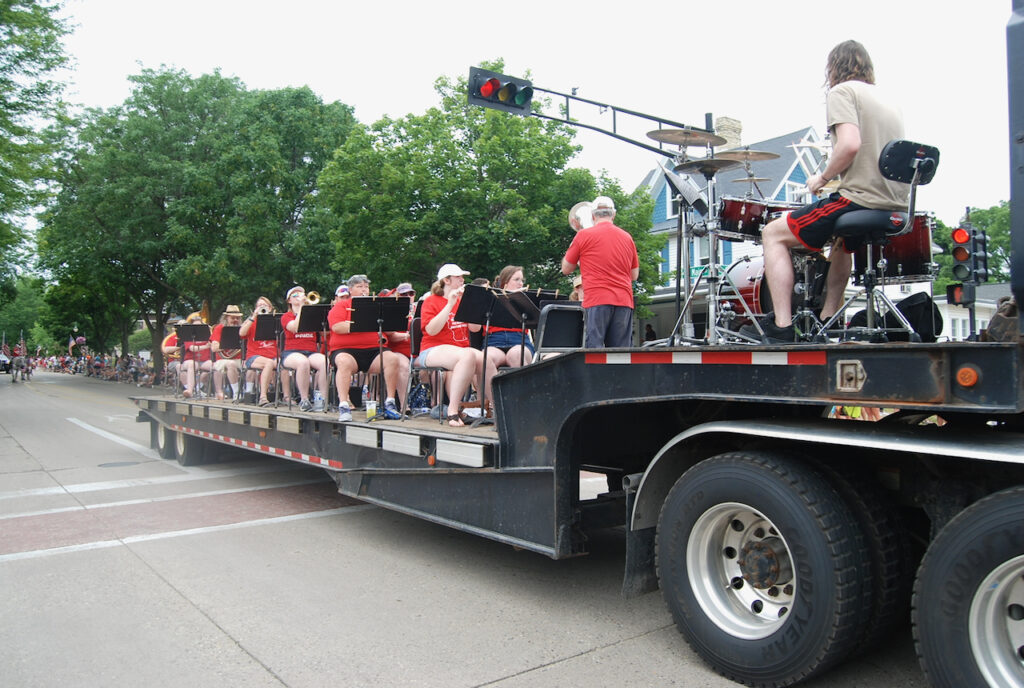
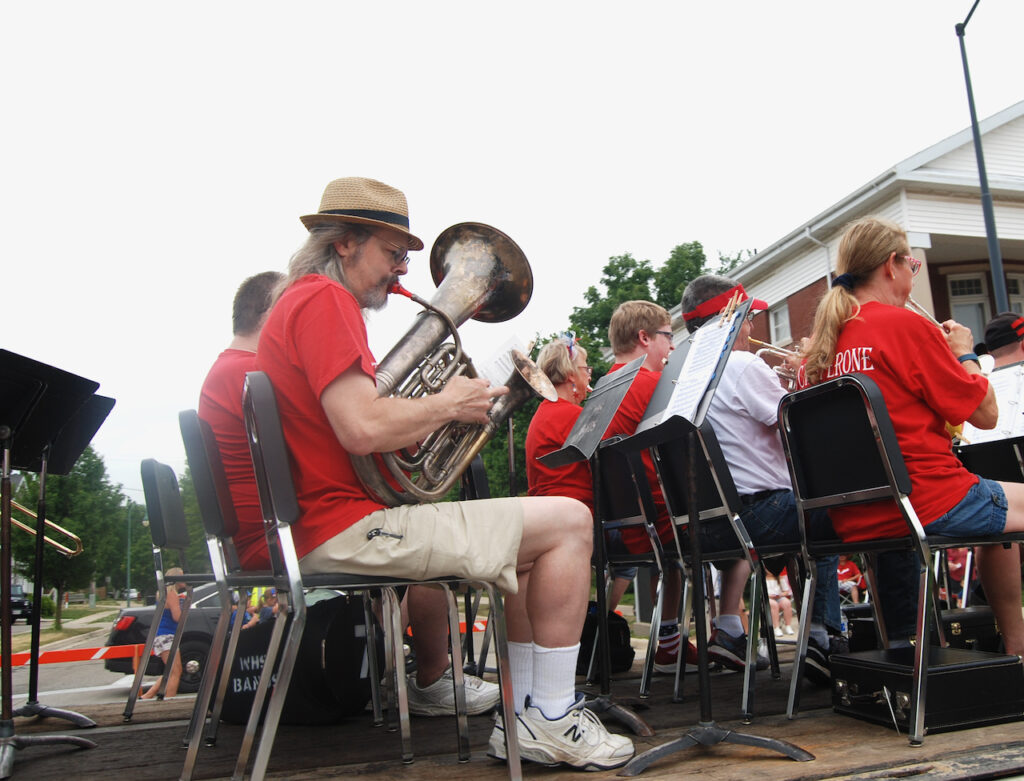
Members of the Whitewater High School Alumni Band entertain the crowd as they ride down Main Street.
Members of the Whitewater High School Alumni Band perform.

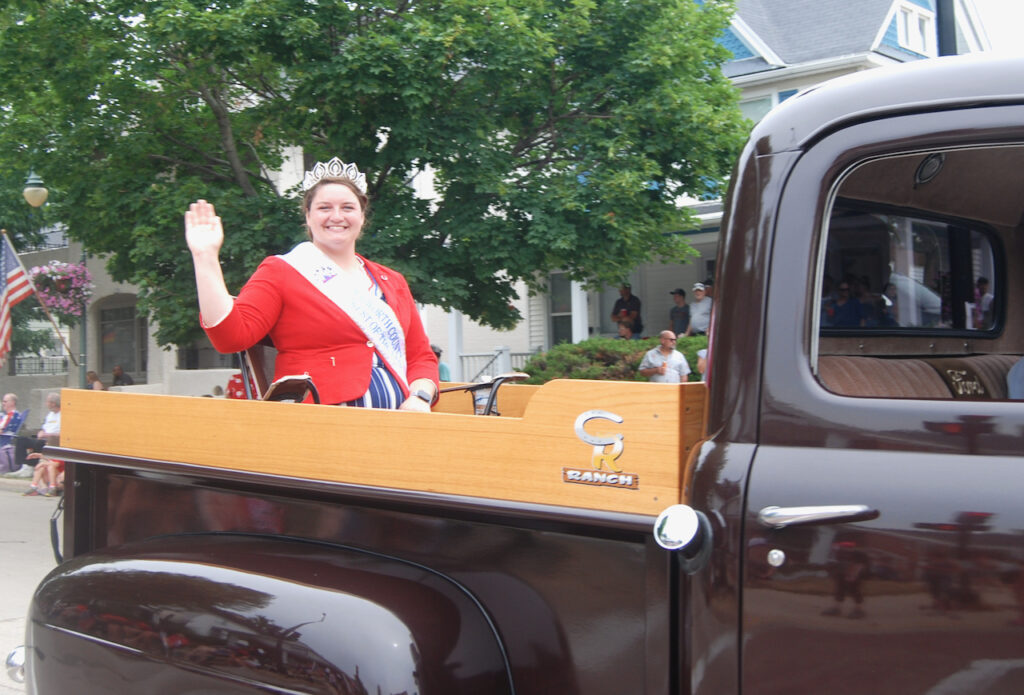
The University of Wisconsin-Whitewater Warhawks football team bus cruises down Main Street. According to information displayed on the side of the bus, the team has won 20 national championships between 1984 and 2018.
The Walworth County “Fairest of the Fair” Jessica Markham waves at parade-goers.


One of several early-model tractors moves along Main Street.
“Teen Miss Whitewater,” Lydia Bols, waves at the crowd.
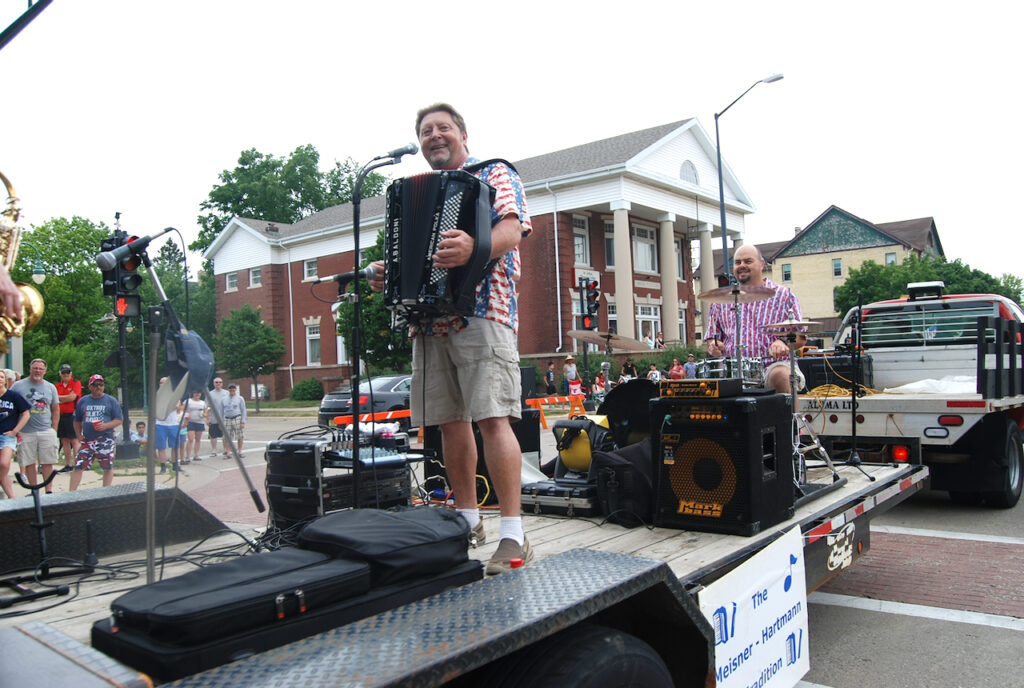
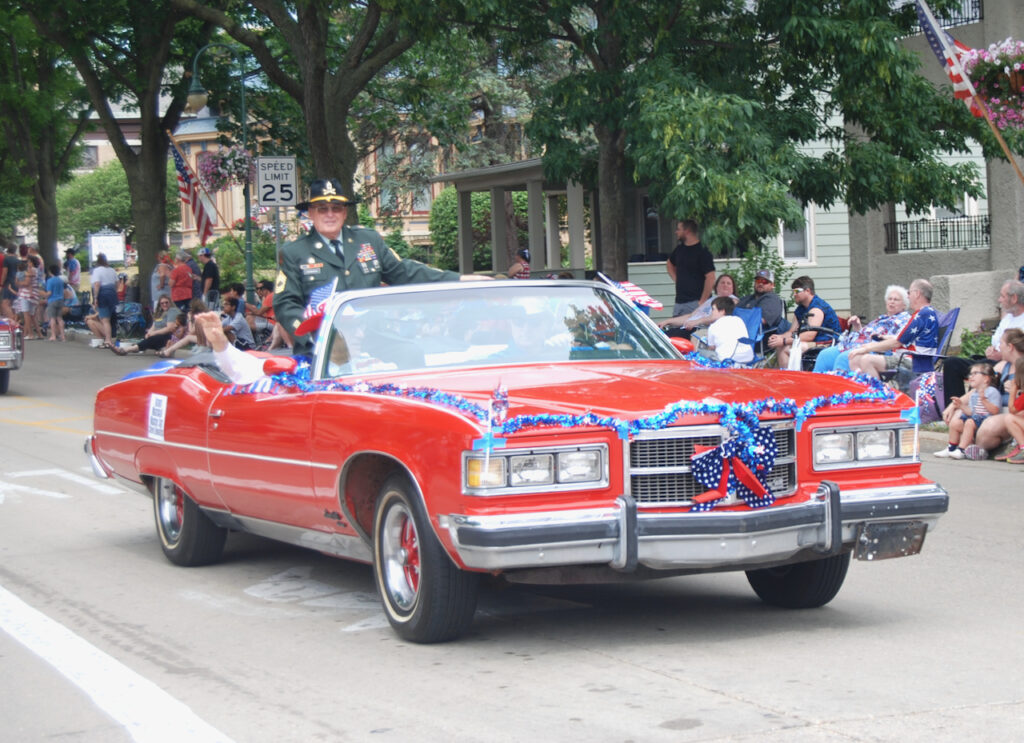
Steve Meisner, riding a float called “The Meisner-Hartmann Tradition,” performs for the crowd.
Parade Grand Marshal Master Sgt. Steve Edwards rides along Main Street.
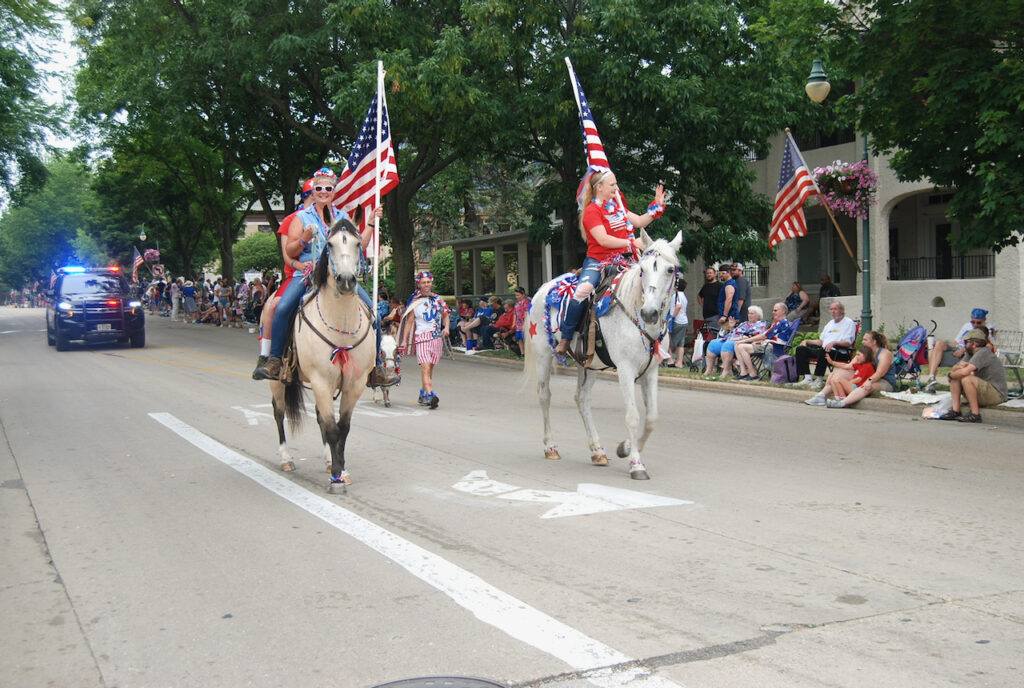

One of several equestrian groups makes its way down Main Street.
Adorned in festive decorations, a horse and riders greet the crowd.


A friendly character greets parade-goers from the Whitewater Lions Club car.
Participants aboard a float titled: “Hooray for the Red, White and Blue,” wave at the crowd.


Parade participants show their enthusiasm as they accompany a float entered into the parade by local business ReVamp Nutrition. The presentation took first place in the business and commercial float category of the parade entrants competition.
Members of the Whitewater High School Band entertain the crowd.


Members of the Whitewater High School Band march along Main Street. The group was one of five marching bands participating in the parade this year.
A Whitewater Fire Department utility vehicle moves along Main Street.
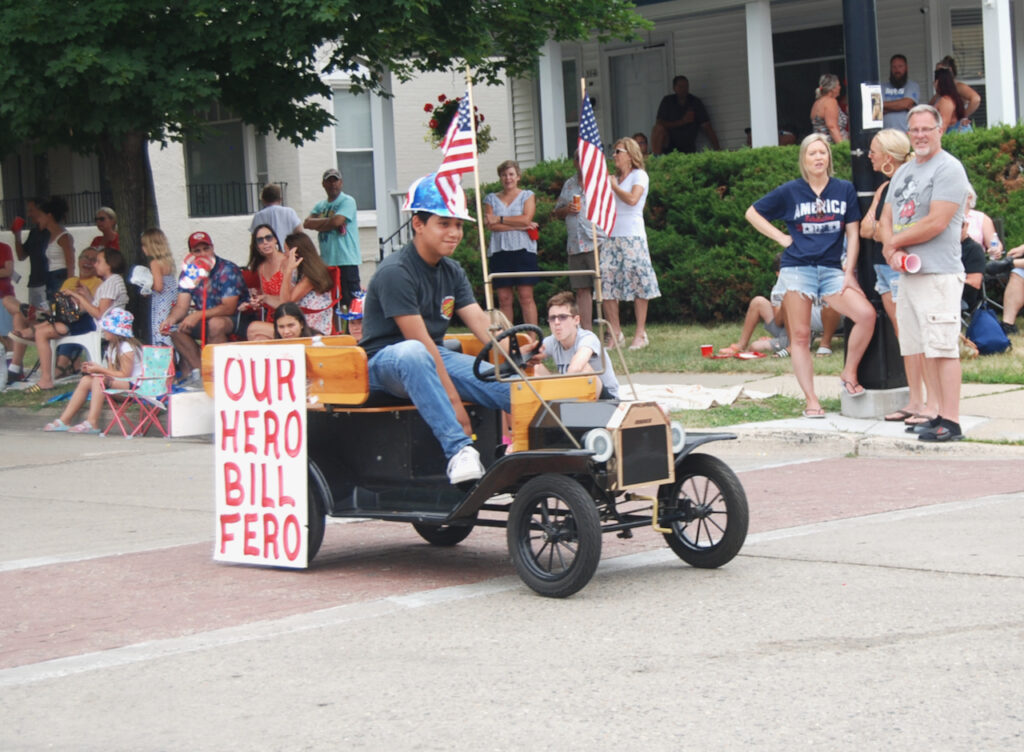
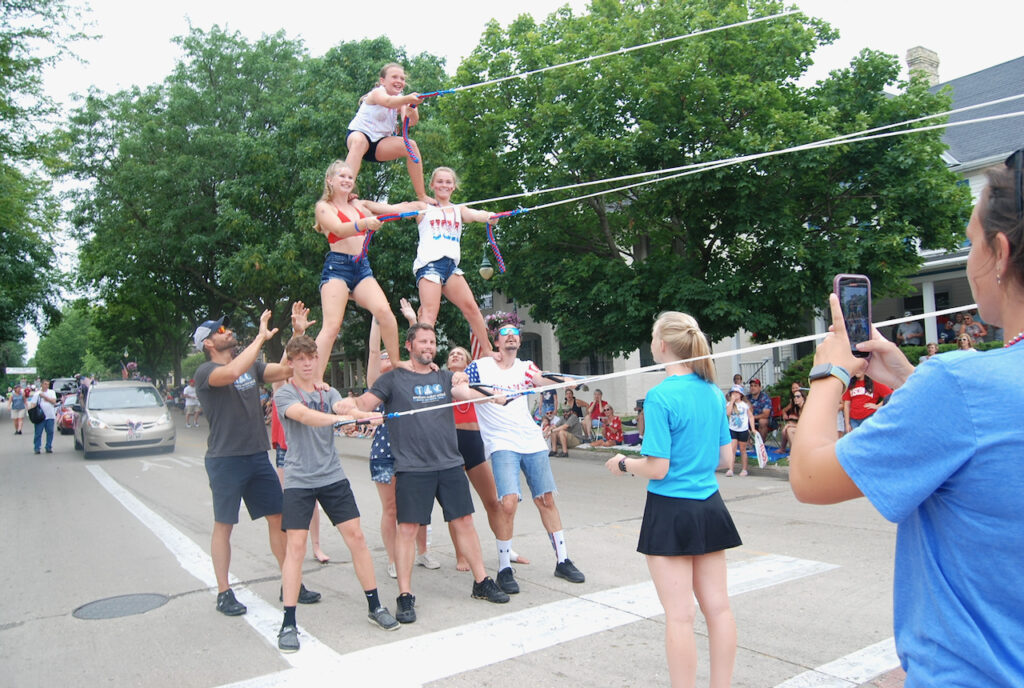
One of several vehicles provided by Home Lumber in Whitewater moves along the parade route.
Members of the Southern Wakes United Water Ski Show Team stop near the intersection of Main and Fremont streets where they build a human pyramid. The group was awarded first place in the youth category of the parade entrants competition for its float and presentation.


The Zor Shriners mini cars team enters the intersection of Main and Fremont streets.
A Zor Shriners mini car whirls around the intersection of Main and Fremont Streets. The cluster of cars zipped around the intersection in circular formations, dazzling the crowd.
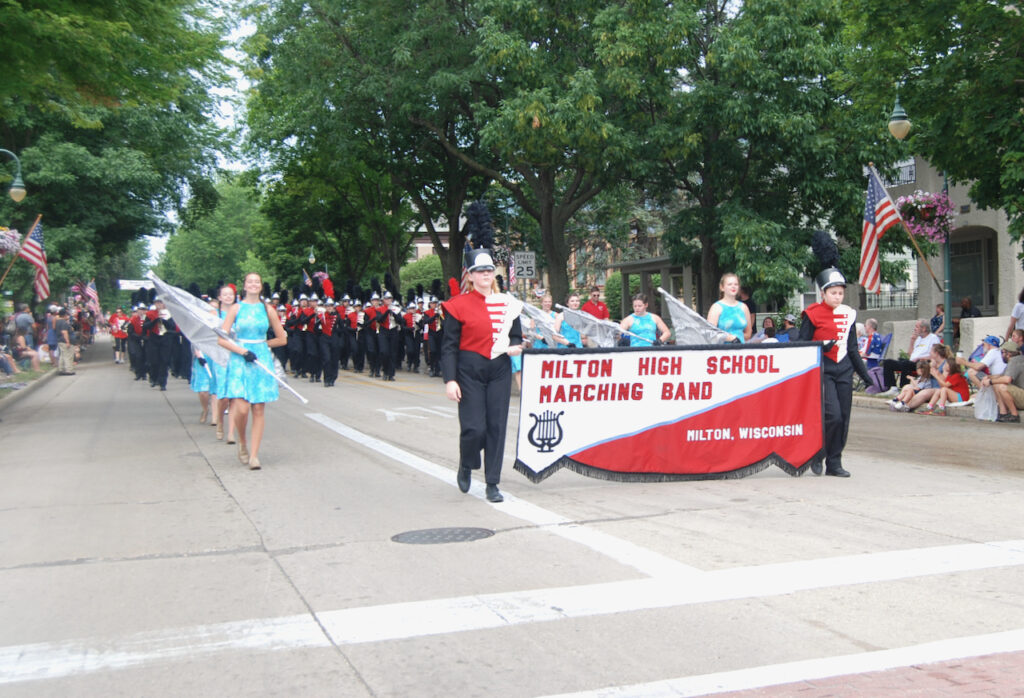
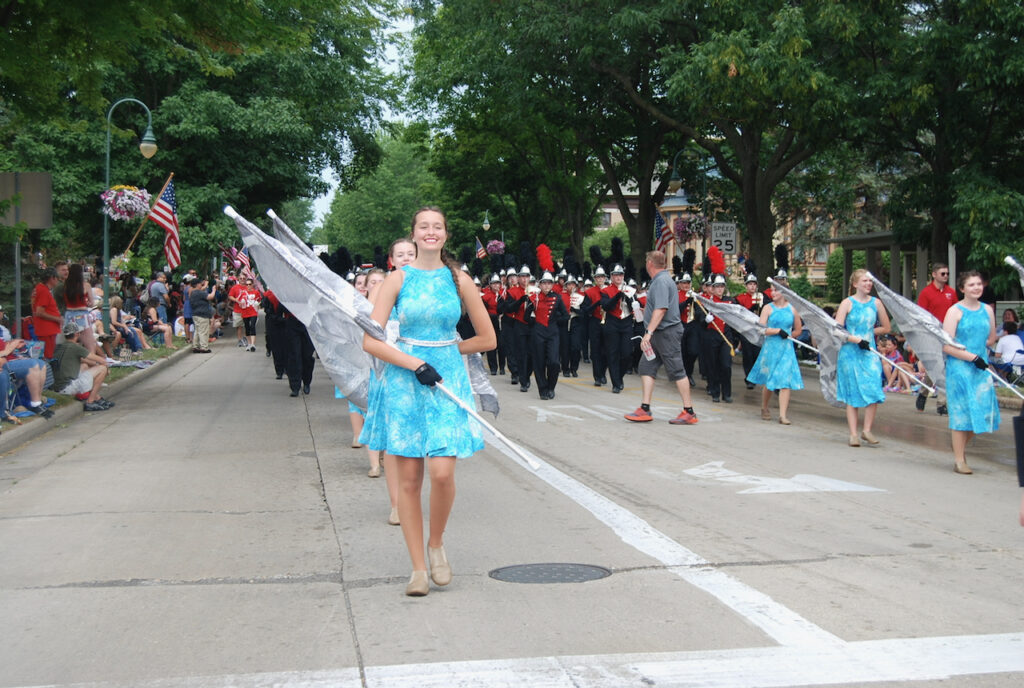
The Milton High School Marching Band makes its way down Main Street.
The Milton High School band marches in formation.
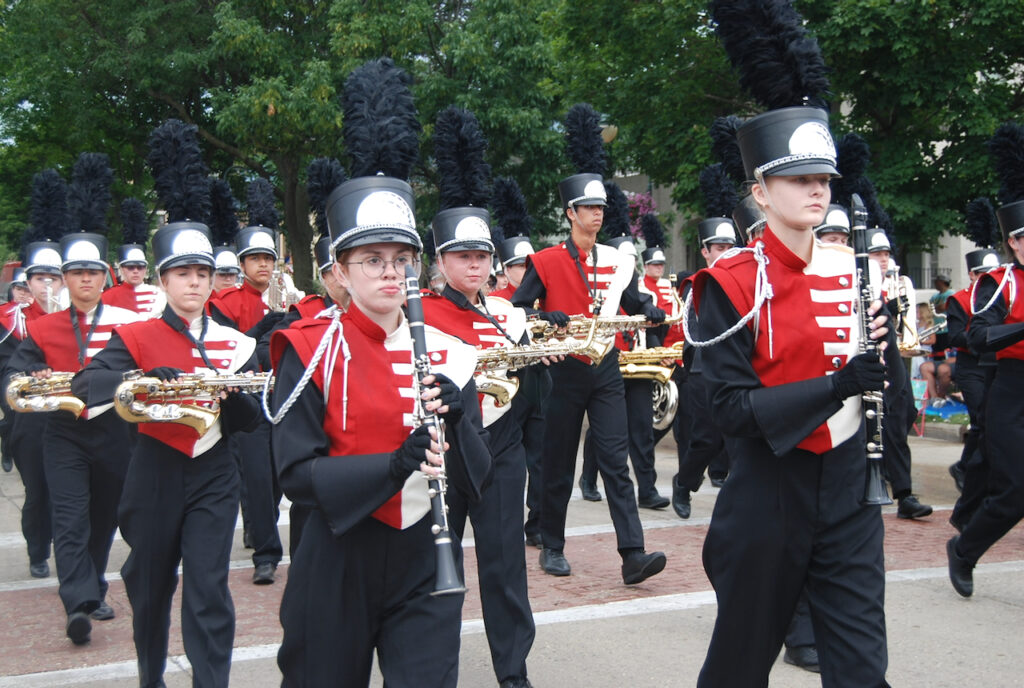
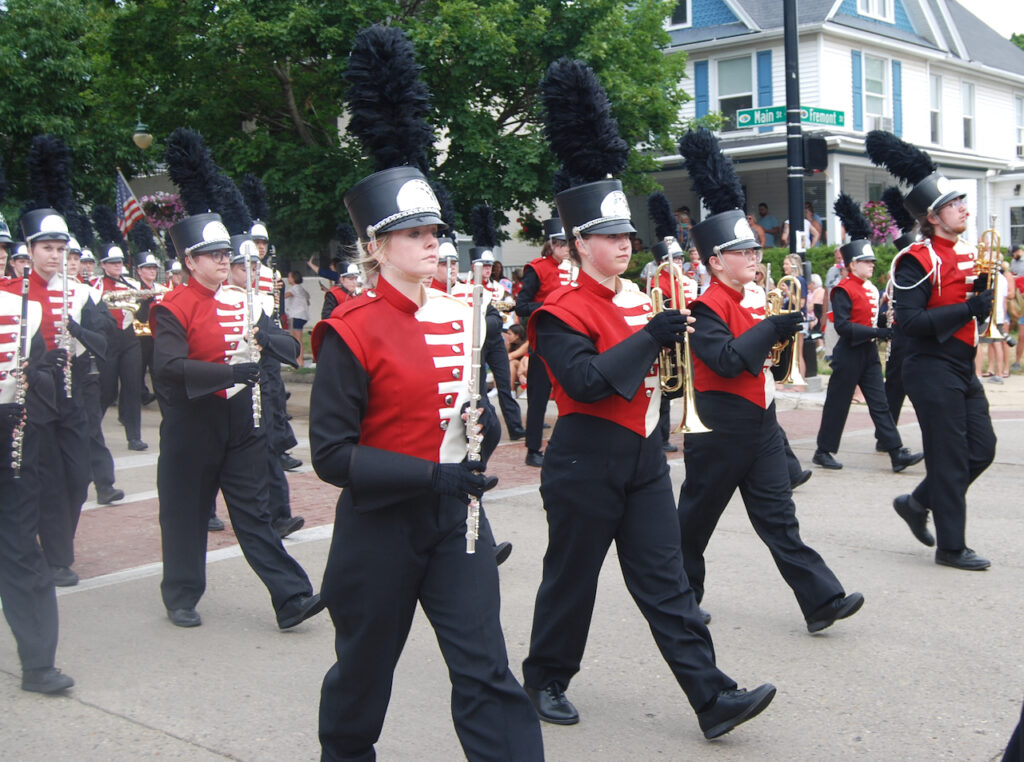
Nearing the end of the parade route, the Milton High School Marching Band holds its instruments in resting position.
The band moves through the intersection of Main and Fremont.
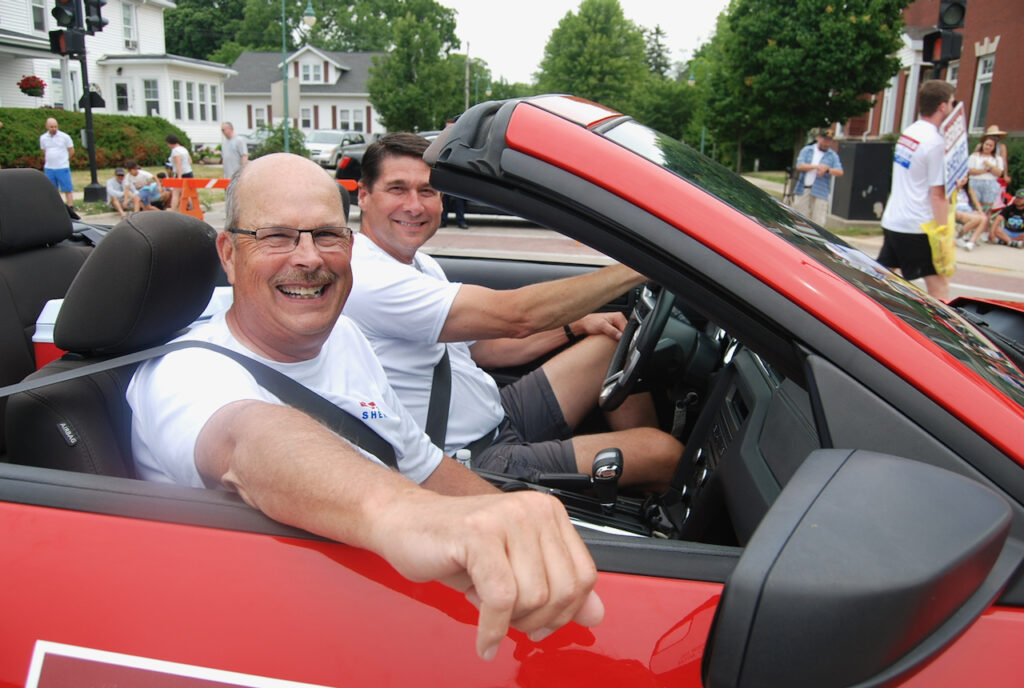

Retired Walworth County Sheriff David Graves, at left, and Walworth County Sheriff Kurt Picknell participate in the parade. Graves served as sheriff from 2001 to 2015. His successor, Picknell, has announced he has plans to retire by the end of this year.
Adorned in festive and matching attire, a man and his donkey work their way down Main Street.

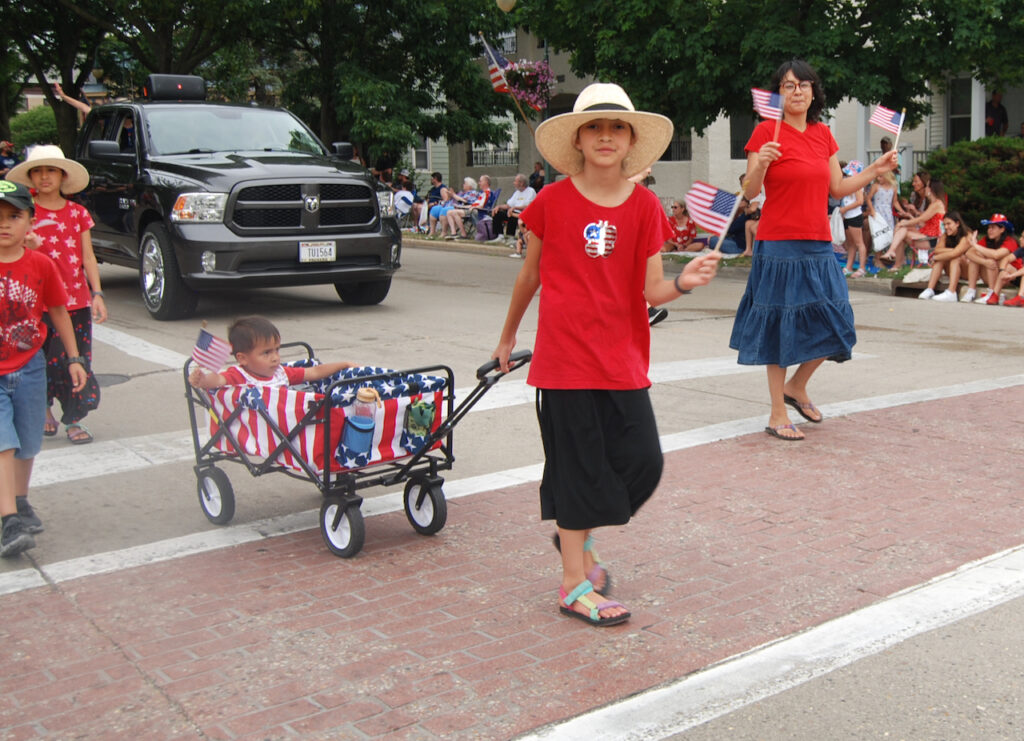
A group of parade participants show their enthusiasm.
Parade participants work their way along Main Street.


A young performer dances for the crowd.
A member of the Whitewater Area Mounted Search Team and Rescue rides along Main Street.
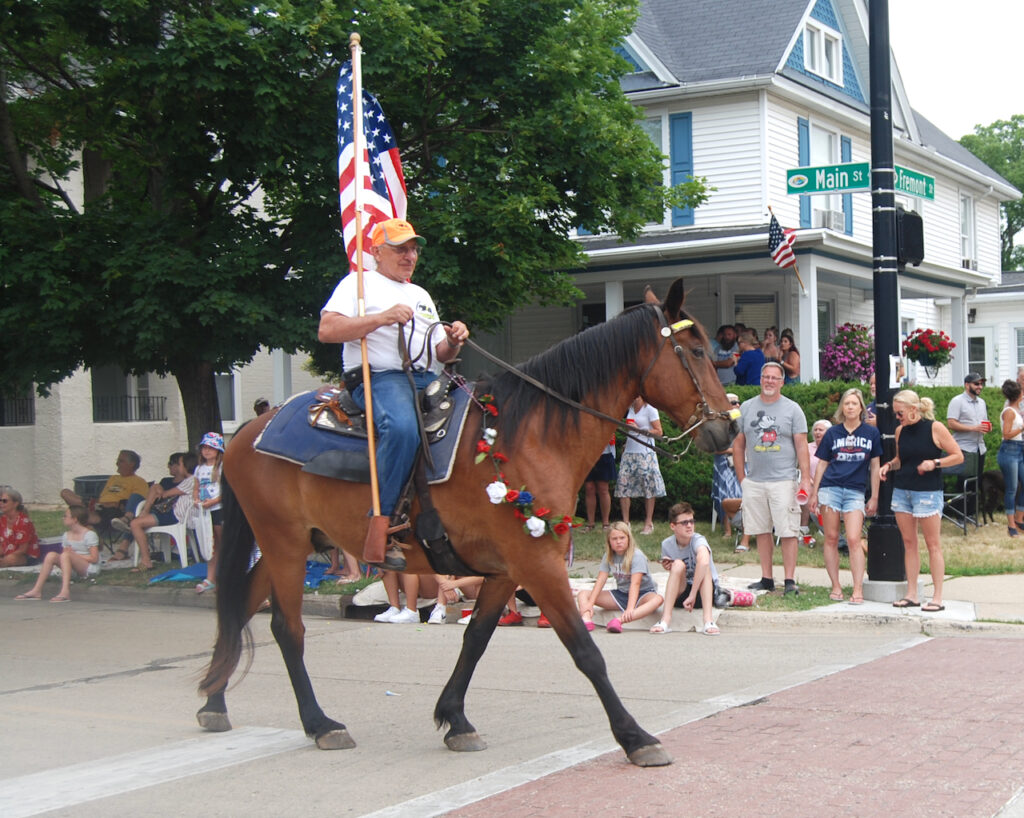
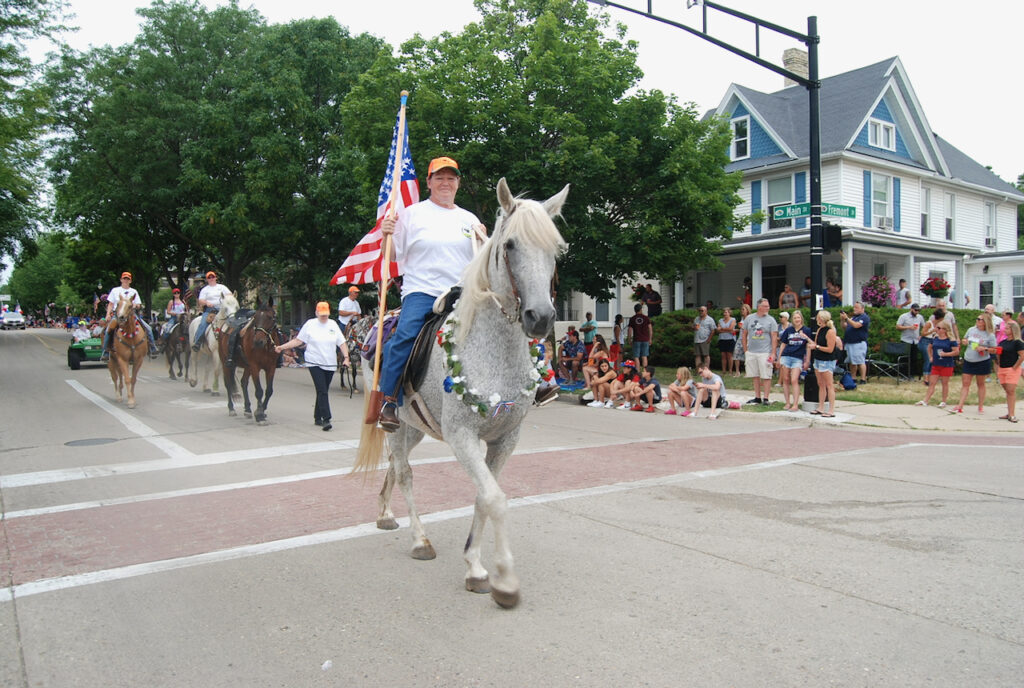
The group, also known as WAMSTAR, won first place in the “horse and pony” category of the parade entrant competition.
A WAMSTAR horse and rider move through the intersection of Main and Fremont streets.

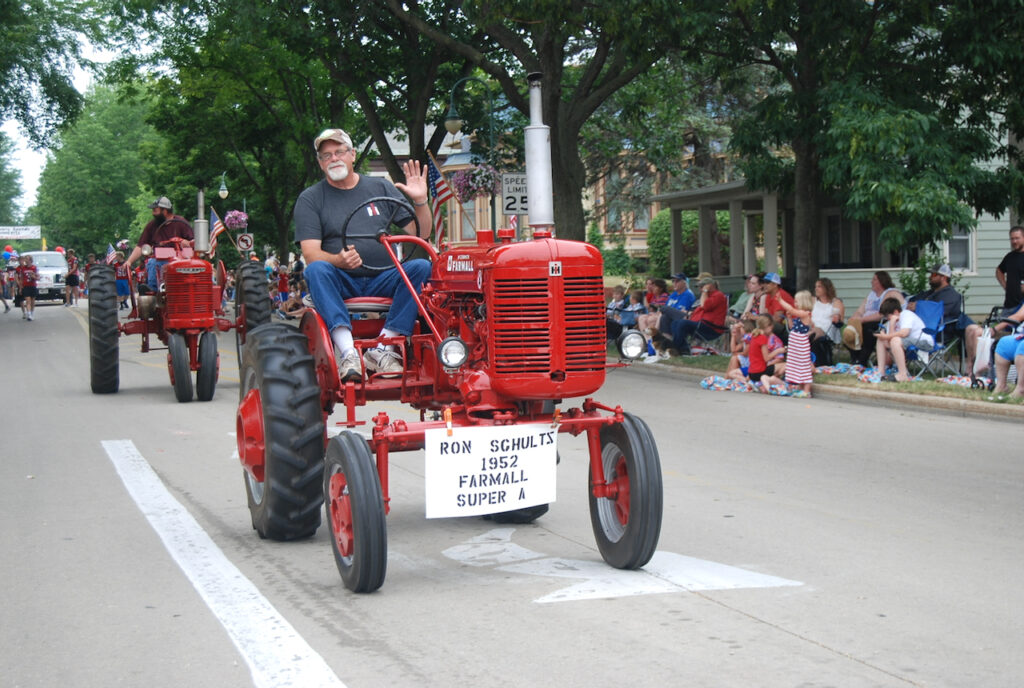
A vehicle from which the Whitewater High School Alumni Band is playing and a vehicle carrying water supplied by Home Lumber travel neck-and-neck along Main Street.
A 1952-vintage tractor travels along Main Street.


Accompanying a float, a parade participant hands out candy.
A young parade participant, riding on a float provided by Bethel House in Whitewater, receives some help as he holds and waves his flag. The float earned first place in the neighborhood and adult category of the parade entrants competition.
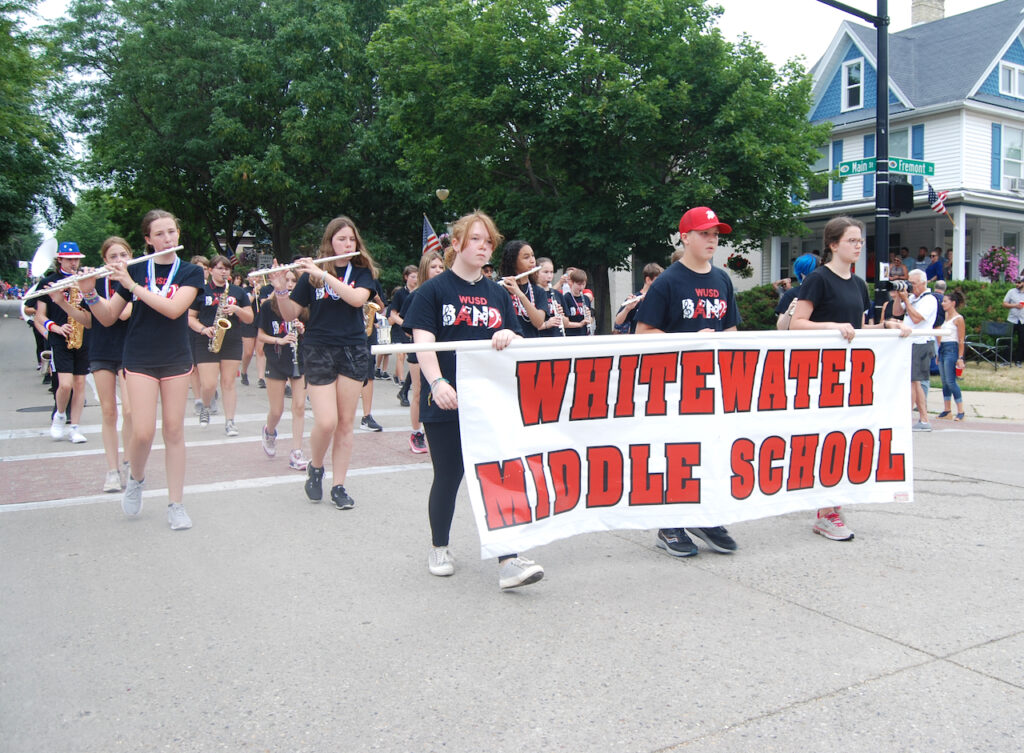
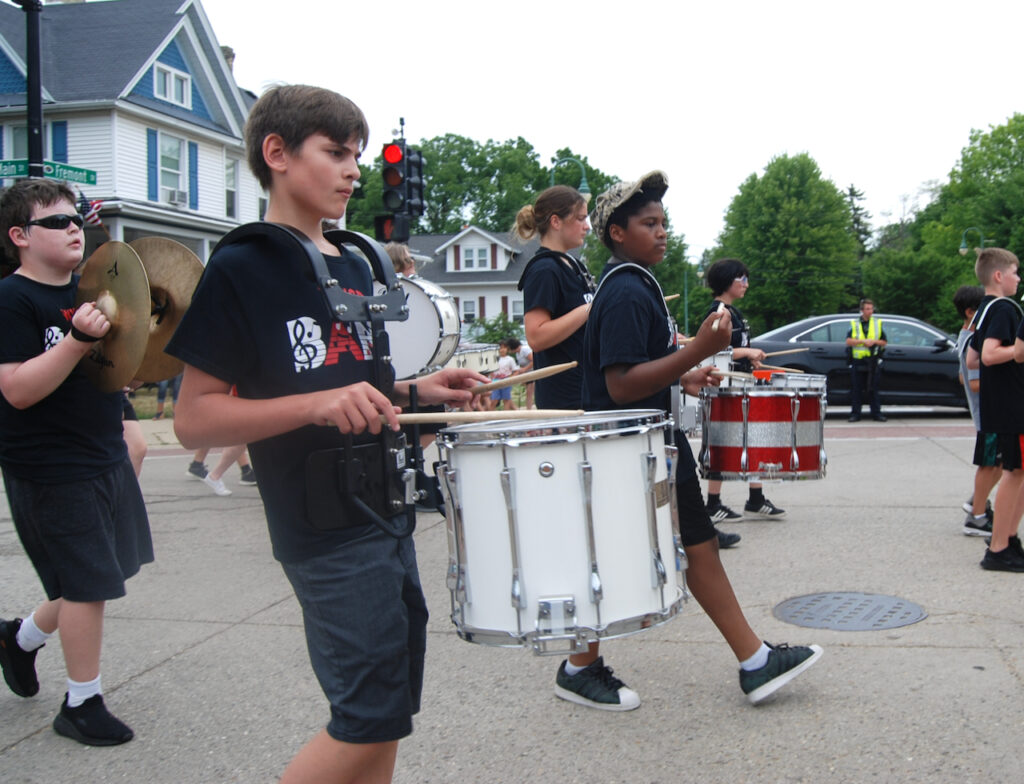
Members of the Whitewater Middle School Band entertain the crowd.
The drum section of the Whitewater Middle School band moves through the intersection of Main and Fremont.
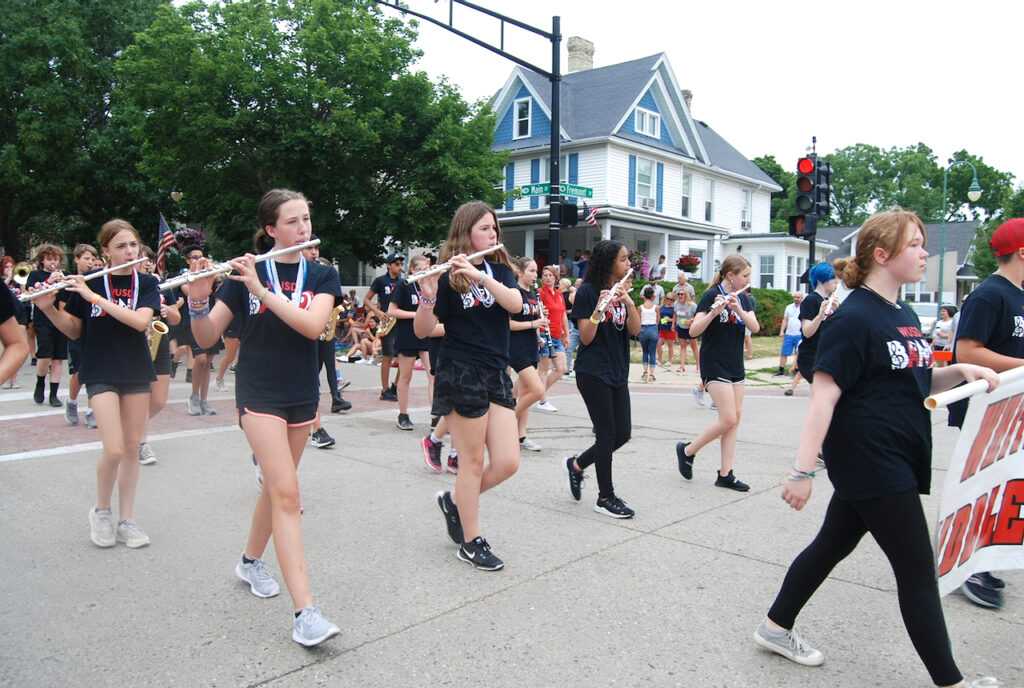
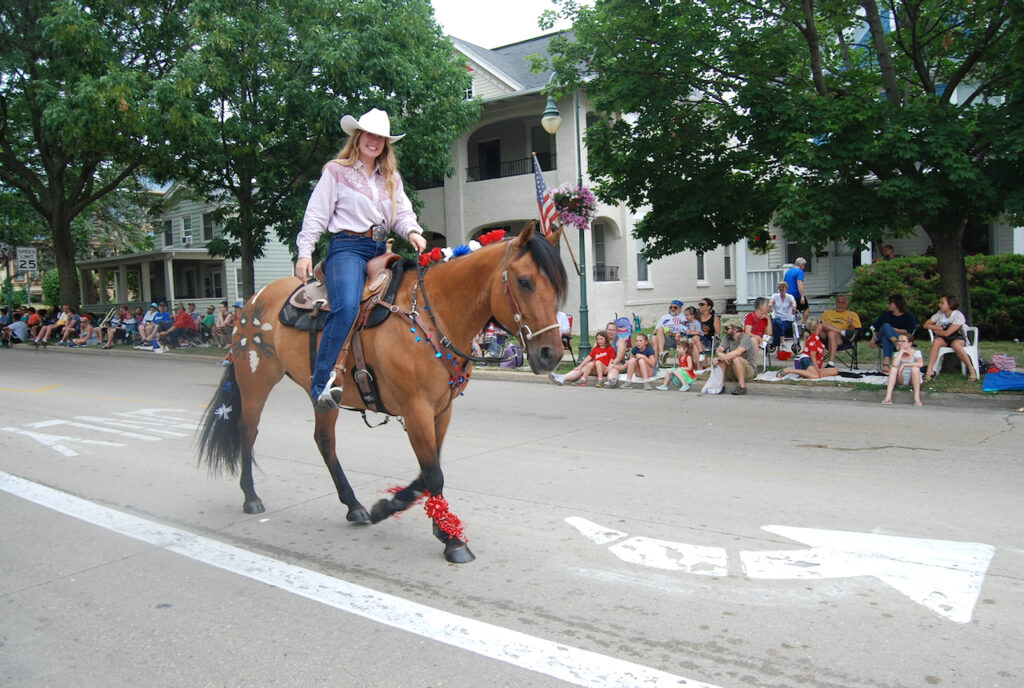
The Whitewater Middle School band continues down Main Street.
A horse and rider move down Main Street.
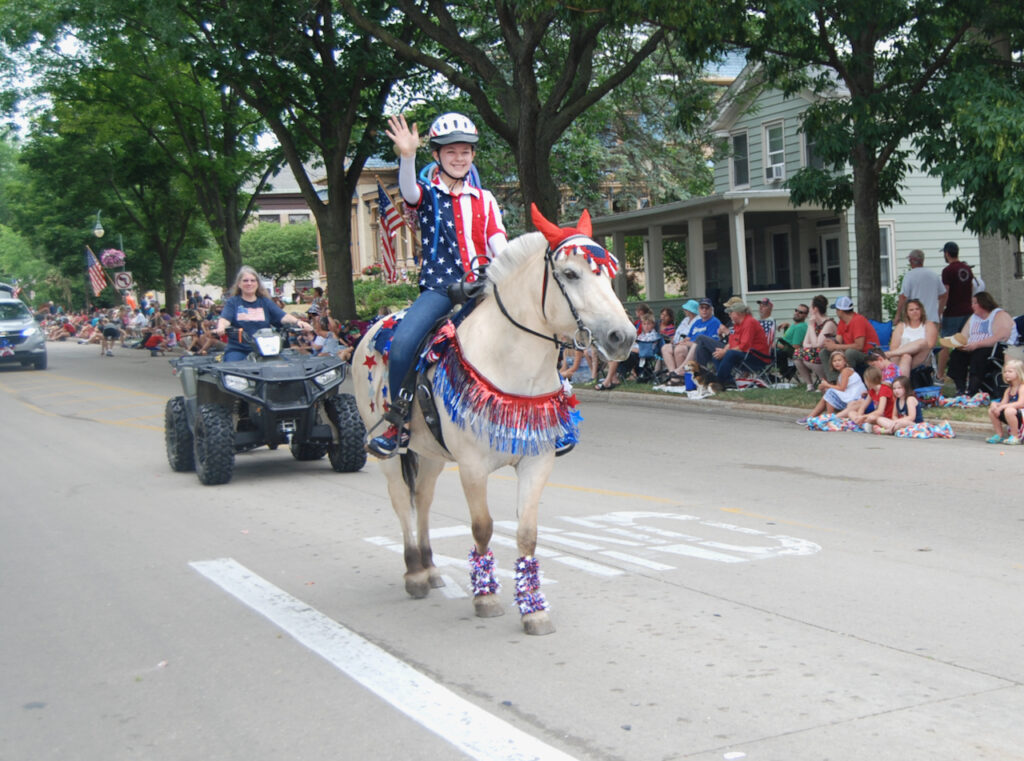

Trinity Smith waves from atop her white dun Fjord horse named “Kona.”
Another Home Lumber vehicle works its way down Main Street.

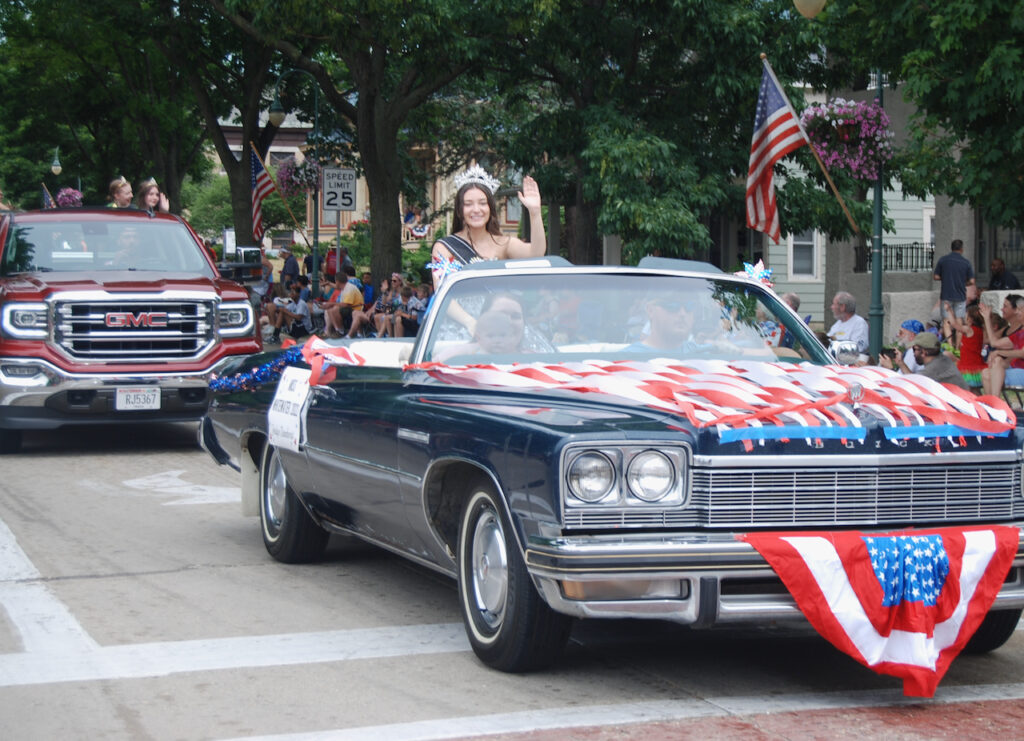
Cub Scout Pack and Scout Troop 173 celebrate Fourth of July.
“Miss Whitewater,” Jordyn Damhorst, rides in the parade.


“Whitewater Junior Miss” Jaylynn Traxler, from left, and “Little Miss” Haley Gutierrez wave to parade-goers.
The Victor Gonzalez mariachi band plays while riding down Main Street.

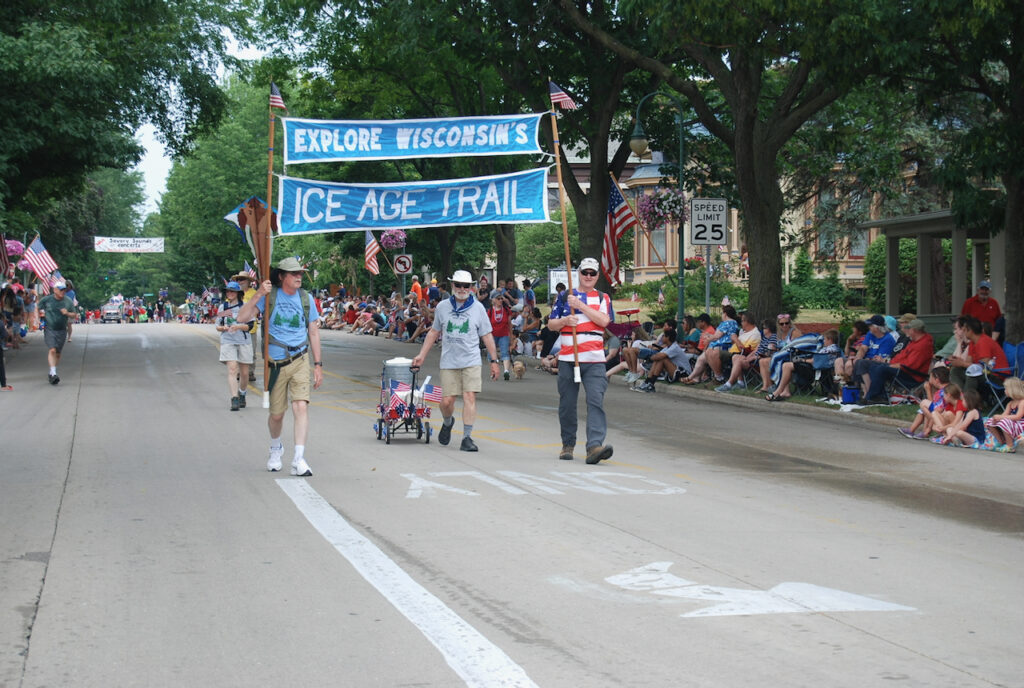
Lima 4-H Queen Katy Farrey greets parade-goers.
A group presenting the Ice Age Trail moves along Main Street. The Ice Age Trail Alliance won second place in the costumed marchers category in the parade entrants competition.


Members of the Whitewater Whippets High School football team greet the crowd. While walking, team members tossed footballs. The team won third place in the youth category of the parade entrants competition.
Members of the Whitewater Grocery Cooperative parade along Main Street. The group, which formed in 2017, is working to bring a community-owned grocery store to Whitewater.


Race cars owned by Kubicz Weber Racing are showcased from a trailer. The vehicles race at Jefferson Speedway and MRM Raceway, a parade banner read.
Gemütlichkeit Days marchers accompany a float. The marchers won first place in the costumed marchers category of the parade entrants competition.

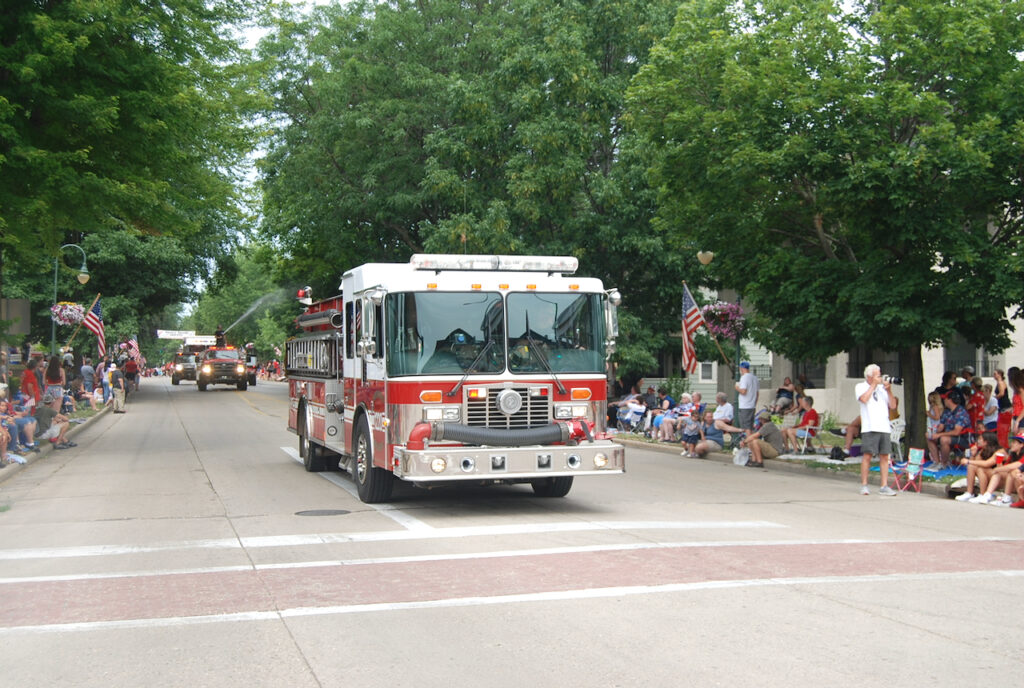
The Gemütlichkeit Days float travels down Main Street.
A fire engine from the Whitewater Fire Department travels in the parade.


Whitewater High School students and Ferradermis robotics club members ride in the parade. The float, complete with a working robot, won second place in the youth category in the parade entrants competition.
A festive vehicle moves along Main Street.


A fleet of festooned Jeeps travel in the parade.
A 1953 Chevy pickup 3100 five-window, owned by Rod Lorenz, Whitewater, makes its way down Main Street. The vehicle’s unique shimmering paint is called Rose Metallic.
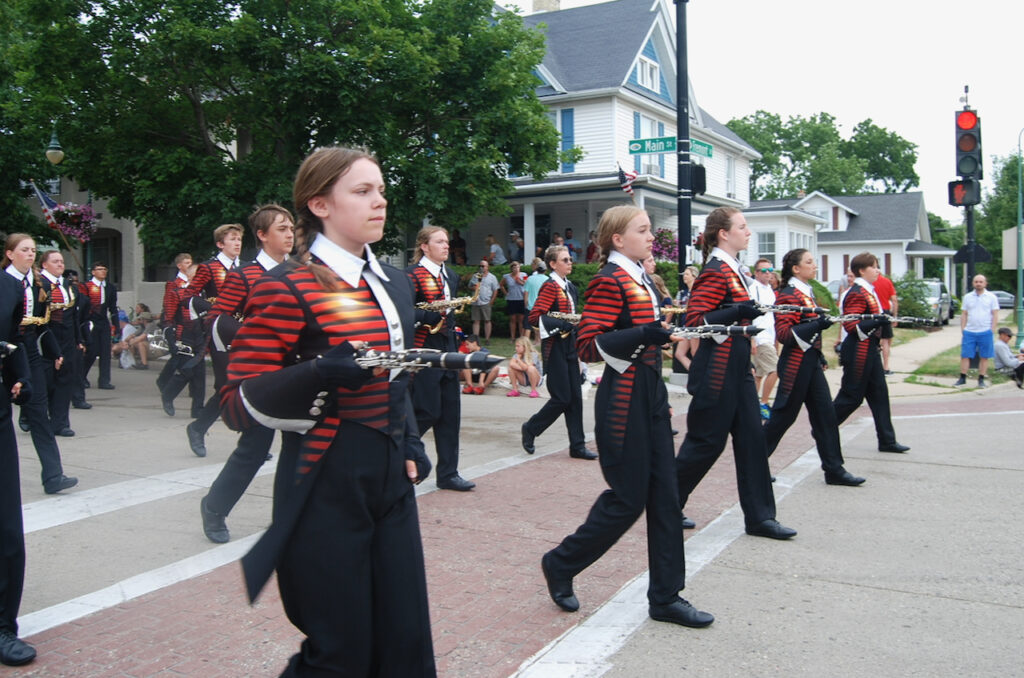

The Sun Prairie High School Marching Band arrives at the intersection of Main and Fremont.
In resting position, the band nears the end of the parade route.


A parade participant waves at the crowd.
Young Tony Evers supporters mug for the camera.


A Walworth County GOP Republican Party float moves down Main Street.
Marchers flank a “UWW College Democrats” banner.

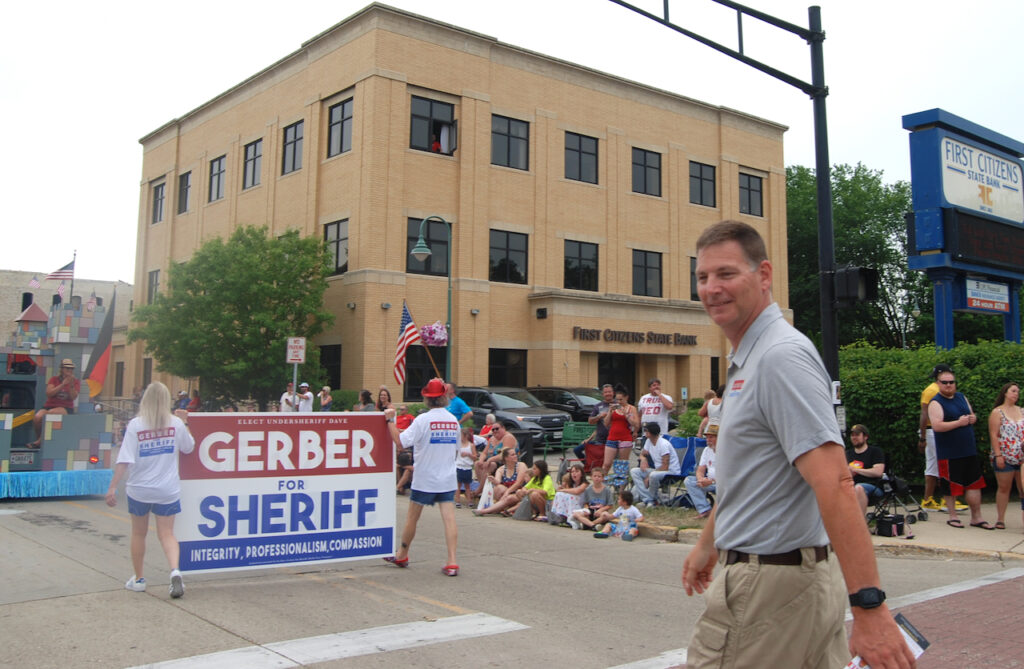
A Jeep is decked out in support of Walworth County Sheriff candidate Dave Gerber. Gerber serves as Walworth County Undersheriff.
Walworth County Undersheriff Dave Gerber marches along Main Street.

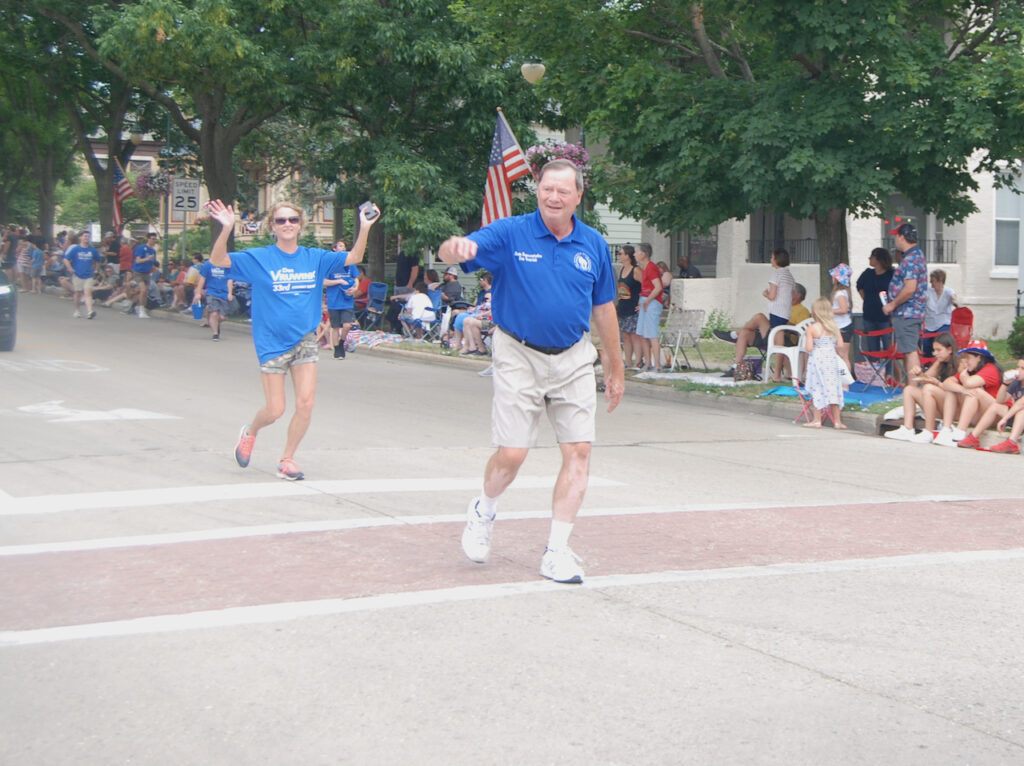
A supporter carries a sign for Craig Konopski who is running for Walworth County Sheriff.
State Rep. Don Vruwink waves to the crowd as he enters the intersection of Main and Fremont. Vruwink is running for a seat in Assembly District 33.


Supporters of Ellen Schutt ride a float down Main Street. Schutt is running for an open seat in Assembly District 31.
Jason Dean waves to the crowd as he approaches the intersection of Main and Fremont streets. Dean is running for an open seat in Assembly District 31.


A canine parade participant smiles at the crowd.
Maryann Zimmerman waves as she walks along Main Street. Zimmerman is running for an open seat in Assembly District 31.


A character in support of Maryann Zimmerman greets parade-goers.
A car travels along Main Street with signage in support of Ann Roe, who is running for a U.S. House of Representatives seat in Congressional District 1.


Ann Roe, at right, walks with supporters along Main Street.
A young parade-goer takes in the festivities.


Cheri Cook, Whitewater, waits Monday morning for the parade to begin.
Eagerly anticipating the parade Monday morning are Everleigh, 2, from left, her mom, Kaitlyn, and brothers, Milo, 4, and Asher, 8. The family is from Jefferson.
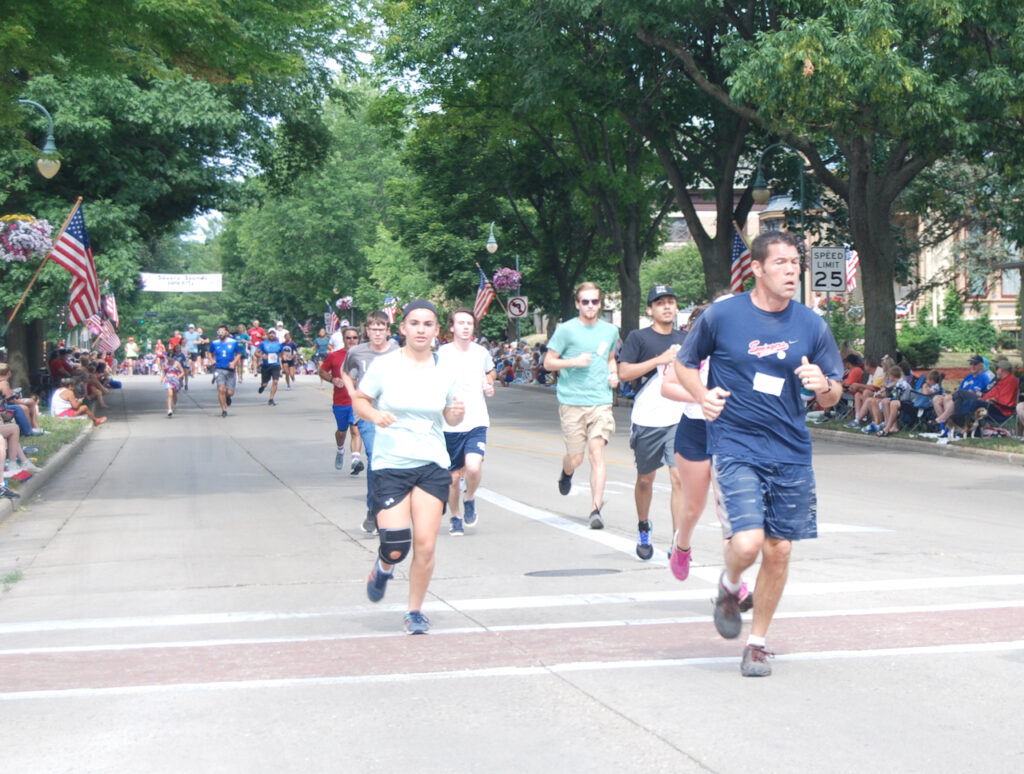
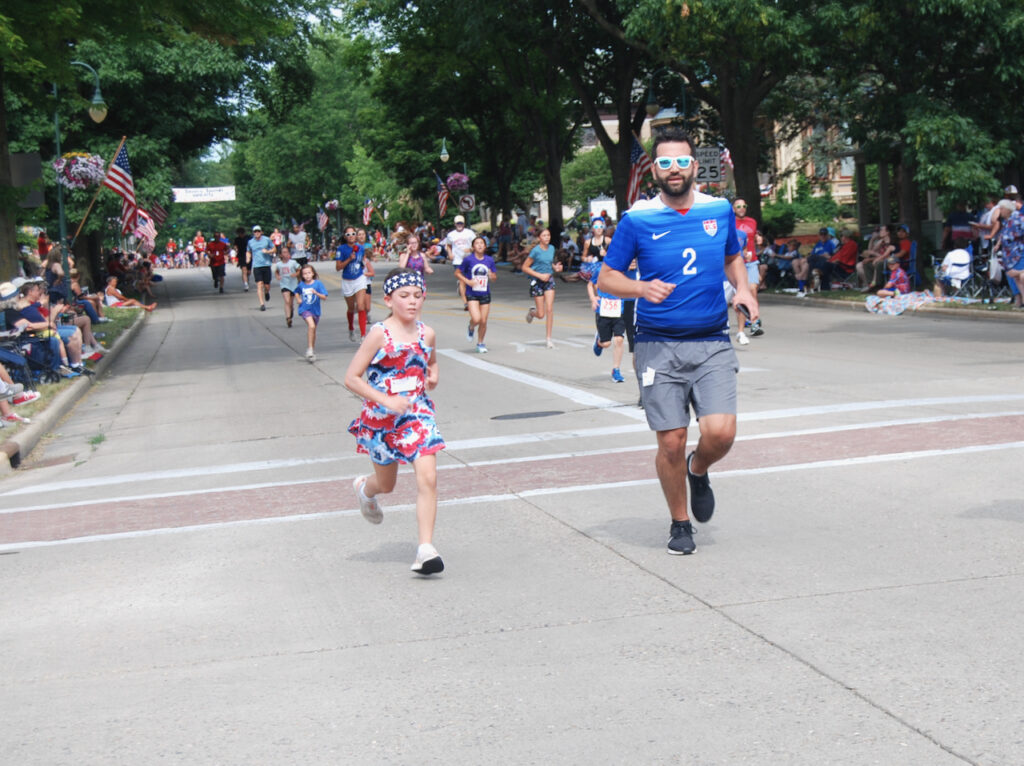
Runners in the Whippet City Mile traverse the parade route in advance of the parade.
Runners of all ages tackle the Whippet City Mile.
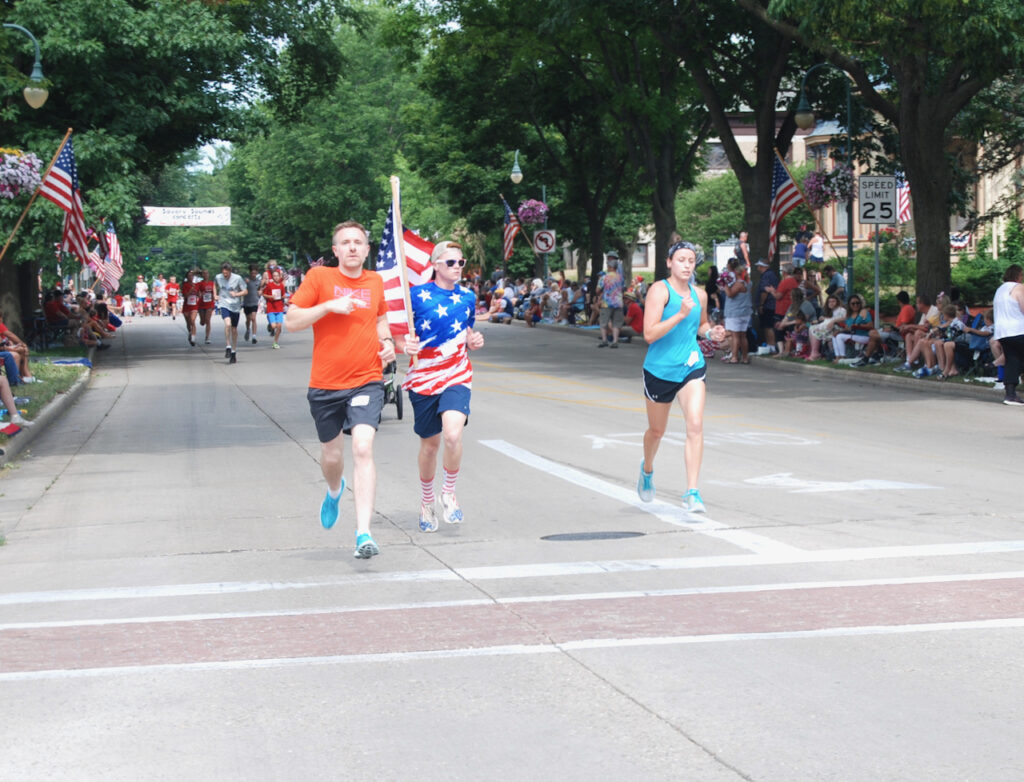

Runners near the end of the parade route as they enter the intersection of Main and Fremont streets.
Runners focus as they complete the course.
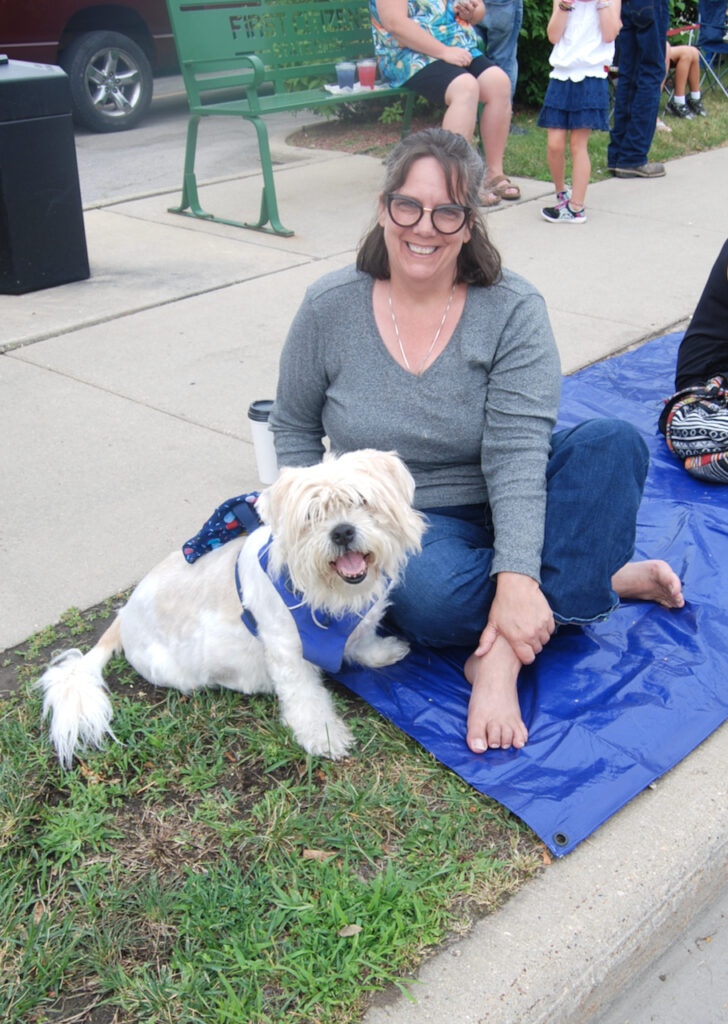

Kelly Schubert, Madison, and her companion “Chewbacca” wait for the parade.
The Smith family, Janesville, wait for the parade. They are Melissa, from left, back row, and Brad, along with Hailey, 17, from left, Kaysten, 3, and Natalie, 11.


Ready for the parade to begin are Roger Johnson, back row, from left, and his wife, Sara. Seated in front are Nevaeh McWilliam, 14; Harper Johnson, 4; Shelby Johnson, 10, and Domenic Kmen, 12. The Family is from Fort Atkinson.
Waiting along Main Street are members of the Hagen family. They are Amy and Nick, standing, and Eileen, seated, from left, Emeline, 8, and Andy. The family is from Whitewater.

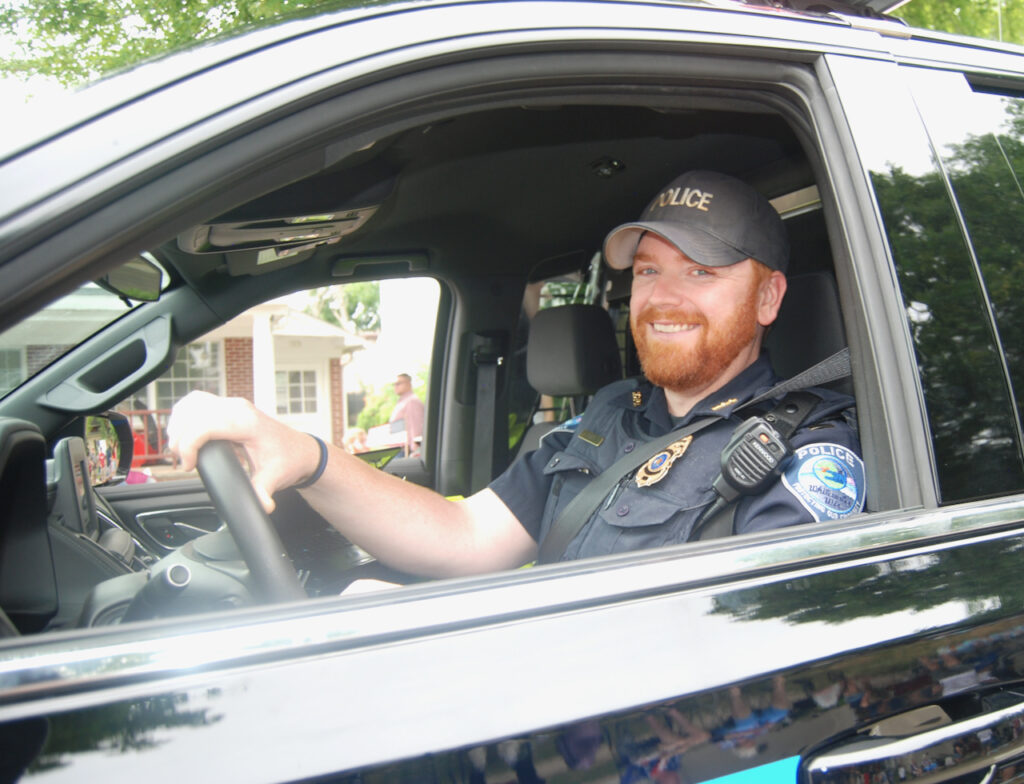
Emily Painter, from left, and Jennifer Ford, both of Richmond, occupy their pups, “Luna” and “Tito,” as they wait for the parade.
Whitewater Police Lt. Ryan Taft drives the final vehicle in the parade.
Whitewater on parade
(Originally published July 5, 2022.)
Correction: Fort Atkinson Online photographer Kim McDarison regretfully missed an opportunity to photograph Assembly District 31 candidate Brienne Brown as she marched in Whitewater’s Fourth of July parade. Brown, and three other candidates running for the Assembly seat, marched in the parade. Her name and a contributed photo has been added to this story.
By Kim McDarison
Whitewater held its annual four-day weekend Fourth of July celebratory event, which, on Monday, included a Fourth of July parade.
According to parade organizers, the city anticipated some 5,000 visitors from around the area arriving to watch the parade.
Among guests marching in the parade this year was Wisconsin Gov. Tony Evers who is running for reelection this fall.
He was joined by more than 50 parade entrants, organizers said.
This year’s parade grand marshal was Master Sgt. Steve Edwards.
According to information supplied by Whitewater Lions Club member and Communications-Fourth of July Chairman Don McComb, this year’s parade included five marching bands, along with returning parade favorites such as the Gemuetlechkeit Days float, multifaceted entertainer and accordion player Steve Meisner, Victor Gonzalez mariachi band, horses, firetrucks, classic cars, vintage tractors, and youth groups of all variety.
The parade included a float offered by Ferradermis, the Whitewater High School robotics club, which featured a working robot that entertained the crowd.
Zor Shriners mini cars were a crowd pleaser and also received “Best of Parade” in a competition for entrants.
Several area businesses joined in the fun, producing colorfully decorated floats, costuming and other presentations.
Crowned pageant winners graced this year’s parade, including several winners of the 2022 Miss Whitewater pageant which was held Friday. Riding together in the parade were Whitewater’s Junior Miss Jaylynn Traxler and Little Miss Haley Gutierrez. Waving to the crowd was Miss Teen Whitewater Lydia Bols and Miss Whitewater Jordyn Damhorst. Also on hand were Walworth County’s The Fairest of the Fair Jessica Markham and Lima 4-H Queen Katy Farrey.
With statewide elections coming this fall, and partisan primary elections slated in August, several candidates running for office walked the parade route and waved to the crowd.
Among them were two candidates for Walworth County Sheriff, including Undersheriff Dave Gerber and Craig Konopski.
Sheriff Kurt Picknell, who also was a parade participant, announced earlier this year that he would be seeking retirement by the end of the year.
Several candidates running for legislative seats were also in the parade, including Republican candidates Jason Dean, Ellen Schutt and Maryann Zimmerman, and Democratic candidate Brienne Brown, all of whom are running for the open seat in Assembly District 31.
Running for a seat in Wisconsin Assembly District 33, Democratic candidate Don Vruwink walked the route and waved to constituents.
Additionally, Ann Roe, a Democrat from Janesville who is running for a seat in the U.S. House of Representatives in Congressional District 1, participated in the parade.
Parade competition winners
According to information supplied by McComb, winners of this year’s parade competition are as follows:
Best of Parade: Zor Shriners mini cars.
Youth: first place, Southern Wakes; second place, Ferradermis Whitewater High School Robotics; third place, Whitewater High School football.
Business and commercial floats: first place, ReVamp Nutrition, second place, Productive Living Systems; third place, Willowbrook Golf Course.
Neighborhood and Adult: first place, Bethel House; second place, Whitewater Parks and Recreation; third place, University of Wisconsin-Whitewater Athletics.
Costumed marchers: first place, Gemütlichkeit Days; second place, Ice Age Trail Alliance; third place, Santa – Gary Hetzel.
Horse and Pony: first place, Whitewater Area Mounted Search Team and Rescue (WAMSTAR); second place, Trinity Smith-Hicks; third place, Tomomitsu family.
An album of nearly 100 photos is viewable by clicking the image below.
Click the image above to view photos from Whitewater’s Fourth of July parade.
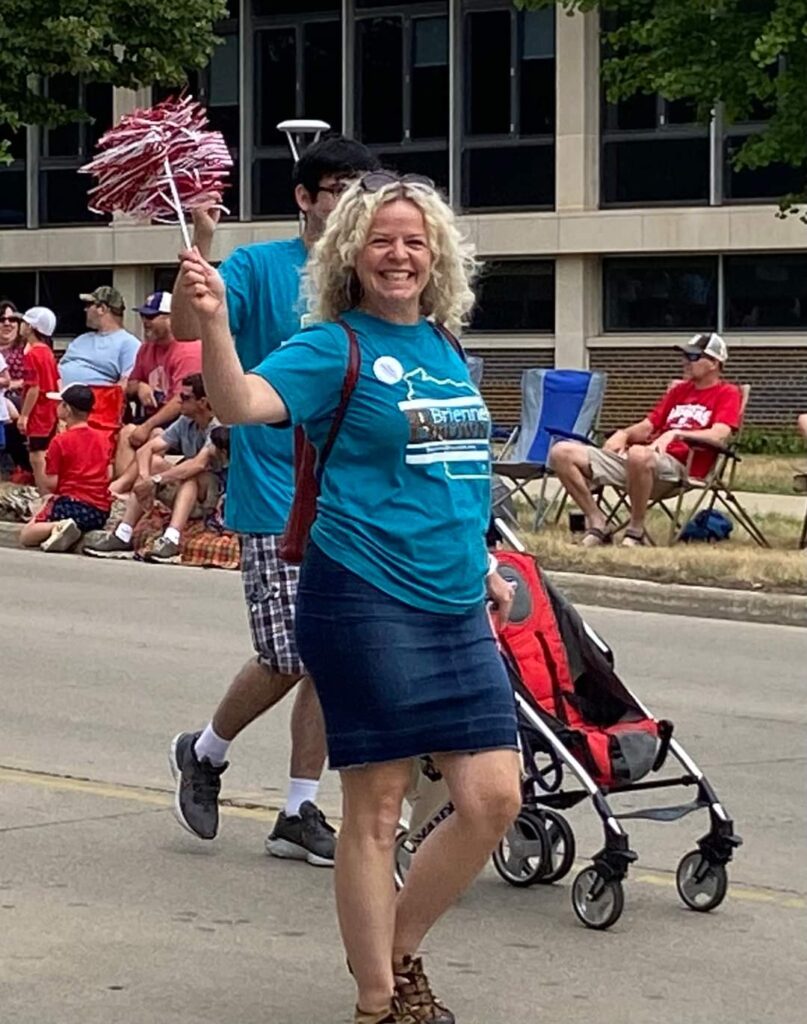
Assembly District 31 candidate Brienne Brown marches Monday in the Whitewater Fourth of July parade. An opportunity to photograph the candidate was regretfully missed by photographer Kim McDarison. Brown, along with Assembly District 31 candidates Jason Dean, Ellen Schutt and Maryann Zimmerman, participated in the parade. Contributed photo.
Whitewater: Council hires GovHR to conduct city manager search
(Originally published July 12, 2022.)
By Kim McDarison
The Whitewater Common Council, during a special meeting held Tuesday, hired GovHR, a professional recruitment firm, to conduct a search for a new city manager.
Services provided by the firm, as outlined in its proposal, will come at a cost of $23,500, excluding consultant travel expenses.
A second firm, Public Administration Associates (PAA), offered services to the city at a cost of $14,800.
Additionally, council approved the scheduling of a closed session meeting to take place July 19, which also is the date of the next regularly scheduled council meeting, during which time options for hiring an interim city manager will be discussed with representatives from GovHR.
During its previously held meetings, council discussed the likelihood that the services of an interim city manager would be needed to help guide city operations while the search for a new city manager was underway.
City Manager Cameron Clapper has previously announced that his last day of employment with the city will be Aug. 12. Clapper is leaving his position to serve as the county administrator in Dodge County.
During Tuesday’s meeting, Clapper said that after receiving instructions from the city council during its last meeting, held June 21, he and members of city staff sought to provide quotes from three recruitment firms to bring before council at the special meeting.
Clapper said that of the three entities approached by the city for information, two, GovHR and PAA, provided quotes, including a written presentation of services and their associated costs.
A third organization, MRA — which, according to its website, is a nonprofit employer association, of which, Clapper said, the city is a member — informed the city by email that it could take between four and six weeks before the organization could begin to provide the services requested by the city.
The delay, Clapper said, prompted city staff to remove the organization from consideration.
Clapper told council members that both companies, GovHR and PAA are “well established with years of experience and a solid reputation for being effective and capable as well as good to work with.”
Looking at the cost differential between the two quotes, Clapper said that the quote from PAA excluded such services as aptitude/psychological tests, emotional intelligence assessments and post‐offer background checks and/or interview visits to the candidate’s community of residence.
The price included consultant expenses, he said.
“These are somewhat difficult to compare as they’re certainly not apples to apples,” Councilman Jim Allen said referencing the two proposals.
“It is easy to look at one and say, ‘well, it’s a lot cheaper,’” Allen said.
Participating in the meeting through Zoom, Councilwoman Brienne Brown, asked if council members wanted to consider bringing representatives from each firm to a council meeting, allowing the opportunity to learn more about each proposal and ask questions.
“I would ask my colleague … to reconsider. Just for the timeline,” Allen said.
“You know Cameron leaves on Aug. 12. I just don’t want to extend it any longer,” he said.
Councilwoman Jill Gerber, also attending the meeting through Zoom, said she favored the GovHR proposal.
“I know it’s more expensive, but I do like the candidate evaluation. It looks like they’re doing a lot more evaluation and screening, social media checks and stuff like that before it gets down to the final interviews. Then it looks like it comes back to us. I think they are providing more services and pre-screening and background,” she said.
Allen said he agreed with Gerber. He added: “I would like to reach out to them to see if they can cut this down to less than 12 weeks,” he said.
Gerber said she was not against the 14-week timeline as proposed by the firm if the outcome would bring “the right candidate.
“I don’t want to rush something as important as the city manager position,” she said.
Six-phased proposal
Within its 16-page proposal, GovHR stated it would accomplish the task of finding a new city manager in six phases.
Phase 1, the document noted, would include position assessment, position announcement and a brochure. The phase would further include one-on-one or group interviews with stakeholders identified by the client, and suggested that surveys could be used to gather feedback. The process would also include conversations and interviews with department heads.
According to the document, a position announcement could be placed on websites and social media.
The company also would develop a detailed recruitment timetable, which, the proposal stated, typically takes between 90 and 120 days.
In Phase 2, a focus would be placed on advertising, candidate recruitment and outreach, which the document noted, would include GovHR consultants personally identifying and contacting potential candidates, and developing a database of potential candidates from across the country, while focusing on leadership and management skills, size of the organization, and experience in addressing challenges and opportunities.
The database will range from several hundred to thousands of names and an email blast will be sent to each candidate, the document stated.
Also in Phase 2, a position announcement would be placed in public sector publications and websites. The document noted approximately 20 such sources in which the placements could occur.
Further, it stated that some 20,000 connections were available through social media.
A list of advertising options will be presented to the council for approval, the document stated.
Phase 3 of the process will include a review and evaluation of the candidates’ credentials. Candidates will next be narrowed down to those who meet the qualifications. Candidates will undergo an evaluation process, which includes: completion of a questionnaire about prior work experiences, and a video interview lasting between 45 minutes and an hour.
Candidates will be asked to provide references which will be contacted and a social media and internet search will be conducted on each of the final candidates.
In Phase 4, the following steps will take place: GovHR will prepare a recruitment report presenting the credentials of the most qualified candidates, GovHR will provide an electronic recruitment portfolio containing a “mini resume” for each candidate, the client will receive a log of all applicants and may review resumes if requested, and the report will arrive in advance of the recruitment report presentation, the document noted.
Phase 5, which includes the interviewing process and background screenings, will focus on the development of a first and second round of interview questions, the coordination of travel and other accommodations for the candidates, and GovHR will provide the client with an electronic file that includes the candidates’ credentials, a set of questions with room for note-taking, and an evaluation sheet to assist the interviewers, according to the document.
GovHR will also coordinate a two-step interview process.
According to the document, the first round will include four or five candidates, and a second round will include two or three candidates.
Along with the structured interviews, GovHR will facilitate tours of the client’s facilities and interviews with senior staff.
In Phase 6 of the process, titled: Appointment of Candidate, GovHR will assist the client as much as the client requests with salary and benefit negotiations, and drafting an employment agreement.
GovHR also will notify all the applicants of the final appointment, the document stated.
A project timeline provided in the document shows Phase 1 completed in two weeks, Phase 2 completed in the following four weeks, Phase 3 completed in the next three weeks, Phase 4 will complete in one week, and phases 5 and 6 each complete in two weeks, respectively, with the full process completing in 14 weeks.
Looking at costs, a breakdown is as follows: recruitment fee, $19,500; recruitment expenses, not to exceed $1,500, and advertising costs of $2,500 are included in the quote.
If advertising costs should exceed the $2,500, the document states, the costs would need to be approved by the client.

The chart above shows a timeline of 14 weeks required to complete a city manager search as proposed by GovHR, the firm hired Tuesday by the Whitewater Common Council to conduct the search.

The chart above shows the costs associated with the city manager recruitment timeline as proposed by GovHR. The full 14-week recruitment process comes at a cost of $23,500.
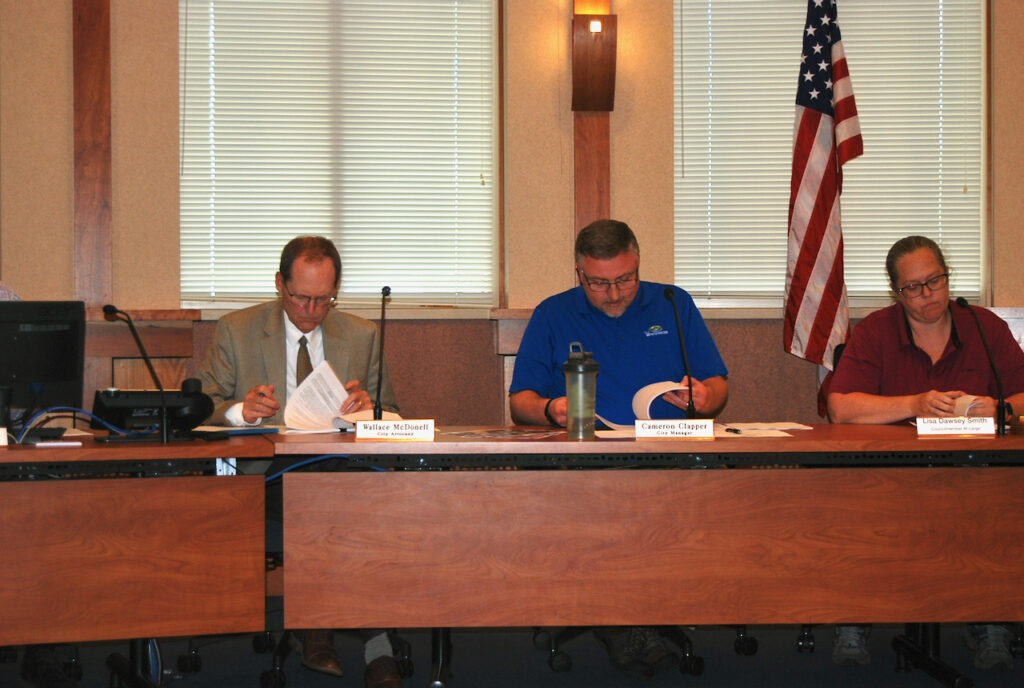
Whitewater City Attorney Wallace McDonell, from left, City Manager Cameron Clapper, and Common Council President Lisa Dawsey Smith look through proposals and associated quotes from two firms under consideration Tuesday to conduct a search for a new city manager. During the special meeting, GovHR was approved by the council to receive the project. Kim McDarison photo.
Whitewater Fire, EMS officials nominate new command staff
(Originally published July 13, 2022.)
The Whitewater Fire and EMS department has nominated command staff, according to information released Tuesday by city officials.
The newly named command staff moves the city forward with its ongoing plans to bring Whitewater Fire Department, Inc., in house as a city-operated department, the release stated.
After the completion of the merger, the new commend staff will serve on the in-house fire department.
The nominations will next be presented to the Police and Fire Commission for approval, the release noted.
According to the release, Kelly Freeman has been nominated to serve as chief of the City of Whitewater Fire and EMS Department. Freeman has served with Whitewater Fire Department, Inc. since 2006 and has held leadership positions as lieutenant, captain, and assistant chief.
Freeman is a part-time Fire I instructor at Gateway Technical College in Burlington, the release noted.
He also is an employee of the city, serving as superintendent of the Streets/Parks/Forestry Division of the Department of Public Works.
Additionally, Ryan Dion has been nominated to serve as first assistant fire chief and Joe Uselding has been nominated as second assistant fire chief.
Dion has been a member of the department for 15 years, holding the positions of lieutenant and captain. Uselding has served within the department for 21 years and has held the positions of lieutenant, captain and assistant chief, according to the release.
Ashley Vickers will serve as the department’s chief of EMS. Vickers has served within the department for 13 years and has held the position of EMS chief since 2021, the release continued.
“Mike Higgins, chief of WFD, Inc., will continue in that position until the merger is completed. He will stay on with WFD, Inc. until January, 2023, when he will retire from service,” the release stated.

A Whitewater Fire Department truck moves down Main Street during the Fourth of July parade. File photo/Kim McDarison.
Musical chairs: Walworth County ties to Dodge County searches
(Originally published July 13, 2022.)
By Kim McDarison
Officials in Dodge County are searching for a finance director.
Whitewater City Manager Cameron Clapper recently accepted a position with Dodge County as its new administrator. He will end his tenure as city manager on Aug. 12 and begin in his role as Dodge County administrator on Aug. 21.
According to agendas and meeting minutes made available on the county’s website, Public Administration Associates (PAA) has been working with the county to facilitate its search for a finance director.
The president of PAA is Kevin Brunner, who served as city manager in Whitewater between 2004 and 2012.
Also employed with PAA and assisting Dodge County in both its former county administrator and ongoing finance director searches is David Bretl. Bretl began his tenure with Walworth County, serving as administrative coordinator, in 2001.
In 2002, the county reorganized, abolishing the county coordinator position and creating the position of county administrator. Bretl continued in that position until 2020, according to information provided on the Walworth County website.
In Dodge County, a meeting of the Human Resources and Labor Negotiations Committee was held June 28. Among agenda items was a recruitment update regarding the position of finance director.
Within the minutes posted from the meeting, it was recorded that interim County Administrator Jon Hochkammer provided an update on the finance director recruitment process, noting that interviews were conducted the previous week.
The minutes continued: “However, unable to agree on terms of employment. Hochkammer stated the finance committee discuss next steps at the next meeting.”
The county’s Finance Committee last held a regularly scheduled meeting on July 11. An update on the finance director recruitment was among items listed on the agenda. As of Wednesday, July 13, meeting minutes had not been posted to the county’s website.
A special meeting of the Finance Committee is scheduled for July 19. Agenda items appear unrelated to a recruitment process associated with the finance director position.
The committee’s next meeting is scheduled for Aug. 8.
The Human Resources and Labor Negotiations Committee last met on July 12. Under recruitment update, a “general recruitment of Dodge County” item was listed.
A spokesperson in the county clerk’s office said committee meeting minutes are not posted to the county’s website until after they have been approved, which takes place during the committee’s next meeting.
The Human Resources and Labor Negotiations Committee’s next meeting is scheduled for July 26.
Fort Atkinson Online has contacted by telephone and email several Dodge County officials, including Hochkammer, county Human Resources Director Suzanne Immel and Dodge County Board of Supervisors Chairman David Frohling, requesting any updates available relative to the ongoing search for a finance director.
An interim finance director, Eileen Lifke, is currently in place.
A story about the county’s decision to pause its search for a director is here: https://fortatkinsononline.com/dodge-county-pauses-finance-director-search-lack-of-applicants-cited/.

Whitewater Municipal Building, file photo/Kim McDarison.
Dodge County pauses finance director search; lack of applicants cited
(Originally published July 14, 2022.)
Struggles with employee recruitment and retention have become high on the list of challenges facing local public entities such as municipalities and school districts.
Dodge County Interim Administrator Jon Hochkammer told Fort Atkinson Online Thursday that similar struggles exist at the county level, and, he said, the position of finance director is one of the hardest to fill.
Hochkammer serves as an interim administrator, contracted through Public Administration Associates (PAA), the recruitment firm which has been working with Dodge County to help fill two positions: county administrator and finance director.
The county administrator position has been filled, Hochkammer said, noting that Whitewater City Manager Cameron Clapper will be taking the administrative helm in Dodge County on Aug. 21. Clapper’s last day as city manager is Aug. 12.
Four months ago, Hochkammer said, the county began its search for a new finance director, and two months ago, after the county discovered a lack of applicants, PAA was asked to step in and help.
“The county didn’t have much success with their recruiting process and we (PAA) have found the same thing,” Hochkammer said.
The county interviewed a candidate for the position of finance director who had initially applied for the position of county administrator, he said, adding that the candidate had some background in finance.
Hochkammer said, when asked, the candidate expressed interest in the position of finance director. After an initial interview, he said, the county’s Finance Committee decided the candidate did not have enough credentials in finance.
A second candidate was interviewed, he said, but the candidate and the county could not come to an agreement regarding salary and benefits.
In both cases, he said, the candidates did not apply for the finance director position, but the county reached out to them.
After an agreement could not be reached with the second candidate, Hochkammer said, “the county board (of supervisors) chair and I recommended to the Finance Committee that we take a step back to allow us time to work on the annual budget.
“We can do that with the staff we have, and we will have Cameron on board. Then we can regroup in two months and attempt to do another recruitment, but for now, we wanted to wait.”
Having the new county administrator in place also was advisable before another recruitment round was undertaken, Hochkammer said, because it will be the county administrator who appoints the finance director. The Dodge County Board of Supervisors will then approve the appointment, he said.
“So right now, the process is at a stand-still. We will wait another month or two and see if the timing might be different for an individual or two,” he said.
When the process resumes, interviews will take place at the Finance Committee level, he said.
“We have no candidates at this time. We anticipate filling the job when we have a qualified candidate. If we find the right candidate, we are ready to fill it,” Hochkammer noted.
Currently, there is a lot of movement between private-sector entities and jobs, Hochkammer said.
Still, he noted, “recruitment is difficult because more people are retiring than there has been in a long time, so there is just a shortage of people at the different levels with the different kinds of experience.”
A lack of qualified candidates is further complicated by stress and burnout in the workplace, he said.
In the private sector, those working in the field of finance struggle with ever-dwindling operational and improvements budgets.
The stress and burnout is causing a lot of public-sector professionals to seek opportunities in the private sector where often they are offered more lucrative compensation packages, he said.
Stressors such as COVID also have played a role.
”Recruitment and retention is becoming more challenging like we’ve never seen it before,” he added.
Hochkammer said he was aware of other counties that also are in the market for a finance director, and some of them had been searching for even longer than Dodge County.
County-level work is specialized, he said. With 72 counties in Wisconsin, he described the pool of resources as “limited.”
When Dodge County resumes its search for a finance director, he said, the county will work through the Finance Committee to conduct interviews.
“We will keep working on the process, but the last thing we want here is to get behind on the budget process,” he said.
Hochkammer noted that PAA has a contract with the county that stipulates that if the company is not successful in finding a finance director within the first recruitment round, PAA will continue the recruitment process with no additional cost to the county other than the cost of ads for recruitments. He estimated that cost at about $2,500.
“We are still working on it,” he said.
An earlier story about the search for a finance director in Dodge County is here: https://fortatkinsononline.com/musical-chairs-walworth-county-ties-to-dodge-county-searches/.
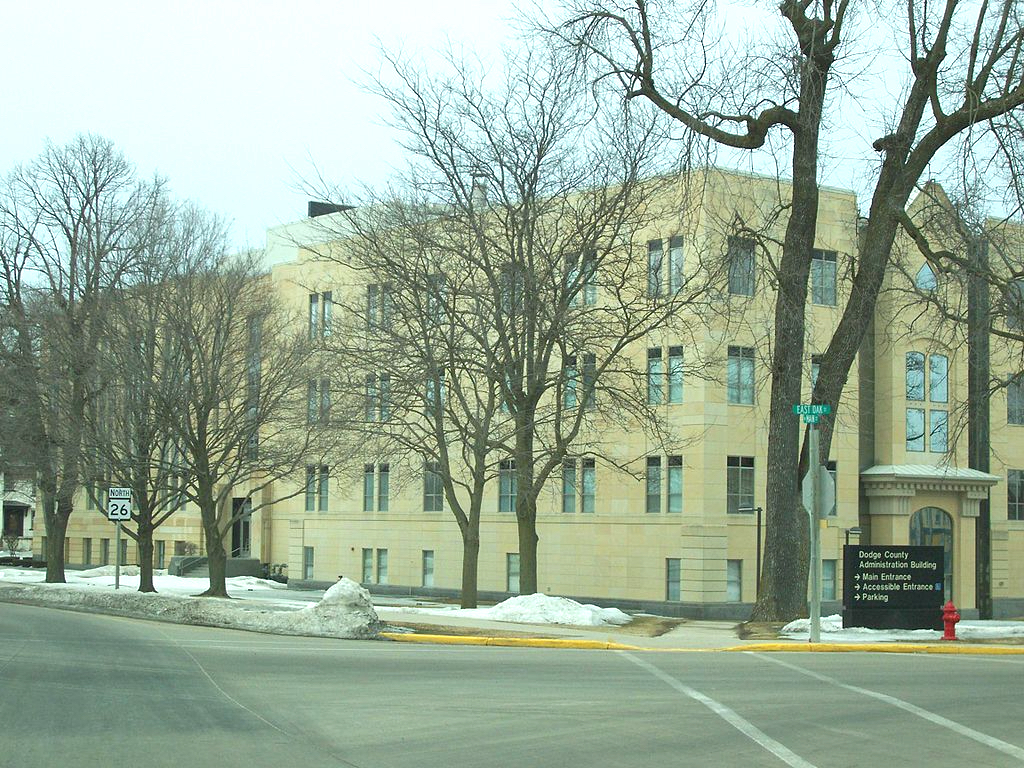
Dodge County Wisconsin Administration Building, Wikipedia. Created March 12, 2008. (Attribution/Sharealike.)
Whitewater: City taps GovTemps USA for interim city manager services
(Originally published July 22, 2022.)
Editor’s note: this story has been updated to include information from the proposal adopted Tuesday by the common council.
By Chris Spangler
The Whitewater Common Council is contracting with a public-sector staffing firm to draw applicants for an interim city manager.
During its regular meeting Tuesday, the council unanimously voted to contract with GovTEMPS USA.
The contract with GovTEMPS USA will be in effect for six months beginning July 1., according to information shared by city officials through email Friday.
The council already was working with GovHR USA, a professional recruitment firm, to conduct a search for City Manager Cameron Clapper’s successor.
Clapper will be leaving his post Aug. 12 to serve as the county administrator in Dodge County.
GovTEMPS USA is a subsidiary of GovHR USA. It specializes in the temporary placement of positions in local government. The firm offers project-specific and short-term assignments, in addition to longterm and outsourced arrangements.
According to the GovTEMPS contract, the terms of the newest contract are “in accordance” with the GovHR contract, with its proposed starting date of July 1.
Council members discussed the interim city manager recruitment process in closed session and then reconvened into open session for its unanimous vote.
The motion to hire GovTEMPS was made by councilperson James Allen and seconded by councilperson Lukas Schreiber.
Particulars of the contract with GovTEMPS USA were not disclosed during Tuesday’s meeting.
According to the GovTEMPS USA proposal, which also was shared Friday, Senior Vice President Lee Szymborski will be working with Whitewater as its project manager.
“He will we be responsible for your recruitment and selection process,” the proposal stated.
An earlier story about the ongoing recruitment process is here: https://fortatkinsononline.com/whitewater-council-hires-govhr-to-conduct-city-manager-search/.
This story has been updated.

Whitewater City Administration Building, file photo/Kim McDarison.
Whitewater: Council discusses future of 1889-built water tower
(Originally published July 24, 2022.)
Correction: During public comments at Tuesday’s meeting, Kori Oberle asked Cornerstone to provide the cost of demolition, and not costs associated with moving the tower. Copy has been changed to reflect her statement. Fort Atkinson Online regrets the error.
By Chris Spangler
The Whitewater Common Council on Tuesday kicked off a community conversation about what to do with the historical Starin Park water tower.
The tower, which was built in 1889 by C.E. Gray Jr. and Co., according to lettering engraved on its datestone, is located in the city’s Starin Park.
As of 2020, freestanding informational signage in the park states, the tower “is the second oldest operating municipal water tower in the state of Wisconsin.”
The full tower’s height consists of 80 feet of stonemasonry which supports a 20-foot-tall water tank. The tank holds 185,000 gallons of water, informational signage states.
During Tuesday’s meeting, those in attendance learned that the city’s new southwest water tower will go online in 2023, so plans call for decommissioning the Starin Park tower in 10 to 12 months.
Department of Public Works Director Brad Marquardt reported that earlier this year, Cornerstone Restoration of Sullivan had undertaken some tuckpointing on the worst sections of the water tower to help stop leaking and deterioration of the structure’s interior.
The idea was to address falling material inside the tower, since employees enter the tower each day to take water samples.
Kyle O’Brien of Cornerstone told the council during its meeting Tuesday that his company did damage containment.
“We plugged a lot of holes with close to 3,000 pounds of mortar,” he said, noting that they “were patching what nature had opened.
“There is substantial work out there that still needs to be done,” he added.
The tower’s base is about 8 feet thick and the top is approximately 4 feet thick, O’Brien said.
“There’s a lot of mass there,” he said, telling the council that the tower “definitely needs a lot of attention.”
While Cornerstone was doing the work, O’Brien offered to provide a quote on what it would cost to restore the water tower. The estimate came in at $968,800.
He told the Public Works Committee last month that the work would include removing loose exterior face stone masonry veneer at the top two levels and replacing the salvaged stone. New stone exceeding three tons would boost the cost.
The bottom three sections would be fully tuckpointed at all elevations. Stone repairs on the lower three sections would be completed as needed on a time-and-materials basis of $105 per manhour.
The tank would have to be drained independently and remain empty throughout the project.
The proposal would only cover work to the face veneer. The interior stone backup wall was not evaluated.
Council President Lisa Dawsey Smith said Tuesday that she is certain nobody wants to see the old water tower razed, but she acknowledged that restoration is costly.
She said she recently received an email from Kori Oberle, a member of the city’s Landmarks Commission, who noted how Fort Atkinson restored its 1901 water tower through fundraising. While owned by the city, it was overseen by the Historic Preservation Commission until the Hoard Historical Museum assumed stewardship last August.
Oberle served as director of the museum from 2008-14.
Dawsey Smith said that even were the historical society to take responsibility for a Starin Park water town project, the issue of financing a restoration “doesn’t go away.”
The Landmarks Commission did discuss this at its last meeting, she added.
During public comments, Oberle posed several questions to O’Brien. Among then, she asked for the cost associated with demolishing the tower.
Within the discussion, O’Brien addressed the potential for salvaging materials from the tower.
“As far as the stone itself, the exterior stone, some of it has shale split and peeled off … Presumably the interior stone is in better shape, but it is encapsulated in mortar, so whether it could be reutilized in another project or not is a factor,” O’Brien said.
Oberle noted that the Jeffers Family Foundation in Janesville would be a likely funding source for a tower restoration, and that the structure meets preliminary eligibility requirements.
“I think the big question is how much is it going to cost to save it?” she said. “But a bigger question is what would the community do with it once its saved? It’s what you’ve been asking all along. Who would be responsible for it and how would we keep it in better repair so this wouldn’t happen again?”
Citizen Richard Helmick asked whether draining the water tank might positively impact the immediacy of repair.
“The compressive load of the water itself helps solidify the structure and helps overcome ice jacking or steel jacking. Whether the interior would deteriorate faster without the load on it, I would say it would be somewhat negligible,” O’Brien replied.
Ice jacking occurs when water permeates a confined space within a structural support, ultimately causing structural fracture when the water freezes and expands.
He said there is a lot of steel up there, so there still will be a lot of weight even if the water tank is empty.
Whitewater resident Dave Saalsaa likened the tower’s structure to that of the Egyptian pyramids.
“The pyramids in Egypt have a capstone of limestone over big stones. That capstone fell off, the pyramids are still there,” he told the council. “Are you saying the capstones are the ones in danger of falling off? We don’t really know what the interior looks like because it’s still covered up by capstones, correct?”
O’Brien said it is not just the capstones — or courses, as they are called technically when brick and mortar are sandwiched together — that are a concern.
“There’s all these difference courses and they interlock. The capstones might be where it steps back. Those themselves are losing some shale. But the veneer itself — the masonry, exterior of the building, the stuff you see as the veneer — those sections also are shaling, falling off, as well. So it is the whole structure, not just specific section …,” he said.
City Manager Cameron Clapper also offered remarks.
“We have a tower here that is one of the oldest in the state of Wisconsin and something that we ought to dedicate more time and resources to discussing and determining the best course of action for it,” he said.
Clapper recommended providing Marquardt with anything needed for moving toward taking the Starin Park water tower out of service, as well as direction or action regarding having, with the Landmarks Commission, the historical society review potential funding resources, including the Jeffers Family Foundation.
“I know we don’t have as robust a community foundation as Fort Atkinson has, but community foundations are also a wonderful resource to utilize, at the very least, to solicit funds when we do fundraising projects and dedicate time and effort to what we can do,” the city manager said. “It would be a shame to simply act to remove the tower because the cost at this time is seemingly prohibitive. I think that there are people that really don’t want to pay taxes that would be happy to fund a project like this if they saw direct result in the end in having the tower still standing as a landmark.”
Marquardt said he did not need any immediate recommendations on decommissioning the tower.
Councilperson Jill Gerber wondered whether wrapping the tower would help stave off deterioration were work to be delayed for, say, three years. She also said she would like to know the cost of razing the structure.
Dawsey Smith said she would be interested in having the Landmarks Commission explore potential ownership options for the tower once the Water Department relinquishes responsibility.
She also said she would like to know if the Landmarks Commission would be amenable to providing summaries of potential funding avenues that could be pursued, especially the Jeffers Family Foundation.
In addition, she asked that this be routed to the Finance Committee to see if there might be potential future funding by the city.
Councilperson Brienne Diebolt Brown suggested also looking into the availability of federal monies.
Whitewater Landmarks Commission Chairperson Patricia Blackmer reminded the council that the city already is responsible for several landmarks, including the Birge Fountain, which is targeted for possible restoration by 2027.
“There are many, many things out there, and financing will be a problem because I know our budget is not that big,” she said. “But we’re looking at constantly reminding you that these are essential. The same with the effigy mounds preserve; that is an expense. Keep it tucked in your hat that there are other projects that the city is responsible for.”
She added, “I just want to remind the public, as well as the common council, that this is a local landmark and it is protected by ordinance.”
In other business, the council:
• Assigned a 15-minute parking stall in front of K9 Hair Care LLC at 104 W. Center St.
Owner Lisa Berglin had requested the change so her customers would be for easy dropoff and pickup of pets.
The Public Works Committee had recommended the 15-minute parking designation for 8 a.m. to 4 p.m. Monday through Friday. However, councilman Allen suggested removing the limited hours, adding that the 15-minute parking also would be beneficial to Gus’ Pizza drivers.
On a motion by Allen that was seconded by Diebolt Brown, the 15-minute stall was approved with no time or day limitations.
It is the first stall on the north side of Center Street, just west of Whitewater Street.
• Accepted the bid of FJA Christiansen Co. Inc. for the Digester Control Building roof replacement.
The Milwaukee company bid $91,456.

A view of the 1889-built water tower as it stands today in the city of Whitewater’s Starin Park. The tower, which is an active component of the city’s water utility system, will be decommissioned in 2023.
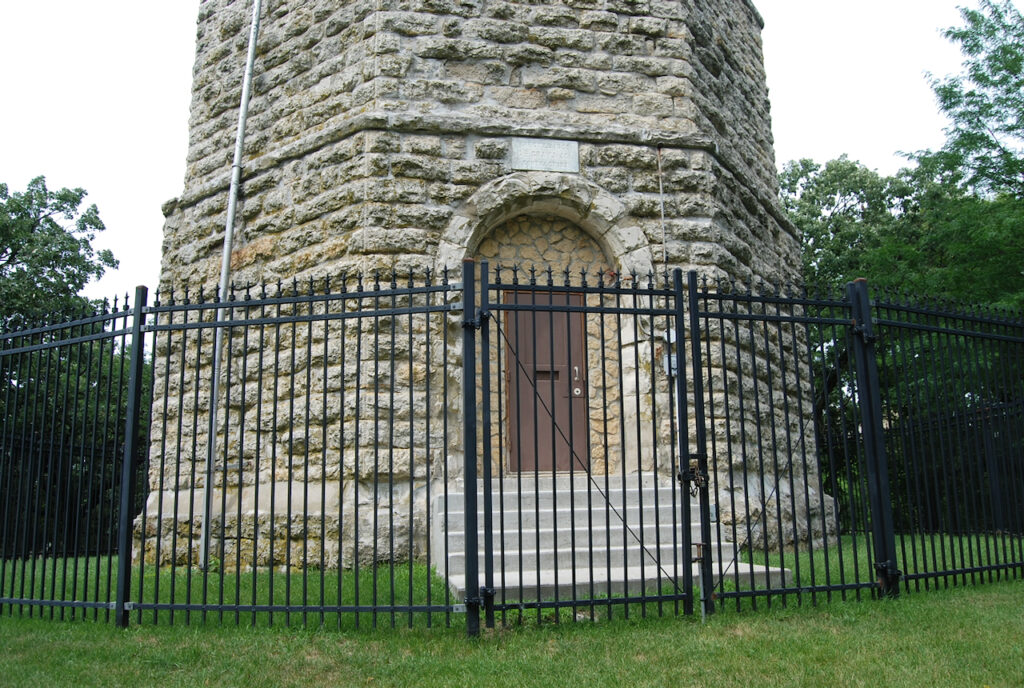
A doorway allows entrance into the 1889-built water tower. City employees enter the tower daily to take water samples, Whitewater Common Council members learned during their meeting held Tuesday.

Engraved lettering on the tower notes that it was built in 1889 by C.E. Gray Jr. and Co. Informational signage in Starin Park notes that the company was Chicago-based. The tower, according to the signage, was built initially as a private utility and turned over to the city in 1912. The octagon-shaped structure is constructed largely of limestone.

Nestled within the city of Whitewater’s Starin Park, the 1889-built stonemasonry water tower looms large above the treetops. According to informational signage in the park, the 100-foot-tall tower was built at the site because it is 50 feet higher than the surrounding area. The tower, which, as of 2020, is the second older municipal tower operating in Wisconsin, holds 185,000 gallons of water.
Kim McDarison photos.
Whitewater: Council moves discussion extending Bird Scooter contract to upcoming meeting
(Originally published July 24, 2022.)
By Chris Spangler
The City of Whitewater Common Council Tuesday delayed action on requests by Bird Scooters until questions are addressed.
Department of Public Works Director Brad Marquardt reported that the city’s original one-year agreement with Bird Scooters expired June 30, and the company was seeking an amendment extending the contract to April 30, 2023, with automatic renewals for successive six-month terms.
The agreement can be terminated without cause with a 30-day prior notice.
Bird also requested having 24-hour service.
“I did mention to them the concern we had as staff, especially the police department, that was with students using them after attending certain establishments downtown late at night,” Marquardt said.
He said Bird Scooters does offer Safe Start, requiring that people wanting to use the scooters between 10 p.m. and 4 a.m. unlock them by correctly entering a keyword into the app.
“I do not find that very satisfying in knowing that all they have to do is enter a keyword, so I would still recommend that we keep the hours as is for operation,” Marqardt said.
Whitewater Common Council President Dawsey Smith said she had received emails from citizens concerned about scooters being left about town, in yards and on sidewalks.
Marquardt said there is a contact number people may call to report complaints, and he would get that sent out to concerned citizens.
Councilman Jim Allen said he did not think the council should extend the contract until the concerns about abandoned scooters had been addressed.
He suggested bringing Bird Scooters representatives back before the council to discuss them, and that was the council concensus.

A Bird Scooter awaits use at the corner of Main and First streets in Whitewater’s downtown area. File photo/Kim McDarison.
Whitewater: Police arrest school district employee accused of sexual relationship with a minor
(Originally published July 26, 2022.)
According to information released Tuesday, officers of the Whitewater Police Department responded Friday, July 22, at 10:03 p.m., to the intersection of E. Clay and S. Wisconsin streets after receiving a report of an alleged suicidal male.
Upon further investigation, officers identified the male as 34-year-old, Anthony P. Hansen, of Whitewater, and determined that Hansen had allegedly been in an ongoing sexual relationship with a minor. It was also found that Hansen was an employee of the Whitewater Unified School District (WUSD), the release stated.
Whitewater Police Department staff swiftly began an investigation, and are working closely with WUSD staff as the investigation continues. A charge of Sexual Assault of a Child by a School Staff Person has been forwarded to the Walworth County District Attorney’s Office. Additional charges may be forwarded pending results of the investigation.
The Whitewater Police Department recognizes that Hansen is considered innocent until proven guilty. Due to the fact that this is an ongoing investigation, no additional information will be released at this time.
“We want to thank those who came forward to report their concerns. We strongly encourage others who have information relevant to this case to contact the Whitewater Police Department at 262-473-0555, or by contacting Detective Jacob Hintz directly at jhintz@whitewater-wi.gov. Anonymous tips may also be shared using P3Tips.com,” the release noted.
For community information and updates from the Whitewater Police Department, visit www.whitewater-wi.gov.

Whitewater Police Department, file photo/Facebook.
.
Whitewater: Council brings fire department in house; explores November ballot referendum
(Originally published July 30, 2022.)
By Kim McDarison
The Whitewater Common Council Thursday approved an agreement, bringing the city’s fire and EMS services in house.
The agreement was adopted unanimously during a special joint meeting of the council and Whitewater Fire Department, Inc., the nonprofit organization that, until Thursday’s decision, provided the city and several surrounding communities with fire and EMS services.
The agreement was approved by a 5-0 vote. Council members Jill Gerber and Gregory Majkrzak were not in attendance.
Thursday’s agreement places Whitewater Fire Department, Inc., staff on the city’s payroll effective Saturday, which is the beginning of the city’s pay period.
Also discussed Thursday was the need for an increase in funding to support the in-house department.
Whitewater Director of Finance Steve Hatton shared several slides depicting various financial scenarios.
He and Whitewater City Manager Cameron Clapper recommended that council consider the placement of a referendum question on the November ballot to support budgetary shortfalls. A potential amount of $700,000 was discussed for ballot placement.
On Thursday, both Hatton and Clapper told Fort Atkinson Online that the amount was a best estimate and could change as more information was gathered to form a referendum question.
Clapper described the formulation of a referendum question as “a work in progress.”
Department overview
Before the agreement was approved, the council received a financial update relating to expenses associated with bringing fire and EMS services in house.
Aided by slides, Hatton told those in attendance at the joint meeting that the move to bring the services in house was made to help alleviate increasing difficulties with staffing faced by the department when using a paid-on-call model.
With staffing constraints, he said, Whitewater was often forced to seek mutual aid from neighboring departments, putting additional stress on those departments’ manpower and assets.
Plans associated with bringing the department in house called for the use of a paid-on-premises model, which would improve the department’s response times and improve its ability to recruit manpower, Hatton said.
The new model would also provide department employees with health and retirement benefits and produce a schedule with more reliable hours, he said.
As part of the agreement, the Whitewater Fire Department, Inc., or WFD, Inc., would be preserved to function as a fundraising organization for the department and would maintain a fund balance to help support services and pay for capital costs associated with purchasing and replacing equipment.
The fundraising tool could also be used to help pay some operational costs as appropriate, Hatton said.
Included within his presentation, Hatton shared a slide showing the department’s service area, which, he said, includes the city of Whitewater and the towns, in part or full, of Whitewater, Cold Spring, Koshkonong, Richmond, Lima and Johnstown.
Hatton also shared a timeline of events, noting that WFD, Inc., notified the city of its intent to develop a new agreement in June of last year.
In October of last year, WFD, Inc., requested $526,000 from the city’s budget. A special meeting was held in October, and the city and WFD, Inc., began sharing ideas to integrate the department as part of city-operated services. Meetings with the towns that contract services from the fire department, the city, and WFD, Inc., were held in November 2021.
The membership of WFC, Inc., voted to accept a proposal for integration with the city in January, which was followed by approval by the city council of a memorandum of understanding for integration in April.
Thursday saw the adoption of the final agreement.
Looking at staffing levels within the department, Hatton said “at transition,” the department has four EMTs on duty 27/7 and two ambulances available to respond to calls for service. The department was staffing a total of 34,944 annual hours, he said.
Firefighters received active pay for calls and on-call pay when responding to calls on nights and weekends.
In addition, Hatton produced a slide showing per hour wages paid to firefighters and EMS staff. Hourly wages for firefighters stared at $13.65 and increased depending on training and rank within the department. The fire chief was the highest paid staff member at $24.55 per hour. On the EMS side, transport drivers and trainees earned a per hour starting wage of $7.25 which increased with level of training to a maximum of $22 per hour.
Hatton further produced a slide that offered three staffing alternatives that could be used to cover service hours.
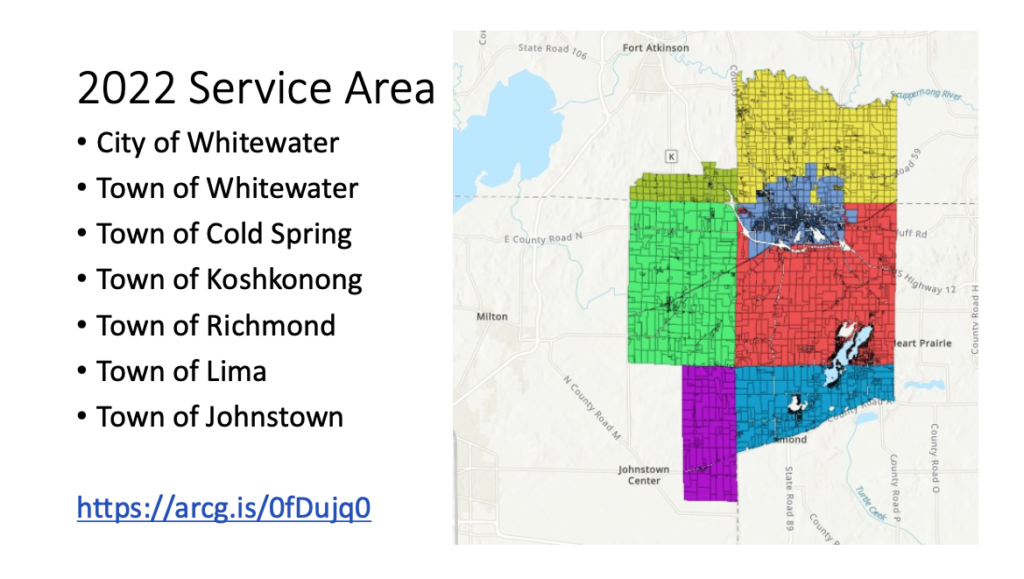
A slide, as provided within a presentation made Thursday by Whitewater Director of Finance Steve Hatton, shows the service area of the Whitewater Fire and EMS department.

A slide shows the Whitewater Fire and EMS Department’s staffing model “at transition.”
Budgets
Looking at the department’s financial overview, Hatton said that in 2021, the department had an operating budget of $1.084 million, with actual costs that year coming in at $1.004 million. This year, the department began the year with an operating budget of $1.5 million, with expenses running at $2.01 million.
He attributed changes in the budget to wages and benefits associated with in-house EMS staffing in the amount of $395,034, and wages and benefits associated with the firefighting staff in the amount of $111,714, for a total increase of $506,748.
With dollars budgeted in 2022 for the department’s operation compared against actual costs, the city would be potentially looking at a shortfall of approximately $1.8 million, he said.
Looking at a capital replacement schedule, Hatton said the department had a total of 15 wheeled assets with a total replacement value of $7.9 million. To maintain the department’s current vehicle and equipment replacement cycles, the city would need about $385,173 annually.
Bringing the operational and capital expenditures together, Hatton said in 2022, the city would require a total operating budget of $2.01 million and a total capital annual budget of $384,000, for a total cost to support fire and EMS of $2.4 million.
Looking at potential sources of money to offset those costs, Hatton said the city in 2022 would have $182,529 to contribute, with another $202,301 coming from the towns served by the department. Another $645,537 would be collected through fees charged to individuals requiring services, leaving what he defined as a “total funding gap” of $1.36 million.
The city has historically funded vehicle replacement through debt issuance and payment by debt service levy, Hatton said.
Facility maintenance and utilities associated with the department have historically been paid using the city’s general fund.

A slide shows the city’s fire and EMS operational budget and the actual dollars spent in 2021, and the original budget approved and the current expenditures in 2022. The operating statement indicates that the original budget in 2022 was set at $1,509,342 while the current expenditures are shown at $2,016,089, placing 2022 expenditures $506,748 over budget.

A balance sheet shows the replacement value of the fire and EMS wheeled assets. To continue with the department’s vehicle and equipment replacement cycles, the city would need $385,173 annually.
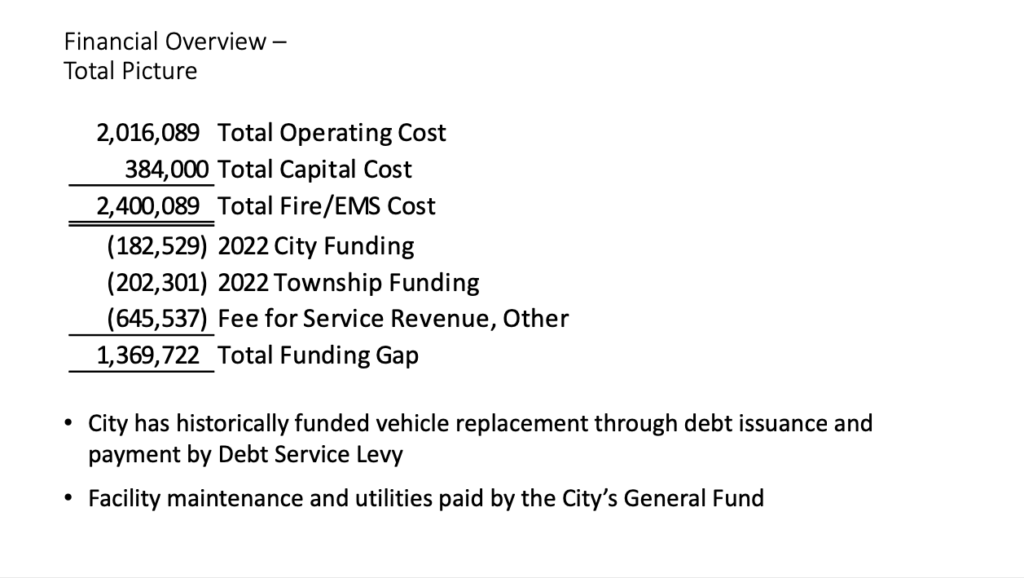
A slide shows the city’s “funding gap” in 2022 calculated after the city’s fire and EMS operating budget and the annual cost of capital replacement is applied against funding paid to support the service district by the city and contracting towns.
Tax levy and impacts
Hatton sought to facilitate an understanding of potential impacts to the city’s levy and the mill rate.
In 2021, he said, in Walworth County, the assessed value of the city’s total taxable assets was $657,651,199. The city’s 2022 tax levy was $3.8 million. In 2022, a Tax Incremental Finance (TIF) tax levy was $1.3 million. The impact to the taxpayer was $6.35 per $1,000 of assessed property value.
In 2021, in Jefferson County, the assessed value of the city’s total taxable assets was $92,912,384. The city’s 2022 tax levy was $405,521, with a TIF tax levy of $691,409. The impact to the taxpayer was $6.41 per $1,000 of assessed property value.
Looking at various estimated tax levy increases, which could be sought in November through the referendum process, Hatton produced several charts showing increases in mill rates and the associated impacts at differing levels of home value in both Walworth and Jefferson counties.
Hatton said the average home value in Whitewater is $206,000.
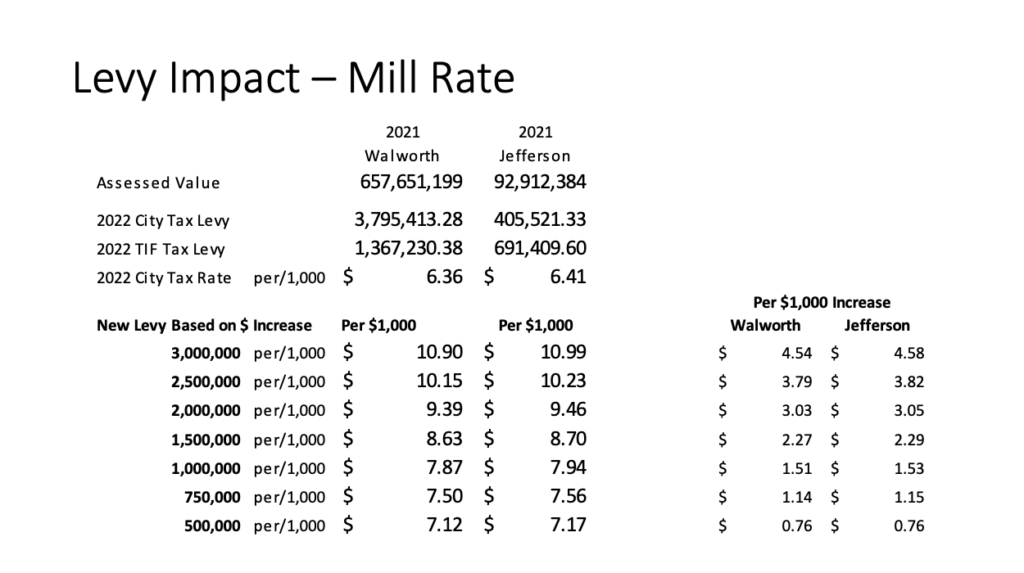
The slide above shows tax levied amounts assessed by the city and the associated mill rate. In 2021, city of Whitewater residents living in Walworth County paid $6.36 per $1,000 of assessed home value. City of Whitewater residents living in Jefferson County paid $6.41. The chart shows mill rate increases associated with varying tax levy amounts.

With the average home in Whitewater valued at $200,000, highlighted in yellow, the chart shows the tax impact as a yearly increase to a homeowner at varying levy amounts.
Allocation of costs
Hatton cited a need to establish an objective and transparent model to allocate costs to municipalities served by the city’s fire and EMS department. He noted that the past practice, used by WFD Inc., to allocate costs was “not well documented or understood.”
Hatton recommended that the city adopt the use of an equalized value model to allocate costs.
Equalized value is used by school districts and other jurisdictions where several municipalities share services, he said. The concept offers a means by which to allocate proportional shares. He described the process as using “simple and objective data maintained by the state and counties.”
In Addition, Hatton said, he would continue to explore other methods used by neighboring departments. He cited the North Shore Fire Department in the Milwaukee area and the City of Delavan Fire Department, which provides service to a portion of the town of Richmond, as entities he would query for advice.
Hatton next provided a slide showing in 2021 the total equalized value of taxable parcels in the city of Whitewater and the towns served by the department.
The chart offered an estimated $1.3 million which could be received through equalized value to support the costs of the fire and EMS service area.
Breaking those numbers down, Hatton said that of the $1.3 million, the city of Whitewater’s taxpayers would be responsible for $697,744. The rest would become the responsibility of the towns within the service area.

The slide shows the allocation of costs to each of the entities contracting services within the Whitewater fire and EMS service area. Of the $1.3 million available through taxation using equalized value, city of Whitewater residents living in Walworth County would be allocated $610,767 and city of Whitewater residents living in Jefferson County would be allocated $86,977.
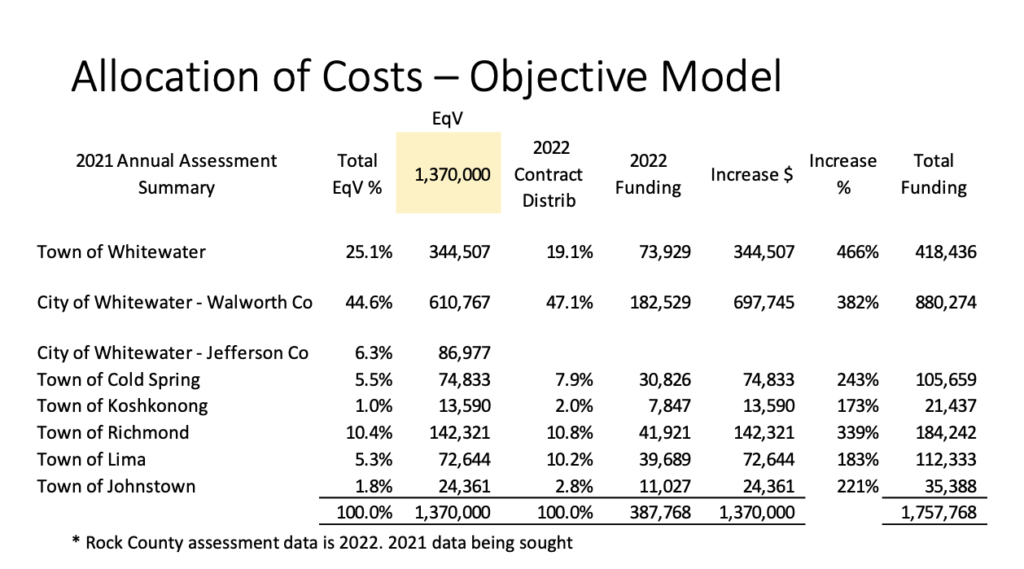
The chart shows the percentage of the total $1.3 million each municipality within the Whitewater Fire and EMS service area is responsible for paying, related to the full cost, as a function of equalized value.
Next steps
Defining next steps, Hatton noted that the city would need to begin communicating with the towns supported by the city’s fire and EMS department to make them aware of future funding contributions.
Clapper said that while the towns were aware that the council would be making a decision regarding bringing fire and EMS services in-house, and that there could be additional future costs associated with that change, they were also aware that their contracts with the department would remain in place until the end of the year. He did not believe the towns would have the ability to bring a referendum before their voters in time to collect additional monies by November.
Hatton said that the city would need to finance the costs until the towns could decide how they would finance the increase.
He suggested that council during its next meeting establish a referendum question to bring before the city’s voters in November.
The selection of a referendum consultant to help educate the public about the need for the referendum also was included among next steps.
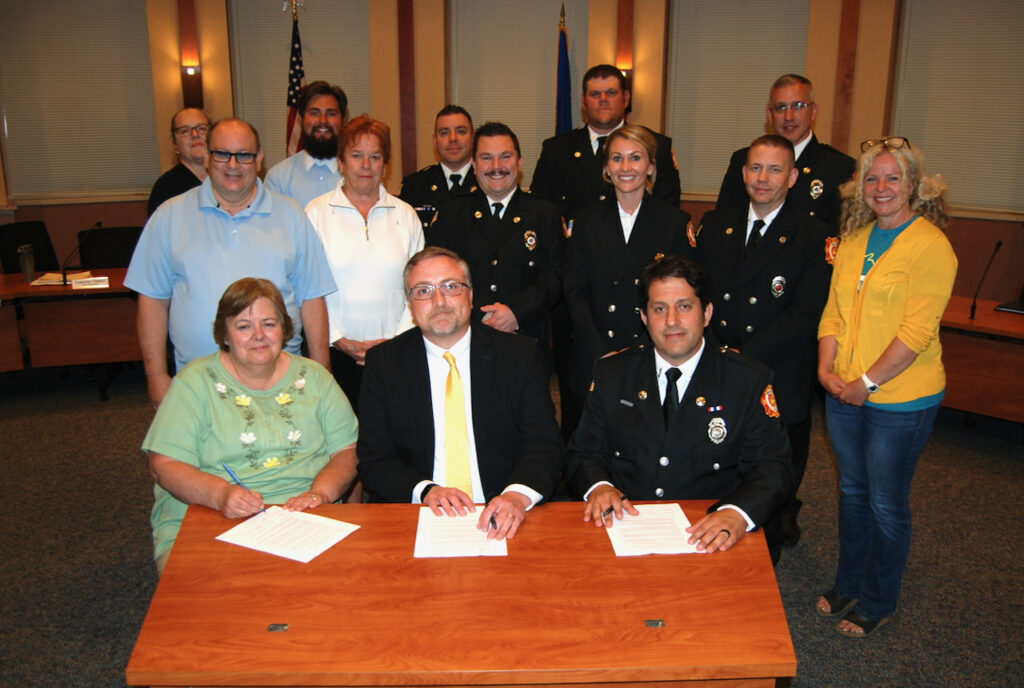
Members of the Whitewater Common Council and the Whitewater Fire and EMS Department, formerly of Whitewater Fire Department (WFD), Inc., gather behind Whitewater City Clerk Michele Smith, seated, from left, City Manager Cameron Clapper and WFD, Inc., Board of Directors President and Capt. Christ Christon, who signed on Thursday an agreement to bring the department in house as a city-operated service.

Members of the Whitewater Fire and EMS Department include: EMS Capt. Jason Dean, from left, Capt. Christ Christon, EMS Chief Ashley Vickers, Lt. Justin Sachse, Lt. Andy Rowland, First Assistant Fire Chief Ryan Dion and Second Assistant Fire Chief Joe Uselding. The fire and EMS personnel were in attendance Thursday at a joint meeting of the Whitewater Common Council and the Whitewater Fire Department, Inc.
An earlier story about the in-house department’s command staff is here: https://fortatkinsononline.com/whitewater-fire-ems-officials-nominate-new-command-staff/.
Kim McDarison photos.
Whitewater: City eyes updated fire, EMS $1 million operational referendum
(Originally published Aug. 3, 2022.)
By Kim McDarison
The City of Whitewater Common Council Tuesday received an updated report outlining a need for $1 million in additional taxpayer dollars to support the newly integrated fire and EMS department.
The report received Tuesday from Whitewater Finance Director Steve Hatton updates an earlier report received by council during a special meeting held last Thursday.
During Thursday’s meeting, Hatton described a scenario in which the city would possibly need $700,000 to finance operational expenses associated with its new in-house fire and EMS department. The department, which was formerly run as an independent agency, was integrated as a city-run department effective July 30.
During Thursday’s special meeting, held to discuss fire and EMS department funding, both Hatton and City Manager Cameron Clapper noted that the development of the full financial picture and the referendum question anticipated to come before voters in November were both a “work in progress.”
On Tuesday, updated numbers delivered by Hatton outlined a need for a referendum question, asking voters for $1 million, rather than the earlier estimation set at $700,000.
During the meeting, Hatton noted that council could approve action to allow city staff to begin to formulate a referendum question based on the need for $1 million additional tax-levied dollars coming from the city’s taxpayers or council could opt to wait and approve action after city staff formulated a referendum question, at which time the requested dollar amount and the question’s associated language would be placed on an upcoming agenda.
Following advice offered by City Attorney Wally McDonell, council opted to instruct city staff to formulate a referendum question for approval by the voters in November, bringing the full question with its associated dollar amount and language before council for approval at an upcoming meeting.
Additionally, council approved the scheduling of a special meeting, with intent that it should be held sometime before the next regularly scheduled council meeting, to consider the completed referendum question.
The next regularly scheduled city council meeting is set for Aug. 16.
A date for the special meeting, as of Tuesday, remains pending.
A $1 million ask and its impact
During Hatton’s presentation made Tuesday, new information associated with an increase in the tax levy by $1 million was shared.
Hatton proposed that the city use a “weighted model” to allocate costs between the various communities, including the city of Whitewater, that contract fire and EMS services with the Whitewater Fire Department.
As noted in his earlier presentation delivered Thursday, the department’s service area, along with the city of Whitewater, includes, in full or part, the towns of Whitewater, Cold Spring, Koshkonong, Richmond, Lima and Johnstown.
Revisiting information shared Thursday as part of a financial overview, Hatton said that the fire department’s operating budget in 2022 was set at just over $1.5 million, but expenses in 2022 are anticipated to reach just over $2 million. Additionally, the department uses a vehicle replacement schedule which comes at a cost of $384,000 annually. When adding the operational costs and vehicle replacement costs together, he said, they come to a total cost for fire and EMS services of $2.4 million. After deducting known monies, coming through city, towns and user service fees set aside to fund the department, the city would be left with a “funding gap” of just over $1.3 million.
An earlier story explaining the department’s expenses and funding gap is here: https://fortatkinsononline.com/whitewater-council-approves-bringing-fire-department-in-house-explores-november-ballot-referendum/.
New information provided Tuesday offered a first look at a cost allocation model that would meet the city’s identified goals of objectivity and transparency, Hatton said.
He noted Tuesday, as he did last Thursday, that the department’s previous practices to allocate costs were “not well documented or understood.”
Looking at the immediate need associated with funding the new in-house fire and EMS department, Hatton said the department could not function if, from day one, there was not manpower and equipment to respond to calls. He noted that the city needed to be ready to provide services “absent township involvement.”
Hatton said that the city had been involved with a planning process to move the fire and EMS department in house for some time and therefore, had some time to prepare for the financial changes the move would bring. The towns that contract for services provided by the department did not have that advantage, he said.
He did not believe the towns were prepared to make the required financial changes needed to fund the department or bring a referendum question to their voters before the end of the year, which, Clapper said Thursday, is when their contacts with the department will expire.
Until that time, the city would need to fund its department, Hatton said Tuesday.
Looking at a weighted approach, Hatton said that he recommended the use of a model that would allocate costs using equalized value, weighted at 25% of each community’s total cost, and EMS call volume, weighted at 75% of each community’s use of the department’s equipment.
Listing the advantages of using equalized value, Hatton said the metric was simple, objective and used data maintained by the state and counties, and is used by the Milton/Edgerton Fire District and area school districts.
Listing the advantages of using the call volume metric, he said it recognizes the differences in service demands made by each community and is based on a five-year average to minimize volatility of measure.

Providing a chart, show above, depicting call volumes, Hatton said, when compared with the contracted towns, the city of Whitewater has the largest average call volume of users within the department’s service area. Of the total number of calls to which the department responds, on average, 73% are from residents within the city, bringing the city’s weighted dollar contribution in 2022 to just under $1 million to fill the $1.3 million gap.
Looking beyond 2022, the chart showed the city’s contribution at $1.18 million, with a total budget to operate the service area at $1.76 million.

Within his presentation, Hatton provided a chart, presented above, showing the funding amounts required by city residents and those in each contracted town using a 25% increase to the towns’ budgets in 2023. The model assumes that the towns will look to bring referendum questions before their voters in 2023, with the city charging full rates to the towns in 2024. The 2024 increase also was adjusted for inflation by an additional 4%.
In 2023, the city’s contribution is calculated at $1.18 million with a total budget to operate the service area set at $1.76 million.
In 2024, the city’s contribution is $1.2 million with a total budget to operate the service area at $1.8 million.

Looking at the mill rate paid by city residents to support city services, a chart, shown above, noted that the current mill rate for residents living in the Walworth County portion of the city is $6.36 while the mill rate paid by residents living in the Jefferson County portion of the city is $6.41.
Looking at an increased levy amount of $1 million, Walworth County residents would see an increase in their mill rate of $1.51, bringing their new total mill rate for city services to $7.87. City residents living in the Jefferson County portion of the city would see an increase of $1.53 in the mill rate paid to support city services for a total mill rate of $7.94.
The mill rate is the amount paid per $1,000 of home value.

Using the average cost of a home in Whitewater, which, Hatton said, is $200,000, the annual tax impact to a homeowner to support city services living in Walworth County, would voters approve the proposed referendum, would be $302, while the the annual impact to a homeowner to support city services living in Jefferson County would be $306.
Next steps
Looking at next steps, Hatton noted council’s next task was to seek voter authority to exceed the levy limit as set by the state through the referendum process.
He suggested the amount by which to exceed levy limits should be set at $1 million within the referendum question.
He asked council to authorize city staff and the city attorney to compose a question in compliance with Wisconsin statutes.
Additionally, the council received proposals from two firms — Mueller Communications and Michael Best Strategies — to help facilitate the educational and communication process in advance of bringing the referendum question before voters.
Council approved a proposal submitted by Mueller Communications at a cost not to exceed $52,690 by a vote of 5-1, with Councilwoman Brienne Brown casting the “no” vote. Councilwoman Jill Gerber, who attended the meeting remotely, abstained from the vote, citing her inability to review the submitted proposals. Proposals from the two communications firms were handed out during the meeting and were not included in the online meeting packet of information which could be viewed electronically.
A story with additional details about the proposals will be published by Fort Atkinson Online at a later date.

Members of the community attend Tuesday’s City of Whitewater Common Council meeting. Among items discussed was the continuing process to form an operational referendum question for placement on the November ballot to support the Whitewater Fire and EMS Department, which was recently brought in-house. Kim McDarison photo.
Primary election guide: Statewide races on Aug. 9 ballot
(Originally published Aug. 4, 2022.)
Compiled By Kim McDarison
Across the state of Wisconsin voters will be heading to the polls on Tuesday, Aug. 9.
Polling places are open from 7 a.m. to 8 p.m.
The partisan primary will see races in which multiple candidates from within each political party are vying for an open seat. Winners in the primary election will advance to the Nov. 8 general election, during which the winners for each open seat will ultimately be decided.
One candidate from each party vying for each available seat will advance to the general election.
Voters are asked to select candidates on the primary ballot from within a single party.
Voters looking to check their registration status as well as find their polling place can visit: https://myvote.wi.gov/en-us/.
Voters arriving at the polls are required to show a photo ID, such as a drivers license, state ID or U.S. passport.
Those who hold an absentee ballot, but have not yet returned it, may do so at their polling place. To be counted within election tallies, all ballots must be delivered to a polling place by 8 p.m. on election day.
Names placed on the primary ballot include statewide candidates running for governor, U.S. senator, lieutenant governor, attorney general, secretary of state and state treasurer.
Jefferson and Walworth county candidates whose names will appear on the primary ballot, and biographical information about each, is here: https://fortatkinsononline.com/primary-election-guide-jefferson-walworth-countywide-races-on-aug-9-ballot/.
Candidates running in statewide races and brief biographical information follows.
Candidates for Governor
Gov. Tony Evers is the incumbent, running unopposed by candidates from within his Democratic party. Four Republican candidates have come forward as challengers. They are Rebecca Kleefisch, Tim Michels, Timothy Ramthun and Adam Fischer.
One Republican challenger will emerge from the primary election to face Evers in November.

Tony Evers
The 46th governor of Wisconsin, Tony Evers assumed office in 2019 after defeating two-term Gov. Scott Walker. Prior to his election as governor, Evers served as the Wisconsin superintendent of public schools from 2009 to 2019. He is 70 years old, married, and the couple has three children.
According to his Wikipedia profile, Evers was born and raised in Plymouth, Wis., and was educated at the University of Wisconsin–Madison, were he received a Ph.D. He worked as a schoolteacher for several years, then as a school administrator, a principal and, later, district superintendent. Evers first ran for superintendent of public instruction in 1993 and again in 2001, losing both elections. Evers was instead appointed deputy superintendent, serving in that position from 2001 to 2009. In 2009, he ran for superintendent of public instruction again, this time winning. He was reelected twice, in 2013 and 2017. Evers’ full wikipedia profile is here: https://en.wikipedia.org/wiki/Tony_Evers. Information supplied by Ballotpedia about this candidate is here: https://ballotpedia.org/Tony_Evers.

Rebecca Kleefisch
The 44th Lieutenant Governor of Wisconsin, Rebecca Kleefisch assumed office in 2011, serving under then-Gov. Scott Walker. She was succeeded in office in 2019 by Mandela Barnes, who serves today as the 45th lieutenant governor. Kleefisch is 46 years old, married, and the couple has two children. According to her Wikipedia profile, Kleefisch was born in Pontiac, Mich. Her family later relocated to Ohio, where she won the title of Miss Ohio Teen USA 1994. On Aug. 16, 1994, she competed in the nationally televised Miss Teen USA 1994 pageant as Miss Ohio Teen USA in Biloxi, Mississippi, but did not place in the competition. Kleefisch graduated from the University of Wisconsin–Madison. She was a reporter for WIFR-TV in Rockford, Ill, and then was a reporter and later morning anchor for WISN-TV in Milwaukee before leaving in 2004. Kleefisch formed her own company, Rebecca Kleefisch Enterprises, Inc. and was a contributor to Charlie Sykes‘ program on WTMJ Radio in Milwaukee. Her full Wikipedia profile is here: https://en.wikipedia.org/wiki/Rebecca_Kleefisch. Information supplied by Ballotpedia about this candidate is here: https://ballotpedia.org/Rebecca_Kleefisch.

Tim Michels
According to his Wikipedia profile, Tim Michels is an American politician and businessman from Brownsville. He co-owns and co-manages Michels Corporation, a family-owned and operated construction company. He is 59, married, and the couple has three children. He graduated from Lomira High School in 1980, and obtained a bachelor’s degree in political science in 1984 from St. Norbert College. He received an MBA from the University of Chicago in 1997 and an MPA from the Illinois Institute of Technology the same year. Additionally, he served as an Airborne Ranger Infantry officer in the U.S. Army for 12 years, earning the rank of major. He is a member of the American Legion and VFW. Michels ran for a state Senate seat in 1998, losing that race to then-Sen. Scott Fitzgerald, who was succeeded by Sen. Devin LeMahieu. Michels’ full Wikipedia profile is here: https://en.wikipedia.org/wiki/Tim_Michels. Information supplied by Ballotpedia about this candidate is here: https://ballotpedia.org/Tim_Michels.

Timothy Ramthun
A member of the State Assembly from the 59th district since 2019, Timothy Ramthun, according to his Wikipedia profile, is an American consultant and politician. The 59th district includes Hartford, Kewaskum, Calumet, Sheboygan, Fond du Lac, and Washington County. Ramthun was born in Kewaskum, and, after graduating from high school, he obtained various certifications in technology and business management. He served on the Kewaskum Board of Eduction and held the position of president on that board for two years. Ramthun ran unsuccessfully for an Assembly seat in 2014. His full Wikipedia profile is here: https://en.wikipedia.org/wiki/Timothy_Ramthun. Information about the candidate as supplied by Ballotpedia is here: https://ballotpedia.org/Timothy_Ramthun.
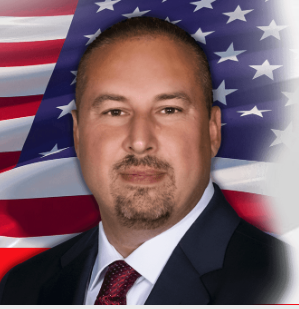
Adam J. Fischer
Adam Fischer does not currently have a profile available on Wikipedia. Communicating through his campaign page, he describes himself as “One pissed off American,” noting in his biographical information that he is a “Christian Republican.”
Fischer notes on his page that he was a police officer for six years before he broke his back. Told by doctors he might not walk again, Fischer writes that he “knew my Lord will heal me and I will return to work and life.” Fischer noted that he lives on a hobby farm in Mauston where he raises chickens and bees. He describes himself as a business owner, a participant in “corporate America,” and a member of the Teamsters Union. His campaign page can be found online. Information supplied by Ballotpedia about the candidate is here: https://ballotpedia.org/Adam_Fischer.
Candidates for U.S. Senator
While in recent days several candidates have dropped out of the running for an open U.S. Senatorial seat, including Democrats Alex Lasry, Sarah Godlewski and Tom Nelson, five Democratic challengers remain. They are Mandela Barnes, Steven Olikara, Kou Lee, Peter Peckarsky and Darrell Williams. On the Republican side, incumbent Sen. Ron Johnson will face Republican challenger David Schroeder. A winning candidate from within each party’s primary race will advance to the November election.

Ron Johnson
The senior U.S. Senator from Wisconsin, Ron Johnson assumed office in 2011, after defeating then-incumbent Russ Feingold. He has since served for two terms, winning a second election in 2016, beating Feingold in a race for the seat a second time. After pledging not to run for a third term, Johnson reconsidered, announcing his candidacy in January. Johnson is 67, married, and the couple has three children. According to his Wikipedia profile, Johnson was born in Mankato, Minn., and attended the University of Minnesota earning a degree in business and accounting. In 1979, he moved to Oshkosh and worked at a plastics company owned by his wife’s family. Described in his profile as a “staunch ally” of Donald Trump, Johnson voted for Trump’s Tax Cuts and Jobs Act in 2017, supported Trump’s decision to end Deferred Action for Childhood Arrivals (DACA), launched investigations into his political opponents and promoted false claims of fraud in relation to Trump’s defeat in the 2020 presidential election. He has rejected the scientific consensus on climate change. During the COVID-19 pandemic, Johnson resisted stay at home orders, used his chairmanship of the Senate Homeland Security Committee to invite witnesses to push fringe theories about COVID-19, and spread misinformation about COVID-19 vaccinations, according to his Wikipedia profile. His full Wikipedia profile is here: https://en.wikipedia.org/wiki/Ron_Johnson_(Wisconsin_politician). Information supplied by Ballotpedia about the candidate is here: https://ballotpedia.org/Ron_Johnson_(Wisconsin).

David Schroeder
David Schroeder does not currently have a profile available on Wikipedia. According to his campaign page, he is a semi-retired civil servant, citing his service as a former educator and postal employee, and has also operated, along with his wife, as a small rental property business owner. He was born in Wisconsin and holds a master’s degree in sociology from the University of Wisconsin-Milwaukee. He also holds a bachelor’s degree in physics. Schroeder’s campaign page can be found online. Information about the candidate supplied by Ballotpedia is here: https://ballotpedia.org/David_Schroeder_(Wisconsin).

Mandela Barnes
The 45th lieutenant governor of Wisconsin, Mandela Barnes assumed office in 2019. He was preceded by Rebecca Kleefisch. Prior to holding his current position, he was a state representative serving the 11th district, holding that seat from 2013 to 2017. According to his Wikipedia profile, Barnes is the first African American to assume Wisconsin’s lieutenant governorship. Barnes in 35 years old. He was born in Milwaukee and holds a bachelor’s degree from Alabama A&M University. Additionally, his profile notes information under a heading of “2018 Tax Delinquencies,” stating that in that year, Barnes did not pay his city of Milwaukee tax bill, owing $2,225.43 with interest and penalties as of mid-June 2019. He also was found guilty by a Milwaukee municipal judge for not paying three parking tickets and was fined $108. Under a heading of “College Degree Credibility Issues,” the website states, that Barnes did not graduate from Alabama A&M in the year that he had previously stated, but did receive his diploma in 2020. Professionally, Barnes worked for various political campaigns and in the office of Milwaukee Mayor Tom Barrett, eventually becoming an organizer for M.I.C.A.H., a Milwaukee-based interfaith coalition that advocates social justice. Barnes served as the deputy director of strategic engagement for State Innovation Exchange, a national progressive public policy organization based in Madison. His full Wikipedia profile is here: https://en.wikipedia.org/wiki/Mandela_Barnes. Information supplied by Ballotpedia about the candidate is here: https://ballotpedia.org/Mandela_Barnes.

Steven Olikara
Steven Olikara does not currently have a profile available on Wikipedia. According to his campaign page, he is the son of Indian immigrants, an entrepreneur and nonprofit leader. His page states: “He attended Wisconsin public schools and graduated as a University of Wisconsin Badger.” He grew up in the Greater Milwaukee area, the page notes, and found his path to public service through music, playing in multiple bands and becoming a DJ for a community-focused radio station. Olikara is the founder and CEO of Millennial Action Project, which, the page states, “is the largest nonpartisan organization of young legislators in the country.” His campaign page can be found online. Information about the candidate supplied by Ballotpedia is here: https://ballotpedia.org/Steven_Olikara.

Kou Lee
Kou Lee does not currently have a profile available on Wikipedia. According to his campaign page, Lee is a native of Laos. His page expresses his concerns about “pitting people against each other,” calling such behavior a “cancer polluting our discourse and sickening our democracy.” On his page, Lee describes fleeing with his parents from the “atrocities in Laos,” during the aftermath of the Vietnam War, arriving in Thailand. He next lived in a Hmong refugee camp until his family could come to American. Lee holds a degree from Michigan State University, and, his page states, has enjoyed a successful career in business. His campaign page can be found online. Information about the candidate as supplied by Ballotpedia is here: https://ballotpedia.org/Kou_Lee.

Peter Peckarsky
Peter Peckarsky does not currently have a Wikipedia profile. According to his campaign page, he was born and raised in Milwaukee, and holds degrees in electrical engineering and political science from the Massachusetts Institute of Technology (MIT). He also holds a law degree from Case Western Reserve University. According to his page, “Sen. Edward M. Kennedy placed Mr. Peckarsky’s senior thesis in the Congressional record in support of his opposition to the Anti-Ballistic Missile system.” His page notes that Peckarsky has worked as an investigative reporter and White House correspondent in Washington and elsewhere. His campaign page can be found online. Information about the candidate as supplied by Ballotpedia is here: https://ballotpedia.org/Peter_Peckarsky.
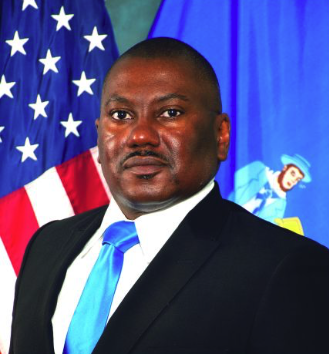
Darrell Williams
Darrell Williams does not currently have a Wikipedia profile. According to his campaign page, he was too poor to be born in a hospital and was instead delivered by a midwife in Mississippi. As a child, his page states, he learned the value of hard work picking cotton in the fields. Earning $3.35 an hour, his mother raised six children. On his page, Williams writes that he understands the importance of having “a job that pays a family supporting wage.” When he was 16, Williams notes, he joined the U.S. Army. He attended Rust College, which he described as “an excellent historically Black college,” and came to Wisconsin where he served for 25 years as an educator, principal, interim superintendent of schools, and was selected as National Principal of the Year by the National Alliance of Black School Educators in 2013. Williams’ campaign page can be found online. Information about the candidate as supplied by Ballotpedia is here: https://ballotpedia.org/Darrell_Williams.
Candidates for Lieutenant Governor
Two Democratic challengers, Peng Her and Sara Rodriguez, will race for a place as the Democratic candidate for lieutenant governor on the November ballot, and eight Republicans will race against one another for a place on the November ballot as the Republican candidate. They are: Patrick Testin, Will Martin, Kyle Yudes, Roger Roth, David C. Varnam, Cindy Werner, David D. King and Jonathan Wichmann.

Peng Her
Peng Her does not currently have a Wikipedia profile. According to his campaign page, he is a first-generation American arriving in the U.S. from Laos when he was 5. The Her family arrived in Des Moines, Iowa, in 1976 and became citizens in 1986. Her worked at a Pella Windows factory to put himself through college, earning a bachelor’s degree in physics and a master’s degree in applied physics both from DePaul University. He notes that he was the first Hmong physicist to work at the Argonne National Laboratory in Chicago. He moved to Madison and met his wife. In Madison, he ran a restaurant for five years, before selling it. According to the page, Peng has worked with the nationally renowned UW-Madison Institute for Research on Poverty where he was part of the DreamUP Wisconsin initiative, a community-university collaboration to expand economic opportunity. Most recently, he has served as the founder and CEO of the Hmong Institute, a nonprofit focused on providing education, training and outreach to improve healthcare and educational achievement for communities of color around Wisconsin. His campaign page can be found online. Information provided by Ballotpedia about the candidate is here: https://ballotpedia.org/Peng_Her.

Sara Rodriguez
Serving in the Wisconsin Assembly representing district 13, Sara Rodriquez assumed office in 2021. District 13 includes constituents living in Brookfield, Elm Grove, and western Wauwatosa. Rodriguez, according to her Wikipedia profile, is a registered nurse. She is 47, and the parent of two children. She was born and raised in Milwaukee and holds a bachelor’s degree in neuroscience from Illinois Wesleyan University. After college, she volunteered with the Peace Corps and served for two years in Samoa. She has also volunteered with the World Health Organization. After returning to the U.S., she continued her education earning a bachelor’s degree and master’s degree in nursing from John Hopkins University. Professionally, she has worked as an ER nurse at Mercy Medical Center in Baltimore, and at the Center for Disease Control and Prevention (CDC) in its Epidemic Intelligence Service from 2004 to 2006. In 2011, she returned to Wisconsin and was employed as vice president of Clinical and Analytical Services at The Benefit Services Group, Inc., until 2014. She then worked three years as vice president of Clinical Services at Honeywell Life Care Solutions. From 2017 until her campaign for the Assembly in 2020, she was vice president for Population Health and Integrated Care Management at Advocate Aurora Health. Information about the candidate as provided by Ballotpedia is here: https://ballotpedia.org/Sara_Rodriguez.

Patrick Testin
Patrick Testin serves as president pro tempore of the Wisconsin Senate and represents district 24, which includes the cities of Stevens Point and Wisconsin Rapids. He assumed this, his second term, in 2021 and has served in the state Senate since 2017. Born in Madison, he is 34 years old and married. He holds a bachelor’s degree in political science earned in 2011 at the University of Wisconsin-Stevens Point. According to his Wikipedia profile, Testin made a run for an Assembly seat in 2012, but lost that bid. In 2016, he ran again, this time for a Senate seat. He was successful in that bid. Information supplied by Ballotpedia about the candidate is here: https://ballotpedia.org/Patrick_Testin.

Will Martin
Will Martin does not currently have a Wikipedia profile. According to his campaign page, Martin is a small business owner and cites his experience in Wisconsin’s Executive branch, working to lead reforms and other initiatives under Govs. Tommy Thompson and Scott Walker. Under Walker, he notes, he served as Wisconsin’s Strategic Workforce Initiatives director in the Department of Workforce Development. Under Thompson, he served as deputy director and helped implement “the nation’s most ambitions welfare-to-work reform,” Martin wrote. Martin’s campaign page can be found online. Information provided by Ballotpedia about the candidate is here: https://ballotpedia.org/Will_Martin.

Kyle Yudes
Kyle Yudes does not currently have a Wikipedia profile. According to his campaign page he was born in Green Bay and grew up in Oconto. After graduating from high school, he moved to Eau Claire where he has resided for the past 22 years. He is married and the father of five boys. Professionally, he has been an entertainer and promoter/coordinator, traveling across the U.S. and Canada for 25 years. Yudes writes: “For the past year, I have been traveling throughout Wisconsin and Minnesota educating, empowering and enlisting the people to run for office, starting in their own backyard.” Information suppled by Ballotpedia about the candidate is here: https://ballotpedia.org/Kyle_Yudes.

Roger Roth
President of the Wisconsin State Senate, Roger Roth has served in that body, representing constituents in the 19th district, since 2015. Prior to winning his Senate seat, he served in the Assemble, representing district 56, between 2007 and 2011, according to his Wikipedia profile. The 19th State Senate District includes northern Winnebago County and southwest Outagamie County, along with Appleton, Menasha and Neenah. Roth is 44. He was born in Appleton. He holds a bachelor’s degree from the University of Wisconsin-Oshkosh. Prior to entering politics, he worked for his family’s homebuilding business and served in the Wisconsin Air National Guard, joining in 2003. He served four tours of duty during the Iraq War. During the course of his political career, according to his profile, he supported a resolution backing a Republican lawsuit challenging the Affordable Care Act, the federal health care reform legislation signed into law by President Barack Obama. Information about the candidate provided by Ballotpedia is here: https://ballotpedia.org/Roger_Roth.

David C. Varnam
David Varnam does not currently have a Wikipedia profile. According to his campaign page, Varnam was first elected mayor of Lancaster in April 2016 after serving nearly three years as a member of the Common Council. Varnam stood up for taxpayers by vetoing a 40 percent stormwater fee increase, defeating a proposed wheel tax, and keeping Lancaster the city with the lowest property taxes in Grant County. He is a past president of Grant County Economic Development and a board member of the Lancaster Area Chamber of Commerce. He also has served as a U.S. congressional aide and represented the global Christian ministry, Focus on the Family, on federal issues as an issues response analyst. He has a bachelor’s degree in Christian studies and history minor from California Baptist University. Varnam is married, and the couple has two children. His campaign page can be found online. Information about the candidate provided by Ballotpedia is here: https://ballotpedia.org/David_Varnam.

Cindy Werner
Cindy Werner does not currently have a Wikipedia profile. Information on Werner’s campaign page states that she is a “sibling of twelve raised by a single mom in the projects,” and a mom of seven and grandmother of four. She is an Army veteran and a state ambassador of the Frederick Douglas Foundation-Wisconsin. She writes: “My family is from rural America. As children, my siblings and I worked in the field helping with the harvest. Upon the death of my father, our family moved north and lived in the projects. Graduating from high school, I joined the Army; later in life, I worked in the private sector for healthcare and compliance. All of my choices in life have always been about service and commitment to God, family, and community.” Information about this candidate provided by Ballotpedia is here: https://ballotpedia.org/Cindy_Werner.

David D. King
David King does not currently have a Wikipedia profile. According to his Ballotpedia profile, King ran in 2016 as a nonpartisan Milwaukee City Council candidate is District 9. He was defeated in a primary election. In 2014, King sought election to the U.S. House of Representatives to represent the 4th Congressional District. He was defeated in the primary. In 2012, King was an Independent candidate for District 4 of the Wisconsin State Senate. His first bid for state legislative office was in 2008, when he ran successfully for a seat in the Wisconsin State Assembly. In 2010, King ran as a challenger against longtime incumbent Douglas La Follette for the office of Wisconsin Secretary of State. His bid was unsuccessful. Professionally, King has served as a neighborhood security aide and has managed restaurants in the Milwaukee area. He has also worked to establish youth programs and a prison ministry with the goal of rehabilitating prison inmates. Information provided by Ballotpedia about the candidate is here: https://ballotpedia.org/David_King_(Wisconsin).

Jonathan Wichmann
Jonathan Wichmann does not currently have a Wikipedia profile. According to his campaign page, Wichmann received his formal education from Ottawa University where he majored in business administration and management information systems, with a minor in marketing. He notes that he has over a decade of corporate experience and eight years of experience as a small business owner. He writes: “I subscribe to the Austrian School of economics as it provides the foundation for the most economic participation and personal freedoms.” His campaign page can be found online. According his Ballotpedia profile he was born in Milwaukee and lists his religion as Christian. Information provided by Ballotpedia about this candidate is here: https://ballotpedia.org/Jonathan_Wichmann.
Candidates for Attorney General
Democratic incumbent Attorney General Josh Kaul is running unopposed by challengers from within his party. In November, he will face the Republican challenger emerging successfully Aug. 9. Republican challengers include Eric Toney, Karen Mueller and Adam Jarchow.

Josh Kaul
The 45th Attorney General of Wisconsin, Josh Kaul assumed office in 2019. His predecessor was Brad Schimel. Kaul, 41, according to his Wikipedia profile, is the son of Peg Lautenschlager, an attorney and politician, and Raj Kaul. His stepfather, Bill Rippl, served as a police officer. He was raised in Oshkosh and Fond du Lac. Kaul graduated from Yale University double majoring in history and economics, and earned his law degree from Stanford Law School. Over the course of his career, Kaul clerked for Michael Boudin in the United States Court of Appeals for the First Circuit. From 2007 through 2010, he worked for the law firm Jenner & Block, and worked as a federal prosecutor in the U.S. Attorney‘s office in Baltimore through 2014. He next moved back to Wisconsin and joined the law firm Perkins Coie‘s Madison office. In 2018, Kaul won his bid for attorney general. He is married, and the couple has two children. Information provided by Ballotpedia about the candidate is here: https://ballotpedia.org/Josh_Kaul.

Eric Toney
Eric Toney does not currently have a Wikipedia profile. According to his campaign page, Toney was first elected as Fond du Lac County district attorney in 2012. Since then, he has successfully prosecuted crimes as varied as homicide, sexual assault, domestic violence, drug trafficking, financial crimes, and racketeering. Additionally, the page states, Toney helped establish a drug treatment court in Fond du Lac County and recognizes that the state needs to take an “all of the above” approach toward dealing with the ongoing methamphetamine and opioid epidemics that have raged in Wisconsin. Toney earned his undergraduate degree from St. Norbert College in De Pere, with a double major in history and political science. He graduated from law school at Hamline University where he focused on criminal law and received a certificate in Alternative Dispute Resolution. While in school, Toney served during summer months as an intern with the Fond du Lac District Attorney’s Office where he was inspired to spend his career in criminal law. Toney enjoys spending time with his family and his dog, “Patton.” Information provided by Ballotpedia about the candidate is here: https://ballotpedia.org/Eric_Toney.
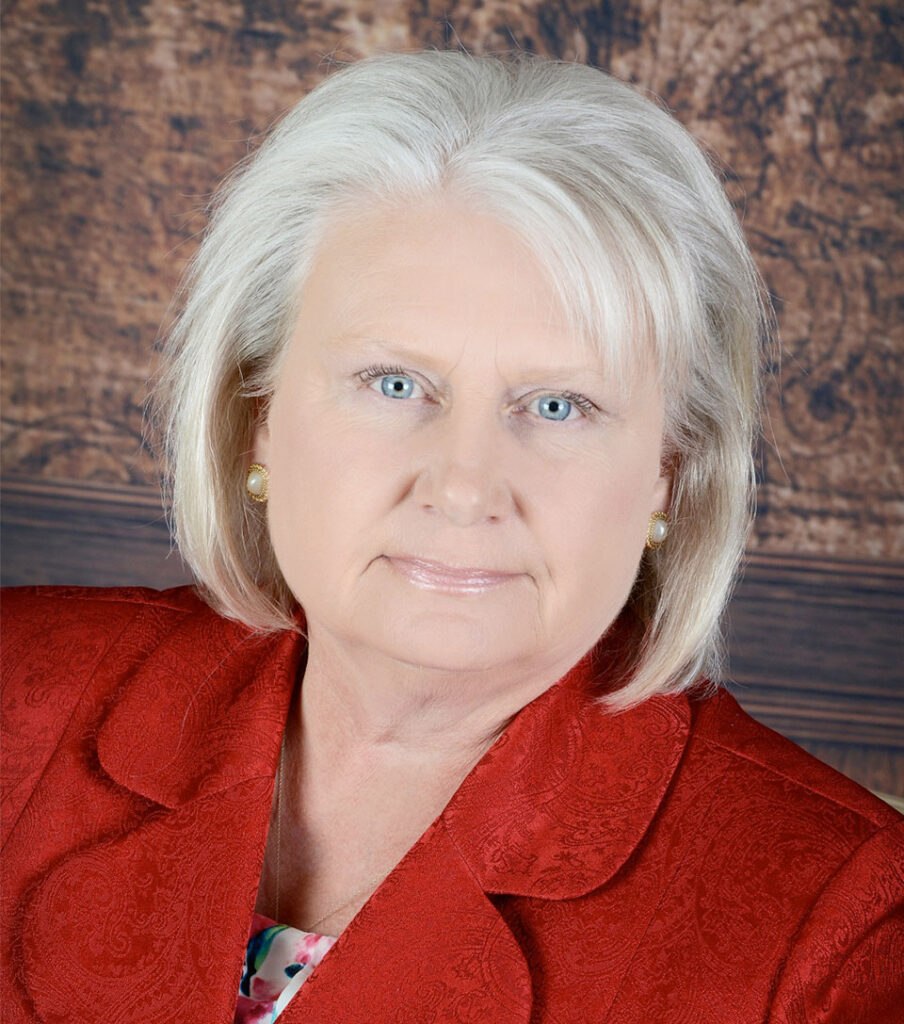
Karen Mueller
Karen Mueller does not currently have a Wikipedia profile. According to Mueller’s campaign page, she is a civil rights attorney from Chippewa Falls, where she resides with her family.
Over the past few years Mueller has fought to maintain election integrity, hold healthcare systems accountable for COVID deaths, and eliminate mask mandates in Wisconsin’s schools. Throughout her legal career, she has been a civil rights and employment law attorney in her own private practice and has worked with discrimination and harassment claims. On her page, she identifies as a “Christian, Constitutional and Conservative Attorney.” Among her credentials, she lists: founder of Amos Center for Justice and Liberty, Ally of Alliance Defending Freedom since 2008, and executive board member of the State Bar of Wisconsin Civil Rights Section since 2015. Her campaign page can be found online. Information provided by Ballotpedia about the candidate is here: https://ballotpedia.org/Karen_Mueller.

Adam Jarchow
A former member of the Wisconsin Assembly, Adam Jarchow represented constituents in district 28, assuming office in 2015, and leaving office in 2019. He was a special election candidate in 2018 for Wisconsin State Senate District 10, according to information presented on his Ballotpedia profile. He was unsuccessful in that bid. According to his Wikipedia profile, he is 43, and was born in Saint Paul, Minn. He earned his undergraduate degree and his law degree at the University of Florida. Jarchow grew up in Balsam Lake, Wis. After graduating from law school, he practiced law in Florida and Minnesota before returning to Wisconsin where he practiced law in New Richmond. Information provided about the candidate by Ballotpedia is here: https://ballotpedia.org/Adam_Jarchow.
Candidates for Secretary of State
Democratic incumbent Secretary of State Doug La Follette will face Democratic challenger Alexia Sabor in a race to claim a spot on the November ballot. The successful candidate will face the successful Republican challenger, who, on Aug. 9, will be chosen by that party’s voters from a field of three. They are Amy Loudenbeck, Jay Schroeder and Justin Schmidtka.

Doug La Follette
Doug La Follette, according to his Ballotpedia profile, has held the position of Secretary of State since 1983. According to his Wikipedia profile, he has served under six governors including Tony Earl, Tommy Thompson, Scott McCallum, Jim Doyle, Scott Walker and Tony Evers. Ballotpedia reports that La Follette ran unsuccessfully for lieutenant governor in 1978.
La Follette unsuccessfully ran for Wisconsin Governor in the 2012 recall election against incumbent Gov. Scott Walker, losing in the primary. An issue in the recall election was Wisconsin Act 10, which involved collective bargaining rights. Following its passage, La Follette delayed the bill’s publication. Subsequently, a bill was passed in 2013 to strip the secretary of state of the power to delay the publication of new laws. La Follette served in the Wisconsin State Senate representing Kenosha County for one term, from 1972 to 1974. He ran for the United States Senate in 1988 and for Wisconsin’s 1st Congressional District in 1970 and 1996, losing in the primary each time. La Follette holds several degrees, including a bachelor’s degree from Marietta College earned in 1963 in business, a master’s degree from Stanford University earned in 1964 in chemistry, and a doctoral degree from Columbia University earned in 1967 in organic chemistry. He began his career as an assistant professor at the University of Wisconsin-Parkside. La Follette is 82. Information provided about the candidate by Ballotpedia is here: https://ballotpedia.org/Douglas_La_Follette.

Alexia Sabor
Alexia Sabor does not currently have a Wikipedia profile. According to her campaign page, Sabor’s great-great grandparents arrived in Wisconsin from Greece in search of a better life. They settled in Sheboygan County, which is where her maternal grandmother was born. Sabor was born in Illinois, but moved to Wisconsin as a young adult. She has lived in Wisconsin for 28 years. Sabor and her family live in Madison. Sabor lists on her campaign page several of her defining characteristics, including that she is a first-generation college student, has lived in rental housing for decades, has survived cancer and is a “certified patient advocate,” and is an environmental science professional. For the last 15 years, she has worked as a project manager for a nonprofit organization and a tech company, according to her page. Sabor’s campaign page can be found online. Information provided about the candidate by Ballotpedia is here: https://ballotpedia.org/Alexia_Sabor.

Amy Loudenbeck
A member of the Wisconsin State Assembly, Amy Loudenbeck represents constituents in District 31. She has held her Assembly seat since 2011, according to her Ballotpedia profile. Loudenbeck graduated in 1991 from the University of Wisconsin-Madison with two bachelor’s degrees, one in political science and a second in international relations. Loudenbeck is a former supervisor for the town of Clinton. Professionally, she has been self-employed as a business coach, compliance consultant and landlord of a mobile home park, and served as vice president of Stateline World Trade Association Board of Directors. Loudenbeck is 52 and married. According to her campaign page, Loudenbeck and her husband live in Rock County. The couple met when they were serving on a volunteer fire department and living in Walworth County. Loudenbeck’s campaign page can be found online. Information provided about the candidate by Ballotpedia is here: https://ballotpedia.org/Amy_Loudenbeck.

Jay Schroeder
Jay Schroeder does not currently have a Wikipedia profile. According to his campaign page, Schroeder has a bachelor’s degree in business administration and an associates degree in applied science in real estate. He has owned and managed a mortgage company for 15 years and invests in real estate equities. He is married, and the couple has four children. The family resides in Neenah. According to his Ballotpedia profile, in 2014, Schroeder was a candidate running for an Assembly seat representing the 55th district. He was defeated in the primary. Also in 2014, prior to running for that seat, he was “briefly” a candidate for the position of Wisconsin Secretary of State. He has also served as a town supervisor in Menasha. Schroeder’s campaign page can be found online. Information provided about the candidate by Ballotpedia is here: https://ballotpedia.org/Jay_Schroeder.

Justin D. Schmidtka
Justin Schmidtka does not currently have a Wikipedia profile. According to information found on his Ballotpedia profile, Schmidtka was born in Mesa, Ariz. He served in the U.S. Marine Corps from 2006 to 2009. Schmidtka graduated from the Reinhardt School of Taxidermy in 2009. His career experience includes working as a truck driver and host and founder of the Badger State Resistance podcast. According to his campaign page, Schmidtka is “a constitutional patriot,” husband and father. He served as an on-call firefighter for the village of Howard from 2015 to 2020. Schmidtka’s campaign page can be found online. Information provided about the candidate by Ballotpedia is here: https://ballotpedia.org/Justin_Schmidtka.
Candidates for State Treasurer
Three Democrats running for state treasurer, including Aaron Richardson, Angelito Tenorio and Gillian Battino will face off with the successful candidate emerging as the Democratic challenger in November. Two Republicans, including John Leiber and Orlando Owens, will vie for placement on the November ballot as their party’s candidate.

Aaron Richardson
Aaron Richardson does not currently have a Wikipedia profile. According to his Ballotpedia profile, Richardson was born in Madison. He earned a bachelor’s degree from the University of Wisconsin-Green Bay in 2000 and an MBA from the University of Wisconsin-Whitewater in 2012. Richardson’s career experience includes serving as the mayor of Fitchburg and working in tech support within the Oregon School District. According to his campaign page, he is the fifth generation of his family to live in Fitchburg. Before taking his position with the Oregon School District, he worked for 16 years in marketing at various companies. He also serves as a youth basketball coach. Richardson’s campaign page can be found online. Information provided about the candidate by Ballotpedia is here: https://ballotpedia.org/Aaron_Richardson_(Wisconsin).

Angelito Tenorio
Angelito Tenorio does not currently have a Wikipedia profile. According to his campaign page, Tenorio immigrated to the United States with his parents from the Philippines in hopes of finding a better life. The family decided to move to Wisconsin. Tenorio wrote that he and his siblings were born and raised in Southeastern Wisconsin. Both of his parents were postal workers. Tenorio earned an undergraduate degree in political science from the University of Wisconsin-Madison. While in college, he enlisted in the Wisconsin National Guard. “I proudly served and conducted my drill all across Wisconsin from Fort Atkinson to Watertown to Camp Douglas and Fort McCoy,” he noted. Professionally, Tenorio wrote that he has worked in “political finance for a number of years,” and he is working with a nonprofit, environmental group called Wisconsin Conservation Voters. He has also served as an alderman in West Allis. Tenorio’s campaign page can be found online. Information provided about the candidate by Ballotpedia is here: https://ballotpedia.org/Angelito_Tenorio.

Gillian Battino
Gillian Battino does not currently have a Wikipedia profile. According to her Ballotpedia profile, Battino was born in Athens, Ohio. She earned a bachelor’s degree from John Carroll University in 1992. She earned an M.D. from the Ohio State University College of Medicine in 1996. She earned a graduate degree from the University of Wisconsin-Madison in 2011. Battino is the director of Rad-AID Latin America. She is affiliated with the NAACP Milwaukee branch, American College of Radiology, Wisconsin Medical Society, and Radiologic Society of North America. According to her campaign page, Battino lives in Wausau with her husband and two children. Her campaign page can be found online. Information provided about the candidate by Ballotpedia is here: https://ballotpedia.org/Gillian_Battino.

John Leiber
John Leiber does not currently have a Wikipedia profile. According to his Ballotpedia profile, Leiber ran for a seat in the Wisconsin State Assembly District 62. He lost that bid during the primary held in 2018. According to his campaign page, Leiber’s hometown is Racine, where, the page states, his ties go back four generations. He has served as the president of his local parks and recreation commission and as a commissioner for his local housing authority. He holds a bachelor’s degree in history from the University of Wisconsin-Parkside and earned his law degree from the University of Wisconsin Law School. He is married, and the couple has three adult children. Leiber lives in Cottage Grove. His campaign page can be found online. Information provided about the candidate by Ballotpedia is here: https://ballotpedia.org/John_Leiber.

Orlando Owens
Orlando Owens does not currently have a Wikipedia profile. On his campaign page, Owens wrote: “Being a Historically Black College and University (HBCU) grad from Morris Brown College of Business, I understand how economics work based on a credit and deficit basis to prioritize the allocation of funds to projects and initiatives that are working. Through my 20 years in economic and workforce development, I understand how to make an economy work better to meet the needs of our community on a much more personal level.” Additionally, he wrote: “As a Minister at Abundant Harvest Church Of God In Christ, my faith plays a major part in everything I do.” Owens wrote that he had been blessed to work with two great men, U.S. Sen. Ron Johnson, and Pastor Jerome Smith of Greater Praise Church of God in Christ. Together, the three have created a faith-based workforce initiative called the Joseph Project, which, Owens, noted, helps connect individuals with career opportunities, specifically in the manufacturing industry. Owens’ campaign page can be found online. Information provided about the candidate by Ballotpedia is here: https://ballotpedia.org/Orlando_Owens.
Whitewater school district press release: board approves November ballot operational referendum
(Originally published Aug. 5, 2022.)
Editor’s note: The following press released information was released Wednesday by the Whitewater Unified School District to its Facebook page.
On Monday, July 25, the Whitewater Unified School District School Board approved an operational referendum question that will appear on the ballot Tuesday, November 8, 2022.
If approved, the referendum would renew a similar measure voters passed in 2018. That non-recurring operational referendum, which has now expired, has allowed WUSD to exceed its state-imposed revenue limit to fund critical programs and services for students.
With the November referendum, the district and board are not asking the community for additional funding, despite rising costs over the past several years. As a result, taxpayers will likely realize a reduction on their property tax bills.
“The 2018 voter-approved referendum has been critical to ensuring we can continue to provide programs and opportunities that allow our students to thrive and prepare them for the future. Now, we are returning to our community to ask them to renew these important funds,” said Thayer Coburn, Board President. “By placing this measure on the ballot, we are proposing a solution that allows us to maintain the programs and services available to our students now and in the years to come.”
In Wisconsin, the amount of money a school district receives is restricted by a revenue limit. Every district has its own revenue limit, which is impacted by the state budget every two years and is highly dependent on annual enrollment changes. WUSD’s revenue limit dictates the majority of its operational budget.
In recent years, state budgets have not increased revenue limits to keep up with inflation. Expenses for things like state- and federally mandated services, transportation, utilities, and insurance also continue to increase, as do other costs that are out of the district’s control.
If approved by voters, the November referendum would provide WUSD with extended revenue limit authority to maintain academic and athletic opportunities, student support and mental health services, comprehensive instructional and co-curricular programs, and technology and facilities infrastructure.
The funds would simply go toward maintaining these programs and services. The district does not have plans to expand offerings to students.
For more information on the district’s financial needs and the November 8 operational referendum, please visit www.wwusd.org/page/referendum.
Note: The original document from the Whitewater school district as it appeared on its Facebook page and as printed above, is here: https://www.wwusd.org/o/wwusd/article/796575. Fort Atkinson Online did not receive, as it has with some past documents, this document directly from the district’s communication office. Fort Atkinson Online has sent a formal request to the district to gain inclusion on all its media lists and has contacted Whitewater Unified School District Board of Education President Thayer Coburn by phone and email to help facilitate that request.
Update: Fort Atkinson Online has been contacted and added to the district’s media list. Fort Atkinson Online appreciates the prompt attention given to this matter.

Public domain/File photo.
Primary election guide: Jefferson, Walworth countywide races on Aug. 9 ballot
(Originally published Aug. 8, 2022.)
Compiled by Kim McDarison
Across the state of Wisconsin voters will be heading to the polls on Tuesday, Aug. 9.
Polling places are open from 7 a.m. to 8 p.m.
The partisan primary will see races in which multiple candidates from within each political party are vying for an open seat. Winners in the primary election will advance to the Nov. 8 general election, during which the winners for each open seat will ultimately be decided.
One candidate from each party vying for each available seat will advance to the general election.
Voters are asked to select candidates on the primary ballot from within a single party.
Voters looking to check their registration status as well as find their polling place can visit: https://myvote.wi.gov/en-us/.
Names of countywide candidates running for U.S. House of Representatives, the State Senate, Assembly, sheriff and clerk of circuit court will be found on the primary ballot.
Brief biographical information for each of the candidates follows.
A story about candidates whose names will appear on the primary ballot running in statewide races is here: https://fortatkinsononline.com/primary-election-guide-statewide-races-on-aug-9-ballot/.
U.S. House of Representatives
Across the state of Wisconsin, there are eight congressional districts. A map showing the eight districts is here: https://www.zipdatamaps.com/politics/national/districts/map-of-wisconsin-congressional-districts.
Jefferson County
Jefferson County is included within Wisconsin’s 5th Congressional District.
Voters within the district, including Fort Atkinson and the portion of Whitewater residing in Jefferson County, will find the names of the Republican incumbent Scott Fitzgerald, who is running for his party’s nomination as a candidate for the U.S. House of Representatives seat, and Mike Van Someren, who is running in the Democratic primary for nomination to the seat. Both will advance to the November election.
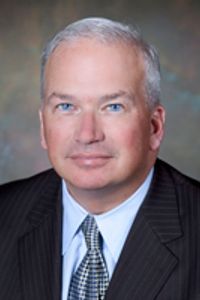
Scott Fitzgerald
According to his official website, Scott Fitzgerald was elected to the U.S. House of Representatives in 2020. Prior to his election to Congress, he served in the Wisconsin State Senate representing the 13th District from 1995 to 2021. Fitzgerald joined the U.S. Army Reserve in 1981 and was commissioned as a lieutenant in the Armor Branch in 1985. He completed the Army Command and General Staff College and served in a number of assignments during his 27 years of service, including Battalion Commander. In 2009, he retired from service at the rank of Lieutenant Colonel. Born in Chicago, he moved to Wisconsin, graduated from Hustisford High School, and earned a bachelor’s degree from the University of Wisconsin-Oshkosh in 1985. He is a former owner of the Dodge County Independent News in Juneau and the Watertown Daily Times. His father, Stephen Fitzgerald, was sheriff of Dodge County for 14 years, served as the U.S. Marshal for the Western District of Wisconsin and most recently served as the superintendent of the Wisconsin State Patrol until his retirement in 2016. His brother, Jeff, was an Assembly Representative from Dodge County who served as the Assembly Speaker for the 2011-2012 legislative session. Scott and his wife live in Clyman. The couple has three children. Fitzgerald’s official website can be found online. His Ballotpedia profile is here: https://ballotpedia.org/Scott_Fitzgerald.

Mike Van Someren
According to his campaign page, Mike Van Someren is the son of an over-the-road truck driver. He is a former public school basketball and football player, and played football in college at UW-Madison and UW-River Falls. He holds a bachelor’s degree in history. He holds a law degree from Marquette Law School. Van Someren began his law career in Waukesha, focusing on real estate law. He serves on the board of Habitat for Humanity of Waukesha County and the Veterans Community Foundation. He has also served as a board member of ArtWorks for Milwaukee. Van Someren is married and the couple has two children. The family lives in Delafield. His campaign page can be found online. His Ballotpedia profile is here: https://ballotpedia.org/Mike_Van_Someren.
Walworth County
Most of Walworth County is included within Wisconsin’s 1st Congressional District.
Voters within the district, including those living in the Walworth County portion of the city of Whitewater, will find the names of the Republican incumbent Bryan Steil, who is running for his party’s nomination as a candidate for the U.S. House of Representatives seat, and Ann Roe, who is running in the Democratic primary for nomination to the seat. Both will advance to the November election.
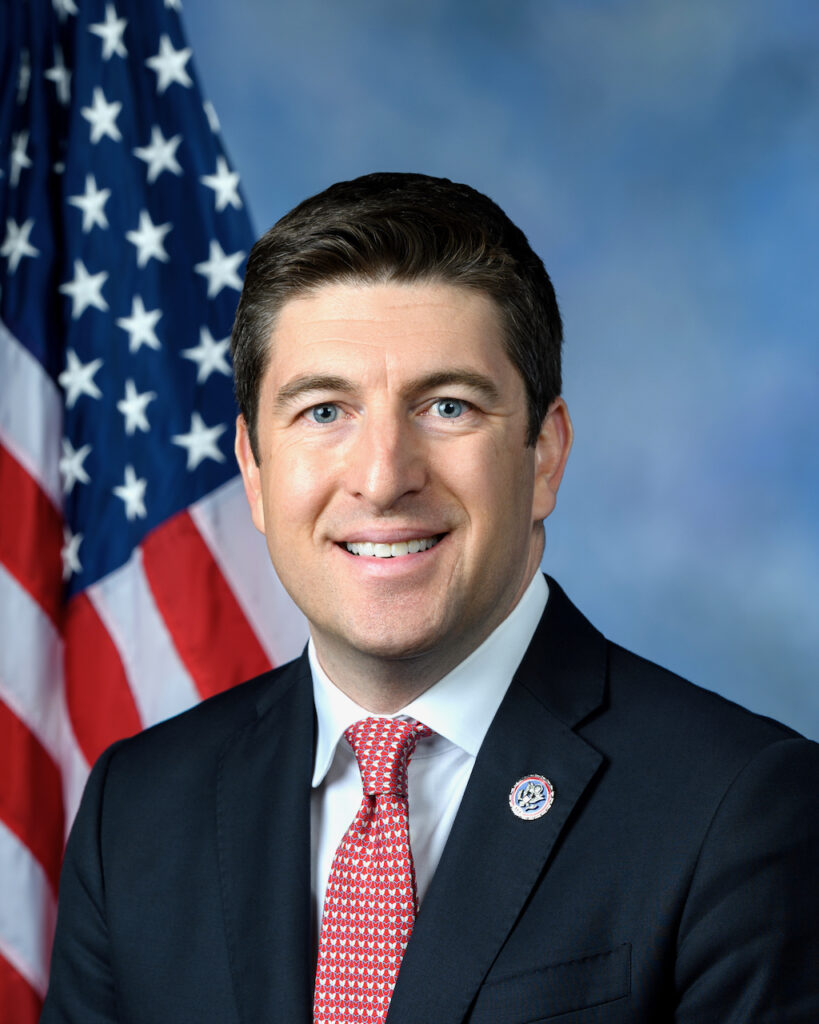
Bryan Steil
According to his official website, Bryan Steil was first elected to the U.S. House of Representatives in Wisconsin’s 1st District in 2018. His predecessor was Paul Ryan. Prior to his election, Steil worked in Wisconsin’s manufacturing industry, first with an industrial motion control manufacturer in Beloit, and then with a plastics manufacturer in Milton. In 2016, he was appointed to serve on the University of Wisconsin Board of Regents. He is a native of Janesville, graduating from Janesville Craig High School, and has attended Georgetown University and the University of Madison Law School. Steil’s official website can be found online. His Ballotpedia profile is here: https://ballotpedia.org/Bryan_Steil.
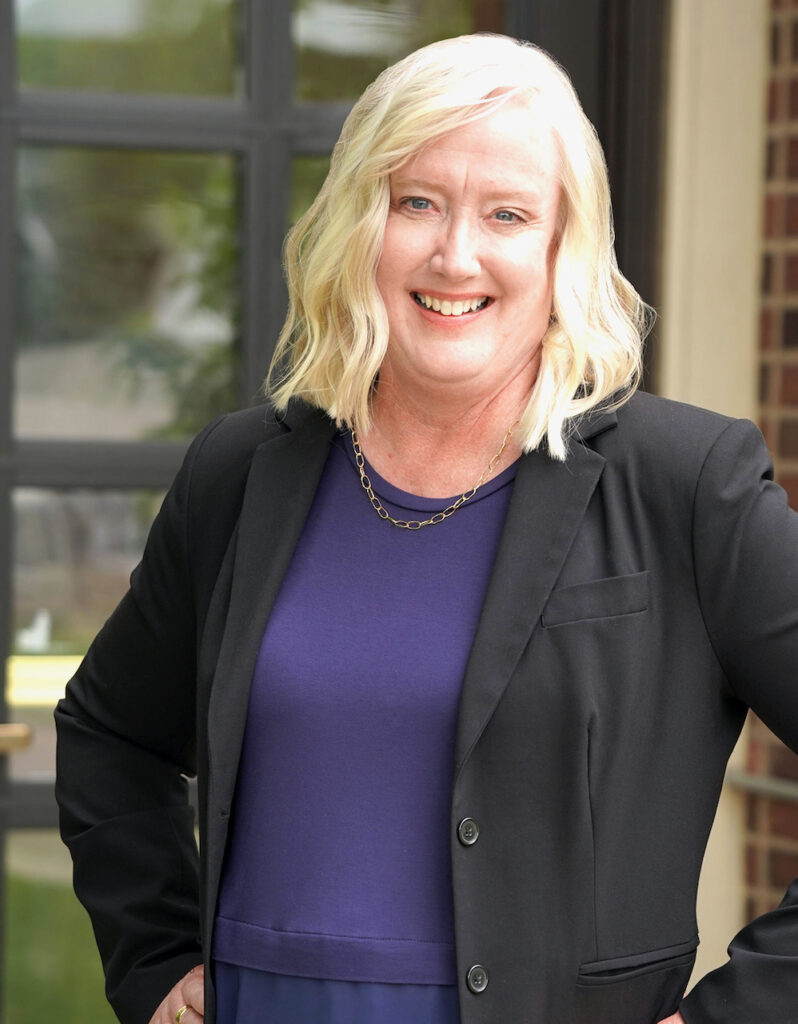
Ann Roe
According to her campaign page, Ann Roe is a small business owner, former educator, working mom and the daughter of a Korean War veteran. She has worked in corporations, small businesses, nonprofits and the educational system. She has served as president of the Downtown Janesville board for the last year. She has lived in Janesville for 25 years, with her husband, who is a pediatrician. The couple has two children. Roe’s campaign page can be found online. Her Ballotpedia profile is here: https://ballotpedia.org/Ann_Roe.
State Senator
Wisconsin Legislative maps underwent redistricting in April. New maps adopted will remain in place for the next 10 years. Within Wisconsin, there are 99 Assembly districts and 33 State Senate districts. A story about the state’s new maps is here: https://fortatkinsononline.com/musical-maps-assembly-and-state-senate-districts-drawn/.

Senate District 11, shown above, is represented by State Sen. Stephen Nass, R-Whitewater, and contains Assembly Districts 31, 32 and 33. The district includes, in part or full, the communities of Jefferson, Helenville, Sullivan, Fort Atkinson, Hebron, Palmyra, Whitewater, Milton, Avalon, Elkhorn, Delavan, Johnstown, Richmond, Darien, Clinton, Sharon, Williams Bay, Lake Geneva, Fontana, Walworth, Beloit and Genoa.
Voters within Senate District 11, will find two candidates on the ballot. They are the incumbent, Nass, running for the Republican party nomination, and Steven J. Doelder, who is running for the Democratic party nomination. Both will advance to the November election.

Stephen Nass
According to his Ballotpedia profile, Stephen Nass has served in his position as State Senator for seven years, assuming office in 2015. Prior to serving in that role, he served in the State Assembly from 1990 to 2015. From 1978 to 1981, he served on the Whitewater Common Council. Nass is a graduate of Whitewater High School and holds a bachelor’s degree from the University of Wisconsin-Whitewater and a master’s degree in school business management. He has served professionally as a negotiator/payroll benefits analyst. He is a member of the Wisconsin Air National Guard, and served in the Middle East in operations Desert Shield and Desert Storm. He also is a member of the American Legion, Veterans of Foreign Wars, the Mukwonago Business Breakfast Club and Jefferson County Agribusiness Club. His official website can be found online. His Ballotpedia profile is here: https://ballotpedia.org/Stephen_Nass.

According to his Ballotpedia profile, Steven J. Doelder was born in Sheboygan. He holds a bachelor’s degree from the University of Wisconsin-Stevens Point and a graduate degree from Carthage College. According to his campaign page, Doelder also holds an associate degree from Gateway Technical College. He completed his certification in teaching chemistry awarded through UW-Madison, and has served professionally as a lifelong teacher. He has served as president of the Racine Education Association. He also has written columns for the Racine Labor paper and the Lake Geneva Regional News. Doelder is the father of two grown children. His campaign page can be found online. His Ballotpedia profile is here: https://ballotpedia.org/Steven_Doelder.
State Assembly seats
In April, new maps were adopted for the 99 State Assembly districts. Among them are districts 33, which includes the city of Fort Atkinson and a portion of Whitewater which resides in Jefferson County, and 31, which includes the portion of the city of Whitewater which resides in Walworth County.

Assembly District 33, shown above, underwent changes from its earlier configuration in place before new maps were adopted in April. Earlier changes made to the boundaries of Assembly District 33, which had formerly included a portion of Mukwonago, left Rep. Cody Horlacher, R-Mukwonago, residing outside of his district. He has since announced that he will not seek another term in the Assembly.
Before final maps were adopted in April, an earlier set of redistricted maps was briefly adopted in February. Within the earlier set, the 33rd Assembly District included portions of Jefferson, Waukesha and Walworth counties, holding within its boundaries the communities of Cambridge, Jefferson, Fort Atkinson, Hebron, Palmyra, Eagle and Mukwonago.
After maps were adopted in February, boundaries excluded Mukwonago and added, in part or full, the communities of Johnson Creek, Rome, Sullivan, Ixonia, Lebanon, Neosho and Watertown.
Final maps approved in April included the communities, in part or full, of Fort Atkinson, Jefferson, Milton, Helenville, Hebron, Sullivan, Oakland and Palmyra. A portion of the city of Whitewater, which resides in Jefferson County, also is included.
Also with the adoption of maps in April, Rep. Don Vruwink, D-Milton, no longer lives in the 43rd district which he represents. Before changes made in April, Vruwink had announced he would be running for reelection. His name will appear on the primary ballot as a candidate running for an Assembly seat representing the 33rd district.
Voters in the 33rd Assembly District will find three candidates on the ballot. They are Vruwink, the representative in District 43 who, after redistricting, is running for a seat in the 33rd District. Vruwink is the only Democrat seeking his party’s nomination in the primary. He will run in November against the prevailing Republican party nominee. The candidates are Scott Johnson and Dale Oppermann.

Don Vruwink
According to his Ballotpedia profile, Don Vruwink assumed office representing the state’s 43rd Assembly District in 2017. According to his campaign page, Vruwink grew up on a dairy farm in central Wisconsin. He holds a bachelor’s degree from the University of Wisconsin-Stevens Point and a master’s degree in social studies from UW-Whitewater. Now retired, he spent 42 years as a school teacher, serving, since 1979, as a history teacher at Milton High School. He also served as a coach for more than 90 high school teams. After retiring in 2011, Vruwink served on the Milton City Council and the Milton School Board. He has earned a Lifetime Achievement Award from the Milton Area Chamber of Commerce. Vruwink is married and the couple has one child. Vruwink’ campaign page can be found online. His Ballotpedia profile is here: https://ballotpedia.org/Don_Vruwink.
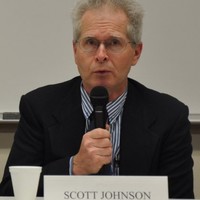
Scott Johnson
According to his Ballotpedia profile, Scott Johnson is a Republican candidate whose name will appear on the primary ballot. The profile offers no further information about the candidate. The candidate is a resident of Jefferson. According to his Linkedin profile, Johnson has served as a consultant for Johnson Enterprises for 38 years. The company provides farm and financial management and debt restructuring services. Johnson is a former member of the Fort Atkinson School Board, serving from 1999 to 2014. During that time, he writes, “I initiated and led the process of educating the school board, administration, staff, and public on the value of utilizing Geo-Thermal Energy Technology to retrofit four of our schools; replacing old inefficient conventional HVAC systems.” Johnson holds a bachelor’s degree in agricultural economics from the University of Wisconsin-Madison and is a graduate of the leadership program offered through the University of Wisconsin-Extension. He holds a master’s degree earned at UW-Whitewater in school business management. Johnson is a graduate of the Milton High School. His Linkedin profile can be found online. His Ballotpedia profile is here: https://ballotpedia.org/Scott_Johnson_(Wisconsin).
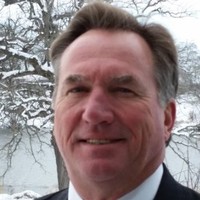
Dale Oppermann
According to his Ballotpedia profile, Dale Oppermann is a Republican candidate whose name will appear on the primary ballot. The profile offers no further information about the candidate. He is a resident of Jefferson. According to his Linkedin profile, Oppermann is the mayor of the city of Jefferson. He has served in that position for more than 12 years. Professionally, he has worked as a sales representative with Milwaukee Plate Glass Company for 26 years. Oppermann holds a bachelor’s degree in elementary education and business administration from the University of Wisconsin-Whitewater and lists additional education coming through Dr. Martin Lutheran College in elementary eduction. He earned his high school diploma through attendance at Lakeside Lutheran High School. Under “organizations,” Oppermann lists WPPI Energy Policy Communication and Leadership Council. Oppermann’s Linkedin profile can be found online. His Ballotpedia profile is here: https://ballotpedia.org/Dale_Oppermann.
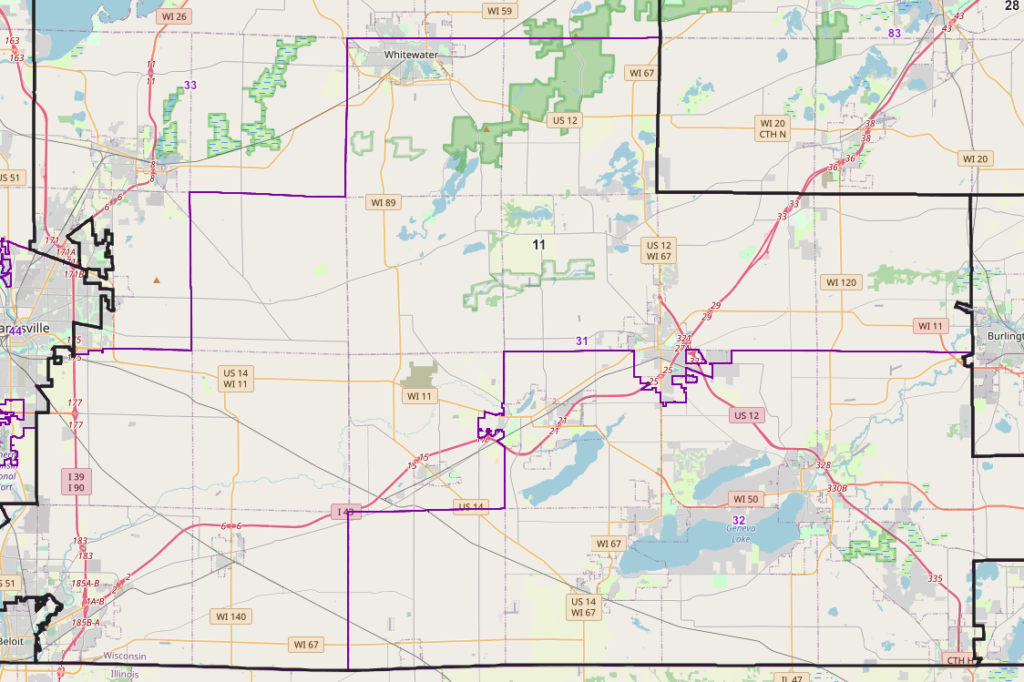
Assembly District 31, shown above, includes the following Rock and Walworth county communities, in full or part: Whitewater, Elkhorn, Darien, Avalon and Clinton.
Voters within the district will find four candidates on the ballot. Vying for the Republican nomination are Jason Dean, Ellen Schutt and Maryann Zimmerman. The successful candidate will face Democratic nominee Brienne Brown, who is the only Democratic candidate whose name will appear on the primary ballot.
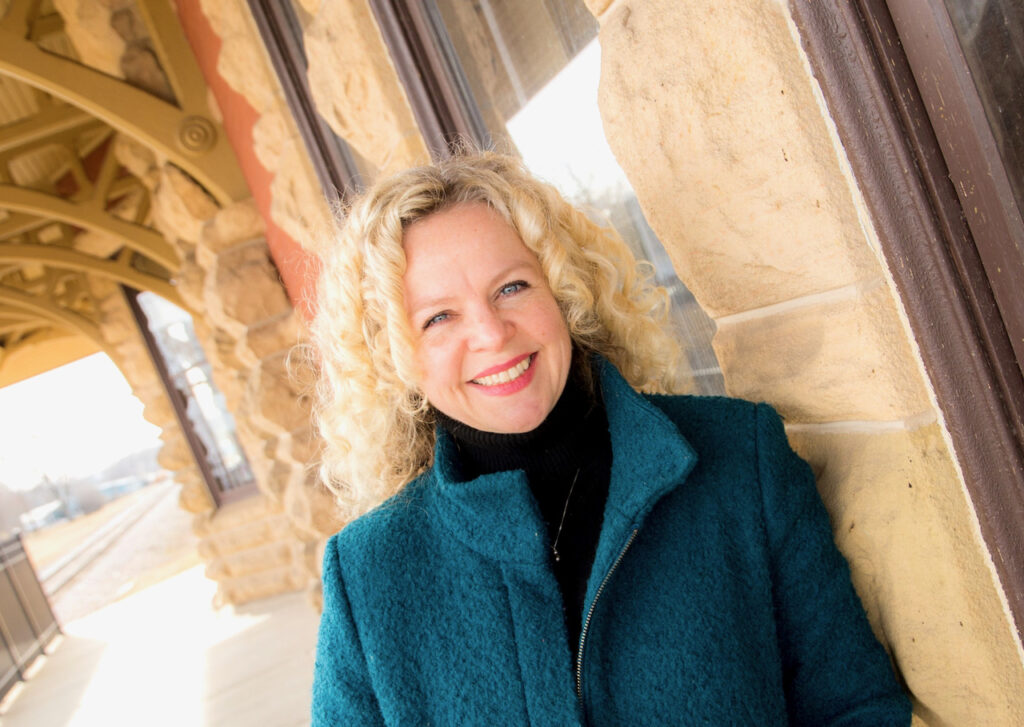
Brienne Brown
According to her Ballotpedia profile, Brienne Brown is running in the primary for a seat in the Assembly representing District 31. The profile offers no further information about the candidate. According to her campaign page, Brown has worked to create a weekly farmers market in Whitewater and has served on the Library Board. She helped reorganize the Whitewater Community Foundation, and writes grant proposals for the Whitewater Grocery Cooperative. She is serving her second term as a City of Whitewater Common Council member and serves on the city’s Plan Board. Brown and her husband both teach at the University of Wisconsin-Whitewater and Brown has worked as a managing editor for an open-source intelligence company, and as an epidemiologist for the Texas Department of Health. Brown’s campaign page can be found online. Her Ballotpedia profile is here: https://ballotpedia.org/Brienne_Brown.

Maryann Zimmerman
According to her Ballotpedia profile, Maryann Zimmerman was born in Milwaukee. According to her campaign page, she grew up in Milwaukee and Glendale, graduating from Nicolet High School and the University of Wisconsin-Milwaukee. She is married and has four children, ranging in age from 3 to 23. The family lives on a hobby farm. She has lived in Whitewater for seven years. She loves chickens and is a state certified pullorum tester. She is the president of the Whitewater Middle School PTO, and is a member of the Whitewater Unified School District Board of Eduction. Zimmerman writes that her family is involved in 4-H. She also serves on the Disability Rights and Equal Opportunities Commission for the city of Whitewater and the southeastern Wisconsin regional planning commission of food security. Zimmerman’s campaign page can be found online. Her Ballotpedia profile is here: https://ballotpedia.org/Maryann_Zimmerman.
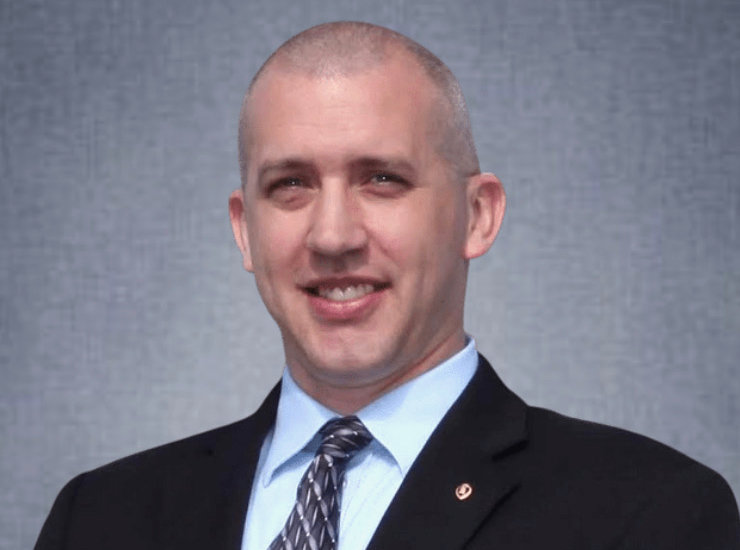
Jason Dean
According to his Ballotpedia profile, Jason Dean is running for an Assembly seat in District 31. The profile offers no further information about the candidate. According to his campaign page, he is a U.S. Marine Corps veteran, father of three, private sector business leader and an active volunteer. While serving as a Marine, he deployed for multiple tours of duty in Iraq. He received a Purple Heart Medal after he was wounded in action in 2006 by enemy fire. After retiring from the military, Dean volunteered for U.S. Rep. Bryan Steil’s campaign, serving as field director. Professionally, he works for ABC Supply Company, Inc., serving on a divisional leadership team. He also serves as an advanced EMT with the Lauderdale-LaGrange Fire Department and was elected to the Whitewater Fire Department, Inc., Board of Directors, serving as vice president. He is a member of the Veterans of Foreign Wars. Dean is married, and the family lives in LaGrange. Dean’s campaign page can be found online. His Ballotpedia profile is here: https://ballotpedia.org/Jason_Dean.
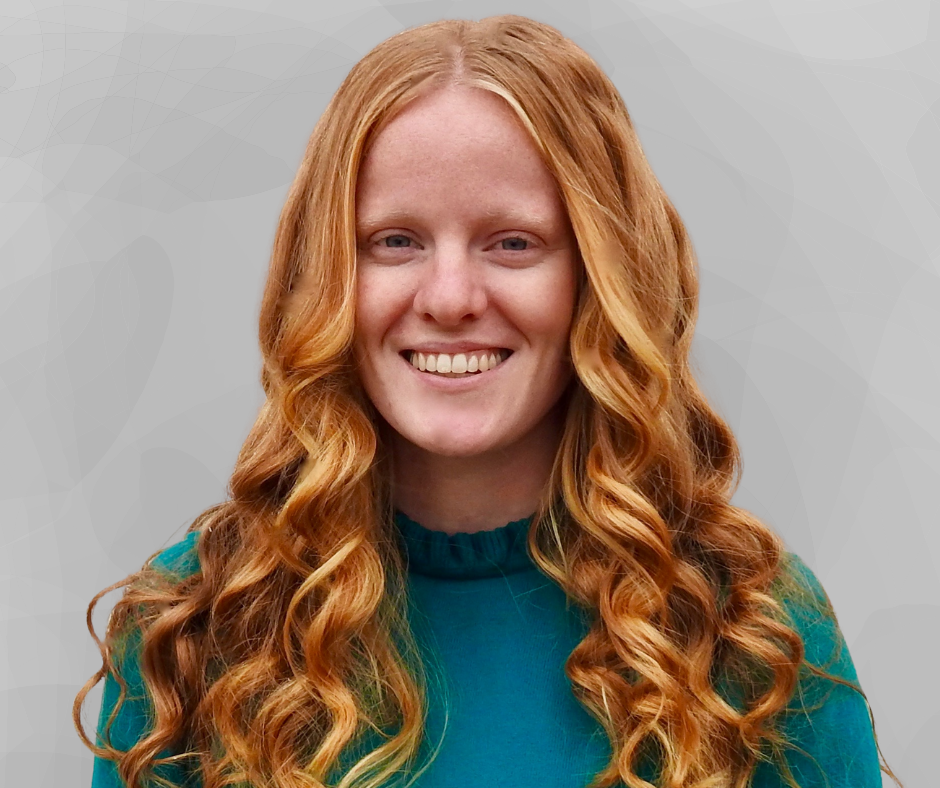
Ellen Schutt
According to her Ballotpedia profile, Ellen Schutt is running for a seat on the Assembly in District 31. The profile offers no further information about the candidate. According to her campaign page, Schutt is a native of Darien and was raised on her family’s farm. She was a member of 4-H and FFA. She graduated from Delavan-Darien High School and attended the University of Wisconsin-Madison. She helped “re-form” the Young Americans for Freedom chapter on campus and established a chapter of the Luce Society. She also interned for State Rep. Amy Loudenbeck and U.S. Rep. Paul Ryan. She has also worked as a research assistant for State. Rep. Tony Kurtz of Wonewoc. Schutt is married and lives in Clinton. Her campaign page is found online. Her Ballotpedia profile is here: https://ballotpedia.org/Ellen_Schutt.
County sheriff, clerk of circuit court
Walworth County
In Walworth County, candidates for the positions of sheriff and clerk of circuit court will appear only on the Republican side of the primary ballot. Candidates for sheriff include Craig Konopski and Dave Gerber. Sheriff Kurt Picknell has announced that he will retire at the end of this year. Kristina Secord is the only republican candidate whose name will appear on the ballot for clerk of circuit court.
Jefferson County
In Jefferson County, candidates for the positions of sheriff and clerk of circuit court will appear only on the Republican side of the primary ballot. Sheriff Paul Milbrath is the only candidate running for the potion of sheriff. Cindy R. Hamre Incha is the only candidate whose name will appear on the ballot for clerk of circuit court.
Primary turnout slow, Whitewater city clerk says
(Originally published Aug. 9, 2022.)
By Kim McDarison
Whitewater City Clerk Michele Smith described primary turnout as slow late Tuesday afternoon.
As of 5:35 p.m., she said 1,353 voters had arrived to cast their ballots. She estimated the city’s registered voters at about 6,000.
Describing traffic at the city’s only polling place for the primary election, Smith said, “It seems lighter to me than past gubernatorial primaries. It seems like we had more of a steady flow in the past compared to today.”
She described the hours between 5:30 and 8 p.m. as typically a “slow time” at the polling place. She estimated another 100 to 150 voters could trickle in before the polls closed.
Typically, poll workers register a number of University of Wisconsin-Whitewater students during elections. That was not the case Tuesday because students have gone home for the summer, Smith said.
During the last gubernatorial general election, poll workers registered 2,356 voters, she said, adding that she had recently researched that number because voting counts from previous elections serve as a guide when determining how many ballots to order for the next election.
Smith said about 655 absentee ballots had been processed by 5:30 p.m. Tuesday. The city issued about 750. That number was larger than the average number of ballots requested by voters before COVID-19.
“I don’t think they will all come in,” she said, adding that she believed poll workers had already received the majority of ballots that would be returned before the polls closed.
“People have discovered how easy it is to vote using absentee ballots,” she said. She believed trends towards absentee ballot use would continue in the future, she said.
While plastic barriers were still in place at poll workers’ stations, Smith said fewer people seemed concerned by COVID-19.
While poll workers were in ample supply Tuesday, Smith said she was concerned there might be shortages in November.
During the fall general election, she said, the city will operate two polling places, one at the city’s downtown armory, which served Tuesday as the city’s only polling place, and another on campus.
At the armory Tuesday some 30 poll workers were on hand to assist voters. Smith said she was pleased with that number.
During the primary election, she said, one of the biggest concerns voters shared was a lack of Democratic candidates running for Walworth County sheriff.
“It’s a partisan primary, so you vote in one party. There are no Democratic sheriff candidates and some of our voters were a little frustrated with that,” she said.
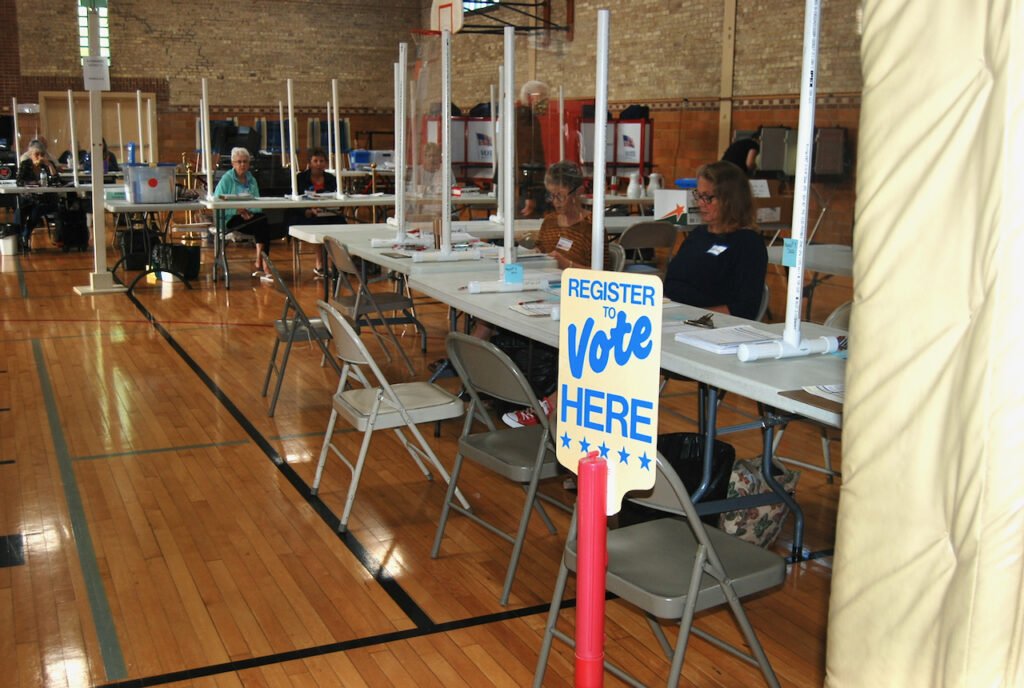
Poll workers wait at the downtown armory in Whitewater to help primary voters.
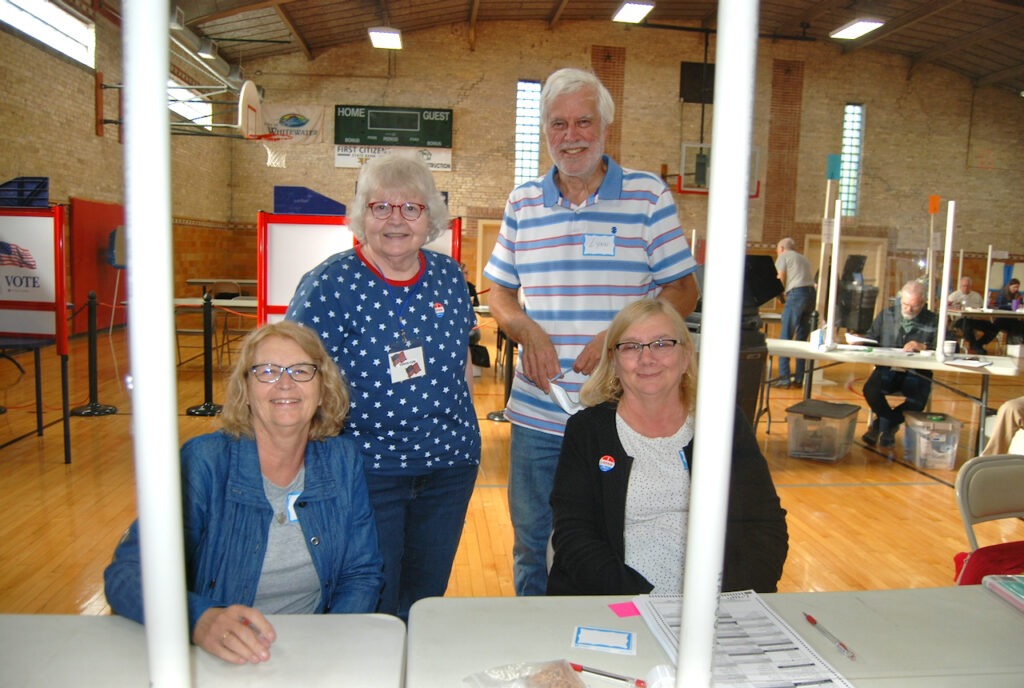
Poll workers Lin Tortomasi, from left, Valerie Cole, Lynn Binnie and Sharon Knight are on-hand to help voters at Whitewater’s polling place.

Drew Miller at left, and his son, Anderson, 2, are helped by poll worker Lynn Binnie.
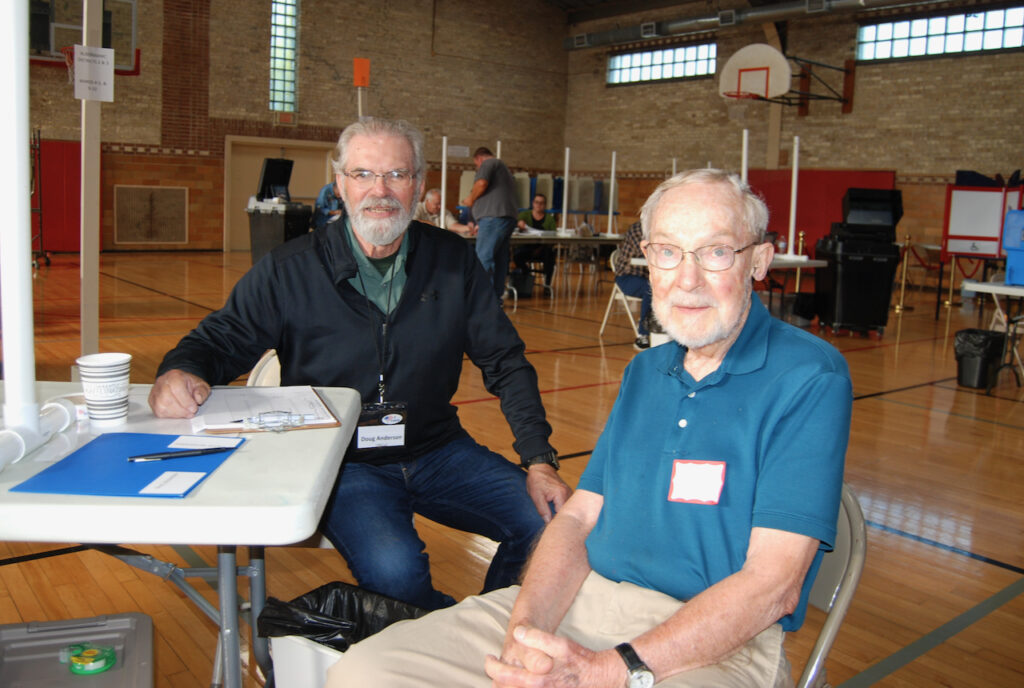
Poll workers Doug Anderson, at left, and Everett Long are ready to help voters operate the voting machine. The job includes making sure the ballot is fed correctly into the machine, Anderson said.
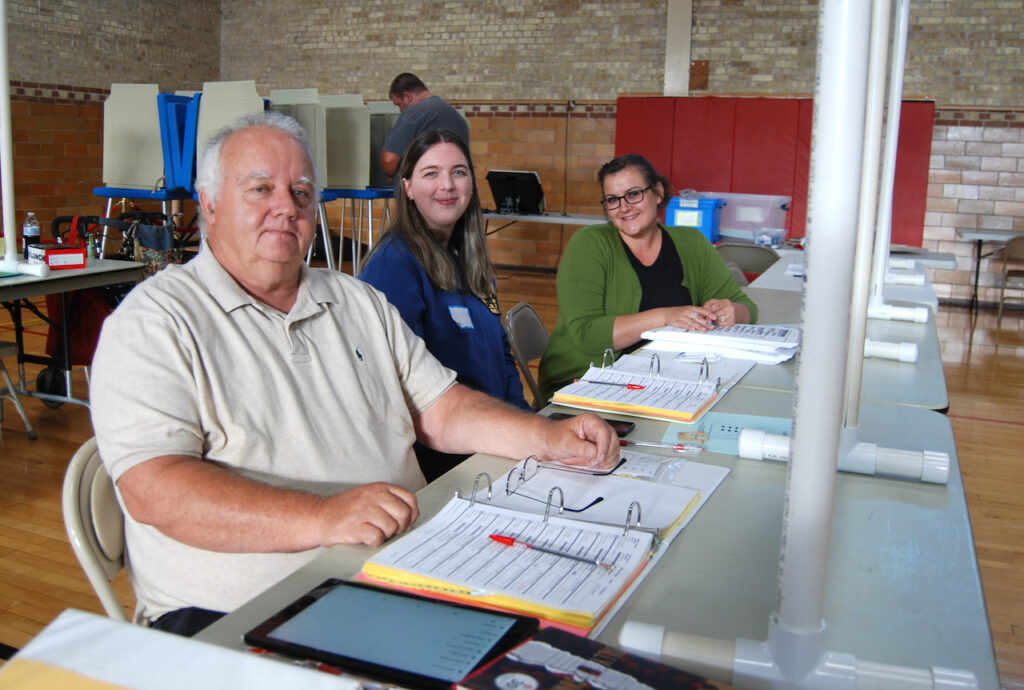
Poll workers Bill Smith, from left, Olivia Pratt and Alaina Smith man a table where Whitewater residents living in Jefferson County receive their ballots.
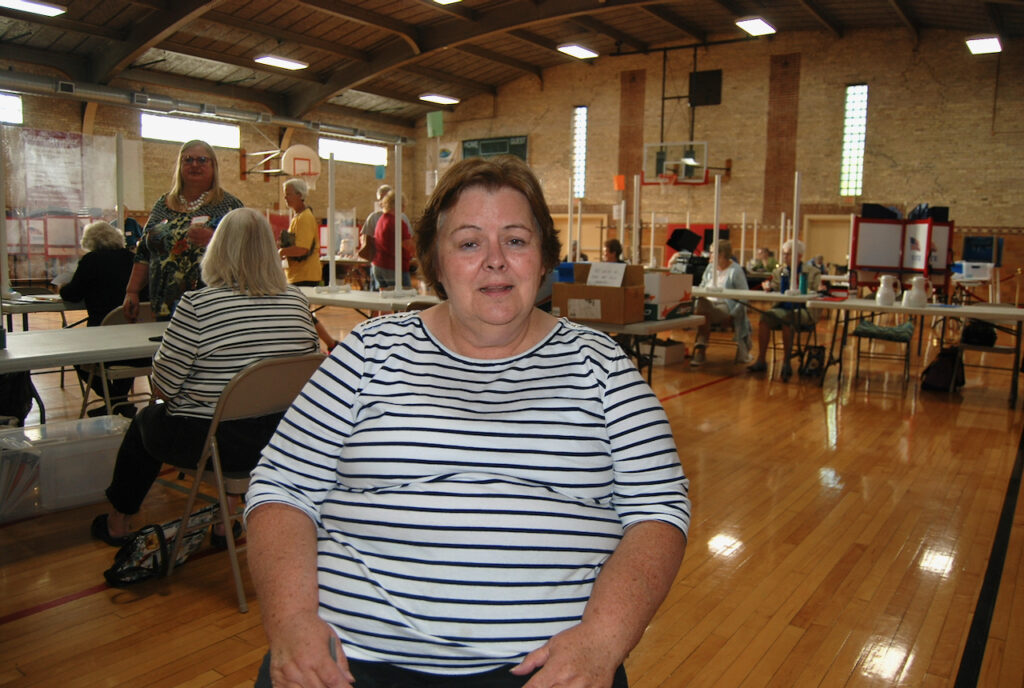
Whitewater City Clerk Michele Smith offers her impressions about Tuesday’s election.
Baldwin, Vruwink to hold agribusiness listening session in Whitewater
(Originally published Aug. 9, 2022.)
U.S. Sen. Tammy Baldwin and State Rep. Don Vruwink have announced they will be hosting a joint listening session focusing on local farmers.
The session will be held Saturday, Aug. 13, at 10 a.m., at the Luke Goessling Farm, W9697 W. Walworth Ave, Whitewater.
According to information released about the session, Goessling and his family grow corn and soybeans on 750 acres. The farm has been in the Goessling family since 1938.
The session will focus on issues presented by area farmers.
Additionally, Baldwin and Vruwink will give area growers, farmers, and food processors an update on issues that have come before Congress and the Wisconsin Legislature.
The farm is located just south of Robin’s Trucking, W9699 W. Walworth Ave, Whitewater.

Tammy Baldwin
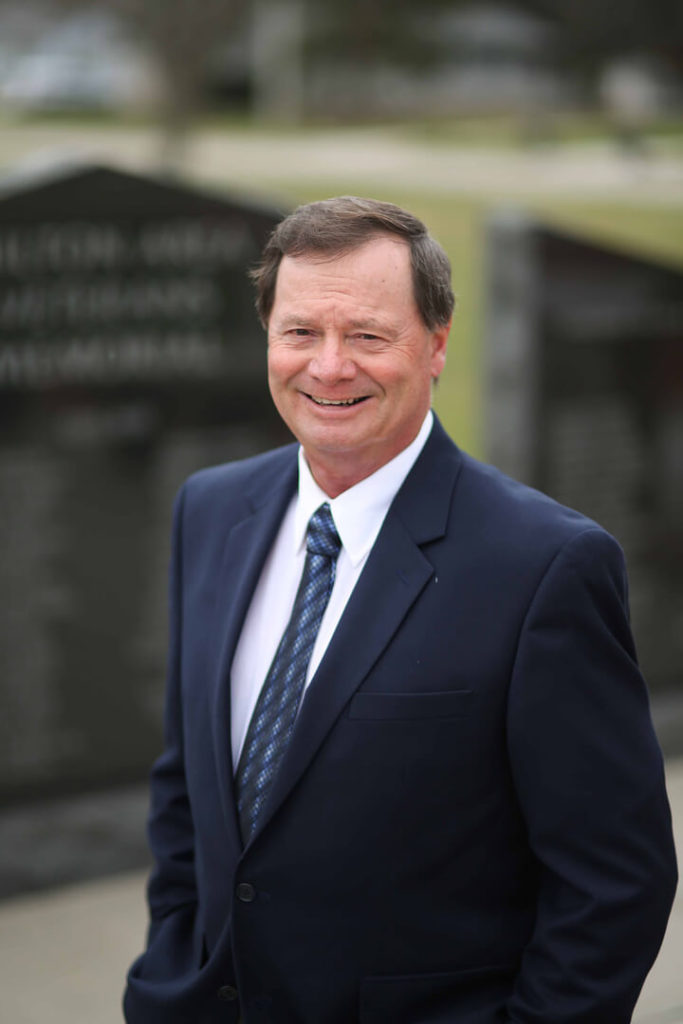
Don Vruwink
Jefferson, Walworth county candidates advance to general election
(Originally published Aug. 10, 2022.)
Editor’s note: This story has been updated to include unofficial votes counted in Dodge County.
By Kim McDarison
Fort Atkinson and Whitewater voters arriving to the primary polls Tuesday found on their ballots the names of candidates running for seats in the U.S. House of Representatives, State Senate and Assembly. Those voting in the Republican primary in both communities also found candidates running for sheriff and clerk of circuit court. A voters guide, with a brief profile of each candidate is here: https://fortatkinsononline.com/primary-election-guide-jefferson-walworth-countywide-races-on-aug-9-ballot/.
The partisan primary election saw voters from within each party choosing candidates whose names will next appear on the fall general election ballot. The election will be held Nov. 8.
Candidates winning placement on the November ballot from within districts including the cities of Fort Atkinson and Whitewater follow.
U.S. Congressional District 5: Fitzgerald to race against Van Someren in November
The city of Fort Atkinson and the portion of the city of Whitewater that resides in Jefferson County are included in U.S. Congressional District 5. The district includes, in part or whole, Jefferson, Dodge, Walworth, Washington and Waukesha counties.
Unofficial results from Tuesday’s primary place the names of Republican candidate Scott Fitzgerald and Democratic candidate Mike Van Someren on the November ballot. The two will race for a seat in the U.S. House of Representatives.
Fitzgerald earned a total of 113,053 votes districtwide. A breakdown is as follows: Dodge County, 7,522; Jefferson County, 9,739 votes; Walworth County, 1,563 votes; Washington County, 26,251 votes and Waukesha County, 67,978 votes.
Van Someren earned a total of 39,749 votes districtwide. A breakdown is as follows: Dodge County, 1,684; Jefferson County, 4,553 votes; Walworth County, 454 votes; Washington County, 6,507 votes and Waukesha County, 26,551 votes.
U.S. Congressional District 1: Steil to race against Roe in November
The portion of the city of Whitewater residing in Walworth County is included in U.S. Congressional District 1. The district also includes, in part or whole, Walworth, Rock, Racine and Kenosha counties.
Following Tuesday’s primary election, Republican incumbent Bryan Steil and Democratic challenger Ann Roe will race for the district’s open U.S House of Representatives seat in November.
During the primary election, Steil earned a districtwide total of 57,623 votes. A breakdown is as follows: Walworth County, 12,913 votes; Rock County, 8,104 votes; Kenosha County, 16,493 votes and Racine County, 20,113 votes.
Roe earned a districtwide total of 34,587 votes. A breakdown is as follows: Walworth County, 5,084 votes; Rock County, 9,332 votes; Kenosha County, 11,134 votes and Racine County, 9,037 votes.
State Senate District 11: Nass to race against Doelder in November
Portions of Jefferson and Walworth counties, including the cities of Fort Atkinson and Whitewater, reside in State Senate District 11. The district also includes portions of Rock and Kenosha counties.
Following Tuesday’s primary election, Republican incumbent Stephen Nass and Democratic challenger Steven Doelder will race for the district’s State Senate seat in November.
During the primary election, Nass earned a districtwide total of 20,399 votes. A breakdown is as follows: Jefferson County, 4,315 votes; Walworth County, 11,958 votes; Rock County, 3,583 votes and Kenosha County, 543 votes.
Doelder earned a districtwide total of 10,318 votes. A breakdown is as follows: Jefferson County, 2,481 votes; Walworth County, 4,827 votes; Rock County, 3,010 votes and Kenosha County, 191 votes.
Assembly District 33: Vruwink to race against Johnson in November
The city of Fort Atkinson and the portion of the city of Whitewater that resides in Jefferson County are included in Assembly District 33. The district includes, in part or whole, Jefferson and Rock counties.
Following Tuesday’s primary election, Democratic candidate Don Vruwink will race against Republican challenger Scott Johnson for the open Assembly seat in November. Vruwink ran unopposed in his primary. Johnson ran successfully against Republican challenger Dale Oppermann Tuesday, winning by a margin of little more than 200 votes.
During the primary election, Vruwink earned a districtwide total of 4,315 votes. A breakdown is as follows: Jefferson County, 2,533 votes, and Rock County, 1,782 votes.
Johnson earned a districtwide total of 3,293 votes. A breakdown is as follows: Jefferson County, 2,371 votes, and Rock County, 922 votes.
Oppermann earned a districtwide total of 3,087 votes, with 2,325 votes earned in Jefferson County and 762 votes earned in Rock County.
Assembly District 31: Brown to race against Schutt in November
Walworth and Rock counties, in part or whole, are included in Assembly District 31. The district includes the portion of the city of Whitewater residing in Walworth County.
Following Tuesday’s primary election, Democratic candidate Brienne Brown will race against Republican candidate Ellen Schutt for the open Assembly seat in November. Brown ran unopposed in her primary. Schutt ran successfully against two Republican challengers: Maryann Zimmerman and Jason Dean.
During the primary election, Brown earned a districtwide total of 3,353 votes. A breakdown is as follows: Walworth County, 2,057 votes, and Rock County, 1,296 votes.
Schutt earned a districtwide total of 3,245 votes. A breakdown is as follows: Walworth County, 1,998 votes, and Rock County, 1,247 votes.
Zimmerman earned a districtwide total of 2,405 votes, with 1,823 votes earned in Walworth County and 582 votes earned in Rock County.
Dean earned a districtwide total of 1,977 votes, with 1,581 votes earned in Walworth County and 396 votes earned in Rock County.
Jefferson County Sheriff: Milbrath advances to November election, running unopposed
In Jefferson County, voters on the Republican side of the primary ballot found the name of Sheriff Paul Milbrath, who is the only candidate running for the position of Jefferson County Sheriff and seeking placement on the November ballot.
He earned 9,733 votes from Republican primary constituents in Jefferson County.
Walworth County Sheriff: Gerber advances to November election, running unopposed
In Walworth County, voters on the Republican side of the primary ballot found the names of Dave Gerber and Craig Konopski running for the position of Walworth County Sheriff and seeking placement on the November ballot.
Gerber will advance to the November ballot having earned 8,149 votes from Republican constituents within Walworth County.
Konopski earned 7,943 votes from Republican constituents in Walworth County.
Clerk of Circuit Court: Hamre Incha, Secord advance
In Jefferson County, voters in the Republican primary found the name of Cindy R. Hamre Incha on their ballot. The candidate is seeking the position of clerk of circuit court and successfully ran Tuesday for a place on the general election ballot.
Hamre Incha earned 8,736 votes in Tuesday’s primary election.
In Walworth County, voters in the Republican primary found the name of Kristina Secord on the ballot. She also is seeking a position as clerk of circuit court and, having earned 12,861 votes from Republican constituents on Tuesday, will advance to the November general election ballot.
A story about statewide candidates advancing to the November election is here: https://fortatkinsononline.com/statewide-candidates-advance-to-general-election/.

Poll workers at the downtown armory in Whitewater prepare to assist voters. The armory served as the city’s only polling place Tuesday. File photo/Kim McDarison.
Solar, food security, Whitewater grocery among topics discussed with Baldwin, Vruwink
(Originally published Aug. 16, 2022.)
By Chris Spangler
Producers’ concerns about solar farms consuming valuable agricultural land were a top takeaway from U.S. Sen. Tammy Baldwin’s visit to Whitewater Saturday morning.
Baldwin and state Rep. Don Vruwink held a joint listening session at the Luke and Brandi Goessling farm west of Whitewater.
The Goesslings and their sons, Rudy and Hank, grow corn and soybeans on 750 acres. The farm has been in the family since 1938.
Janesville farmer Doug Rebout served as moderator for the discussion.
The senator and Assemblyman briefed area growers, farmers and food processors on issues that have come before Congress and the Wisconsin Legislature, as well as fielded questions and concerns from attendees.
The discussion on solar farm developers being able to outspend farmers when buying agricultural land stemmed from opening remarks by Vruwink, who currently represents the 43rd Assembly District, but is the Democratic candidate for the newly redrawn 33rd District in the Nov. 8 general election.
“As I talk to farmers, some of their concerns are the rising cost of land (and) that they can’t afford to buy it because investors are now buying up farmland …,” he said. “I think the cost went up 23% just in the last year or so. That will prevent young people from getting into farming.”
He noted that dairy producers are worried about getting enough labor to expand, and many farmers are concerned about the solar industry taking over farmland.
“Part of it is that … in the last six years in Madison, we’ve been talking about helping farmers with farm succession plans to help how they’re going to get out of it. We really haven’t done anything on this,” Vruwink said.
He said he has two cousins who are dairy farmers in their 50s with no children to take over the farm.
“The solar companies are going hard on them, saying, ‘we’ll give this much every month to take your land,’ and there are people upset with them who don’t want them to sell it, so we have to keep costs down so we can get younger farmers into agriculture. If they could sell their farms to someone for the value of its worth, they would do it tomorrow rather than give it to a solar company,” the representative said.
An attendee questioned whether solar subsidies are driving up the cost.
“The reason solar companies are investing in the land is because they are getting subsidized by the federal government,” he stated.
Sen. Baldwin said that legislation sent to President Joe Biden includes additional subsidies for solar, wind and other efforts, “as it is very much focused on reducing the nation’s reliance on fossil fuels.”
The Environmental Quality Incentives Program (EQIP) helps farmers install solar on their buildings, yet, she said, “We certainly want to be providing those sort of incentives where we can, but not selling the farm for a solar farm.”
“So the problem’s going to get worse?” a farmer asked.
“Um, yeah,” Baldwin replied.
Rebout told the senator that farmers who are trying to expand are competing with solar farm developers.
“Got a neighbor that’s getting older and looking at getting out? Yeah, we’d love to go and get that land. A solar company that’s being subsidized comes in and has a lot more money. That kind of makes it rough for us at times,” he said.
Another attendee recalled that during the drought of 2012, farmers caught a lot of flak due to the “food-vs.-fuel” ethanol debate.
“So how is this anything different for the federal government trying to get sun for fuel, solar for fuel, versus food?” he asked.
“We’re going to have to be very careful in terms of how we do this,” Baldwin said. “There are lots of places that are good for solar that aren’t necessarily good for agriculture.”
Luke Goessling said that the farmers’ message can get lost in the conversation.
“The general public assumes, ‘OK, we’re putting up solar; it’s going to be on the roof of my shed (and) the roof of my house.,” he said. “They don’t realize what’s happening out here in rural America, where they’re taking up hundreds of acres because they’re (solar) getting that subsidy. They’re expecting you to have it on your garage or top of your house. … I think some of that gets lost on where it’s really ending up.”
“I’m going to certainly track this,” Baldwin vowed.
She said she and Iowa Republican U.S. Sen. Chuck Grassley are working on legislation regarding foreign ownership of agricultural lands.
“That’s something we are supposed to be keeping track of, but basically, it’s not being enforced right now. And we want to have a really clear sense of what that foreign ownership does for rural communities,” Baldwin said.
“But it seems like we need to be doing exactly the same thing with regard to solar use.”
Jim Raymond of Janesville, host of “Ag Matters” on WCLO/WJVL, said that he did not think anyone at the listening session objects to installing solar on rooftops.
“But the farms are such large pieces of land and we have been so active in trying to preserve farmland — there are programs for that. And suddenly this new thing comes along and we see neighboring farms where they take 1,000 acres and suddenly suck it out of production for the next 25 or 30 years, and we wonder why that’s there,” he told the legislators.
“Well, the reason it’s there is because those people are paying a thousand dollars an acre in rent on land that would rent for $200 or $250. So the owner of that farmland is saying, ‘Well Doris, why don’t we rent to the solar company?’ So it runs counter to almost everyone who’s talked so far.”
He said that farmland is valuable and producers are not in favor of large solar farms.
“It has pitted neighbors against neighbors,” Raymond said. “That’s going on in the background right now.”
Baldwin said this would be a big takeaway from Saturday’s gathering.
“This is why these sessions are so important to me, because it’s not something that has been brought to my attention,” she said.
Also discussed were several related issues, such as whether the tax base for solar farms is calculated on the agricultural land value or income potential.
Vruwink said there should be a difference.
“I have a sneaky feeling it’s probably on ag value. In Wisconsin, real estate taxes on ag land are much lower,” he said.
The Assemblyman noted that the droughts in the western United States and Europe are negatively affecting the food chains from those two areas. In addition, the Russian invasion has wreaked havoc on Ukrainian farmers getting their grain to market.
“We have to look at the world balance, because we don’t want food wars to take place in the world,” Vruwink said.
“So we have to look at what we want to promote here, because we are going to need this land for food in Wisconsin.”
He said that he believes the dairy industry out west will be struggling if water use is limited there, and “what California loses, we might gain here in Wisconsin.
“So we don’t want to take all of our land and put it in there (solar), because we’re going to need that because we’re going to have to be somebody who provides the food.”
Vruwink said there should be considerations when siting a solar farm, such as the proximity to a substation.
Food security
Rebout said that food security is national security.
“This is good to keep your eye on, because when it starts pitting one farmer or neighbor against another, you’ve got turmoil in the neighborhood,” Raymond told Baldwin.
An attendee added that “an entity like China or any foreign interest, Communist or otherwise, should not be allowed to buy farmland in this country. That’s a huge national security item.”
Baldwin said there is no federal law banning foreign ownership, although there is a law requiring that a foreign interest disclose land purchases.
However, it is not enforced, she noted.
“So Chuck Grassley and I have teamed up to require enforcement of it, but also to report to the public and to Congress the impact of foreign ownership on our rural communities and agriculture,” Baldwin said.
“The other thing that it doesn’t touch, but I would be really interested in hearing how we should grapple with this, is if I think about the really large foreign-owned meatpackers.”
She said they are becoming more and more vertically integrated so they are not only owning the farmland, but they also are owning the market animals.
“And I don’t know how we keep track of that because I think that’s a security issue too,” the senator said.
Vruwink said that farmers also have voiced concerns about there not being enough plants nearby where small producers can take their beef cattle or hogs for slaughter in a timely manner. Right now, it might take nine months to a year to get to an appointment.
“If we want to promote these smaller areas …, we need to do a better job of encouraging more meatpacking plants. I hear the regulations keep changing and it costs them to keep upgrading. When the regulations change, we need to give aid to those small processors so they can stay in business rather than close down,” he suggested.
Baldwin agreed.
“We really believe that part of the answer is getting a lot more local meat-processing and butcher shops. But you’re right: it’s a dying art,” she said.
Ethanol production
Turning to other issues, Raymond said that ethanol is important to the people at Saturday’s event.
“That’s where 25% to 30% of our corn crop goes. It’s up and running, it’s 10% to 15% of the fuel and it’s working. Agriculture has a kind of a small voice because only 2% of our population is agriculture, so we have to bring the rest of the people along and make them understand that ethanol is a big part of our market right now,” he said.
Baldwin replied that she is a “big fan” of ethanol and biofuels.
She said they are especially important now that the United States halted imports from Russia after its invasion of Ukraine.
“The 7% we were importing from Russia could easily be replicated by biofuels. We should be doing that,” she said. “In my mind, just as food is national security, so is energy. And to be able to domestically produce it is (important) …”
Succession plans
A farmer voiced concern that the inheritance tax plan is not compatible with succession, so often, farmers inheriting the family’s land have to sell off land to pay the taxes.
Baldwin reported that at the state level, Wisconsin can provide assistance with succession planning for farmers.
“If something happens before we have a succession plan in place, if the inheritance tax level is down low, our kids are dealing with the loss of parents and also having to deal with having to sell land to pay for those taxes. And that’s something that we would really like to avoid,” Goessling said.
Baldwin suggested that Wisconsin should be looking at growing agricultural cooperatives, where the economy of scale can be reached through a cooperative rather than a single farm.
Whitewater grocery
Brienne Diebolt Brown of Whitewater, the Democratic candidate for the 31st Assembly District, asked about assistance creating other kinds of cooperatives, such as those to help grocery or childcare providers.
She is a member of the board of directors of the Whitewater Grocery Co., which is trying to create a community cooperative market in the city.
“Grocery store co-ops are very dependent on the supply chain, and very often that supply chain comes from national cooperative purchasers and often those come from cooperatively owned farms. Is there a bill …. in terms of helping growing cooperatives?” she asked.
Baldwin said that anything independently introduced would be eyed for the Farm Bill, but that would be for agricultural cooperatives.
Brown said that the city cannot draw a grocery store unless the median income is $65,000, and Whitewater’s is $35,000 due to there being many low-income residents, college students and people on fixed incomes.
Vruwink said that the only good location for a grocery store is where a hotel recently was built, as it must be easily accessible by college students to boost customer traffic.
“No grocer will come in because there is no location that makes sense to them,” he said.
The legislator said he thinks the state should provide incentives for restaurants and other entities such as schools to use Wisconsin-made products from area farmers.
“I think that would be a win-win for us, but we’re so toxic that we can’t have those discussions,” Vruwink said of the political landscape.
Baldwin cited Northland College in Ashland, which locally sourced food for its campus. It required 50 percent by a certain year, and the hospital followed suit.
“They actually ended up having several new farms created because they had created a new demand for things,” she said. “That local economy has really changed.”
While there is no federal footprint for such an effort, Baldwin said that Whitewater, as a community, might consider establishing a similar effort to create demand.
“The food that our schoolchildren eat in Wisconsin, we could grow in Wisconsin and market that through a marketing cooperative,” Vruwink agreed. “If we had cooperatives like you said, Sen. Baldwin, … (we could) promote small farmers through this. And we could get more kids and young families involved in ag.”
Also Saturday, Baldwin was asked whether there is any federal help to address the labor shortage.
She noted that the Infrastructure Bill President Biden signed into law provides money to train workers in construction, broadband, bridge building and more.
She cited, as an example, the goal of having every lead lateral nationwide replaced in 10 years. To meet that huge goal, pipefitters and other related workers will be needed.
“There are work training programs and apprenticeship opportunities that are a part of that measure, but we don’t have an ag counterpart to that. So labor shortages in the ag sector, we need to be creative there too,” the senator said.
Baldwin overview
Baldwin is chair of the Senate Appropriations Subcommittee on Agriculture, Rural Development, Food and Drug Administration and Related Agencies.
During her opening remarks, she noted that draft agriculture appropriations legislation that debuted last month highlights the dairy industry.
“The Dairy Business Innovation Program is one I helped put into the 2018 Farm Bill and funded through appropriations measures,” she said.
“We’ve been able to increase the funding for the program significantly since it was first authorized. This goes to Wisconsin producers and processors to help add value to their products, their operation or to create efficiencies that lower the cost of production and open new markets, etc.,” Baldwin added.
The national allocation will be funded at a significant increase of $25 million, she reported.
“We also have increased funding for the Healthy Fluid Milk Incentive Program, which allows SNAP (food stamp) recipients to purchase dairy products. And as we know, we have a thriving corn and ethanol industry, and this legislation directs the USDA to identify any market barriers to get access for the biofuels industry,” the senator said.
She noted that she worked closely with U.S. Sen. John Hoeven, a North Dakota Republican, to increase investments in rural development and conservation programs, as well as rural broadband programs.
“The Inflation Reduction Act enroute to the president’s desk includes a lot of investment in lowering the carbon output in the country, and agriculture is a big piece of that,” the senator said, adding that it funds EQIP and conservation stewardship programs, among others.
“These programs also provide farmers with financial and technical assistance to maintain land for generations to come,” Baldwin said.
The act also provides debt relief for distressed farm borrowers and assistance for underserved farmers and ranchers, including those who live in high-poverty areas, veterans, and beginning farmers and ranchers, according to the senator.
Finally, next year, Congress is due to reauthorize the Farm Bill, the first time since 2018.
Baldwin said her highest priorities are looking at strong crop insurance and dairy risk-management programs; continuing investments in clean water and rural broadband infrastructure and in trade-promotion programs to increase exports and to establish new expanded trade relationships; and to continue upping support for the Dairy Business Innovation Program.
Baldwin concluded the gathering by re-emphasizing the importance of listening sessions such the one at the Goessling farm.
“Thank you for your input, especially on the solar farm, the first one you hit me with,” she said. “It’s like now I know and we’re going to go back and chew on that.”

State Rep. Don Vruwink accompanies U.S. Sen. Tammy Baldwin as they enter a shed at the Luke and Brandi Goessling farm west of Whitewater. The shed was the site of a Saturday morning listening session on agricultural issues.
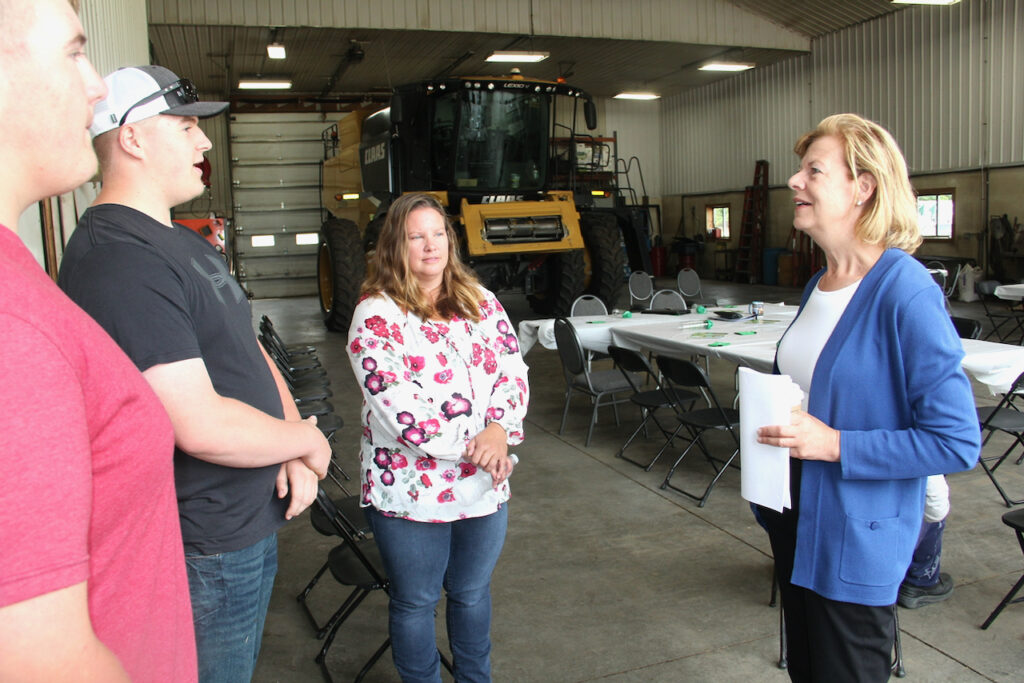
Hank, from left, Rudy and Brandi Goessling visit with U.S. Sen. Tammy Baldwin before a listening session Saturday held on the Goesslings’ Whitewater farm.
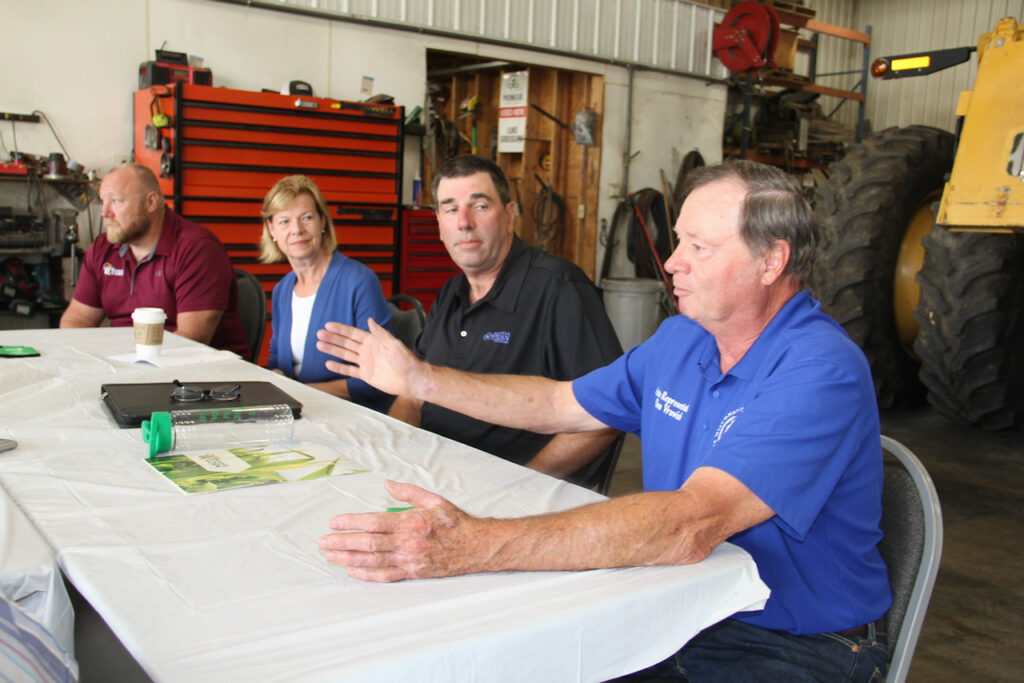
State Rep. Don Vruwink, at right, shares constituent concerns about solar farms being able to outspend farmers for agricultural land. Listening are host Luke Goessling, from left, U.S. Sen. Tammy Baldwin, and Janesville farmer and moderator Doug Rebout.
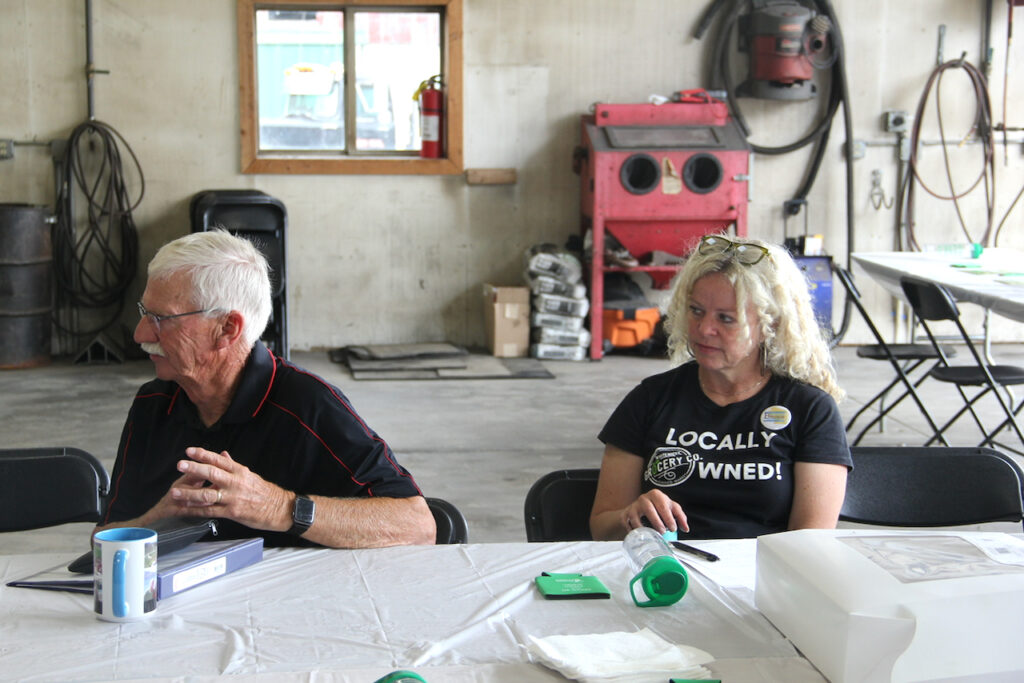
Jim Raymond, Janesville, and Brienne Brown, Whitewater, listen to U.S. Sen. Tammy Baldwin speak about the importance of cooperatives Saturday. Raymond is the host of “Ag Matters” on WCLO/WJVL, while Brown is a Whitewater Common Council member and candidate for the 31st Assembly District in the November election.
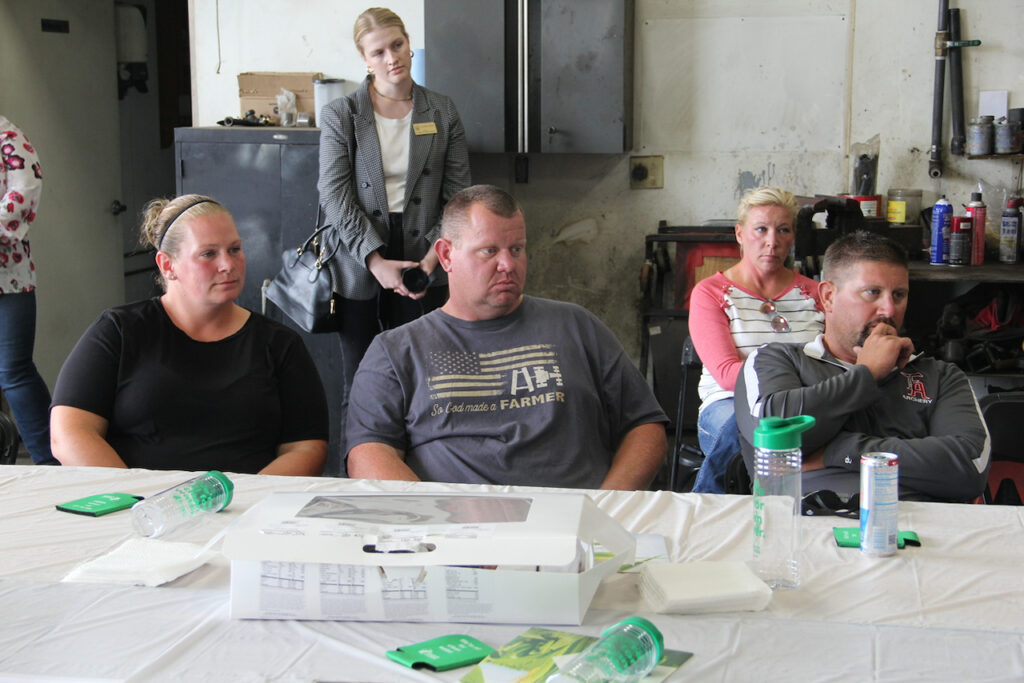
Heather and Matt Reu, Fort Atkinson, seated at the table and from left, and Casey Kelleher, Whitewater, listen Saturday to the legislators speak. Kelleher is a director on the Wisconsin Corn Promotion Board, representing District 8, which includes Jefferson, Walworth, Racine and Kenosha counties.
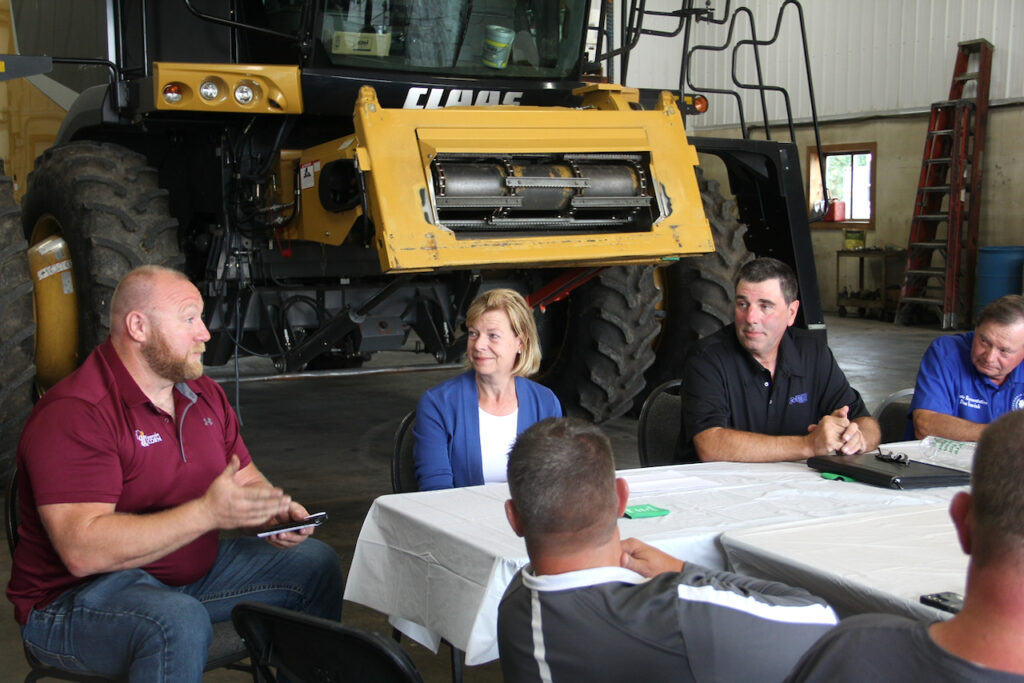
Event host Luke Goessling, from left, remarks on succession planning for farmers. Among those listening are U.S. Sen. Tammy Baldwin, Janesville farmer and moderator Doug Rebout and state Rep. Don Vruwink.

State Rep. Don Vruwink, from left, listening session hosts Luke and Brandi Goessling, U.S. Sen. Tammy Baldwin, and Goessling family members Hank and Rudy gather for a photo after the listening session.
Chris Spangler photos.
Whitewater: Council approves placement of EMS staffing referendum on November ballot
(Originally published Aug. 17, 2022.)
Editor’s note: the following information has been provided through Mueller Communications, LLC, a contracted public relations firm working with the city of Whitewater.
The city of Whitewater has submitted a resolution to the Walworth and Jefferson county clerks placing a referendum question on Nov. 8, 2022, ballots. Voters will be asked whether or not to increase property tax levies to support the city’s share of EMS staffing improvements.
The Whitewater Fire Department provides fire and EMS services to the city and town of Whitewater, and the towns of Cold Spring, Johnstown, Koshkonong, Lima Center, and Richmond. Under the proposed EMS staffing recommendations, each community would pay its fair share of a $1.47 million increase in funding, beginning in 2023. The city of Whitewater’s share of the increase, based on a calculation that takes into account the equalized value of a community, and a five-year average of EMS call volume, would be $1.1 million.
If approved, the increased funding would support up to 17 full-time, paid-on-premises firefighter/EMTs. Seventeen full-time staff would make it possible to have a fully-staffed, onsite EMS response 24/7, helping to address increased calls for service, surging response times and a lack of available paid-on-call staff.
“Like departments across the state, our community is no longer served best by a paid-on-call staff. There is a critical need to invest in highly trained, full-time, EMT personnel to be in-station and responsive to the Whitewater community,” said Kelly Freeman, chief of the Whitewater Fire Department.
For decades, the Whitewater Fire Department has relied on a paid-on-call staffing model. This model, which requires on-call staff to leave their homes or jobs to respond first to the station, then to the incident, is no longer providing an adequate level of service to Whitewater. In 2020, 41% of EMS calls had a more than five minute initial departure time, meaning staff did not leave the station to travel to the incident until five or more minutes after the initial call came in. This trend continued in 2021. As a result, a large number of EMS calls made to the Whitewater Fire Department were answered by a neighboring community, resulting in longer response times to Whitewater residents.
In November, City of Whitewater residents will be asked whether they support an increased property tax levy of $1.1 million to fund improved EMS staffing. If approved, the annual tax impact would be an increase of $67 per $100,000 home value in Walworth County and a $52 annual increase per $100,000 home value in Jefferson County. This increase takes into account reduced mill rates tied to increasing levy limits by the amount allowable by state law and the closing of tax incremental districts (TIDs).
“We are at a critical juncture to determine the level of fire and EMS services we want in our community. These challenges are not unique to our city. We are seeing departments across the state facing the need to ask residents to enhance EMS and fire services by increasing the property tax levy,” said Lisa Dawsey Smith, president of the City of Whitewater Common Council.
In the coming weeks and months, city and department officials will be working to educate the community about the need for improved staffing, the costs associated with its recommended staffing plan and the upcoming referendum. Additional information, including a list of upcoming information sessions, will soon be available at https://www.whitewater-wi.gov/582/Referendum.
Whitewater: Council names Meyer as police chief
(Originally published Aug. 20, 2022.)
By Kim McDarison
Members of the City of Whitewater Common Council Tuesday named interim Police Chief Dan Meyer as the city’s full-time police chief.
Meyer, who has served the city as its interim police chief since last December, thanked council Tuesday for his appointment.
Meyer follows former police chief Aaron Raap, who signed a Release and Employment Disposition Agreement with the city, which became effective June 30. The agreement came after an investigation, which was begun by the city, according to information released by the city, in December. The city’s investigation followed an incident which occurred at Raap’s home in Waukesha County last November.
While criminal charges alleging “battery-domestic abuse” were filed by the Waukesha County Sheriff’s Office late last year, they were subsequently dismissed by Waukesha County District Attorney Sue Opper, who cited as reasoning, in a telephone interview with Fort Atkinson Online, her lack of a finding of sufficient evidence that there was an intention to inflict bodily harm.
To date, city of Whitewater officials have not shared the results of the city’s investigation with Fort Atkinson Online.
As reported in May, on Dec. 16, 2021, in an updated press release, city officials, noting that they were responding to “a number of media inquiries about the city’s ongoing investigation,” further writing: “the procedure is part of a broader effort to maintain the integrity of the organization as a whole, not a criminal investigation. As a result, the internal investigation runs independent from any decisions made by other agencies including Waukesha County’s District Attorney’s Office and will be completed as soon as possible.”
In January, the city released the following information: “The outside investigation in regards to the status of the Whitewater Police Chief is still ongoing. Although we are hopeful for this investigation to draw to a close soon, we do not have any new information to share at this time as we wait for the results.
“When the investigation is complete, it will be reviewed by city officials. Upon the conclusion of that process, we will be issuing an updated press release for the community. The timeline is undetermined and we are very appreciative for the patience of the community and all those involved as we navigate through this difficult situation.”
In May, an item on the city council’s agenda noted the council’s intent to convene in closed session to discuss the terms of Raap’s employment with the city. The council did not reconvene in open session following its closed session meeting.
During Tuesday’s meeting, City of Whitewater Human Resources Manager Judy Atkinson told those in attendance: “As you all know, we had a position to fill regarding our police chief. We went through an internal process because … there was a need to expedite this situation as well as we had a candidate that we knew would fit the bill quite perfectly. And so with this contract that’s being presented to you tonight, we are asking for approval for — the Police and Fire Commission has approved the appointment of Dan Meyer; Dan has been with the city of Whitewater since 2010, and has held many roles within the city, and has grown and developed into the leader that he is today — so, with this contract, I am asking this body to formally approve Dan Meyer as our chief of police for the city of Whitewater.”
The action received unanimous approval.
Minutes approved Tuesday by council from the city’s Police and Fire Commission’s meeting held July 25, stated that the commission approved the extension of a “conditional offer to negotiate a contract” for the position of chief of police with Meyer, “subject to successful negotiation of an employment agreement” with the city.
According to the contract signed with the city, Meyer — who assumed the role of full-time chief Tuesday — will receive compensation of $102,000 annually. The employee will receive salary increases consistent with any across-the-board increases granted to all salaried employees, the agreement states.
Any reductions to the chief’s compensation must first receive approval by the city’s Fire and Police Commission.
The agreement provides for a biweekly transportation stipend equal to the value of 300 miles at the current IRS mileage rate, provided to the chief in lieu of a vehicle, which was previously assigned to the chief. The document states that the vehicle “is of greater benefit to the department if made available to all members of the command staff for use while on duty.”
Additionally, the contract stipulates that the city will pay annual dues on the chief’s behalf to the International Association of Chiefs of Police and the Wisconsin Chiefs of Police Association,” along with expenses associated with travel and lodging, allowing the chief to participate in two regional one- or two-day seminars annually.
Benefits include health insurance as provided through participation with the city’s group health insurance program offered to all full-time city employees and term life insurance equal to two times the employee’s base salary.
Upon retirement, the city will provide payment of all costs related to enrolling the employee in the state’s retirement plan, with the exception of any percentage required by the state of Wisconsin to be paid by the state and local government sworn law enforcement or protective occupation plan.
Upon retirement, the city will make available to the chief health, vision, and dental insurance at a cost equal to the monthly premiums accessible to other city employees.
The chief will also receive a clothing allowance of $700 annually to purchase suitable clothing and uniformed attire. The allowance may also be used for dry cleaning and expenses associated with clothing maintenance.
The city will provide the chief with a cell phone and cell phone plan for business use only.
Also stipulated within the agreement, the chief is required to establish residency within 20 miles of the city within six months.
The employment agreement can be terminated by the employee by giving a 60-day written notice to the city manager.
The city’s Police and Fire Commission, once cause is established, may terminate the contract at any time.
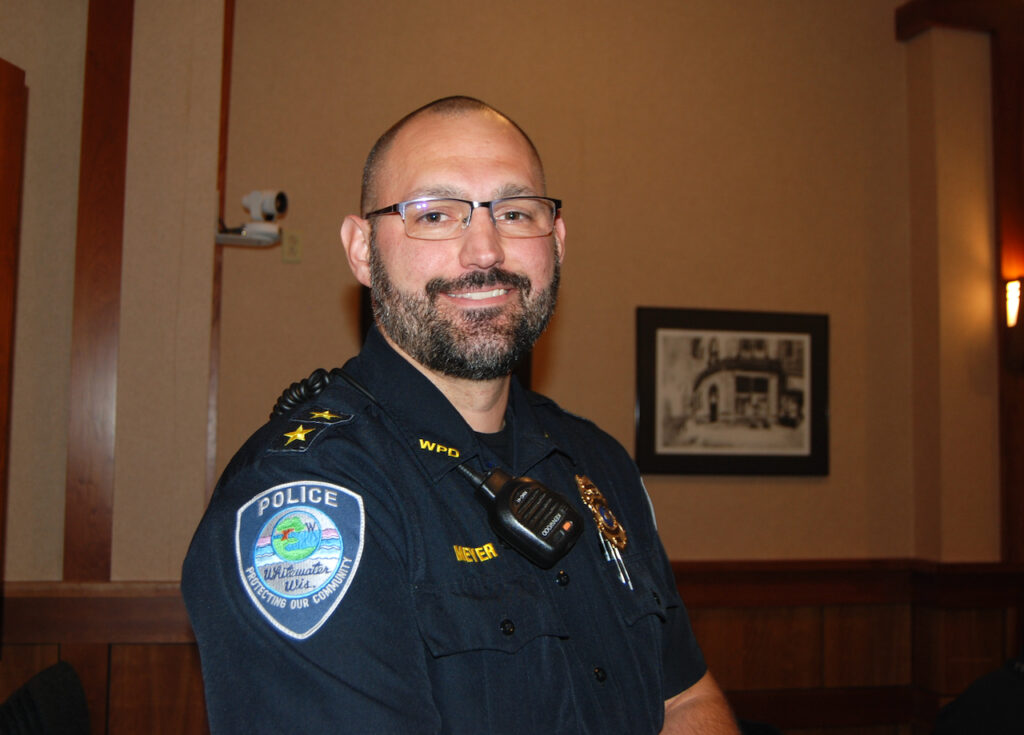
Dan Meyer
Kim McDarison photo.
Whitewater: Council hires John Weidl as interim city manager
(Originally published Aug. 20, 2022,)
By Kim McDarison
The City of Whitewater Common Council Tuesday approved a leasing agreement with GovTemps USA through which it has hired John Weidl to serve as interim city manager.
Weidl will serve in a part-time capacity while the city continues its search for a permanent city manager.
Sister companies
On July 19, the city hired GovTemps USA, a public-sector staffing firm, to conduct a search for an interim city manager. The contract with GovTemps USA was approved by council for a period of six months, beginning July 1.
Earlier in July, council hired GovHR USA, a professional recruitment firm, to conduct a search for former city manager Cameron Clapper’s successor.
GovTEMPS USA is a subsidiary of GovHR USA.
Information presented within the GovTEMPS contract notes that its terms were in accordance with the earlier approved GovHR contract, which also has a starting date of July 1.
An earlier story, about GovHR USA and its six-phased, 14-week timeline to recruit a permanent city manager, is here: https://fortatkinsononline.com/whitewater-council-hires-govhr-to-conduct-city-manager-search/.
Clapper accepted a position as county administrator in Dodge County. His last day as city manager was Aug. 12.
On Aug. 2, council adjourned at the end of its regular meeting not to reconvene for the purpose of interviewing an interim city manager candidate, according to the agenda.
During Tuesday’s meeting, in advance of council’s unanimous vote to install Weidl as interim city manager, City of Whitewater Human Resources Manager Judy Atkinson, said: “On the 12th of July, this body approved for us to pursue GovHR USA and GOV Temps USA, to not only help us with the recruitment for our city manager position, but also to help us in filling an interim city manager position for us. We do not have the staff capacity right now to take on all those roles and responsibilities. In the meeting on Aug. 2, we presented our final candidate for the interim position, and I’m looking tonight here for you to approve the appointment of John Weidl, who will be our interim city manager from tomorrow, Aug. 17, through Nov. 4, of 2022, unless, of course, we should source and procure an applicant for our city manager position prior to that.”
Councilman Jim Allen noted that Weidl will be working with the city of Whitewater for 20 to 24 hours each week. He also stated that the rate of pay for Weidl is $105 per hour.
Atkinson added that the compensation is a flat rate, saying, “this is a contracted position and they’ll be no benefits related to this cost.”
Council approved hiring Weidl through GovTemps USA and installing the interim city manager as outlined within an Employee Leasing Agreement, which was the component approved Tuesday.
Council President Lisa Dawsey Smith noted that while council approved the applicant Tuesday, the council anticipates a formal introduction of the applicant to the public during an upcoming city council meeting.
According to the leasing agreement, GovTemps USA serves as an independent contractor that will “lease” certain employees to its client, in this case, the city of Whitewater.
GovTemps will timely pay the wages and related payroll taxes of the assigned employee from its own account in accordance with federal and Illinois law. The company also will maintain records of benefits and wages paid to its leased employee, the lease agreement states.
The client will pay GovTemps fees for the services of the leased employee.
The contract stipulates that the parties agree that the client has the right of direction and control over the assigned employee, including in matters of discipline, excluding removal or reassignment.
About Weidl
According to his LinkedIn profile, Weidl served as the village administrator/economic development director in Mukwonago between 2013 and March of last year. He has also held positions, including those of city administrator/clerk/treasurer and director of public works, with the city of Princeton, beginning in 2011 and ending his tenure there in 2013.
He served in the Office of the Administrator in the village of Lake Zurick, Ill., from June of 2009 until January of 2011.
Weidl holds a master’s degree from Northern Illinois University in urban management and development, earned in 2011. He holds an undergraduate degree earned from the same institution in 2009 in political science and European history, graduating with honors.

Seated Tuesday in the gallery of the Whitewater Common Council chamber, John Weidl, at left, described by Whitewater Human Resources Manager Judy Atkinson as “our final candidate,” is appointed part-time interim city manager by the city council. A lease agreement with public staffing firm GovTemps USA for his services will expire Nov. 4. Kim McDarison photo.
UW announces fall 2023 program offering tuition-free degree for underserved students
(Originally published Aug. 22, 2022.)
UW System President Jay Rothman recently announced a program which will help underserved students obtain a degree tuition-free.
According to a recent news release, the program is slated to begin in the fall of 2023.
The program, dubbed the Wisconsin Tuition Promise, is a new initiative created to ensure that underserved Wisconsin students can attend any UW System university without paying tuition or fees, the release stated.
The goal of the program is to increase the number of state residents who graduate with a bachelor’s degree – especially first-generation students and those from low-to-moderate income families throughout Wisconsin – thereby improving individual lives and communities and helping meet the state’s workforce needs, the release continued.
According to the release, Bucky’s Tuition Promise at UW-Madison serves as the new program’s model. The Wisconsin Tuition Promise would provide up to four years of tuition and fee funding for students coming from families earning less than $62,000 annually and enrolling at any of the other 12 public universities within the UW System.
The program would be structured to provide “last dollar” financial support after federal and state grant aid is accounted for; as a result, Tuition Promise awards will vary.
Eligible students will be Wisconsin residents, first-time enrollees or transfers, and attending full-time. They will need to make sufficient academic progress each year and attest that they were employed at some point during the previous year, the release stated.
Rothman, within the release, said the affordability review he sought shows a UW System education is the most affordable in the Midwest and is very affordable nationally compared to peers. However, fewer low-to-moderate-income and first-generation students are attending UW System universities, suggesting that despite a tuition freeze in place since 2013, a state college education is increasingly out of reach for some.
“Education unlocks success in Wisconsin. By ensuring that every Wisconsin student is given the full opportunity to get a higher education, we will improve those lives directly while building the economic engine and community prosperity that benefit all Wisconsinites,” Rothman said in the release.
The release added that students will be automatically considered for the Wisconsin Tuition Promise when they apply for federal financial aid. A full publicity campaign led by the universities will begin later this fall. Current information can be found at: wisconsin.edu/tuition-promise/.
“The benefits of a college education are unassailable. A college degree needs to be within reach for every Wisconsin citizen as a path to a better life, and the Wisconsin Tuition Promise will provide these opportunities. It is also how we can close the skills gap that now limits Wisconsin’s potential to thrive in a global economy,” Rothman was quoted as saying in the release.
According to Rothman, an estimated 8,000 students will be supported through the program once it is fully implemented over four years. Eligible students will be awarded an average of $4,500 over four years. The UW System intends to fund the first year of the program in academic year 2023-24 at $13.8 million and seek state investment for subsequent years.
“At UW-Whitewater, the Wisconsin Tuition Promise builds upon our legacy as a university where students from all backgrounds can access a high-quality education at an affordable price. By guaranteeing that tuition and fees are covered for even more students, this program is a game changer. At the Whitewater and Rock County campuses, we are passionate about student success. From achievements in the classroom to the playing field, and through coveted internships and research opportunities, Warhawks are thriving — and the Wisconsin Tuition Promise will mean more students can experience a UW-Whitewater education,” interim UW-Whitewater Chancellor John Chenoweth was quoted as saying in the release.

UW-Whitewater, file photo/Kim McDarison.
Second annual Whitewater Pride Rally set for Oct. 1
(Originally published Aug. 23, 2022.)
The second annual Whitewater Pride Rally will be held Saturday, Oct. 1, at Cravath Lakefront Park.
The event, which is free and open to the public, will include music, entertainers, speakers and family-friendly activities.
The event will take place from noon until 2 p.m., rain or shine.
According to information released by event organizers, the Cravath Lakefront Park provides space for additional activities and vendor booths. The organizing committee — composed of representatives from the community, Whitewater Unites Lives, University of Wisconsin-Whitewater’s PB Poorman Pride Center and Whitewater High School’s Gay Straight Alliance — encourages those who wish to show their support of all members of the community and especially their LGBTQ+ neighbors to participate.
Organizations will be able to share information about their groups and businesses, while restaurants and others will have an opportunity to sell their products, the release stated.
A vendor agreement is available to those who wish to support pride in the Whitewater community. Submissions are due by Friday, Sept. 9.
Proceeds from the Pride Rally will be used to help keep the event free for all attendees. All additional profit will support LGBTQ+ youth in the community through the Whitewater High School Gay Straight Alliance and UW-Whitewater’s PB Poorman Pride Center.
For more information, contact Megan Kaiser at kaiserme13@uww.edu.
A form, as supplied by the event’s organizers, is here: http://fortatkinsononline.com/wp-content/uploads/2022/08/Whitewater-Pride-Rally-Vendor-Form.pdf.
Editor’s note: While Fort Atkinson Online has provided a link to the form, all questions or concerns regarding the form should be addressed to Kaiser. Fort Atkinson Online takes no responsibility for the form, its content, we do not collect money nor can we receive the returned form or forward it to the Whitewater Pride Rally organizers.
As stipulated within the form, “To participate as a vendor, please submit the application to Megan Kaiser at kaiserME13@uww.edu.

Community members gather near the Birge Fountain in downtown Whitewater at the first Whitewater Pride Rally on Oct. 23, 2021. This year’s event will be held Oct. 1, at Cravath Lakefront Park. Vendors interested in participating in the event are asked to submit an application by Sept. 9. Contributed photo.
Whitewater: Meet the interim city manager; shares plans to apply for permanent position
(Originally published Aug. 25, 2022.)
By Kim McDarison
Seated in the conference room on the second floor of the Whitewater Municipal Building Monday, newly installed interim City Manager John Weidl said he has been spending his time meeting with department heads and finding his way around the city.
Installed Tuesday, Aug. 16, as the part-time interim city manager, he took the city’s helm a week ago Wednesday, working some 20-24 hours per week. His terms of employment with the city, contracted through public sector staffing firm GovTemps USA, will expire on Nov. 4, but, Weidl said, he has already made the city council aware that he is interested in the permanent city manager position.
A sister company of the temp agency through which he is hired, GovHR USA, has begun a nationwide search to fill former City Manager Cameron Clapper’s position, and Weidl said, he plans to submit his application to be considered for the job.
Right now, he said, he is focused on issues that immediately affect the city, citing the upcoming budget cycle and the recently approved EMS staffing referendum question, which will come before the city’s voters in November.
“We are in the annual budget process right now and we are currently doing two budgets: one with the referendum passing and one without it passing, and the budget and the referendum have hard deadlines,” he said, adding that the fall general election will be held Tuesday, Nov. 8., which, he noted, is just four days after his contract as the interim city manager expires.
From Illinois, with Walworth County ties
Born in Hoffman Estates, Ill., Weidl said he grew up in Woodstock and Huntley, Ill., graduating from Huntley High School in 2001.
“Then 9/11 happened,” he said. The event weighed on his mind, he added.
He had enrolled in the University of Wisconsin-Parkside and had begun taking classes, but his mind was on the infamous attacks and he felt compelled to serve, he said.
His desire to serve was influenced in part by the actions of his paternal grandparents both of whom had served during World War II in the U.S. Army Air Corps, he said.
By December, he was serving in the U.S. Air Force. He was stationed near London at Royal Air Force (RAF) Mildenhall, where he served as a mechanic and spent a year, between 2002 and 2003, in Iraq traveling on convoys with the U.S. Army.
“Air Force personnel did joint combat missions with the Army,” he said, adding that as a mechanic, he fixed “everything that didn’t fly.”
His full tour lasted three years and six months, he said, earning him eligibility for the Montgomery GI Bill, which provided him with resources he could use to pay for college.
In 2005, Weidl returned to the United States and began classes at Northern Illinois University (NIU).
Not sure where a career path might lead, he said he chose an undergraduate course of study in political science and European history as “passion projects.”
While taking a local government class, his professor identified a proclivity and encouraged him to explore the subject.
Weidl graduated with a bachelor’s degree from NIU in 2009. He next entered into a master’s program at NIU, which came with a mentorship component through which he met Joshua Schoemann, who, Weidl said, formerly served as the city administrator in Princeton and is today the administrator in Washington County.
After completing an internship in Lake Zurich, Ill., and graduating with a master’s degree in urban management in 2011, Weidl began working within city administration in Princeton, serving over the course of his nearly three-year tenure there as the city’s director of public works and its administrator/clerk/treasurer.
In 2013, he said, he took a position in Mukwonago as the village administrator/economic development director. He left the position in March of last year.
The Milwaukee Journal Sentinel reported in April of 2021 that Weidl had signed a non-disparagement agreement with the village. The full story is here: https://www.jsonline.com/story/communities/waukesha/news/mukwonago/2021/04/13/former-mukwonago-village-administrator-john-weidl-talks-resignation-non-disparagement-agreement/7129440002/.
Weidl told the Journal that he had worked for “12 different permutations of the village board,” and that the terms of the non-disparagement agreement only affected the “current village board and its officials.” He said that working with the village board and staff had been “an absolute pleasure,” noting that, through the election process, over time the board had changed, further noting that “change is inevitable,” and “It’s (the board’s) privilege to choose their own leadership as they pursue their vision.”
Citing his comments made to the Journal, Weidl said Monday that it’s not uncommon for municipal administrators to change positions, noting that, on average, they tend to stay with a single municipality for less than five years.
Weidl said he made a career choice and commitment to serve in local government because “it’s the purest form of government; it’s where the rubber meets the road.”
National and state politics often get more attention, he said, but at the local level, that’s where everyday problems that affect people’s lives are addressed.
“At the local level, the concerns are with making sure there is water coming out of your pipes, and that the community has EMS, and safe streets to go to and from work. That’s what keeps me coming back to local government. I think it’s important.”
While working in Princeton, Weidl met his wife, Kristina. The couple lives in Elkhorn, arriving there in 2016. They married in 2019. Kristina is a fourth-grade teacher within the Mukwonago school system.
The couple enjoys outdoor activities, including hiking, cycling, and Kristina is a triathlete. She swam 100 miles last year, Weidl said.
Weidl said his father died from illness while he was in college. Last summer, he said, his mother was diagnosed with cancer.
He paused his career, taking a job at Evergreen Country Club in Elkhorn as a bartender and manager. The move allowed him time to care for his mother toward the end of her life in her Lake Geneva home, he said.
The position as interim city manager of Whitewater is his reemergence back into public service, Weidl added.
“Public service, it can be an all-consuming job, and taking care of my mother was an all-consuming job, and you can’t have two of them,” he said.
He described taking time to care for his mother as “the single best decision I made. There are certain things in life you only get to do once and they deserve your attention. I wouldn’t trade it for anything.”
While Weidl grew up in Illinois, he has ties to Walworth County, he said. His paternal grandparents moved to Walworth County after they retired, and he has fond childhood memories of visiting Lake Geneva and playing on the beach. Also, he said, his mother lived in Lake Geneva for seven years before she died.
In Whitewater, Weidl said, he sees an opportunity to utilize his skills and work in the area where he and his family have made the commitment to live.
“I’m not moving,” he said, adding that serving the next several months as interim city manager offers him an opportunity to understand the community and the skills needed to guide it.
As interim, he said, “I get to spend three months looking under the hood.”
In Whitewater, he said, “it’s about the referendum, and we are on the clock. Right now, the city council is engaged in a nationwide search for a city manager.”
Other staffing positions need to be filled he said, citing those of economic development director and chief of information officer.
Interim versus permanent manager
In describing the difference between the job of interim city manager and one who serves full-time, Weidl said that some of the more immediate concerns are, by necessity, on his plate as interim city manager, while other items are best left for implementation by the next full-time manager.
“I would say a lot is the same, except I would forego certain types of decisions. There is a limited set of decisions that I think would be better made by the new city manager. For instance, I have no intention of filling the economic development position, because the full-time administrator should take care of it. That decision is better suited for the city manager. But, there is no choice on the referendum. Education must happen and we are on a deadline.”
Looking at Whitewater with an interest in serving it full-time, he said the budget and EMS staffing remains important.
Additionally, he said, “I have learned that there is a deep desire in this community to see new activities, new growth. A grocery store has been mentioned, and several times, and filling out the Innovation Park, and there is a desire to talk about new residential.”
Looking ahead, he said, “because there is a funding mechanism, that would rise to the top. Then you have new taxpayers and new homes to help fund a grocery store.”
Weidl noted that Whitewater has prepared itself financially to look at creating affordable housing.
“When the TID (Tax Incremental Financing District) that is scheduled to close this year closes, there will be an increment totaling $2.1 million for the sole purpose of affordable housing.”
He stressed that affordable housing was not another term for low-income housing.
Instead, he said, the concept revolves around looking at the demographics of the city with an eye towards determining what those looking to live in the community can afford.
He said the $2.1 million could be used to create market-rate housing that targets an economic subsection that is considered affordable. He described those homes as between 1,400 and 1,600 square feet, with an attached garage, that might sell for $180,000 to $225,000.
Filling an economic gap between building housing that can be sold at affordable prices and the costs incurred by builders to make that housing stock is where the $2.1 million can be applied.
That might include the city putting in the municipal infrastructure to facilitate that outcome, mobilizing the $2.1 million to create housing stock or incentives for developers to create stock, he said.
He described the creation of affordable housing stock in the area as “a glaring need.”
Since his arrival in Whitewater, Weidl said he has spent time touring the city with different department heads.
He cited tours taken with both the city’s police and fire chiefs, and the water and wastewater superintendent.
“I will be doing that repetitively. I was out with the parks and recreation director. I saw the library this morning,” he said, adding that the value of such tours is seeing the city through each department head’s eyes.
He also has plans to visit with the community’s various service clubs and leadership at the university.
Weidl said he plans to begin moving in “small concentric circles,” expanding them each day to meet more people.
He noted that as he tours and learns, he sees opportunities for success in Whitewater, beginning with discussions about economic development and growth opportunities for the community.
“There is a targeted opportunity that the city has through use of the Tax Incremental Financing District that will close. These types of opportunities have led to such developments as the Kwik Trip and the new Dollar General.
During Monday’s interview, Weidl was asked to pause the process by a staff member.
He was needed to sign some documents, he said upon his return.
Those documents were for the Dollar General development, he said. This week, the city is closing on the land.
When he arrived in Whitewater, he said, he noticed attributes of the city right away.
Among them, he said, is the city’s farmers market. He was impressed to learn that the venders works closely with the city’s Parks and Recreation Department, making use of the park and the city’s outdoor amphitheater.
He also noticed, he said, that the city has a large downtown area comprised of buildings with a broad mix of interesting architecture. The size and architectural mix was an asset that he saw as highly marketable, he added.
Additionally, he cited the city’s relationship with and proximity to outdoor recreational opportunities, including the Kettle Moraine, as marketable advantages.

Whitewater interim City Manager John Weidl sits Monday behind his desk on the second floor of the city’s municipal building. Kim McDarison photo.
UW-Whitewater to hold public listening sessions regarding chancellor search
(Originally published Aug. 30, 2022.)
By Kim McDarison
The University of Wisconsin-Whitewater has announced that it will be hosting two listening sessions to facilitate a search for its next chancellor.
The sessions, which will be held Monday, Sept. 12, and Tuesday, Sept. 13, are open to the public.
According to information released by UW-Whitewater, the Chancellor Search Committee would like the public’s opinion about “key characteristics for a new campus leader, university strengths that a prospective candidate should know, and challenges facing a new chancellor.”
As earlier reported by Fort Atkinson Online, former interim Chancellor Jim Henderson resigned from his position in April, saying in his resignation statement: “One of my three goals for my time as interim chancellor has been to help this campus hire the best chancellor possible who will be here for the long term. Over the past few days it has become clear to me that I cannot make progress on that goal. Given that, I feel that it is in both the best interest of UW-Whitewater and me personally that I resign my position as interim chancellor.”
An earlier story about Henderson’s decision to resign is here: https://fortatkinsononline.com/uw-whitewater-interim-chancellor-resigns-effective-monday/.
Following Henderson’s resignation, the teachers’ union on campus began a petition which, union representatives told Fort Atkinson Online in April, was designed to stop what they perceived as political interference on campus from state lawmakers. Several student organizations across the UW System voiced similar concerns. Among concerns cited was a free speech survey proposed for systemwide distribution, with those critical of the survey suggesting it used methodology that “raised concerns about intent.”
Students, in a statement sent to UW System leadership, noted: “The topic of free speech at our universities has been used in the political arena to divide our students, create unwarranted resentment towards public higher education, and pass unjust laws limiting educational freedoms and the ability to have an honest conversation in the classroom. While we clearly support academic freedom and free speech rights, student perceptions of these complex topics must be studied in an academically rigorous manner for the results to be effective. This starts with engaging stakeholders from across the UW System.”
A story about the survey and alleged political interference is here: https://fortatkinsononline.com/uw-whitewater-teachers-union-circulates-petition-against-political-interference/.
Others on the UW-Whitewater campus told Fort Atkinson Online in April that they felt they were not being given the same rights to free speech as their more liberal-leaning contemporaries.
In April, University of Wisconsin-Whitewater student and chairman of the UW-Whitewater chapter of the Wisconsin College Republicans John Beauchamp took the podium in advance of a presentation made on campus by former President Donald Trump’s 2016 campaign manager Kellyanne Conway.
As he introduced Conway, Beauchamp included within his comments concerns about what he said was “an ever-increasing blockage” when it came to free speech associated with he and his club members getting their message heard.
“We find ourselves shouted down, and shut up, but we will not be silenced,” he told the 200 or so audience members assembled in the Timmerman Auditorium on campus.
A story from Beauchamp’s perspective about free speech on campus is here: https://fortatkinsononline.com/differing-perspectives-a-view-of-free-speech-on-campus/.
Henderson was hired as interim chancellor in June of 2021, after then-Chancellor Dwight Watson resigned. Watson tendered his resignation after receiving a diagnosis of cancer.
An earlier story about Watson’s decision to resign is here: https://fortatkinsononline.com/uw-whitewater-chancellor-resigns-after-cancer-diagnosis/.
After Henderson resigned, John Chenoweth, who then served as UW-Whitewater provost, was named interim chancellor at UW-Whitewater by then-UW System Interim President Michael Falbo. Falbo has since completed his service as interim president. UW System President Jay O. Rothman was named president by the UW System Board of Regents in June of this year.
An earlier story about Chenoweth’s installment as interim chancellor is here: https://fortatkinsononline.com/chenoweth-named-interim-uw-w-chancellor/.
An earlier story about Rothman’s appointment is here: https://fortatkinsononline.com/uw-w-chancellor-congratulates-rothman-as-uw-system-president/.
A 12-member Search and Screen Committee to help identify a new UW-Whitewater chancellor was formed in May.
A story about the committee is here: https://fortatkinsononline.com/system-names-members-of-uw-whitewater-chancellor-search-screen-committee/.
Upcoming listening sessions
Information released by the university notes that upcoming listening sessions may be attended both in-person and virtually.
Those interested in attending Monday’s session are invited to arrive at Hyland Hall, for a session that will take place between 2 and 3 p.m. The session will be held in Room 1000, also known as Timmerman Auditorium.
Those interested in attending Monday’s session virtually are invited to use the Webex platform. Registration is required. To register, visit:
https://wisconsin.webex.com/wisconsin/onstage/g.php?MTID=e4e055f51c171128262af129019590d05.
Those interested in attending Tuesday’s session are invited to arrive at Timmerman Auditorium at 5 p.m. to participate in the hour-long session.
A registration link for Tuesday’s session is here:
https://wisconsin.webex.com/wisconsin/onstage/g.php?MTID=e4053105e4924a3e4dd7f14984791c996.
Parking for those attending in person will be provided on campus in lots 7 and 9.
More information about the search for a chancellor as provided by the university is here: https://www.uww.edu/chancellor-search.
According to information provided by the university, those with questions are encouraged to contact the Search and Screen Committee Chair Regent Amy Bogost by email: abogost@uwsa.edu, or Vice Chair Lynn Gilbertson, associate professor and department chair in the College of Education and Professional Studies, by email: gilbertl@uww.edu or phone: 262-472-5203.

UW-Whitewater. file photo/Kim McDarison.
o.
Whitewater: From patrol officer to chief, Dan Meyer says he’s invested
(Originally published Sept. 2, 2022.)
By Kim McDarison
Seated behind his desk at the Whitewater Police Department, Police Chief Dan Meyer’s demeanor is quiet and approachable.
He arrived in Whitewater in 2010, at the age of 22, to take a position as a patrol officer. Today, a husband and father of three, Meyer said he’s eager to continue serving Whitewater, with additional plans to shape the city’s police department, and stay longterm.
Appointed to the position of chief on Aug. 16, after serving as interim chief since last December, Meyer said he felt over the last few months like the department was “stuck in neutral.”
Now that he’s assumed the role of chief, he said during an interview Thursday, “we can kick into drive and begin moving forward with a focus on longterm planning.”
As earlier reported by Fort Atkinson Online, Meyer follows former police chief Aaron Raap, who signed a Release and Employment Disposition Agreement with the city in June. The agreement came after an investigation, which was begun by the city, according to information released by the city, in December. The city’s investigation followed an incident which occurred at Raap’s home in Waukesha County last November.
While criminal charges alleging “battery-domestic abuse” were filed by the Waukesha County Sheriff’s Office late last year, they were subsequently dismissed by Waukesha County District Attorney Sue Opper, who cited as reasoning, in a telephone interview with Fort Atkinson Online, her lack of a finding of sufficient evidence that there was an intention to inflict bodily harm.
To date, city of Whitewater officials have not shared the results of the city’s investigation with Fort Atkinson Online.
An earlier story about the investigation is here: https://fortatkinsononline.com/waukesha-da-ive-declined-prosecution-whitewater-officials-process-broader-effort/.
For Meyer, the focus is on moving forward, he said.
Choosing a career path
Meyer is a native of Eau Claire, he said. As a high school student, he thought he would find his career in fields related to math and science, but a political science teacher with a background in law enforcement piqued his interest in the field. Meyer said he began to see the potential in law enforcement for an opportunity to make a longterm difference, and work at something that did not require him to sit behind a desk.
“Well, I am now,” he said, but new opportunities, albeit from behind a desk, will allow him to make a longterm difference of a broader scope, through shaping the goals of the department as a whole, he noted.
Meyer graduated from high school in 2005, next attending the University of Wisconsin-Platteville. He graduated in 2009 with an undergraduate degree in criminal justice.
While in college, Meyer said, he met his wife, Tera. After graduation, she found her first job in Madison as a civil engineer. Together they moved to the city and Meyer began attending police academy classes at MATC.
After a 13-week course, which included 520 hours of training — Meyer noted that today police academy students train for 720 hours — in January of 2010, he landed his first job in law enforcement as a patrol officer in Whitewater.
A career in Whitewater
Upon his arrival as an officer in Whitewater, Meyer said he was yet unmarried, but in 2011, he and Tera were wed and the couple moved, first to Fort Atkinson, and then they purchased a home in the town of Janesville. The family lives there today. The location allows both Meyer and his wife to drive relatively equal distances to work. Since graduating from college, Tera has remain employed with the same company.
The family plans to continue living in Janesville, Meyer said.
When Meyer chose a career in law enforcement, he made the decision because “I thought it would be enjoyable and I wanted to be out having conversations with people, and I could see that it made a difference,” he said.
As he worked his way up through the ranks, he had less one-on-one time with residents, but each advancement offered opportunities to impact the full organization, he said.
Looking back on his time as a newly hired police officer, he said, his first impressions of the job and the community were that he “had a lot to learn.”
Describing Whitewater, he said: “it’s a very busy place.” He worked mostly second and third shifts.
Of law enforcement in general, Meyer said he recalled hearing that it was 98% boring and 2% sheer terror, but in Whitewater, he was never bored.
“Here, there’s always something going on, especially on third shift; it’s not a sleepy place,” Meyer said.
Meyer described Whitewater as a community with a demographic that includes a younger population.
The city is home to a UW system campus.
When he began his career, he worked under then-Police Chief Jim Coan, but a year and a half later, he said, the department welcomed a new chief: Lisa Otterbacher.
“She was a lieutenant when I was hired and coming up through the organization,” Meyer said, noting that after her promotion to chief, she served as his mentor.
In 2013, Meyer said he was promoted to detective. The job changed his role within the department: instead of spending the majority of his time patrolling the community, he was working an assigned case load.
As a detective, he said, he because part of the city’s detective bureau. The bureau is made up of a detective lieutenant, who is the bureau’s supervisor, two detectives, and a school resource officer.
His job included investigation, processing crime scenes, and working with and following up on such cases as sensitive issues, drug enforcement, and cases considered high profile, such as robberies and sexual assaults.
The department’s detectives also conduct in-depth investigations when the department is hiring someone new, he said.
“When I was in the detective unit, we had a lot of burglaries and robberies,” he said, adding that like many cities, and especially those with young populations, detectives find themselves involved in drug work. He described burglaries and robberies as “a byproduct of the drug problem.”
In 2014, Meyer was promoted to the supervisory position of detective sergeant. Today, he said, the position is called detective lieutenant.
With that change, he began seeing his job from a more global perspective, he said.
New duties included executing search warrants and preparing the department for working through the accreditation process. He also became responsible for the contents and security of the department’s evidence room.
A shift in structure
In 2015, the department underwent some structural changes, Meyer said.
He recalled that both a captain and a lieutenant left in the same week. One found another job as chief in a different department and the other retired.
With the departure of the two members of the force, an opportunity opened. Meyer decided to apply for the position of captain.
He advanced to captain that year, serving under Otterbacher as the department’s second in command. He remained in the role until 2019.
He described the advancement as “more administrative.”
A change in leadership came in 2018, when Otterbacher retired and Raap was appointed as the city’s new chief. Under Raap’s leadership, the second-in-command position was retitled deputy chief, Meyer said, which effectively was a change in name only.
Meyer served as deputy chief until December, 2021, when Raap was placed by the city on administrative leave and Meyer assumed the role of interim chief.
Kicking into drive
Looking at the road ahead, Meyer said that some things since his arrival have stayed the same: when he started as a patrol officer, the department had 24 sworn officers. Today, that number is the same.
Some things are different: recently, he said, the city has received a large influx of residents from the Central American region.
“That brings a lot of challenges for both them and law enforcement,” he said.
Meyer said, for him, the question is: “How do we positively connect with them so they trust us? Because they come from a place where you don’t want to meet law enforcement in a dark alley.
“The new situation in January of 2022 started hitting all of us because of the demographic change.”
Still, Meyer said, he likes challenges.
Meeting challenges is what drove him to seek out promotions over the course of his career. He added: “I love to read, I love to learn, and when opportunity comes, I’m the type of person to go for it.”
Looking at the course of his career, he said: “I like the path. I really enjoy what I’m doing and I want to make a positive impact on the department as a whole.”
Meyer said he is invested in Whitewater and hopes to stay with the department for the rest of his career.
Looking at the composite of the force, he said, “We have hired some very solid people in the last few rounds. We just hired two new people who are at the law enforcement academy in Kenosha. This whole organization is a very great group of people. They make it enjoyable to come to work every day.”
As a chief, he said, “I hope to be as invested in this department as I can be. I do not want to ask anyone in this department to do anything that I wouldn’t do myself.”
Among goals for the department, he said, he would like to see the command staff, including himself, working outside of the office for four hours a week.
“That’s 10% of the week. There really is a lot of work to be done from behind the desk and I don’t want to set us up for failure, but I don’t think 10% is too much to ask. I am very invested in making sure our people are successful,” he said.
Also among his goals, he said: “I hope the community can trust the department and me. Personally, I don’t have a theory on the best way to police — too much time spent developing theories can cause you to lose focus. Be fully invested in the moment and the rest takes care of itself. Simply fix it, be there, be decent with people and a lot of that takes care of itself.
“I hope people will see from my actions how invested I am. I prefer to listen. I love to not be the first to speak. You learn more by listening than by talking. I tell my kids: God gave you two ears and one mouth for a reason.”

Appointed last month as Whitewater’s new police chief, Dan Meyer sits behind his desk in the city’s municipal building. Kim McDarison photo.
Whitewater: Police chief expresses concerns with ‘ongoing influx of new community members’
(Originally published Sept. 8, 2022.)
By Kim McDarison
The City of Whitewater Common Council Tuesday received a presentation from Police Chief Dan Meyer, addressing, according to the agenda, an “increase in new members to the community, opportunities to connect with new members, and safety issues.”
The presentation centered around statistics associated with what has been described by city and school district officials as an “influx” of residents from Central America, including Nicaragua.
During his presentation, Meyer said that he was responding to a request for updated information made by the council during its Aug. 16 meeting, about the “ongoing influx of new community members arriving from outside the U.S.”
Meyer said that while it was difficult to estimate the number of new residents included in the recent influx, numbers provided by the Whitewater Unified School District initially estimated 120 new students who had enrolled over the course of the last school year.
Additionally, he said, 33 new students had registered with the district in the “2022 school year,” with 28 of those students arriving from Nicaragua.
Included within the meeting packet as part of the presentation, Meyer pointed to several charts showing statistics, which, he said, were impacting police department operations.
Among statistics offered in the meeting packet were “previous estimates of new community members,” which, the material noted, were estimated in the spring at between 400 and 500 residents.
Increases in traffic citations
Meyer said that the increase in community members coincided with “notable traffic enforcement increases.”
Looking at the number of citations issued for traffic crashes, and offenses such as operating without a license (OWL), and operating while intoxicated (OWI), between January and August for three consecutive years — 2020, 2021 and 2022 — Meyer said there was a noticeable uptick.
Looking at traffic crashes over the eight-month period, in 2020, the department wrote 78 citations; in 2021, it wrote 97 citations, and in 2022, it wrote 129 citations.
Looking at the infraction of driving without a license, Meyer said, over the eight-month period, the department wrote 66 citations in 2020; 76 citations in 2021, and 201 citations in 2022.
Looking at OWI and absolute sobriety infractions, Meyer said the department wrote 58 citations in 2020, 81 citations in 2021, and 62 citations in 2022.
In addition, Meyer expressed concerns with housing, citing issues with over-occupancy, noting that recent information shared with the department alleged that there were apartments in the community with three and four families living in them.
Costs of interpretation services
Meyer next shared information associated with the cost of interpretation services, noting that in 2020, the department spent $382 dollars for the year. In 2021, the department incurred an expense of $963.81 for the year. In 2022, year-to-date, he said the department had spent $3,651.65.
“Costs associated with language interpretation have increased dramatically,” he said.
Costs included services from Southern Wisconsin Interpreting and Translation Services (SWITS) and Language Line, Meyer said, noting that officers typically use SWITS for interpretation services during criminal investigations. The department’s dispatchers use Language Line when callers do not speak English.
To reduce costs, the department was considering a new service called Propio, which would provide interpretation services by voice or video over the phone within 30 seconds.
Staff was also working with the public library to access Spanish Law Enforcement classes and was looking into prepackaged tutorials such as Rosetta Stone. Meyer said recent versions of Rosetta Stone cost $199 per person, which, he said, was not within the department’s budget.
Meetings with the school district
Citing a meeting with members of the Whitewater Unified School District held in August, Meyer said topics discussed included the creation of three new district positions and the hiring of staff to fill them. Among new hires are Jorge Islas Martinez, serving as the district’s bilingual liaison; Cesar Valadez, serving as the district’s new homeless outreach coordinator, and Terilyn Robles, serving as the district’s new multilingual coordinator.
Also discussed was the consideration of a ride-share option which could be offered within the community or by some of the area’s larger employers to help reduce incidences of unlicensed driving.
Meyer said Lisa Huempfner, a University of Wisconsin-Whitewater professor, will be engaging with her Spanish-speaking students, looking for opportunities where they might be of service within the community.
He noted the possibility of providing information to new community members in October when the school district plans to hold its Fall Festival at Cravath Lakefront Park.
Concerns with over-occupancy
Pointing to a chart presented within meeting packeted materials, Meyer said: “There has been a marked increase in calls for service at Fox Meadows in 2022.”
Fox Meadows, according to its website, is an apartment building located on the city’s northwest side, directly west of the University of Wisconsin-Whitewater campus. The building has one-, two- and three-bedroom apartments.
Looking again at an eight-month period, from January to August, during three consecutive years, 2020, 2021 and 2022, Meyer said in 2020, the department responded to 30 calls for service at Fox Meadows; in 2021, the department responded to 26 calls, and in 2022, the department responded to 125 calls.
Among his concerns, he said, was a large amount of turnover with on-premise property management.
In common spaces within the building, Meyer said, his officers were reporting missing smoke detectors, drug paraphernalia, and stains from excrement and urine.
“(An) exterminator has been on premise almost daily, if not daily, due to (a) cockroach problem,” Meyer wrote in his presentation.
Meyer cited concerns stemming from over-occupancy and loss of life in the event of a fire emergency.
Enforcement plan
During the meeting, Meyer shared with council members plans for enforcement to correct the enumerated concerns.
In August, he said, he met with Neighborhood Services Director Chris Bennett and the city’s building inspector to enlist their help.
The enforcement plan, which, he said, is being implemented primarily through the city’s neighborhood services officers and building inspectors, will begin with the issuance of letters to property owners, followed by “consistent inspections” of common areas and consistent, “potentially daily,” fines for noncompliance.
When the department has an indication of probable cause that over-occupancy is taking place, enforcers will “follow up” on an “apartment-by-apartment basis,” Meyer said.
According to Meyer, in August, the property management at Fox Meadows said it would be implementing some changes. Among them, he said, management will set up cameras around the entire property; locks will be installed on all the doors, with tenants gaining access by use of key fobs, and, among changes already begun, notices for removal are being placed on junk vehicles, and tenants with municipal code violations are receiving warnings, with further stipulations that unresolved violations will lead to fines.
Tenants who are not in compliance with their lease are receiving 14-day notices to vacate the premise, Meyer said.
How did the influx begin?
Washington Elementary School multilingual teacher Sandra Ramirez, speaking with Fort Atkinson Online by phone, noted that the influx began last school year.
Ramirez said at the beginning of the last school year, in August, after a staff member who had previously served as a district liaison left the position, she was given an extra role.
At the time, she said, the district only had a few families who were identified as coming from Central America. She believed she could handle the additional work.
Over the course of the school year, more families enrolled, she said, adding that this year, after experiencing the influx from last year, the district has hired a full-time liaison and she no longer serves in that capacity. Her tenure as liaison ended in June.
Ramirez said she has been a teacher within the Whitewater Unified School District for 12 years. Prior to September of 2021, she was working with families mostly of Mexican descent. Last September, five Nicaraguan families enrolled children in the district.
As the year progressed, and new families enrolled, she noticed many were from the same province in Nicaragua, she said.
“It started with five families and then others in Nicaragua would want to come,” Ramirez said. Those families that wanted to come would know someone who had already come, she said, adding: “So now they have a place to stay. So most of the families that are here know each other or are from the same location in Nicaragua.”
After the first families came, other followed. Ramirez described a pattern, noting that the first families to arrive would become the sponsors of the next families to arrive.
Ramirez said when families emigrating from other countries arrive at the U.S. border, they have to disclose to such agencies as the U.S. Citizenship and Immigration Services and U.S. Immigration and Customs Enforcement (ICE) where they will be staying.
“When they come through Immigration, they are given permission to be here and they are supposed to be taken care of by their sponsor. They have asylum status, most come here seeking asylum,” she said.
As the school liaison, last year, Ramirez said she was enrolling families mostly from the Nicaraguan province at a rate of about one family per week. The trend continued through May of this year, she said.
Ramirez estimated that the community now has some 80 families with children enrolled in the district and between 50 and 80 single adults, whom she described as young, and mostly male.
“They come to work. The adults come first and then the rest of the family comes over. The idea is that the men come first and get a job, and get established, and then they send for the family,” she said.
Fox Meadows has become home for many of the families because they had space, they have an application process that accommodates first-time renters, and other family members with cars may have already been living there, Ramirez said.
“Because so many Nicaraguan families live there, they can share a ride with people in the same building to go to work,” she said, adding that many of the Nicaraguan workers are employed by the same few companies.
“The men go to work and establish themselves, but it does take a while to become established,” she said.
Looking at solutions to such issues as language barriers, transportation and housing, Ramirez said: “Transportation in the city of Whitewater is a big thing. They don’t have a drivers license, but they need to get to their job. If the city or their job could provide transportation, that would help.
“They do want to speak English and they want to learn, but they spend all of their time working. They like overtime because it pays more money. Some work overnight, which makes it hard. If you have classes scheduled at night, they can’t come, and when they are in the day, they are sleeping.
“I had tried to get students and families together and have workshops, and it was hard to get even five adults together on the same day. It’s not their priority. They come here to work … and make life better for their families.”
Ramirez said programming allowing adults to learn English on their own time might be a good option.
Additionally, she said, churches in the community have stepped up to help. They have collected donations, most of which are used to buy mattresses.
“When they come, they come with nothing. Immigration takes their Nicaraguan IDs, so they show up with a cell phone and the clothes they are wearing. When they get here, they need a bed, so that’s a big thing.”
Looking ahead, she said, she believes the influx from Nicaragua will begin to slow.
Said Ramirez: “As a university town, Whitewater offered more housing options than its surrounding neighbors. But now we are at the limit. So now that the housing is full, they are looking for housing in Beloit and Janesville … even though their families are here, they will locate somewhere else where they can find housing.”
To learn more about conditions in Nicaragua, the U.S. Department of State offers a document titled: U.S. Relations With Nicaragua. A link is here: https://www.state.gov/u-s-relations-with-nicaragua/.

File photo/Kim McDarison.
Whitewater: Council opts to extend interim city manager’s hours to full time
(Originally published Sept. 9, 2022.)
By Kim McDarison
The Whitewater Common Council Tuesday approved extending hours of employment for its interim city manager from 24 to 40 per week.
The decision came after the council deliberated in closed session.
Upon reconvening in open session, council amended its contract with GovHR USA, the professional recruitment firm through which interim city manager John Weidl has been hired, to reflect the increase in hours.
According to information shared by the city with Fort Atkinson Online, “the overall impact in costs to the city will be a little over $7,000,” which, the information noted was “within currently budgeted amounts.”
Weidl was installed as interim city manager by the city council earlier this month. He attended his first meeting as interim city manager Tuesday.
The city’s contract with GovTemps USA, a sister company of GovHR USA, through which Weidl is contracted, will expire Nov. 4.
Weidl, according to the initial contract signed by the city and GovTemps USA, was hired at an hourly rate of $105. Information provided by the city has not indicated a change in that rate.
GovHR USA and the city are engaged in a hiring process to find a permanent city manager. Weidl has announced publicly that he has applied for the position.
The search and hiring process was begun after former City Manager Cameron Clapper announced he would be leaving his post to take a job as administrator with Dodge County. Clapper’s last day with the city was Aug. 12.
The city council approved its contract with GovHR USA in July. The company has advanced a six-phase hiring proposal, coming at a cost to the city of $23,500.
Updates relating to the hiring process will be published in a separate story.
An earlier story about GovHR USA and its proposed timeline is here: https://fortatkinsononline.com/whitewater-council-hires-govhr-to-conduct-city-manager-search/.
An earlier story about the city’s contract with GovHR USA and its companion company, GovTemps USA, is here: https://fortatkinsononline.com/whitewater-council-hires-john-weidl-as-interim-city-manager/.
An earlier story about Weidl is here: https://fortatkinsononline.com/whitewater-interim-city-manager-says-he-plans-to-apply-for-permanent-position/.

Whitewater Interim City Manager John Weidl delivers his first city manager’s report during the council’s regular meeting held Tuesday. Weidl has announced publicly that he has applied for the permanent city manager position. A six-phase search and hiring process, which is being conducted by the city with help from contracted professional recruitment firm GovHR USA, is underway. Kim McDarison photo.
Whitewater: City seeks engineering bids to decide fate of Starin Park tower
(Originally published Sept. 9, 2022.)
By Kim McDarison
Whitewater officials have released a request for proposals to four structural engineering firms, looking for alternatives that could help decide the fate of the 1889-built historical water tower in the city’s Starin Park.
According to information released by the city Friday, bids from the engineering firms are due back to the city by Sept. 23.
The tower has been a functioning component of the city’s water supply system since its construction.
In recent months, the city has been building a new water tower on its southwest side. The new tower is anticipated to come online in 2023. With the addition of the new tower, the city is planning to decommission the old tower.
During a city council meeting held in July, council members learned from Whitewater Director of Public Works Brad Marquardt and a representative from Cornerstone Restoration — a Sullivan-based company which had been hired to perform some tuck-pointing work on the tower’s 80-foot-tall stonemasonry elevation — that the tower was in need of structural attention.
Cornerstone representative Kyle O’Brien told the council that his company estimated work required to restore the tower would cost $968,800.
During the discussion, Council President Lisa Dawsey Smith said that while she was certain nobody wanted to see the old water tower razed, she acknowledged that restoration would be costly.
She told those in attendance during the July meeting that she had received an email from Kori Oberle, a member of the city’s Landmarks Commission, who cited the city of Fort Atkinson’s efforts to restore its 1901-built tower, finding support for their project through fundraising.
During public comments held during the July meeting, Oberle, members of the city’s Landmarks Commission, and members of the public expressed their interest in preserving the tower, talked about potential funding sources, and asked questions about the tower’s condition.
In July, then-City Manager Cameron Clapper said: “We have a tower here that is one of the oldest in the state of Wisconsin and something that we ought to dedicate more time and resources to discussing and determining the best course of action for it.”
An earlier story about the July council meeting and the tower-related discussion is here: https://fortatkinsononline.com/whitewater-council-discusses-future-of-1889-build-water-tower/.
Within the request for proposals released by the city and announced Friday, Marquardt requested proposals to:
• assess the tower’s current structural viability to determine if it can be repaired or must be demolished.
• provide potential solutions for repairing the tower or for demolishing the tower, if necessary.
• provide cost estimates for all potential solutions.
• identify public safety measures to implement while awaiting restoration or demolition and removal, if necessary.
The city is anticipating the development of a full report by Dec. 2, according to its Friday release.
Additionally, the release states, Marquardt told the Landmarks Commission at its meeting Sept. 1, that funding for these professional services is available in the Water Utility’s current operating budget. He anticipates recommending a proposal to the council during its Oct. 18 meeting.
Some tower history
According to the release, The water tower in Starin Park has served the city for 133 years. It was constructed with locally quarried limestone and has been a local landmark, protected by city ordinance, since 2015.
As noted in the release, which quotes from a document titled: “Architectural and Historical Survey of Whitewater,” written by local historian Carol Cartwright in 2008, “The best example of stone construction in the city is the water tower in Starin Park … The regularly coursed rusticated limestone walls are laid up in stepped sections that expand from larger to smaller as the structure rises. The walls are accented with belt courses and round arches. Also historically significant, the water tower is distinctive for its stone construction and potentially eligible for the National Register.”
According to the release, during an earlier meeting, the city council directed the Whitewater Landmarks Commission to research restoration costs and potential funding sources to rehabilitate the tower. In response, the commission asked the council to secure professional structural analysis to determine if the water tower can be saved.
Members of the commission include Ben Adamitis, Patricia Blackmer, Karen Coburn, Kori Oberle and Dan Richardson, along with City Councilman Lukas Schreiber and city staff representative Olivia Pratt. The commission has one vacancy to be filled by a citizen.
Those interested in learning more about the tower, may contact Marquardt by phone: 262-473-0139 or email: bmarquardt@whitewater-wi.gov.
Those interested in learning more about the Landmarks Commission may contact its chairman: Patricia Blackmer, by phone: 262-458-2178 or email: blackmerpa@aol.com.

Nestled within the city of Whitewater’s Starin Park, the 1889-built stonemasonry water tower looms large above the treetops. According to informational signage in the park, the 100-foot-tall tower was built at the site because it is 50 feet higher than the surrounding area. The tower, which, as of 2020, is the second older municipal tower operating in Wisconsin, holds 185,000 gallons of water. File photo/Kim McDarison.
Winchester True Value owner Steve Johnson retires; new owner is Niemann Foods
(Originally published Sept. 12, 2022.)
The Whitewater Area Chamber of Commerce has announced that local hardware store, Winchester True Value, 1415 W. Main St., Whitewater, has been sold.
Additionally, the chamber extended on Friday its congratulations to former owner Steve Johnson, who, the announcement stated, after operating the store for 46 years, has retired.
The announcement describes Winchester True Value as a “staple in Whitewater for 152 years.”
Johnson officially retired Friday.
The store, according to the announcement, has been sold to Niemann Foods, Inc.
According to its website, Niemann Foods, Inc. (NFI) is an association-owned company which operates across several states, including Illinois, Indiana, Missouri, Iowa and Wisconsin. Other online information notes that the company, which is headquartered in Quincy, Ill., has, as of 2016, more than 100 locations — such as supermarkets, pharmacies, convenience, pet and hardware stores — most of which operate under the banners of the County Market, County Market Express, Harvest Market, Cenex One-Stop, Haymakers, ACE Hardware, Pet Supplies Plus, and Save-A-Lot.
Additionally, the information states, the “employee-owned, family-run” company was founded in 1917 by brothers Ferd and Steve Niemann. The company began as a grocery store chain, operating 10 corner grocery stores by 1930, and opening its first full-service supermarket in Quincy in 1940.
The company’s website is here: https://www.mycountymarket.com.
According to information supplied by the chamber, shortly after his graduation from the University of Wisconsin-Whitewater, Johnson took over the operations of Winchester True Value.
“Winchester True Value is one of the longest standing and valued members of the Whitewater Area Chamber of Commerce who have been involved in the community in many ways,” the announcement stated.
The release continued: “Steve, as a biking enthusiast, has also been a member of the Whitewater Tourism Council, helping shape the outdoor recreation messaging sent to visitors. The community will certainly miss having him at the helm of the store and we wish him well on his retirement. We are happy to know that he is remaining in Whitewater and continuing his work with the Tourism Council, in between his many upcoming biking adventures.”
In its announcement, the chamber extended a welcoming message to Niemann Foods, writing: “We are sure that they will keep the hometown feel of the store and embrace the Whitewater community as is the tradition at Winchester. We are excited to see what changes and additions they will bring to the store and happy to be able to continue the long-standing relationship with the Chamber.”
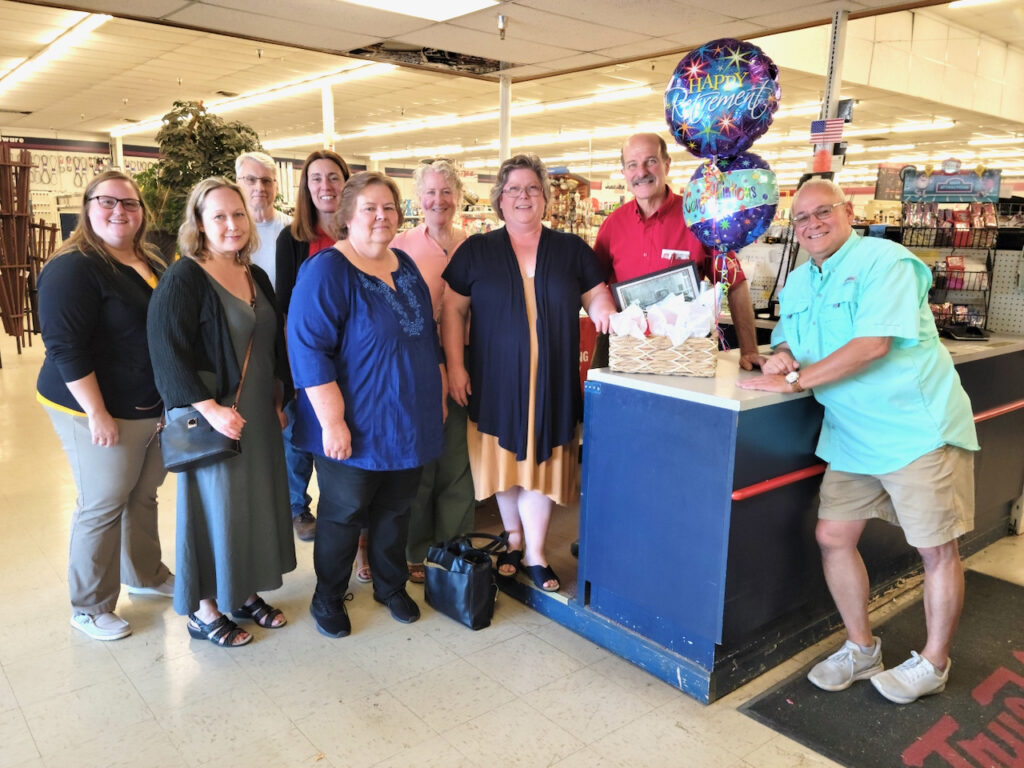
Whitewater Area Chamber of Commerce and community members gather to wish retiring Winchester True Value owner Steve Johnson well. The group includes: Chamber board members Krystal Walsh, from left, and Amy Fox; community member Dave Saalsaa; chamber board member Amy Oeding; Whitewater City Clerk Michele Smith; Chamber board President Karen McCulloch; Chamber Executive Director Kellie Carper; Johnson, and Robert Sivek. Contributed photo.
Whitewater: EMS staffing referendum topic of upcoming public information sessions
(Originally published Sept. 13, 2022.)
City of Whitewater officials have announced that they will be hosting three public information sessions regarding an EMS staffing referendum slated to appear before the city’s voters on the November general election ballot.
According to a news release, sessions will be held Wednesday, Sept. 21, at 6 p.m., at the Whitewater University Innovation Center, 1221 Innovation Dr.; Saturday, Oct. 8, at 10 a.m., at the Irvin L. Young Memorial Library, 431 W. Center St., and Tuesday, Oct. 11, at 5 p.m., at the Whitewater Fire Station, 312 W. Whitewater St.
During the sessions, community members will have an opportunity to hear from the city’s fire chief, Kelly Freeman, and other city officials, and ask questions.
The fall general election will be held Nov. 8.
As quoted within the release, Freeman said: “In November, Whitewater residents will be asked whether they support increased property taxes to support EMS staffing. These sessions will provide us the opportunity to share information and begin a dialogue with members of the community about the need for increased EMS staffing.”
For more information about the city of Whitewater’s 2022 EMS staffing referendum, visit: www.whitewater-wi.gov/582/Referendum.
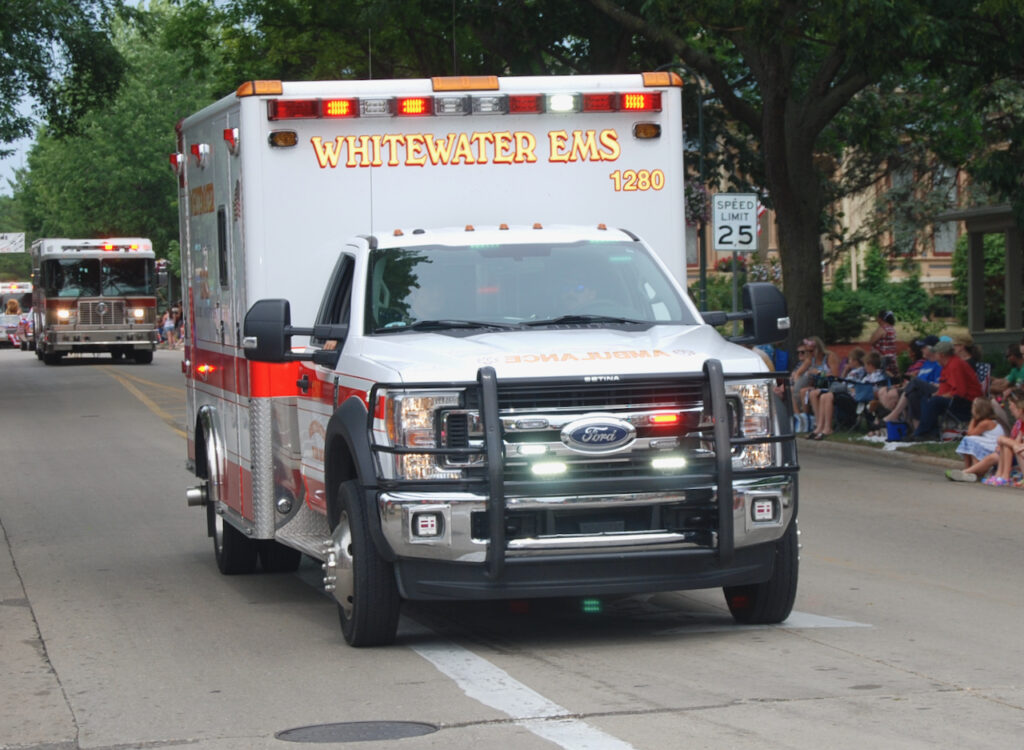
File photo/Kim McDarison.
Statewide policing trends show low numbers of applicants, higher crime; local chiefs weigh in
(Originally published Sept. 13, 2022.)
Editor’s note: The following story will be published in two parts. Recently a report produced and shared broadly for publication by the statewide nonprofit news agency, The Badger Project, pointed to trends in policing, noting that law enforcement agencies across the state were experiencing “historic lows” when seeking applicants to serve in law enforcement jobs, while simultaneously experiencing increases in crime. Fort Atkinson Online has interviewed both Fort Atkinson Police Chief Adrian Bump, who has served in law enforcement since 1998, and is an eight-year veteran serving as chief with the force, and Whitewater Police Chief Dan Meyer, who has served with the force since 2010, and was installed as its chief in August. Part 1, featuring our interview with Bump, follows.
By Kim McDarison
A recent news story shared broadly and written by The Badger Project’s managing editor Peter Cameron reports statewide trends showing a decrease in applicants in Wisconsin for law enforcement jobs. At the same time, the report notes trends across the state of increasing crime rates.
A link to The Badger Project’s story is here: https://fortatkinsononline.com/the-badger-project-number-of-police-in-wisconsin-at-historic-lows-continues-to-drop/.
In separate interviews, Fort Atkinson Police Chief Adrian Bump and Whitewater Police Chief Dan Meyer talked about policing trends in their respective communities and compared them with those reported statewide.
Following are comments from Bump. Comments from Meyer will be published in a separate story.
Building, maintaining a force
Responding to questions about the recently reported statewide trends, Bump said his force was recently increased in size by two sworn officers. The positions were made possible as part of an EMS referendum approved by the city of Fort Atkinson’s voters in April.
With the addition of the two new positions, his force has 22 sworn officers. While he described 22 sworn officers as a “good force,” he would like to see it grow to 24 sworn officers, he said, adding that budget constraints make that a “big ask.”
Other changes within the department — including two retirements and a third one pending — have facilitated a need to hire more officers, he noted, adding that Sept. 12 marked an application deadline for two positions and two officers will be coming online in January.
As a comparison, Whitewater Police Chief Dan Meyer said in a recent interview he has 24 sworn officers, which, he noted, is the same number of sworn officers the department had when he joined as a patrol officer in 2010.
Bump agreed Fort Atkinson was seeing trends similar to those described statewide. The department has been receiving fewer applications when searching for new officers, he said.
“In the 90s, it would not have been unusual to have 200 to 400 applicants for a single position. That started tapering down in about 2000, and in the last two or three years, we are seeing between 7 to 20 applicants for a single position,” he said.
On Thursday, he said, “We have a position open and we’ve been advertising for 30 days now. We have had nine applications returned so far and from that group, seven will proceed to the next step. Normally, at this stage, we would have right around 12.”
Comparing the numbers of applicants with those received recently in Whitewater — which Meyer earlier told Fort Atkinson Online was about 25 — he said: “They have a college with a criminal justice program, so it makes sense that they can attract bigger numbers of applicants because those potential applicants are already in the community and going to school in that career field. It’s true in bigger cities, too, where they have more applicants.”
Still, Bump said: “We have been lucky with the people we’ve been hiring. We have great people. One out of 12 is a good fit for us and meets our minimum qualifications, so that’s good.”
Looking at causes for the decrease in applicants, Bump cited recently formed perceptions about law enforcement, often influenced by depictions advanced by the media.
“Social media and other media outlets haven’t been doing us any favors in the last 24 months. There have been a lot of accusations towards law enforcement,” he said, adding that, in his view, many have been “unfair and not accurate.”
He said unfair representation in the media is occurring more frequently at the state and national level.
“They are not helping to paint an actual, real-life picture of what law enforcement is and what we do in our communities. There is too much focus on 1% of the issues and not enough on the 99% of our successes,” he said.
Also, he said, some hiring trends affecting law enforcement are representative of changes in the overall workforce.
Young people are not excited about working nights, weekends and holidays, he said.
Additionally, the structure of public employment is not as glamorous as it used to be, he said adding: “Pay is an obstacle. They can get better pay in the private sector.”
In Fort Atkinson, the starting salary range for a patrol officer is $29.11 to $37.87 an hour.
But, he said, the traditional tradeoff of receiving better benefits in the public sector is still in place.
As listed on a recent flier advertising patrol officer positions, new officers in Fort Atkinson will receive benefits such as the Wisconsin retirement fund, health insurance, life insurance, sick leave, dental, vision, 10 paid holidays, a clothing allowance, longevity pay, deferred compensation and vacation.
“Since I’ve been here — I came eight years ago — the focus has been to invest in our people and help them grow in their career,” Bump said.
To that end, the department looks to promote from within.
“We had two supervisors retire and another one is retiring in six months. They were all replaced internally. We focus on training and development because those were their future goals. My goal is for the next chief to come from within the department. (The agency’s) last two chiefs were hired from outside. I would like to turn that around by developing our talent,” he said.
A community connection
In Fort Atkinson, Bump said, the department has public support. He described the city as a place were community members take pride in all of the community’s institutions and work to encourage and support them.
“We are way different than most communities. Around here, we have a very strong connection with our community. There is a teamwork atmosphere. Not every community has that. This is a unique community that really focusses on all aspects of the community, including law enforcement,” he said.
Applicants down, crime up
Also noted by The Badger Project as a statewide trend, while applicants for police jobs are going down, crime is going up.
Bump said statistics in Fort Atkinson are in keeping with that finding.
Crime in the city is going up. Numbers are going up “right across the board,” he said.
The biggest changes are in drug- and alcohol-related crime, he added.
Bump said he wasn’t sure why the city was experiencing increases in those particular crimes.
Perhaps people are still dealing with changes brought about by the pandemic, he said.
Often, he noted, the perpetrators are young.
“I’m not sure if it’s just the stressful times, but we really struggle in our community,” he said.
Looking at the different categories of crime, he said, crimes such as burglary and theft are not increasing as much as crimes of impaired driving, disorderly conduct and assaults.
“It has a lot to do with people and the maturity level of people out and about in the community, in our establishments. Four percent of the people 96% of the time are the ones causing issues. They are in their 20s and 30s, and a lot of the time these things happen in the evening hours in and around our downtown district,” he said, adding, “It’s getting to the point were we don’t have the manpower we need.”
Bump said the department is looking at strategies to address the crime increases with the manpower it has.
“We are looking to increase our officers on the road through overtime, and we will have two new officers in January. We are going to have two officers doing foot patrol, which is new for us, we’ve never done that in the past, or at least not that anybody can remember,” he said.
The foot patrols will be taking place Thursdays, Fridays and Saturdays in the downtown area, he said. The department is also looking at adding a bike patrol.
Community policing
In Fort Atkinson, Bump said: “Our policing model is 100% focused on community policing, and we have 100% buy-in by all of our officers. I think that’s why we have such positive relations with our community.”
He described the Fort Atkinson community as “active,” and “very proactive.
“And we are very proactive in how we police the community. I think if you are a small to medium community, you have to have a community police department.”
Also important is the way the department faces new challenges in terms of new expectations placed on law enforcement personnel, he said.
“It’s not like it was 20 years ago. There is more required in the way we interact and the way we address concerns and issues,” he noted.
Some additional duties and issues addressed today by officers would not have been considered part of the traditional role of law enforcement, he stated.
“I’ve been (in policing) since 1998. When I joined, if you would have told me I’d be training in intervention crises, dementia response and autism response … I would not have associated these skills with a career in law enforcement,” but today, he said, “all of our officers are trained in those things. And we were one of the first departments in the state to be dementia friendly, and probably the only one in the state that is 100% certified in crises intervention.”
Shifting jobs to civilian personnel
While The Badger Project reported that some departments across the state were utilizing some civilian personnel to help cover some tasks, Bump said, to date, his department has not used civilians to do the work that is traditionally performed by sworn officers.
“We just brought in a code enforcement specialist and nuisance abatement (employee) to address issues in the community. We used to have CSOs (community service officers), and they would transition to code enforcements. A lot of times CSOs are seasonal. They are college students who work in the summer and we need people year-round,” Bump said.
A code enforcement person became valuable to the department because a number of residents were not mowing their lawns and shoveling their snow, Bump said.
The department has a full roster of dispatchers, including five full-time and six part-time employees, along with one records clerk and a code enforcement specialist.
The department also has a co-response person assigned through Jefferson County Human Services. It is a partnership position, and while the individual carries a badge, he said the employee is not on the city’s payroll. The person is paid by the county human services department.
“She is a resource for us with calls involving metal health crises,” Bump added.
An earlier story about the co-response person is here: https://fortatkinsononline.com/fort-police-to-partner-with-county-human-services-to-address-mental-health/.
Training, financing
Said Bump: “One of the reasons Fort is such a good police department and liked so well is because we invest in training and development from day one, and all the way through (an officer’s) career. It’s cheaper to train officers and have them be awesome at their job than it is to have the civil liability of potential mistakes — so not being prepared is more expensive.”
Looking at finances, he said, when it comes to funding, “The department is not receiving less, but is making decisions about how to maintain the same level of service with a budget that does not increase. So we have the same budget, but our costs go up. So the job is one of keeping the budget from increasing from year to year.
“We also want our employees to make good money so they can afford to live and are happy in their work, but to give them more money, we have to have more money.”
The department is looking at ways to reduce costs through such options as using less paper and streamlining activities in accordance with best practices, he said.
Even with today’s challenges, Bump said of himself and his force “We like our jobs. It can be frustrating at times. Most everyone in this field has to have a passion for it to be good at it. There has to be some intrinsic motivation because it is at times dangerous, at times exciting, at times boring, you have to be able to take away more than pay and benefits to do this type of job.”
A link to Part 2 of this story, featuring comments made by Whitewater Police Chief Dan Meyer, is here: https://fortatkinsononline.com/part-2-statewide-policing-trends-show-low-number-of-applicants-higher-crime-whitewater-chief-weighs-in/.
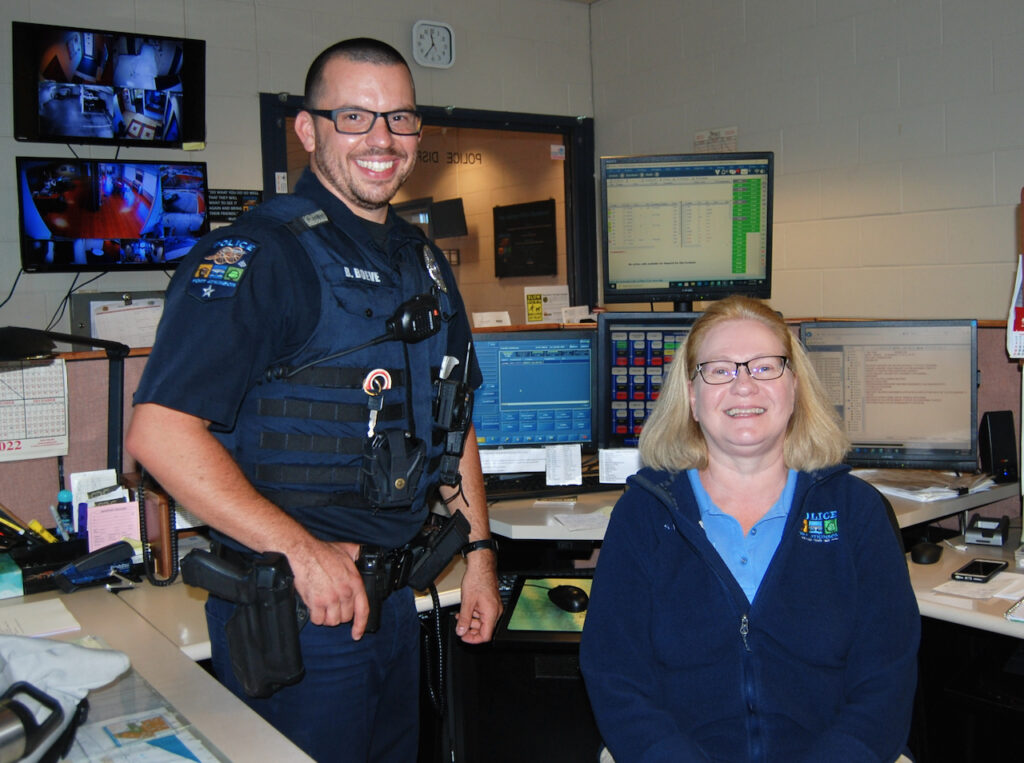
Fort Atkinson Police Department dispatcher Sandy Hottman, seated, and School Resource Officer Ben Boeve perform their duties Thursday afternoon. Hottman has been with the department for 40 years. “My brother was a police officer here, so I thought it was kind of cool,” she said. Police Chief Adrian Bump described Hottman as “committed,” adding that she trains new people and is “very invested in being great and making others great at this job.” Kim McDarison photo.
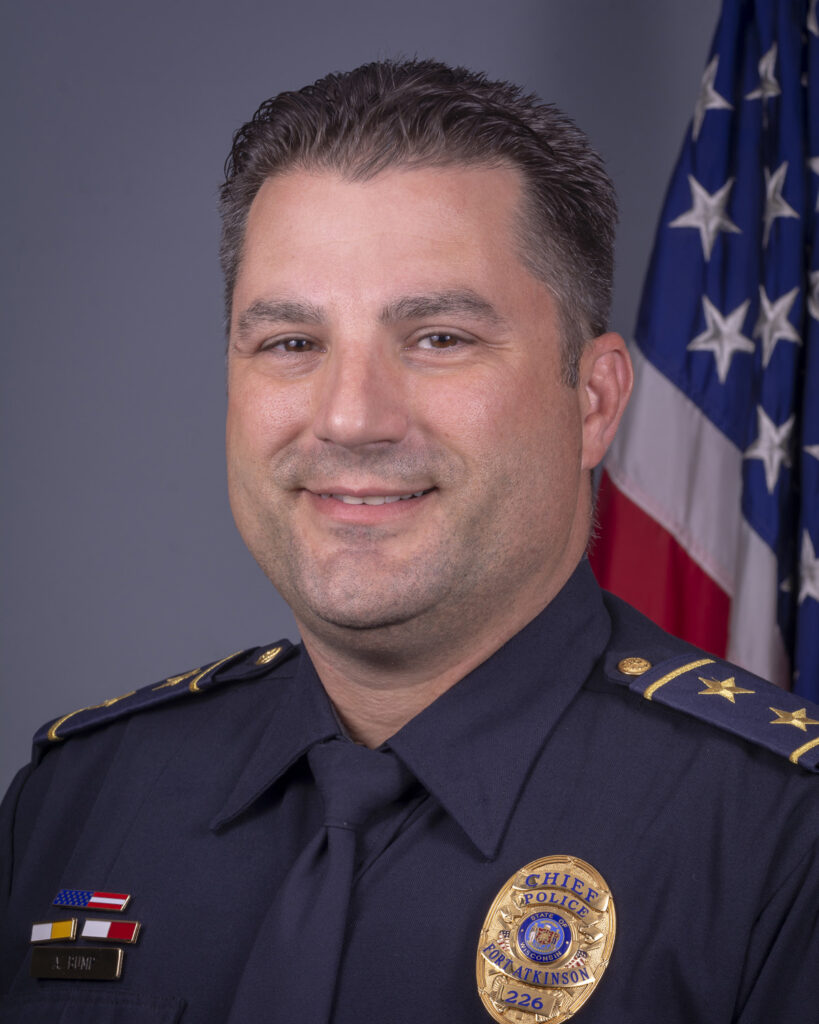
Fort Atkinson Police Chief Adrian Bump
Part 2: Statewide policing trends show low number of applicants, higher crime; Whitewater chief weighs in
(Originally published Sept. 17, 2022.)
Editor’s note: This is the second in a two-part story about policing trends. Recently a report produced by the statewide nonprofit news agency, The Badger Project, pointed to trends in policing, noting that law enforcement agencies across the state were experiencing “historic lows” when seeking applicants to serve in law enforcement jobs, while simultaneously experiencing increases in crime. Fort Atkinson Online has interviewed both Fort Atkinson Police Chief Adrian Bump — whose comments about policing trends were published in Part 1 — and Whitewater Police Chief Dan Meyer, whose comments follow.
By Kim McDarison
As noted in Part 1 of this two-part story, a recent news story shared broadly and written by The Badger Project’s managing editor Peter Cameron reports statewide trends showing a decrease in applicants in Wisconsin for law enforcement jobs. At the same time, the report notes trends across the state of increasing crime rates.
A link to The Badger Project’s story is here: https://fortatkinsononline.com/the-badger-project-number-of-police-in-wisconsin-at-historic-lows-continues-to-drop/.
In separate interviews, Fort Atkinson Police Chief Adrian Bump and Whitewater Police Chief Dan Meyer talked about policing trends in their respective communities and compared them with those reported statewide. Bump’s comments are found here: https://fortatkinsononline.com/statewide-policing-trends-show-low-numbers-of-applicants-higher-crime-local-chiefs-weigh-in/.
In this, Part 2, of Fort Atkinson Online’s story, Meyer talks about policing trends in Whitewater.
Building, maintaining a force
In an interview conducted earlier this month focusing on his recent appointment as the city’s police chief, Meyer said he has 24 sworn officers, which, he noted, is the same number of sworn officers the department had when he joined as a patrol officer in 2010.
“We have hired some very solid people in the last few rounds. We just hired two new people who are at the law enforcement academy in Kenosha. This whole organization is a very great group of people,” he told Fort Atkinson Online in the earlier interview.
Responding by email to additional questions addressing trends identified by The Badger Project, Meyer said that he would like to see the number of sworn officers in Whitewater increase.
“I believe our call volume here justifies an increase. The simple fact is that as our staff becomes stretched thin, our activity as a department becomes increasingly ‘reactive.’ In order to be a more ‘proactive’ department, it’s important for officers to have unobligated time to devote to things like traffic enforcement, drug enforcement, and community interaction,” Meyer said.
He continued: “We can reduce traffic accidents by enforcing our traffic laws. We can help reduce drug overdose deaths by interrupting the supply chain and the cycle of addiction through drug enforcement. We can improve our community’s trust in our staff when officers have time to do business checks and attend special events. As important as all of these things are, they fall to the wayside when officers have to go call-to-call responding to priority calls, many of which may have been preventable with a more proactive style of policing.”
Like Bump, Meyer cited limited financial resources as among barriers when looking to increase the number of sworn officers on his force.
He pointed to an upcoming referendum question that will be placed on the November ballot, asking city of Whitewater voters to fund increases in fire and EMS personnel.
Bump recently noted that his department increased by two sworn officers after the voters in Fort Atkinson approved an EMS referendum in April.
In Whitewater, Meyer said: “The referendum is of critical importance to the police department just as it is to Fire and EMS. It’s important for the community to know that the referendum will have far-reaching impacts regardless of the outcome. However, if the referendum fails, the police department — and most other city departments — will be financially impacted, potentially impacting our staffing levels. We will also be much more likely to be the first responder on-scene for medical issues that our officers are trained at only a basic level to handle. In my opinion that is a disservice to those needing care, and also reduces our officers’ unobligated time.”
As earlier reported by Fort Atkinson Online, both chiefs agreed that they were receiving fewer applications when searching for new officers, which, as reported by The Badger Project, is in line with statewide trends.
In Whitewater, in an earlier interview, Meyer said, “It is getting harder to find people.
“Ten years ago, there might be 200 applicants for one patrol job.”
He added that when the department recently went looking for new hires, about 25 people applied. “And that’s better than other places, I’ve heard,” he said.
Looking at causes for the decrease in applicants, both chiefs cited recently formed perceptions about law enforcement, often enhanced by the media, as among influencers.
Meyer cited “the national narrative,” and some of what he described as “anti-law-enforcement” messaging in general.
“I think that’s impacted people and has kept people away from this field,” he said, adding: “I see hiring as a pendulum. We are on the extreme end right now. As the economy does well, people go to private sector work. As the economy gets worse, they go to public sector jobs.”
While Meyer did not provide a salary range in his responses, information reported by salary.com, as of Aug. 29, 2022, states that the average patrol officer salary in Whitewater is $59,546, and the typical range falls between $55,641 and $64,840. The website reports that salary ranges vary depending on education, certification, additional skills, and the number of years spent in the profession, among others. According to the site, the average salary paid in Whitewater falls at the median as compared to the national average. The site reports that among human resources departments reporting data, half report paying officers between $52,086 and the median salary, and half offer salaries starting at the median and pay up to $69,659. A link to the data is here: https://www.salary.com/research/salary/benchmark/police-patrol-officer-salary/whitewater-wi.
Looking at training, Meyer wrote: “We have an exceptional staff here at WPD (Whitewater Police Department), and we are focused on ensuring that our employees are as highly trained as possible so that we can provide a high level of service to our community. In order to remain certified, the state requires officers to have 24 hours of training every year. Many of our officers approach or exceed 100 hours of training annually. This training is critical when looking at the variety of functions that officers now provide.”
In addition, he said: “Recently, Whitewater has undergone a demographic shift related to an influx of individuals from Central America. This has created a number of challenges for our officers, with the largest being communication, as many of the new community members speak a dialect of Spanish. Our department has responded to this need, and just this week, rolled out a Spanish language learning program and will be providing staff 30 minutes of on-duty time daily to train.”
Meyer noted that changing community demographics in Whitewater is not new to the city’s policing staff.
“We see an entirely new group of young people living in the community every four years or so. Whitewater is a very dynamic community. I think that is one of the reasons people are attracted to it, and a big reason people want to work here. From a law enforcement perspective, working here requires you to be open to learning and willing to put in an honest day’s work every single day. I’m thankful for the excellent group of individuals we have here,” he said.
A community connection
Meyer did not offer specific comment describing the department’s relationship with the Whitewater community.
In an earlier interview, he said one of the benefits of being a police chief is the opportunity to “shape the department.”
As he takes the helm, and in light of the recent influx of residents from Central America and the community’s changing demographics, Meyer told Fort Atkinson Online in an interview earlier this month that a question he asks himself is: “How do we positively connect with them so they trust us? Because they come from a place where you don’t want to meet law enforcement in a dark alley.
“The new situation in January of 2022 started hitting all of us because of the demographic change.”
Meyer noted in the earlier interview that he likes challenges.
Looking to the future and goal-setting, Meyer said all of the department’s command staff, including himself, have a goal set of being out of the office for four hours a week or 10% of the work week.
He described a recent situation where two officers were in Elkhorn working with the district attorney’s office when an incident happened in the city. In that case, he said, he and a captain responded. The goal is for all members of the department to help out where they can, he said.
Applicants down, crime up
Also noted by The Badger Project as a statewide trend, while applicants for police jobs are going down, crime is going up.
Bump recently told Fort Atkinson Online that statistics in Fort Atkinson are in keeping with that finding.
Looking at the different categories of crime, he said, crimes such as burglary and theft are not increasing as much as crimes of impaired driving, disorderly conduct and assaults.
Meyer did not provide specifics in overall crime data. He recently reported during a Whitewater City Council meeting that crimes associated with new residents from Central America were resulting in an increase in traffic violations such as crashes, operating without a license and operating while intoxicated. He also noted that his department was responding to more calls about concerns of over-occupancy at one of the city’s apartment buildings. A link to a story, citing those concerns, is here: https://fortatkinsononline.com/whitewater-police-chief-expresses-concerns-with-ongoing-influx-of-new-community-members/.
An earlier interview with Whitewater Police Chief Dan Meyer, describing his policing history in Whitewater and goals for the future, is here: https://fortatkinsononline.com/whitewater-from-patrol-officer-to-chief-dan-meyer-says-hes-invested/.
A story about the Whitewater Common Council’s recent deliberations as it drafted a fire and EMS staffing referendum question, which will appear before the city’s voters in November, is here: https://fortatkinsononline.com/whitewater-city-eyes-updated-fire-ems-1-million-operational-referendum/.
A press release from the city of Whitewater, further describing the fire and EMS staffing referendum, is here: https://fortatkinsononline.com/whitewater-council-approves-placement-of-ems-staffing-referendum-on-november-ballot/.
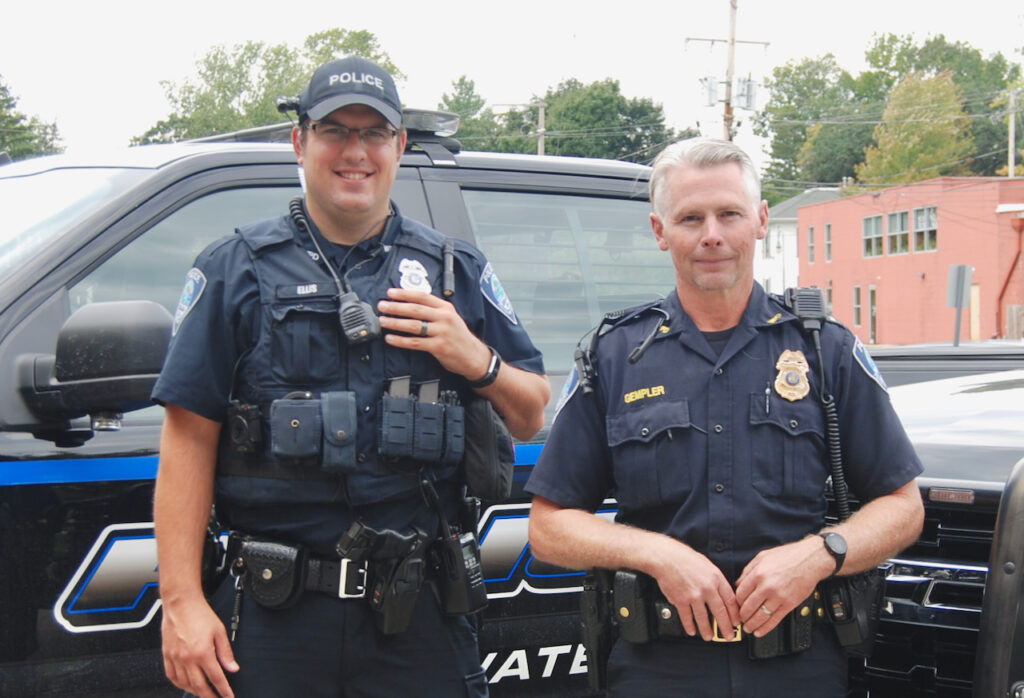
Whitewater Police Officer Richard Ellis, at left, and Police Lt. David Gempler are among staff members on duty in Whitewater Saturday afternoon. Ellis has served as a sworn member of the force for nine months, previously serving as a dispatcher for over a year. Working as a dispatcher helped him prepare for the types of calls to which he, as an officer, responds, and helped him develop skills in multitasking, he said, adding that he likes his work because “I like being able to help people when they most need it.” Gempler is a 29-year veteran of the force who began his career at the University of Wisconsin-Parkside, serving there for one year. While he described the Parkside campus as more rural than Whitewater, he grew up in Platteville. He described the community and campus as similar to Whitewater. Said Gempler: “After 30 years, there is so much I enjoy.” At the top of his list, he said, is getting to know the people in the community he serves. Kim McDarison photo.

Whitewater Police Chief Dan Meyer, file photo/Kim McDarison.
Sponsors announce purpose, activities slated for second annual pride rally
(Originally published Sept. 19, 2022.)
A coalition of unity supporters have announced that the second annual Whitewater Pride Rally, featuring a host of family oriented activities, will be held Saturday, Oct. 1.
The event will be held at the Cravath Lakefront Park in downtown Whitewater, from noon until 2 p.m.
Virginia Coburn, a member of both Whitewater Unites Lives and the Pride Rally committee, said in a recent news release: “The Pride Rally is a way to support our kids and listen to the stories of their journeys.”
Additionally, she noted, the rally provides an avenue through which members of the public can “be a friend to them and their families.”
The event is slated to include activities for children, adults and, according to the release, “even the family pets,” all in support of the area’s LGBTQ+ friends and neighbors with a focus on high school and college students.
Slated events include music, performances, vendors and food trucks. Speakers will discuss the state of the LGBTQ+ movement locally and nationally, the release stated.
“As a planning group, we believe it is important for communities like Whitewater to show that we, too, are supportive of LGBTQ+ students and others. Celebrating those who are out, coming out or thinking about it is critically important for rural communities to demonstrate real support for all that LGBTQ+ residents add to the fabric of vibrant communities,” Stephanie Selvick, UW-Whitewater’s LGBTQ+ coordinator, said within the release.
“This event provides an opportunity not only to celebrate, but also to educate. Having a report on issues facing the LGBTQ+ community and their allies is an important part of inspiring and garnering additional support and activism for the community,” she added.
Volunteers from Creative and Resourceful Educator (CARE), a UW-Whitewater student group, will be on site to lead children’s activities. A children’s corner will include story time with community leaders who will read a selection of LGBTQ+ children’s books. Among those participating are interim UW-Whitewater Chancellor John Chenoweth and interim Provost Robin Fox, the release noted.
Pets are invited to attend and participate in an inaugural Pride Pet Costume contest. Registration will take place from 11:30 a.m. until 12:30 p.m. on the day of the event. For the safety of participating pets, owners are asked to keep pets leashed. Owners are encouraged to keep their pets’ conform level with crowds in mind.
The Sweet Spot Café in Whitewater will be supporting the event by providing pride-themed cookies.
Camden Harlan, an English teacher and co-advisor for the Gay-Straight Alliance at Whitewater High School, said within the release: “As an educator in this wonderful community, it’s absolutely inspiring and heartwarming to be part of this ever-growing event. Whitewater High School students talked about last year’s Pride Rally all year long. Whether attendees gathered up the courage to speak on stage or experienced their first drag show … they will remember those moments for the rest of their lives. It’s the support of a resilient and inclusive community — businesses, schools and municipalities — that allows us to celebrate and show our love for every human.”
According to the release, this year’s event partners include: Impact student organization, Unity Project, Whitewater Unites Lives, Whitewater High School Gay-Straight Alliance, The Book Teller, First United Methodist and the Pride Center at UW-Whitewater.
For more information about the event, call: 262-472-7169 or visit the event’s Whitewater Pride Rally Facebook page.
An earlier story about the second annual Pride Rally is here: https://fortatkinsononline.com/second-annual-whitewater-pride-rally-set-for-oct-1/.

Pride flag, file photo/Chris Spangler.
Whitewater: City shares two budgets: one if referendum is approved by voters, one if it’s not
(Originally published Sept. 30, 2022.)
Following is the first of a two-part series examining two budgets drafted for possible use in the city of Whitewater in 2023. In this, the first part, the budgets — one proposed for use if the city’s EMS referendum is approved in November by voters and one proposed for use if the referendum does not pass — are presented. Part two will explore how the two budgets will impact mill rates in both Walworth and Jefferson counties and changes those residents can expect to see on their tax bills.
By Kim McDarison
Whitewater Interim City Manager John Weidl and Director of Finance Steve Hatton Thursday provided Fort Atkinson Online with a “budget briefing,” explaining the development of two possible budgets, one of which likely will be placed in use next year.
A “presentation and brief overview of (a) draft 2023 budget and 2023 alternate budget” are among items listed on the Whitewater City Council’s Tuesday, Oct. 4 meeting agenda. The meeting will be held at the city’s municipal building, 312 W. Whitewater St., at 6:30 p.m. A virtual option for attendance also is available.
The two budget scenarios under development are contenders for use in the second year of the city’s biennial 2022-23 budget, which, according to city documentation, was adopted Nov. 16, 2021.
Weidl and Hatton noted Thursday that they have developed two budgets, one for use if the city’s proposed EMS referendum is approved by voters in November and one for use if it does not receive approval.
The EMS referendum question will appear before the city’s voters on the Nov. 8 ballot.
It reads as follows: “Under state law, the increase in the levy of the City of Whitewater for the tax to be imposed for the next fiscal year 2023 is limited to 7.673%, which results in a levy of $4,656,852. Shall the City of Whitewater be allowed to exceed this limit and increase the levy for the next fiscal year 2023 for the purpose of establishing, staffing and operating a City of Whitewater Municipal Government Fire and Emergency Services Department (Municipal Department), by a total of which results in a levy of $5,756,852, and on an ongoing basis, include the increase of for each fiscal year going forward?”
To fund the in-house department, the city is requesting an annual increase in the levy, which requires voter approval because it exceeds the state-imposed levy limit by $1.1 million, with those revenues used to fund the city’s newly acquired in-house fire department.
The city’s in-house fire department was formed in July through contractual agreement with Whitewater Fire Department, Inc., a volunteer paid-on-call fire and EMS department that, through an earlier contractual agreement, serviced the city and several neighboring communities. Whitewater Fire Department, Inc., while operating as a separate entity from the city, was housed in garage space attached to the city’s municipal building.
In bringing the department in-house, the city also has assumed ownership of contracts with neighboring communities formerly held by Whitewater Fire Department, Inc. Those communities include, in part or whole, the towns of Whitewater, Cold Spring, Koshkonong, Richmond, Lima and Johnstown.
In addition, the contractual agreement with the city bringing the department in house allowed for staffing changes: firefighters and EMTs have moved from a paid-on-call model to one in which they are paid members of the city’s staff. The change allows the department to increase the number of hours covered by staff, which, officials have said, would improve emergency crew response times.
An earlier story about the new fire department model and exploration of a November ballot referendum to fund the new department is here: https://fortatkinsononline.com/whitewater-council-approves-bringing-fire-department-in-house-explores-november-ballot-referendum/.
The two budgets
According to information supplied by city officials, in 2022, the city operated using a budget of $10,020,828, of which $3,217,219 was funded through the tax levy.
In 2023, the proposed budget, which was drafted before the fire department was brought in house, was $10,417,100. State statutes limit the budgetary obligation — known as the levy — which can be paid by the city’s taxpayers. In 2023 the levy limit is $4,656,852.
Among the recently amended budgets — both of which include the additional expenses associated with the in-house fire department — would voters approve the referendum, in 2023, the city anticipates operating with a budget of $11,511,608, funded, in part, with a tax levy of $5,756,852. Would taxpayers approve the referendum, the city would be able to exceed the levy limit by $1.1 million “going forward,” as language within the referendum question states, meaning in perpetuity, or as long as the city deemed it necessary.
Would voters decide against the referendum, in 2023, the city anticipates operating with a budget of $10,114,853, funded, in part, with a tax levy of $4,656,852, which is the initial levy limit as imposed by state statute.
Building a budget: Revenues and expenses
In a State of the City address delivered in October of 2021, then-City Manager Cameron Clapper offered a slide presentation noting revenue sources used to fund the city and the associated costs. In 2021, he said, the city developed its budget anticipating revenues of $9.6 million.

Referencing a slide (above) showing the city’s revenue sources, Clapper said during his presentation: “You can see property taxes and intergovernmental revenue make up the largest chunk of our dollars coming in, and intergovernmental revenues is actually more than property tax, so we are very dependent on the state for the dollars that they choose to allocate annually in the biannual budget to municipalities.”
Clapper said monies collected through the tax levy support 42% of the city’s operating budget and 47% come from intergovernmental revenues. Other sources, such as public charges for services, forfeitures, licenses and permits, special assessments and miscellaneous charges, each account individually for anywhere from 1% to 5% of the full general fund revenue pie.

Looking at general fund operating expenditures (above), Clapper said, public safety accounts for 40%; followed by general government expenses, at 16%; public works expenses and transfers, each coming in at 11%; debt service accounts for 10%; cultural, recreational and educational activities consume 8%, and conservation and development are allotted 4%.
Clapper defined expenditures associated with public works and public safety as “significant.”
“Public Safety, of course, is very expensive, with all of the equipment and training that’s required of our public servants,” he said.
A link to Clappers State of the City address from last year is here: https://fortatkinsononline.com/whitewater-city-manager-shares-state-of-the-city-address/.
Differences in the 2023 draft budgets
Within their presentation Thursday, Weidl and Hatton shared information showing the differences between the two draft budgets proposed in 2023.
Among guiding principles and goals, they noted a desire to deliver two balanced budgets, including one that could be used if the referendum passes and one which would be used if it does not, along with a desire to maintain a fund balance for the city equal or greater than 20% of the general fund operating budget.
Additionally, they offered a list of “notable items,” which — would voters approve the referendum in November — would allow for a budget that could: close the city’s share of the funding gap sustainably, maintain EMS personnel onsite with up to 17 full-time employees, and fully fund fire and EMS equipment replacement without debt. The fully funded budget, with the additional $1.1 million included, also would allow the city to more readily absorb the cost of inflation, calculated in August at 8.3% by Consumer Price Index for All Urban Consumers (CPI-U), and allow the city to maintain a 4% wage increase to retain staff.
Would the referendum fail, a second list, as presented by Weidl and Hatton, included notable items that would affect the city’s budgetary decisions. It included: an inability to close the city’s share of the funding gap sustainably; a reduction of fire and EMS staffing such that only one ambulance would be available to respond to calls 24/7, noting that the department currently runs two ambulances; a likelihood that debt would be required to replace fire and EMS equipment; a $28,000 increase in a solid waste and recycling fee which would be passed on to the consumer at an approximate cost of $15 per month; a need to maintain a vacant patrol officer position; deferrals of some revenue transfers that would traditionally be used for street maintenance and repair, and a reduction in the city’s electricity bill by making operational changes in some of the city’s street lights.
Additionally, the budget considers a reduction in funds transferred for the replacement of Department of Public Works equipment.
Both budgets look at the elimination of city-supplied flower baskets in the city’s downtown.
According to Weidl, with purchasing the baskets and supplying the manpower to sustain them, they cost the city annually approximately $16,000. While the item would be eliminated from the city’s budget, he said he believed there were other organizations within the city with the resources to take over the responsibility of the baskets.
Both budgets call for reductions in street maintenance and repair. Would the referendum pass, the fund would see a reduction of $26,000. Would the referendum fail, the fund would see a reduction of $37,000.
In a followup email, Hatton noted that the city’s normal level of funds transferred annually from the general fund to the city’s Fund 280 to pay for street repair and maintenance is $112,000. At the end of 2021, the fund had a balance of approximately $722,000. Planned projects in 2022 expended $232,000 and planned projects in 2023 will expend another $360,000.
“The original 2023 transfer to (Fund) 280 from the General Fund was $37,014 – short of the ‘normal/target’ $112,500 level due to the need to balance the original 2023 budget. As originally budgeted, the fund balance would dwindle to (approximately) $167,000. Even if the referendum passes, we’ll need to trim this (general fund) transfer further, below $37,000,” Hatton wrote.
Looking at the impact of the transfer reduction, he noted that the city’s Director of Public Works Brad Marquardt wrote in an email: “a mill or pulverize with an asphalt overlay runs about $80 per foot for a typical street width (28 feet of pavement).”
Hatton continued: “So, cost would translate into (approximately) $422,000 per mile. Said differently, a normal $112,500 funding level would refinish about .27 miles of street.”

A slide shared by city officials Thursday shows the predicted changes in the distribution of revenues would the referendum pass in November. When comparing the pie chart from 2021, 42% of revenues were derived from the tax levy. If the referendum is approved by voters in November, 52% of general fund revenues will derive from taxes.
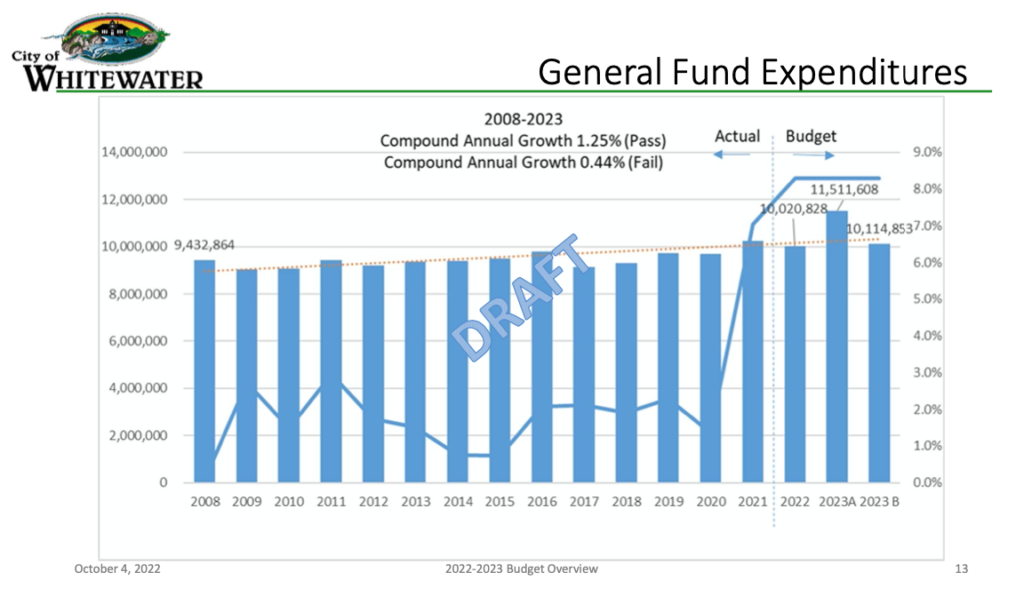
A slide shared by city officials Thursday shows the trajectory of expenditures from 2008 to present, with both draft budgets for 2023 included.
Part 2 in this two-part series, examining tax impacts associated with funding the city’s in-house fire department, is here: https://fortatkinsononline.com/whitewater-tax-impacts-associated-with-funding-an-in-house-fire-department/.
Whitewater: Tax impacts associated with funding an in-house fire department
(Originally published Oct. 1, 2022.)
Following is the second of a two-part series examining two budgets drafted for possible use in the city of Whitewater in 2023. Part two explores impacts to taxpayers in both Walworth and Jefferson counties and changes those residents can expect to see on their tax bills if the proposed EMS referendum receives voter approval in November.
By Kim McDarison
Whitewater Interim City Manager John Weidl and Director of Finance Steve Hatton Thursday provided Fort Atkinson Online with a “budget briefing,” explaining the development of two possible budgets, one of which likely will be placed in use next year.
Part 1 of this two-part series presented overviews of the two budgets. A link to Part 1 is here: https://fortatkinsononline.com/elementor-89201/.
As reported within Part 1, two budget proposals have been drafted for use by the city of Whitewater in 2023. One is developed for use if the EMS referendum question, which will come before the city’s voters in November, is approved and the second is developed for use by the city would the referendum fail.
The two budgets are as follows: in 2023, the city anticipates operating with a budget of $11,511,608, funded, in part, with a tax levy of $5,756,852. Would taxpayers approve the referendum, the city would be able to exceed the levy limit by $1.1 million “going forward,” as language within the referendum question states, meaning in perpetuity, or as long as the city deemed it necessary.
Would voters decide against the referendum, in 2023, the city anticipates operating with a budget of $10,114,853, funded, in part, with a tax levy of $4,656,852, which is the initial levy limit as imposed by state statute.
During a special Whitewater Common Council meeting held in July, Hatton presented information showing impacts to the taxpayers within the city of Whitewater derived from the city’s portion of the full tax levy paid annually by residents. Along with the city’s portion, the full tax bill includes levies from other taxing jurisdictions, including the Whitewater Unified School District, the county — Walworth or Jefferson — depending upon where within the city the resident lives, and the area’s technical college.
Adjusted mill rates from 2021
Isolating the city’s levy and using statistics from 2021, in July, Hatton said, impacts, were as follows: In Walworth County, the assessed value of the city’s total taxable assets was $657,651,199. The city’s 2022 tax levy was $3.795 million. In 2022, a Tax Incremental Finance (TIF) tax levy was $1.367 million. The impact to the taxpayer was $6.36 per $1,000 of assessed property value.
In 2021, in Jefferson County, the assessed value of the city’s total taxable assets was $92,912,384. The city’s 2022 tax levy was $405,521, with a TIF tax levy of $691,409. The impact to the taxpayer was $6.41 per $1,000 of assessed property value.
Looking at various estimated tax levy increases, which could be sought in November through the referendum process, Hatton produced several charts showing increases in mill rates and the associated impacts at differing levels of home value in both Walworth and Jefferson counties.
Hatton said the average home value in Whitewater is $206,000.

The slide above, which was initially presented to the city council in July, shows tax levied amounts assessed by the city and the associated mill rate. In 2021, city of Whitewater residents living in Walworth County paid $6.36 per $1,000 of assessed home value. City of Whitewater residents living in Jefferson County paid $6.41. The chart shows mill rate increases associated with varying tax levy amounts. Using this chart, and looking at a tax levy increase to fund the fire department of $1 million, a homeowner in Walworth County could expect to see an increase of $1.51 per $1,000 in home value, bringing their new mill rate to $7.87. A homeowner in Jefferson County could expect to see an increase of $1.53 per $1,000 of home value, bringing their new mill rate to $7.94.

With the average home in Whitewater valued at $200,000, highlighted in yellow, The slide above, which was initially presented to the city council in July, shows the tax impact as a yearly increase to a homeowner at varying levy amounts. Using this chart and with a levy increase of $1 million to fund the fire department, a homeowner with a home worth $200,000 in Walworth County could expect to see an increase of $302 to their tax bill. In Jefferson County, the homeowner could expect to see an increase of $306.
Blended rates
During Thursday’s budget briefing, Hatton presented similar figures using a “blended” illustration, which sought to create one set of statistics to represent both Walworth and Jefferson counties. Using the blended model, and using statistics from 2022, Hatton first produced a chart showing the full tax levy, with all the taxing jurisdictions represented. The full tax levy — including taxes collected to support the city at a levy of $5,756,853 (which is the amount the city would levy would the referendum receive voter approval); school district, at a levy of $7,948,419; county, at a levy of $2,547,180, and technical school, at a levy of $514,651 — is combined for a total amount of $16.9 million. The full levy to support all of the taxing jurisdictions is assessed against some $826,163,828 in total property value. To fund the full levy, the example uses a blended mill rate (defined by Hatton as a weighted average mill rate, based on equalized value in each county, used to represent rates in both Walworth and Jefferson counties) of $20.43. Within the full levy, mill rates to support each taxing district are as follows: Whitewater Unified School District, $9.69; city of Whitewater, $7.01; county, $3.11, and technical school, 63 cents.

Presented Thursday as part of the budget briefing, the chart above shows a breakdown of levies and associated mill rates for each of four taxing jurisdictions. A blended rate of $20.43 illustrates the full mill rate used to calculate tax bills for residents living within the city of Whitewater.
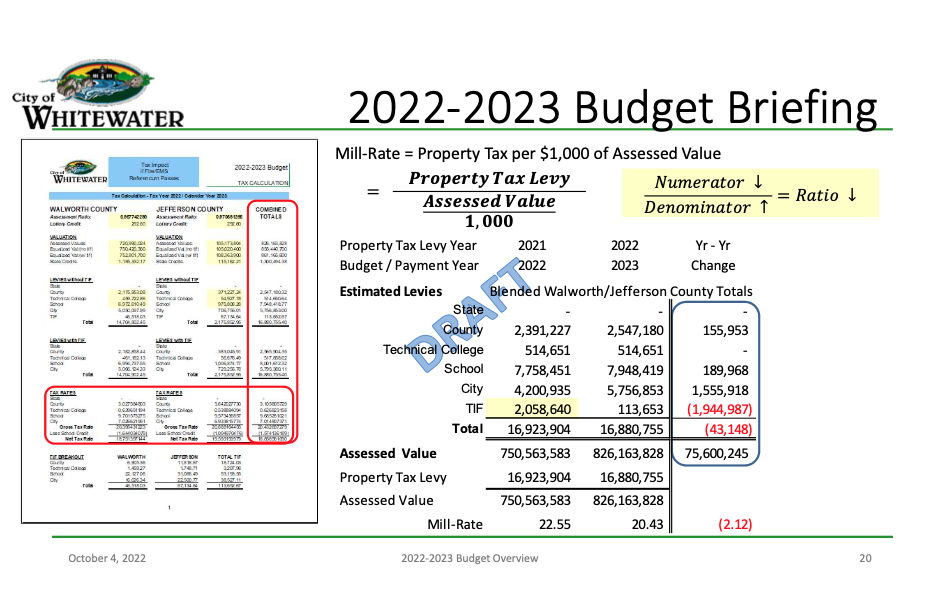
Another chart shared Thursday, shown above, is designed to show how mill rates are calculated, and, using blended mill rates, shows an anticipated reduction in the overall mill rate between 2022 and 2023. According to the chart, the blended mill rate used to collect taxes in 2021, and applied to the budget in 2022, was $22.55, as opposed to the mill rate that will be used to collect taxes in 2022, and applied to the budget in 2023, of $20.43. Additionally, the chart shows a decrease in the levy between 2022 and 2023 developed through a Tax Incremental Financing (TIF) increment of $1,944,987, which was applied to the levy, reducing the overall levy from $16,923,904 to $16,880,755, a decrease of $43,148.
Interim city manager: ‘Most’ residents will pay less taxes
During Thursday’s briefing, Weidl said that even if the city’s EMS referendum and a school district operational referendum, which also will be placed on the November ballot, each receive voter approval, the average homeowner, and even “most” of the city’s homeowners, will likely realize a reduction in their overall tax bill.
Looking at actual mill rates in Walworth County between 2021 and 2022, three of the four taxing jurisdictions are reducing their mill rates. The county mill rate will drop by 54 cents from $3.56 to $3.03; the technical college mill rate will drop by 13 cents from 77 cents to 64 cents, and the school district mill rate will drop by $2.05 from $11.75 to $9.70.
Looking at a home worth $200,000, Weidl said, if there is no change in the assessed value of the home, in Walworth County, that homeowner will see an overall decrease in their tax bill of $409. Looking at the potential for assessments to increase, Weidl said, in Walworth County the average assessed value increase is 7.8%, which would raise the value of a home worth $200,000 to $215,000. Even with that adjustment, he said, in Walworth County, that homeowner would see a decrease in their overall tax bill of $91.17.
In Jefferson County, looking at actual mill rates between 2021 and 2022, three of the four taxing jurisdictions are reducing their mill rates. The county mill rate will drop by 55 cents from $4.19 to $3.64; the technical college mill rate will drop by 33 cents from 87 cents to 54 cents, and the school district rate will drop by $2.27 from $11.84 to $9.57. If the assessed value of a home stays the same, a homeowner with a home valued at $200,000 will see a reduction in their overall tax bill of $524.59. In Jefferson County, the average assessment increase is 13.5%, which would mean a house worth $200,000 in 2021 would be worth $227,000 in 2022. In that case, he said, even with both referendums passing, the homeowner would see a modest increase in their overall bill of $33.13.
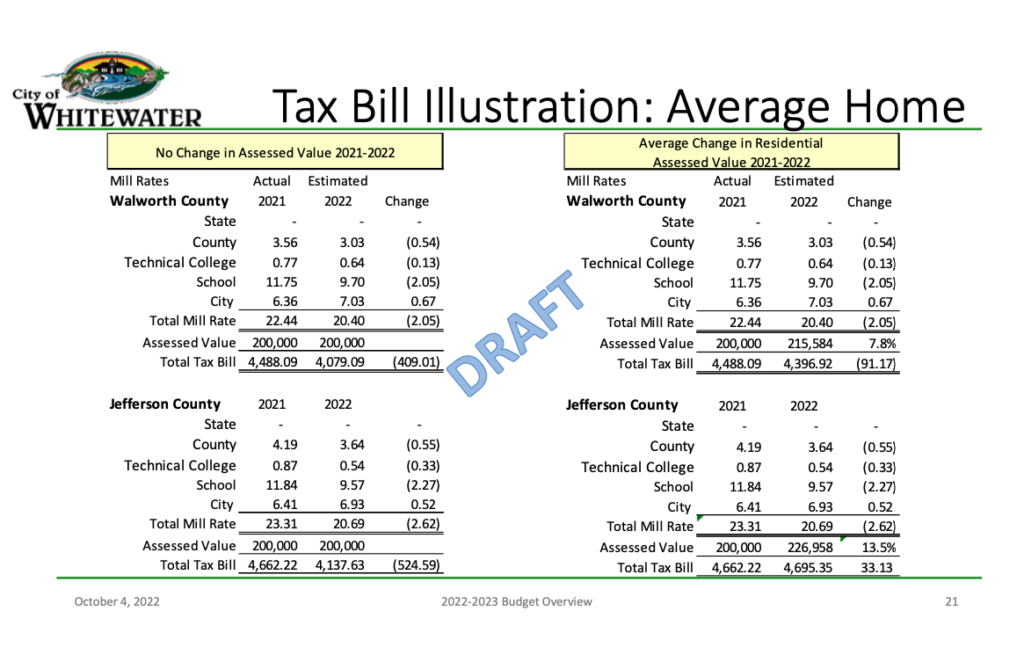
The chart above, shared Thursday, shows that while the city of Whitewater — would the EMS referendum gain voter approval in November — would increase its mill rate in Walworth County by 67 cents from $6.36 to $7.03, and in Jefferson County by 52 cents from $6.41 to $6.93, the other three taxing jurisdiction which make up the full levy for residents within the city in both counties are reducing their mill rates. The overall calculation shows a reduction in the total amount of taxes the average resident will pay even if both the city’s EMS and school district’s operational referendums pass, according to Weidl.
Information on the city’s website notes the following: “If both referendums pass, the net impact will actually be a reduction in tax bills. Due in large part to an increase in state per-pupil funding available for students within the District, the School District’s annual levy is expected to go down. The reduction in the District’s levy in combination with growth in the City’s tax base more than offsets the increase in property taxes for EMS staffing.”
On Thursday, Weidl noted that much of the city’s tax base growth is associated with the recent closing of its Tax Incremental Financing District (TID) No. 4.
With the closing of the TID, Hatton said, the city is legally obligated to return at least 50% of the increment to the taxing jurisdictions.
School district operational referendum
The Whitewater Unified School District’s operational referendum question that will appear before voters in November is as follows: “Shall the Whitewater Unified School District, Walworth, Jefferson and Rock Counties, Wisconsin, be authorized to exceed the revenue limit specified in Section 121.91, Wisconsin statutes, by $4,400,000 per year beginning with the 2023-2024 school year and ending with the 2026-2027 school year, for non-recurring purposes consisting of the following: maintaining targeted class sizes, maintaining student support and mental health services, maintaining comprehensive instructional and co-curricular programs, and maintaining technology, safety, and facilities infrastructure?”
What is tax incremental financing?
According to an overview published by the Wisconsin Economic Development Association (WEDA), titled: “Tax Incremental Financing: An Analysis of Wisconsin’s Most Important Economic Development Tool,” the Wisconsin Legislature adopted tax incremental financing (TIF) statutes in 1975. The financial tool is meant to facilitate tax base expansion within municipalities, which, in turn, is meant to create revenues to fund projects to support economic and industrial development, job growth, urban renewal and tourism.
The process allows a municipality to establish a geographical area, called a tax incremental financing district, or TID. Once established, the assessed value of the geographical area is frozen. That frozen value is called the “base value” of the TID. During the process, the taxing jurisdictions, which receive tax revenues from the TID, agree to receive tax revenues on the base value only for a set period of time. As the TID’s assessed value increases, by virtue of growth through investment over the base value, those revenues, called an “increment,” are placed in a separate fund, with those dollars used to fund investment projects over the life of the TID. When the TID closes, or sunsets, tax revenues created from the full assessed value of the TID, including the base and increment, are returned to the original taxing jurisdictions. When the TID closes, the value of the taxable property within the TID is meant to be higher than the taxable value of the property at the time that it was frozen. A goal of tax incremental financing is that the increment created within the TID will fund investment and increase the value of the property within the TID. TIDs, depending on their purpose, typically have a life of between 23 and 27 years.
Included within the process of forming a TID is the establishment of a municipal Joint Review Board. Its purpose is to approve the creation of the TID and, in so doing, determine that, “but for” the public investment afforded by TID expenditures, sufficient development or improvements within the TID would not occur.
The Joint Review Board’s voting members include representatives from the host municipality and taxing jurisdictions whose revenues will be affected by the TID, including the county and school district.
In Whitewater’s case, that also includes the area technical school.
Once created, eligible TID costs, coming in the form of investments in the TID, are paid from property tax revenues generated as increment by increased taxable property values within the district.
“TIF is not a tax cut nor a tax increase, but an allocation method for incremental property taxes collected within the district,” The WEDA document states.
Additionally, the document states, state statutes outline the maximum life of a TID, how much of a community’s value can be in TIDs, reporting requirements for TIDs, the process for creating a TID, and what costs are eligible to be reimbursed or paid out.
When creating a TID, its purpose must be designated. Wisconsin statutes currently allow for blight remediation, conservation or rehabilitation, industrial, mixed-use, town, and environmental remediation.
The full document, produced by Baker Tilly Virchow Krause LLP in 2019, is here: http://www.weda.org/wp-content/uploads/2020/01/TIF-study.pdf.
Assembly District 31 candidates respond to questionnaire
(Originally published Oct. 5, 2022.)
By Kim McDarison
A fall general election will be held Nov. 8. Residents within Wisconsin Assembly District 31 will find two names on the ballot: Democrat Brienne Brown and Republican Ellen Schutt.
In April, Wisconsin underwent a redistricting process which changed the boundaries of some legislative districts. Redistricting is a process that occurs every 10 years.
Walworth and Rock counties, in part or whole, are included in Assembly District 31. The district includes the portion of the city of Whitewater residing in Walworth County.
Both Brown and Schutt are newcomers running for the seat in the district. The would-be incumbent, Republican Amy Loudenbeck, Clinton, who has held the seat since 2013, said in advance of the August primary race that she would not seek another term as the district’s representative. Her name will appear on the November ballot as the Republican candidate running for the position of Wisconsin secretary of state.
During the August primary, four Assembly District 31 candidates came forward to vie for placement on the November ballot. Brown, from Whitewater, ran unopposed in the Democratic primary. Schutt, from Clinton, faced two challengers in the Republican primary: Maryann Zimmerman, Whitewater, and Jason Dean, Elkhorn. Schutt emerged with a comfortable margin, with 840 votes separating her from Zimmerman and 1,268 votes separating her from Dean.
In Assembly District 31, the new map includes the communities, in part or full, of Whitewater, Elkhorn, Darien, Avalon and Clinton.
An earlier story about primary candidates, which includes the Assembly District 31 map, is here: https://fortatkinsononline.com/primary-election-guide-jefferson-walworth-countywide-races-on-aug-9-ballot/.
Fort Atkinson Online recently asked Brown and Schutt to respond to a short questionnaire. Candidates were asked to keep responses to four questions to a total of between 700 and 1,000 words.
Their responses follow.

Brienne Brown
Age: 49
Address: 156 N. Fremont St., Whitewater
Occupation: Educator/Small Business Owner
Number of years resided in city: 10
Education: Bachelors of Journalism, Master’s work without thesis, University of Texas at Austin
Civic and other organizational memberships: League of Women Voters, Whitewater Grocery Cooperative, Library Board, Plan Board, Equal Opportunities Commission
Political experience: two elected terms on Whitewater Common Council
What are your reasons for seeking this position?
While serving on Whitewater Common Council, I found that I enjoy serving my community and working across the aisle to find practical solutions to local problems. My experience on the Council has given me an understanding of how the State Assembly could better serve Wisconsin’s cities and towns if politicians actually had local governing experience before running for higher office. As a small business owner, educator, and mother, I bring real world experience to obstacles facing everyday people. I’m running as a Democrat, because right now they are the party that is proposing practical solutions that do not interfere with people’s freedoms.
What are the most pressing issues facing the position you seek?
Women’s reproductive freedom, affordable healthcare, fair funding for education, support and training for public safety officers, gun safety reform, and stewardship of our land, which includes preserving family farms.
The Republican-led legislature has been in power for 12 years, and things have gotten worse for the middle class. Seventy percent of Wisconsinites believe it is government overreach to force women to have babies. Women have to drop out of the workforce to have children, because childcare is too expensive – or nonexistent. There is no real safety net in the case of divorce, sickness, or loss of a job. There is a projected $5.4 billion “surplus,” however inadequate funds were invested in our schools, cities and police departments in the first place. Land and housing is becoming more scarce and expensive, and we need to make sure that we plan in a way that moves Wisconsin and future generations forward.
If elected, what unique perspective and experience do you bring to the State Assembly?
I am a former investigative journalist who studied politics and international relations, specifically how geography influences political decisions. I moved into public health and studied the built environment and how it influences communities. In both cases I often had to follow the money. I have a 20-year history of writing winning grant proposals and funding private and state projects. Upon moving to Whitewater, I noticed that there was no town square, and I collaborated with other community members to build a farmer’s market near City Hall. Whitewater is a USDA food desert, and I am a founding board member of the Whitewater Grocery Cooperative, an initiative to build an affordable grocery store. I have an ability to tease out problems that are often ignored and the research background to find evidence-based solutions.
Any additional comments?
I am no stranger to hard work. I worked for my dad in his contracting business when I was a teenager and worked in a fish cannery in Alaska during college. My parents are Vietnam veterans (my mom outranks my dad), and I was raised hunting. I’m a gun owner who believes in common sense gun laws. My dad owned a quail farm, and my husband’s family has been farming crops for 150 years. I believe that most of the issues that we’re grappling with are truly bipartisan and that I have the experience and skill set to work across the aisle and make decisions that benefit all Wisconsinites.

Ellen Schutt
Age: 26
Address: Clinton
Occupation: Legislative assistant
Number of years resided in city: I am a lifelong resident of the 31st Assembly District. I grew up in Darien on my family’s farm and my husband and I now live in Clinton and have for the past two and a half years.
Education: University of Wisconsin-Madison, 2017, Political Science B.A.
Civic and other organizational memberships: I am a member of the Rock County Farm Bureau, the Clinton Community Historical Society, and a lifetime member of the Walworth County Fair.
Political experience: I am a member of both the Rock and Walworth County Republican Party, and a board member of the South Central Wisconsin Young Republicans. Since 2018, I have worked on a number of state legislative campaigns as well as working as an aide to conservative legislators in the state capitol.
What are your reasons for seeking this position?
I’m running because I am thinking about the next generation. I want to make sure that the generations after me have the same opportunities that I did. I recently got married, and my husband and I are thinking about starting a family, and we are concerned about the world our children might grow up in. I want to be a part of the solution to the challenges Wisconsin faces going forward and make sure we think about how each and every decision made in Madison will affect the future generations.
What are the most pressing issues facing the position you seek?
The most important issues I hear about as I have met with people across the district at community events, parades, and their doorstep are regarding record inflation and the economy, rising violent crime and support of first responders, and ensuring our smaller communities and rural Wisconsin doesn’t get left behind.
If elected, what unique perspective and experience do you bring to the State Assembly?
I will bring a unique perspective to Madison that emphasizes the importance of our rural and smaller communities. I grew up on my family’s farm in rural Walworth County, and I continue to help out on the farm to this day. I understand the issues facing farmers, and our smaller and rural communities and will provide a voice for them in Madison. I also believe I have great experience in both the public and private sector. I have worked numerous jobs in the private sector, and have worked for a number of state representatives, including our current representative Amy Loudenbeck. I learned a lot from each of them – not just about public policy but also about management. I understand what it takes to accomplish things in Madison and get results for your constituents. If elected, I will be able to hit the ground running working for the people of the 31st Assembly District.
Any additional comments?
None cited.
Whitewater: Council receives referendum presentation from school district
(Originally published Oct. 6, 2022.)
Update: The following information was recently released by the Whitewater Unified School District: WUSD taxpayers will realize a lower than expected levy rate after the school board approved the district’s 2022-23 budget. As a result, the tax levy will decrease by about 7% from the previous year, with a mill rate of $8.76 per $1,000 of assessed property value. This marks a decrease from the originally projected rate of $9.91 per $1,000 of assessed property value.
By Kim McDarison
The Whitewater Common Council Tuesday received a presentation from several members of the Whitewater Unified School District outlining the district’s ask for a $17.6 million operational referendum.
The referendum question, which will appear on the November ballot, asks voters to extend an operational referendum approved in 2018. Would voters make that approval, the extension would allow the district to continue to operate with taxpayer-supported revenues above its state-imposed levy limit by $4.4 million over each of the next four years.
Voters within the Whitewater Unified School District on Nov. 8 will find the following question on the ballot: “Shall the Whitewater Unified School District, Walworth, Jefferson and Rock Counties, Wisconsin, be authorized to exceed the revenue limit specified in Section 121.91, Wisconsin statutes, by $4,400,000 per year beginning with the 2023-2024 school year and ending with the 2026-2027 school year, for non-recurring purposes consisting of the following: maintaining targeted class sizes, maintaining student support and mental health services, maintaining comprehensive instructional and co-curricular programs, and maintaining technology, safety, and facilities infrastructure?”
District representatives making the presentation to council Tuesday included Superintendent Caroline Pate-Hefty, Board of Education member Larry Kachel and Director of Business Services Ben Prather.
Impacts to taxpayers
Aided by a series of slides, the district’s representatives noted that would the voters approve the referendum in November — voting to continue funding the $4.4 million above the state-imposed limit — the district’s levy and mill rate to support the 2022-2023 school year would decrease from the levy and rate paid to support the 2021-2022 school year.
Looking at the full budget, the team stated that the school district operates annually using a budget of approximately $28.3 million. In the 2021-2022 school year, the taxpayer-supported portion, called a levy, of that budget was $18.3 million. This year, resulting, in part, from early payments made to reduce a debt obligation, the district is projecting a levy of $16.8 million, lowering the levy by approximately $1.4 million.
The district serves, in part or whole, several communities, including the city of Whitewater and the towns of Cold Spring, Koshkonong, Johnstown, Lima, LaGrange, Richmond, Sugar Creek and Whitewater. The portion of the school district’s levy paid by city of Whitewater taxpayers is approximately $8 million. Residents in the city of Whitewater also will find a referendum question on the November ballot, asking for $1.1 million in revenue above the city’s state-imposed levy cap to fund expenses associated with a new in-house fire and EMS department.
A story about the impact to taxpayers in Whitewater should both referendums receive voter approval is here: https://fortatkinsononline.com/whitewater-tax-impacts-associated-with-funding-an-in-house-fire-department/.
Looking at districtwide taxpayer impact, Kachel said: “There would be no property tax increase if this referendum is approved by the voters on the part of the school district.”
A slide noted that the current levy is $18,256,742 with a mill rate at $11 per every $1,000 of fair market property value. The projected levy, with an approved referendum, would be $16,946,148, with a mill rate of $9.91 per $1,000 of fair market property value.
Presenting a slide showing a “taxpayer estimated analysis,” and using equalized property value, the district produced several examples showed anticipated tax impacts to homeowners within the district. According to the slide, a taxpayer within the district with a home valued at $100,000, would have paid $1,100 last year in support of the school district’s levy. This year, the homeowner, would the referendum pass, could expect to pay $1,004. Looking at a home within the district valued at $200,000 — which city officials have said is the average value of a home in the city of Whitewater — the taxpayer would have paid $2,200 last year and could expect to pay $2,008 this year.

Referencing an operational budget slide, shown above, Pate-Hefty said that more than 70% of the district’s $28.29 million budget is used to support salaries and benefits for those working in the district.
“This is really common in public schools,” she said, adding: “We’re a human-rich field serving little humans.” She continued: “There is not one segment of that pie that this district can take out and say, ‘well, we’ll just cut that program or cut that service.’ These are critical services for our kids.”
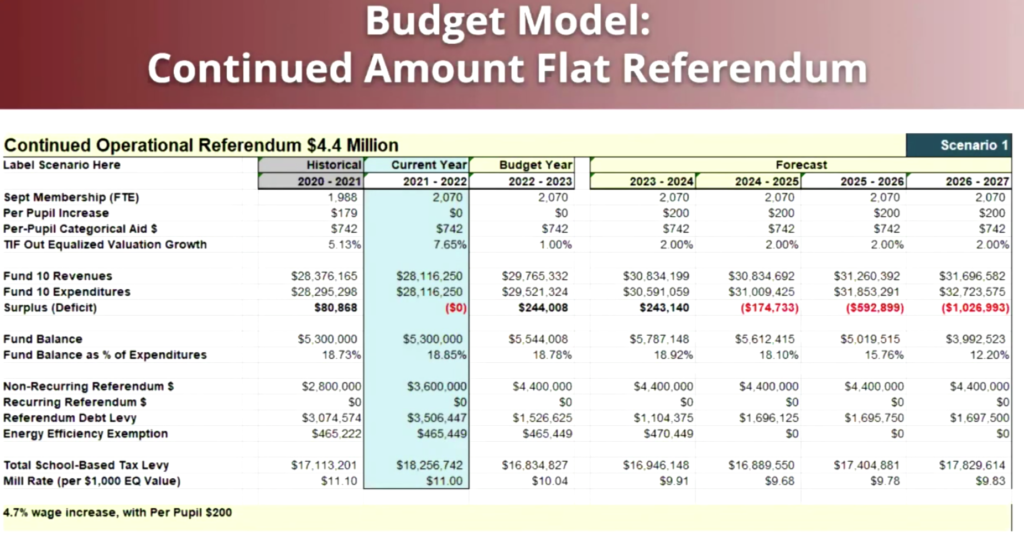
Pointing to a “budget model,” Prather said the slide, shown above, offers a budget projection beginning with the 2021-2022 school year through to the 2026-2027 school year.
“You can see that currently, 2021-22, we had an $18.2 million levy. Going forward, we’re trying to control that amount to keep it under that amount, and that’s also going to reduce the mill rate. Some of these things can fluctuate based on equalized value of property and also based off of our enrollment growth or decline,” he said.
Pointing to a line on the chart labeled “referendum debt levy,” Prather noted that this year, the debt was listed at $3.5 million. Going forward, he said, payments will bring the debt to $1.5 million next year, and continue to lower debt each subsequent year.
“So we are able to save that projected $2.5 million in these interest costs alone by being fiscally responsible and paying that long-term debt off early,” Prather said, adding: “Overall, we’re able to say we can reduce the overall levy because we paid off that debt.”
“These levy projections assume flat enrollment growth, equalized value growth of 2% and standard debt levy. The district is in the process of defeasing Fund 39 debt, which will reduce the debt levy moving forward,” Kachel said.
A larger representation of the budget model above can be viewed here: http://fortatkinsononline.com/wp-content/uploads/2022/10/Screen-Shot-2022-10-06-at-10.07.56-AM.pdf.

The upper half of the slide above shows the portion of the district’s tax levy collected from taxpayers within each of the municipalities the district serves. The lower half of the slide offers several examples of impacts to taxpayers based on the equalized value of a home.
“The takeaway here is that the mill rate’s going to go down and our levy is going to be reduced as well,” Prather said.
A larger representation of the Taxpayer Estimated Analysis slide is here: http://fortatkinsononline.com/wp-content/uploads/2022/10/taxpayer-estimated-anaylsis-pdf.pdf.
Why is the referendum needed?
During the presentation, Kachel told those in attendance that the referendum approved by voters in 2018 “has been critically important to our district’s operations and more important for the ability of our schools to provide programs and services to students.
“If our district is to continue to have access to these funds, we need to return to voters for a replacement referendum.”
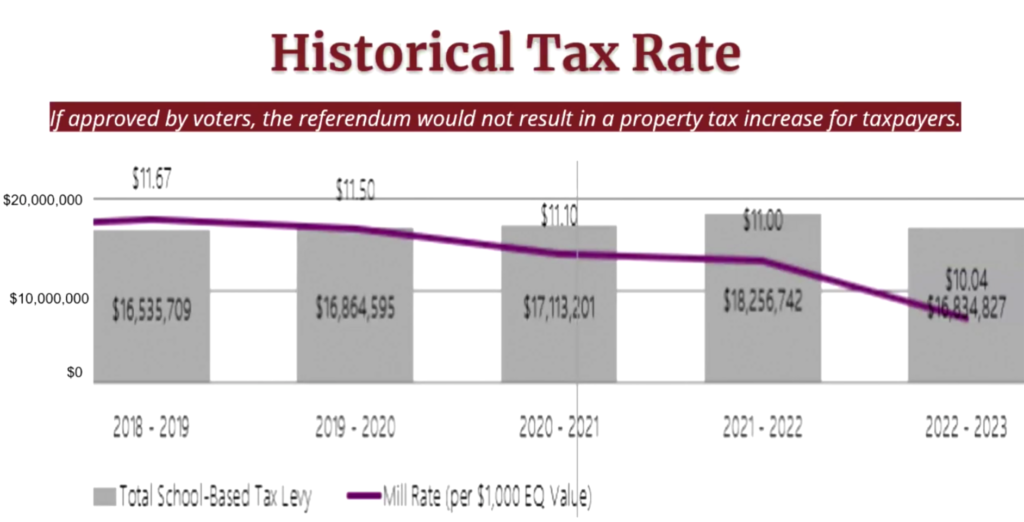
Pointing to a slide, shown above, Kachel said: “The grey bar represents the total school-based levy for our district, while the purple line represents the mill rate or property tax rate for the school district’s portion of the tax bill. The mill rate has steadily declined in recent years, and would continue to do so even with approval of our referendum.”
According to the graph, in school year 2018-19, the levy was $16.5 million with a mill rate of $11.67; in 2019-20, the levy was $16.8 million with a mill rate of $11.50; in 2020-2021, the levy was $17.1 million with a mill rate of $11.10; in 2021-22, the levy was $18.2 million with a mill rate of $11, and projected for 2022-23, the levy is $16.8 million with a mill rate of $10.04.
Said Prather: “So many of you might be asking, why are referendums necessary for school districts? A major reason is that it’s tied to a 1993 state statute where what we were spending in ’93 is what the state locked us into. So, as you know, 30 years have gone by and costs have changed.”
Addressing costs, he said: “So, just the day-to-day fuel for buses; one major cost we’re seeing is an increase in special ed needs, as well as metal health, and so those are a lot different than they were in ’93. So between the revenues locked in and also our expenditures going up, and just day-to-day things that everybody’s feeling right now, especially with inflation, that’s why we need a referendum.”
“The State Department of Public Instruction says that they do not believe there is any chance the school funding formula will be changing anytime soon. This means districts like ours will continue to need operational referendums to avoid significant cuts to programs and services,” Kachel said.
He added that Whitewater is among 130 districts in Wisconsin that have brought operational referendums before voters in the past decade. Communities have approved about 72% of those referendums.
Since 1993, when the funding system used by the state was put in place, Whitewater has “engaged in this operational referendum process 10 times,” Kachel added.
Student populations and needs
According to Pate-Hefty, the school district has 2,003 students. Data presented in a slide offered information about the student body based on an enrollment of 1,949 students, which, she said, “is our last verified data.”
Among students in the district, some 50% are within a range that qualifies them for free or reduced lunch programs. Pate-Hefty said she anticipates that the number will increase. Some 13% of students within the district are English language learners, defined as students who speak a language other than English at home. Another 19% of the district’s students are enrolled in special education.
“Just to give you some context, about 10-13(%) is a national average for special education. I also want to share some regional data with you so you know where we stand regionally. But that 19% is high. And that’s what happens when you do really amazing things serving students. Our families come back and they let other families know that we’re a great place to serve our students,” she said.

The slide above, as shared by Pate-Hefty, shows the breakdown of student needs and populations within the Whitewater Unified School District.
Students with unique needs require additional funding and resources to ensure high-quality services, Pate-Hefty said. Growth in the district’s economically disadvantaged population and students with disabilities has been steady over time. A slide showed that between 2016 and 2021, the district’s economically disadvantaged population grew from 41 to 50% and the district’s students with disabilities population over the same period grew from 17 to 19%. Both growth trajectories place the district above the state average, according to the slide.
“Our students with disabilities rate has always been over the national average. Some of that is accounted for in that we serve three counties, but one of our largest counties is Walworth, and in Walworth we have a special education facility that can be serviced or provided for students, and so that attracts some percentage of families as well,” Pate-Hefty said.
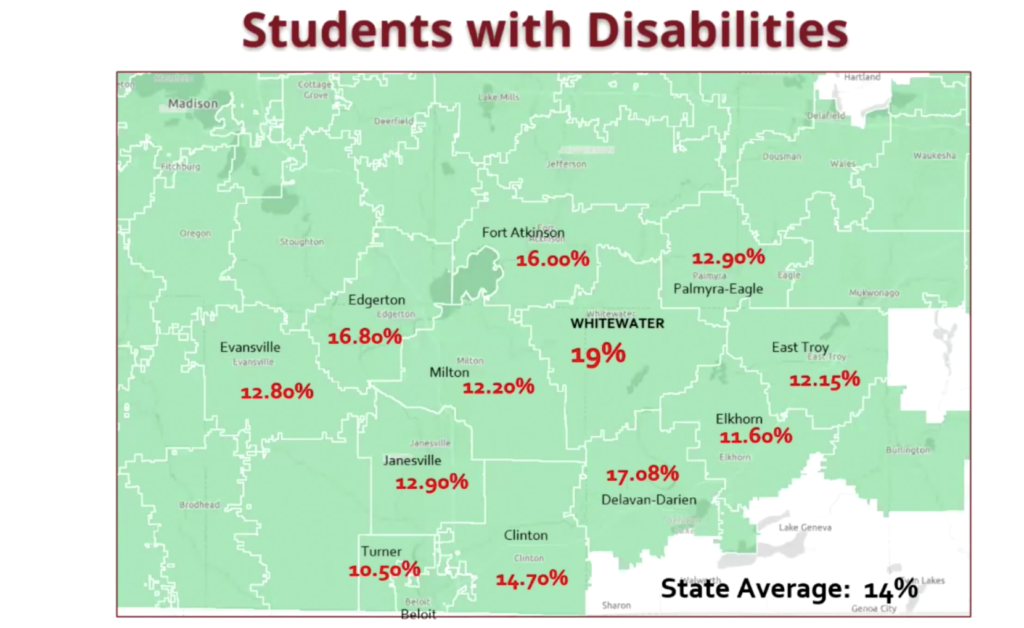
The above graphic, presented Tuesday, shows the percentage of students with disabilities within each school district’s population. The state average is 14%.
Said Pate-Hefty: “So Whitewater is right there in the middle. Again, students with disabilities rate is 19%, and you can see we are significantly above those around us in terms of service. So when you hear cost of students and service, this is a connection that’s directly related … we’re legally required to provide things like OT (occupational therapy), speech, PT (physical therapy) and other services to make sure that they are reaching their potential.”
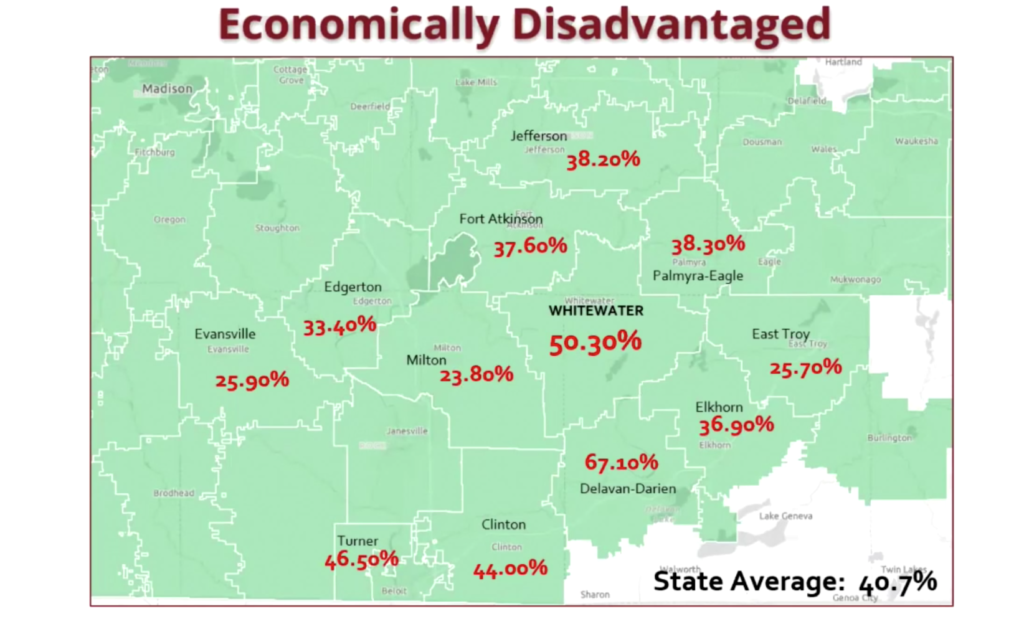
The above graphic, presented Tuesday, shows the percentage of students who are economically disadvantaged within each school district’s population.
Said Pate-Hefty: “Again, economically disadvantaged, we are only below Delavan-Darian (school district) in the area. The state average is about 40%, so we’re above that in comparison with regional school districts.”

The above graphic, presented Tuesday, shows the percentage of students who are English language learners within each school district’s population. The state average is 2.8%.
Said Pate-Hefty: “So we are inline with a couple of communities as far as English language learners. We expect this to go up. A snapshot was taken prior to about 120 new students moving in last year from Nicaragua, and so those students have needs related to acquiring English and kind of supporting them being part of our community.”
Programs
Pate-Hefty next talked about programming within the district, noting, in some cases, a need for creative thinking.
“Our teachers will tell you and our staff will tell you that students’ needs around depression and anxiety following COVID have been intense. We are trying to be creative with funds that we can have in the community. So we wrote a grant to have “Project Winston.” He’s our therapy dog and he will be reporting in January over at Washington school to support our students,” she said, adding that the district also has a therapy dog at the high school.
Prather listed several programs, which he described as among those “we absolutely value,” including growth in the district’s middle school tech program; “Whitewater Builds,” a summer school program through which students this year built three sheds and donated them to area veterans; K-12 Drama and Theater, which, he said, will extend programming to the elementary-school-level, and Project Lead the Way, a STEM program that has been successfully piloted in two of the district’s three elementary schools.
Pate-Hefty said approval of the referendum by voters would protect robust academic and athletic opportunities, citing athletic programs offered at the fifth-grade level, which, she said, are “really competitive now with the region, and that’s a new change we made.”
Additionally, she cited “Ferradermis,” which she described as a robotics program with nationwide recognition.
“Student support and mental health services are critical,” she said, citing as example the displacement of a family recently resulting from a situation within the home.
“That included a significant travel of 45 minutes away. That enacted the McKinney-Vento (Homeless Education Assistance) act because they become homeless, and we had to make sure that all seven kids could come to school and receive services based on their experience and stabilize them in our schools. And that’s a reality of what public school looks like. The referendum will protect those metal health services,” she said, adding that the district has a clinician in every school building and career, mental health and social needs counselors that support students.
Citing advancements in comprehensive instructional and co-curricular programs, Pate-Hefty said: “We revamped math curriculum this year and adopted a new math curriculum that we’re really excited and proud with called Bridges, very research-based. Our elementary schools are implementing that. Our teachers are receiving professional development around that. We started the year learning about positive ways to communicate as teachers in the field; we call it Professional Learning Communities. Our teachers are also receiving professional development around strategies for multilingual learners so that we can continue to help them excel. And then expanding that career and tech ed segment that Ben mentioned to you previously.”
Questions from council members
After the presentation, council members were offered an opportunity to ask questions.
Councilwoman Brienne Brown asked: “I’ve been to a couple of your presentations, and the question that pops up often is how you used the ARPA (American Rescue Plan Act of 2021) funding. I’m wondering if you’re going to be putting that into your presentations or are you just waiting for those questions to pop up later so you can explain how that money was spent?”
Pate-Hefty responded: “We’re glad to talk a little bit about that. There were requirements from the federal government for how that funding was spent. And it was intentionally outlined to be spent to generate the economy. So that included some provisions; we could spend it on HVAC, which we did, you could spend that on recoupment and recovery for students or you could reinvest in your operational budget so that you could expend and save in your budget for long-term projects, which is exactly what we did. And so we invested — one of the projects that that allowed us to invest in was fields. Since 2008, the school board has been considering a fix — this is long before this administration and even that rotation of the board, but the board has been looking for a fix for flooded fields. We serve over 600 students in our athletic programs and it was a regular kind of story for them that their seasons were canceled and that they were shop-vaccing our fields so that they could have their events. So our families came out hard, and from the athletics, to say, ‘hey, this is really important to us.’ We were able to, without asking the taxpayers for support — local communities by us, Delavan-Darian just did a remodel to their fields and had to go to the taxpayers and ask for that. Within our budget, we were able to reapply those funds so that we could update fields and all 600 of our athletes now play in the stadium for all of their events.”
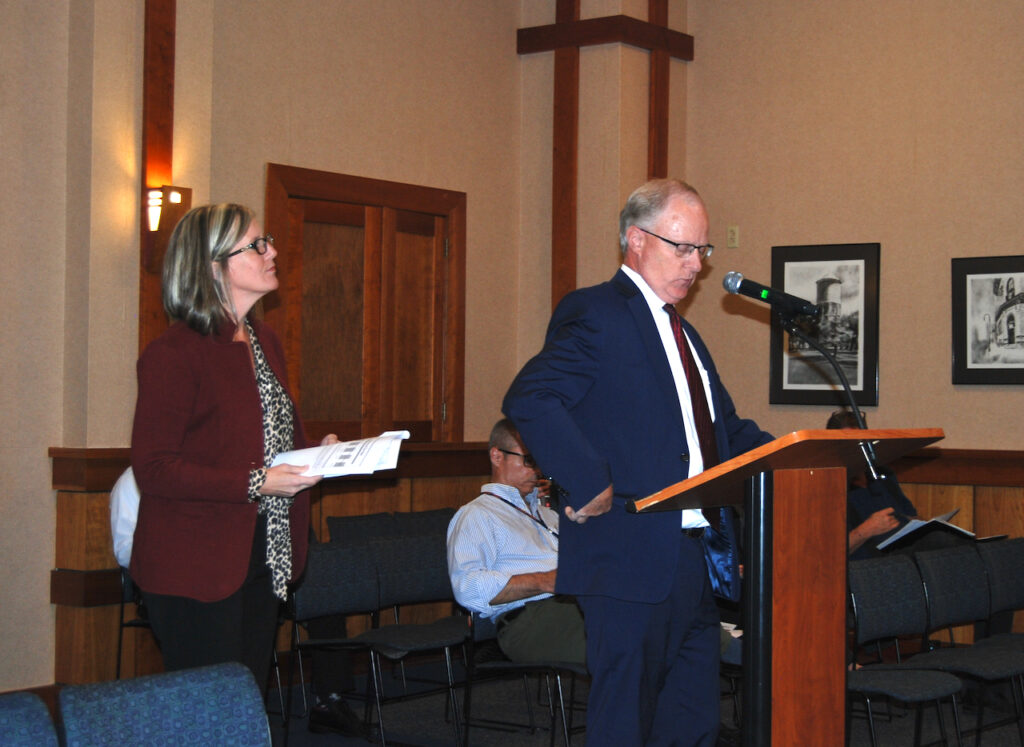
Whitewater Unified School District Superintendent Caroline Pate-Hefty, from left, and Whitewater Unified School District Board of Education member Larry Kachel address the Whitewater Common Council Tuesday. The two, along with a third district representative, Ben Prather, not pictured, gave a presentation about the history, tax impacts and programming needs associated with the district’s proposed operational referendum. A referendum question will appear before the school district’s voters in November. Kim McDarison photo.

A slide, as presented by the Whitewater Unified School District, shows proposed outcomes would voters approve the four-year operational referendum.
Whitewater: Council receives city manager recruitment update; committee to meet ‘initial applicants’
(Originally published Oct. 8, 2022.)
By Kim McDarison
The City of Whitewater Common Council Tuesday received an update about the process underway to hire a city manager. The update was presented by Human Resources Coordinator Judy Atkinson.
During the presentation, Atkinson said the city’s search committee had plans to meet on Friday with the city’s GovHR USA-appointed liaison Lee Szymborski who would apprise them on the recruitment process. After Friday’s meeting, a next step would take place on Wednesday, Oct. 12, and Thursday, Oct. 13, at which time the search committee would conduct interviews with at least eight candidates using the Zoom platform.
Members of the city’s search committee include council members Lisa Dawsey Smith, Carol McCormick and Jim Allen, along with members of city staff. They are: Atkinson, Finance Director Steve Hatton, Director of Public Works Brad Marquardt and Police Chief Dan Meyer.
A search for a city manager became necessary after former City Manager Cameron Clapper tendered his resignation in June. Clapper accepting a position as county administrator in Dodge County, assuming that role in August.
An earlier story about Clapper’s appointment as administrator in Dodge County is here: https://fortatkinsononline.com/dodge-county-board-hires-whitewaters-city-manager/.
GovHR, a third-party recruitment firm based in Northbrook, Ill., was hired by the city in July to assist with the recruitment process.
Within its proposal, the company offered a six-phase process with a timeline for completion of 14 weeks.
The company was hired at a cost of $23,500, excluding any consultant travel expenses, Atkinson told council within her presentation.
An earlier story, including the six-step recruitment process as outlined by GovHR, is here: https://fortatkinsononline.com/whitewater-council-hires-govhr-to-conduct-city-manager-search/.
The recruitment process
Said Atkinson: “I wanted to share with you our timeline because I know that there have been some questions about the process.”
Thus far, she said, aided by Szymborski, the city has completed the information gathering phase.
Describing activities completed by Szymborski, Atkinson said he had compiled information, created a position announcement and recruitment brochure, and posted the announcement, which remained open until Sept. 23. He next reviewed some 30 applications that were received in response to the posting, interviewed the pool of candidates and conducted background and reference checks.
“He did his due diligence,” Atkinson said, adding that she was “very pleased to hear” that the city had attracted 30 candidates.
From the initial pool, she said, Szymborski “boiled it down to 12.”
He next facilitated Zoom interviews with the reduced pool of applicants.
During the process, Atkinson said, two candidates withdrew their applications after accepting positions elsewhere.
On Tuesday, Atkinson said that Szymborski would, on Wednesday, Oct. 5, present the city with a portfolio of eight applicants.
On Friday, Oct. 7, the search committee was scheduled to meet with Szymborski to discuss the continuing process, Atkinson said, which included making preparations in advance of Zoom interviews conducted with the committee, anticipated to take place Wednesday and Thursday of next week.
“Following those Zoom interviews, Mr. Szymborski will review the feedback on the applicants and discuss with the search committee who to move on for the final interviews,” Atkinson said.
She noted that the city was hoping to complete the recruitment process by the end of October, a goal she described as “very ambitious, but I think we can do it.”
Looking at final, in-person interviews, she said, the process would include the city council, city staff leadership, and also community stakeholders.
“It will also include a community meet-and-greet for the community members to meet the candidates,” Atkinson said.
She added: “Following all of those steps, Mr. Szymborski will debrief with each of the panels — the interview panels — and then provide the common council with that feedback so (it) can then deliberate and make a hiring decision.”
Final steps, Phase 5 and 6
According to information presented to council by GovHR in July within its recruitment services proposal, Phase 5 within the process includes the interviewing process and background screenings, the development of a first and second round of interview questions, coordination of travel and other accommodations for the candidates, and GovHR will provide the client with an electronic file that includes the candidates’ credentials, a set of questions with room for taking notes, and an evaluation sheet to assist the interviewers.
GovHR will also coordinate a two-step interview process.
According to the document, the first round will include four or five candidates, and a second round will include two or three candidates.
Along with the structured interviews, GovHR will facilitate tours of the client’s facilities and interviews with senior staff.
In Phase 6 of the process, GovHR will assist the client as much as the client requests with salary and benefit negotiations, and drafting an employment agreement.
GovHR also will notify all the applicants of the final appointment, the document stated.
Who is Szymborski? GovHR?
Within her presentation, Atkinson offered biographical information about Szymborski, describing him as a senior vice president, a project manager and the main point of contact for the city. She noted his more than 33 years of experience in local government administration in Wisconsin and Illinois, further citing his education, which, she said, includes a masters of science degree in urban affairs and a bachelors of arts degree in political science.
Biographical information about Szymborski, as presented on the GovHR website is here: https://www.govhrusa.com/associates/lee-szymborski/.
Offering information about GovHR, Atkinson said: “GovHR is well-known in the city manager recruitment profession and the firm is well-established with years of experience and a solid reputation for being effective and capable, as well as a good partner to work with, which I can attest to.”
Atkinson noted that using a third-party managerial recruitment firm “is common among municipalities in Wisconsin and also nationally.”
The company’s website is here: https://www.govhrusa.com.

Whitewater Municipal Building, file photo/Kim McDarison.
Whitewater: Council postpones ordinance allowing golf carts on city streets
(Originally published Oct. 10, 2022.)
By Kim McDarison
The Whitewater Common Council Tuesday postponed the advancement of an ordinance allowing the use of golf carts on city streets.
The action returns the ordinance to city staff, charging it with crafting language to include several proposed amendments, such as allowing golf carts to travel for “short distances” on city sidewalks.
After engaging in an hour-long discussion, council approved the motion to postpone the ordinance, which had come before it for its second and final reading, by a 4-3 vote, with council members Jim Allen, Brienne Brown and Greg Majkrzek voting against the measure.
A first reading was approved during a council meeting held Sept. 20.
During Tuesday’s discussion, Majkrzek said he had been involved with developing the ordinance for “almost a year.” He noted his disappointment with the council’s decision to postpone its passage.
The ordinance before amendments
Language within the ordinance, as presented Tuesday, defined golf carts as “a vehicle designed and manufactured with limited speed capabilities that does not exceed 20 miles per hour on a paved, level surface that is designed and intended to convey one or more persons.”
The proposed ordinance allows for the modification of golf carts to “allow extra seating in the area originally designed to carry equipment.”
Additionally, the ordinance defines public roads as “any city road, street or highway located within the city boundaries designed to accommodate motor vehicles,” with the exclusion of state- and county-owned roads.
Within the document, Business Highway 12, State Highway 59 and Janesville Street are excluded from golf cart use. Golf carts would be allowed to cross those roads at intersections while traveling on city-owned roads. Golf carts would be allowed to operate on city roads at a speed limit of 25 mph or less. Golf cart use is restricted to roads with a posted speed limit of 25 mph.
All golf carts intended for use on city-owned streets must be registered with the city clerk, language states. Registrations would remain valid for three years. Permits to operate, as provided by the city, must be prominently displayed on the “rear fender of the golf cart,” the ordinance stipulates.
To receive a permit, the owner of the golf cart must provide, along with identifying information, proof of insurance and “any such other information as may be reasonably required.”
A valid drivers license is required to operate a golf cart on city streets.
Golf carts operating on city streets must be equipped with functioning brakes, reliable and accurate steering apparatus, safe and proper tires, a rearview mirror, and red reflectors or tape on the front and rear bumpers.
Golf carts may only be operated on streets between sunrise and sunset.
All passengers must be seated.
Children who are of an age and size that federal law would require them to use child restraint equipment may not ride in golf carts operating on city streets.
Golf carts must be operated in single file, and as close to the right-hand side of the street as possible. Hand signals when making turns are required.
Golf carts are not allowed to operate on sidewalks other than when crossing them to access a public road.
Golf carts may not be operated in areas not designated for motor vehicle use, including public parks, grassy areas and public walkways. An exception, as stipulated in the ordinance, is the University of Wisconsin-Whitewater path between West Schwager Drive and Burr Oak Trail. The exception is followed by language stating: “if it is allowed by the University of Wisconsin-Whitewater.”
Golf carts must display a “slow moving” emblem as required by state statute.
All the applicable “rules of the road” apply to golf cart drivers, including those that apply to use of alcohol and traveling with open containers of alcohol.
Majkrzak reminded council on Tuesday that during its first reading, the ordinance was amended to include a registration process which would require renewal every three years. The registration was developed to provide city officials with the ability to identify golf cart operators using city-owned streets and came with no associated fee.
Amendments discussed Tuesday
Councilwoman Jill Gerber, during Tuesday’s discussion, proposed an amendment to language allowing golf cart use on city streets between “sunrise and sunset,” changing it to reflect statutes regarding the use of motor vehicles. Citing state statutes, she said “hours of darkness,” as defined by state statutes, means the period of time from one-half hour after sunset to one-half hour before sunrise and all other times when there is not sufficient natural light to render clearly visible any person or vehicle upon a highway at a distance of 500 feet.
Allen said that the words, sunrise to sunset, were chosen to simplify the language.
“When I was talking to (City Attorney) Wally (McDonell) about this, the reasons that we thought, at least that I thought we ‘d leave the registration fee zero, and the fines minimum, is that, in case Jill (Gerber) or the chief’s nightmares came true, and that every student on campus bought a golf cart, that this would be our way of controlling it, by registration fees and fines, so it gives us a couple more tools in the box in case something terrible would happen,” Allen said.
Gerber said she would prefer to see the registration period changed from every three years to annually, and suggested the inclusion of a registration fee of $25.
“I noticed the other communities were charging $25 annually. I’m not sure why we are offering this at no charge,” she said.
Additionally, she said, she was confused by the ordinance’s acceptance of golf carts operating on city streets while it excluded low speed vehicles.
“How is one, such as the police department, to decipher between a golf cart and a golf cart that is a low speed vehicle?” she asked.
Citing a third concern, she said: “I don’t see the agreement in here that I believe (council member) Lisa Dawsey (Smith) asked you for in regards to use of the sidewalk, or the pathway, from Prairie Village, to be able to access around Fremont Street.”
Regarding sidewalk use by golf cart operators, she said: “Overall, I’d like to just remove it, if I could, from citywide, and just keep it from Prairie Village down to Fairhaven, but the way its written, it’s citywide.”
Addressing council from the podium, Whitewater resident Jerry Wendt said he was in support of the ordinance and a provision that would allow him to use a golf cart to travel between two senior care facilities in Whitewater: Prairie Village, 817 Burr Oak Trail, and Fairhaven, 435 West Starin Rd.
Wendt said he was concerned that the ordinance as drafted in advance of its second reading did not allow use of golf carts on sidewalks.
“Remember that the big concern is safety and accessibility,” he said.
He offered four examples of situations where, he said, he believed allowing golf carts to operate on sidewalks would constitute the safest option. In his first example, he talked about another resident, Rollie Cooper, who owned adjoining properties. The resident’s home was on one property and his barn and farm were on the second. Citing the ordinance as written, he said, when Cooper wanted to go from his house to his barn, he would have to drive his golf cart into the street. He argued that Cooper should be allowed to use the sidewalk.
In his second example, he cited golf carts associated with the University of Wisconsin-Whitewater which travel along Prairie Street. He said the street was very busy, adding: “It would be ridiculous to say, ‘oh, because the ordinance is you can’t be on the sidewalk, you must go out in the street.’ That doesn’t make sense.”
He next cited his own desire to travel by golf cart between Prairie Village and Fairhaven. He noted his preference to use the sidewalk.
“It’s 100 times safer,” he said, adding that as his fourth example he would also like to use his golf cart to travel along the various paths along Whitewater Creek. He dubbed the path system “Creekside Parkway,” outlining a path he might use, traveling between North, Starin and Fremont streets. Looking to the future, he said, he believed one day the city would extend the system to County Trunk U.
“I can think of no practical reason why I cannot take my golf cart or a golf cart owned by Fairhaven and drive it on the Creekside Parkway. It’s safe, and you could only drive on the sidewalk on a very slow speed. We do not want golf carts going 25 mph on sidewalks, absolutely,” Wendt said.
Offering explanations for the various clauses in the ordinance, Majkrzek said when he began exploring the possibility of writing an ordinance to allow golf cart use on city streets, interest in and support of the idea came first from residents within Fairhaven and Prairie Village.
During meetings with the two groups of residents, Majkrzek said they expressed a desire to travel by golf cart to the city’s library, weekly market and downtown business district. Majkrzek described restrictions within the proposed ordinance as “appropriate,” further noting a decision to include all of the city’s roads so as not to restrict access within some of the city’s neighborhoods.
“Sidewalks, when we first brought this up even with the scooters, sidewalks is a big sticking point. We can’t ride scooters — we’re not supposed to — ride scooters on sidewalks … we’re not supposed to ride bicycles on sidewalks, and when we talked about allowing just sidewalks for this, it was a nonstarter with staff. So that’s where we ended up with the streets,” he said.
City officials and staff participating in developing the ordinance also looked at creating “routes” for carts, he said, adding that “it became very complicated. We were starting to dictate who could go where based on the routes.”
He described a process used to gain feedback from UW-Whitewater officials, noting that he talked with the university’s risk management team, who, in turn, spoke with the campus police department. Language in the ordinance allows flexibility, Majkrzek said, adding that would there becomes concerns with golf cart use on sidewalks along Fremont Street, the city or the university could revoke the privilege.
Addressing concerns about low speed vehicles, Majkrzek said he was unfamiliar with the vehicle classification, only learning of it recently through Gerber. Addressing Gerber, he said: “I think including it in this, I’m not entirely against it, but I would suggest that if you have a strong interest in LSV that you bring an ordinance forward.”
Majkrzek said he had himself considered adding the “hours of darkness” stipulation as outlined by state statute, and addressing concerns with busy streets, he said he believed golf cart operators would look themselves for less busy alternative routes, ones with which they felt comfortable.
Assessing traffic on streets, he said: “It’s not busy all the time, It’s busy during certain times, and that’s a true statement for all of our streets.”
Allen said golf cart use on campus is only allowed on sidewalks. Operators take an online exam and promise to travel at speeds up to 5 mph.
“So we’re kind of flip-flopping here,” he said.
According to Allen, when cart drivers encounter pedestrians on campus, the have the option to wait or go around them on the grass.
“I don’t see that as an issue,” he said, adding: “I sure would like to be able to see them (golf cart operators) use the footbridge and bicycle paths along the creek.”
Majkrzek suggested approving the ordinance, with the understanding that the issue of adding sidewalks could be discussed at a later date.
Allen said that was not his preference.
Responding to questions asked by council, addressing the issue of hours of darkness and language using the words sunrise and sunset, Police Chief Dan Meyer said: “My take is for officers, we’re going to have to look up the specific time regardless of what the decision is to make sure, if we have to cite for it, it’s legitimate. I think the more light, the better, just for safety purposes.”
Responding to questions about the use of sidewalks, Meyer said: “I would not be in favor of use of sidewalks. My understanding on why that is such a sticking point is because those are intended for pedestrians, and if you are going down the sidewalk, and you come upon a pedestrian, then what? You’re kind of stuck, unless you’re going on someone’s property.”
During discussion, council members sought to craft language and make amendments that could be included within the ordinance by staff while still allowing it to receive a second-reading vote.
Interim City Manager John Weidl said that while he did not want to discourage council members from crafting amendments and taking a vote, he did want to remind them that language crafted and approved as an amendment during a second reading would not be brought back before them for approval.
He described the proposed amendments as “a lot of original language for us to craft,” noting, that adding language to include low speed vehicles could include the addition of a “whole new section. We would be bringing in a lot of definitions and requirements,” he said.
An option before council was to direct staff to come back with some suggested language.
McDonell also noted that council could vote to pass the ordinance with amendments or it could postpone the second reading and direct staff to prepare language for the amendments and bring it before council at a later date.
Council voted in favor of postponement.

A small fleet of golf carts are at the ready for use at Willowbrook Golf Course, Whitewater. An ordinance allowing the use of golf carts by residents on city streets has been under development for nearly a year. The ordinance, which received first-reading approval in September, was postponed Tuesday in advance of its second reading after council members proposed several amendments to the draft, including allowing golf carts to travel for short distances on city sidewalks. The amendments are anticipated to appear before council at an upcoming meeting. Kim McDarison photo.
Wisconsin DPI releases 2021-22 ACT, ACT Aspire, Forward Exam scores
(Originally published Oct. 13, 2022.)
By Kim McDarison
The Wisconsin Department of Public Instruction (DPI) has released ACT, ACT Aspire and Forward Exam scores earned by students during the 2021-22 school year in districts from across the state.
The scores, which were released Sept. 29, offer data from the three exams which together comprise the Wisconsin Student Assessment System (WSAS).
According to the release, overall results from the standardized tests show strong signs of recovery and progress among tested Wisconsin students, as they continue to work through learning disruptions and challenges caused by the COVID-19 pandemic. In addition to student achievement, participation in the WSAS also increased closer to pre-pandemic levels.
The WSAS consists of the Forward Exam given in Grades 3-8 and 10, the ACT Aspire given in Grades 9 and 10, the ACT with writing in Grade 11, and Dynamic Learning Maps given across all tested grades to students with the most significant cognitive disabilities, the release stated.
The WSAS is administered each spring and is a snapshot in time intended to show how Wisconsin students are progressing toward grade-level expectations. The WSAS results are one measure to help teachers and schools understand where students are academically at a given time and help them determine where additional support may be needed. Results from the WSAS are a foundational component of the state-legislated school and district report cards that will be issued in November. The DPI urges caution when making cross-year comparisons in statewide assessment results between 2019, 2021, and 2022 due to differences in tested populations, the release noted.
Takeaways, the release continued, from the 2021-22 WSAS results include, but are not limited to:
• Among public school and Private School Choice Program students tested in grades 3-11, 35.5% were proficient in English language arts (ELA).
• 92.9% of eligible students participated in ELA, an increase of about 9% from 2020-21 levels, and approaching pre-pandemic levels of 96.3% in 2018-19.
• Among the public school and Private School Choice Program students tested in Grades 3-11, 35.2% were considered proficient in mathematics.
• 93.9% of eligible students participated in mathematics, an increase of 9.1% from 2020-21, and approaching pre-pandemic levels of 97.1% in 2018-19.
• Student achievement increased in most grade levels from 2020-21, but is not at the same level of achievement from 2018-19.
State and district averages
ACT (all students statewide in grade 11)
According to the information made available on the DPI website, the statewide composite average score for students taking the ACT in grade 11 in 2021-22 is 19.2.
The highest score a student can achieve on the test is 36.
In 2021-22, the average scores earned by 11th-grade students taking the ACT exam, served by school districts within the broader Fort Atkinson Online readership area, are as follows:
Fort Atkinson: 19.3
Lake Mills: 19.2
Elkhorn: 19.1
Milton: 18.9
Palmyra-Eagle: 18.5
Watertown: 18.3
Jefferson: 18.2
Janesville: 18.2
Whitewater: 17.6
Delavan-Darien: 17
ACT Aspire (grades 9 and 10, English language arts)
The ACT Aspire test is administered to students in grades 9 and 10. Data presented on the DPI website offer a “scale score” in the areas of English language arts, math, reading, science and writing.
The average ACT Aspire score earned by all students statewide taking the exam in the area of English language arts in 2021-22 among ninth-graders was 425.2 and 10th-graders, 426.8.
The highest score a student can earn is 460.
In 2021-22, the average scores earned by students taking the ACT Aspire exam administered to all students within grades 9 and 10 within the broader Fort Atkinson Online readership area in the category of English language arts are as follows:
Fort Atkinson: Grade 9, 426.3; Grade 10, 427.5
Lake Mills: Grade 9, 425.9; Grade 10, 428.3
Elkhorn: Grade 9, 425.5; Grade 10, 427.6
Milton: Grade 9, 426.0; Grade 10, 428.4
Palmyra-Eagle: Grade 9, 425.5; Grade 10, 426.5
Watertown: Grade 9, 425.7; Grade 10, 425.2
Jefferson: Grade 9, 426.5; Grade 10, 426.2
Janesville: Grade 9, 424.5; Grade 10, 425.7
Whitewater: Grade 9, 425.1; Grade 10, 425.3
Delavan: Grade 9, 424.4; Grade 10, 425.1
ACT Aspire (grades 9 and 10, mathematics)
The average ACT Aspire score earned by all students statewide taking the exam in the area of mathematics in 2021-22 among ninth-graders was 425.1 and among 10th-graders, 427.2.
In 2021-22, the average scores earned by students taking the ACT Aspire exam administered to all students within grades 9 and 10 within the broader Fort Atkinson Online readership area in the category of math are as follows:
Fort Atkinson: Grade 9, 427.1; Grade 10, 429.5
Lake Mills: Grade 9, 426.9; Grade 10, 430.5
Elkhorn: Grade 9, 427.4; Grade 10, 429.6
Milton: Grade 9, 425.9; Grade 10, 428.6
Palmyra-Eagle: Grade 9, 425.0; Grade 10, 427.9
Watertown: Grade 9, 425.6; Grade 10, 426.2
Jefferson: Grade 9, 424.5; Grade 10, 425.5
Janesville: Grade 9, 423.0; Grade 10, 424.6
Whitewater: Grade 9, 426.3; Grade 10, 426.1
Delavan: Grade 9, 424.0; Grade 10, 425.3
Forward Exam
The Forward Exam is administered to students statewide in grades 3-8 in the subjects of English language arts and math; grades 4 in science, and grades 4, 8 and 10 in social studies. Results are calculated using a “scale score.”
State averages
In 2021-22, average statewide Forward Exam scores are as follows:
• English language arts, grade 3, 551; grade 4, 579; grade 5, 595; grade 6, 603; grade 7, 619, and grade 8, 623.
• Math, grade 3, 554; grade 4, 575; grade 5, 601; grade 6, 606; grade 7, 618, and grade 8, 636.
• Science, grade 4, 497.
•Social studies, grade 4, 501; grade 8, 700, and grade 10, 799.
In 2021-22, according to the DPI website, the Forward Exam average scale scores indicate, when looking at students statewide, including all grades levels, in the subject of English language arts, that 37.0% of the state’s students taking the exam are performing at the combined “advanced and proficient” level, while 59.7% are performing at the “basic and below basic” level.
In the subject of mathematics, statewide, 39.2% of the students are performing at the combined advanced and proficient level and 57.6% are performing at the combined basic and below basic level.
In science, 48.8% of students taking the exam are performing at the advanced and proficient level while 47.5% are performing at the basic and below basic level.
In social studies, 52.2% are performing at the advanced and proficient level and 41.8% are performing at the basic and below basic level.
Fort Atkinson
In Fort Atkinson, students in grades 3-8 taking the Forward Exam on average earned the following scores in the subject of English language arts: grade 3, 559; grade 4, 590; grade 5, 601; grade 6, 618; grade 7, 630, and grade 8, 635.
The scores indicate that in the subject of English language arts, 42.2% of students taking the exam are performing at a combined level of advanced or proficient, while 55.8% are performing at a level of basic or below.
In the subject of mathematics, Fort Atkinson students, on average, earned the following scores: grade 3, 554; grade 4, 581; grade 5, 606; grade 6, 619; grade 7, 626, and grade 8, 649.
The scores indicate that in the subject of mathematics, 42.9% of students taking the exam are performing at a level of advanced or proficient, while 55.5% are performing at a level of basic or below basic.
In science, students, on average, earned the following score: grade 4, 498. The score indicates that 49.5% of fourth-grade students are performing at a level of advanced or proficient, while 48.0% are performing at a level of basic or below.
In social students, averages were as follows: grade 4, 507; grade 8, 702, and grade 10, 812. The scores indicate that 56.8% of students are performing at an advanced or proficient level while 39.3% are performing at a level of basic or below.
Whitewater
In Whitewater, students in grades 3-8 taking the Forward Exam on average earned the following scores in the subject of English language arts: grade 3, 554; grade 4, 584; grade 5, 590; grade 6, 593; grade 7, 614, and grade 8, 615.
The scores indicate that 30.8% of students are advanced or proficient in English language arts, while 66.2% are performing at a level of basic or below.
In mathematics, on average, Whitewater students earned the following scores: grade 3, 544; grade 4, 564; grade 5, 591; grade 6, 595; grade 7, 616, and grade 8, 618.
The scores show that 29.0% of math students are performing at an advanced or proficient level while 70.4% are performing at a level of basic or below.
In science, students, on average, earned the following score: grade 4, 504. The score indicates the 53.7% of fourth-graders are performing at an advanced or proficient level while 45.5% are performing at a level of basic or below.
In social studies, students, on average earned the following scores: grade 4, 510; grade 8, 703, and grade 10, 779. The scores indicate that 51.9% of students are performing at an advanced or proficient level while 45.3% are performing at a level of basic or below.
Information about public school performance is made available by school and by district on the WISEdash Public Portal.
Student performance data for Wisconsin’s three parental choice programs are posted via the Parental Choice Program data page.
For more information about student assessment in Wisconsin, visit: https://dpi.wi.gov/assessment.

The table above, as presented on the DPI website, provides performance categories and cut score ranges for each performance level for each content area for students taking the Wisconsin Forward Exam.

Unsplash.com/Annie Spratt.
Whitewater: City, DNR share continued restoration plans for Trippe, Cravath lakes
(Originally published Oct. 17, 2022.)
By Chris Spangler
Extra chairs were needed to accommodate Whitewater residents who packed the common council room for a Saturday morning update on restoring Trippe and Cravath lakes.
Nearly 70 citizens attended the community meeting led by Whitewater Interim City Manager John Weidl, Parks and Recreation Department Director Eric Boettcher and state Department of Natural Resources lakes biologist Heidi Bunk.
The gathering provided information on the overall project, the current state of the lakes, fish stocking plans and the management of cattails and vegetation. An hour was spent answering the public’s questions.
Boettcher noted that the lake projects began July 8, 2019, with Cravath Lake having been drawn down fully after the first season. Siphons added over the spillway in the summer of 2020 enabled the continuous drawdown of Trippe Lake during the past year.
Both drawdowns were complete in August 2021. Dredging took place Jan. 12-Feb. 27, 2022.
“The hard part about this dredging project was, since it was mechanical dredging, we could only dredge as long as there was frost in the ground,” Boettcher told attendees. “At the very end of February, we had to pull everything out because the ground became too soft …”
Both lakes were refilled this past spring.
“We started up the second week of June, and it took quite a while to get them refilled to where we are right now,” Boettcher added.
He said that at the end of August, the lakes were close to being refilled; however, the statewide drought has kept the water levels a little below normal.
He showed aerial photos of the lakes after dredging, noting that a total of about 60,000 cubic yards of material were removed from the lakes.
The disappearing frost led to a few areas not being able to be dredged, including one in Cravath Lake and locations closer to the dam and the west shore on Trippe Lake.
“A lot of the vegetation you see is a lot of cattails, and there is additional vegetation,” Boettcher said. “As you recall, we didn’t start refilling until June of this year. A lot of that vegetation had already grown. Some of that vegetation is not even aquatic plant life, so next year and the year after, those are going to die off, along with some cattails.”
During a September boat trip with Bunk, he said, they saw improvements in the lakes.
Boettcher reported that in September, the DNR stocked 300 and 350 10- to 11-inch Northern Pike in Cravath and Trippe lakes, respectively.
Fish stocking is continuing through the end of this month and possibly into early November, with each lake receiving 100 4- to 6-inch bluegills, 600 2- to 3-inch Crappies, 500 3- to 5-inch yellow perch and, for feeder fish, five to 10 pounds of Golden Shiners.
Large-mouth bass are anticipated to be stocked next fall.
Boettcher said that the city plans to undertake a burning program on the lakes in January 2023.
Coontail a problem
Taking the microphone, Bunk noted that the lakes are filled with a lot of algae and coontail. In fact, coontail makes up 91.38% of the frequency of occurrence in vegetated areas.
“That is a plant that isn’t rooted; it floats around in the lake. It is native, but you have too much of it in the lake,” she said. “And it is a plant that is frozen out by drawdowns.”
A lot of coontail was in Trippe Lake in particular, she said.
Bunk explained that during the drawdowns, there was a cracking of the lake sediment as it dried out.
“Seeds that were in the sediment would have a chance to get bare and again be stimulated to germinate once the lake refilled,” she said.
Native plants seen on the recent boat tour included long-leaf pondweed, wild rice, softstem bulrush, smartweed, yellow water lilies and cattails.
“Right after our refill, we built a spect of full assemblage of five plants we expected for next year, so we are very curious to see what it will look like that summer,” the lake biologist said.
Talking further about cattails, Bunk said many were established while the lakes were drawn down.
“In other drawdowns that the state has participated in, it takes a while for the cattails to die back. If the water is deeper, they die back quicker. If it’s shallower, it takes a bit longer,” she said.
Thus, Bunk said, she and Boettcher would be focusing management efforts on cattails in three feet of water or less.
She pointed out that cattails do serve a function, however. They not only provide a windbreak to allow the native submersed plants to establish, but also use phosphorus to reduce algae blooms, create wildlife habitat, stabilize lake sediment and, when growing along the shoreline, deter geese from nesting there.
She said that in addition to the burning in January, cattail management methods for spring include cutting, as well removing potential bogs.
“The higher the water is, the faster the cattails will recede,” Bunk said. “But the flip side of that is that the higher water levels also will cause these bog islands to break off and float around.”
She noted that the goals of the restoration project are to improve the navigational depth for boating, clarity of water, wildlife habitat and fishery, and prompt a shift in the aquatic plant community.
“A lot of these goals are either met or on the way to being met,” Bunk said. “The lakes have improved …”
Audience questions
After the presentation, the city and DNR officials took questions from the audience for about an hour-and-a-half.
Responding to a question from a Cravath Lake property owner, Bunk said that cutting cattails that are attached to sediment is considered dredging, while those that break off into a floating bog may be pushed toward shore and removed from the water without a permit.
Weidl said that the city will create a mechanism for people who see floating bogs to report them so the city can remove them.
Another attendee asked about the logic of not dredging in front of Cravath Lakefront Park, “because that is what’s being used.”
Boettcher said the idea of dredging was to get a navigational channel through the lake “because if we don’t do that, sediment will keep continuing to deposit into the lakes.
“The other issue is we would have loved to dredge more than what we did, but the simple matter of the fact is that it’s very expensive to dredge. So we wanted to dredge more, but this is the amount that we could dredge initially,” Boettcher added.
A lakeshore property owner asked why such a small width of the channel was dredged, and said he would be losing six to eight inches, if not more, of shoreline due to the weeds.
“Keep in mind this was never a project meant to go shore to shore to make it five feet deep,” Bunk said, adding that the idea was to “give back the recreational value of these lakes to the community.”
As for shoreline plants, she said that some will take a while to die back if the water is less than three feet.
A man asked how long it might be before the dredged areas are filled back in with silt.
“What I understood was that you were digging this channel so that the new flow of water would continue to clean the lake out …,” he said.
He also said that the city has “glossed over” the goose problem in the parks and along the shore.
Boettcher indicated that the city has not had to spray down sidewalks to remove goose droppings as much as in the past.
“Obviously, geese are always going to be an issue. There are things that we will do in the future to help with that problem,” he said. “One is next year, we want to bring back our hunting program. The other thing is next year, we’re looking at other things, like goose roundups and other things like that to help eliminate some of those geese, and also other measures as well.”
The questioner said he felt the most simple solution would be strategically placing swan decoys near the shore to keep the geese off of the land.
“It’s disgusting every day,” he said of the goose droppings at Cravath Lakefront Park.
Boettcher said the city would look into the swan decoys and other ways to deter the geese.
The officials also were asked why they opened up fishing, but not hunting, on the lakes this year.
Boettcher said that he does not control the fishing season, and that the hunting season is up to the DNR.
The questioner said that he had talked to the DNR a couple of times and he was told it was the city’s decision.
Weidl said he would talk to the DNR official and get an answer.
“We just recently bought a place on the lake. We’re in Trippe condos on the hill so we could have a view. And … there is none,” a women told officials. You’ve taken this from a lake to a marsh. And if now we are going to be a marshfront, we shouldn’t be paying lakefront taxes anymore,” she said to some applause.
“You have taken our beautiful lake with our beautiful view — both lakes — and taken it down to looking at a whole bunch of weeds,” she added.
Responding to the woman’s query as to how long it will take to get her view back, Bunk said that before the project started, the lakes were not very useful for fishing or boating.
“Aesthetically, you might have liked the look, but they were not functioning very well, she said of the lakes.
She re-emphasized that the plants growing in four or more feet of water will die back quicker than that in three or less feet.
“We’re like two football fields or more from what used to be water,” the woman said in response, pressing Bunk for a restoration timeframe.
Bunk said that it is all dependent on rainfall.
Another attendee later asked the same question.
…The lakes are healthy in the dredged area; they really are,” he said. “However, …, in your professional opinion, how long before this problem that we’ve just gotten rid of will come back? The sediment is going to come back into the lower pond especially.”
He acknowledged that in reality, the lakes always are going to be marshes, and asked what people want them to be in the long term.
“Once you get back out into the areas down by where the creeks actually come into the lakes, it’s a different area. But I think they should be embraced instead of fighting them all the time,” he said. “I agree … the lakes look awful right now, but over time, they will improve. But what’s the long-term plan here because this isn’t going to go away. It’s going to come back. It’s just a matter of time.”
Bunk said that essentially, the projects are going against what nature intended, and she estimated that they should last 10 years were they left alone.
“But there are things you can do,” she emphasized, citing winter drawdowns, managing aquatic plants for diversity and best management practices in the watershed.
An attendee asked whether the city would be cutting weeds on the north shore of Trippe Lake next spring.
Bunk said she is working with Boettcher to figure out what the city can do with the budget it has.
“Whether or not the city will have the money to do everything that everybody wants, that’s not my call,” Bunk said. “But in terms of permitting, I’m not looking to have every last piece of cattail removed because that would not help the native plants in the lake be re-established.”
“Was the DNR’s plan from the beginning to take a lake and turn it into marsh and charge the city millions of dollars?” an attendee asked. “Because that’s what we feel has happened.”
Bunk responded “no.”
Another person pointed out that people need to wait to see how many weeds or plants die off.
“I think that everyone’s got to wait at least for another year,” he said. “You go out there and there’s water in there right now, and that brushy grass will not live in water. It will die. You’ve got to wait another year and you’ll see a big difference.”
He added, “You’ll have a lot of wasted money trying to fight these weeds that are already going to die.”
Another member of the audience asked why the city couldn’t simply raise the water level in order to kill off the weeds.
Bunk explained that the water levels are set by the operating orders for the dam, taking into account flooding downstream and a minimum flow.
Another attendee asked whether the intent of the project was to get the lakes back to the state that they were prior to the dredging.
“In the immediate future, we do want some of the cattails to remain so that the native aquatic plants in the water have a chance to establish,” Bunk said.
“We want native plants to support the fishery. We want native plants to make it more diverse and … easier to navigate. We need to balance that with the aesthetic and recreational desires of the public. So what I am envisioning is, over time, letting them recede, first of all, through water levels; second, through burning; and third, through some selective cutting,” Bunk said.
An East Clay Street resident asked whether there would be an opportunity to have a controlled spray of chemicals to kill the lake weeds. He also asked about the use of drones for spraying.
Bunk said that the best method when applying chemicals is to first cut the weeds before spraying. However, while that is the most effective, it also is the most labor intensive.
“Aerial spraying of material that’s up and not cut (has) limited effectiveness,” she added.
Weidl said that he would look into the cost of using drones for spraying.
Responding to a question on whether property owners could cut weeds in the lake themselves, Bunk said that an individual landowner may manually cut 30 feet along the frontage out into the lake 100 feet without a DNR permit.
The material would have to be removed from the lake.
A woman asked how the 30-foot rule would affect a condominium association with multiple owners. Bunk said that a common lot would be 30 feet and anything over that would require a permit.
After a brief break, Weidl asked attendees to share priorities on which they feel the city should focus as it moves forward with the lakes project.
One man said he would like to see hydro-dredging at some of the primary use areas of the lakes.
Bunk said the city’s permit is for mechanical dredging, and, at the very least, it would have to be amended for hydro-dredging.
Weidl said he would talk to a DNR expert to learn more about hydro-dredging.
A woman asked whether the fire department could do the winter weed burning on the lakes.
Bunk noted that a certified burn boss is needed for lake burns, and few fire departments have a member with that certification.
Weidl added that burning options was on his list of topics to study, as was a “goose roundup.”
An attendee said that he feels the best use of any funds available for both lake projects would be along the park shorelines.
“The best use of those funds, from my perspective, would be right along the park properties on Trippe and Cravath both, just because we’re going to get the best bang for our buck out of that, not only from our own recreational use, but from driving more people into our community, which is going to help in the long run,” he stated.
Weidl listed the park properties on his idea list.
In response to another question, he said that one of the city’s goals is to get on a trajectory to spend money for cutting weeds and cattails.
“We are working on developing what would end up being an annual expense to, over time, work with the DNR,” he said.
Bunk was asked whether something could be done to deter silt coming into the lakes from adjoining creeks. She said that there might be some federal monies flowing through the county that might help. This was added to the list.
A woman asked whether there had been a study on agricultural runoff and how it affects the lakes. Bunk said the council president would be meeting with the county and will ask about this.
Also suggested were contacting someone about a slow-no wake or motor boats on the lake, and opening hunting.
A woman asked that city and DNR officials meet with lakeshore homeowners and actually walk the land to see what has changed since the dredging. Weidl said he and Boettcher would do that.
Rounding out the meeting, an attendee pointed out that property taxes are figured out according to the assessed property value.
“In my mind, the elephant in the room is there is a referendum coming up next month that is designed to pay for increasing EMS services,” he said. “If that referendum happens to not pass, the city manager and council are going to have to be working hard to figure out how to cut not only discretionary things, but some things that are essential, which I think it needs to be said. If that occurs, there’s going to be less and less discretionary monies to be spent on (the lakes).”
“So this turned into be political now,” a woman commented.
“I don’t think it’s political. I just think it’s just the reality of the situation,” the man replied.
Weidl noted that there will be further updates, the next coming most likely in spring.
The video of the meeting may be viewed on the city’s website.

State Department of Natural Resources lakes biologist Heidi Bunk, at left, explains plans to manage cattails in Trippe and Cravath lakes.

Whitewater officials, including Department of Parks and Recreation Director Eric Boettcher, standing, listen Saturday to public input offered about the city’s ongoing lakes restoration project.
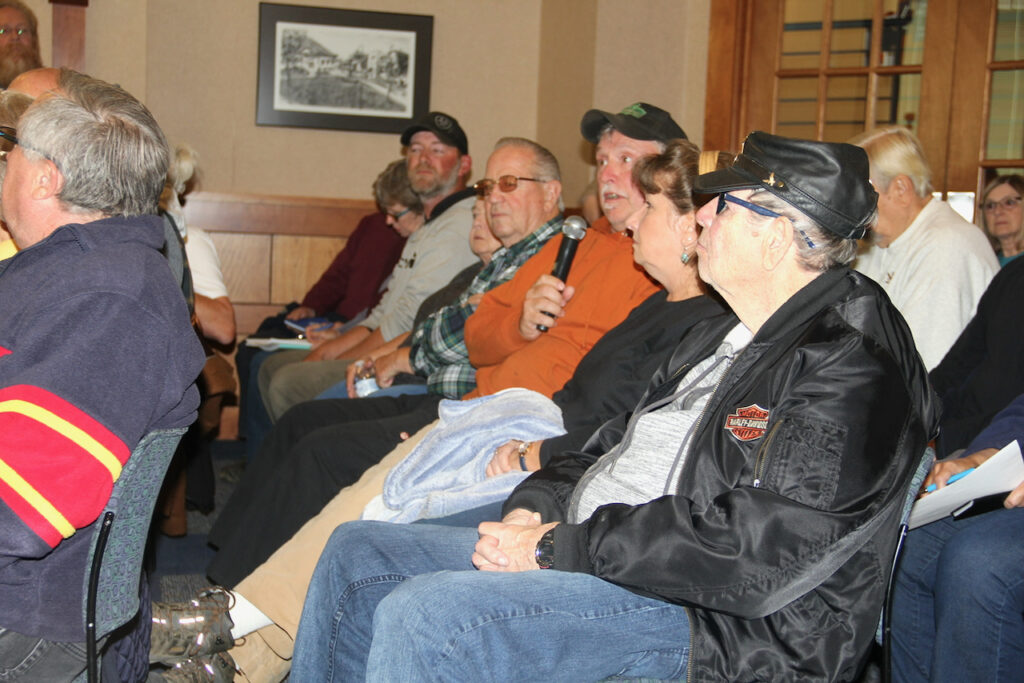
Members of the public ask questions of Whitewater and state Department of Natural Resources officials during a special meeting Saturday about the Cravath and Trippe lakes restoration project.
Chris Spangler photos.
Whitewater: City manager finalists announced
(Originally published Oct. 19, 2022.)
The City of Whitewater Common Council has announced that it has selected three finalists for the position of city manager.
According to a news release, the finalists are James “Jim” Palenick, David R. Porter and John S. Weidl.
Interviews with the three candidates will be held Friday, Oct. 21. A community reception and “Meet and Greet” for the finalists will be held Friday at the City of Whitewater Municipal Building, 312 W. Whitewater St., from 5 to 6:30 p.m. in the Community Room on the building’s first floor.
The Meet and Greet is open to the public and citizens are encouraged to attend. The common council will also hold interviews with the candidates and deliberate on Saturday, Oct. 22.
Biographical information, as supplied by city officials, follows:
James ‘Jim’ Palenick
Jim Palenick is the former city manager for Middletown, Ohio. He resides in Middletown.
Palenick has over 34 years of experience in service to local government as a city manager/chief administrative officer including Middletown, city administrator for the city of Racine; director of economic and business development in the city of Fayetteville, N.C.; interim and town manager, town of Dallas, N.C.; city manager for the city of Gastonia, N.C.; city manager for the city of Rio Rancho, N.M.; city manager for the city of Bay City, Mich.; city manager for the city of Dowagiac, Mich., and village manager for the village of Dexter, Mich. Palenick graduated with honors from Western Michigan University with an MPA degree; summa cum laude with a bachelor’s of science degree in public administration from Western Michigan, and an AAS degree from Kalamazoo Valley Community College.
David R. Porter
David Porter is the village administrator of Winneconne. He resides in Winneconne. Porter has previously been the management analyst and interim HR manager for the town of Wayland in Wayland, Mass.; co-founder and consultant to Trisector Advisors in Brookline, Mass.; senior researcher for the Center for Public Leadership in Cambridge, Mass.; program manager for EDX, Inc., in Cambridge Mass.; advisor and project manager for The Readiness Project in Washington D.C.; legal assistant for Sidley Austin Brown and Wood LLP in Washington D.C., and a consultant for Bancroft Associates, PLLC, in Washington D.C. Porter graduated cum laude from Harvard College with an artium baccalaureus in history with a certificate in Latin American studies and a citation in Spanish language. Porter holds a master of public policy degree from Harvard Kennedy School.
John S. Weidl
John Weidl is the interim city manager of the city of Whitewater and also a supervisor for the town of Lafayette. He lives in Elkhorn. He has previously held the position of village administrator/director of economic development, Mukwonago; city administrator/clerk/treasurer and director of Public Works for the city of Princeton, and office of the administrator for the village of Lake Zurich, Ill. He has been a leadership counselor for the Edward YMCA Camp in East Troy and a team leader, customer service director and database manager for the U.S. Air Force. Weidl is a decorated United States Air Force (USAF) combat veteran with tours of duty in Europe and the Middle East, including joint combat service with the United States Army. Weidl holds a master of public administration degree from Northern Illinois University and a bachelor of arts in political science/European history, also from Northern Illinois University.

James “Jim” Palenick

David R. Porter
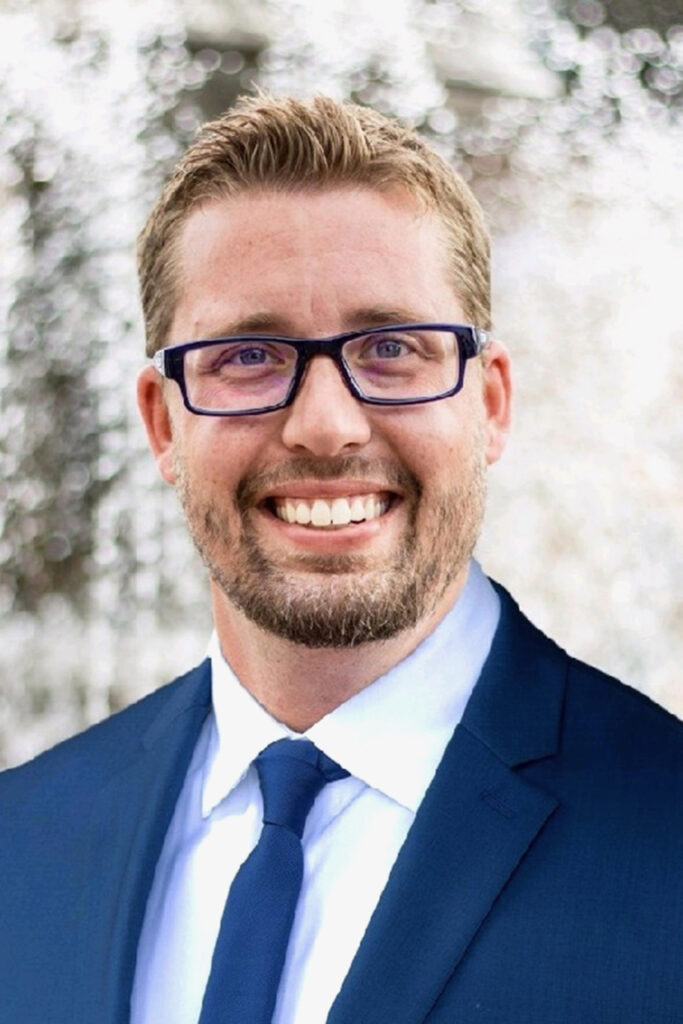
John S. Weidl
Increase to city’s tax base drives reduction in property taxes, Whitewater city officials say
(Originally published Oct. 19, 2022.)
By Kim McDarison
The fall general election, which will be held Tuesday, Nov. 8, is quickly approaching.
According to information released by Whitewater city officials, city of Whitewater residents will be asked whether they support two separate referendums.
The first is a request from the city to raise the city’s portion of the taxpayer-supported levy above the state-imposed cap by $1.1 million to support EMS staffing and equipment investments. The raise in the levy, would voters approve the referendum question, would be in place for perpetuity, or until a time when the city deemed it unnecessary.
An earlier two-part story about the proposed EMS referendum is here: https://fortatkinsononline.com/elementor-89201/.
A second referendum question has been placed on the ballot by the Whitewater Unified School District. The district is asking districtwide taxpayers to continue an operational referendum above the state imposed revenue cap by $17.6 million. Would the referendum receive voter approval, the increase would be collected over the course of a four-year period in the amount of $4.4 million each year.
An earlier story about the school district’s proposed operational referendum is here: https://fortatkinsononline.com/whitewater-council-receives-referendum-presentation-from-school-district/.
According to information released by the city: “If both referendums pass, most taxpayers will see a net reduction in tax bills thanks in large part to $75 million of growth in the city’s tax base.”
City of Whitewater Common Council President Lisa Dawsey Smith, as quoted within the release, said: “When the city brings in new development, the marker of that success is additional tax dollars to increase the tax base. Recent increases tied to the closure of tax incremental districts (TIDs) help offset the impact of the proposed EMS referendum.”
The release continued: “Combined with anticipated reduced levies from Whitewater Unified School District, the counties and technical colleges, the vast majority of residents can expect to see a reduction in net property taxes even if both referendums on the November ballot are passed.”
“We want to be transparent and clear that we are asking for a property tax increase to fund EMS services through the referendum question, but, we also want to make clear that the increase is more than offset by other reductions in net property taxes tied to an increase in the city’s tax base,” John Weidl, interim city manager, was quoted as saying in the release.
“The majority of Walworth County property owners can expect to see an estimated $202 reduction in net annual property taxes per $100,000 assessed value and the majority of Jefferson County property owners can expect to see a $242 reduction in net annual property taxes per $100,000 assessed value,” the release stated.
According to the release, more information about the city’s proposed EMS referendum is available by visiting: www.whitewater-wi.gov/582/Referendum.

City of Whitewater Municipal Building, file photo/Kim McDarison.
Whitewater: Finalists respond to news stories, petition alleging employment concerns
(Originally published Oct. 20, 2022.)
Editor’s note: This story has been updated to include a response from finalist David Porter.
By Kim McDarison
Whitewater city officials recently made public the names of three finalists for the position of Whitewater city manager. They are: James “Jim” Palenick, David R. Porter and John S. Weidl.
Following the release of the finalists’ names, Fort Atkinson Online has become aware of several news stories and a petition recounting activities in which the candidates were allegedly involved in their last places of employment.
Responding to Fort Atkinson Online by email about information available online, Lee Szymborski, GovUSA senior vice president and the individual identified by Whitewater city officials as the city’s liaison with GovUSA, the contracted search firm working with the city, wrote: “As you know from your reporting experience, it is not unusual for city officials to be criticized for some of their decisions. Each of the candidates have sustained such critiques, we were aware of it, and shared that with the city. I appreciate you giving them a chance to offer their side of the story.”
Fort Atkinson Online has invited each of the candidates to respond by email to the information found online. The information found online and a response made by each candidate to the information follows.
James Palenick
According to information reported by the Cincinnati Enquirer in March, James Palenick parted from his position as city manager of Middletown, Ohio, after he and the city council “mutually resolved to part ways due to differences in their overall visions for the city.” The information was supplied to the paper via a press release from Middletown Communications Manager Missy Knight.
The statement, according to the paper, followed an executive session meeting to “consider the appointment, employment or termination of a public employee or official.”
The Enquirer further reported that Palenick was “fired” from his post as city manager in three cities, including Bay City, Mich., in 2002; Rio Rancho, N.M., in 2006, and Gastonia, N.C. in 2011, crediting as its sources MLive, the Columbia Missourian and the Albuquerque Journal. According to the report, Palenick was removed by the Gastonia City Council after writing a cover letter noting, the paper reported: “he and his family did not mix well with the culture and traditions of Gastonia.”
Additionally, the paper reported, “Palenick sued the city of Rio Rancho after his termination, claiming it was illegal because council members violated open meeting laws.”
In Middleton, according to the Enquirer, controversy surrounded Palenick after he “brought developers interested in building Hollywoodland,” which the paper described as a $1.3 million entertainment-themed development.”
The full Cincinnati Enquirer story is here: https://www.cincinnati.com/story/news/2022/03/14/middletown-city-manager-jim-palenick-exits-position/7035546001/.
Palenick’s response
Responding to Fort Atkinson Online by email, Palenick wrote: “In my career of service as a chief administrative officer, spanning over 30 years, I have served in a number of communities where significant majority changeover in the elected governing body membership resulted in votes to terminate my employment contract. In each case it was without cause, with full severance, and exclusively as a result of newly elected majorities seeking to exact change by changing the appointed manager. In no case was my professionalism, ethics, leadership or level of competence or success ever called into question. I am exceptionally proud of my work and accomplishments in each of these cities. Further, my tenures therein lasted between 3 1/2 and 6 years.”
David Porter
A petition begun by a resident in Winneconne on the change.org platform is titled: “People of Winneconne Request to Remove David Porter, Village Administrator.”
The petition, which received its first comments in September, has, to date, received 134 signatures.
The petition lists 22 points of concern, ranging from an allegation of “blatantly lied to village board members and the people of our village,” to concerns of no economic development, no new business in industrial park, improper management of finances and lack of communicating with village residents, among others.
The petition further alleges that Porter held “secret meetings,” violating open meeting laws.
Petition author, Jonni Janikowski, in an Oct. 11 update wrote that she had decided to leave the petition “in place” after being asked by the village president and administrator to take it down, further noting: “I was told each time David Porter interviews for a position, they do a search and see the petition and then he has to defend himself. Well, so be it, you reap what you sow.”
Porter continues to serve as village administrator.
A link to the full petition and its associated comments is here: https://www.change.org/p/people-of-winneconne-request-to-remove-david-porter-village-administrator?redirect=false.
Porter’s response
Responding to Fort Atkinson Online by email, Porter wrote: “Like many Wisconsin communities, Winneconne is feeling the cumulative effects of the strict Act 10 levy limits imposed more than a decade ago. The levy limit does not include any adjustment for inflation. While we are growing, inflation always grows faster. Early in my tenure, I realized that Winneconne was not on a financially sustainable trajectory. In response, I facilitated economic growth, applied for and received significant grant funding, and made difficult and sometimes unpopular decisions regarding staffing and operations.
“I applied for many grants and received more than $1 million in grant funds to re-pave roads, re-build a seawall in one of our parks, and renovate a dilapidated building on Main Street. We also applied for and were approved for a Safe Drinking Water Loan to finance a DNR-mandated upgrade to one of our municipal wells.
John Weidl
According to information reported by the Milwaukee Journal Sentinel in April of last year, John Weidl parted from his position as village of Mukwonago administrator after signing a non-disparagement agreement.
Prior to his departure, Weidl had served as village administrator since 2013.
He resigned, according to the Journal, in March of 2021, following, the paper continued, “a closed-door session of the village board on the financial terms of his separation.”
Additionally, the Journal reported: “The reasons for his departure are unclear. Weidl faced some political pressure from an incident at a previous job in Princeton. He allegedly opened a ballot box during a mayoral election, resulting in a charge of willful neglect. That issue came to light years after it occurred, and many months ahead of his resignation recently.”
The Journal further noted: “No official reason has been stated,” for the separation, with village officials citing their restriction from comment through the non-disparagement arrangement.
A link to the full Milwaukee Journal Sentinel story is here: https://www.jsonline.com/story/communities/waukesha/news/mukwonago/2021/04/13/former-mukwonago-village-administrator-john-weidl-talks-resignation-non-disparagement-agreement/7129440002/.
Weidl’s response
Responding to Fort Atkinson Online by email, Weidl wrote: “By any objective measure, the years I spent in Mukwonago executing the village board’s vision was successful. During my 7.5 year tenure, we grew the tax base by over $350 million spread across industrial, commercial and residential – including new single-family subdivisions. We also developed multiple successful tax increment financing districts leading to a village-owned industrial park with 500,000 square feet of new manufacturing space and added hundreds of employees to the village in manufacturing and healthcare. Both myself and the village received numerous awards and recognition from organizations like the Wisconsin Economic Development Corporation (WEDC), the International Economic Development Council (IEDC), and the Wisconsin City/County Manager Association (WCMA) because of our annual budget process and economic development efforts. As with any public organization over time, the village board transitioned significantly, especially in the later years of my time there. As is the privilege of the elected officials, a majority of the board asked me to step aside in order to facilitate moving in a new direction and offered a severance package and a letter of recommendation approved by the village board. I have provided that letter to Fort Atkinson Online. A non-disclosure agreement to limit discourse of elected officials and separating employees is common in these instances to ensure both parties can move forward without distraction.
(A copy of the letter is here: http://fortatkinsononline.com/wp-content/uploads/2022/10/LOR-Village-of-Mukwonago.pdf.)
“Prior to serving in Mukwonago, I did accept a violation of municipal election ordinance that resulted in a citation. I’ve learned many things from that incident and a few of them are to admit when you have made a mistake, learn an actionable lesson, and move forward in a positive direction. While I can’t change what happened, I’m certainly willing to stand on my record before and after that moment as a decorated military combat veteran, award-winning local government administrator, and economic development professional. My intention is to bring that same resilience, positive attitude, and forward momentum to the city of Whitewater should I be selected as the next city manager.”
Community ‘meet and greet,’ interviews
A community reception and “Meet and Greet” for the finalists will be held Friday, Oct. 21, between 5 and 6:30 p.m. at the City of Whitewater Municipal Building, 312 W. Whitewater St., in the Community Room on the building’s first floor. The Meet and Greet is open to the public and residents are encouraged to attend.
Members of the Whitewater Common Council will hold interviews with the three candidates Friday, Oct. 21, and Saturday, Oct. 22, followed by deliberations on Saturday, Oct. 22.
According to information supplied by city officials, the council will meet in executive session Saturday at 8 a.m., with items to be discussed listed as “interview city manager candidates, deliberation and possible negotiation of contract terms. Final action on a contract would occur in open session at a later date.”
An earlier story offering biographical information about each candidate as supplied by Whitewater city officials is here: https://fortatkinsononline.com/whitewater-city-manager-finalists-announced/.

The three finalist for the position of Whitewater city manager are James “Jim” Palenick, from left, David R. Porter and John S. Weidl.
Whitewater: Residents meet city manager finalists
(Originally published Oct. 22, 2022.)
By Kim McDarison
Whitewater residents Friday were offered an opportunity to meet three final candidates for the position of city manager.
Some 20 people arrived at the informal forum held at the city’s municipal building to shake hands with and learn more about each candidate. They are James “Jim” Palenick, David R. Porter and John S. Weidl.
Questions asked by participants ranged from those revolving around basic personal and educational information about each candidate to those about management style and impressions of the city.
The 90-minute evening forum concluded a full day of activities, with the three candidates arriving in Whitewater to begin a planned itinerary around noon.
The day’s activities focused on meeting with panels, including search committee members, community stakeholders and members of the city’s management staff. Candidates also were given a tour of the city.
Whitewater Common Council President Lisa Dawsey Smith said that while members of the city’s search team, including herself and council members Jim Allen and Carol McCormick, had previously met the candidates using the Zoom platform, council members, along with members of the public were meeting the candidates in person on Friday for the first time.
Also on Friday city officials announced that council would hold a closed session meeting Saturday, at 8 a.m., at which time the candidates would be interviewed, with the possible negotiation of contract terms discussed.
According to the announcement, “final action on a contract would occur in open session at a later date.”
During Friday’s informational meeting, a break in the activity was taken to allow each candidate an opportunity to deliver a prepared speech, offering information, according to an introduction made by Dawsey Smith, about why they would like to be the next city manager of Whitewater.
Prepared comments, delivered by candidates in alphabetical order, follow.
James ‘Jim’ Palenick
“I was born and raised in a small town in southwest Michigan, one of three sons. Early on in my life, I started thinking about what I wanted to do with my life, and my profession, and I wanted to have some kind of an impact. And, to me, that meant being involved in government. And I couldn’t really get my head around maybe working in the federal government or the state, and so local government was something that I really felt would make a big impact on people’s lives. And I thought about this concept of a city manager, and there was a council-manger form of government. So really early on, I actually set out to become a city manager.
“So I went to Western Michigan University in Kalamazoo and I got bachelor and master degrees in public administration and economics, with sole belief that I was going to be a city manager. And then I sort of followed a rather unusual means in this profession, because typically people start in a larger organization at the bottom and they work their way up. And I started in the opposite — I started at the very top of a very small organization. So as soon as I was done with my graduate school, I actually got the job as the village manager of Dexter, Michigan, 1,400 people, 14 employees, and for the next four and a half years that’s what I did. And there’s two things that happen when you start out in a really small city, small organization like that: Number one, you’re forced and you learn to do almost everything there is about government because you don’t have enough resources, so you learn everything about public safety, engineering, public works, water, wastewater, and police and fire, and all the things that come with it. But — number two — you learn that to advance in your career you have to move on.
“So hence starts sort of my nomadic journey and then I went on to a city of 6,500 people, then a city of 38,000 people in Michigan, and then I started going across the country, and I served as the city manager in Rio Rancho, New Mexico, and city manager in Gastonia, North Carolina. I was in Racine. I had the opportunity as city administrator for Racine, Wisconsin, for three and a half years, and most recently, I was the city manager in Middletown, Ohio. So, my entire life, I spent basically in my career in local government, as a city manager. I’ve loved every single minute of it. I get great personal fulfillment out of it. I really, genuinely enjoy the work that I do. I love … trying to make things better. I’ve had a chance along the way to get involved in all kinds of economic development and redevelopment; that’s kind of been my passion.
“And when it comes to Whitewater, I was really very interested in coming back to Wisconsin because I very much enjoyed my time in the state. I love the community, I want to stay, I love the outdoor recreation, the people, the culture, and the chance to actually work on a council-manager form of government like this in a university community was very, very appealing.”
David Porter
“I currently serve as the village administrator in Winneconne, about an hour and 45 minutes north of here, just right near Oshkosh.
“And, there are a lot of things that make Whitewater extraordinarily appealing to me. First, it is abundantly clear and was even before I applied, that you have a really strong staff who do great work. And so I would be excited to work with them and to continue building upon the legacy of your prior city manager and continue to forge strong relationships with the university.
“I grew up in a university town, and public service runs deep. Both of my parents were involved at a university, and so from a young age, I spent a lot of time on campus, even as a sixth- and a seventh-grader I would go to the university library and my parents would bring me to concerts and athletic events. I can’t even count the number of basketball games I went to with my dad because he went to so many that they made him an honorary coach and made him sit on the bench.
“And I would really — my wife and I have three young children, ages 8, 6, and 4 — and it would be just a tremendous privilege to bring my family into a community like Whitewater. And raise them in an environment similar to the one I experienced.
“I had a whole series of wonderful meetings today, with staff members, with your public works director who took me on a tour, and showed me some of the impressive facilities that you have and also some of the areas that are ripe for further development, and to grow, that’s exciting to have that space to do those things. And then, one of the most impressive features from my perspective of your community were the third and final panel, the community representatives from the school district, and the historical commission, and the university, and the local business community, the chamber of commerce. The fact that your city and your council could open up their Rolodex and convene a meeting with representatives from every sector of your community, and that they would take interest in who the next city manager might be, really speaks volumes about the strength of your community.”
John Weidl
“I’m the interim city manager. I’ve been here since August.
“Some things about me: I’ve been in Walworth County for the last decade, and my wife and I have lived in our home that we own in the township of Lafayette for the last seven years. I’ve spend most of my life associated with Walworth County. I started out as a counselor on a (YMCA) campgrounds called Camp Edwards, which is in East Troy. I left for the military and college, and I subsequently came back to the area through employment in the village of Mukwonago, which is in Walworth County. I spent the last seven and a half years there, working on economic development and also leading that organization, which, in many ways, is as big as Whitewater; it’s about a billion dollars of assessed value, which is roughly equal to the size of Whitewater. We were very successful in generating growth in single-family residential, which is something I know this community is looking to expand on. We were also quite successful in filling out our industrial park and with our downtown redevelopment, which are also areas that I know the city is heavily invested in developing.
“Prior to that, I was in the United States military. I served almost four years in the Air Force. I was given the opportunity to go straight to college after I was done serving in Iraq — I took about a year serving in Iraq — and then I was allowed to go straight to college with all of the Montgomery GI benefits, so I did that and got my masters degree.
“My wife is a graduate of UW-Whitewater and she is currently enrolled in classes there. She has also taught in the district previously and now teaches in the Mukwonago school district.
“So what really attracts me to this community is the fact that we’ve got deep roots within the community. We don’t plan on going anywhere. We have certainly been a part of and taken advantage of the things that Whitewater has to offer, whether that’s educationally or recreationally. And most importantly, I look to continue what has been well over a decade in public and government service in the city of Whitewater to help it achieve its goals.”


Two photos above: At top, Whitewater city manager finalist James “Jim” Palenick, at right, meets with a city resident; above, University of Wisconsin-Whitewater staff member Jan Bilgen, from left, and UW-Whitewater Student Government President Will Hinz meet Palenick.
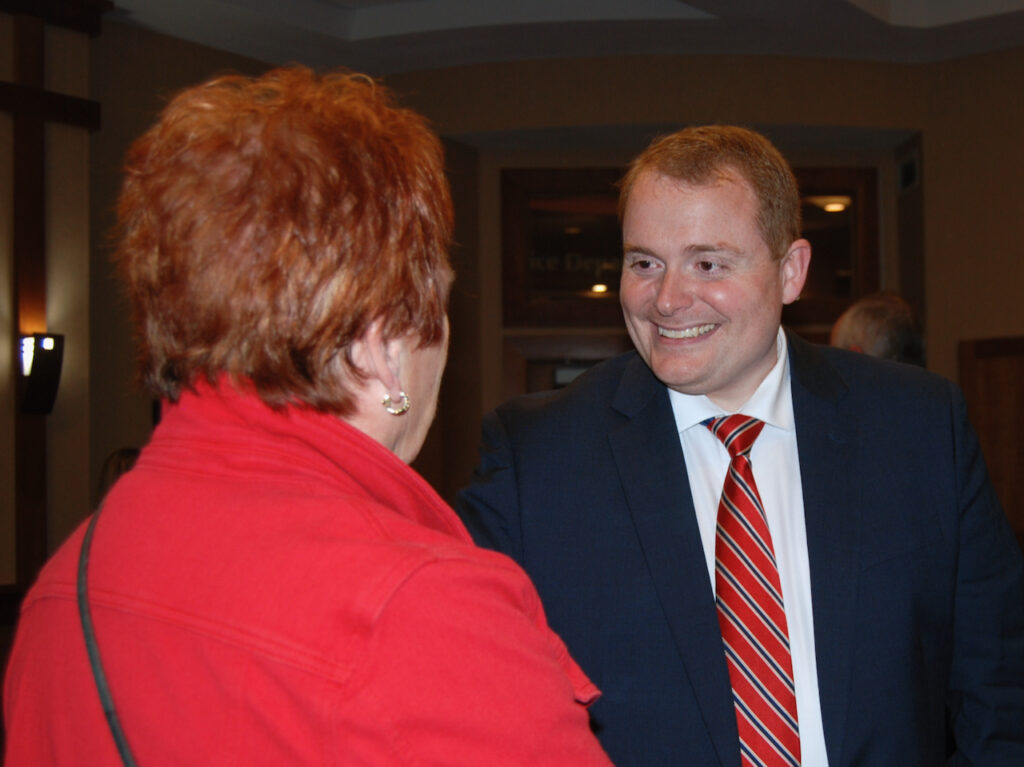
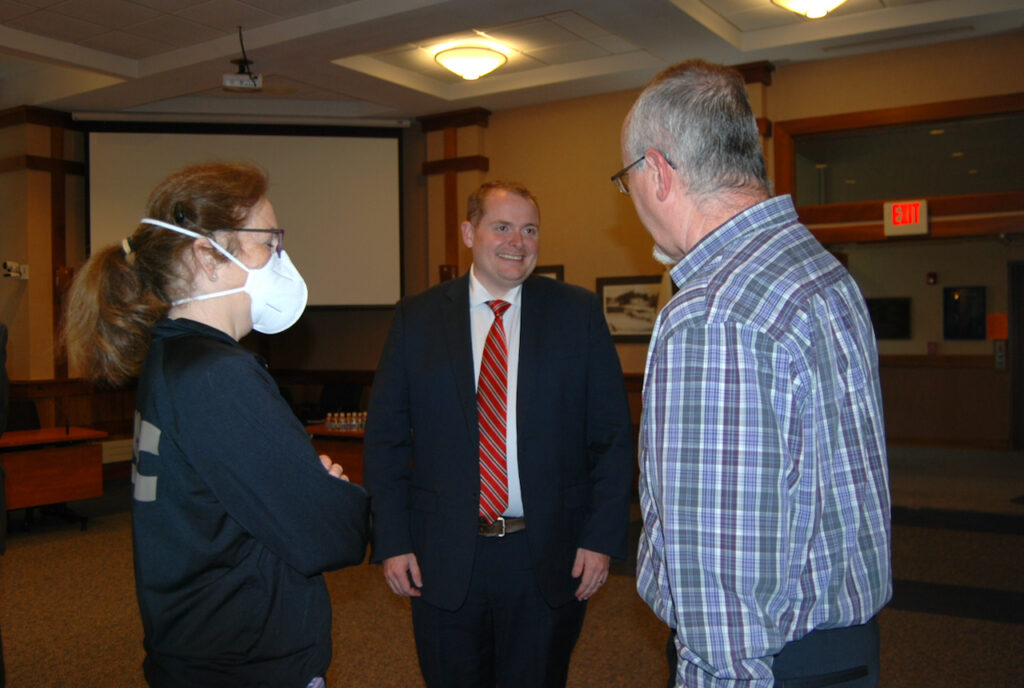
Two photos above: At top, Whitewater Common Council member Carol McCormick meets Whitewater city manager finalist David Porter; above, UW-Whitewater staff member Jan Bilgen, at left, and UW-Whitewater Assistance Vice Chancellor of Student Affairs Frank Bartlett, at right, talk with Porter.

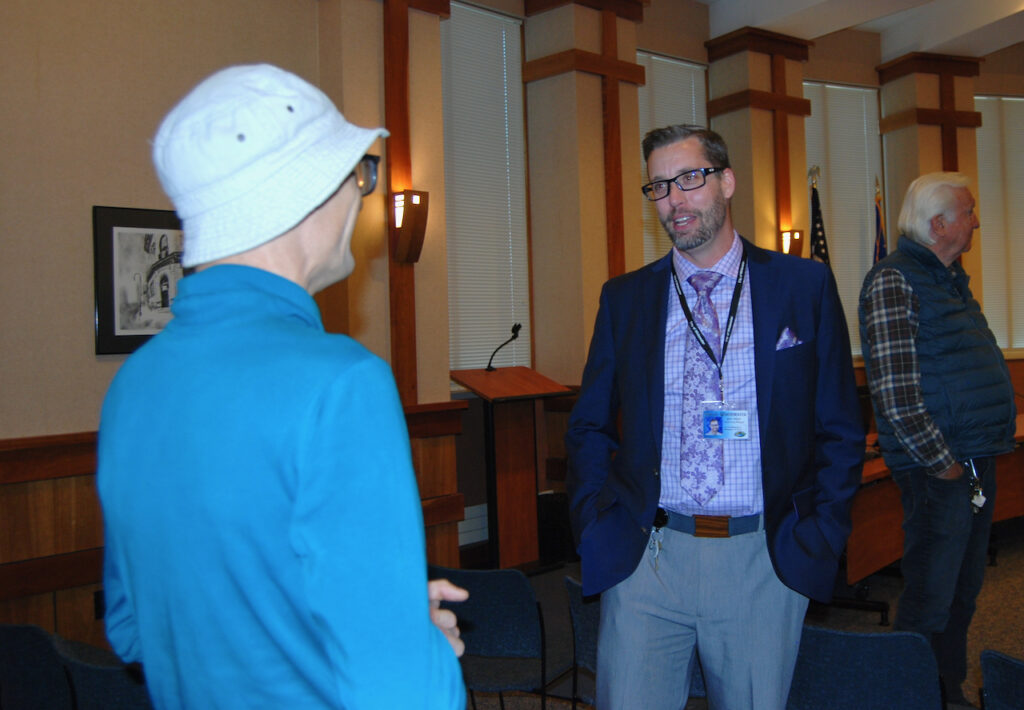
Two photos above: Whitewater interim city manager and finalist John Weidl, at right in both photos, answers questions posed by members of the public.

Community members gather Friday in advance of an informal meet-and-greet. The event was organized by city officials to offer members of the public an opportunity to meet the three finalists under consideration for the job of Whitewater city manager. The event was held at the Whitewater Municipal Building.
Kim McDarison photos.
Whitewater: Council postpones ordinance aimed at reducing nuisance emergency service calls
(Originally published Oct. 24, 2022.)
By Kim McDarison
The Whitewater Common Council Tuesday voted to postpone an ordinance that would establish fines for individuals making “unnecessary or preventable” calls for emergency services.
Council voted unanimously in favor of postponing the ordinance’s first reading, asking staff to explore language that would make more specific the activities and their frequency that would precipitate the engagement of a penalty system using fines as a deterrent.
Whitewater Police Capt. Adam Vander Steeg introduced the ordinance to council Tuesday, noting that he was making the presentation on behalf of Whitewater Police Chief Dan Meyer who was on vacation.
According to Vander Steeg, the ordinance was being proposed to help EMS staff alleviate a burden created from an increasing number of calls for service which both the city’s police and fire and EMS department personnel have identified as unnecessary and preventable.
Vander Steeg said that the police department specifically had noted a significant increase in calls for service emanating from group home facilities.
As an example, he said, the police department was called to one address 76 times between June of 2021 and June of 2022. He said the numbers show that on average, the department was responding to the address one time every five days. At another address, he said, officers responded 34 times during the same time period.
Reading from a memo submitted to council by Meyer, Vander Steeg said “Many of these circumstances were preventable and did not require a response by an officer.”
The memo further noted that the department’s command staff had met with the owners of the two facilities to work through the concerns, and, according to the memo, “improvements have been noted.”
Said Vander Steeg, reading from the memo: “The intent is not to dissuade the public from calling for emergency services, rather we are simply requesting to have a tool that can address the truly egregious abuses that cause undue strain on our emergency services personnel.”
He emphasized that owners of the facilities mentioned in his examples, upon talking with police officers, were “very receptive” and “clearly understood our limited emergency services we have in the city.”
The ordinance would give the department tools would future owners not be as receptive to address future calls, he said.
Within the ordinance, calls that fit the definition of unnecessary or preventable included:
- Calls that do not require emergency service.
- Repeated calls that display a pattern indicating the home/care employee skill levels and capabilities do not align with the special needs fo the resident.
- Fire alarms caused by unattended, burned food.
- Fire alarms caused by detectors that have not been maintained.
- Fire alarms caused by excessive dust or a similar non-combustible trigger.
- 911 misdial/hangup calls.
- Runaway, elopement or missing resident calls.
- Lift assist calls not caused by a fall.
The ordinance outlined the following penalties for the listed offenses: First offense, not less than $100 or more than $300; second offense within one year, not less than $300 or more than $550, and for a third or subsequent offense within one year, not less than $500 or more than $700.
Council discussion
During discussion, councilman Greg Majkrzak asked about the process that would be used to initiate punitive action, asking: at what point would someone be citied for a violation?
Said Vanger Steeg: “I think we would handle it the exact same way we did when we started seeing continued issues in the community, where officers were responding when they shouldn’t be. And so the issue then was — us in the administration would have to have those meetings with owners and management to go over our concerns, to make sure that they clearly understand the burden they are putting on a lot of these emergency services, and tying up the personnel for a long period of time. Then I think at that point, if things don’t progress or get better or have a game plan, then this would be the recourse we would potentially use.”
Majkrzak expressed an interest in developing specifics, advancing the concept of “three strikes.”
“Actually that was part of one of the drafts. Ultimately, it was decided to take that out because it somewhat administratively burdens some, and ultimately what this type of ordinance does is it gives the officers discretion,” City Attorney Wally McDonell said.
Officers would have the discretion to give warnings, he added.
Majkrzak proposed that language within the ordinance could be changed, making the first offense a warning, “and then you escalate to a fine,” he said.
Said McDonell: “One of the problems with that is that the question becomes: Is it one individual at the — I don’t want to single out group homes, but it’s sort of a good example — if they get three calls from three different or the same employee, or three different group homes owned by one owner, just kind of sorting out who the warning is, and when you have your first strike, so to speak, was somewhat of a concern.”
Addressing his comments to Majkrzak, councilman Jim Allen said: “This could be used more against Hispanic people, or interpreted that way, if it’s used unequally. And I think that’s your concern, right?”
Majkrzak responded, saying: “I don’t want it to be a surprise — it won’t be a surprise in reality — but it could be a surprise in perception, to everyone else. Whatever criteria will justify the first penalty, which is not more than $300, or $100 and no more than $300, would be a warning instead.”
Said Allen: “It’s tough to create an ordinance that could be used against someone who doesn’t understand what they’re at fault for. Secondly, there are situations where they don’t have $300. … I don’t know. I think it needs a little more work.”
“How did you arrive at the specificity of this particular list of the definition of unnecessary or preventable calls? Was there a review of other municipalities, or a framework, or something hyper-local to what our departments here have been experiencing?” asked council president Lisa Dawsey Smith.
McDonell responded, saying: “both. It was probably more what this department is experiencing,” but, he said, other ordinances were consulted as resources.
Allen suggested looking at ordinances developed by other municipalities.
Councilwoman Jill Gerber suggested looking into language, especially that associated with criteria for “lift assist calls not caused by a fall,” that could exclude private residents and homeowners who did not live in group homes or assisted living facilities.
Dawsey Smith asked if the city’s departments are charging fees for lift assist services.
“My understanding is unless you are transported by the ambulance they are not charging,” Vander Steeg said.
Allen and Dawsey Smith both cited an earlier discussion — which they recalled may have taken place during negotiation meetings with fire department personnel before they were brought in house — revolving around calls for lift assists.
The fire department, which operated as Whitewater Fire Department, Inc., an independent nonprofit organization, was absorbed by the city as an in-house fire department in July.
Allen said he recalled that within that earlier discussion there were suggestions made that the city no longer provide assistance for calls concerning lift assists not caused by a fall.
“Definitely I think that falls should be paid for. If they (group home and assisted living facilities) are just using us for that, they have the training, they have the equipment, they want to continue to use us … then we have to collect what it costs us back,” Allen said.
McDonell said city staff could look at developing a policy that would address lift assists using a fee for service rather than include it within a policy that establishes a penalty for misuse.
Allen said that while he agreed with the need for an ordinance, he would not support it in the form in which it was presented.
Council voted to postpone the ordinance with the understanding that it would reappear before them at a “further date.”
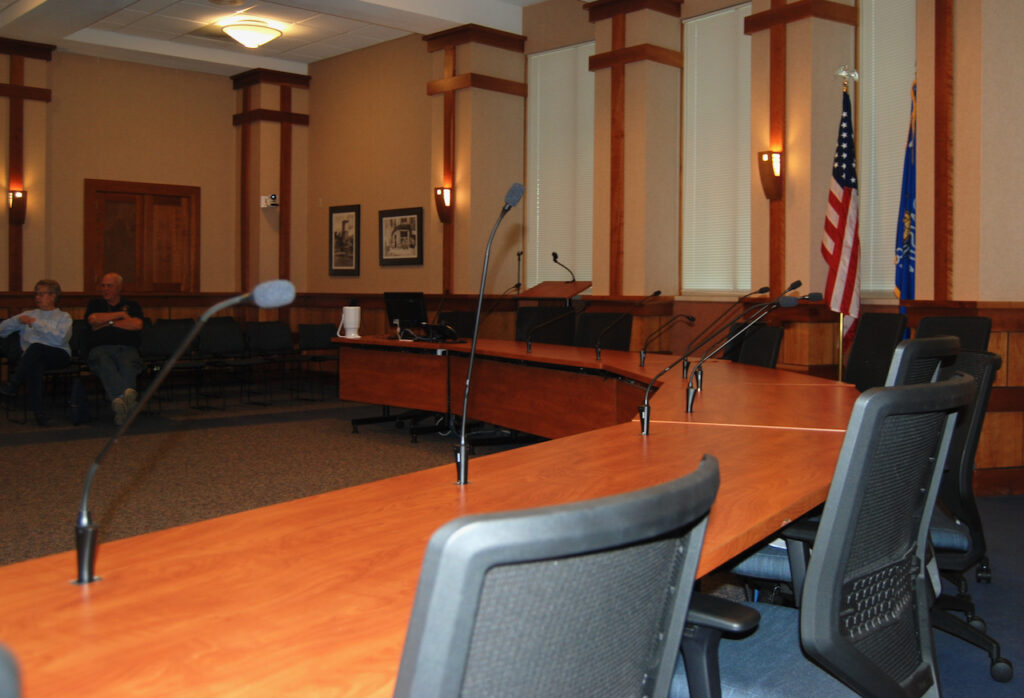
Whitewater council chambers, file photo/Kim McDarison.
Whitewater: Weidl named city manager
(Originally published Oct. 26, 2022.)
By Kim McDarison
Following 35 minutes of closed-session deliberation Wednesday during a special meeting of the Whitewater Common Council, the body reconvened in open session and voted in favor of installing John Weidl as city manager.
Weidl has served the city as interim city manager since August.
Council voted unanimously in favor of hiring Weidl at an annual salary of $115,000, with a salary increase to $119,600, taking effect January 1, 2023.
Six of seven council members participated in the vote. Councilwoman Brienne Brown was not in attendance.
According to the employment agreement approved by council, Weidl will begin his contract as city manager on Monday, Nov. 7.
Contractual provisions
After the increase in annual salary scheduled for Jan. 1, the contract stipulates that future salary increases will be tied to performance reviews anticipated to take place on an annual basis.
Additionally, the contract states, “should the city manager decline the city’s health insurance because he receives coverage through another plan, he shall be eligible for additional compensation paid in lieu of insurance.”
The contract stipulates that the city manager can be terminated by the city council at any time during the agreement without cause or for just cause.
Would the city manager opt to resign, he must provide a 60-day written notice to the city clerk and the council president, according to the agreement.
The contract notes that the city will make available to the city manager a city-issued vehicle for use during the course of conducting business, and in the absence of the availability of a vehicle, the city will reimburse the manager for mileage at a rate established by the Federal Internal Revenue Service.
The city also will provide the manager with a cell phone allowance of $50 per month.
The full contract is here: http://fortatkinsononline.com/wp-content/uploads/2022/10/DOC102622-10262022192636.pdf.
Prepared statements
After the open session meeting, the city released a prepared statement, noting that after weeks of engaging in the recruitment process, which included “conducting a national search, phone interviews and video interviews, the council selected three final candidates.”
They were David Porter, James Palenick and Weidl, each of whom participated Friday in a “full day interview.”
According to the release, the day consisted of interviews with members of city staff and stakeholders, along with a tour of the community and a meet-and-greet for media and citizens.
Council members and the candidates continued the interviewing process on Saturday, and, the release noted, received information from other interview panels.
“We welcome Mr. Weidl as the new city manager for Whitewater. The council took this decision very seriously and feels that Mr. Weidl is the candidate best qualified for this role for the city of Whitewater. We trust that Mr. Weidl will bring his experience, abilities and energy to work diligently and passionately for the city of Whitewater,” Council President Lisa Dawsey Smith was quoted as saying in the release.
She continued: “Like every community, Whitewater is facing a number of challenges, and we feel that Mr. Weidl has the drive to tackle projects head-on and a desire to get results for the betterment of the entire community. His experience and knowledge in local government, especially economic development, should prove to be an asset to our city.”
Responding within the press release to the council’s decision, Weidl was quoted as saying: “Thank you to the community members, staff and elected officials that participated in the process of choosing the city’s next manager. I’ve enjoyed the previous two months serving as the interim city manager, particularly finding value touring the community and discussing the fire and EMS referendum as an entryway to learning more about the needs and opportunities of Whitewater, while meeting several hundred community members and dozens of local organizations.”
He continued: “I’m excited to bring my expertise in economic development, energy, and enthusiasm to Whitewater as we look to increase opportunities for public outreach, communication and collaboration with local partners.”
Weidl said that on Monday, Nov. 7, he plans to make himself available to members of the public, offering discussion over coffee and pastries at the Sweet Spot, 226 W. Whitewater St., between 8:30 and 10 a.m., which, he said within the release, would be his “first opportunity to reintroduce myself to the community as the permanent city manager.”

Whitewater City Manager John Weidl, file photo/Kim McDarison. An earlier story about Weidl is here: https://fortatkinsononline.com/whitewater-interim-city-manager-says-he-plans-to-apply-for-permanent-position/.

Whitewater Common Council members Lisa Dawsey Smith, from left, Carol McCormick, Greg Majkrzak, Lukas Schreiber and Jim Allen assemble Wednesday in a conference room on the second floor of city hall. Councilwoman Jill Gerber, not pictured, attended the special meeting through Zoom. Council met in closed session, deliberating for 35 minutes before reconvening in open session and voted to install John Weidl as city manager. Kim McDarison Photo.
Woman dead after being struck by vehicle near Whitewater
(Originally published Oct. 30, 2022.)
Editor’s note: This story has been updated to include information released by the Jefferson County Sheriff’s Office on Nov. 1.
By Kim McDarison
A woman has died from her injuries after being struck by a vehicle in Jefferson County just north of the city of Whitewater, according to information released by the operators of the Jefferson County Scanner Facebook page and presented within a GoFundMe account opened Sunday.
The GoFundMe account was created by Alejandra Godina, of Whitewater, to raise funds to return the body of Maricela Del Carmen Rivas Rivas to Nicaragua, according to information presented on the account.
According to the GoFundMe account, Maricela Del Carmen Rivas Rivas, 30, was struck by a car, and was pronounced “brain dead” and died at the hospital.
She leaves behind a husband, Jose Fajardo, and 5-year-old son, the account noted.
Monies collected through the account will be used for funeral and transportation fees to return her to Nicaragua, the account stated.
A goal of $15,000 has been set. As of Sunday night, some $1,120 had been raised.
According to information released by operators of the Jefferson County Scanner Facebook page, a car versus pedestrian crash occurred near the Whitewater city limits in the N300 block of County Trunk N.
Janesville medics were requested to the scene.
Information released by the Jefferson County Sheriff’s Office Tuesday notes that deputies responded to the scene Saturday at 9:50 p.m., which was located in the town of Cold Spring on County Highway N, south of County Highway U.
According to information found on the scanner, the accident happened around 10 p.m. Saturday, with the scanner further reporting that the “patient was in and out of consciousness.” Posts made by the operator of the scanner page described the victim as having a “significant head injury.”
Information released by the sheriff’s office stated that a primary investigation at the scene showed that a “group of pedestrians” were attempting to cross County Highway N when one of them was hit by a vehicle traveling northbound on the highway.
Units from the Whitewater Police Department and the Jefferson County Sheriff’s Department were reportedly responding to the scene, the scanner operater noted.
According to the scanner, County Trunk N was “shutdown” between County Truck N and U, just north of Peninsula Lane.
Additionally, the sheriff’s department reports that the driver of the vehicle was not injured and remained at the scene until law enforcement arrived.
The pedestrian who was hit, identified as Maricela Del Carmen Rivas Rivas, was transported to a local hospital with “critical injuries,” the release from the sheriff’s office stated.
The victim, the sheriff’s office reported it learned on Monday, died from her injuries.
The victim is reported to be from “the Whitewater area.”
Responding by email Sunday night, Whitewater Police Chief Dan Meyer said that the Jefferson County Sheriff’s Department was the primary agency handling the scene.
As stated within the release from the sheriff’s office, the agency was assisted at the scene by the Whitewater police, fire and EMS departments, and the Jefferson County Emergency Communications agency, which helped with traffic control.
The incident remains under investigation, the release stated.
A link to the GoFundMe page is here: https://www.gofundme.com/f/ny9vra-maricela-del-carmen-rivas-rivas?utm_campaign=p_cf+share-flow-1&utm_medium=copy_link&utm_source=customer.
This story may continue to be updated.

A collage of photographs, shown above, is presented on the GoFundMe page created to raise funds for a funeral and transportation costs associated with returning the body of 30-year-old Maricela Del Carmen Rivas Rivas to Nicaragua.
